
THE HISTORY OF
MODERN PAINTING
 | |
| ADOLF VON MENZEL. | RESTAURANT AT THE PARIS EXHIBITION 1867. |

CONTENTS
| PAGE | |
LIST OF ILLUSTRATIONS | ix |
| BOOK IV (continued) | |
| THE REALISTIC PAINTERS AND MODERN IDEALISTS (continued) | |
| CHAPTER XXVIII | |
| REALISM IN ENGLAND | |
The mannerism of English historical painting: F. C. Horsley, J. R. Herbert, J. Tenniel, E. M. Ward, Eastlake, Edward Armitage, and others.—The importance of Ruskin.—Beginning of the efforts at reform with William Dyce and Joseph Noël Paton.—The pre-Raphaelites.—The battle against “beautiful form” and “beautiful tone.”—Holman Hunt.—Ford Madox Brown.—John Everett Millais and Velasquez.—Their pictures from modern life opposed to the anecdotic pictures of the elder genre painters.—The Scotch painter John Phillip | 1 |
| CHAPTER XXIX | |
| REALISM IN GERMANY | |
Why historical painting and the anecdotic picture could no longer take the central place in the life of German art after the changes of 1870.—Berlin: Adolf Menzel, A. v. Werner, Carl Güssow, Max Michael.—Vienna: August v. Pettenkofen.—Munich becomes once more a formative influence.—Importance of the impetus given in the seventies to the artistic crafts, and how it afforded an incentive to an exhaustive study of the old colourists.—Lorenz Gedon, W. Diez, E. Harburger, W. Loefftz, Claus Meyer, A. Holmberg, Fritz August Kaulbach.—Good painting takes the place of the well-told anecdote.—Transition from the costume picture to the pure treatment of modern life.—Franz Lenbach.—The Ramberg school.—Victor Müller brings into Germany the knowledge of Courbet.—Wilhelm Leibl | 39 |
| CHAPTER XXX | |
| THE INFLUENCE OF THE JAPANESE | |
The Paris International Exhibition of 1867 communicated to Europe a knowledge of the Japanese.—A sketch of the history of Japanese painting.—The “Society of the Jinglar,” and the influence of the Japanese on the founders of Impressionism | 81 |
| CHAPTER XXXI | |
| THE IMPRESSIONISTS | |
Impressionism is Realism widened by the study of the milieu.—Edouard Manet, Degas, Renoir, Camille Pissarro, Alfred Sisley, Claude Monet.—The Impressionist movement the final phase in the great battle of liberation for modern art | 105 |
| CHAPTER XXXII | |
| THE NEW IDEALISM IN ENGLAND | |
Rossetti and the New pre-Raphaelites: Edward Burne-Jones, R. Spencer Stanhope, William Morris, J. M. Strudwick, Henry Holliday, Marie Spartali-Stillman.—W. B. Richmond, Walter Crane, G. F. Watts | 151 |
| CHAPTER XXXIII | |
| THE NEW IDEALISM IN FRANCE AND GERMANY | |
Gustave Moreau, Puvis de Chavannes, Arnold Boecklin, Hans von Marées.—The resuscitation of biblical painting.—Review of previous efforts from the Nazarenes to Munkacsy, E. von Gebhardt, Menzel, and Leibermann.—Fritz von Uhde.—Other attempts: W. Dürr, W. Volz.—L. von Hofmann, Julius Exter, Franz Stuck, Max Klinger | 210 |
| BOOK V | |
| A SURVEY OF EUROPEAN ART AT THE PRESENT TIME | |
INTRODUCTION | 251 |
| CHAPTER XXXIV | |
| FRANCE | |
Bastien-Lepage, L’hermitte, Roll, Raffaelli, De Nittis, Ferdinand Heilbuth, Albert Aublet, Jean Béraud, Ulysse Butin, Édouard Dantan, Henri Gervex, Duez, Friant, Goeneutte, Dagnan-Bouveret.—The landscape painters: Seurat, Signac, Anquetin, Angrand, Lucien Pissarro, Pointelin, Jan Monchablon, Montenard, Dauphin, Rosset-Granget, Émile Barau, Damoye, Boudin, Dumoulin, Lebourg, Victor Binet, Réné Billotte.—The portrait painters: Fantin-Latour, Jacques Émile Blanche, Boldini.—The Draughtsmen: Chéret, Willette, Forain, Paul Renouard, Daniel Vierge, Cazin, Eugène Carrière, P. A. Besnard, Agache, Aman-Jean, M. Denis, Gandara, Henri Martin, Louis Picard, Ary Renan, Odilon Redon, Carlos Schwabe | 255 |
| CHAPTER XXXV | |
| SPAIN | |
From Goya to Fortuny.—Mariano Fortuny.—Official efforts for the cultivation of historical painting.—Influence of Manet inconsiderable.—Even in their pictures from modern life the Spaniards remain followers of Fortuny: Francisco Pradilla Casado, Vera, Manuel Ramirez, Moreno Carbonero, Ricardo Villodas, Antonio Casanova y Estorach, Benliure y Gil, Checa, Francisco Amerigo, Viniegra y Lasso, Mas y Fondevilla, Alcazar Tejeder, José Villegas, Luis Jimenez, Martin Rico, Zamacois, Raimundo de Madrazo, Francisco Domingo, Emilio Sala y Francés, Antonio Fabrés | 307 |
| CHAPTER XXXVI | |
| ITALY | |
Fortuny’s influence on the Italians, especially on the school of Naples.—Domenico Morelli and his followers: F. P. Michetti, Edoardo Dalbono, Alceste Campriani, Giacomo di Chirico, Rubens Santoro, Edoardo Toffano, Giuseppe de Nigris.—Prominence of the costume picture.—Venice: Favretto, Lonza.—Florence: Andreotti, Conti, Gelli, Vinea.—The peculiar position of Segantini.—Otherwise anecdotic painting still preponderates.—Chierici, Rotta, Vannuttelli, Monteverde, Tito.—Reasons why the further development of modern art was generally completed not so much on Latin as on Germanic soil | 326 |
| CHAPTER XXXVII | |
| ENGLAND | |
General characteristic of English painting.—The offshoots of Classicism: Lord Leighton, Val Prinsep, Poynter, Alma Tadema.—Japanese tendencies: Albert Moore.—The animal picture with antique surroundings: Briton-Rivière.—The old genre painting remodelled in a naturalistic sense by George Mason and Frederick Walker.—George H. Boughton, Philip H. Calderon, Marcus Stone, G. D. Leslie, P. G. Morris, J. R. Reid, Frank Holl.—The portrait painters: Ouless, J. J. Shannon, James Sant, Charles W. Furse, Hubert Herkomer.—Landscape painters.—Zigzag development of English landscape painting.—The school of Fontainebleau and French Impressionism rose on the shoulders of Constable and Turner, whereas England, under the guidance of the pre-Raphaelites, deviated in the opposite direction until prompted by France to return to the old path.—Cecil Lawson, James Clarke Hook, Vicat Cole, Colin Hunter, John Brett, Inchbold, Leader, Corbett, Ernest Parton, Mark Fisher, John White, Alfred East, J. Aumonier.—The sea painters: Henry Moore, W. L. Wyllie.—The importance of Venice to English painting: Clara Montalba, Luke Fildes, W. Logsdail, Henry Woods.—French influences: Dudley Hardy, Stott of Oldham, Stanhope Forbes, J. W. Waterhouse, Byam Shaw, G. E. Moira, R. Anning Bell, Maurice Greiffenhagen, F. Cayley Robinson, Eleanor Brickdale | 341 |
BIBLIOGRAPHY | 405 |

LIST OF ILLUSTRATIONS
| PLATES IN COLOUR | |
| PAGE | |
| Adolf Von Menzel: Restaurant at the Paris Exhibition, 1867 | Frontispiece |
| Millais: The Vale of Rest | Facing p. 28 |
| Degas: The Ballet Scene from Robert the Devil | ” 118 |
| Monet: A Study | ” 138 |
| Rossetti: The Day-Dream | ” 160 |
| Burne-Jones: The Mill | ” 176 |
| L’Hermitte: The Pardon of Plourin | ” 266 |
| Raffaelli: The Highroad to Argenteuil | ” 274 |
| Carrière: School-Work | ” 304 |
| Segantini: Maternity | ” 338 |
| Alma-Tadema: The Visit | ” 354 |
| Colin Hunter: Their only Harvest | ” 394 |
| IN BLACK AND WHITE | |
| PAGE | |
| Alma Tadema, Laurens. | |
| Sappho | 354 |
| Aman-Jean, Edmond. | |
| Sous la Guerlanda | 303 |
| An Unknown Master. | |
| Harvesters resting | 97 |
| Ansdell, Richard. | |
| A Setter and Grouse | 37 |
| Aumonier, M. J. | |
| The Silver Lining to the Cloud | 394 |
| Bastien-Lepage, Jules. | |
| Portrait of Jules Bastien-Lepage | 256 |
| Portrait of his Grandfather | 257 |
| The Flower Girl | 258 |
| Sarah Bernhardt | 259 |
| Mme. Drouet | 260 |
| The Hay Harvest | 261 |
| Le Père Jacques | 262 |
| Joan of Arc | 263 |
| The Beggar | 264 |
| The Pond at Damvillers | 265 |
| The Haymaker | 266 |
| Bell, R. Anning. | |
| Oberon and Titania with their Train | 398, 399 |
| Benliure y Gil. | |
| A Vision in the Colosseum | 321 |
| Besnard, Paul Albert. | |
| Evening | 299 |
| Portrait of Mlles. D. | 301 |
| Boecklin, Arnold. | |
| Portrait of Himself | 227 |
| A Villa by the Sea | 229 |
| A Rocky Chasm | 231 |
| The Penitent | 232 |
| Pan startling a Goat-Herd | 234 |
| The Herd | 235 |
| Venus despatching Cupid | 237 |
| Flora | 241 |
| In the Trough of the Waves | 242 |
| The Shepherd’s Plaint | 243 |
| An Idyll of the Sea | 244 |
| Vita Somnium Breve | 245 |
| The Isle of the Dead | 246 |
| Boldini, Giovanni. | |
| Giuseppe Verdi | 290 |
| Boudin, Eugène Louis. | |
| The Port of Trouville | 289 |
| Boughton, George. | |
| Green Leaves among the Sere | 367 |
| Snow in Spring | 368 |
| A Breath of Wind | 369 |
| The Bearers of the Burden | 370 |
| Brangwyn. | |
| Illustration to the Rubáiyát of Omar Khayyám | 401 |
| Brown, Ford Madox. | |
| Portrait of Himself | 10 |
| Lear and Cordelia | 11 |
| Romeo and Juliet | 13 |
| Christ washing Peter’s Feet | 15 |
| The Last of England | 29 |
| Work | 31 |
| Burne-Jones, Sir Edward. | |
| Chant d’Amour | 169 |
| The Days of Creation | 170, 171 |
| Circe | 172 |
| Pygmalion (the Soul attains) | 173 |
| Perseus and Andromeda | 175 |
| The Annunciation | 176 |
| The Enchantment of Merlin | 177 |
| The Sea Nymph | 178 |
| The Golden Stairs | 179 |
| The Wood Nymph | 181 |
| Butin, Ulysse. | |
| Portrait of Ulysse Butin | 278 |
| The Departure | 279 |
| Caldecott, Randolph. | |
| The Girl I left behind Me | 363 |
| Carrière, Eugène. | |
| Motherhood | 297 |
| Casado del Alisal. | |
| The Bells of Huesca | 323 |
| Cazin, Jean Charles. | |
| Judith | 295 |
| Hagar and Ishmael | 296 |
| Crane, Walter. | |
| The Chariots of the Fleeting Hours | 193 |
| From The Tempest | 194 |
| From The Tempest | 195 |
| Dagnan-Bouveret, Pascal Adolphe Jean. | |
| Consecrated Bread | 284 |
| Bretonnes au Pardon | 285 |
| The Nuptial Benediction | 286 |
| Dantan, Edouard. | |
| A Plaster Cast from Nature | 280 |
| Degas, Hilaire Germain Edgard. | |
| The Ballet in Don Juan | 119 |
| A Ballet-Dancer | 121 |
| Horses in a Meadow | 122 |
| Dancing Girl fastening her Shoe | 123 |
| Diez, Wilhelm. | |
| Returning from Market | 61 |
| Duez, Ernest. | |
| On the Cliff | 282 |
| The End of October | 283 |
| Dyce, William. | |
| Jacob and Rachel | 5 |
| Eastlake, Sir Charles Lock. | |
| Christ blessing little Children | 3 |
| Favretto, Giacomo. | |
| On the Piazzetta | 331 |
| Susanna and the Elders | 333 |
| Fildes, Luke. | |
| Venetian Women | 396 |
| Forain, J. L. | |
| At the Folies-Bergères | 293 |
| Forbes, Stanhope. | |
| The Lighthouse | 397 |
| Fortuny, Mariano. | |
| Portrait of Mariano Fortuny | 309 |
| The Spanish Marriage (La Vicaria) | 310 |
| The Trial of the Model | 311 |
| The Snake Charmers | 312 |
| Moors playing with a Vulture | 313 |
| The China Vase | 314 |
| At the Gate of the Seraglio | 315 |
| Furse, Charles W. | |
| Frontispiece to “Stories and Interludes” | 381 |
| Gervex. | |
| Dr. Péan at La Salpétrière | 281 |
| Güssow, Karl. | |
| The Architect | 53 |
| Harunobu. | |
| A Pair of Lovers | 101 |
| Heilbuth, Ferdinand. | |
| Fine Weather | 277 |
| Herkomer, Hubert. | |
| John Ruskin | 382 |
| Charterhouse Chapel | 383 |
| Portrait of his Father | 384 |
| Hard Times | 385 |
| The Last Muster | 387 |
| Found | 389 |
| Hiroshige. | |
| The Bridge at Yeddo | 93 |
| A High Road | 94 |
| A Landscape | 95 |
| Snowy Weather | 96 |
| Hirth, Rudolf du Frénes. | |
| The Hop Harvest | 70 |
| Hokusai. | |
| Hokusai in the Costume of a Japanese Warrior | 82 |
| Women Bathing | 83 |
| Fusiyama seen through a Sail | 84 |
| Fusiyama seen through Reeds | 85 |
| An Apparition | 86 |
| Hokusai sketching the Peerless Mountain | 87 |
| Holl, Frank. | |
| “The Lord gave, the Lord hath taken away; Blessed be the Name of the Lord” | 373 |
| Leaving Home | 374 |
| Ordered to the Front | 375 |
| Hunt, William Holman. | |
| The Scapegoat | 8 |
| The Light of the World | 9 |
| Hunter, Colin. | |
| The Herring Market at Sea | 393 |
| Kaulbach, Fritz August. | |
| The Lute Player | 64 |
| Kiyonaga. | |
| Ladies Boating | 99 |
| Korin. | |
| Landscape | 89 |
| Rabbits | 91 |
| Lawson, Cecil. | |
| The Minister’s Garden | 391 |
| Leibl, Wilhelm. | |
| Portrait of Wilhelm Leibl | 71 |
| In the Studio | 72 |
| The Village Politicians | 73 |
| The New Paper | 74 |
| In Church | 75 |
| A Peasant drinking | 76 |
| In the Peasant’s Cottage | 77 |
| A Tailor’s Workshop | 79 |
| Leighton, Lord. | |
| Portrait of Lord Leighton, P.R.A. | 343 |
| Captive Andromache | 345 |
| Sir Richard Burton | 347 |
| The Last Watch of Hero | 348 |
| The Bath of Psyche | 349 |
| Lenbach, Franz. | |
| Portrait of Franz Lenbach | 65 |
| Portrait of Wilhelm I. | 66 |
| Portrait of Prince Bismarck | 67 |
| The Shepherd Boy | 68 |
| L’Hermitte, Léon. | |
| Pay time in Harvest | 267 |
| Portrait of Léon L’Hermitte | 268 |
| Manet, Édouard. | |
| Portrait of Édouard Manet | 107 |
| The Fifer | 108 |
| The Guitarero | 109 |
| Le Bon Bock | 110 |
| A Garden in Rueil | 111 |
| The Fight between the “Kearsarge” and “Alabama” | 114 |
| Boating | 115 |
| A Bar at the Folies Bergères | 116 |
| Spring: Jeanne | 117 |
| Mason, George Hemming. | |
| The End of the Day | 365 |
| Menzel, Adolf. | |
| Portrait of Adolf Menze | 40 |
| From Kugler’s History of Friedrich the Great | 41 |
| The Coronation of King Wilhelm I. | 43 |
| From Kugler’s History of Friedrich the Great | 45 |
| The Damenstiftskirche at Munich | 46 |
| King Wilhelm setting out to join the Army | 47 |
| The Iron Mill | 49 |
| Sunday in the Tuileries Gardens | 51 |
| A Levee | 52 |
| Meyer, Claus. | |
| The Smoking Party | 63 |
| Michetti, Francesco Paolo. | |
| Going to Church | 329 |
| The Corpus Domini Procession at Chieti | 330 |
| Millais, Sir John Everett. | |
| Portrait of Sir John Everett Millais | 16 |
| Lorenzo and Isabella | 17 |
| The North-West Passage | 19 |
| The Huguenot | 20 |
| Autumn Leaves | 21 |
| The Yeoman of the Guard | 22 |
| The Right Hon. W. E. Gladstone | 23 |
| Yes or No | 25 |
| Mrs. Bischoffsheim | 26 |
| Thomas Carlyle | 27 |
| Monet, Claude. | |
| Portrait of Claude Monet | 139 |
| Monet’s Home at Giverny | 140 |
| Morning on the Seine | 141 |
| A Walk in Grey Weather | 143 |
| The Church at Varangéville | 144 |
| River Scene | 145 |
| The Rocks at Bell-Isle | 147 |
| Hay-Ricks | 148 |
| A View of Rouen | 149 |
| Moore, Albert. | |
| Portrait of Albert Moore | 355 |
| Midsummer | 356 |
| Companions | 357 |
| Yellow Marguerites | 359 |
| Waiting to Cross | 360 |
| Reading Aloud | 361 |
| Moore, Henry. | |
| Mount’s Bay | 395 |
| Moreau, Gustave. | |
| The Young Man and Death | 213 |
| Orpheus | 214 |
| Design for Enamel | 215 |
| The Plaint of the Poet | 216 |
| The Apparition | 217 |
| Morelli, Domenico. | |
| The Temptation of St. Anthony | 327 |
| Nittis, Giuseppe de. | |
| Paris Races | 276 |
| Okio. | |
| A Carp | 92 |
| Ouless, Walter William. | |
| Lord Kelvin | 377 |
| Outamaro. | |
| Mother’s Love | 98 |
| Paton, Sir Joseph Noël. | |
| The Reconciliation of Oberon and Titania | 7 |
| Pettenkofen, August von. | |
| Portrait of August von Pettenkofen | 56 |
| A Woman Spinning | 57 |
| In the Convent Yard | 59 |
| Phillip, John. | |
| The Letter-Writer, Seville | 33 |
| Spanish Sisters | 35 |
| Pissarro, Camille. | |
| Sitting up | 133 |
| Rouen | 135 |
| Sydenham Church | 136 |
| Pissarro, Lucien. | |
| Solitude | 287 |
| Ruth | 288 |
| Poynter, Edward. | |
| Idle Fear | 350 |
| The Ides of March | 351 |
| A Visit to Æsculapius | 353 |
| Pradilla, Francisco. | |
| The Surrender of Granada | 317 |
| On the Beach | 319 |
| Puvis de Chavannes, Pierre. | |
| Portrait of Pierre de Chavannes | 218 |
| A Vision of Antiquity | 219 |
| The Beheading of John the Baptist | 220 |
| The Threadspinner | 221 |
| The Poor Fisherman | 223 |
| Summer | 224 |
| Autumn | 225 |
| Raffaëlli, Francisque Jean. | |
| Place St. Sulpice | 271 |
| The Midday Soup | 272 |
| The Carrier’s Cart | 273 |
| Paris, 4K. 1 | 274 |
| Le Chiffonier | 275 |
| Ramberg, Arthur von. | |
| The Meeting on the Lake | 69 |
| Reid, John Robertson. | |
| Toil and Pleasure | 371 |
| Renoir, Firmin Auguste. | |
| Supper at Bougival | 125 |
| The Woman with the Fan | 126 |
| Fisher Children by the Sea | 127 |
| The Woman with the Cat | 129 |
| A Private Box | 130 |
| The Terrace | 131 |
| Robinson, F. Cayley. | |
| A Winter Evening | 403 |
| Roll, Alfred. | |
| The Woman with a Bull | 269 |
| Manda Lamétrie, Fermière | 270 |
| Rossetti, Dante Gabriel. | |
| Portrait of Dante Gabriel Rossetti | 153 |
| Beata Beatrix | 154 |
| Monna Rosa | 155 |
| Ecce Ancilla Domini | 157 |
| Sancta Lilias | 158 |
| Astarte Syriaca | 159 |
| Study for Astarte Syriaca | 161 |
| Dante’s Dream | 163 |
| Rosa Triplex | 165 |
| Sir Galahad | 166 |
| Mary Magdalene at the House of Simon the Pharisee | 167 |
| Sant, James. | |
| The Music Lesson | 379 |
| Sisley, Alfred. | |
| Outskirts of a Wood | 137 |
| Stanhope, R. Spencer. | |
| The Waters of Lethe | 183 |
| Strudwick, J. M. | |
| Elaine | 185 |
| Thy Tuneful Strings wake Memories | 186 |
| Gentle Music of a bygone Day | 187 |
| The Ramparts of God’s House | 189 |
| The Ten Virgins | 191 |
| Tanyu. | |
| The God Hoteï on a Journey | 88 |
| Tito, Ettore. | |
| The Slipper Seller | 335 |
| Toyokumi. | |
| Nocturnal Reverie | 103 |
| Villegas, José. | |
| Death of the Matador | 320 |
| Walker, Frederick. | |
| The Bathers | 366 |
| Watts, George Frederick. | |
| G. F. Watts in his Garden | 196 |
| Lady Lindsay | 197 |
| Hope | 198 |
| Paolo and Francesca | 199 |
| Love and Death | 201 |
| Ariadne | 203 |
| Orpheus and Eurydice | 205 |
| Artemis and Endymion | 207 |
| Willette, Adolfe. | |
| The Golden Age | 291 |

CHAPTER XXVIII
REALISM IN ENGLAND
The year 1849 was made famous by a momentous interruption in the quiet course of English art brought about by the pre-Raphaelites. A movement, recalling the Renaissance, laid hold of the spirit of painters. In all studios artists spoke a language which had never been heard there before; all great reputations were overthrown; the most celebrated Cinquecentisti, whose names had hitherto been mentioned with respectful awe, were referred to with a shrug as bunglers. A miracle seemed to have taken place in the world, for the muse of painting was removed from the pedestal on which she had stood for three centuries and set up in triumph upon another.
To understand fully the aims of pre-Raphaelitism it is necessary to recall the character of the age which gave it birth.
After English art had had its beginning with the great national masters and enjoyed a prime of real splendour, it became, about the middle of the nineteenth century, the prey to a tedious disease. A series of crude historical painters endeavoured to fathom the noble style of the Italian Cinquecento, without rising above the level of intelligent plagiarism. As brilliant decorative artists possessed of pomp and majesty, and sensuously affected by plastic beauty, as worshippers of the nude human form, and as modern Greeks, the Italian classic painters were the worst conceivable guides for a people who in every artistic achievement have pursued spiritual expression in preference to plastic beauty. But in spite of the experiences gained since the time of Hogarth, they all went on the pilgrimage to Rome, as to a sacred spring, drank their fill in long draughts, and came back poisoned. Even Wilkie, that charming “little master,” who did the work of a pioneer so long as he followed the congenial Flemish painters and the Dutch, even Wilkie lost every trace of individuality after seeing Spain and Italy. As this imitation of the high Renaissance period led to forced and affected sentiment, it also developed an empty academical technique. In accordance with the precepts of the Cinquecento, artists proceeded with an affected ease to make brief work of everything, contenting themselves with a superficial façade effect. A painting based on dexterity of hand took the place of the religious study of nature, and a banal arrangement after celebrated models took the place of inward absorption.
It was to no purpose that certain painters, such as F. C. Horsley, J. R. Herbert, J. Tenniel, Edwin Long, E. M. Ward, and Eastlake, the English Piloty, 2 by imitation of the Flemish and Venetian masters, made more of a return from idealism of form to colour, and that Edwin Armitage, who had studied in Paris and Munich, introduced Continental influences. They are the Delaroche, Gallait, and Bièfve of England. Their art was an imposing scene painting, their programme always that of the school of Bologna—the mother of all academies, great and small—borrowing drawing from Michael Angelo and colour from Titian; taking the best from every one, putting it all into a pot, and shaking it together. Thus English art lost the peculiar national stamp which it had had under Reynolds and Gainsborough, Constable and Turner. It became an insignificant tributary of the false art which then held sway over the Continent, insincere towards nature, full of empty rhetorical passion, and bound to the most vacant routine. And as the grand painting became hollow and mannered, genre painting grew Philistine and decrepit. Its innocent childishness and conventional optimism had led to a tedious anecdotic painting. It repeated, like a talkative old man, the most insipid tales, and did so with a complacency that never wavered and with an unpleasant motley of colour. The English school still existed in landscape, but for everything else it was dead.
A need for reform became urgent all the sooner because literature too had diverged into new lines. In poetry there was the influence of the Lake poets Wordsworth and Coleridge, who had simplicity, direct feeling for nature, and a Rousseau-like pantheism inscribed as a device upon their banner, and it came as a reaction against the dazzling imaginative fervour of those great and forceful men of genius Byron and Shelley. Keats had again uttered the phrase which had before been Shaftesbury’s gospel: “Beauty is truth, truth beauty.” In the year 1843 John Ruskin published the first volume of his Modern Painters, the æsthetic creed of which culminated in the tenet that nature alone could be the source of all true art.
This transitional spirit, which strove for liberty from the academical yoke, though diffidently at first, is represented in painting by the Scotch artist William Dyce. In England he pursued, though undoubtedly with greater ability, a course parallel to that of the German Nazarenes, whose faith he championed. Born in 1806, he had in Italy, in the year 1826, made the acquaintance of Overbeck, who won him over to Perugino and Raphael. Protesting against the histrionic emptiness of English historical painting, he took refuge with the Quattrocentisti and the young Raphael. His masterpiece, the Westminster frescoes, with the Arthurian legends as their subject, goes to some extent on parallel lines with Schnorr’s frescoes on the Nibelungen myths. The representation of vigorous manhood and tempestuous heroism has been here attempted without sentimentality or theatrical heroics. In his oil pictures—Madonnas, “Bacchus nursed by the Nymphs,” “The Woman of Samaria,” “Christ in Gethsemane,” “St. John leading Home the Virgin,” etc.—he makes a surprising effect by the graceful, sensuous charm of his women, by his exquisite landscapes and his tender idyllic characters. The charming 3 work “Jacob and Rachel,” which represents him in the Hamburg Kunsthalle, might be ascribed to Führich, except that the developed feeling for colour bears witness to its English origin. With yearning the youth hastens to the maiden, who stands, leaning against the edge of the well, with her eyes cast down, half repulsing him in her austere chastity.
 | |
| EASTLAKE. | CHRIST BLESSING LITTLE CHILDREN. |
| (By permission of the Corporation of Manchester, the owners of the picture.) | |
 | |
| Seemann, Leipzig. | |
| DYCE. | JACOB AND RACHEL. |
Where the Nazarenes obtain a pallid, corpse-like effect, a deep and luminous quality of colour delights one in his pictures. He is essentially graceful, and with this grace he combines the pure and quiet simplicity of the Umbrian masters. There is something touching in certain of his Madonnas, who, in long, clinging raiment, appeal to the Godhead with arms half lifted, devout lips parted in prayer, and mild glances lost in infinity. A dreamy loveliness brings the heavenly figures nearer to us. Dyce expresses the magic of downcast lids with long, dark lashes. Like the Umbrians, he delights in the elasticity of slender limbs and the chaste grace of blossoming maiden beauty. Many German fresco painters have become celebrated who never achieved anything equal in artistic merit to the Westminster pictures of Dyce. Yet 6 he is to be reckoned with the Flandrin-Overbeck family, since he gives a repetition of the young Raphael, though he certainly does it well; but he only imitates and has not improved upon him.
The pictures of another Scotchman, Sir Joseph Noël Paton, born in 1821, appear at a rather later date. Most of them—“The Quarrel of Oberon and Titania,” “The Reconciliation of Oberon and Titania” in the Edinburgh Gallery, and his masterpiece, “The Fairy Queen”—have, from the æsthetic standpoint, little enjoyment to offer. The drawing is hard, the composition overladen, the colour scattered and motley. As in Ary Scheffer, all the figures have vapid, widely opened eyes. Elves, gnomes, women, knights, and fantastic rocks are crowded so tightly together that the frame scarcely holds them. But the loving study of nature in the separate parts is extraordinary. It is possible to give a botanical definition of each plant and each flower in the foreground, with so much character and such care has Paton executed every leaf and every blossom, even the tiny creeping things amid the meadow grass. Here and there a fresh ray of morning sun breaks through the light green and leaps from blade to blade. The landscapes of Albrecht Altdorfer are recalled to mind. Emancipation from empty, heroically impassioned emphasis, pantheistic adoration of nature, even a certain effort—unsuccessful indeed—after an independent sentiment for colour, are what his pictures seem to preach in their naïve angularity, their loving execution of detail, and their bright green motley.
This was the mood of the young artists who united to form the pre-Raphaelite group of 1848. They were students at the Royal Academy of from twenty to four-and-twenty years of age. The first of the group, Dante Gabriel Rossetti, had already written some of his poems. The second, Holman Hunt, had still a difficulty in overcoming the opposition of his father, who was not pleased to see him giving up a commercial career. John Everett Millais, the youngest, had made most progress as a painter, and was one of the best pupils at the Academy. But they were contented neither by the artistic achievement of their teachers nor by the method of instruction. Etty, the most valued of them all, according to the account of Holman Hunt, painted mythological pictures, full of empty affectation; Mulready drew in a diluted fashion, and sacrificed everything to elegance; Maclise had fallen into patriotic banalities; Dyce had stopped short in his course and begun again when it was too late. Thus they had of necessity to provide their own training for themselves. All three worked in the same studio; and it so happened that one day—in 1847 or 1848—chance threw into their hands some engravings of Benozzo Gozzoli’s Campo-Santo frescoes in Pisa. Nature and truth—everything which they had dimly surmised, and had missed in the productions of English art—here they were. Overcome with admiration for the sparkling life, the intensity of feeling, and the vigorous form of these works, which did not even shrink from the consequences of ugliness, they were agreed in recognising that art had always stood on the basis of nature 7 until the end of the fifteenth century, or, more exactly, until the year 1508, when Raphael left Florence to paint in the Vatican in Rome. Since then everything had gone wrong; art had stripped off the simple garment of natural truthfulness and fallen into conventional phrases, which in the course of centuries had become more and more empty and repellent by vapid repetition. Was it necessary that the persons in pictures should, to the end of the world, stand and move just as they had done a thousand times in the works of the Cinquecentisti? Was it necessary that human emotions—love, boldness, remorse, and renunciation—should always be expressed by the same turn of the head, the same lift of the eyebrows, the same gesture of the arms, and the same folded hands, which came into vogue through the Cinquecentisti? Where in nature are the rounded forms which Raphael, the first Classicist, borrowed from the antique? And in the critical moments of life do people really form themselves into such carefully balanced groups, with the one who chances to have on the finest clothes in the centre?
 | |
| Annan, photo. | |
| PATON. | THE RECONCILIATION OF OBERON AND TITANIA. |
From this reaction against the Cinquecentisti and against the shallow imitation of them, the title pre-Raphaelite Brotherhood, and the secret, masonic sign P.R.B., which they added to their signatures upon their pictures, are rendered comprehensible. But whilst Dyce, to avoid the Cinquecentisti, imitated the Quattrocentisti, the title here is only meant to signify that these artists, like the Quattrocentisti, had determined to go back to the original source of real life. The Academy pupils Rossetti, Millais, and Holman Hunt, together with the young sculptor Thomas Woolner, who had just left school, were at first the only members of the Brotherhood. Later the genre painter 8 James Collinson, the painter and critic F. G. Stephens, and Rossetti’s brother, William Michael Rossetti, were admitted to the alliance.
 | |
| HOLMAN HUNT. | THE SCAPEGOAT. |
| (By Permission of Messrs. Henry Graves & Co., the owners of the copyright.) | |
Boldly they declared war against all conventional rules, described themselves as beginners and their pictures as attempts, and announced themselves to be, at any rate, sincere. The programme of their school was truth; not imitation of the old masters, but strict and keen study of nature such as the old masters had practised themselves. They were in reaction against the superficial dexterity of technique and the beauty of form and intellectual emptiness to which the English historical picture had fallen victim; they were in reaction against the trivial banality which disfigured English genre painting. In the representation of passion the true gestures of nature were to be rendered, without regard to grace and elegance, and without the stock properties of pantomime. The end for which they strove was to be true and not to create what was essentially untrue by a borrowed idealism which had an appearance of being sublime. In opposition to the negligent painting of the artists of their age, they demanded slavishly faithful imitation of the model by detail, carried out with microscopic exactness. Nothing was to be done without reverence for nature; every part of a picture down to the smallest blade or leaf was to be directly painted from the original. Even at the expense of total effect every picture was to be carried out in minutest detail. It was better to stammer than to make empty phrases. A young and vigorous art, such as had been in the fifteenth century, could win its way, as they believed, from this conception alone.
In all these points, in the revolt against the emptiness of the beauté suprême 9 and the flowing lines of the accepted routine of composition, they were at one with Courbet and Millet. It was only in further developments that the French and English parted company; English realism received a specifically English tinge. Since every form of Classicism—for to this point they were led by the train of their ideas—declares the ideal completion of form, of physical presentment, to be its highest aim, the standard-bearers of realism were obliged to seek the highest aim of their art, founded exclusively on the study of nature, in the representation of moral and intellectual life, in a thoughtful form of spiritual creation. The blending of realism with profundity of ideas, of uncompromising truth to nature in form with philosophic and poetic substance, is of the very essence of the pre-Raphaelites. They are transcendental naturalists, equally widely removed from Classicism, which deals only with beautiful bodies, as from realism proper, which only proposes to represent a fragment of nature. From opposition to abstract beauty of form they insist upon what is characteristic, energetic, angular; but their figures painted faithfully from nature are the vehicles of a metaphysical idea. From the first they saturated themselves with poetry. Holman Hunt has an enthusiasm for Keats and the Bible, Rossetti for Dante, Millais for the mediæval poems of chivalry.
 |
 | ||
| HOLMAN HUNT. | THE LIGHT OF THE WORLD. | FORD MADOX BROWN. | Mag. of Art. PORTRAIT OF HIMSELF. |
| (By permission of Mr. L. H. Lefèvre, the owner of the copyright.) | (By permission of Theodore Watts Dunton, Esq., the owner of the picture.) | ||
All three appeared before the public for the first time in the year 1849. John Millais and Holman Hunt exhibited in the Royal Academy, the one being represented by his “Lorenzo and Isabella,” a subject drawn from Keats, the other by his “Rienzi.” Rossetti had his picture, “The Girlhood of Mary Virgin,” exhibited at the Free Exhibition, afterwards known as the Portland Gallery. All three works excited attention and also derision, and much shaking of heads. The three next works of 1850—“A Converted British Family sheltering a Christian Missionary,” by Holman Hunt; “The Child Jesus in the Workshop of Joseph the Carpenter,” by Millais; and “The Annunciation” by Rossetti—were received 10 with the same amused contempt. When they exhibited for the third time—Holman Hunt, a scene from The Two Gentlemen of Verona; Millais, “The Return of the Dove to the Ark” and “The Woodman’s Daughter”—such a storm of excitement broke forth that the pictures had to be removed from the exhibition. A furious article appeared in The Art Journal; the exhibitors, it was said, were certainly young, but they were too old to commit such sins of youth. Even Dickens turned against them in Household Words. The painters who had been assailed made their answer. William Michael Rossetti laid down the principles of the Brotherhood by an article in a periodical called The Critic, and smuggled a second article into The Spectator. In 1850 they founded a monthly magazine for the defence of their theories, The Germ, which on the third number took the title Art and Poetry, and was most charmingly embellished with drawings by Holman Hunt, Madox Brown, and others. Stephens published an essay in it, on the ways and aims of the early Italians, which gave him occasion to discuss the works recently produced in the spirit of simplicity known to these old masters. Madox Brown wrote a paper on historical painting, in which he asserted that the true basis of historical painting must be strict fidelity to the model, to the exclusion of all generalisation and beautifying, and exact antiquarian study of costumes and furniture in contradistinction to the fancy history of the elder painters. But all these articles were written to no purpose. After the fourth number the magazine was stopped, and in these days it has become a curiosity for bibliomaniacs. But support came from another side. Holman Hunt’s picture dealing with a scene from Shakespeare’s Two Gentlemen of Verona received the most trenchant condemnation in The Times. John Ruskin came forward as his champion and replied on 13th May 1851. The Times contained yet a second letter from him on 30th May. And soon afterwards both were issued as a pamphlet, with the title Pre-Raphaelitism, 11 its Principles, and Turner. These works, he said, did not imitate old pictures, but nature; what alienated the public in them was their truth and rightness, which had broken abruptly and successfully with the conventional sweep of lines.
 | |
| FORD MADOX BROWN. | Mag. of Art. LEAR AND CORDELIA. |
| (By permission of Albert Wood, Esq., the owner of the picture.) | |
Holman Hunt is the painter who has been most consistent in clinging throughout his life to these original principles of the Brotherhood. He is distinguished by a depth of thought which at last tends to become entirely elusive, and often a depth of spirit more profound than diver ever plumbed; but at the same time by an angular, gnarled realism which has scarcely its equal in all the European art of the century.
“The Flight of Madeleine and Porphyro,” from Keats’ Eve of St. Agnes, was the first picture, the subject being borrowed in 1848 from his favourite poet. In the work through which he first acknowledged himself a member of the pre-Raphaelite Brotherhood he has given a plain and simple rendering of the scene in the introductory chapter of Bulwer Lytton’s Rienzi. He has chosen the moment when Rienzi, kneeling beside the corpse of his brother, takes a vow of vengeance against the murderer who is riding away. The composition avoids any kind of conventional pyramidal structure. In the foreground every flower is painted and every colour is frankly set beside its neighbour without the traditional gradation. His third picture, “A Converted British Family sheltering a Christian Missionary,” is not to be reckoned 12 amongst his best performances. It is forced naïveté, suggesting the old masters, to unite two entirely different scenes upon the same canvas: in the background there are fugitives and pursuers, and a Druid, merely visible by his outstretched arms, inciting the populace to the murder of a missionary; in the foreground a hut open on all sides, which could really offer no protection at all. Yet in this hut a priest is hiding, tended by converted Britons. However, the drawing of the nude bodies is an admirable piece of realism; admirable, also, is the way in which he has expressed the fear of the inmates, and the fanatical bloodthirsty rage of the pursuers, and this without any false heroics, without any rhetoric based upon the traditional language of gesture. The picture from Shakespeare’s Two Gentlemen of Verona, with the motto, “Death is a fearful thing, and shamed life a hateful,” is perhaps theatrical in its arrangement, though it is likewise earnest and convincing in psychological expression.
Microscopic fidelity to nature, which formed the first principle in the programme of the Brotherhood, has been carried in Holman Hunt to the highest possible point. Every flower and every ear of corn, every feather and every blade of grass, every fragment of bark on the trees and every muscle, is painted with scrupulous accuracy. The joke made about the pre-Raphaelites has reference to Holman Hunt: it was said that when they had to paint a landscape they used to bring to their studio a blade of grass, a leaf, and a piece of bark, and they multiplied them microscopically so many thousand times until the landscape was finished. His works are a triumph of industry, and for that very reason they are not a pleasure to the eye. A petty, pedantic fidelity to nature injures the total effect, and the hard colours—pungent green, vivid yellow, glaring blue, and glowing red—which Holman Hunt places immediately beside each other, give his pictures something brusque, barbaric, and jarring. But as a reaction against a system of painting by routine, which had become mannered, such truth without all compromise, such painstaking effort at the utmost possible fidelity to nature, was, in its very harshness, of epoch-making significance.
With regard, also, to the transcendental purport of his pictures Holman Hunt is perhaps the most genuine of the group. In the whole history of art there are no religious pictures in which uncompromising naturalism has made so remarkable an alliance with a pietistic depth of ideas. The first, which he sent to the exhibition of 1854, “The Light of the World,” represents Christ wandering through the night in a gold-embroidered mantle, with a lantern in His hand, like a Divine Diogenes seeking men. Taine, who studied the picture impartially without the catalogue, describes it, without further addition, as “Christ by night with a lantern.” But for Holman Hunt the meaning is Christianity illuminating the universe with the mystic light of Faith and seeking admission at the long-closed door of unbelief. It was because of this implicit suggestion that the work made an indescribable sensation in England; it had to go on pilgrimage from town to town, and hundreds of 13 thousands of copies of the engraving were sold. The pietistic feeling of this ascetic preacher was so strong that he was able to venture on pictures like “The Scapegoat” of 1856 without becoming comical.
 | |
| Cassell & Co. | |
| FORD MADOX BROWN. | ROMEO AND JULIET. |
 | |
| FORD MADOX BROWN. | CHRIST WASHING PETER’S FEET. |
A striving to attain the greatest possible local truth had led Holman Hunt to the East when he began these biblical pictures. He spent several years in Palestine studying the topographical character of the land, its buildings and its people, and endeavoured with the help of these actual men and women and these landscape scenes to reconstruct the events of biblical history with antiquarian fidelity. To paint “The Shadow of Death” he searched in the East until he discovered a Jew who corresponded to his idea of Christ, and painted him, a strong, powerful man, the genuine son of a carpenter, with that astounding truth to nature with which Hubert van Eyck painted his Adam. Even the hairs of the breast and legs are as faithfully rendered as if one saw the model in a glass. Near this naked carpenter—for He is clothed only with a leather apron—there kneels a modern Eastern woman, bowed over a chest, 16 in which various Oriental vessels are lying. The ground is covered with shavings of wood. Up to this point, therefore, it is a naturalistic picture from the modern East. But here Holman Hunt’s pietistic sentiment is seen: it is the eve of a festival; the sun casts its last dying rays into the room; the journeyman carpenter wearily stretches out His arms, and the shadow of His body describes upon the wall the prophetic form of the Cross.
 |
| SIR JOHN EVERETT MILLAIS. |
Another picture represented the discovery of our Lord in the Temple, a third the flock which has been astray following the Good Shepherd into His Father’s fold. On his picture of the flight into Egypt, or, as he has himself called it, “The Triumph of the Innocents,” he published a pamphlet of twelve pages, in which he goes into all the historical events connected with the picture with the loyalty of an historian; he discusses everything—in what month the flight took place, and by what route, how old Christ was, to what race the ass belonged, and what clothes were worn by Saint Joseph and Mary. One might be forgiven for thinking such a production the absurd effusion of a whimsical pedant were it not that Hunt is so grimly in earnest in everything he does. In spite of all his peculiarities it must be admitted that he gave a deep and earnest religious character to English art, which before his time had been so paltry; and this explains the powerful impression which he made upon his contemporaries.
The artist most closely allied to him in technique is Ford Madox Brown, who did not reckon himself officially with the pre-Raphaelites, though he followed the same principles in what concerned the treatment of detail. Only a little senior to the founders of the Brotherhood—he was nine-and-twenty at the time—he is to be regarded as their more mature ally and forerunner. Rossetti was under no illusion when, in the beginning of his studies, he turned to him directly. In those years Madox Brown was the only English painter who was not addicted to the trivialities of paltry genre painting or the theatrical heroics of traditional history. He is a bold artist, with a gift of dramatic force and a very rare capacity of concentration, and these qualities hindered him from following the doctrine of the pre-Raphaelites in all its consequences. If he had, in accordance with their programme, exclusively confined himself to work from the living model, several of his most striking and powerful pictures would never have been painted.
 | |
| Cassell & Co. | |
| MILLAIS. | LORENZO AND ISABELLA. |
 | |
| Hanfstaengl. | |
| MILLAIS. | THE NORTH-WEST PASSAGE. |
Madox Brown passed his youth on the Continent—in Antwerp with Wappers, in Paris, and in Rome. The pictures which he painted there in the beginning of the forties were produced, as regards technique, under the influence of Wappers. The subjects were taken from Byron: “The Sleep of Parisina” and “Manfred on the Jungfrau.” It is only in the latter that an independent initiative is perceptible. In contradistinction from the generalities of the school of Wappers he aimed at greater depth of psychology and accuracy of costume, while at the same time he endeavoured, though without success, to replace the conventional studio light by the carefully observed effect of free light. These three things—truth of colour, of spiritual expression, and of historical character—were from this time forth his principal care. And when his cartoon of “Harold,” painted in Paris in the year 1844, was exhibited in Westminster Hall, it was chiefly this scrupulous effort at truth which made such a vivid impression upon the younger generation. In the first masterpiece which he painted after his return to London in 1848 he stands out already in all his rugged individuality. “Lear and Cordelia,” founded on a most tragic passage in the most tragic of the great dramas of Shakespeare, is here treated with impressive cogency. It stood in such abrupt opposition to the traditional historical painting that perhaps nothing was ever so sharply opposed to anything so universally accepted. The figures stand out stiff and parti-coloured like card kings, without fluency of line or rounded and generalised beauty. And the colouring is just as incoherent. 20 The brown sauce, which every one had hitherto respected like a binding social law, had given way to a bright joy of colour, the half-barbaric motley which one finds in old miniatures. It is only when one studies the brilliant details, used merely in the service of a great psychological effect, that this outwardly repellent picture takes shape as a powerful work of art, a work of profound human truth. Nothing is sacrificed to pose, graceful show, or histrionic affectation. Like the German masters of the fifteenth century, Madox Brown makes no attempt to dilute what is ugly, nor did Holbein either when he painted the leprous beggars in his “Altar to St. Sebastian.” Every figure, whether fair or foul, is, in bearing, expression, and gesture, a character of robust and rigorous hardihood, and has that intense fulness of life which is compressed in those carved wooden figures of mediæval altars: the aged Lear with his weather-beaten face and his waving beard; the envious Regan; the cold, cruel, ambitious Goneril; Albany, with his fair, inexpressive head; the gross, brutal Cornwall; Burgundy, biting his nails in indecision; and Cordelia, in her touching, bashful grace. And to this angular frankness of the primitive masters he unites the profound learning of the modern historian. All the archæological details, the old British costumes, jewels, modes of wearing the hair, weapons, furniture, and hangings, have been studied with the accuracy of Menzel. He knows nothing of the academic rules of composition, and his robes fall naturally without the petty appendage of fair folds and graceful motives.
 |
 | ||
| Brothers, photo. | |||
| MILLAIS. | THE HUGUENOT. | MILLAIS. | AUTUMN LEAVES. |
The picture in which he treated the balcony scene in Shakespeare’s Romeo and Juliet is outwardly repellent, like “Lear and Cordelia,” but what a hollow effect is made by Makart’s theatrical heroics beside this aboriginal sensuousness, this intensity of expression! Juliet’s dress has fallen from her shoulders, and, devoid of will and thought, with closed lids, half-naked, and thrilling in every fibre with the lingering joy of the hours that have passed, she abandons herself to the last fiery embraces of Romeo, who in stormy haste is feeling with one foot for the ladder of ropes.
He has solved a yet more difficult problem in the picture “Elijah and the Widow.”
“See, thy son liveth,” are the words in the Bible with which the hoary Elijah brings the boy, raised from death and still enveloped in his shroud, to the agonised mother kneeling at the foot of the sepulchre. The woman makes answer: “Now by this I know that thou art a man of God.” In the embodiment of this scene likewise Madox Brown has aimed in costume and accessories at a complete harmony between the figures and the character of the epoch, and has set out with an entirely accurate study of Assyrian and Egyptian monuments. Even the inscription on the wall and the Egyptian antiquities correspond to ancient originals. At the same time the figures have been given the breath of new life. Elijah looks more like a wild aboriginal man than a saint of the Cinquecento. The ecstasy of the mother, the astonishment of the child whose great eyes, still unaccustomed to the light, gaze into the world again with a dreamy effort, after having beheld the mysteries of death—these are things depicted with an astonishing power. The downright but convincing method in which Hogarth paints the soul has dislodged the hollow, heroical ideal of beauty of the older historical painting. Madox Brown’s confession of faith, which he formulated as an author, culminates in the tenet that truth is the means of art, its end being the quickening of the soul. This he expresses in two words: “emotional truth.”
While Holman Hunt and Madox Brown held fast throughout their lives to the pre-Raphaelite principles, pre-Raphaelitism was for John Everett Millais, the youngest of the three, merely a transitory phase, a stage in his artistic development.
 |
| L’Art. |
| MILLAIS. THE YEOMAN OF THE GUARD. |
Sir John Millais was born 8th June 1829, in Southampton, where his family had come from Jersey. Thus he is half a Frenchman by descent. 22 His childhood was passed in Dinant in Brittany, but when he was nine years old he went to a London school of drawing. He was then the little fair-haired boy in a holland blouse, a broad sash, and a large sailor’s collar, whom John Phillip painted in those days. When eleven he entered the Royal Academy, probably being the youngest pupil there; at thirteen he won a prize medal for the best drawing from the antique; at fifteen he was already painting; and at seventeen he exhibited an historical picture, “Pizarro seizing the Inca of Peru,” which was praised by the critics as the best in the exhibition of 1846. With “Elgiva,” a work exhibited in 1847, this first period, in which he followed the lines of the now forgotten painter Hilton, was brought to an end. His next work, “Lorenzo and Isabella,” now in the Walker Art Gallery in Liverpool, bore the letters P.R.B., as a sign of his new confession of faith. Microscopically exact work in detail has taken the place of the large bravura and the empty imitation of the Cinquecentisti. The theme was borrowed from one of Boccaccio’s tales, The Pot of Basil—the tale on which Keats founded Isabella. A company of Florentines in the costume of the thirteenth century are assembled at dinner. Lorenzo, pale and in suppressed excitement, sits beside the lovely Isabella, looking at her with a glance of deep, consuming passion. Isabella’s brother, angered at it, gives a kick to her dog. All the persons at the table are likenesses. The critic F. G. Stephens sat for the beloved of Isabella, and Dante Gabriel Rossetti for the toper holding his glass to his lips at the far right of the table. Even the ornaments upon the damask cloth, the screen, and the tapestry in the background are painted, stroke after stroke, with the conscientious devotion of a primitive painter. Jan van Eyck’s brilliancy of colour is united to Perugino’s suavity of feeling, and the chivalrous spirit of the Decameron seized with the sureness of a subtle literary scholar.
The work of 1850, “The Child Jesus in the Workshop of Joseph the Carpenter,” illustrated a verse in the Bible (Zechariah xiii. 6): “And one shall say unto Him, What are these wounds in Thine hands? Then He shall answer, Those with which I was wounded in the house of My friends.” The Child Jesus, who is standing before the joiner’s bench, has hurt Himself in the hand. St. Joseph is leaning over to look at the wound, and Mary is kneeling 23 beside the Child, trying to console Him with her caresses, whilst the little St. John is bringing water in a wooden vessel. Upon the other side of the bench stands the aged Anna, in the act of drawing out of the wood the nail which has caused the injury. A workman is labouring busily at the joiner’s bench. The floor of the workshop is littered with shavings, and tools hang round upon the walls. The Quattrocentisti were likewise the determining influence in the treatment of this subject. Ascetic austerity has taken the place of ideal draperies, and angularity that of the noble flow of line. The figure of Mary, who, with her yellow kerchief, resembled the wife of a London citizen, was the cause of special offence.
 | |
| MILLAIS. | Mag. of Art. THE RIGHT HON. W. E. GLADSTONE. |
| (By permission of Messrs. Thomas Agnew & Co., the owners of the copyright.) | |
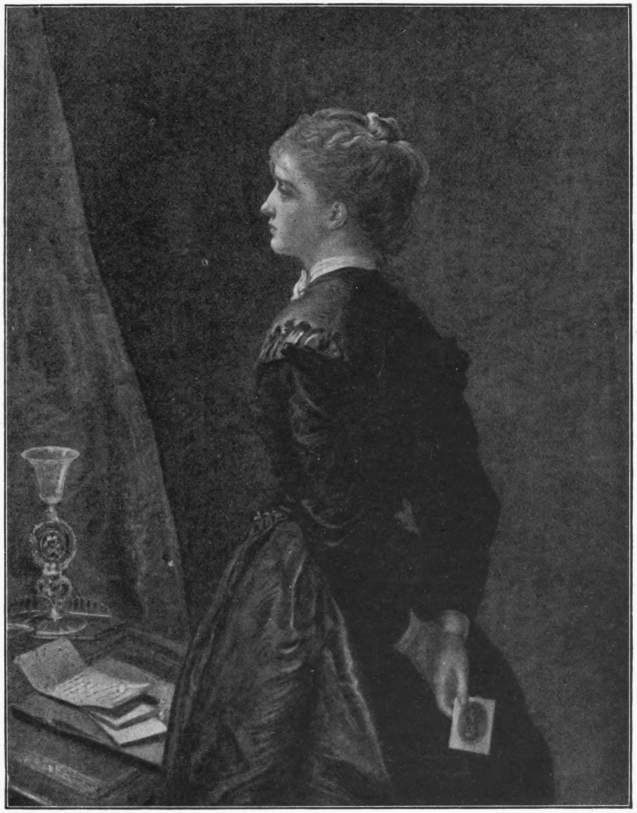 | |
| Cassell & Co. | |
| MILLAIS. | YES OR NO? |
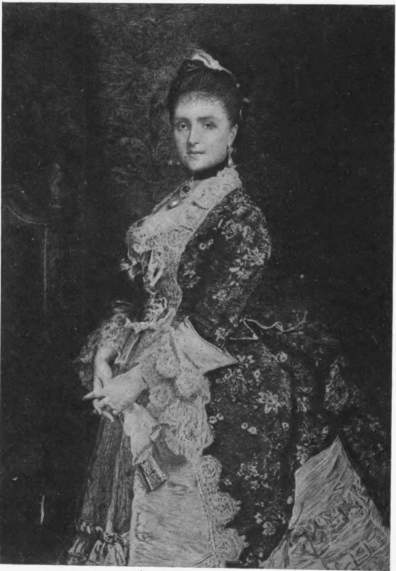 |
| L’Art. |
| MILLAIS. MRS. BISCHOFFSHEIM. |
| (By permission of Mrs. Bischoffsheim, the owner of the picture.) |
Up to the seventies Millais continued to paint such pictures out of the Bible, or from English and mediæval poets, with varying success. One of them, which in its brilliant colouring looked like an old picture upon glass, represented the return of the dove to Noah’s ark. The central point was formed by two slender young women in mediæval costume, who received the exhausted bird in their delicate hands. The picture, “The Woodman’s Daughter,” was an illustration to a poem by Coventry Patmore, on the love of a young noble for a poor child of the wood. In a semicircular picture of 1852 he painted Ophelia as she floats singing in the green pool where the white water-lilies cover her like mortuary wreaths—floats with her parted lips flickering with a gentle smile of distraction. The other picture of this year, “The Huguenot,” represented two lovers taking leave of each other in an old park upon the eve of St. Bartholomew. She is winding a white scarf round his arm to save him from death by this badge of the Catholics, whilst he is gently resisting. The mood of the man standing before the dark gate of death, the moral strength which vanquishes his fear, and all the solemnity of his farewell to life are expressed in his glance. A world of love rests in the eyes of the woman. Millais has often treated this problem of the loving woman with earnest and almost sombre realism, that knows no touch of swooning sentimentality. “The Order of Release” of 1853 shows a jailor in the scarlet uniform of the eighteenth century opening a heavy prison door to set at liberty a Highlander, whose release has been obtained by his wife. A scene from the seventeenth century is treated in “The Proscribed Royalist”: a noble cavalier, hidden in a hollow tree, is kissing the hand of a graceful, trembling woman, who has been daily bringing him food at the risk of her life. “The Black Brunswicker” of 1856 closed this series of silent and motionless dramas. In the picture of 1857, “Sir Isumbras at the Ford,” an old knight is riding home through the twilight of a sultry day in June. The dust of the journey lies upon his golden armour. At a ford he has fallen in with two children, and has lifted them up to carry them over the water. And “The Vale of Rest,” a picture deep and intense in its scheme of colour, earnest and melancholy as a requiem, revealed—with a sentiment a little 27 like that of Lessing—a cloister garden where two nuns are silently preparing a grave in the evening light; while “The Eve of Saint Agnes” in 1863 illustrated the same poem of Keats to which ten years previously Holman Hunt had devoted his work of early years. Madeleine has heard the old legend, telling how girls receive the tender homage of their future husbands if they go through their evening prayer supperless at midnight. With her heart filled with the thoughts of love she quits the hall where the guests are seated at a merry feast, and mounts to her room so hastily that her thin taper is extinguished on the way. She enters her little chamber, kneels down, repeats the prayer, 28 and rises to her feet, taking off her finery and loosening her hair. The clear moonlight streams through the window, throwing a ghostly illumination over the little images of saints in the room, falling like a caress upon the tender young breast of the girl, playing upon her folded hands, and touching her long, fair hair with a radiance like a vaporous glory. In the shadow of the bed she sees him whom she loves. Motionless, as in a dream, she stands, nor ventures to turn lest the fair vision should vanish. “The Deliverance of a Heretic condemned to the Stake,” “Joan of Arc,” “Cinderella,” “The Last Rose,” that dreamy picture of romantic grace, “The Childhood of Sir Walter Raleigh,” and the picture of the hoary Moses, supported by Hur and Aaron, watching from the mountain-top the victory of Joshua, were the principal works achieved in the later years of the master. But when these pictures were executed England had become accustomed to honour Millais, not as a pre-Raphaelite, but as her greatest portrait painter.
 | |
| MILLAIS. | THOMAS CARLYLE. |
His portrait of himself explains this transformation. With his white linen jacket and his fresh sunburnt face Sir John Millais does not look in the least like a “Romanticist,” scarcely like a painter; he has rather the air of being a wealthy landowner. He was a man of a sound and straightforward nature, a great and energetic master, conscious of his aim, but a poet in Ruskin’s sense of the word is what he has never been. His pre-Raphaelitism was only a flirtation. His methods of thought were too concrete, his hand too powerful, for him to have lingered always in the world of the English poets, or endured the precise style of the pre-Raphaelites. “Millais will ‘go far’ if he will only change his boots,” About had written on the occasion of the World Exhibition of 1855; when that of 1867 was opened Millais appeared in absolutely new shoes. The great exhibition of 1857 in Manchester, which made known for the first time how many of the works of Velasquez were hidden in English private collections, had helped Millais to the knowledge of himself. From the naturalism of the Quattrocentisti he made a transition to the naturalism of Velasquez.
Millais was a born portrait painter. His cool and yet finely sensitive nature, his simple, manly temperament, directed him to this department, which rather gravitates to the observant and imitative than to the creative pole of art. In his pictures he has the secret of enchanting and of repelling; he has arrived at really definite issues in portrait painting. His likenesses are all of them as convincing as they are actual. Together with the Venetians and with Velasquez, Millais belongs to the master spirits of the grand style, which relies upon the large movement of lines, in figure and in face, upon the broad foundation of surfaces, and the strict subordination of individual details. His figures are characteristic and recognisable even in outline. He makes no effort to render them interesting by picturesque attitudes, or to vivify them by placing them in any situation. There they stand calm, and sometimes stiff and cold; they make no attempt at conversation with the spectator, nor come out of themselves, as it were, but fix their eyes upon him with an air of well-bred composure and indifference. Even the hands are not made use of for characterisation.
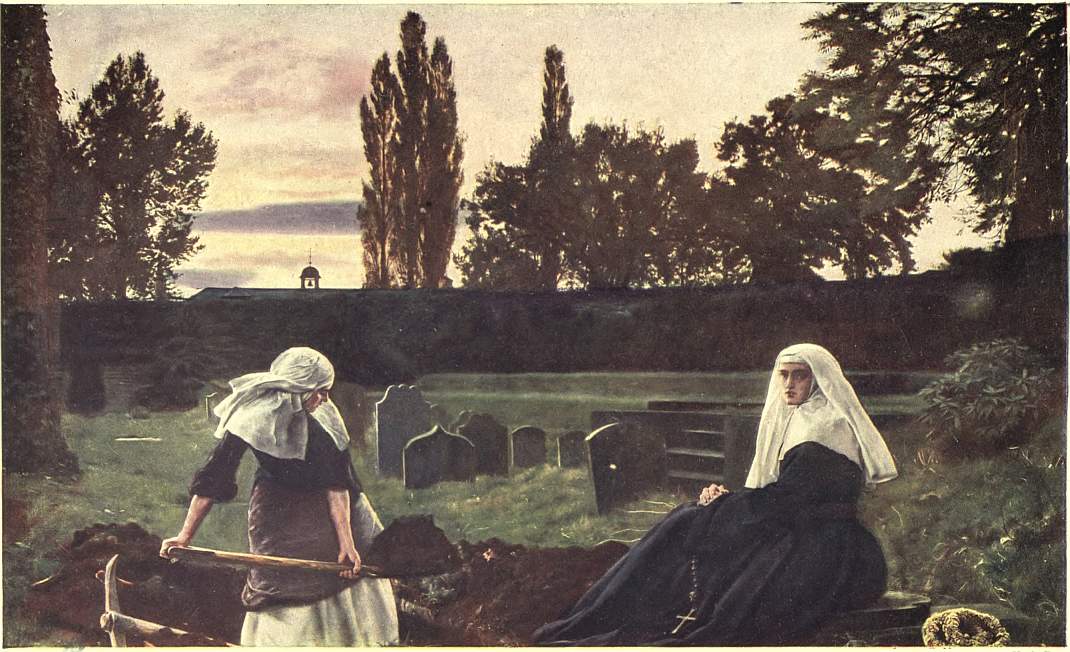 | |
| Cassell & Co. | |
| MILLAIS. | THE VALE OF REST. |
The extraordinary intensity of life which sparkles in his great figures, so simply displayed, is almost exclusively concentrated in the heads. Millais is perhaps the first master of characterisation amongst the moderns. To bold and powerful exposition there is united a noble and psychical gaze. The eyes which he paints are like windows through which the soul is visible.
 | |
| Mag. of Art. | |
| FORD MADOX BROWN. | THE LAST OF ENGLAND. |
Amongst his portraits of men, those of Gladstone and Hook stand in the first rank: as paintings perhaps they are not specially eminent; both have an opaque, sooty tone, from which Millais’ works not unfrequently suffer, but as a definition of complex personalities they are comparable only with the best pictures of Lenbach. How firmly does the statesman hold himself, despite his age, the old tree-feller, the stern idealist, a genuine English figure chiselled 30 out of hard wood. The play of light centres all the interest on the fine, earnest, and puckered features, the lofty forehead, the energetic chin, and the liquid, thoughtful eyes. All the biography of Gladstone lies in this picture, which is simpler and greater in intuition than that which Lenbach painted of him. Hook, with his broad face, furrowed with wrinkles, looks like an apostle or a fisher. Millais has looked into the heart of this man, who has in him something rugged and faithful, massive and tender; the painter of vigorous fishermen and vaporous sunbeams. Hook’s landscapes have a forceful, earnest, and well-nigh religious effect, and something patriarchal and biblical lies in his gentle, reflective, and contemplative glance.
In his portrait of the Duke of Westminster, painted in 1878, Millais depicts him in hunting dress, red coat, white corduroys, and high, flexible boots, as he stands and buttons on his glove. The same year “The Yeoman of the Guard” was exhibited in Paris—the old type of discipline and loyalty, who sits there in his deep red uniform, with features cast in bronze, like a Velasquez of 1878. Disraeli, Cardinal Newman, John Bright, Lord Salisbury, Charles Waring, Sir Henry Irving, the Marquis of Lorne, and Simon Fraser are all worthy descendants of the eminent men whom Reynolds painted a century before. The plastic effect of the figures is increased by the vacant, neutral ground of the picture. Like Velasquez, Millais has made use of every possible background, from the simplest, from the nullity of an almost black or bright surface, to richly furnished rooms and views of landscape. Sometimes it is only indicated by a plain chair or table that the figure is standing in a room, or a heavy crimson curtain falls to serve as a repoussoir for the head. With a noble abstention he avoids prettiness of line and insipid motives, and remains true to this virile taste even in his portraits of women. His women have curiously little of the æsthetical trait which runs elsewhere through English portraits of ladies. Millais renders them—as in the picture “Dummy Whist”—neither sweet nor tender, gives them nothing arch, sprightly, nor triumphant. Severe and sculptural in their mien, and full of character rather than beauty, proud in bearing and upright in pose, their serious, energetic features betray decision of character; and the glance of their brown eyes—eyes like Juno’s—is indifferent and almost hard. A straight and liberal forehead, a beautifully formed and very determined mouth, and a full, round chin complete this impression of earnest dignity, august majesty, and chilling pride. To this regular avoidance of every trace of available charm there is joined a strict taste in toilette. He prefers to work with dark or subdued contrasts of colour, and he is also fond of large-flowered silks—black with citron-yellow and black with dark red.
 | |
| FORD MADOX BROWN. | Mag. of Art. WORK. |
| (By permission of the Corporation of Manchester, the owners of the picture.) | |
And this same stringent painter of character commands, as few others, the soft light brush of a painter of children. No one since Reynolds and Gainsborough has painted with so much character as Millais the dazzling freshness of English youth; the energetic pose of a boy’s head or the beauty of an English girl—a thing which stands in the world alone: the soft, glancing, silken locks, rippling to a blonde cendrée, pale, delicate little faces, pouting little mouths, and great, shining blue, dreamy, childish eyes. Sometimes they stand in rose-coloured dresses embroidered with silver in front of a deep green curtain, or sit reading upon a dark red carpet flowered with black. At other times they are arrayed like the little Infantas of Velasquez, and play with a spaniel like the Doge’s children of Titian, or hold out with both hands an apron full of flowers, which Millais paints with a high degree of finish. A spray of pale red roses, chrysanthemums, or lilies stands near. One must be a great master of characterisation to paint conscious, dignified, and earnest feminine beauty like that of Mrs. Bischoffsheim, and at the same time that fragrant perfume of the fresh and dewy spring of youth which breathes from Millais’ pictures of children.
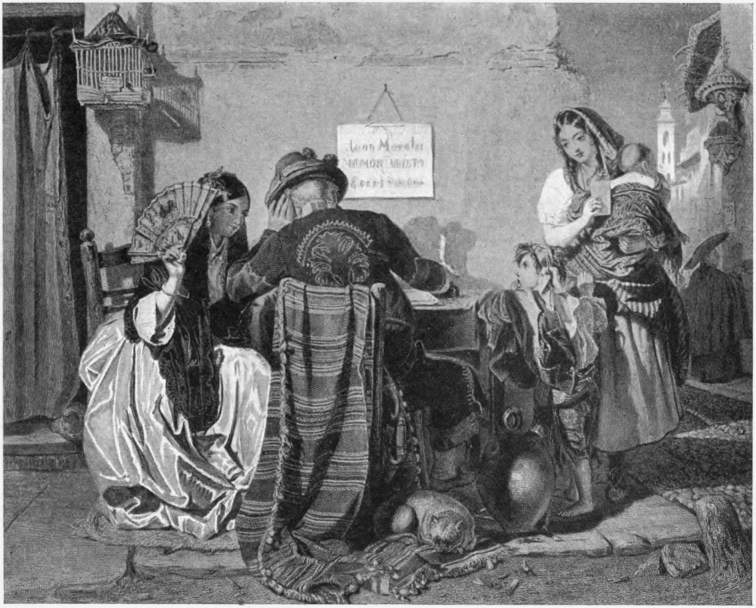 | |
| PHILLIP. | THE LETTER-WRITER, SEVILLE. |
Millais is one of those men in the history of nineteenth-century painting who are as forcible and healthy as they are many-sided. I do not know one who could have developed so swiftly from a style of the most minute exactness to one of the most powerful breadth; not one who could have united such poetry of conception with such an enormous knowledge of human beings; not one who could have been so like Proteus in variety—at one moment charming, at another dreamy, at another entirely positive. In their firm structure and 34 largeness of manner his landscapes sometimes recall Théodore Rousseau. And now the pre-Raphaelite is just a little evident in an excess of detail. He paints every blade of grass and every small plant, though there is at the same time a largeness in the midst of this scrupulous exactitude. He does not merely see the isolated fact through a magnifying lens, but has eyes that are sensitive to the poetry of the whole, and in spite of all study of detail he sometimes reaches a total effect which is altogether impressionist. His picture “Chill October” has an airy life, a grey, vibrating atmosphere, such as only John Constable painted elsewhere.
Such a concrete study of nature as was made by the pre-Raphaelites of necessity led at last to entirely realistic pictures from modern life. In their biblical and poetic pictures they had started from the conviction that new life-blood could only be poured into the old conventional types, which had gradually become meaningless by tactfully drawing the models for them from popular life. They believed, as the masters of Florence and Bruges had done before them, that there could be no good painting without strict dependence on the model; that it was of the utmost importance to give a poetic or legendary figure the stamp of nature, the strong savour of individuality. All their creations are based upon the elements of portrait painting, even when they illustrate remote scenes from the New Testament or from mediæval poetry. And these elements at last led them altogether to give up transposing such figures into an alien milieu, and simply to paint what was offered by their own surroundings. In this way they reached the goal which was arrived at in French painting through Courbet and Ribot. It is due in the first place to the pre-Raphaelites that the well-meant and moderately painted genre picture of the old style, which, with its wealth of pathetic stories, was once a prime source of supposed artistic pleasure, was finally vanquished in England, and made way for earnest and vigorous painting,—painting which sought to make its effect by purely artistic means, and proudly declined attempt to conceal intrinsic weakness in “interesting” subject drawn from external sources. As early as 1855 Millais exhibited a picture in the Royal Academy which Ruskin called a truly great work containing the elements of immortality—“The Rescue.” It represented a fireman who has carried three children from a burning house and laid them in the arms of their parents. Narrative purport was entirely renounced. The fireman was treated without sentimentality, and in a way that suggested the cool fulfilment of a duty, and the agitation of the parents was also rendered without any dash of melodrama. Then there followed that masterpiece of exquisite and soft colouring, tender and moving expression, and infinite grace, “The Gambler’s Wife,” sadly taking up the cards which have brought her misery upon her. In 1874 was painted “The North-West Passage,” a sort of modern symbol of the forceful, enterprising English people who have populated and subdued half the world from their little island kingdom. “There is a passage to the Pole, and England will find it—must find it.” These are more or less the words spoken by Trelawney, 35 the old friend and comrade of Byron in Greece. With a chart before him he is brooding over the plan of the North-West Passage, and upon his own outstretched hand, which would fain hold the future in its grasp, the hand of a youthful woman is soothingly laid, as she sits at his feet reading to him the narrative of the last voyage of discovery. The figure of the seaman with his white beard has a strong, sinewy life, and the broad daylight streams through the room, filled with charts and atlases. The sea and clear, bright sky gleam through the open window. It is a powerful and moving picture, one of those modern creations in which the ideas of the nineteenth century are concentrated with simplicity and a renunciation of all hollow emphasis.
 | |
| PHILLIP. | SPANISH SISTERS. |
A few pictures of modern life which have nothing in common with the older genre painting may even be found among the works of the devotionalist Holman Hunt. “Awakened Conscience,” according to the explanation of the painter, tells the story of a young woman seduced by a cruel and light-minded man, and kept in a luxurious little country-house. They are together. Seated at the piano he is playing the old melody “Oft in the Stilly Night,” and the strains of the song recall to the frail maiden her youth, and the years of purity and innocence. Thus even Hunt has not overcome the moralising tendencies of Hogarth, though his taste is more discreet and delicate. He has struck deeper chords of thought than the English public had heard before. And in particular the painting is not a mere substratum for the story; it has become the principal thing, and the story subsidiary. In another picture, “May Morning on Magdalen Tower,” he renounced all deeper purpose altogether, and merely painted a number of Oxford dons and students, who, in accordance with the old custom, usher in the May with a hymn from the college tower.
But the most remarkable work of this description has been executed by Madox Brown, the English Menzel, who has not merely reconstructed the environment of past ages with the accuracy of an eye-witness, but has looked upon the drama of modern life as an attentive observer. His first picture, “The Last of England,” was executed in the June of 1852, at a time when emigration to America began to take serious proportions. A married couple, humble, middle-class people, are sitting on the deck of a ship. The man, in his thick cloth overcoat, with a soft felt hat on his head, a pale face, and sunken eyes with dark rings underneath, casts one more look upon his native-land, which vanishes in the hazy distance, as he thinks bitterly of lost hopes and vain struggles. But the young wife, in a light-coloured cloak and a pretty round bonnet with wide strings, gazes before her with gentle resignation, from underneath a great umbrella protecting her from the boisterous sea-wind.
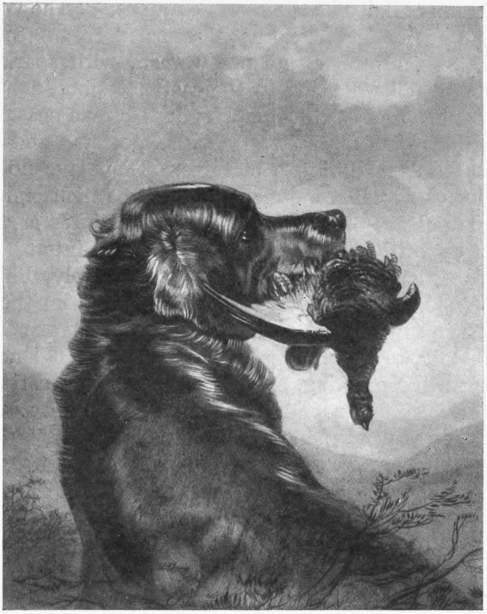 |
| R. ANSDELL. A SETTER AND GROUSE. |
In “Work,” begun at the same period, and finished, after various interruptions, in 1865, he has produced the first modern picture of artisans after Courbet’s “Stone-breakers.” The painter, who was then living in Hampstead, where extensive cuttings were being made for the laying down of gas-pipes, daily saw the English artisan at labour in all his thick-set strength. This gave him the theme for his picture. In bright daylight on a glaring summer afternoon artisans are digging a trench for gas-pipes in a busy street. Women and poor children are standing near. Even the older genre artists had painted men in their working blouses, but only 37 joking and making merry, never at work. Like stage-managers who are sure of their public, they always set the same troop of puppets dancing. Madox Brown’s artisans are robust and raw-boned figures; where the older artists affected to be witty with their genre painting, Madox Brown painted straightforwardly, without humour and without making his figures beautiful. The composition of his pictures is just as plain. No one poses, no one makes impassioned gestures, no one thinks of grouping himself with his neighbour in fine flowing lines. It is pleasant to think that this powerful symbol of work has passed by presentation into the possession of one of the greatest manufacturing towns in England, into the gallery of Manchester.
A Scotchman, born in Aberdeen, John Phillip was the vigorous abettor of the pre-Raphaelites in these realistic endeavours. He, too, was a painter in the full meaning of the word, and he has therefore left works with which the future will have to reckon. Velasquez had opened his eyes as he had opened those of Millais. When Phillip went to Spain in 1851, he was not the first who had trod the Museo del Prado. Wilkie had painted in Spain before him, and Ansdell had been busy there at the same time. But no one had been able to grasp in any degree the impressive majesty of the old Spanish painters. John Phillip alone gained something of the verve of Velasquez, a broad, virile technique which distinguishes him from all his English contemporaries. The impression received from his pictures is one of opulence, depth, and weight; they unite something of the strength of Velasquez to a more Venetian splendour of colour. The streets of Seville, the Spanish port on the Guadalquivir, the town where Velasquez and Murillo were born, were his chief field of study. Here he saw those market-women, black as mulattoes and sturdy as grenadiers, who sit in front of their fruit-baskets under a great umbrella, and those water-carriers with sunburnt visages, strongly built chests, and athletic arms.
After he had returned to Scotland he occasionally painted pictures of 38 ceremonies, “The House of Commons,” “The Wedding of the Princess Royal,” and so forth, but he soon returned to subjects from Spanish life. Gipsy-looking, cigarette-smoking women, with sparkling eyes and jet-black hair, young folks dancing to the castanets, bull-fighters with glittering silver-grey costume and flashing glances, dark-brown peasants in citron-yellow petticoats, hollow-eyed manufactory girls, potters, and glass-blowers.—such are the materials of Phillip’s pictures. They give no scope to anecdote; but they always reveal a fragment of reality which emits a world of impressions and an opulence of artistic ability. As painter par excellence, John Phillip stands in opposition to older English genre painters. Whilst they were, in the first place, at pains to tell a story intelligibly, Phillip was a colourist, a maître peintre, whose figures were developed from the colours, and whose creations are so full of character that they will always assert their place with the best that has ever been painted. Even in England, the country of literary and narrative painting, art was no longer an instrument for expressing ideas; it had become an end in itself, and had discovered colour as its prime and most essential medium of expression.

CHAPTER XXIX
REALISM IN GERMANY
In Germany the realistic movement was carried out in much the same way as in France, though it came into action two decades after its French original. Here also it was recognised that the well-meant but badly painted anecdote must give way to the well-painted picture: and if we inquire who it was that gave to Germany the first serious paintings inspired by the modern spirit the reply, without hesitation, must be Adolf Menzel. The pioneering work of this great little man, who for fifty years had embodied in their typical perfection all phases of German art, is something fabulous: the greatest and, one might almost say, the only historical painter of bygone epochs, the only one who knew a previous period so intimately that he could venture on painting it, was also the leader of the great movement which, in the seventies, aimed at the representation of our own life. His first appearance was in the time when the proud Titan Cornelius sought to take heaven by storm. Little Menzel was no Titan in those days; he seems in that generation like one bound to the earth, yet he belonged to the Cyclopean race. He was a mighty architect with the powers of a giant; and this uncouth Cyclops rough-hewed and chiselled the blocks, and, fitting each in its place, raised an edifice to as lofty a height as the Romanticists had reached on the perilous wings of Icarus. Having been first the draughtsman and then the painter of Frederick the Great, he gave up history after finishing the picture of the Battle of Hochkirch: his talent was too modern, too much set upon what was concrete, to admit of its being given full scope to the end by constructive work from a milieu that was not his own. Until his fortieth year he had celebrated the glorious past of his country. When, with the death of Friedrich Wilhelm IV, a great and decisive turn was given to the politics of the Prussian state—one which put an end to the stagnation of civil life in Prussia and Germany, and ushered in a new and brilliant period for the realm and the heirs of Friedrich—the painter of Friedrich the Great became the painter of the new realm. After he had already, in the first half of the century, placed reality on the throne of art in the place of rhetoric and a vague ideal, he went one step further in the direction of keen and direct observation, and now painted what he saw around him—the stream of palpitating life.
“The Coronation of King Wilhelm at Königsberg” is the great and triumphant title-page to this section of his art. The effects of light, the red 40 tones of the uniforms, the shimmering white silk dresses, the surging of the mass of people, the perfect ease with which all the personages are individualised, the princes, the ministers, the ambassadors, the men of learning, the instantaneousness in the movement of the figures, the absolutely unforced and yet subtle and pictorial composition, render this painting no picture of ceremonies, in the traditional sense of the phrase, but a work of art at once intimate and august in the impression which it makes. In the picture “King Wilhelm setting out to join the Army”—the representation of the thrilling moment, on the afternoon of 31st July 1870, when the King drove along the linden avenue to the railway station—this phase, which he began with the Coronation picture, was brought to a close. Everything surges and moves, speaks and breathes, and glows with the palpitating life which vibrates through all in this moment of patriotic excitement. But the painter’s course led him further.
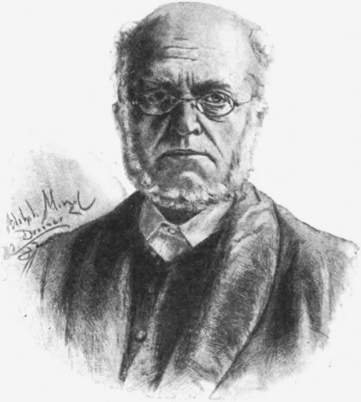 |
| ADOLF MENZEL. |
He first became entirely Menzel when he made the discovery of toiling humanity. In 1867, in the year of the World Exhibition, he came to Paris and became acquainted with Meissonier and Stevens. With Meissonier in particular—whose portrait he painted—he entered into a close friendship, and it was curious afterwards to see the two together at exhibitions—the little figure of Menzel with his gigantic bald forehead and the little figure of Meissonier with his gigantic beard, a Cyclops and a Gnome, two kings in the realm of Liliput, of whom one was unable to speak a word of German and the other unable to speak a word of French, although they had need merely of a look, a shrug, or a movement of the hand to understand each other entirely. He also came into the society of Courbet, who had just made the famous separate exhibition of his works, at the Café Lamartine, in the company of Heilbuth, Meyerheim, Knaus, and others. Here in Paris he produced his first pictures of popular contemporary life, and if as an historical painter he had already been a leader in the struggle against theatrical art, he became a pioneer in these works also. Everywhere he let in air and made free movement possible for those who pressed forward in his steps. In the course of years he painted and drew everything which excited in him artistic impulse upon any ground whatever, and not one of these endeavours was work thrown away. A universal genius amongst the painters of real life, he combined all the qualities of which other men of excellent talent merely possessed fragments separately apportioned 41 amongst them: the sharpest eye for every detail of form, the most penetrative discrimination for the life of the spirit, and at times a glistening play of colour possessed by none of his German predecessors.
 | |
| MENZEL. | FROM KUGLER’S “HISTORY OF FRIEDRICH THE GREAT.” |
Catholic churches seem always to have had a great attraction for him, as well as the people moving in them, and in this an echo of his rococo enthusiasm is still perceptible. The quaint, rococo churches in the ornate style favoured by the Jesuits, which are still preserved intact in Munich and the Tyrol, were those for which he had a peculiar preference. He lost himself voluptuously in the thousand details of sculpture, framework, organs, balustrades, and carved pulpits, dimly outlined in the subdued light from stained-glass windows. In the gloom it was all transformed into a forest of ornaments, expanding their traceries like trees in a wood. Sick and infirm people, women in prayer burying their faces in their hands, and lame men with crutches, kneel or move amid the luxuriant efflorescence of stone and wood and gold, of angels’ heads and shrines, garlands of flowers, consoles, and fonts of holy water. Twisted marble pillars, church banners, lamps and lustres mount in a confusion of capricious outlines at once tasteful and piquant to the vaulted dome, where 42 the painted skies, blackened by the ascending mist of incense, seem waywardly fantastic.
After the churches the salons appealed to him. There came his pictures of modern society: ladies and cavaliers of the Court upon ballroom balconies, the conversation of Privy Councillors in the salon, the marvellous ball supper, where a mass of beautiful shoulders, splendid uniforms, and rustling silken trains move amid mirrors, lustres, colonnades, and gilded frames. “The Ball Supper” of 1870 is a vivid picture, bathed in glistening light. The music has stopped. And from a door of the brilliantly lighted ballroom the company is streaming into the neighbouring apartment, where the supper-table has been laid, and groups of ladies and men in animated conversation are beginning to occupy the chairs and sofas. In 1879 there followed the famous “Levee”: the Emperor Wilhelm in the red Court uniform of the Gardes du Corps is talking with a lady, surrounded by a sea of heads, uniforms, and naked bowing shoulders. Though it was always necessary in earlier representations of the kind to have a genre episode to compensate the insufficient artistic interest of the work, in Menzel’s pictures the pictorial situation is grasped as a whole. They have the value of a book; they neither falsify nor beautify anything, and they will hand down to the future an encyclopædia of types of the nineteenth century.
From the salon he went to the street, from exclusive aristocratic circles into the midst of the eddying crowd. For many years in succession Menzel was a constant visitor at the small watering-places in the Austrian and Bavarian Alps. The multitude of people at the concerts, in the garden of the restaurant, on the promenade, at the open-air services, were precisely the things to occupy his brush. The light rippled through the leaves of the trees; women, children, and well-bred men of the world listened to the music or the words of the preacher. One person leaves a seat and another takes it; everything lives and moves. Huge and lofty trees stretch out their arms, protecting the company from the sun. Unusually striking was “The Procession in Gastein”: in the centre was the priest bearing the Host, then the choristers in their red robes, in front the visitors and tourists who had hastened to see the spectacle, and in the background the mountain heights. The bustle of people gives Menzel the opportunity for a triumph. In Kissingen he painted the promenade at the waters; in Paris the Sunday gaiety in the garden of the Tuileries, the street life upon the boulevard, the famous scene in the Jardin des Plantes, with the great elephants and the vivid group of Zouaves and ladies; in Verona the Piazza d’Erbe, with the swarm of people crowding in between the open booths and shouting at the top of their voices. Many after him have represented such scenes, although few have had the secret of giving their figures such seething life, or painting them, like Menzel, as parts of one great, surging, and many-headed multitude.
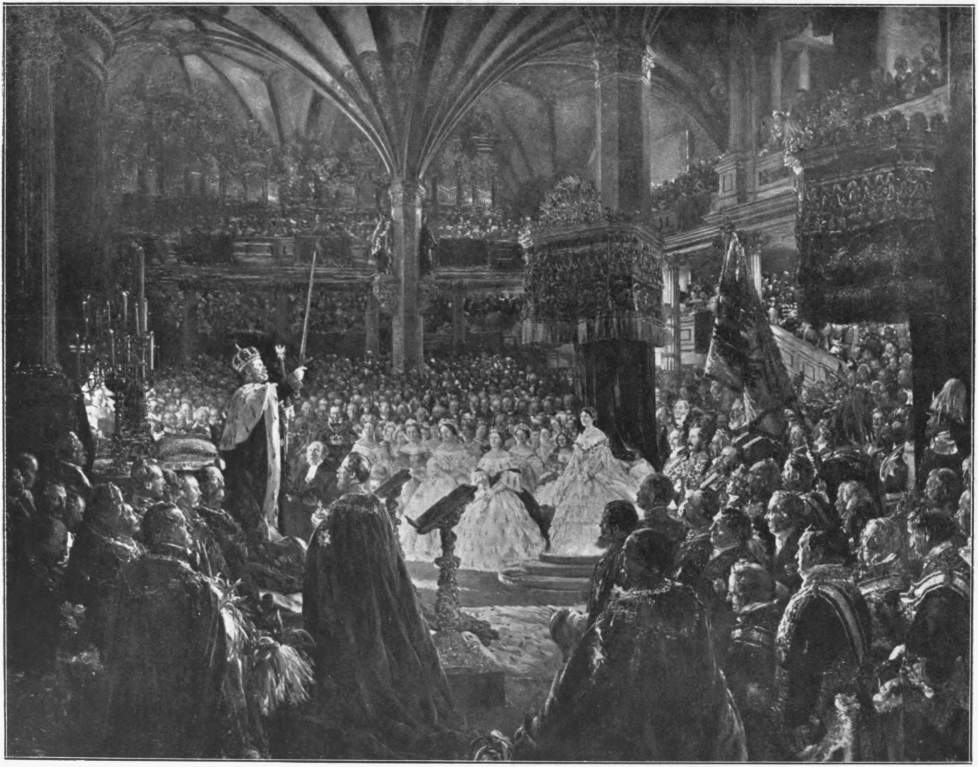 | |
| Hanfstaengl. | |
| MENZEL. | THE CORONATION OF KING WILHELM I. |
People travelling have always been for him a source of much amusement: men sitting in the corner of a railway carriage with their legs crossed and their hats over their eyes, yawning or asleep; women looking out of the windows or counting their ready money. Alternating with such themes are those monotonous yet simple and therefore genial landscapes from the suburbs of the great city, poor, neglected regions with machines and men at their labour. Children bathing in a dirty stream bordered by little, stunted willows; small craft gliding over a river, sailors leaping from one vessel to another, men landing sacks or barrels, and great, heavy cart-horses dragging huge waggons loaded with beer-barrels along the dusty country road. Or the scaffolding of a house is being raised. Six masons are at work upon it, and they are working in earnest. A green bush waves (German fashion) above the scaffolding, and further off long rows of houses stretch away, and the aqueducts and gas-works which supply the huge crater of Berlin, and day-labourers are seen wheeling up barrow-loads of stones. For the first time a German painter sings the canticle of labour.
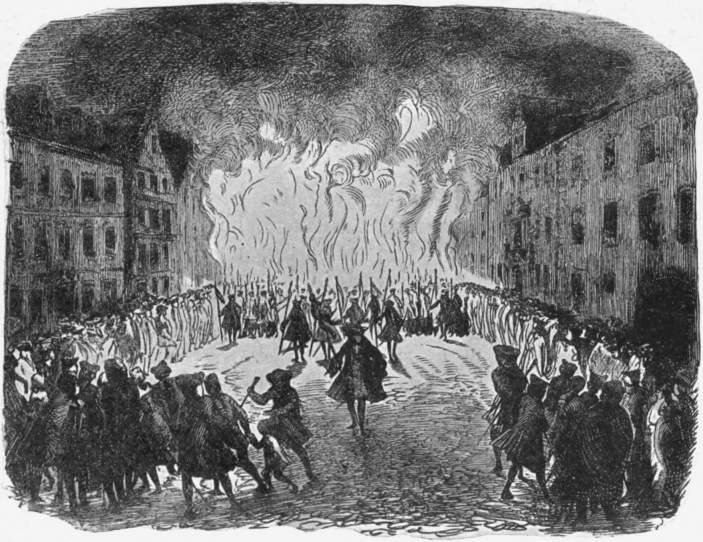 | |
| MENZEL. | FROM KUGLER’S “HISTORY OF FRIEDRICH THE GREAT.” |
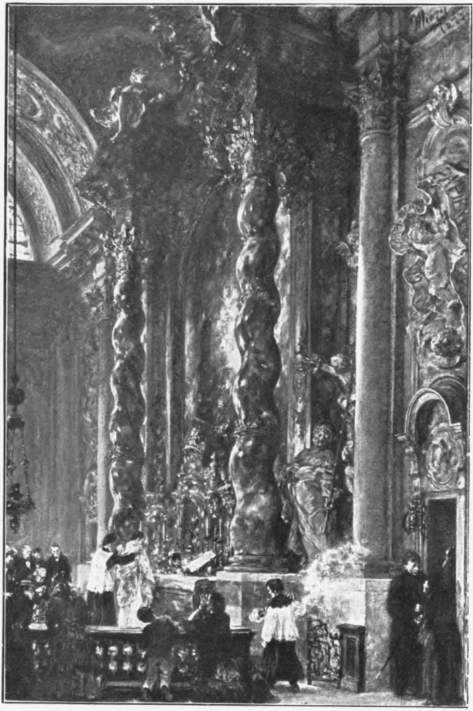 |
| Hanfstaengl. |
| MENZEL. THE DAMENSTIFTSKIRCHE AT MUNICH. |
From the streets he enters the work-places, and interprets the wild poetry of roaring machines in smoky manufactories. The masterpiece of this group is that bold and powerful picture, his “Iron Mill” of 1876. The workshop of the great rail-forge of Königshütte in Upper Silesia is full of heat and steam. The muscular, brawny figures of men with glowing faces stand at the furnace holding the tongs in their swollen hands. Their vigorous gestures recall Daumier. Upon the upper part of their bodies, which is naked, the light 46 casts white, blue, and dark red reflections, and over the lower part it flickers in reddish, greenish, and violet tinges, on the creases in their clothing. The smoke rising in spirals is of a whitish-red, and the beams supporting the roof are lit up with a sombre glow. Heat, sweat, movement, and the glare of fire are everywhere. Dust and dirt, strong, raw-boned iron-workers washing themselves, or exhausted with hard toil, snatching a hasty meal, a confusion of belting and machinery, no pretty anecdote but sober earnest, no story but pure painting—these were the great and decisive achievements of this picture. Courbet’s “Stone-breakers” of 1851, Madox Brown’s “Work” of 1852, and Menzel’s “Iron Mill” are the standard works in the art of the nineteenth century.
Within German art Menzel has won an enclave for himself, a rock amid the sea. In France during the sixties he represented German art in general. France offered him celebrity, and after this recognition he had the fortune to be honoured in his native-land before he was overtaken by old age. His realism was permitted to him at a time when realistic aims were elsewhere reckoned altogether as æsthetic errors. This explains the remarkable fact that Menzel’s toil of fifty years had scarcely any influence on the development of German painting; it would scarcely be different from what it is now if he had never existed. When he might have been an exemplar there was no one who dared to follow him. And later, when German art as a whole had entered upon naturalistic lines, the differences between him and the younger generation were more numerous than their points of sympathy, so that it was impossible for him to have a formative influence. He stood out in the new period merely as a power commanding respect, like a hero of ancient times. Even the isolated realistic 47 onsets made in Berlin in the seventies are in no way to be connected with him.
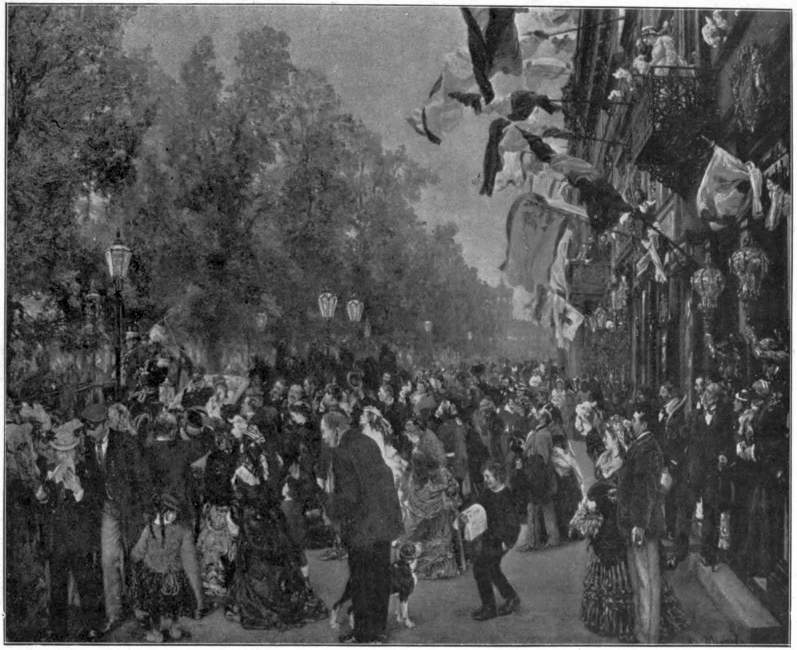 | |
| Hanfstaengl. | |
| MENZEL. | KING WILHELM SETTING OUT TO JOIN THE ARMY. |
If realism consisted in the dry and sober illustration of selected fragments of reality, if upright feeling, loyalty, and honest patriotism were serviceable qualities in art, a lengthier consideration should certainly be accorded to Anton von Werner. In his genre pictures of campaign life everything is spick and span, everything is in its right place and in soldierly order: it is all typically Prussian art. His portraits are casino pictures, and as such it is impossible to imagine how they could better serve their purpose. From the spurs to the cuirassier helmet everything is correct and in accordance with military regulation; even the likeness has something officially prescribed which would make any recruit form front if suddenly brought face to face with such a person. In his pictures of ceremonies his ability was just sufficient to chronicle the function in question with the conscientiousness of a clerk in a law court. The intellectual capacity for seeing more of a great man than his immaculately polished boots and the immaculately burnished buttons of his uniform was denied him, as was the artistic capacity of exalting a picture-sheet to the level of a picture.
Equipped with a healthy though trivial feeling for reality, Carl Güssow ventured to approach nature in a sturdy and robust fashion in some of his works, and exhibited in Berlin a few life-sized figures, “Pussy,” “A Lover of Flowers,” “Lost Happiness,” “Welcome,” “The Oyster Girl,” and so forth. Through these he opened for a brief period in Berlin the era of yellow kerchiefs and black finger-nails, and on the strength of them was exalted by the critics as a pioneer of realism or else anathematised, according to their æsthetic creed. He had a robust method of painting muscles and flesh and clothes of many colours, and of setting green beside red and red beside yellow, yet even in these first works—his only works of artistic merit—he never got beyond the banal and barbaric transcript of a reality which was entirely without interest.
Max Michael seems to be somewhat influenced by Bonvin. Like the latter, he was attracted by the silent motions of nuns, juicy vegetables, dark-brown wainscoting, and the subdued light of interiors. He was, like Ribot in France, although with less artistic power, a good representative of that “school of cellar skylights” which imitated in a sound manner the tone of the old Spanish masters. One of his finest pictures, which hangs in the Kunsthalle in Hamburg, represents a girls’ school in Italy. A nun is presiding over the sewing-lesson; the background is brown; the light comes through the yellow glass of a high and small window (like that of an attic), and throws a brown dusky tone over the room, in which the gay costumes of the little Italian girls, with their white kerchiefs, make exceedingly pretty and harmonious spots of colour. No adventure is hinted at, no episode related, but the picturesque appearance of the little girls, and their tones in the space, are all the more delicately rendered. A refined scheme of colour recalling the old masters compensates for the want of incident.
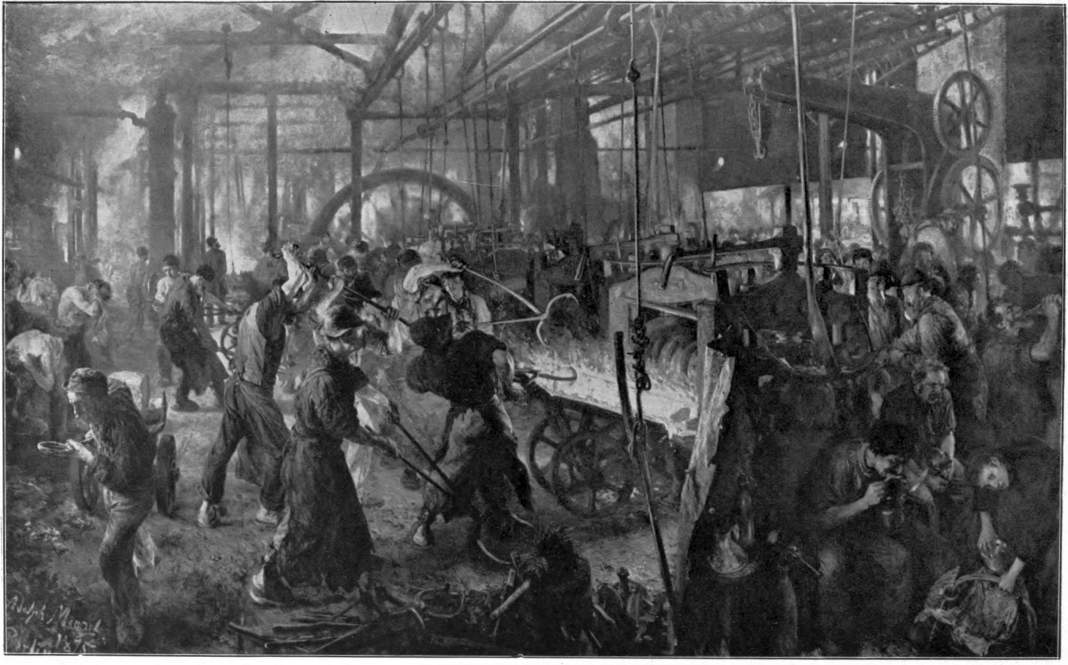 | |
| MENZEL. | Hanfstaengl. THE IRON MILL. |
| (By permission of the Berlin Photographic Co., the owners of the copyright.) | |
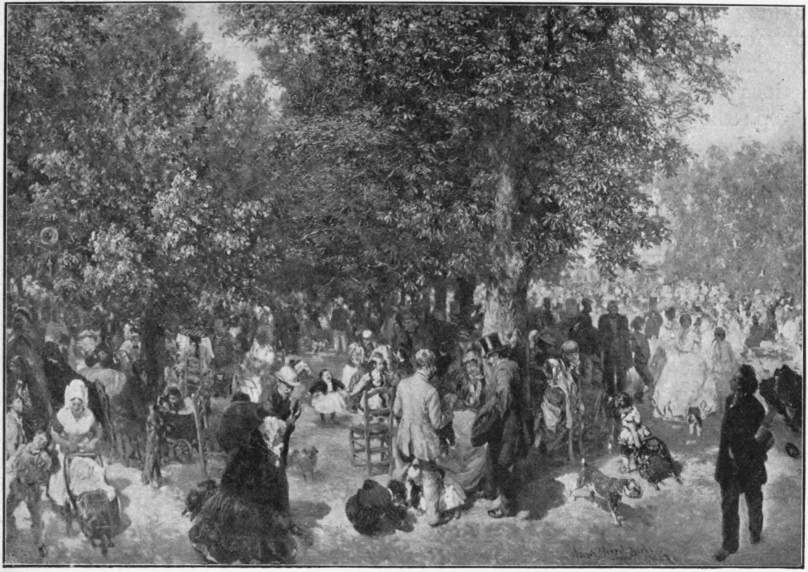 | |
| Hanfstaengl. | |
| MENZEL. | SUNDAY IN THE TUILERIES GARDENS. |
 |
| Hanfstaengl. |
| MENZEL. A LEVEE. |
In Vienna August von Pettenkofen made a transition from the ossified, antediluvian genre painting to painting which was artistically delicate. While the successors of Gauermann and Danhauser indulged in heart-breaking scenes or humorous episodes, Pettenkofen was the first to observe the world from a purely pictorial point of view. Alfred Stevens had opened his eyes in Paris in 1851. Troyon’s pictures and Millet’s confirmed him in his efforts. He was brought up on a property belonging to his father in Galicia, and had been a cavalry officer before he turned to painting: horses, peasants, and oxen are the simple figures of his pictures. In the place of episodic, ill-painted stories he set the meagre plains of lonely Pusta, sooty forges, gloomy cobblers’ work shops, dirty courtyards with middens and rubbish-heaps, gipsy encampments, and desolate garrets. There is no pandering to sentimentality or the curiosity excited by genre painting. There are delicate chords of colour, and that is enough. The artist was in the habit of spending the summer months in the little town of Spolnok on the Theiss, to the east of Pesth. Here he wandered about amongst the little whitewashed houses, the booths of general dealers, and the fruit-sellers’ stalls. A lazily moving yoke of oxen with a lad asleep, dark-eyed girls fetching water, poor children playing on the ground, old men dreaming in the sun in a courtyard, are generally the only breathing beings in his pictures. Here is a sandy village-square with low, white-washed houses; there is a wain with oxen standing in the street, or a postilion trotting away on his tired nag. Like Menzel, Pettenkofen paints busy humanity absorbed in their toil, simple beings who do not dream of leaving off work for the sake of those who frequent picture galleries. What differentiates him from the Berlin painter is a more lyrical impulse, something tender, thoughtful, and contemplative. Menzel gives dramatic point to everything he touches; he sets masses in movement, depicts a busy, noisy crowd, pressing together and elbowing one another, forcing their way at the doors of theatres or the windows of cafés in a multifarious throng. Pettenkofen lingers with the petty artisan and the solitary sempstress. In Menzel’s “Iron Mill” the sparks are flying and the machines whirring, but everything is peaceful and quiet in the cobblers’ workshops and the sunny attics visited by Pettenkofen. Menzel delights in momentary impressions and quivering life; Pettenkofen in rest and solitude. In the former every one is thinking and talking and on the alert; in the latter every one is yawning or asleep. If Menzel paints a waggon, the driver cracks his whip and one hears the team rattling over the uneven pavement; in Pettenkofen the waggon stands quietly in a narrow lane, the driver enjoys a 52 midday rest, and an enervating, sultry heat broods overhead. Menzel has a love for men and women with excitement written on their faces; Pettenkofen avoids painting character, contenting himself with the reproduction of simple actions at picturesque moments. The Berlin artist is epigrammatically sharp; the Viennese is elegiac and melancholy. Menzel’s pictures have the changing glitter of rockets; those of Pettenkofen are harmonised in the tone of a refined amateur. They have only one thing in common: neither has found disciples; they are not culminating peaks in Berlin or Vienna art so much as boulders wedged into another system.
Whilst the realistic movement in both towns was confined to particular masters, Munich had once again the mission of becoming a guiding influence. Here all the tendencies of modern art have left the most distinct traces, all movements were consummated with most consistency. The heroes of Piloty followed the divinities of Cornelius, and these were in turn succeeded by the Tyrolese peasants of Defregger, and amid all this difference of theme one bond connected these works: for interesting subject was the matter of chief importance in them, and the purely pictorial element was something subordinate. The efforts of the seventies had for their object the victory of this pictorial element. It was recognised that the talent for making humorous points and telling stories, which came in question as the determining quality in the pictures of monks and peasants of the school of Defregger and Grützner, was the expression of no real faculty for formative art—that it was merely technical incompleteness complacently supported by the lack of artistic sensibility in the public which had produced this narrative painting. It was felt that the task of formative art did not consist in narrative, but in representation, and in representation through the most sensuous and convincing means which stood at its disposal. A renewed study of the old masters made this recognition possible.
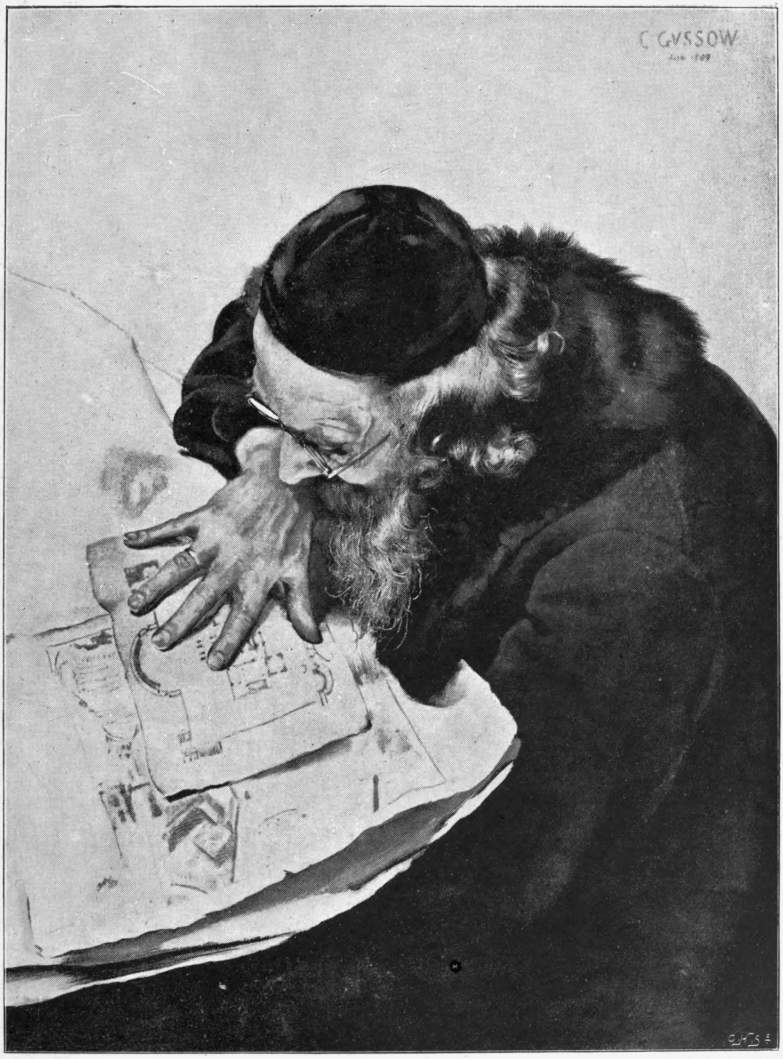 | |
| GÜSSOW. | THE ARCHITECT. |
| (By permission of M. H. Salomonson, Esq., the owner of the picture.) | |
Up to this time the most miserable desolation had also reigned over the province of the artistic crafts. But, borne up by the rekindled sentiment of nationality, and favoured by the high tide of the milliards paid by France, since 1870, that eventful movement bearing the words “Old German” and “Fine Style” on its programme had become an accomplished fact. The German Renaissance, which research had been hitherto neglected, was discovered afresh. Lübke explored it thoroughly and systematically; Woltmann wrote on Hans Holbein, Thausing on Dürer; Eitelberger founded the Austrian Industrial Museum; Georg Hirth brought out his Deutsches Zimmer, and began the publication of the Formenschatz. The national form of art of the German Renaissance was taken up everywhere with a proud consciousness of patriotism: here, it was thought, was a panacea. Those who followed the artistic crafts declared open war against everything pedestrian and tedious. Lorenz Gedon in particular—in union with Franz and Rudolf Seitz—was the soul of the movement. With his black, curly hair, his little, fiery, dark eyes, his short beard, his negligent dress, and his two great hands expert in the exercise of every description of art, he had himself something of the character of an old German stone-cutter. His manner of expressing himself corresponded to this appearance. In every thing it was original, saturated with his own personal conception of the world. As the son of a dealer in old pictures and curiosities, he was familiar with the old masters from his childhood, and followed them in the method of his study. He was far from confining himself to one branch. The façades of houses, the architecture of interiors, tavern rooms and festal decorations, furniture and state carriages, statues and embellishments in stone, bronze, wood, and iron, portrait busts in wax, clay, and marble, models for ornaments, for iron lattices, for the adornment of ships and the fittings of cabins, all objects that were wayward, fantastic, quaint, and curious lay in his province; and for the execution of each in turn this remarkable man felt that he had in him an equal capacity. And, at the same time, the temperament of a collector was united in him with that of an artist in an entirely special way. In the bushy wilderness of a garden before his house in the Nymphenburger Strasse countless stone fragments of mediæval sculpture were strewn about, up to the very hedge dividing it from the street. Rusty old trellises of wrought iron slanted in front of the windows, and in the house itself the most precious objects, which artists ten years before had passed without heed, stood in masses together. As Gedon was taken from his work when he was forty his artistic endeavour never got beyond efforts of improvisation, but the impulse which he gave was very powerful. Through his initiative the whole province of the artistic crafts was brought under observation from a pictorial point of view. The bald Philistine style of decoration gave way and a blithe revel of colour was begun. The great carnival feasts arranged by him on the model of the Renaissance period are an important episode in the history of culture in Munich, and have contributed in no unessential manner to the refinement of taste in the toilette of women. The Munich Exhibition of the Arts and Crafts in 1876 (before the entrance of which he had erected that great portal made of old fragments of architecture, 56 wood-carving, and splendid stuffs, and bearing the inscription “The Works of our Fathers”) indicated the zenith of that movement in the handicrafts which was flooding all Germany in those days.
The course which was run by this movement in the following years is well known, and it is well known how the imitation of the German Renaissance soon became as wearisome as in the beginning it had been attractive. After it had been a little overdone another step was taken, and from the Renaissance people went to the baroque period, and soon afterwards the rococo period followed. In these days sobriety has taken the place of this fever for ornamentation, and the mania for style has resulted in a surfeit, a weariness and a desire for simplicity and quietude. Nevertheless the beneficial influence of the movement on the general elevation of taste is undeniable, and indirectly it was of service to painting.
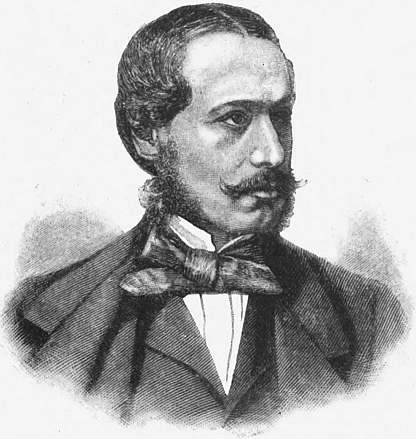 |
| Seeman, Leipzig. |
| AUGUST VON PETTENKOFEN. |
In rooms where the owner was the only article of the inventory repugnant to the conception of style, only those pictures were admitted which had been executed in the exact manner of the old masters. Works of art were regarded as tasteful furniture, and were obliged to harmonise correctly with the other appointments of the room; they had, moreover, to be themselves legitimate “imitations of the Works of our Fathers.” And, in this way, the movement in the handicrafts gave an impulse to a renewed study of the old masters, carried out with far more refinement than had hitherto been the case. Amongst the costume painters spread over all Germany, the experts in costume, working in Munich during the seventies, form a really artistic race of able painters who were peculiarly sensitive to colour. They were the historians of art, the connoisseurs of colour in the ranks of the painters. Piloty did not satisfy them; they buried themselves in the study of old masters with a delicately sensitive appreciation of them; they began to mix soft, luxuriant, and melting colours upon their palettes, and to feel the peculiar joy of painting. Whilst they imitated the exquisite “little masters” of former ages, in dimly lighted studios hung with Gobelins, imitating at the same time the beautifying rust of centuries, they gradually abandoned all their own tricks of art; and whilst they devoted themselves to detail they brought about the Renaissance of oil-painting. Compared with earlier works, their pictures are 57 like rare dainties. They no longer recognised the end of their calling, as the genre painters had done, in a one-sided talent for characterisation, but tried once more to lay chief weight upon the pictorial and artistic appearance of their pictures. They were conscious of a presentiment that there were higher spheres of art than the commonplace humour of genre painting, and this recognition had a very wide bearing. Pictorial point took the place of narrative humour. If artists had previously painted thoughts they now began to paint things, and even if the things were bundles of straw, mediæval hose, and the old robes of cardinals, they were no longer “invented,” but something which had been seen as a whole. It was a transition towards ultimately painting what had actually taken place before the artist’s eyes.
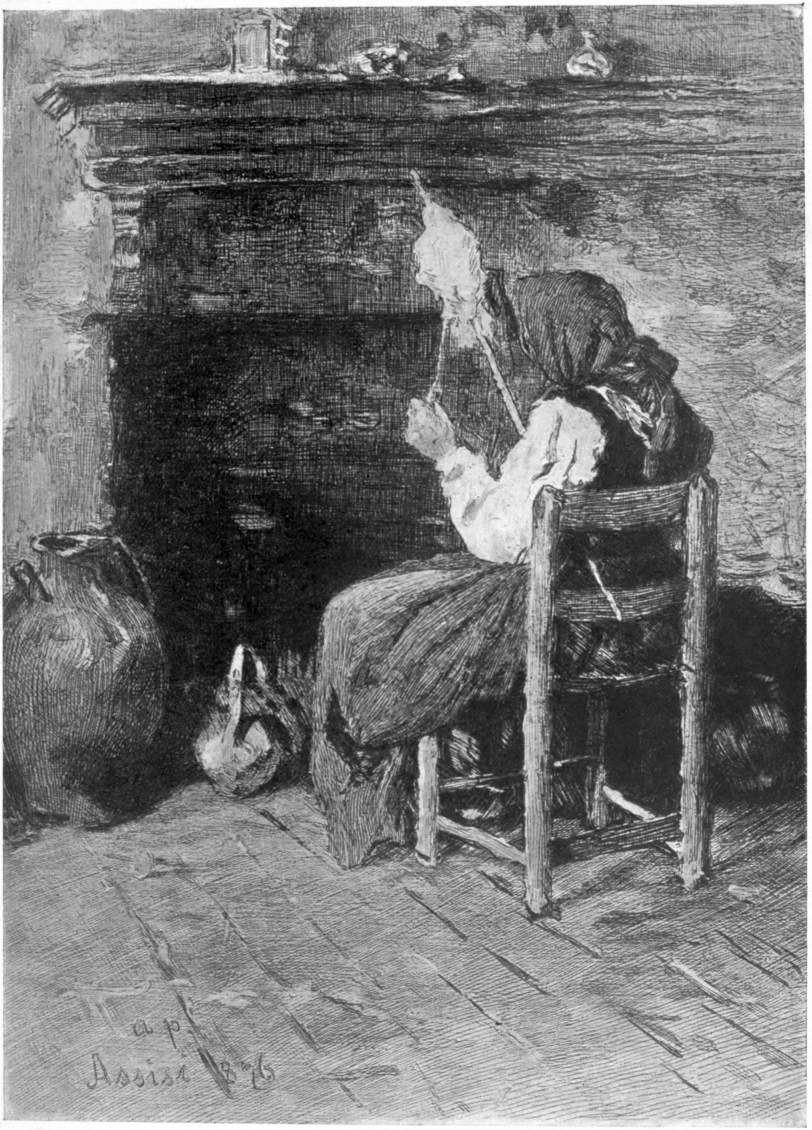 | |
| Seemann, Leipzig. | |
| PETTENKOFEN. | A WOMAN SPINNING. |
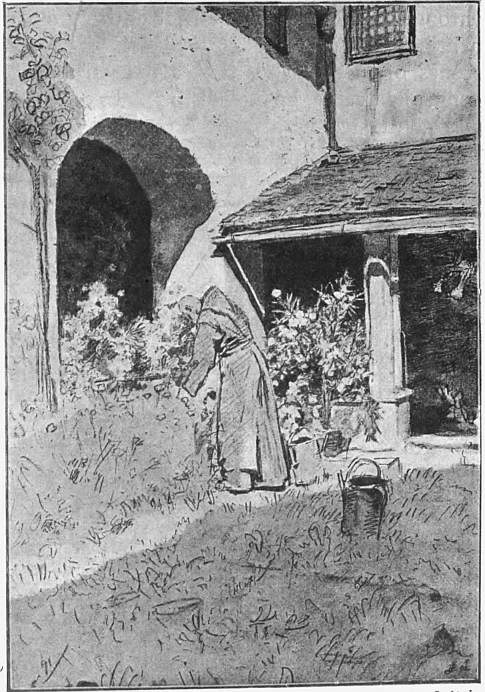 |
| Seemann, Leipzig. |
| PETTENKOFEN. IN THE CONVENT YARD. |
That sumptuous, healthy artist of such pictorial ability, Diez, the Victor Scheffel of painting, stands at the head of the group. From his youth upwards his chief place of resort had been the cabinet of engravings where he studied Schongauer, Dürer, and Rembrandt, and all the boon-companions and vagabonds etched or cut in copper or wood, and on the model of these he painted his own marauders, robber-barons, peasants in revolt, old German weddings and fairs. His picture “To the Church Consecration” recalls Beham, his “Merry Riding” Schongauer, and his “Ambuscade” Dürer, whilst Teniers served as model for his fairs. Diez knows the period from Dürer and Holbein to Rubens, Rembrandt, Wouwerman, and Brouwer as thoroughly as an historian of art, and sometimes—for instance in his “Picnic in the Forest”—he has even drawn the eighteenth century into the circle of his studies. His pictures had an unrivalled delicacy of tone, and could certainly hang beside their Dutch models in the Pinakothek without losing anything by such proximity.
Something of Brouwer or Ostade revived once more in Harburger, the talented draughtsman of Fliegende 60 Blätter, the undisputed monarch of the kingdom of slouching hats, old mugs, and Delft pipes. Pictures like “The Peasants’ Doctor,” “The Card-players,” “The Grandmother,” “By the Quiet Fireside,” “In the Armchair,” and “Easy-going Folk” were masterpieces of delicate Dutch painting: the tone of his pictures shows distinction and temperament; they have deep and fine chiaroscuro, and are soft and fluent in execution. Loefftz with his picture “Love and Avarice” appeared as Quentin Matsys redivivus, and then attached himself in turn to Holbein and Van Dyck; and exercised, like Diez, a great influence on the younger generation by his activity as a teacher.
Claus Meyer, who became one of the best known amongst the young Munich painters by his “Sewing School in the Nunnery” of 1883, is worthy of remark inasmuch as he acquired a method of painting which was full of nuances, through modelling himself upon Pieter de Hoogh and Van der Meer of Delft. Through the windows hung with thin curtains the warm, quiet daylight falls into the room, glancing on the clean boards of the floor, on the polished tops of the tables, the white pages of the books, and the blond and brown hair of the children, playing round it like a golden nimbus. Another sunbeam streams through the door, which is not entirely closed, and quivers over the floor in a bright and narrow strip of light. The intimate representation of peaceful scenes of modest life, the entirely pictorial representation of peaceful and congenial events, has taken the place of the adventures dear to genre painting. Old gentlemen with a glass of beer and a clay pipe, servant-girls peeling potatoes in the kitchen, pupils at the cloister sitting over their books in the library, drinkers, smokers, and dicers—such were the quiet, passive, and silent figures of his later pictures. The mild sunshine breaks in and plays over them. Light clouds of tobacco smoke float in the air. Everything is homely and pleasant, touched with a breath of pictorial charm, comfortable warmth, and poetic fragrance. A hundred years hence his works will be sold as flawlessly delicate and genuine old Dutch pictures. Holmberg became the historian of cardinals. A window, consisting of rounded, clumpy panes, with little glass pictures let in, forms the background of the room, and in the subdued oil-light which beams over splendid vessels and ornaments, chests and Gobelins, the white satin dresses of ladies in the mode of 1640, or the lilac and purple robes of cardinals from the artist’s rich wardrobe, are displayed, together with the appropriate models.
In Fritz August Kaulbach, the most versatile of the group in his adoption of various manners, the essence of this whole tendency is to be found. He did not belong to the specialists who restricted themselves, in a one-sided fashion, to the imitation of the Flemish or the Dutch masters, but appeared like old Diterici, Proteus-like, now in one and now in another mask; and, whether he assumed the features of Holbein, Carlo Dolci, Van Dyck, or Watteau, he had the secret of being invariably graceful and chic.
 | |
| Seemann, Leipzig. | |
| DIEZ. | RETURNING FROM MARKET. |
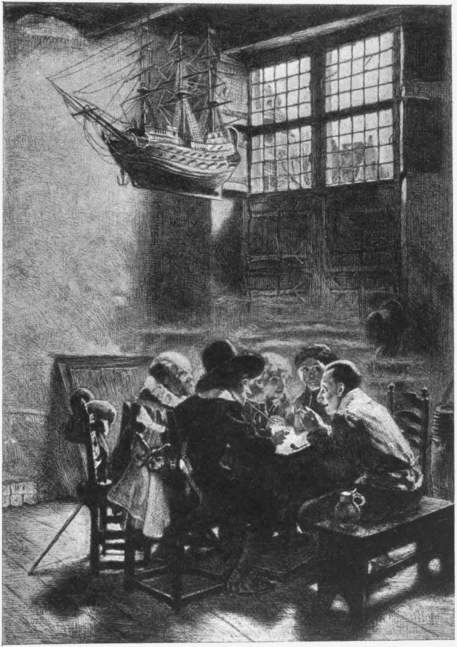 |
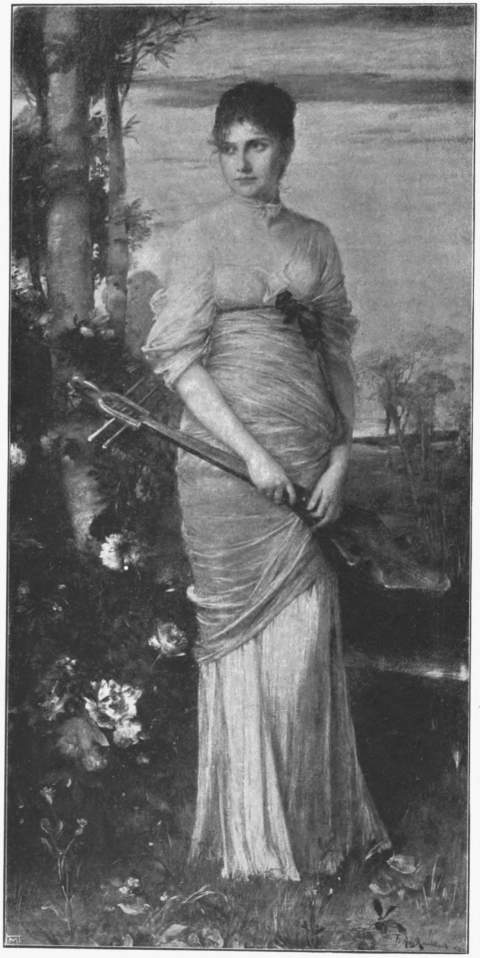 | ||
| Hanfstaengl. | |||
| CLAUS MEYER. | THE SMOKING PARTY. | KAULBACH. | THE LUTE PLAYER. |
When the German Renaissance was at its zenith he painted in the Renaissance style: harmless genre pictures à la Beyschlag—the joys of love and of the family circle—but not being so banal as the latter he painted them with more delicate colouring and finer poetic charm. Certain single figures were found specially acceptable—for instance, the daughters of Nuremberg patricians, and noble ladies in the old German caps, dark velvet gowns, and long plaits like Gretchen’s, with their eyes sometimes uplifted and sometimes lowered, and their hands at one moment folded and at another carrying a shining covered goblet. Occasionally these single figures were portraits, but none the less were they transformed into “ladies in old German costume”; and Kaulbach understood how to paint, to the utmost satisfaction of his patrons, the black caps, no less well than the little veil and the net of pearls, and the greenish-yellow silk of the puffed sleeves, no less well than the plush border of the dark gown and the antique red Gretchen pocket. Many of them held a lute and stood amid a spring landscape, before a streamlet, or a silver-birch, such as Stevens delighted in painting ten years previously. At that time Fritz August Kaulbach, with greater softness in his treatment, occupied in Germany the place which Florent Willems had occupied in Belgium. Since then he has brought nearer to the public the most various old and modern masters, and he has done so with fine artistic feeling: in his “May Day” he has revived the pastoral scenes of Watteau with a felicitous cleverness; in his “St. Cecilia” he created a total effect of great grace by going arm in arm with Carlo Dolci and Gabriel Max; his “Pietà” he composed with “the best figures of Michael Angelo, Fra Bartolommeo, and Titian,” just as Gerard de Lairesse had once recommended to painters. Intermediately he painted frail flower-like girls à la Gabriel Max, charming little angels à la Thoma, children in Pierrot costume à la Vollon, and little landscapes à la Gainsborough. He did not find in himself the plan for a new edifice in erecting his palace of art, but built according to any plans that came in his way; he simply chose from all existing forms the most graceful, the most elegant, the most precious, culled from their beauties only 64 the flowers, and bound them into a tasteful bouquet. In his modern portraits of women, which in recent years have been his chief successes, he placed himself between Van Dyck and the English. Of course, a really chic painter of women, like Sargent, is not to be thought of in this connection; but for Germany these portraits were in exceedingly fine taste, had an interesting Kaulbachian trace of indifferent health, and breathed an odeur de femme which found very wide approval. In his “Lieschen, the Waitress of the Shooting Festival” he risked a fresh attempt at treating popular life, and made of it such a graceful picture that it might almost have been painted by Piglhein; while in a series of spirited caricatures he even succeeded in being—Kaulbach. The history of art is wide, and since Fritz August Kaulbach knows it extremely well, he will certainly find much to paint that is pleasing and attractive, “s’il continue à laisser errer son imagination à travers les formes diverses créées par l’art de tous les temps,” as the Gazette des Beaux-Arts said of him on the occasion of the Vienna World Exhibition of 1878.
After all, these pictures will have little that is novel for an historian of the next century. “Être maître,” says W. Bürger, “c’est ne ressembler à personne.” But these were the works of painters who merely announced the dogma of the infallibility of universal eclecticism, as the Caracci had done in their familiar sonnets: they were spirited imitators, whose connection with the nineteenth century 65 will be known in after years only by the dates of their pictures. As old masters called back to life, they have enriched the history of art, as such, by nothing novel. Yet, in replacing superficial imitations by imitations which were excellent and congenial, they have nevertheless advanced the history of art in the nineteenth century in another way.
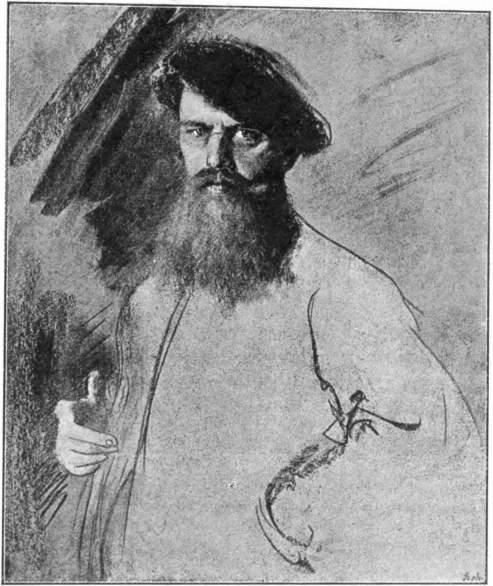 |
 | ||
| Hanfstaengl. | |||
| FRANZ LENBACH. | LENBACH. | PORTRAIT OF WILHELM I. | |
By the labour of his life each one of them helped to make a place in Germany for the art of oil-painting, which had been forgotten under the influence of Winckelmann and Carstens, and in this sense their works were very important stations, as one might say, on the great thoroughfare of art. Through systematic imitation of the finest old masters, the Munich school had in a comparatively short time regained the appreciation of colour and treatment which had so long been lost. At a hazy distance lay those times when the distinctive peculiarity of German painting lay in its wealth of ideas, its want of any sense for colour, and its clumsy technique, whilst the æsthetic spokesmen praised these qualities as though they were national virtues. These views had been altogether renounced, and a decade of strenuous work had been devoted to the extirpation of all such defects. Such an achievement was sufficiently great, and sufficiently important and gratifying. This last resuscitation of the old masters was capable of being turned into a bridge leading to new regions.
A feeling arose that the limit had been reached, and it arose in those very men who had advanced furthest in pictorial accomplishment, adapting and making their own all the ability of the old masters. Painters believed that they had learnt enough of technique to be able to treat subjects from modern life in the spirit of these old masters, not handling them any longer as laboriously composed genre pictures, but as real works of art. And a group of realists came forward as they had done in France, and began to seek truth with scientific rigour and an avoidance of any kind of anecdotic by-play.
The greatest pupil of the old masters, Franz Lenbach, stands in a close and 66 most important relationship with these endeavours of modern art, through some of his youthful works.
The public has accustomed itself to think of him only as a portrait painter, and he is justly honoured as the greatest German portraitist of the century. But posterity may one day regard it as a special favour of the gods that Lenbach should have been born at the right time, and that his progress to maturity fell in the greatest epoch of the century. His gallery of portraits has been called an epic in paint upon the heroes of our age. The greatest historical figures of the century have sat to him, the greatest conquerors and masters in the kingdom of science and art. Nevertheless this gallery would be worthless to posterity if Lenbach had not had at his disposal one quality possessed by none of his immediate predecessors, a sacred respect for nature. At a time when rosy tints, suave smiles, and idealised drawing were the requirements necessary in every likeness, at a time when Winterhalter painted great men, not as they were, but as, in his opinion, they ought to have been—without reflecting that God Almighty knows best what heads are appropriate for great men—Lenbach appeared with his brusque veracity of portraiture. That alone was an achievement in which only a man of original temperament could have succeeded. If a portrait painter is to prevail with society a peculiar combination of faculties is necessary, apart from his individual capacity for art. Lenbach had not only an eye and a hand, but likewise elbows and a tongue which placed him hors concours. He could be as rude as he was amiable, and as deferential as he was proud; half boor and half courtier, at once a great artist and an accomplished faiseur, he succeeded in doing a thing which has brought thousands to ruin—he succeeded in forcing upon society his own taste, and setting genuine human beings of strong character in the place of the smiling automatons of fashionable painters. In comparison with the works of earlier portrait painters it might be 67 said that a touch of pantheism and nature-worship goes through Lenbach’s pictures.
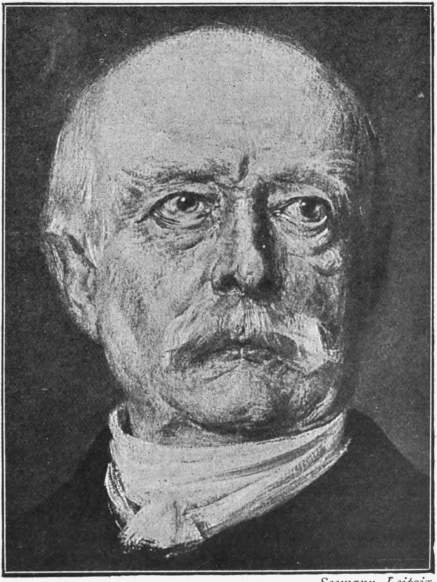 |
| Seeman, Leipzig. |
| LENBACH. PRINCE BISMARK. |
And what makes this so invaluable is that his greatness depends really less upon artistic qualities than upon his being a highly gifted man who understands the spirit of others. It is not merely artistic technique that is essential in a portrait, but before everything a psychical grasp of the subject. No artist, says Lessing, is able to interpret a power more highly spiritual than that which he possesses himself. And this is precisely the weak side in so many portrait painters, since a man’s art is by no means always in any direct relationship with the development of his spiritual powers. In this respect a portrait of Bismarck by Lenbach stands to one by Anton von Werner, as an interpretation of Goethe by Hehn stands to one by Düntzer. To speak of the congenial conception in Lenbach’s pictures of Bismarck is a safe phrase. There will always remain something wanting, but since Lenbach’s works are in existence one knows, at any rate, that this something can be reduced to a far lower measure than it has been by the other Bismarck portraits. “Bien comprendre son homme,” says Bürger-Thoré, “est la première qualité du portraitiste,” and this faculty of the gifted psychologist has made Lenbach the historian elect of a great period, the active recorder of a mighty era. It even makes him seem greater than most foreign portrait painters. How solid, but at the same time how matter-of-fact, does Bonnat seem by Lenbach’s side! One should not look at a dozen Bonnats together; a single one arrests attention by the plastic treatment of the person, but if you see several at the same time all the figures have this same plastic character, all of them have the same pose, and they all seem to have employed the same tailor. Lenbach has no need of all that characterisation by means of accessories in which Bonnat delights. He only paints the eyes with thoroughness, and possibly the head; but these he renders with a psychological absorption which is only to be found amongst modern artists, perhaps in Watts. In a head by Lenbach there glows a pair of eyes which burn themselves into you. The countenance, which is the first 68 zone around them, is more or less—generally less—amplified; the second zone, the dress and hands, is either still less amplified, or scarcely amplified at all. The portrait is then harmonised in a neutral tone which renders the lack of finish less obvious. In this sketchy treatment and in his striking subjectivity Lenbach is the very opposite of the old masters. Holbein, and even Rubens—who otherwise sets upon everything the stamp of his own personality—characterised their figures by a reverent imitation of every trait given in nature. They produced, as it were, real documents, and left it to the spectator to interpret them in his own way.
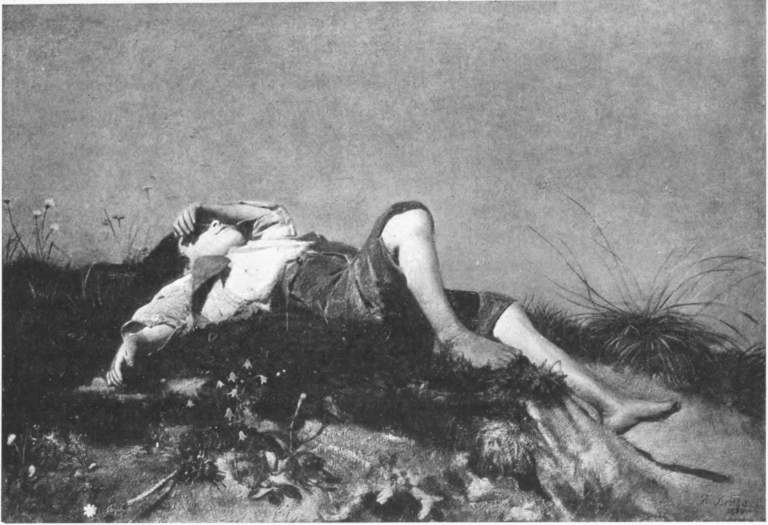 | |
| LENBACH. | THE SHEPHERD BOY. |
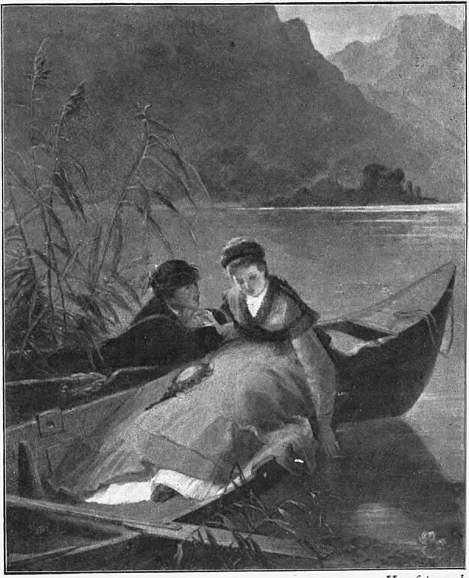 |
| Hanfstaengl. |
| RAMBERG. THE MEETING ON THE LAKE. |
Lenbach, less objective, and surrendering himself less absolutely to his subject, emphasises one point, disregards another, and in this way conjures up the spirit by his faces, just as he sees it. It may be open to dispute which kind of portraiture is the more desirable; but Lenbach, at any rate, has now forced the world to behold its great men through his eyes. He has given them the form in which they will survive. No one has the same secret of seizing a fleeting moment; no one turned more decisively away from every attempt at idealising glorification or at watering down an individual to a type. He takes counsel of photography, but only as Molière took counsel of his housekeeper: he uses it merely as a medium for arriving at the startling directness, the instantaneous impression of life, in his pictures. Works like the portraits of King Ludwig I, Gladstone, Minghetti, Bishop Strossmayer, Prince Lichtenstein, Richard Wagner, Franz Liszt, Paul Heyse, Wilhelm 69 Busch, Schwind, Semper, Liphart, Morelli, and many others have no parallel as analyses of the character of complex personalities. Some of his Bismarck portraits, as well as his last pictures of the old Emperor Wilhelm, will always stand amongst the greatest achievements of the century in portraiture. In the one portrait is indestructible power, as it were the shrine built for itself by the mightiest spirit of the century; in the other the majesty of the old man, already half alienated from the earth, and glorified by a trace of still melancholy, as by the last radiance of the evening sun. In these works Lenbach appears as a wizard calling up spirits, an évocateur d’âmes, as a French critic has named him.
But what the history of art has forgotten in estimating the fame of the portrait painter Lenbach is, that in the beginning of his career this very man paved the way for the “Realistic” movement in German painting which later he confronted so haughtily and with so much reserve. The first of these works of his, which have for Germany much the same significance as the early works of Courbet have for France, is the well-known “Shepherd Boy” in the Schack Gallery. Stretched on his back, he lies in the high grass where flowers grow thickly, and looks up while butterflies and dragon-flies flutter through the dusty air of a Roman summer day. Such a frank, an audacious, naked realism, breaking away from everything traditional in its representation of fact, was something entirely novel and surprising in Germany in the year 1856. Up to this time no one had seen a fragment of nature depicted with such unqualified veracity. The tanned shepherd lad, with his naked sunburnt feet, covered by a dark crust of mire from the damp earth, seemed to be lying there in the flesh, plastically thrown into relief by the glowing midday sun. The next of these pictures, “Peasants taking Refuge from the Weather,” which appeared in the exhibition of 1858, called down a storm of indignation on account of its “trivial realism.” Every figure was painted after nature with blunt and rigorous sincerity, and no anecdotic incident was devised in it.
 | |
| Hanfstaengl. | |
| HIRTH. | THE HOP HARVEST. |
After the sixties the influence of Courbet began to be directly felt. In the days when he worked in Couture’s studio Victor Müller had taken up some of the ideas of the master of Ornans, and when he settled in 1863 in Munich, Müller communicated to the painters there the first knowledge of the works of the great Frenchman. He did not follow Courbet, however, in his subjects. “The Man in the Heart of the Night lulled to Sleep by the Music of a Violin,” “Venus and Adonis,” “Hero and Leander,” “Hamlet in the Churchyard,” “Venus and Tannhäuser,” “Faust on the Promenade,” “Romeo and Juliet,” “Ophelia by the Stream”—such are the titles of his principal works. But how far they are removed from the anæmic, empty painting of beauty which reigned in the school of Couture! Though a Romanticist of the purest water in his subjects, Müller appears, in the manner in which he handles them, as a Realist on whom there is no speck of the academical dust of the schools. The dominant features of Victor Müller’s pictures are the thirst for life and colour, full-blooded strength, haughty contempt for every species of hollow exaggeration and all outward pose, genuine human countenances and living human forms inspired with tameless passion, an audacious rejection of all the traditional rules of composition, and, even in colour, a veracity which in that age, given up to an ostentatious painting of material, must have had an effect that was absolutely novel. In 1863 the blooming flesh of his “Wood Nymph” 71 excited the Munich public to indignation, just as the nude female figures of Courbet had roused indignation about the same time in Paris. Pictures painted with singular sureness of hand were executed by him during the few years that he yet had to live—portraits of dogs, landscapes of a flaming glow of colour, single figures of red-haired Bacchantes and laughing flower-girls, old men dying, and charming fairy pictures. The nearer he came to his death the more his powers of work seemed to increase. The most remarkable ideas came into his head. He drew, and painted without intermission designs which had occupied him for years. “I feel,” he said, “like an architect who has been commissioned to carry out a great building, and I cannot do it: I must die.”
But the impulse which he had given in more than one direction had further issues. As Hans Thoma in later years continued the work of the great Frankfort master in the province of fairy-tale, Wilhelm Leibl realised Müller’s realistic programme.
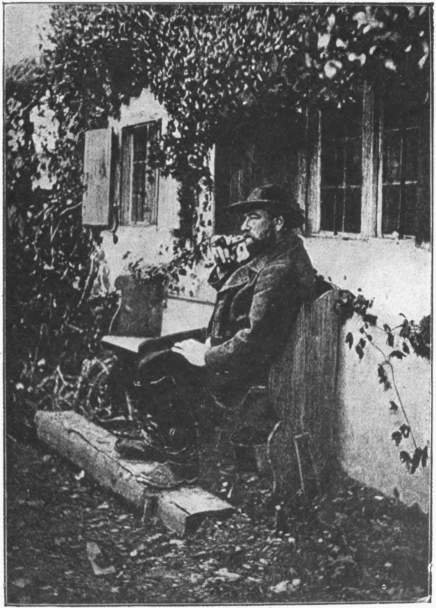 |
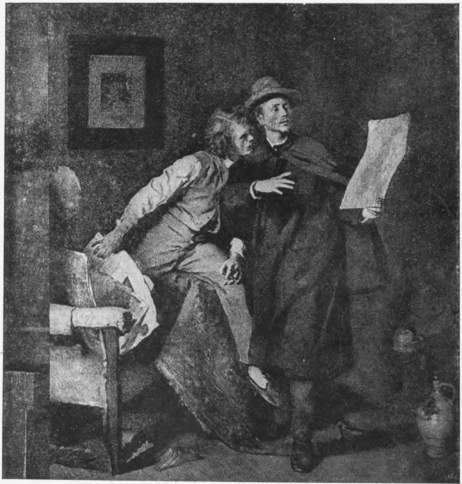 | ||
| Kunst für Alle. | |||
| WILHELM LEIBL. | Kunst für Alle. | LEIBL. | IN THE STUDIO. |
Wilhelm Leibl, son of the conductor of music in the cathedral, was born at Cologne on 23rd October 1844. At Munich he entered the studio of Arthur van Ramberg, that unjustly forgotten master who, both by his own work and by his activity as a teacher, exercised upon the younger Munich school a far healthier influence than Piloty. Ramberg was a modern man, was always eager to come into immediate contact with life and break the fetters of tradition which hung everywhere upon that generation. He was an aristocrat and a dandy, and, having occupied himself in the beginning with romantic fairy subjects, he painted, soon after his migration to Munich, a series of pictures from modern life—“Dachau Girls on Sunday,” “The Return from the Masked Ball,” “A Walk with the Tutor,” “The Meeting on the Lake,” “The Invitation to Boat,” and others, which rose above the mass of contemporary productions by their great distinction, fragrance, and grace. At a time when others held nothing but the smock-frock fit for representation, Ramberg painted the fashionable 72 modern costume of women. And when others devoted themselves to clumsy genre episodes, he created songs without words that were full of fine reserve, nobility, and delicate feeling.
Rudolf Hirth, who made a stir with his “Hop Harvest”; Albert Keller, the tasteful painter of fashionable life; Karl Haider, the sincere and conscientious miniature painter whose energy of manner had a suggestion of the old masters, together with Wilhelm Leibl, all issued from Ramberg’s school, not from Piloty’s.
The young student from Cologne was thus saved, in the beginning, from occupying himself with history, and he had no need to addict himself to narrative genre painting, since his entire organisation preordained him to painting pure and simple. Wilhelm Leibl was in those days a handsome fellow, with powerful limbs and shining brown eyes. He was realism incarnate—rather short, but strongly made, and with a frame almost suggesting a beast of burden, broad in the chest, high-shouldered, and bull-necked. His arms were thick and his feet large. His gait was slow, heavy, and energetic, and he made with his arms liberal gestures which took up a good deal of room. He had not the fiery spirit of Courbet, being more prosaic, sober, and deliberate, but he resembled him both in appearance and in the artistic faculty of eye and hand. “He had,” as a French critic wrote of him, “one of those organisations which are predestined for painting, as Courbet had amongst us Frenchmen. Such men extract the most remarkable things from painting.”
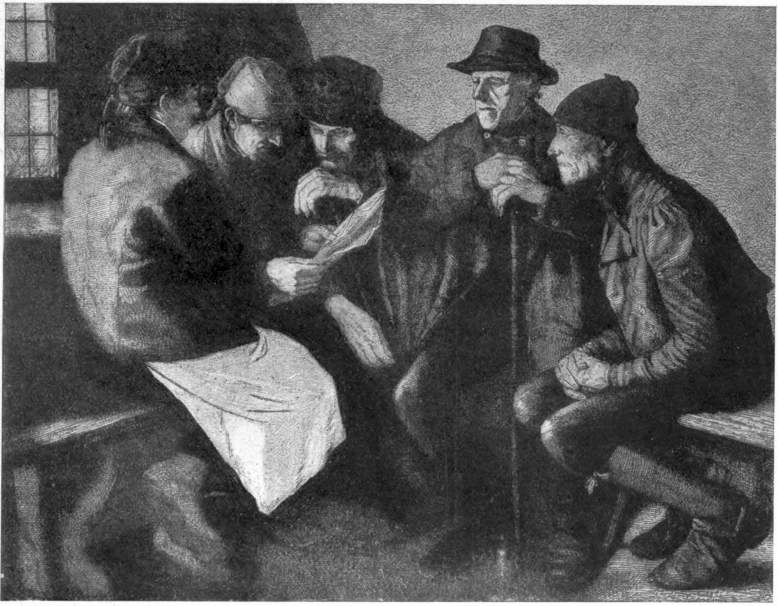 | |
| American Art Review. | |
| LEIBL. | THE VILLAGE POLITICIANS. |
Even his first picture, exhibited in 1869, and representing his two fellow-pupils Rudolf Hirth and Haider looking at an engraving, had a soft, full golden harmony, which left all the products of conventional genre painting far behind it, and came into direct competition with the refined works of the Dutch painter Michael Swert. His second picture, a portrait of Frau Gedon, made an impression even in Paris by its Rembrandtesque beauty of tone, and was awarded there in 1870 the gold medal which the judges had not ventured to give him the year before at Munich, because he was still an Academy pupil. Yet 1869 was the decisive year in Leibl’s life. The Munich Exhibition gave at that time an opportunity for learning the importance of French art upon a scale previously unknown. Over four hundred and fifty pictures were accessible, and the works of the smooth, conventional historical painters were the minority. Troyon was to be seen there, and Millet and Corot. But Courbet, to whose works the committee had devoted an entire room, was chiefly the hero, and one over whom there was much conflict. Opinions were violently at odds about him in the painters’ club. The official circle greeted the master of Ornans with the same hoot of indignation which had been accorded him in France. But for Leibl he became an adored and marvellous ideal. His eyes sparkled when he sat opposite him at the Deutsches Haus, and in default of any other means of making himself understood he assured Courbet of his veneration by sturdily drinking to him: “Prosit Courbet—Prosit Leibl.” He stretched his powerful limbs, and threw himself into vigorous attitudes to evince in sanguinary quarrels, when necessary, his enthusiasm for the great Frenchman. How false and paltry seemed the whole school of Piloty, with its rose-coloured insipidity and its conventional bloom of the palette, when set 74 against the downright veracity and the masterly painting of these works!
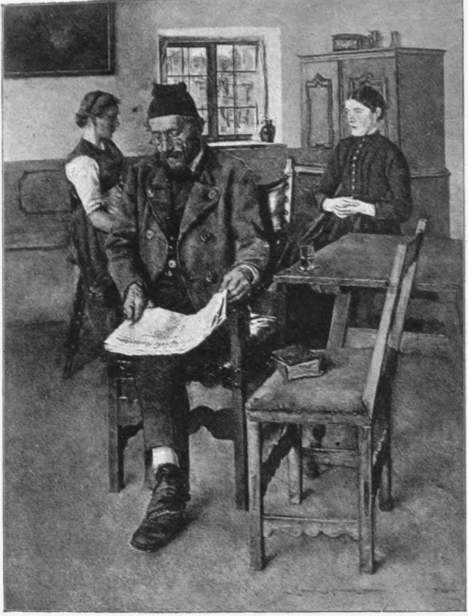 |
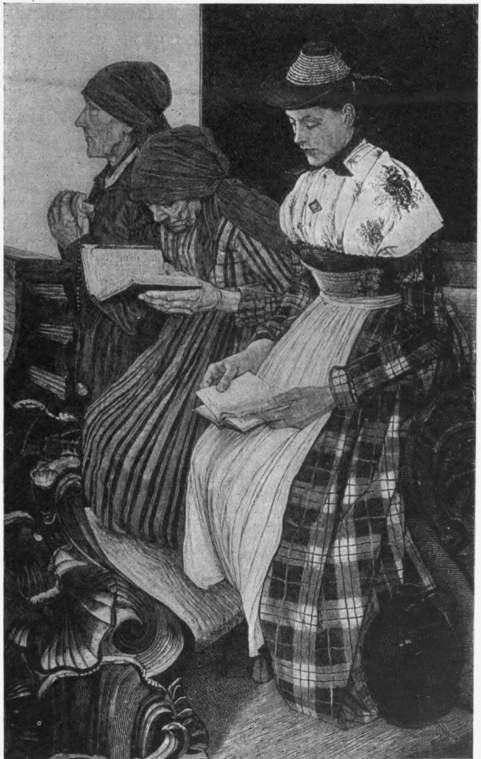 | ||
| Kunst für Alle. | Seemann, Leipzig. | ||
| LEIBL. | THE NEW PAPER. | LEIBL. | IN CHURCH. |
In the same year he went to Paris, special occasion for the journey being given by a commission for a portrait which he received from the Duc Tascher de la Pagerie. There he painted “La Cocotte,” the portrait of a fat Frenchwoman seated upon a sofa and watching the clouds of smoke from her clay pipe. In its massive realism, and in the exuberant power of its broad, liquid painting, it might have been signed “Courbet,” and Leibl told afterwards with pride how Courbet slapped him on the shoulder when he was at his work, saying: “Il faut que vous restez à Paris.” The breaking out of the war brought his residence in Paris to an end more quickly than he had foreseen, but though he was there only nine months that was long enough to give for ever a firm direction to the efforts of the painter. Leibl became the apostle of Courbet in Germany, and in his outward life the German Millet. Back once more in Bavaria, he migrated in 1872 to Grasolfingen, then to Schondorf on the Ammersee, then to Berbling near Aibling, and in 1884 to Aibling itself; he became a peasant, and, like Millet, he painted pictures of peasants.
The poetic and biblical, the august and epical bias which characterises the works of Millet, is not to be expected in Leibl. A spirit bent upon what is great and heroic speaks out of Millet’s pictures. A Rembrandtesque feeling for space, the great line, the simplification, the intellectual restraint from anecdotic triviality of form, are the things which constitute his style. Leibl is at his best when he buries himself with delight in the hundred little touches of nature. He triumphs when he has to paint the faces of old peasant women, full of wrinkles, and furrowed with care; the ruddy cheeks of girls, sparkling in all their natural rustic freshness; figured dresses, the material and texture of which are clearly recognisable; flowered silk kerchiefs worn round the 75 neck, coarse woollen bodices, and heavy hobnail shoes. He is to Millet what Holbein is to Michael Angelo.
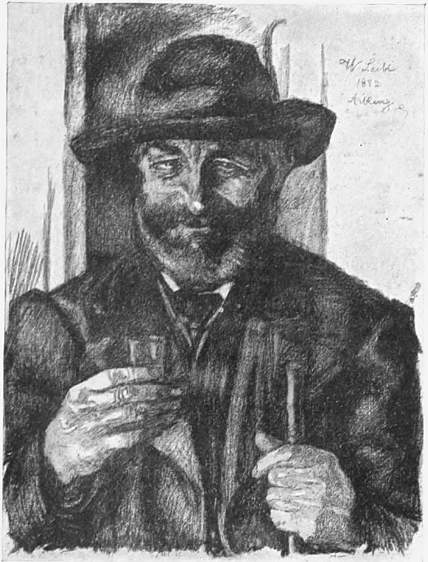 |
| L’Art. |
| LEIBL. A PEASANT DRINKING. |
Nor can he be called an artist of intimate feeling in the sense in which the Scandinavians are amongst the moderns. In Viggo Johansen the painter disappears; what he paints has not the effect of a picture, but of a moment of existence, a memory of something clear and familiar—something which has been lived and seen, but not fashioned with deliberate intention. His figures are like the sudden appearance of actual persons, spied upon, as if one were looking through the window into a strange room under cover of night. One feels that there is no occasion to pay the artist a compliment; but one would like to sit in such a warm, cosy room, impregnated with tobacco smoke, to inhale the fine cloud of steam issuing from the tea-kettle, to hear the water bubbling and humming upon the glimmering fire. But the painter is always seen in Leibl’s pictures. A communicative spirit, something which touches the heart and sets one dreaming, is precisely what is not expressed in them. The spectator invariably thinks, in the first place, of the astonishing ability, the incredible patience, which went to the making of them. And with all their photographic fidelity he is, moreover, conscious that the painter himself was less concerned in seizing the poetry of a scene, the instantaneous charm of an impression of nature, than in forcing into the foreground particular evidences of his technical powers which he has reserved for display. For instance, newspapers in which, if it is possible, a fragment of the leading article may be deciphered, earthen vessels, bottles, and brandy glasses, play in his pictures a rôle similar to that assumed by the little caskets with brass covers that catch 76 the flashing lights, the overturned settles, the tapestry, and the globe in works of the school of Piloty.
Wilhelm Leibl is a good workman, like Courbet, a man of fresh, vigorous, and energetic nature and robust health, very material, and at times matter-of-fact and prosaic. Painting is as natural to him as breathing and walking are to the rest of us. He goes his way like an ox in the plough, steadily and without tiring, without vibration of the nerves, and without the touch of poetry. He goes where his instinct leads him and paints with a muscular flexibility of hand whatever appeals to his eye or suits his brush. Opposed to the neurotic and hurrying moderns, he has something of a mediæval monk who sits quietly in his cell, without counting the hours, the days, and the years, and embellishes the pages of his service-book with artistic miniatures, to depart in peace when he has set “Amen, Finis” at the bottom of the last page. But he has, too, all the capacity and all the boundless veneration for nature of these old artists. He is the greatest maître peintre that Germany has had in the course of the century, and in this sense his advent was of epoch-making importance.
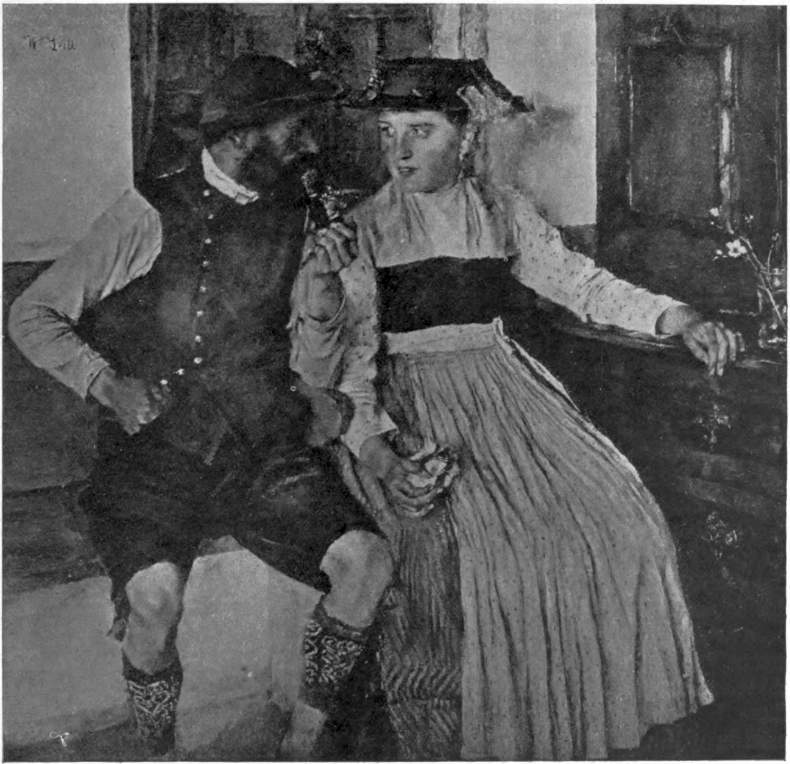 | |
| LEIBL. | IN THE PEASANT’S COTTAGE. |
Even Defregger had observed peasant life altogether from a narrative and anecdotic point of view. In Leibl this narrative genre has been overcome. He had ability enough to give artistic attractions even to an “empty subject.” To avoid exaggerated characterisation, to avoid the expression of anything divided into rôles, he consistently painted people employed in the least exciting occupations—peasants reading a newspaper, sitting in church, or examining a gun. Pains are taken to avoid the slightest movement of the figures. Whilst all his predecessors were romance writers, Leibl is a painter. His themes—simple scenes of daily life—are a matter of indifference; the beauty of his pictures lies in their technique. They are works of which it may be said that every attempt to give an impression of them in words is useless, for they have not proceeded from delight in anecdotic theme, but, as in the good periods of art, from the discipline of the sense for colour and from an eminent capacity for drawing: they are pictures in which mere interest in subject is lost in the consideration of their artistic value, while the matter of what is represented is entirely thrown into the background by the manner in which it is carried out. The chief aim of the historical as of the genre painters had been to draw a fluent cartoon based upon single studies, to mix the colours nicely upon the palette, lay them upon the canvas according to the rules, blend them and let them dry, so as then to attain the proper harmony of colour by painting over again and finally glazing. Leibl’s mastery, which of itself resulted in an astonishing truth to nature, lay in seizing an impression as quickly as possible, taking hold of the reality rightly at the first glance, and transferring the colours to his canvas with decision and sureness, in clear accord with the hues of the original. Lessing’s maxim, “From the eyes straight 78 to the arm and the brush,” has been realised here for the first time in Germany.
As yet no German had, in the same measure, what the painter calls qualities, and even in France two apparently heterogeneous faculties have seldom been united in one master in the same measure as they were in Leibl: a broad and large technique, a bold alla prima painting, and, on the other hand, a joy in work of detail with a fine brush, such as was known by Quentin Matsys, the smith of Antwerp. “The Village Politicians” of 1879 was the chief work that he painted in Schondorf. What would Knaus, the king of illustration and the ruler over the province of vignettes, have made out of this theme! By a literary evasion he would have subordinated the interest of the picture to his ideas. One would have learnt what it is that peasants read, and received instruction as to their political allegiance to party and their offices and honours in the village: that would be the magistrate, that the smith, and that the tailor. In Leibl there are true and simple peasants, who, by way of relaxation from the toil of the week, listen stupidly and indifferently to the reading of a Sunday paper, in which one of them is endeavouring to discover the village news and the price of crops. They are harsh-featured and common, but they have been spared theatrical embellishment and impertinent satire; they are not artistically grouped, though they sit there in all the rusticity of their physiognomies, and all the angularity of their attitudes, without polish or Sunday state. Leibl renders the reality without altering it, but he renders it fully and entirely. The fidelity to nature held fast on the canvas surpassed everything that had hitherto been seen, and it was gained, moreover, by the soundest and the simplest means. Whereas Lenbach, in his effort to reproduce the colour-effects of the old masters, destroyed the durability of his pictures even while he worked upon them, Leibl seemed to have chosen as his motto the phrase which Dürer once used in writing to Jacob Heller: “I know that, if you preserve the picture well, it will be fresh and clean at the end of five hundred years, for it has not been painted as pictures usually are in these days.”
He took a further step in the direction of truth when he made a transition from the Dutch towards the old German masters. After he had, in his earlier productions, worked very delicately at the tone of his pictures, and, for a time, had particularly sought to attain specific effects of chiaroscuro, attaching himself to Rembrandt, he took up an independent position in his conception of colour, painting everything not as one of the old masters might have seen it, but as he had seen it himself. All the tricks of painting and sleights of virtuosity were despised, special emphasis being scarcely laid upon pictorial unity of effect. Everything was simple and true to nature, and had a sincerity which is not to be surpassed.
The picture of the three peasant women, “In Church,” is the masterpiece in this “second manner” of his, and when it appeared in the Munich International Exhibition of 1883 it was an event. From that date Leibl was 79 established—at any rate in the artistic circles of Munich—as the greatest German painter of his time. That Leibl painted the picture without sketching for himself an outline, that he began with the eye of the peasant girl and painted bit by bit, like fragments of a mosaic, was a feat of technique in which there were few to imitate him. The young generation in Munich studied the pages of the service-book and the squares of the gingham dress, the girl’s jug and the carvings of the pew, with astonishment, as though they were the work of magic. They were beside themselves with delight over such unheard-of strength, power, and delicacy of modelling, the fusion of colour suggesting Holbein, and the intimate study of nature. They perpetually discovered new points that came upon them as a surprise, and many felt as Wilkie did when he sat in Madrid before the drinkers of Velasquez, and at last rose wearily with a sigh.
 | |
| L’Art. | |
| LEIBL. | A TAILOR’S WORKSHOP. |
Leibl did for Germany what the pre-Raphaelites did for England. Men and women were represented with astonishing pains just as they sat and suffered themselves to be painted. He was determined to give the whole, pure truth, and he gave it; that, and nothing more and nothing less. He reproduced nature in her minutest traits and in her finest movements, bringing the imitative side of art to the highest perfection conceivable. In virtue of these qualities he was a born portrait painter; and although he never had “conception,” as Lenbach had, his portraits belong, with those of Lenbach, 80 to the best German performances of the century. Only Holbein when he painted his “Gysze” had this remorseless manner of analysing the human countenance in every wrinkle. Leibl once more taught the German painters to go into detail, and led them constantly to hold nature as the only source of art; and that has been the beginning of every renaissance.
His works were pictorially the most complete expression of the aims of the Munich school in colour. As a representative of the efforts of the decade from 1870 he is as typical as Cornelius for the art of the thirties, Piloty for that of the fifties, and as Liebermann became later as a representative of the efforts of the eighties.

CHAPTER XXX
THE INFLUENCE OF THE JAPANESE
Courbet and Ribot for France, Holman Hunt and Madox Brown for England, Stevens for Belgium, Menzel, Lenbach, and Leibl for Germany, are the great names of modern Realism, the names of the men who subjected modern life to art, and subjected art to the nineteenth century.
One point, however, the question of colour, still remained unsolved: as the preceding generation took their form, so these painters took their colour, not from nature, but from the treasury of old art.
Courbet announced it as his programme to express the manners, ideas, and aspect of his age—in a word, to create living art. He described himself as the sincere lover of la vérité vraie: “la véritable peinture doit appeler son spectateur par la force et par la grande vérité de son imitation.” But one may question how far his figures, and the environment of them, are true in colour? Where there is a delightful subtlety of fleeting nuances in nature, an oppressive opaque heaviness is found in this modern Caravaggio of Franche-Comté. He certainly painted modern stone-breakers, but it was in the tone of saints of the Spanish school of the seventeenth century. His pictures of artisans have the odour of the museum. The home of his men and women is not the open field of Ornans, but that room in the Louvre where hang the pictures of Caravaggio.
Alfred Stevens made a great stride by painting modern Parisiennes. Whereas the costume picture had up to his time sought the truth of the old masters only in the matter of the skirts which the fashion of their age prescribed, Stevens was the first to dress his women in the garb of 1860, just as Terborg painted his in the costume of 1660 and not of 1460. But the very atmosphere in which the Parisienne of the nineteenth century lived is no longer that in which the women of de Hoogh moved. The whole of life is brighter. The studios in which pictures are painted are brighter, and the rooms in which they are destined to hang. Van der Meer of Delft, the greatest painter of light amongst the Dutch, still worked behind little casements; and in dusky patrician dwellings, “where the very light of heaven breaks sad through painted window,” his pictures were ultimately hung. The old masters paid special attention to these conditions of illumination. The golden harmony of the Italian Renaissance came into being from the character of the old cathedrals furnished with glass windows of divers colours; the half-light of 82 the Dutch corresponded to the dusky studios in which painters laboured, and the gloomy, brown-wainscoted rooms for which their pictures were destined. The nineteenth century committed the mistake even here of regarding what was done to meet a special case as something absolute. Rooms had long become bright when studios were artificially darkened, and artists still sought, by means of coloured windows and heavy curtains, to subdue the light, so as to be able to paint in tones dictated by the old masters. Stevens shed over a modern woman, a Parisienne, sitting in a drawing-room in the Avenue de Jena, the light of Gerard Dow, without reflecting that this illumination, filtered through little lattice-windows, was quite correct in Holland during the seventeenth century, but no longer proper in the Paris of 1860, in a salon where the windows had great cross-bars and clear white panes which were not leaded. It is chiefly this that makes his pictures untrue, lending them an old Flemish heaviness, something earthy, savouring of the clay, and not in keeping with the fresh fragrance of the modern Parisienne. Her modernity is seen through the yellowish glass which the old Flemish masters seemed to hold between Stevens and his model.
 |
 | ||
| Quantin, Paris. | Quantin, Paris. | ||
| HOKUSAI IN THE COSTUME OF A JAPANESE WARRIOR. | HOKUSAI. | WOMEN BATHING. | |
Considered as a separate personality Ribot, too, is a great artist; his works are masterpieces. Yet when young men spoke of him as the last representative of the school of cellar-windows there was an atom of truth in what they said. Like Courbet, he continued the art of galleries. The master of a style and yet the servant of a manner, he marks the summit of a tendency in which the great traditions of Frans Hals and Ribera were once more embodied. When he paints subjects resembling the themes of these old masters he is as great as they are, as genuine and as much a master of style; but as soon as he turns to other subjects the imitative mannerist is revealed. Even things as tender and unsubstantial as the flowers of the field seem as if they were made of wax. His disdain for what is light, fluent, and fickle, like air and water, is evident in his sea-pieces. His steamers plough their way through a greyish-black sea beneath a thick 83 black stormy sky, as though through grey deserts. Nature quivering in the air and bathed in light is not so heavy and compact, nor has it such plasticity of appearance. His women reading are the ne plus ultra of painting; only it is astonishing that any human being can read in such a dark room.
Ribot’s parallel in Germany is Lenbach, who had less pictorial and greater intellectual power. As a painter of copies, particularly copies of the artists of the sixteenth and seventeenth centuries, he formed and perfected a school for the understanding of the old masters, as none of his contemporaries had done. The copies which he made as a young man for Count Schack in Italy and Spain are probably the best translations by the brush that have ever been executed. He has reproduced Titian and Rubens, Velasquez and Giorgione, with equal magic; no other painter has entered into all the subtleties of their technique with such intelligence and keenness; and by the aid of these sleights of art, which he learnt as a copyist from classic masterpieces, he communicated to his own works that impress which qualifies them for the gallery and suggests the old masters with such refinement. His pictures mark the summit of ability reached in Germany in the pictorial style of the old artists.
But, at the same time, his weakness lies in this very eminence. The man who had passed through the high-school of the old masters with the greatest success was entered as a student for life, and never took the professorial chair himself. Helferich has called him the impersonated spirit of the galleries, the spirit which is centuries old.
 |
| Quantin, Paris. |
| HOKUSAI. FUSIYAMA SEEN THROUGH A SAIL. |
This indicates the direction which must be taken by the further development of painting. A really new and independent art must finally emancipate itself from the Renaissance colouring, the tone of Church painting, and the chiaroscuro of pictures painted behind the variegated panes of lattice-windows. It must be evident that the methods of the old Spanish and old Dutch schools, excellent in themselves, were fully in keeping with strange scenes of martyrdom 84 or quiet interiors with peasants and fat matrons, but that they could not possibly be employed in pictures of artisans beneath the free sky, nor in those of elegant interiors of our own days, nor of pale and delicate Parisiennes attired in silks, beings of a new epoch. A different period necessitates different methods. It is not merely that the subjects of art change, but the way in which they are handled must bear the marks of the period. Nature should no longer be studied through the prism of old pictures, and the phrase beau par la vérité must be exalted to a principle applying to colour also.
The pre-Raphaelites and Menzel were the first to become alive to the problem. They were never taken captive by the tones of the early masters, but placed themselves always in conscious opposition to the artists of older ages. The battle against “brown sauce” even formed an essential point in the programme of the Brotherhood. They protested against conventional colouring as violently as against the sweeping line taught by traditional rules of beauty.
But, as so often happens in the nineteenth century, though the English found the jewel, they did not understand how to cut it. The pre-Raphaelites had a quickening influence, in exciting a feeling for hue and tint, and rendering it keener by their own insistence on the elementary effects of colour. They sought to free themselves from brown sauce and to be just to local tones, through straightforward, independent observation. They painted the trees green, the earth grey, the sky blue, the sunbeams yellow, in sharply accentuated colours, as little blended as possible. But in most cases the result was not particularly pleasant; there was almost always a hard, motley colouring which produced a most unpleasant, glaring effect. Their audacity was somewhat barbaric. There was a want of warmth and softness, the atmosphere 85 did not combine the whole by its mitigating and harmonising power. Even Madox Brown’s “Work” is an offensive chaos of crying colours. The bright clothes, the blue blouses, the red uniforms have a gaudy and unquiet effect. The problem was attacked, but the solution was harsh and crude.
 | |
| HOKUSAI. | FUSIYAMA SEEN THROUGH REEDS. |
Of Menzel’s pictures the same is true, though not perhaps in the same degree. In pictorial conception he also has not quite reached the summit. His method of painting is sometimes sparkling and full of spirit, holding the mean, more or less, between the quiet and plain painting of Meissonier and the crisp, glittering style of Fortuny; he lets off a flickering, dazzling, rocket-like firework, but at bottom he has been cut from the block from which draughtsmen are made. Sometimes it is astonishing how his brush sweeps over costumes, ornaments, and buildings, but he does not think in colour; it is supplementary to the drawing, and not of earlier origin, nor even of equal birth. Much as he tried to paint smoke and steam in his “Iron Mill,” he had no understanding for atmospheric life; for this reason harsh and glaring tones almost invariably make a disturbing effect in his works. His “Piazza d’Erbe” as well as his “King Wilhelm setting out to join the Army” have a motley and restless effect in the picture, and only in photography or black and white do they acquire something of the simplicity which is to be desired in the originals. The best of his drawings may stand beside the 86 sketches of Dürer without detriment; to place his pictures on the same level is impossible, because quietude and pure harmony are wanting in them.
So extremes meet. Courbet, Ribot, and Lenbach are greater connoisseurs of colour than Europe had seen previous to their appearance, but this they are at the expense of truth; they have identified themselves with the old masters, and not arrived at any personal conception of colour. Menzel and the pre-Raphaelites despised the old masters, but their conception of colour had something primitive, jarring, and undisciplined.
The note of truth was still missing in the mighty orchestra. By what possible means could it be supplied? How bring to perfection that great harmony which is ever the end and aim of all true artistic effort. It was not until the art of the Far East was unfolded before the eyes of Western painters that this disquieting problem reached its solution.
 | |
| Quantin, Paris. | |
| HOKUSAI. | AN APPARITION. |
In the year in which Millet exhibited his “Winnower” and Courbet painted his “Stone-breakers” a man died in the Far East whose name was Hokusai. He was the last great representative of an art of painting more than a thousand years old—one which had no Raphael, Correggio, or Titian, though it was, nevertheless, art in the loftiest meaning of the word. Marco Polo, the great traveller of the Middle Ages, had told of a remarkable land “towards the sunrise,” the soil of which it was not permitted to him to tread. And the artistic views of the eighteenth century were revolutionised when the first Japanese porcelain and lacquer-work arrived at the Courts of Dresden and Paris. The aged Louis XIV himself began to find pleasure in idols, 87 pagodas, and “stuffs printed with flowers.” In a short time these works formed an important part of superior collections, and led to the movement against the inflexible despotism of the pompous Lebrun style. For the Japanese gave Europe the unfettered principles of a freer intuition of beauty; they excited a preference for things which were unsymmetrical, capricious, full of movement, for everything by which the charming Louis XV style is to be distinguished from the tiresome academic art of Louis XIV. In the sixties of the nineteenth century Japan exerted, for the second time, a revolutionary influence on the development of European painting. If Japanese productions were in earlier days regarded as curiosities, for which place was to be found in cabinets of rarities, as trifles the artistic value of which was less prized than the dexterity of their construction, it was reserved for the present age to do justice to Japanese art as such.
 | |
| HOKUSAI. | HOKUSAI SKETCHING THE PEERLESS MOUNTAIN. |
As is well known, oil-painting exists neither in China nor Japan. Just as the Japanese choose the slightest material for building, so everything in their painting bears a trace of extreme lightness. Japanese pictures, kakemonos, are painted in water colour or Chinese ink upon framed silk or paper; but this paper has an advantage over the European article in its unsurpassed toughness, its remarkable softness and pliability, its surface which has either a dull, silky lustre, or may only be compared with the finest parchment. And the pictures themselves are kept rolled up, and only hung, as occasion 88 offers, in the Tokonama, the little closet near the reception-room, and according to very refined rules. Only a few are hung at a time, and only such as harmonise. When a visit is expected the taste of the guest determines the selection. Fresh and variously coloured flowers and branches, placed near them in vases, are obliged to harmonise in colour with the pictures.
 | |
| TANYU. | THE GOD HOTEÏ ON A JOURNEY. |
As an instrument for painting use is only made of the pliant brush of hair, which executes everything with a free and fluent effect. Pen, crayon, or chalk, and all hard mediums which offer resistance, are consistently excluded. The subject-matter of these pictures is surprisingly rich, and assumes for their proper understanding some acquaintance with Japanese literature. An opulent folk-lore, in which cannibals and heroes like Tom Thumb live and move and have their being, just as in European fairy stories, stands at the disposal of the artist. Historical representations from the life of fabulous national heroes, ghosts, and apparitions half man and half bird, alternate with simple landscapes and scenes from daily life. And in all pictures, whether they are fanciful or plain renderings of fact, attention is riveted by the same keenness of observation, the same refinement of taste, in the highest sense of the word by pictorial charm. After the Japanese have been long recognised as the first decorative artists in the world, after the highest praise has been accorded to them in the industrial crafts taken jointly—in lacquer-work and bronze work, weaving, embroidery, and pottery—they are now likewise celebrated as the most spirited draughtsmen in existence.
 | |
| Studio. | |
| KORIN. | LANDSCAPE. |
 |
 | ||
| Studio. | Cassell & Co. | ||
| KORIN. | RABBITS. | OKIO. | A CARP. |
The Japanese artist lives with nature and in her as no artist of any other country has ever done. Life in the open air creates a relation to nature suggestive of the doctrines of Rousseau; it makes earth, sky, and water as familiar to man as are the beings that move in them. Every house, even in the centre of towns, has a garden laid out with fine taste, and combining beautiful flowers, trees, and cascades, everything incidental to the soil. The form of trees, the shape and colour of flowers, the ripple of leaves, and the gleaming mail of insects are so imprinted in the memory of the painter that his fancy can summon them at pleasure without the need of fresh study. The most fleeting moment of the life of nature is held as firmly in his mind as the everlasting form of rocks and gigantic trees shadowing the temple groves of Nippon. Every one of these artists works with the unfettered falcon glance of the child of nature. His keen eye sees in the flight of birds turns and movements first revealed to us by instantaneous photography. This quickness of eye and this astonishing exercise of memory enable him to obtain the most striking effects with the slightest means. If a Japanese executes figures, race, station, age, business, personality are all seized with the keenest vision, and pregnantly rendered in their essential features. Robes and unclad forms, heads and limbs, animated and still nature, are all reproduced with the same reality. Yet little as the doctrine ever gained ground that to create works of art nature should be mastered upon a system, trivial realism was just as little at any time the vogue.
The love of nature is born in the Japanese, but the photographic imitation, the servile reproduction of reality, is never his ultimate aim. Geoffroy has noted with much subtlety the resemblance which exists between Japanese poets and painters in this respect. Their poets never describe, but only endeavour to express a spiritual feeling, to hold a memory fast—the blitheness of smiling pleasure, the mournfulness of vanished joy. They sing of the mist passing over the mountain summits, the fishing boats, the reeds by the seashore, the plash of waves, the flying streaks of cloud, the sunset streaming purple over the weary world. The same economy of means, the same sureness in the choice of characteristic features, and a similar rapidity in striking the keynote are peculiar to the painters. They, too, express themselves by the scantiest means, shrink from saying too much, and aim only at a rapid and right expression of total effect, leaving to the imagination the task of supplementing and amplifying what is given. The heaviness of matter is overcome, the absurd pretence of reality not attempted. Like the French of the eighteenth century, the Japanese possess the sportive grace, the esprit of the brush hovering over objects, extracting merely their bloom and essence, and using them as the basis for free and independent caprices of beauty. They have the remarkable faculty of being synthetic and discarding every ponderous and disturbing element, without losing the local accent in a landscape or a figure. They fasten upon the most vivid impression of things, but in great, comprehensive lines, subordinating every peculiarity to the light which shines upon them and the shadow in which they are muffled. Their handwriting is at once broad and precise, graceful and bizarre. What a nonchalant, fragile, piquant, or coquettish effect have their feminine figures! And but a few firm strokes sufficed to create the impression. A dexterous sweep of the brush was all that was necessary for the modelling, all that was wanted to summon the idea of the velvet softness of the flesh and the firmness of the bosom. Or surging waves have been painted, or foaming cataracts. But with what consummate mastery, with what peculiar knowledge, the swirl and eddying of the waters have been represented. And how slight are the means which have been employed! Everything has the freshness of life, and the sheer, intangible movement of objects has been caught by a simple and decisive line. A few dashes of Chinese ink are made, and the forcible strokes unite without effort in forming a mountain path or a hillside stream foaming over rocks and trees. Or the prow of a vessel is represented. Nothing is to be seen of the water, and yet it is as if the waves were 93 rocking the ship. The billow swells, rises, and sinks, suggesting the wide sea, the rhythm in the universe. The lines in which the motives are executed render only what is essential. But combined with this striving after simplified form there is a sense of space which of itself, as it were, controls everything, producing the poetic illusion of distance.
 | |
| HIROSHIGE. | THE BRIDGE AT YEDDO. |
The Japanese are masters of the art of enlarging a narrow picture frame to a great expanse, and indicating by a few strokes the distance between foreground and horizon. There is often nothing, or next to nothing, in the wide space, but proximity and distance are so correctly related that all the geological structure is clear, whilst light air is pervasive, giving the eye a vision of boundless perspective. The spur of a headland, the bank of a river, or a cleft between two mountains enables the eye to measure far landscapes. In the presence of their works one dreams, one has the presentiment of infinite distances. They divest objects of their earthiness by bold simplifications, and transform reality into dreamland. It is the spirit of things, their smile, and their intangible perfume which live in these veiled masterpieces which are yet so precise.
The bold irregularity of Japanese works, which know nothing of the stiffness of symmetrical composition, contributes much to this impression. Their pictures are never “composed” in our sense of the word, but rather resemble 94 the instantaneous pictures of photographers. A bird is seen to dart past, only half visible, a cluster of trees is a chance slice from the forest, as it is seen out of the window of a railway train whizzing past. Or it is merely the bough of a tree with a bird upon it that stretches into the picture, which is otherwise filled with a fragment of blue sky. Without appearing to concern themselves about it, they compose little poems of grace and freshness, with a frog, a butterfly, and a blossoming apple-branch sprouting out of a vase. They play with beetles, grasshoppers, tortoises, crabs, and fish as did the artists of the Renaissance with Cupids and angels.
 | |
| HIROSHIGE. | A HIGH ROAD. |
And in everything, as regards colour too, the Japanese have a strain of refinement peculiar to themselves. It is as though they were controlled by the finest tact, as by a force majeure, even in their intuition of colour. That great harmony of which Théodore Rousseau spoke, and to which it was the aim of his life to attain, is reached by the Japanese artist almost instinctively. The most vivid effects of red and green trees, yellow roads, and blue sky are represented; the most refined effects of light are rendered—illuminated bridges, dark firmaments, the white sickle of the moon, glittering stars, the bright and rosy blossoms of spring, the dazzling snow as it falls upon trim gardens; and there are discords nowhere. How heavy and motley our colouring is compared with these delicious chords, set beside each other so boldly, and invariably so harmonious. Is it that our eyes are by nature less delicate? or is everything in the Japanese only the result of a more rational training? We have not the same intense force of perception, this instinctive and sensuous gift of colour. Their colouring is a delight to the eyes, a magic potion. Offence is nowhere given by a glaring or an entirely crude tone; everything is finely calculated, delicately indicated, and has that melting softness so enchanting 95 in Japanese enamel. The simplest chords of colour are often the most effective; nothing can be more charming than the delicate duet of grey and gold. And the cheapest wood-cut has often all these refinements in common with the most costly kakemono. Even here, where they turn to lowly things, their art is never vulgar, but maintains itself at such an aristocratic height that we barbarians of the West, blessed with oleographs and Academies of Art, can only look up with envy to this nation of connoisseurs.
 | |
| HIROSHIGE. | A LANDSCAPE. |
The oldest of these Japanese artists working in wood-cut engraving was Matahei, who lived in the beginning of the seventeenth century, and executed scenes from the theatres and Japanese family and street life. Icho and Moronobu followed at the close of the seventeenth century, the one being a spirited caricaturist, the other a genuine baroque artist of noble and classic reserve. Through the masters of the eighteenth century, as through Eisen, Fragonard, and Boucher, this reproductive art took fresh development. The soft girls of Soukénobu with their delicate round faces, the graceful beauties of Harunobu arrayed in costly toilettes, the tall feminine forms of the marvellous Outamaro in all their provocative charm, the vivid scenes from popular life of the great colourist Shunsho, are works pervaded with a delicate perfume of which Edmond de Goncourt alone could render any impression in words.
Outamaro, the poet of women, was, in a special sense, the Watteau of aristocratic life in Japan. He knew the life of the Japanese woman as no other has ever done—her domestic occupations, her walks and her charming 96 graces, her vanities and her love affairs. He knew also the scenes of nature which she contemplated, the streets through which she passed, and the banks along which she sauntered with an undulating step. His women are slender beings, isolated like idols, and standing motionless in poses hieratically august; æsthetic souls, who swoon and grow pale under the sway of disquieting visions; fading flowers, forms roaming wearily by the verge of a lonely sea or a sluggish stream, or flitting timidly, like bats, through the soft brilliancy of lights amid a festival by night. And in killing what is fleshly and physical he renders the faces visionary and dreamy, renders the hands and the gestures finer, and at the same time subdues and mitigates the colours and the splendour of the clothes, taking pleasure in dying chords, in deep black and tender white, in fine, pallid nuances of rose-colour and lilac. Every one of his pupils became a fresh chronicler of aristocratic life. Toyohami painted night festivals; Toyoshiru, animated crowds; Toyokumi, scenes of the theatre; Kunisada, women upon their walks; Kunioshi, melodramatic representations full of pomp, with marvellous fantastic landscapes.
 | |
| Quantin, Paris. | |
| HIROSHIGE. | SNOWY WEATHER. |
The nineteenth century brought the widest popularisation of art, corresponding more or less to the “resort to popular national life,” as the beginning of modern genre painting and of the modern art of illustration was called in Germany. The refined son of Nippon shrugs his shoulders over these last creations of Japanese reproduction in colours; he prefers those earlier charming masters of grace, and misses the aristocratic cachet in the 97 new men, with as much justification as the refined European collector has when he does not care to place the plates of Granville or Doré in a portfolio with those of Eisen or Fragonard. Nevertheless amongst the draughtsmen who followed the popular tendency there was at any rate one great genius, one of the most important artists of his country, who became more familiar to Europe than any of his other compatriots: this was Hokusai.
 | |
| AN UNKNOWN MASTER. | HARVESTERS RESTING. |
All the qualities of Japanese art are united in him as in a focus. His work is the encyclopædia of a whole nation, and in his technical qualities he stands by the side of the greatest men in Europe. He is the most attentive observer, a painter of manners as no other has ever been; he takes strict measure of everything, analysing the slightest movements. He draws the solid things of earth, the immovable rocks, the everlasting primæval mountains, and yet follows the changing phenomena of light and shade upon its surface. He has, in the highest degree, that peculiarly Japanese quality of giving tangible expression to the movements of things and living creatures. His men and women gesticulate, his animals run, his birds fly, his reptiles crawl, his fish swim; the leaves on the trees, the water of the rivers, and the sea and the clouds of the sky move gently. He is a magnificent landscape painter, celebrating all the seasons, from blossoming spring to ice-bound winter. In his designs he maps out orchards, fields, and woods, follows the winding course of rivers, summons a fine mist from the sea, sends the waves surging forward, and the billows racing up against the rocks and losing themselves as murmuring rivulets in the sand. But he is also a philosopher and a poet of wide flight, who makes the boldest journeys into the land of dreams. His 98 imagination rises above the work-a-day world, rides upon the chimera, bodies forth a new life, creates monsters, and tells visions of terrible poetry. The deep feeling of the primitive masters revives in him, and he appears as a strange mystic, when he paints his blithe ethereal goddesses, or that old Buddhist who, when banished, came every day across the sea, as the legend tells, to behold once more Fuji, the sacred mountain.
 |
 | ||
| Studio. | |||
| OUTAMARO. | MOTHER’S LOVE. | KIYONAGA. | LADIES BOATING. |
Hokusai was born in 1760, amid flowery gardens in a quiet corner of Yeddo, fourteen years after Goya and twelve years after David. His father was purveyor of metallic mirrors to the Court. Hokusai took lessons from an illustrator, but does not seem to have been much known until his fortieth or fiftieth year. In 1810 he first founded an industrial school of art, which attracted numbers of young people. To provide them with a compendium of instruction in drawing he published in 1810 the first volume of his Mangwa. From that time he was recognised as the head of a school. When his fame began to spread he changed his residence almost every month to protect himself from troublesome visitors. And just as often did he alter his name. Even that under which he became famous in Europe is only a pseudonym, like “Gavarni”: amongst various noms de guerre it was that which he bore the longest and by which he was definitely recognised.
As a painter he was only active in his youth. The achievement of his life is not his pictures, but a magnificent series of illustrated books, a life’s work richer than that of any of his compatriots. Like Titian and Corot, fate had predestined him to reach a very great age without ever growing old.
“From my sixth year,” he writes in the preface to one of his books, “I had a perfect mania for drawing every object that I saw. When I had reached my fiftieth year I published a vast quantity of drawings; but I am unsatisfied with all that I have produced before my seventieth year. At seventy-three I had some understanding of the form and real nature of birds, fish, and plants. At eighty I hope to have made further progress, and at ninety to 99 have discovered the ultimate foundation of things. In my hundredth year I shall rise to yet higher spheres unknown, and in my hundred and tenth, every stroke, every point, and in short everything that comes from my hand will be alive.” Hokusai certainly did not reach so great an age as that. He died at eighty-nine, on 13th April 1849, and is buried in the temple at Yeddo. During the period between 1815 and 1845 he published about eighty great works, altogether over five hundred volumes.
“I rose from my seat at the window, where I had idled the whole day long ... softly, softly.... Then I was up and away.... I saw the countless green leaves tremble in the densely embowered tops of the trees; I watched the flaky clouds in the blue sky, collecting fantastically into shapes torn and multiform.... I sauntered here and there carelessly, without aim or volition.... Now I crossed the Bridge of Apes and listened as the echo repeated the cry of the wild cranes.... Now I was in the cherry-grove of Owari.... Through the mists shifting along the coast of Miho I descried the famous pines of Suminoye.... Now I stood trembling upon the Bridge of Kameji and looked down in astonishment at the gigantic Fuki plants.... Then the roar of the dizzy waterfall of Ono resounded in my ear. A shudder ran through me.... It was only a dream which I dreamed, lying in bed near my window with this book of pictures by the master as a cushion beneath my head.”
In these words a learned Japanese has indicated the great range of subject, the unspeakably rich material of the works of the master. By preference he leads us to the work-places of artisans, to woodcarvers, smiths, workers in metal, dyers, weavers, and embroiderers. Then come the pleasures of the nobility, who are displayed in their refinement, reserve, and dignity; the country-folk at their daily avocations, or making merry upon holidays; the fantastic shapes of fabulous animals and demons, who figure in the life of Japanese national heroes, mighty with the sword; 100 apparitions, drunken men, wrestlers, street figures of every conceivable description, mythical reptiles, snow-clad mountain tops, waving rice-fields lashed by the wind, woodland glens, strange gateways of rock, far views over waters with cliffs clothed with pine.
The most celebrated of those works which contain landscapes exclusively are the views, published in three volumes in 1834-36, of the mountain of Fuji, the great volcano rising close by Yeddo, and from old time playing a part in the works of Japanese landscape painters. In Hokusai’s book the cone of the mountain is sometimes seen rising clear in a cloudless sky, whilst it is sometimes shrouded by clouds of various shapes. Its beautiful outline glimmers through the meshes of a net, through the spindrift of snow falling in great flakes, or through a curtain of rain splashing vertically down. It rises from misty valleys coloured by the rays of the evening sun, or is reflected—itself out of sight—in the smooth surface of a lake, upon the reedy shores of which the wild geese cackle, or it stands in ghostly outlines against the night sky flooded with silver moonlight. Summer breezes and winter storms drive over it, rattling showers of hail, lashed by the wind, or light falls of snow descend round it. In spring the blossoms of peach and plum-trees flutter to the earth, like swarms of white and rosy butterflies. Only famished wolves or dragons, which popular superstition has located in the mountain of Fuji, occasionally animate the grandiose solitude of the landscape.
“Never,” says Gonse, “has a more dexterous hand rested upon paper. It is impossible to study his plates without an excited feeling of pleasure, for they are absolute perfection, the highest that Japanese art has produced in freshness, brilliancy, life, and originality. Hokusai’s capacity of giving the impression of relief and colour with a stroke of the brush has nothing like it except in Rembrandt, Callot, and Goya. Men, animals, landscapes, and everything in his drawings are reduced to their simplest expression. Groups are seen in motion, priests in procession, soldiers on the march, and often a single stroke is sufficient to render an individual or create the impression of life and movement. Every plate is a masterpiece of coloured woodcut engraving, of singular flavour in colour, delightful in its gravely harmonised chord of golden yellow, faded green, and fiery red, to which are sometimes added golden, silvern, and other metallic tones.”
After the beginning of the sixties Paris came under the captivating influence of Japan. And there is no doubt that as the English influenced the landscape painters of Fontainebleau, the Venetians Delacroix, and the Neapolitan masters Courbet and Ribot, the newest phase of French art, which took its departure from Manet, was inaugurated by the enthusiasm for things Japanese. From the moment when the peculiar isolation of Japan was ended by the breaking up of the Japanese feudal state, Paris was flooded by splendid works of Japanese art. A painter discovered amongst the mass of articles newly arrived albums, colour prints, and pictures. Their drawing, colouring, and composition deviated from everything hitherto accounted as art, and yet the æsthetic 101 character of these works was too artistic to permit of any one smiling over them as curiosities. Whether the discoverer was Alfred Stevens or Diaz, Fortuny, James Tissot, or Alphonse Legros, the enthusiasm for the Japanese swept over the studios like a storm. The artistic world never wearied of admiring the capricious ability of these compositions, the astonishing power of drawing, the fineness in tone, the originality of pictorial effect, nor of wondering at the refined simplicity of the means by which these results were achieved. Japanese art made itself felt by its fresh and tender charm, its creative opulence, its lightness and delicacy of observation; it arrested attention because directness, unfailing tact, and inherent distinction were of the essence of its conception; and it was recognised as the production of a nation of artists combining the subtilised taste of an originally refined civilisation with the freshness of feeling peculiar to primitive people. Colour prints, now to be had for a few francs at every bazaar, were bought at the highest figures. Every new consignment was awaited with feverish impatience. Old ivory, enamel, porcelain and embellished pottery, bronzes and wood and lacquer-work, ornamented stuffs, embroidered silks, albums, books of wood-cuts, and knick-knacks were scarcely unpacked in the shop before they found their way into the studios of artists and the libraries of scholars. In a short time great collections of the artistic productions of Japan passed into the hands of the painters Manet, James Tissot, Whistler, Fantin-Latour, Degas, Carolus Duran, and Monet; of the engravers Bracquemond and Jules Jacquemart; of the authors Edmond and Jules de Goncourt, Champfleury, Philippe Burty, and Zola; and of the manufacturers Barbedienne and Christofle.
 |
| HARUNOBU. A PAIR OF LOVERS. |
The International Exhibition of 1867 brought Japan still more into fashion, and from this year must be dated the peculiar influence of the West upon the East and the East upon the West. The Japanese came over to study at the European polytechnic institutes, universities, and military academies. On the other hand, we became the 102 pupils of the Japanese in art. Even during the course of the Exhibition a group of artists and critics founded a Japanese society of the “Jinglar,” which met every week in Sèvres at the house of Solon, the director of the manufactory. They used a Japanese dinner-service, designed by Bracquemond, and everything except the napkins, cigars, and ash-trays was Japanese. One of the members, Dr. Zacharias Astruc, published in L’Étendard a series of articles upon “The Empire of the Rising Sun,” which made a great sensation. Soon afterwards the Parisian theatres brought out Japanese ballets and fairy plays. Ernest d’Hervilly wrote his Japanese piece La Belle Saïnara, which Lemère printed for him in Japanese fashion and paged from right to left, giving it a yellow cover designed by Bracquemond. A Japanese ballet was performed at the opera, and a Japanese turn was given to the toilettes of women.
For painters Japanese art was a revelation. Here was uttered the word that hovered on so many lips, and that no one had dared to pronounce. With what a fleeting touch, and yet with what precision, with what incomparable sureness, lightness, and grace, was everything carried out. How intuitive and spontaneous, how imaginative and how full of suggestion, how effortless and how rich in surprises, was this strange art. How happily was industry united with caprice, and nonchalance with endeavour at the highest finish. How suggestive was this disregard for symmetry, this piquant method of introducing a flower, an insect, a frog, or a bird here and there, merely as a pictorial spot in the picture. How the Japanese understood the art of expressing much with few means, where the Europeans toiled with a great expenditure of means to express little.
It would certainly have been an exceedingly false move if a direct imitation of the Japanese had been thought of. Japanese art is the product of a sensuous people, and European art that of intellectual nations. The latter is greater and more serious; it is nobler, and it reaches heights of expression not attained by the grotesque and terrible distortions and the morbidly droll or melancholy outbursts of sentiment known to the Japanese. Our imagination is alien to that of these children of the sensuous world, who quake and tremble for joy, horrify themselves with their masks, and pass from convulsive laughter to sheer terror, and from the shudder of hallucination to ecstatic bliss. Had Japanese art been coarsely transposed by imitators it would have led to caricature.
But if its poetics were little suitable for Europe in the specialised case, they nevertheless contained general laws better fitted for modern art than those which had been hitherto borrowed from Greece. All arts, music as well as poetry, were then striving for the dissolution of simple, tyrannical rhythms. The recurrence of unyielding measures beaten out with unwavering repetition no longer corresponded with the complicated, neurotic emotions of the new age. In painting, likewise, exertions were being made to burst the old shell, and a style was sought after for the treatment of modern life which had been violently 103 handled in the effort to force it to fit the Procrustean bed of traditional rules. Then came the Japanese with their astonishing, rapid, and pictorial sketches, and revealed a new method for the interpretation of nature. At a time when the symmetrical balance of lines, borrowed from the works of the Renaissance masters, became wearisome in its monotony, they taught a much freer architecture of form, and one which was broken by charming caprices. Where there had been rhythm, tension, clarity, largeness, and quietude in the old European painting, there was in them a nervous freedom, an artful carelessness, and life and charm. Art was concealed beneath the fancy shown in their facile construction, which seemed to have been improvised by nature herself. An artistic method of deviating from geometrical arrangement, freedom of distribution, unforced and unsymmetrical structure, in the place of balance and construction according to rules, were learnt from the Japanese in the matter of composition.
 | |
| TOYOKUMI. | NOCTURNAL REVERIE. |
At the same time, they threw light upon what had been flat and trivial in Courbet’s realism. These spirited narrators never told a story for the sake of telling it; they never painted to give a prosaic copy of some particle of reality. They liberated European painting from the heaviness of matter, and rendered it tender and delicate. They taught that art of not saying everything, which says so much, the method of compendious drawing, the secret of expanding distance by a special treatment of lines, the touch thrown rapidly in, the unforeseen, the surprise, the fleeting hint, the way of increasing effect by the 104 incompletion of motive, the suggestion of the whole by a part. Artists learnt from them another manner of drawing and modelling, a manner of giving the impression of the object without the need for the whole of it being executed, so that one knows that it is there only through one’s knowledge. They brought in the taste for pithy sketches dealing only with essentials, the consciousness of the endless catalogue of what may be contained—in life, reality, and fancy—by one fluent outline. They introduced the preference for perspective bird’s-eye views, the disposition to throw groups, dense masses, and crowds more into the distance, and render them more animated and vivid by a relief of the foreground, which (though confirmed by photography) is apparently improbable.
The influence of Japan on colouring is just as visible as upon composition and drawing. It had been clearly shown in Courbet’s pictures of artisans that the rules of the Bolognese school, with their brown sauce and their red shadows, could not possibly be applied to objects in the open air. It was therefore necessary to discover a new principle of colour for modern subjects, a principle by which oil-painting would be divested of its oil, and light and air would come to their rights. It was seen from the works of the painters of Nippon that it was not absolutely necessary to paint brown to be a painter. They taught a new method of seeing things, opened the eyes to the changing play of the phenomena of light, the fugitive nature and constant mutability of which had up to this time seemed to mock at every rendering. The softness of their bright harmonies was studied and artistically transposed.
These are the points in which Japanese art has had a revolutionary effect upon the development of European. Each one of those who at that time belonged to the Society of the Jinglar has had more or less experience of its influence. Alfred Stevens owes to it certain delicacies of colouring; Whistler, his exquisite refinement of tone and his capriciously artistic method in the treatment of landscape; Degas, his fantastic and free grouping, his unrivalled audacities of composition. Manet especially became now the artist to whom history does honour, and Louis Gonse tells a story with a very characteristic touch of the first exhibition of the Maîtres impressionistes. He went there, coming from the official Salon in the company of a Japanese, and, while the French public declared the fresh brightness of the pictures to be untrue and barbaric, the son of sacred Nippon, accustomed from youth to see nature in light, airy tones without a yellow coating of varnish, said: “Over there I was in an exhibition of oil-pictures, here I feel as if I were entering a flowery garden. What strikes me is the animation of these figures, and the feeling is one I have never had elsewhere in your picture exhibitions.”

CHAPTER XXXI
THE IMPRESSIONISTS
The name Impressionists dates from an exhibition in Paris which was got up at Nadar’s in 1871. The catalogue contained a great deal about impressions—for instance, “Impression de mon pot au feu,” “Impression d’un chat qui se promène.” In his criticism Claretie summed up the impressions and spoke of the Salon des Impressionistes.
The beginning of the movement, however, came about the middle of the sixties, and Zola was the first to champion the new artists with his trenchant pen. Assuming the name of his later hero Claude, he contributed in 1866 to L’Événement, under the title Mon Salon, that article which swamped the office with such a flood of indignant letters and occasioned such a secession of subscribers that the proprietor of the paper, the sage and admirable M. de Villemessant, felt himself obliged to give the naturalist critic an anti-naturalistic colleague in the person of M. Théodore Pelloquet. In these reviews of the Salon, collected in 1879 in the volume Mes Haines, and in the essay upon Courbet, the Painter of Realism—Courbet, the already recognised “master of Ornans “—those theories are laid down which Lantier and his friends announced at a later date in L’Œuvre. Then the architect Dubiche, one of the members of the young Bohème, dreamed in a spirit of presage of a new architecture. “With passionate gestures he demanded and insisted upon the formula for the architecture of this democracy, that work in stone which should give expression to it, a building in which it should feel itself at home, something strong and forcible, simple and great, something already proclaimed in our railway stations and our markets in the grace and power of their iron girders, but purified and made beautiful, declaring the largeness of our conquests.” A few years went by, and then the Paris Centenary Exhibition provided that something, though it was not in monumental stone. The great edifices were fashioned of glass and iron, and the mighty railway buildings were their forerunners. The enormous engine-rooms which gave space for thousands and the Eiffel Tower announced this new architecture. And as Dubiche prophesied a new architecture, so did Claude prophesy a new painting. “Sun and open air and bright and youthful painting are what we need. Let the sun come in and render objects as they appear under the illumination of broad daylight.” In Zola Claude Lantier is the martyr of this new style. He is scorned, derided, avoided, and cast out. His best picture 106 is smuggled, through grace and mercy, into the Exhibition by a friend upon the hanging committee as a charité. But, ten years after, these new doctrines had penetrated all the studios of Paris and of Europe like germs borne in the air.
The artistic ideas of Claude Lantier were given to Zola by his friend Édouard Manet, the father of Impressionism, and in that way the creator of the newest form of art. Manet appeared for the first time in 1862. In 1865, when the Committee of the Salon gave up a few secondary rooms to the rejected, the first of his pictures which made any sensation were to be seen—a “Scourging of Christ” and a picture of a girl with a cat resting—both invariably surrounded by a dense circle of the scornful. Forty years before, the first works of the Romanticists, whose doctrine was likewise scoffed at in the formula Le laid c’est le beau, had called forth a similar outcry against the want of taste common to them all. A generation later people laughed at “The Funeral in Ornans,” and now the same derision was directed against Manet, who completed Courbet’s work. His pictures were held to be a practical joke which the painter was playing upon the public, the most unheard of farce that had ever been painted. If any one had declared that these works would give the impulse to a revolution in art, people would have turned their backs upon him or thought that he was jesting. “Criticism treated Manet,” wrote Zola, “as a kind of buffoon who put out his tongue for the amusement of street boys.” The rage against “The Scourging of Christ” went so far that the picture had to be protected by special precautions from the assaults of sticks and umbrellas.
But the matter took a somewhat different aspect when, five years afterwards, from twenty to thirty more recent pictures were exhibited together in Manet’s studio. Whether it was because the aims of the painter had become clearer in the meanwhile, or because his works suffered less from the proximity of others, they made an impression, and that although they represented nothing in the least adventurous and sensational. Life-size figures, light and almost without shadow, rowed over blue water, hung out white linen, watered green flower-pots, and leant against grey walls. The light colours placed immediately beside each other had a bizarre effect on the eye accustomed to chiaroscuro. The eye, which, like the human spirit, has its habitudes, and believes that it always sees nature as she is painted, was irritated by these delicately chosen tone-values which seemed to it arbitrary, by these novel harmonies which it took for discords. Nevertheless the clarity of the pictures made a striking effect, and something of “Manet’s sun” lingered in the memory. People still laughed, only not so loud, and they gave Manet credit for having the courage of his convictions. “A remarkable circumstance has to be recorded. A young painter has followed his personal impressions quite ingenuously, and has painted a few things which are not altogether in accord with the principles taught in the schools. In this way he has executed pictures which have been a source 107 of offence to eyes accustomed to other paintings. But now, instead of abusing the young artist through thick and thin, we must be first clear as to why our eyes have been offended, and whether they ought to have been.” With these words criticism began to take Manet seriously. Charles Ephrussi and Duranty, besides Zola, came forward as his first literary champions in the press. “Manet is bold” was now the phrase used about him in public. The Impressionists took the salon by storm. And Manet’s bright and radiant sun was seen to be a better thing than the brown sauce of the Bolognese. It was as if a strong power had suddenly deranged the focus of opinion in all the studios, and Manet’s victory brought the same salvation to French art as that of Delacroix had done forty years before and that of Courbet ten years before. Manet et manebit. Delacroix, Courbet, and Manet are the three great names of modern French painting, the names of the men who gave it the most decisive impulses.
 |
 | ||
| ÉDOUARD MANET. | MANET. | Gaz. des Beaux-Arts. THE FIFER. | |
| (By permission of M. Durand-Ruel, the owner of the copyright.) | |||
Édouard Manet, le maître impressioniste, was born in 1832, in the Rue Bonaparte, exactly opposite the École des Beaux-Arts, and his life was quietly and simply spent, without passion and excitement, unusual events, or sanguinary battles. At sixteen, having passed through the Collège Rollin, he entered the navy with the permission of his parents, and made a voyage to Rio de Janeiro, which was accomplished without any incident of interest, without shipwreck or any one being drowned. With his cheerful, even temperament he looked on the boundless sea and satiated his eyes with the marvellous spectacle of waves and horizon, never to forget it. The luminous sky was spread before him, the great ocean rocked and sported around, revealing colours other than he had seen in the Salon. On his return he gave 108 himself up entirely to painting. He is said to have been a slight, pale, delicate, and refined young man when he became a pupil of Couture in 1851, almost at the same time as Feuerbach. Nearly six years he remained with the master of “The Decadent Romans,” without a suspicion of how he was to find his way, and even after he had left the studio he was still pursued by the shade of Couture; he worked without knowing very well what he really wanted. Then he travelled, visiting Germany, Cassel, Dresden, Prague, Vienna, and Munich, where he copied the portrait of Rembrandt in the Pinakothek; and then he saw Florence, Rome, and Venice. Under the influence of the Neapolitan and Flemish artists, to whom Ribot, Courbet, and Stevens pointed at the time, he gradually became a painter. His first picture, “The Child with Cherries,” painted in 1859, reveals the influence of Brouwer. In 1861 he exhibited, for the first time, the “double portrait” of his parents, for which he received honourable mention, although—or because—the picture was entirely painted in the old Bolognese style. These works are only of interest because they make it possible to see the rapidity with which Manet learnt to understand his craft with the aid of the old masters, and the sureness and energy with which he followed, from the very beginning, the realistic tendency initiated by Courbet. “The Nymph Surprised,” in 1862, was a medley of reminiscences from Jordaens, Tintoretto, and Delacroix. His “Old Musician,” executed with diligence but trivial in its realism, had the appearance of being a tolerable Courbet. Then he made—not at first in Madrid, which he only knew later, but in the Louvre—the eventful discovery of another old master, not yet known in all his individuality to the master of Ornans.
 |
 | ||
| MANET. | Gaz. des Beaux-Arts. THE GUITARERO. |
MANET. | LE BON BOCK. |
| (By permission of M. Faure, the owner of the picture.) | (By permission of M. Faure, the owner of the picture.) | ||
At the great Manchester Exhibition of 1857 Velasquez had been revealed to the English; in the beginning of the sixties he was discovered by the French. William Stirling’s biography of Velasquez was translated into French by G. Brunet, and provided with a Catalogue raisonné by W. Bürger. The works of Charles Blanc, Théophile Gautier, and Paul Lefort appeared, and in a short time Velasquez, of whom the world outside Madrid had hitherto known little, 109 was in artistic circles in Paris a familiar and frequently cited personality, who began not only to occupy the attention of the historians of art, but of artists also. Couture was in the habit of saying to his pupils that Velasquez had not understood the orchestration of tones, that he had an inclination to monochrome, and that he had never comprehended the nature of colour. From the beginning of the sixties France came under the sway of that serious feeling for colour known to the great Spaniard, and Manet was his first enthusiastic pupil. Certain of his single figures against a pearl-grey background—“The Fifer,” “The Guitarero,” “The Bull-fighter wounded to Death”—were the decisive works in which, with astonishing talent, he declared himself as the pupil of Velasquez. W. Bürger praised Velasquez as le peintre le plus peintre qui fût jamais. As regards the nineteenth century, the same may be said of Manet. Only Frans Hals and Velasquez had these eminent pictorial qualities. In the way in which the black velvet dress, the white silk band, and the red flag were painted in the toreador picture, there was a feeling for beauty which bore witness to the finest understanding of the great Spaniard. In his “Angels at the Tomb of Christ” he has sought, as little as did Velasquez in his picture of the Epiphany, to introduce any trace of heavenly expression into the faces, but as a piece of painting it takes its place amongst the best religious pictures of the century. His “Bon Bock”—a portrait of the engraver Belot, a stout jovial man smoking a pipe as he sits over a glass of beer—is one of those likenesses which stamp themselves upon the memory like the “Hille Bobbe” of Frans Hals. “Faure as Hamlet” stands out from the vacant light grey background like the “Truhan Pablillos” of Velasquez. The doublet and mantle are of black velvet, the mantle lined with rose-coloured silk; and the toilette is completed by a broad black hat with a large black feather. He seems as though he had just stepped to the footlights, and stands there with his legs apart, the mantle thrown over the left arm, and his right hand closing upon his sword. The cool harmony of black, white, grey, and rose-colour makes an uncommonly refined effect. Manet has the rich artistic methods of Velasquez in a measure elsewhere only attained by Raeburn, and as the last of these studies he has created in his “Enfant à l’Épée” a work which—speaking 110 without profanity—might have been signed by the great Spaniard himself. In the beginning of the sixties, when he gave a separate exhibition of his works, Courbet is said to have exclaimed upon entering, “Nothing but Spaniards!”
But even this following of the Spaniards indicated an advance upon Courbet; it meant the triumph over brown sauce and a closer approximation to truth. For, amongst all the old masters, Velasquez and Frans Hals—who greatly resemble each other in this respect—are the simplest and most natural in their colouring; they are not idealists in colour like Titian, Paul Veronese, and Rubens, nor do they labour upon the tone of their pictures like the Dutch “little masters” and Chardin. They paint their pictures in the broad and common light of day. Their flesh-tint is truer than the juicy tint of the Venetians, and the fiery red of Rubens, with his shining reflections. Beside Velasquez, as Justi says, the colouring of Titian seems conventional, that of Rembrandt fantastic, and that of Rubens is tinged with something which is not natural. Or, as a contemporary of Velasquez expressed himself: “Everything else, old and new, is painting; Velasquez alone is truth.”
Thus the difference between the youthful works of Manet and those of his predecessor Courbet is the difference between Velasquez and Caravaggio. Of course, in Manet’s earliest pictures there were found the broad, dull red-brown surfaces which characterise the works of the Bolognese and the Neapolitans. A cool silver tone, a shadowless treatment gleaming in silver, has now taken the place of this warm brown sauce. He has the white of Velasquez, his cool subdued rose-colour, his delicate grey which has been so much admired and against which every touch of colour stands out clear and determined, and that celebrated black of the Spaniard which is never heavy and dull, but makes such a light and transparent effect. What is bright is contrasted with what is bright, and light colours are placed upon a silvery grey background. The most perfect modelling and plastic effect is attained without the aid of strong contrasts of shadow. Thus he closed his apprenticeship to the old masters by being able to see with the eyes of that old master whose vision was the truest.
 | |
| MANET. | A GARDEN IN RUEIL. |
This was the point of departure for Manet’s further development. The study of Velasquez did not merely set him free from sauce; it also started the problem of painting light. He went through a course of development similar to that of the old Spaniard himself. When Velasquez painted his first picture with a popular turn, the “Bacchus,” he still stood upon the ground of the tenebrous painters; he represented an open-air scene with the illumination of a closed room. Although the ceremony is taking place in broad daylight, the people seem to be sitting in a dingy tavern, receiving light from a studio window to the left. Ten years afterwards, when he painted “The Smithy of Vulcan,” he had emancipated himself from this Bolognese tradition, which he spoke of henceforward as “a gloomy and horrible style.” The deep and sharply contrasted shadows have vanished, and daylight has conquered the light of the cellar. The great equestrian portraits which followed gave Mengs occasion to remark, even a hundred years ago, that Velasquez was the first who understood how to paint what is “ambiant,” the air filling the vacuum between objects. And at the end of his life he solved the final problem in “The Women Spinning.” In the “Bacchus” might be found the treatment of an open-air scene in the key of sauce, but here was the glistening of light in an interior. The sun quivers over silken stuffs, falls upon the dazzling necks of women, plays through coal-black Castilian locks, renders one thing plastically distinct and another pictorially vague, dissolves corporeality, and lends surface the rounding of life. Contours touched with the brightness of light surround the heads of the girls at work. The shadows are not warm brown but cool grey, and the tints of reflected light play from one object to another.
Two remarkable pictures of 1863 and 1865 show that Manet had grasped the problem and was endeavouring in a tentative way to give expression to his ideas.
In one of these, “The Picnic,” painted in 1863, there was a stretch of sward, a few trees, and in the background a river in which a woman was merrily splashing in her chemise; in the foreground were seated two young men in frock-coats opposite another woman, who has just come out of the water and been drying herself. Needless to say, this picture was rejected as something unprecedented, by the committee, which included Ingres, Léon Cogniet, Robert Fleury, and Hippolyte Flandrin. Eugène Delacroix was the only one in its favour. So Manet was relegated to the Salon des Refusés, where Bracquemond, Legros, Whistler, and Harpignies were hung beside him. This Exhibition was held in the Industrial Hall, and the public went through a narrow little door from one gallery to the other. Half Paris was bewildered and discomposed by these works of the rejected; even Napoleon III and the Empress Eugénie ostentatiously turned their backs upon Manet’s picture when they visited the Salon. This naked woman made a scandal. 114 How shocking! A woman without the slightest stitch of clothes between two gentlemen in their frock-coats! In the Louvre, indeed, there were about fifty Venetian paintings with much the same purport. Every manual of art refers to “The Family,” as it is called, and the “Ages of Life” of Giorgione, in which nude and clothed figures are moving in a landscape and placed ingenuously beside each other. But that a painter should claim for a modern artist the right of painting for the joy of what is purely pictorial was a phenomenon that had never been encountered before. The public searched for something obscene, and they found it; but for Manet the whole picture was only a technical experiment: the nude woman in front was only there because the painter wanted to observe the play of the sun and the reflections of the foliage upon naked flesh; the woman in her chemise merely owed her existence to the circumstance of her charming outline making such a delightful patch of white amid the green meadows. Manet for the first time touched the problem which Madox Brown had thrown out in his “Work” ten years before in England, though for the present he did so with no greater success: the sunbeams glanced no doubt, but they were heavy and opaque; the sky was bright, but without atmosphere. As yet there is nothing of the Manet who belongs to history.
 |
| Gaz. des Beaux-Arts. |
| MANET. THE FIGHT BETWEEN THE “KEARSARGE” AND “ALABAMA.” |
The celebrated “Olympia” of 1865, now to be found in the Luxembourg, was painted during this stage in his development: it represents a neurotic, anæmic creature, who stretches out, pale and sickly, her meagre nudity upon white linen, with a purring cat at her feet; whilst a negress in a red dress draws back the curtain, offering her a bouquet. With this picture—no one can tell why—the definite battles over Impressionism began. The critics who talked about obscenity were not consistent, because Titian’s pictures of Venus with her female attendant, the little dog, and the youth sitting upon the edge of the bed, are not usually held to be obscene. But it is nevertheless difficult to find in this flatly modelled body, with its hard black outlines, those artistic qualities which Zola discovered in it. The picture has nothing whatever of Titian in it, but it may almost be said to have something of Cranach. “The Picnic” and “Olympia” have 115 both only an historical interest as the first works in which the artist trusted his own eyes, refusing to look through any one’s spectacles. Feeling that he would come to nothing if he continued to study nature through the medium of an old master, he had to render some real thing just as it appeared to him when he was not looking into the mirror of old pictures. He tried to forget what he had studied in galleries, the tricks of art which he had learnt with Couture, and the famous pictures he had seen. In his earlier works there had been a far-fetched refinement and a delicacy taken from the old masters, but “The Picnic” and “Olympia” are simpler and more independent. In both he was already an “Impressionist,” true to his personal vision, though he could not entirely express the new language that hovered upon his lips. He had tried both to rid himself of Courbet’s brown sauce and of the ivory tone of Bouguereau, and to be just to local tones through simple and independent observation; in his “Picnic” he had painted the trees green, the earth yellow, and the sky grey, and in “Olympia” the bed white and the body of the woman flesh-colour. But he was as little successful as the pre-Raphaelites in bringing the local tones into full harmony. This is the step which Manet made in advance of the pre-Raphaelites: after he had emancipated himself from the conventional brown and ivory scheme of tone, and had been for a time, like the pre-Raphaelites, true although hard, 116 he attained that harmony which hitherto had been either not reached by artistic means or not reached at all, by strict observation of the medium by which nature produces her harmonies—light. As the air, the pervasive atmosphere, renders nature everywhere harmonious and refined in colour, so it forthwith became for the artist the means of reaching that great harmony which is the object of all pictorial endeavour, and which had never previously been reached except through some mannerism.
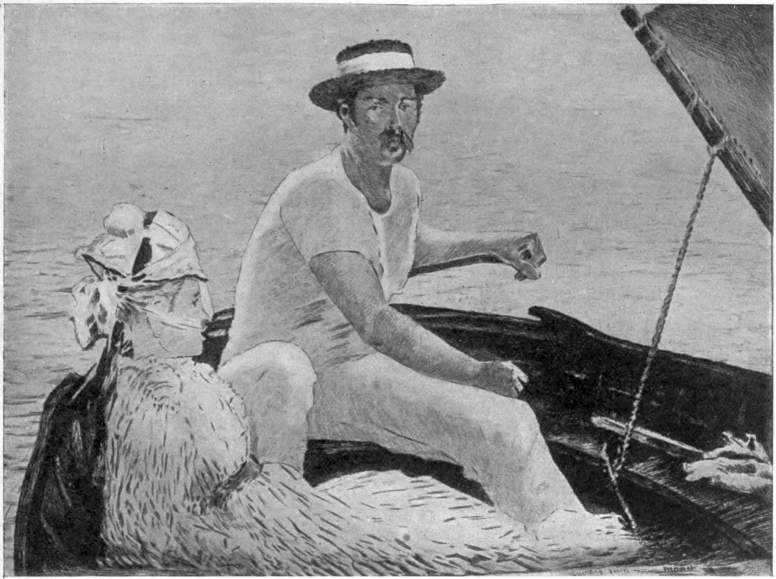 | |
| Baschet. | |
| MANET. | BOATING. |
 | |
| Gaz. des Beaux-Arts. | |
| MANET. | A BAR AT THE FOLIES-BERGÈRES. |
This movement, so historically memorable, when Manet discovered the sun and the fine fluid of the atmosphere, was shortly before 1870. Not long before the declaration of war he was in the country, in the neighbourhood of Paris, staying with his friend de Nittis; but he continued to work as though he were at home, only his studio was here the pleasure-ground. Here one day he sat in full sunlight, placed his model amid the flowers of the turf, and began to paint. The result was “The Garden,” now in the possession of Madame de Nittis. The young wife of the Italian painter is reclining in an easy-chair, between her husband, who is lying on the grass, and her child asleep in its cradle. Every flower is fresh and bright upon the fragrant sward. The green of the stretch of grass is luminous, and everything is bathed in soft, bright atmosphere; 117 the leaves cast their blue shadows upon the yellow gravel path. “Plein-air” made its entry into painting.
In 1870 his activity had to be interrupted. He entered a company of Volunteers consisting chiefly of artists and men of letters, and in December he became a lieutenant in the Garde Nationale, where he had Meissonier as his colonel. The pictures, therefore, in which he was entirely Manet belong exclusively to the period following 1870.
From this time his great problem was the sun, the glow of daylight, the tremor of the air upon the earth basking in light. He became a natural philosopher who could never satisfy himself, studying the effect of light and determining with the observation of a man of science how the atmosphere alters the phenomena of colour.
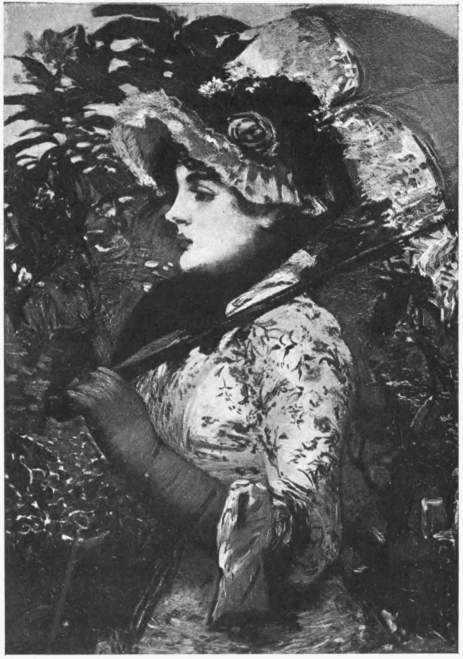 |
| Baschet. |
| MANET. SPRING: JEANNE. |
In tender, virginal, light grey tones, never seen before, he depicted, in fourteen pictures exhibited at a dealer’s, the luxury and grace of Paris, the bright days of summer and soirées flooded with gaslight, the faded features of the fallen maiden and the refined chic of the woman of the world. There was to be seen “Nana,” that marvel of audacious grace. Laced in a blue silk corset, and otherwise clad merely in a muslin smock with her feet in pearl-grey stockings, the blond woman stands at the mirror painting her lips, and carelessly replying to the words of a man who is watching her upon the sofa behind. Near it hung balcony scenes, fleeting sketches from the skating rink, the café concert, the Bal de l’Opéra, the déjeuner scene at Père Lathuille’s, and the “Bar at the Folies-Bergères.” In one case he has made daylight the subject of searching study, in another the artificial illumination of the footlights. “Music in the Tuileries” reveals a crowd of people swarming in an open, sunny place. Every figure was introduced as a patch of colour, but these patches were alive and this multitude spoke. One of the best pictures was “Boating”—a craft boldly cut away in its 118 frame, after the manner of the Japanese, and seated in it a young lady in light blue and a young man in white, their figures contrasting finely with the delicate grey of the water and the atmosphere impregnated with moisture. And scattered amongst these pictures there were to be found powerful sea-pieces and charming, piquant portraits.
Manet had a passion for the world. He was a man with a slight and graceful figure, a beard of the colour known as blond cendré, deep blue eyes filled with the fire of youth, a refined, clever face, aristocratic hands, and a manner of great urbanity. With his wife, the highly cultured daughter of a Dutch musician, he went into the best circles of Parisian society, and was popular everywhere for his trenchant judgment and his sparkling intellect. His conversation was vivid and sarcastic. He was famous for his wit à la Gavarni. He delighted in the delicate perfume of drawing-rooms, the shining candle-light at receptions; he worshipped modernity and the piquant frou-frou of toilettes; he was the first who stood with both feet in the world which seemed so inartistic to others. Thus the progress made in the acquisition of subject and material may be seen even in the outward appearance of the three pioneers of modern art. Millet in his portrait stands in wooden shoes, Courbet in his shirt-sleeves; Manet wears a tall hat and a frock-coat. Millet, the peasant, painted peasants. Courbet, the democrat from the provinces, gave the rights of citizenship to the artisan, but without himself deserting the provinces and the bourgeoisie. He was repelled by everything either distinguished or refined. In such matters he could not find the force and vehemence which were all he sought. Manet, the Parisian and the man of refinement, gave art the elegance of modern life.
In the year 1879 he made the Parisian magistracy the offer of painting in the session-room of the Town Hall the entire Ventre de Paris, the markets, railway stations, lading-places, and public gardens, and beneath the ceiling a gallery of the celebrated men of the present time. His letter was unanswered, and yet it gave the impulse to all those great pictures of contemporary life painted afterwards in Paris and the provinces for the walls of public buildings. In 1880 he received, through the exertions of his friend Antonin Proust, a medal of the second class, the only one ever awarded to him. And the dealer Duret began to buy pictures from him; Durand-Ruel followed suit, and so did M. Faure, the singer of the Grand Opera, who himself is the owner of five-and-thirty Manets. The poor artist did not long enjoy this recognition. On 30th April 1883, the varnishing day at the Salon, he died from blood-poisoning and the consequences of the amputation of a leg.
But the seed which he had scattered had already thrown out roots. It had taken him years to force open the doors of the Salon, but to-day his name shines in letters of gold upon the façade of the École des Beaux-Arts as that of the man who has spoken the most decisive final utterance on behalf of the liberation of modern art. His achievement, which seems to have been an unimportant alteration in the method of painting, was in reality a renovation in the method of looking at the world and a renovation in the method of thinking.
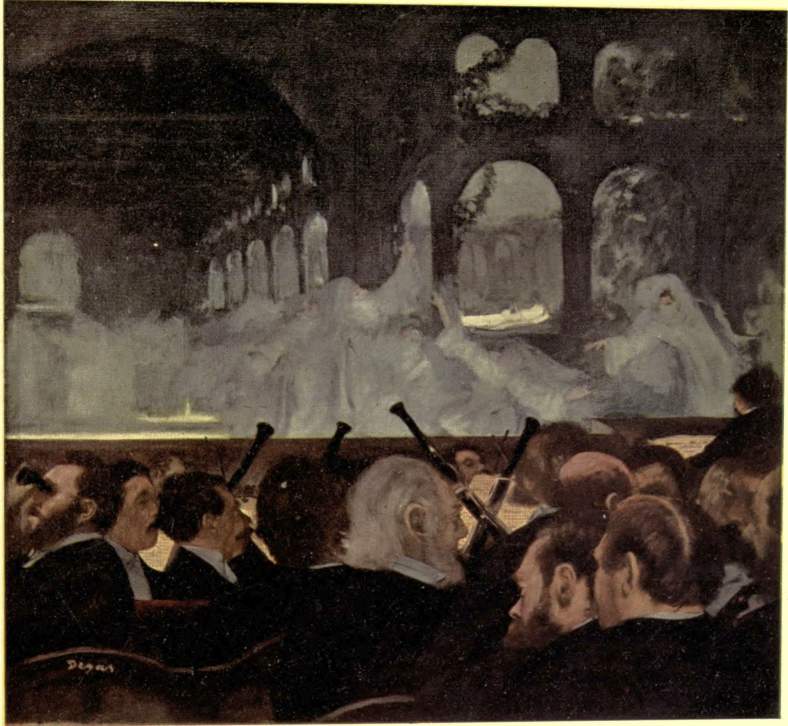 | |
| Mansell Photo. | |
| DEGAS. | THE BALLET SCENE IN ROBERT THE DEVIL. |
 | |
| DEGAS. | THE BALLET IN DON JUAN. |
| (By permission of M. Durand-Ruel, the owner of the copyright.) | |
 |
| DEGAS. A BALLET DANCER. |
| (By permission of M. Durand-Ruel, the owner of the copyright.) |
Up to this time it was only the landscape painters who had emancipated themselves from imitation of the gallery tone, and what was done by Corot in landscape had, logically enough, to be carried out in figure-painting likewise; for men and women are encompassed by the air as much as trees. After the landscape painters of Barbizon had made evident the vast difference between the light of day and that of a closed room in their pictures painted in the open air, the figure-painters, if they made any claim to truth of effect, could no longer venture to content themselves with the illumination falling upon their models in the studio, when they were painting incidents taking place out of doors. Yet even the boldest of the new artists did not set themselves free from tradition. Even after they had become independent in subject and composition they had remained the slaves of the old masters in their intuition of colour. Some imitated the Spaniards, without reflecting that Ribera painted his pictures in a small, dark studio, and that the cellar-light with which they were illuminated was therefore correct, whereas applied, in the present age, to the bright interiors of the nineteenth century it was utterly false. Others treated open-air scenes as if they were taking place in a ground-floor parlour, and endeavoured by curtains and shutters to create a light similar to that which may be found in old masters and pictures dimmed with age. Or the artist painted according to a general recipe and in complete defiance of what he saw with his eyes. For instance, an exceedingly characteristic episode is told of the student days of Puvis de Chavannes. Upon a grey, misty day the young artist had painted a nude figure. The model appeared enveloped in tender light as by a bright, silvery halo. “That’s the way you see your model?” grumbled Couture indignantly when he came to correct the picture. Then he mixed together white, cobalt blue, Naples yellow, and vermilion, and turned Puvis de Chavannes’ nude grey figure by a universal recipe into one that was highly coloured and warmly luminous—such a figure as an old master might perhaps have painted under different conditions of light. With his “Fiat Lux” Manet uttered a word of redemption that 122 had hovered upon many lips. The jurisdiction of galleries was broken now also in regard to colour; the last remnant of servile dependence upon the mighty dead was cast aside; the aims attained by the landscape painters thirty years before were reached in figure-painting likewise.
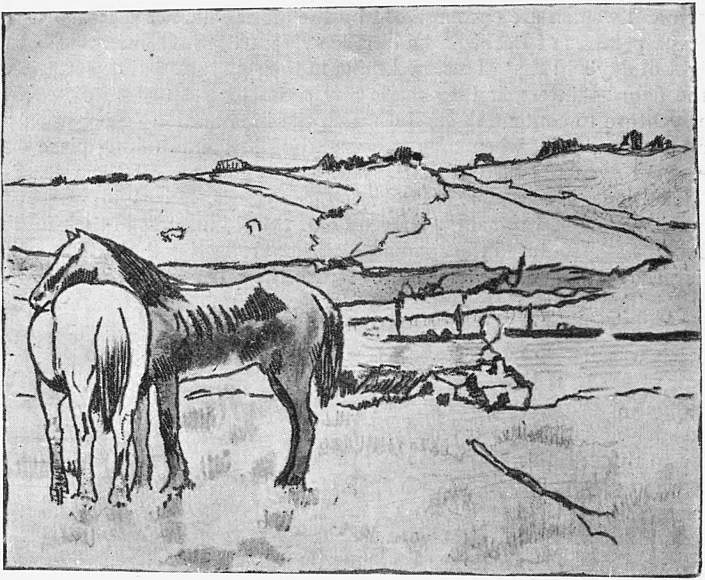 | |
| DEGAS. | HORSES IN A MEADOW. |
| (By permission of M. Durand-Ruel, the owner of the copyright.) | |
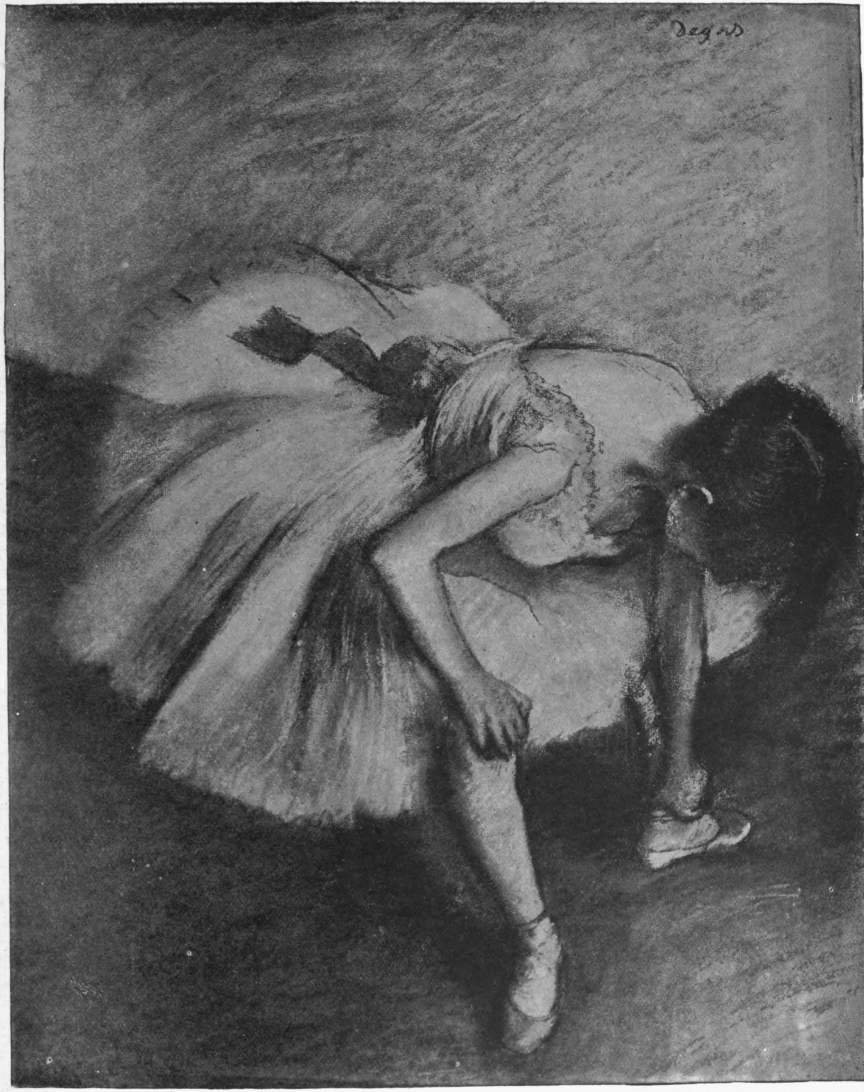 | |
| DEGAS. | DANCING GIRL FASTENING HER SHOE. |
Perhaps a later age may even come to recognise that Manet made an advance upon the old masters in his delicacy and scrupulous analysis of light; in that case it will esteem the discovery of tone-values as the chief acquisition of the nineteenth century, as a conquest such as has never been made in painting since the Eycks and Masaccio, since the establishment of the theory of perspective. In a treatise commanding all respect Hugo Magnus has written of how the sense of colour increased in the various periods of the world’s history; since the appearance of the Impressionists, verification may be made of yet another advance in this direction. The study of tone-values has never been carried on with such conscientious exactitude, and in regard to truth of atmosphere one is disposed to believe that our eyes to-day see and feel things which our ancestors had not yet noticed. The old masters have also touched the problem of “truth in painting.” It is not merely that the character of their colours often led the Italian tempera and fresco painters to the most natural method of treating light. They even occupied themselves in a theoretical way with the question. An old Italian precept declares that the painter ought to work in a closed yard beneath an awning, but should place his model beneath the open sky. In the frescoes which he painted in Arezzo in 1480, Piero della Francesca, in particular, pursued the problem of plein-air painting with a fine instinct. But love of the beautiful and luminous tints, such as the technique of oil-painting enabled artists to attain at a later date, quickly seduced them from carrying out the natural treatment of light in the gradation of colour. Under the influence of oil-painting the Italians of the great period, from Leonardo onwards, turned more and more to strong contrasts. And in spite of Albert Cuyp, even the Dutch landscape painters of the seventeenth century have seen objects rather in line and form, plastically, than pictorially in their environment of light and air. The nineteenth century was the first seriously to attack a problem which—except by Velasquez—had been merely touched upon by the old schools, but never solved.
 | |
| RENOIR. | SUPPER AT BOUGIVAL. |
| (By permission of M. Durand-Ruel, the owner of the copyright.) | |
 |
| RENOIR. THE WOMAN WITH THE FAN. |
| (By permission of M. Durand-Ruel, the owner of the copyright.) |
What the masters of Barbizon had done through instinctive genius was made the object of scientific study by the Impressionists. The new school set up the principle that atmosphere changes the colour of objects; for instance, that the colour and outline of a tree painted in a room are completely different from those of the same tree painted upon the spot in the open air. As an unqualified rule they claimed that every incident was to be harmonised with time, place, and light; thus a scene taking place out of doors had of necessity to be painted, not within four walls, but under the actual illumination of morning, or noon, or evening, or night. In making this problem the object of detailed and careful inquiry the artist came to analyse life, throbbing beneath its veil of air and light, with more refinement and thoroughness than the old masters had done. The latter painted light deadened in its fall, not shining. Oils were treated as an opaque material, colour appeared to be a substance, and the radiance of tinted light was lost through this material heaviness. Courbet still represented merely the object apart from its environment; he saw things in a plastic way, and not as they were, bathed in the atmosphere; his men and women lived in oil, in brown sauce, and not where it was only possible for them to live—in the air. Everything he painted he isolated without a thought of atmospheric surroundings. Now a complete change of parts was effected: bodies and colours were no longer painted, but the shifting power of light under which everything changes form and colour at every moment of the day. The elder painters in essentials confined light to the surface of objects; the new painters believed in its universality, beholding in it the father of all life and of the manifold nature of the visible world, and therefore of colour also. They no longer painted colours and forms with lights and cast-shadows, but pellucid light, pouring over forms and colours and absorbed and refracted by them. They no longer looked merely to the particular, but to the whole, no longer saw nothing except deadened light and cast-shadows, but the harmony and pictorial charm of a moment of nature considered as such. With a zeal which at times seemed almost paradoxical, they proceeded to establish the importance of the phenomena of light. They discovered that, so far from being gilded, objects are silvered by sunlight, and they made every effort to analyse the multiplicity of these fine gradations down to their most delicate nuances. They learnt to paint the quiver of tremulous sunbeams radiating far and wide; they were the lyrical poets of light, which they often glorified at the expense of what it envelops and causes to live. At the service of art they placed a renovated treasury of refined, purified, and pictorial phases of expression, in which the history of art records an increase in the human eye of the sense of colour and the power of perception.
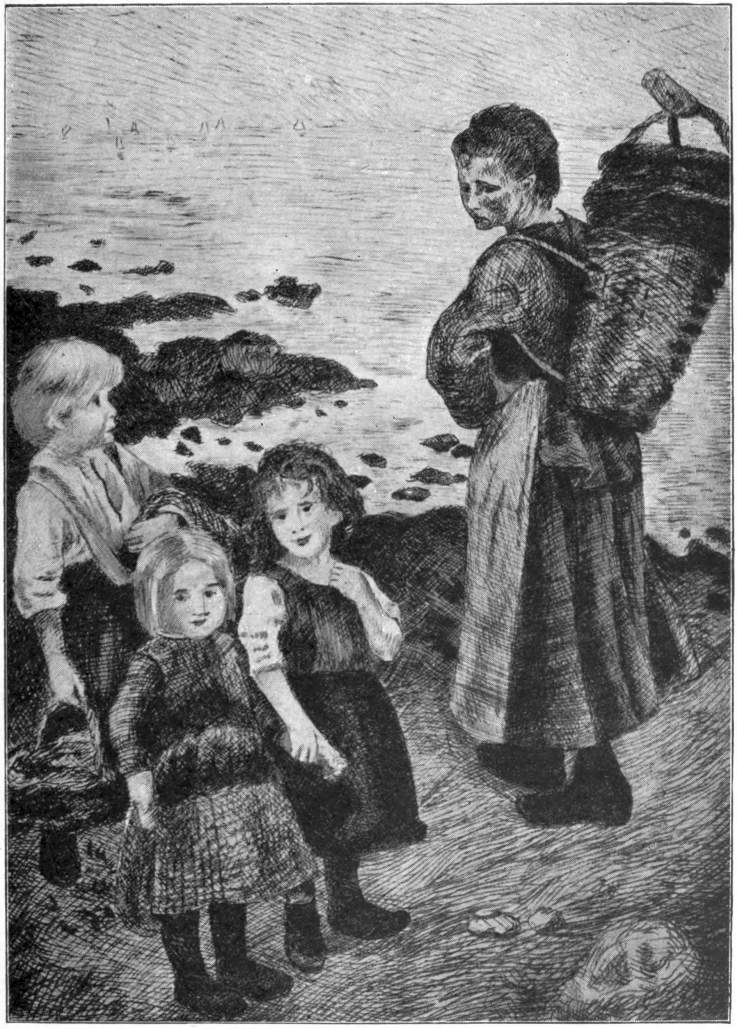 | |
| RENOIR. | FISHER CHILDREN BY THE SEA. |
| (By permission of M. Durand-Ruel, the owner of the copyright.) | |
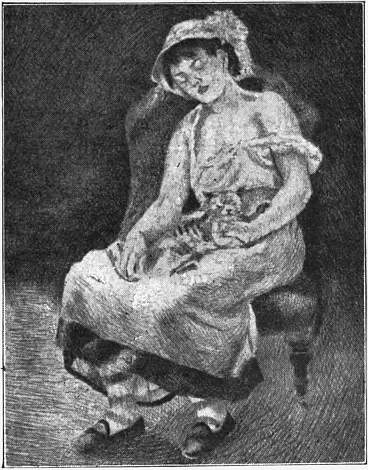 |
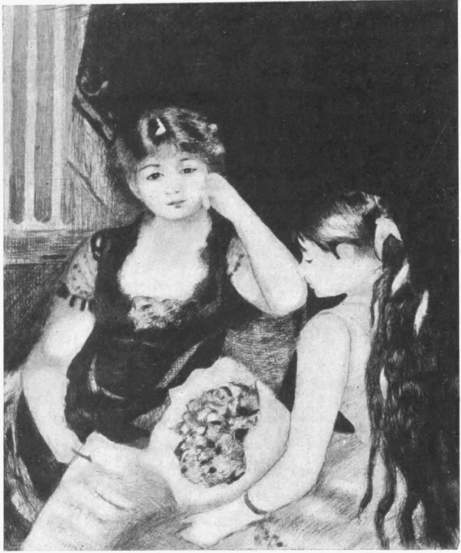 | ||
| RENOIR. | THE WOMAN WITH THE CAT. | RENOIR. | A PRIVATE BOX. |
| (By permission of M. Durand-Ruel, the owner of the copyright.) | (By permission of M. Durand-Ruel, the owner of the copyright.) | ||
That light is movement is here made obvious, and that all life is movement is just what their art reveals. Courbet was an admirable painter of plain surfaces. If he had to paint a wall he took it upon his strong shoulders and transferred it to his canvas in such a way that a stonemason might have been deceived. If it was a question of rocks, the body of a woman, or the waves of the sea, he began to mix his pigments thick, laid a firm mass of colour on the canvas, and spread it with a knife. This spade-work gave him unrivalled truth to nature in reproducing the surface of hard substances. Rocks, banks, and walls look as they do in nature, but in the case of moving, indeterminate things his power deserts him. His landscapes are painted in a rich, broad, and juicy style, but his earth has no pulsation. Courbet has forgotten the birds in his landscape. His seas have been seen with extraordinary largeness of feeling, and they are masterpieces of drawing; the only drawback is that they seem uninhabitable for fish. Under the steady hand of the master the sea came to a standstill and was changed into rock. If he has to paint human beings they stand as motionless as blocks of wood. The expression of their faces seems galvanised into life, like their bodies. Placing absolute directness in the rendering of impressions in their programme, as the chief aim of their artistic endeavours, the Impressionists were the first to discover the secret of seizing with the utmost freshness the nuances of expression and movement, which remained petrified in the hands of their predecessors. Only the flash of the spokes is painted in the wheel of a carriage in motion, and never the appearance of the wheel when it is at rest; in the same way they allow the outlines of human figures to relax and become indistinct, to call up the impression of movement, the real vividness of the appearance. Colour has been established as the sole, unqualified medium of expression for the painter, and has so absorbed the drawing that the line receives, as it were, a pulsating life, and cannot be felt except in a pictorial way. In the painting of nude human figures the waxen look—which in the traditional painting from the nude had a pretence of being natural—has vanished from the skin, and thousands of delicately distinguished gradations give animation to the flesh. Moreover, a finer and deeper observation of temperament was made possible by lighter and more sensitive technique. In the works of the earlier genre painters people never are what they 130 are supposed to represent. The hired model, picked from the lower strata of life, and used by the painter in bringing his picture slowly to completion, was obvious even in the most elegant toilette; but now real human beings are represented, men and women whose carriage, gestures, and countenances tell at once what they are. Even in portrait painting people whom the painter has surprised before they have had time to put themselves in order, at the moment when they are still entirely natural, have taken the place of lay-figures fixed in position. The effort to seize the most unconstrained air and the most natural position, and to arrest the most transitory shade of expression, produces, in this field of art also, a directness and vivacity divided by a great gulf from the pose and the grand airs of the earlier drawing-room picture.
From his very first appearance there gathered round Manet a number of young men who met twice a week at a café in Batignolles, formerly a suburb at the entrance of the Avenue de Clichy. After this trysting-place the society called itself L’École des Batignolles. Burty, Antonin Proust, Henner, and Stevens put in an occasional appearance, but Legros, Whistler, Fantin-Latour, Duranty, and Zola were constant visitors. Degas, Renoir, Pissarro, Sisley, Monet, Gauguin, and Zandomeneghi were the leading spirits of the impressionistic staff, and, being excluded from the official Salon, they generally set up their tent at Nadar’s, Reichshofen’s, or some other dealer’s. These are the names of the men who, following Manet, were the earliest to make the new problem the object of their studies.
Degas, the subtle colourist and miraculous draughtsman, who celebrates dancers, gauze skirts, and the foyers of the Opera, is the boldest and the most original of those who banded together from the very outset of the movement—the worst enemy of everything pretty and banal, the greatest dandy of modern France, the man whose works are caviare to the general and so refreshing to the gourmet, the painter who can find a joy in the sublime beauty of ugliness.
 |
| RENOIR. THE TERRACE. |
| (By permission of M. Durand-Ruel, the owner of the copyright.) |
Degas was older than Manet. He had run through all phases of French art since Ingres. His first pictures, “Spartan Youths” and “Semiramis building the Walls of Babylon,” might indeed have been painted by Ingres, to whom he looks up even now as to the first star in the firmament of French art. Then for a time he was influenced by the suggestive and tender intimacy in feeling and the soft, quiet harmony of Chardin. He had also an enthusiasm for Delacroix: less for his exaggerated colouring than for the lofty mark of style in the gestures and movements painted by this great Romanticist, which Degas endeavoured to transfer to the pantomime of the ballet. From Manet he learnt softness and fluency of modelling. And finally the Japanese communicated to him the principle of their dispersed composition, the choice of standpoint, allowing the artist to look up from beneath or down from above, the taste for fantastic decoration, the suggestive method of emphasising this and suppressing that, the surprise of detail introduced here and there in a perfectly arbitrary fashion. From the original and bizarre union of all these elements he formed his exquisite, marvellously expressive, and entirely personal style, which is hard to describe with the pen, and would be defectively indicated by reference to Besnard, who is allied to him in the treatment of light. It is only in literature that Degas has a parallel. If a comparison between them be at all possible, it might be said that his style in many ways recalls that of the brothers de Goncourt. As these have enriched their language with a new vocabulary for the expression of new emotions, Degas has made for himself a new technique. Utterly despising everything pretty and anecdotic, he has the secret of gaining the effect intended by refinements of drawing and tone-values, just as the de Goncourts by the association of words; he has borrowed phrases from all the lexicons of painting; he has mixed oils, pastel, and water-colour together, and, such as he is to-day, he must, like the 132 de Goncourts, be reckoned amongst the most delicate and refined artists of the century.
His range of subjects finds its limit in one point: he has the greatest contempt for banality, for the repetition of others and of himself. Every subject has to give opportunity for the introduction of special models, not hitherto employed, of pictorial experiments and novel problems of light. He made his starting-point, the grace and charming movements of women. Trim Parisian laundresses in their spotless aprons, little shop-girls in their boutiques, the spare grace of racehorses with their elastic jockeys, marvellous portraits, like that of Duranty, women getting out of the bath, the movements of the workwoman, and the toilette and négligé of the woman of the world, boudoir scenes, scenes in court, and scenes in boxes at the theatre—he has painted them all. And with what truth and life! How admirably his figures stand! how completely they are what they give themselves out to be! The Circus and the Opera soon became his favourite field of study. In his ballet-girls he found fresher artistic material than in the goddesses and nymphs of the antique.
At the same time the highest conceivable demands were here made on the capacities of the painter and the draughtsman, and on his powers of characterisation. Of all modern artists Degas is the man who creates the greatest illusion as an interpreter of artificial light, of the glare of the footlights before which these décolleté singers move in their gauze skirts. And these dancers are real dancers, vivid every one of them, every one of them individual. The nervous force of the born ballerina is sharply differentiated from the apathy of the others who merely earn their bread by their legs. How fine are his novices with tired, faded, pretty faces, when they have to sweep a curtsey, and pose so awkwardly in their delightful shyness. How marvellously he has grasped the fleeting charm of this moment. With what spirited nonchalance he groups his girls enveloped in white muslin and coloured sashes. Like the Japanese, he claims the right of rendering only what interests him and appears to make a striking effect—“the vivid points,” in Hokusai’s phrase—and does not hold himself bound to add a lifeless piece of canvas for the sake of “rounded composition.” In pictures, where it is his purpose to show the varied forms of the legs and feet of his dancers, he only paints the upper part of the orchestra and the lower part of the stage—that is to say, heads, hands, and instruments below, and dancing legs above. He is equally uncompromising in his street and racing scenes, so that often it is merely the hindquarters of the horses and the back of the jockey that are visible. His pictures, however, owe not a little of their life and piquancy to this brilliant method of cutting through the middle, and to these triumphant evasions of all the vulgar rules of composition. But, for the matter of that, surely Dürer knew what he was about when, in his pictures of apocalyptic riders, instead of completing the composition, he left it fragmentary, to create an impression of the wild gallop.
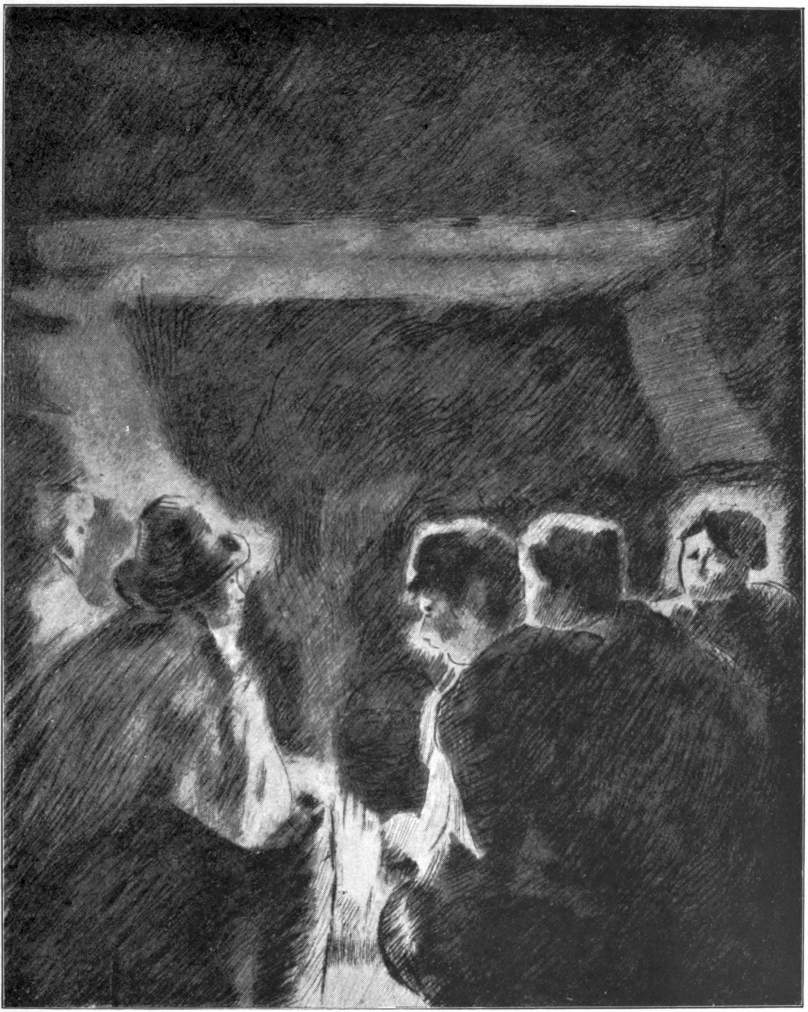 | |
| C. PISSARRO. | SITTING UP. |
| (By permission of M. Durand-Ruel, the owner of the copyright.) | |
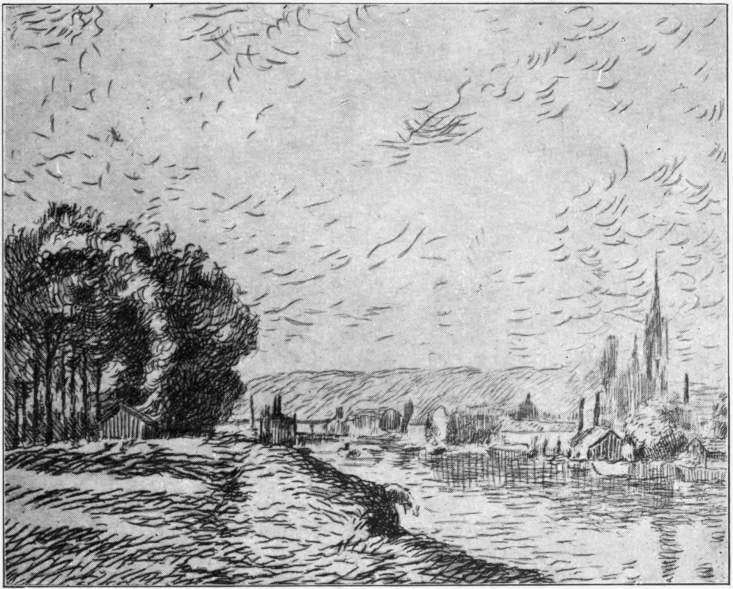 | |
| C. PISSARRO. | ROUEN. |
| (By permission of M. Durand-Ruel, the owner of the copyright.) | |
A special group amongst the artist’s ballet pictures is that in which he represents the training of novices, the severe course through which the grub must pass before taking wing as a butterfly. Here is displayed a strange fantastic anatomy, only comparable to the acrobatic distortions to which the Japanese are so much addicted in their art. But it is precisely these pictures which were of determining importance for the development of Degas. In the quest of unstable lines and expressions, instead of feeling reality in all its charming grace, he came to behold it only in its degeneration. He was impelled to render the large outline of the modern woman—the female figure which has grown to be a product of art beneath the array of toilette—even in the most ungraceful moments. He painted the woman who does not suspect that she is being observed; he painted her seen, as it were, through the key-hole or the slit of a curtain, and making, to some extent, the most atrociously ugly movements. He was the merciless observer of creatures whom society turns into machines for its pleasure—dancing, racing, and erotic machines. He has depicted cruelly the sort of woman Zola has drawn in Nana—the woman who has no expression, no play in her eyes, the woman who is merely animal, motionless as a Hindu idol. His pictures of this class are a natural history of prostitution of terrible veracity, a great poem on the flesh, like the works of Titian and Rubens, except that in the latter blooming beauty is the 136 substance of the brilliant strophes, while in Degas it is wrinkled skin, decaying youth, and the artificial brightness of enamelled faces. “A vous autres il faut la vie naturelle, à moi la vie factice.”
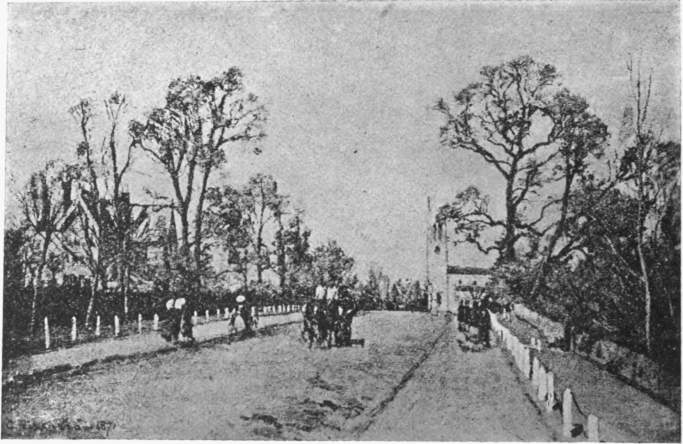 | |
| L’Art française. | |
| PISSARRO. | SYDENHAM CHURCH. |
This sense of having lived too much expressed itself also in the haughty contempt with which he withdrew himself from exhibitions, the public, and criticism. Any one who is not a constant visitor at Durand-Ruel’s has little opportunity of seeing the pictures of Degas. The conception of fame is something which he does not seem to possess. Being a man of cool self-reliance, he paints to please himself, without caring how his pictures may suit the notions of the world or the usages of the schools. For years he has kept aloof from the Salon, and some people say that he has never exhibited at all. And he keeps at as great a distance from Parisian society. In earlier days, when Manet, Pissarro, and Duranty met at the Café Nouvelle Athènes, he sometimes appeared after ten o’clock—a little man with round shoulders and a shuffling walk, who only took part in the conversation by now and then breaking in with brief, sarcastic observations. After Manet’s death he made the Café de la Rochefoucauld his place of resort. And young painters went on his account also to the Café de la Rochefoucauld and pointed him out to each other, saying, “That is Degas.” When artists assemble together the conversation usually turns upon him, and he is accorded the highest honours by the younger generation. He is revered as the haughty Independant who stands unapproachably above the profanum vulgus, the great unknown who never passed through the ordeal of a hanging committee, but whose spirit hovers invisibly over every exhibition.
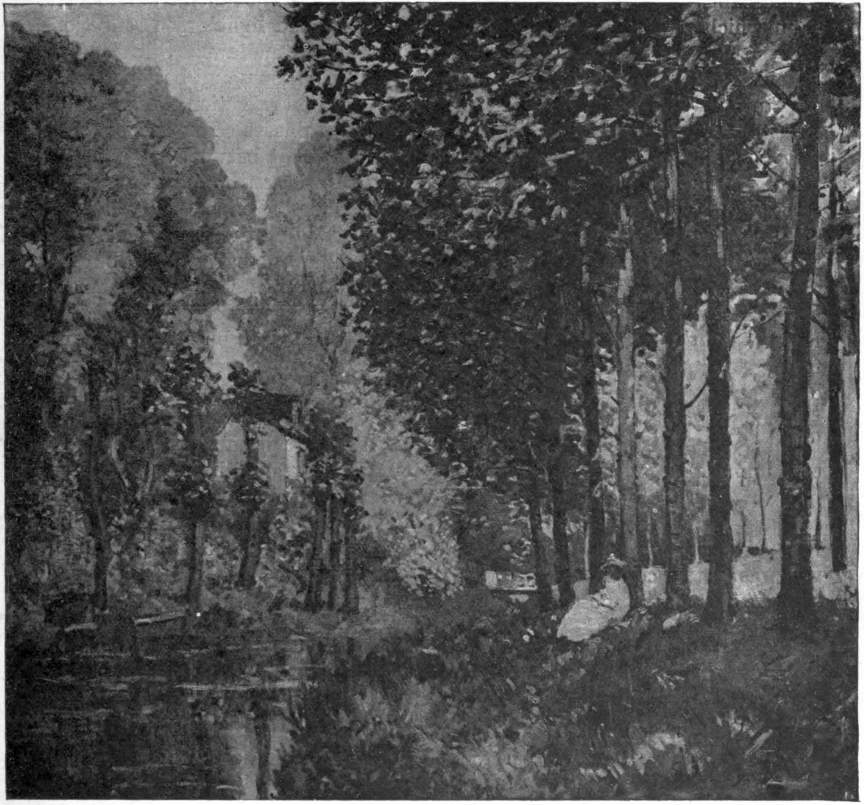 | |
| SISLEY. | OUTSKIRTS OF A WOOD. |
A refined charmeur, Auguste Renoir, has made important discoveries, in portrait painting especially. He is peculiarly the painter of women, whose elegance, delicate skin, and velvet flesh he interprets with extraordinary deftness. Léon Bonnat’s portraits were great pieces of still-life. The persons sit as if they were nailed to their seats. Their flesh looks like zinc and their clothes like steel. In Carolus Duran’s hands portrait painting degenerated into a painting of draperies. Most of his portraits merely betray the amount which the toilettes have cost; they are inspired by their rich array of silk and heavy curtains; often they are crude symphonies in velvet and satin. The rustle of robes, the dazzling—or loud—fulness of colour in glistening materials, gave him greater pleasure than the lustre of flesh-tints and any 138 glance of inquiry into the moral temperament of his models. Renoir endeavours to arrest the scarcely perceptible and transitory movements of the features and the figure. Placing his persons boldly in the real light of day which streams around, he paints atmospheric influences in all their results, like a landscapist. Light is the sole and absolute thing. The fallen trunk of a tree upon which the broken sunlight plays in yellow and light green reflections, and the body or head of a girl, are subject to the same laws. Stippled with yellowish-green spots of light, the latter loses its contours and becomes a part of nature. With this study of the effects of light and reflection there is united an astonishing sureness in the analysis of sudden phases of expression. The way in which laughter begins and ends, the moment between laughter and weeping, the passing flash of an eye, a fleeting motion of the lips, all that comes like lightning and vanishes as swiftly, shades of expression which had hitherto seemed indefinable, are seized by Renoir in all their suddenness. In the portraits of Bonnat and Duran there are people who have “sat,” but here are people from whom the painter has had the power of stealing and holding fast the secret of their being at a moment when they were not “sitting.” Here are dreamy blond girls gazing out of their great blue eyes, ethereal fragrant flowers, like lilies leaning against a rose-bush through which the rays of the setting sun are shining. Here are coquettish young girls, now laughing, now pouting, now blithe and gay, now angry once more, and now betwixt both moods in a charming passion. And there are women of the world of consummate elegance, slender and slight-built figures, with small hands and feet, an even pallor, almond-shaped eyes catching every light, moist shining lips of a tender grace, bearing witness to a love of pleasure refined by artifice. And children especially there are, children of the sensitive and flexuous type: some as yet unconscious, dreamy, and free from thought; others already animated, correct in pose, graceful, and wise. The three girls, in his “Portrait of Mesdemoiselles M——,” grouped around the piano, the eldest playing, the second accompanying upon the violin, and the youngest quietly attentive, with both hands resting upon the piano, are exquisite, painted with an entirely naïve and novel truth. All the poses are natural, all the colours bright and subtle—the furniture, the yellow bunches of flowers, the fresh spring dresses, the silk stockings. But such tender poems of childhood and blossoming girlhood form merely a part of Renoir’s work. In his “Dinner at Chaton” a company of ladies and gentlemen are seated at table, laughing, talking, and listening; the champagne sparkles in the glasses, and the cheerful, easy mood which comes with dessert is in the ascendant. In his “Moulin de la Galette” he painted the excitement of the dance—whirling pairs, animated faces, languid poses, and everything enveloped in sunlight and dust. Renoir’s peculiar field is the study of the various delicate emotions which colour the human countenance.
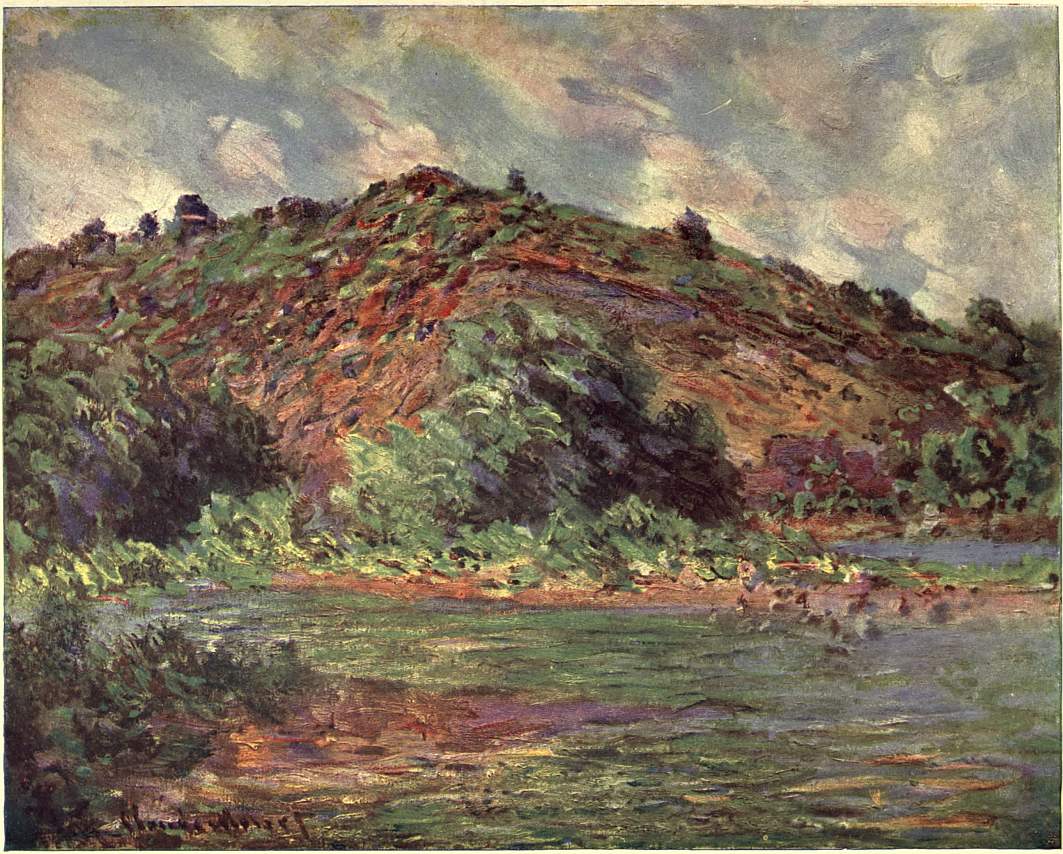 | |
| MONET. | A STUDY. |
| By permission of M. Durand-Ruel. | |
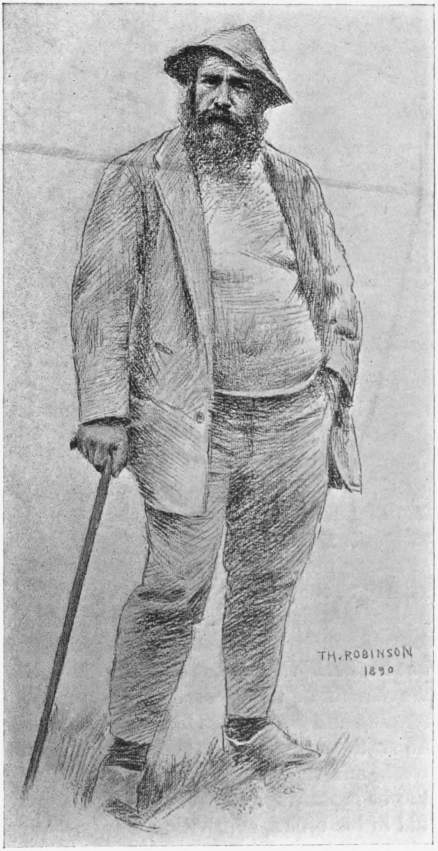 |
| CLAUDE MONET. The Century. |
The merit of Camille Pissarro is to have once more set the painting of peasants, weakened by Breton, upon the virile lines of Millet, and to have supplemented them in those places where Millet was technically inadequate. When the Impressionist movement began Camille Pissarro had already a past: he was the recognised landscape painter of the Norman plains; the straightforward observer of peasants, the plain and simple painter of the vegetable gardens stretching round peasant dwellings. Since Millet, no artist had placed himself in closer relationship to the life of the earth and of cultivated nature. Though a delicate analyst, Pissarro had not the epic feeling nor the religious mysticism of Millet; but like Millet he was a rustic in spirit, like him a Norman, from the land of vineyards, of large farmyards, green meadows, soft avenues of poplars, and wide horizons reddened by the sun. He was healthy, tender, and intimate in feeling, rejoiced in the richness of the land and the voluptuous undulation of fields, and he could give a striking impression of a region in its work-a-day character. Celebrated in the press as the legitimate descendant of Millet, he might have contented himself with his regular successes. He had, indeed, arrived at an age when men usually leave off making experiments, and reap what they have sown in their youth, at an age when many conquerors occupy themselves with the mechanical reproduction of their own works. Nevertheless the Impressionistic movement became for Pissarro the starting-point of a new way.
He aimed at fresher, intenser, and more transparent light, at a more cogent observation of phenomena, at a more exact analysis of the encompassing atmosphere. He celebrated the eternal, immutable light in which the world is bathed. He loved it specially during clear afternoons, when it plays over bright green meadows fringed by soft trees, or at the foot of low hills. He has sought it on the slopes across which it ripples deliciously, on the plains from which it rises like a light veil of gauze. He studied the play of light upon the bronzed skin of labourers, on the coats of animals, on the foliage and fruit of trees. He characterised the seasons, the hour of day, the moment, with the conscientiousness of a peasant intent upon noting the direction of the wind and the position of the sun. The cold, chilly humour of autumn afternoons, the vivid clarity of sparkling wintry skies, the bloom and lightness of spring mornings, the oppressive brooding of summer, the luxuriance or the aridity of the earth, the young vigour of foliage or the fading of nature robbed of her adornment,—all these Pissarro has painted with largeness, plainness, and simplicity. He strays over the fields, watching the shepherd driving out his flock, the wains rumbling along the uneven roads, the quiet, rhythmical movement of the gleaners, the graceful gait of the women who have been reaping and now return home in the evening with a rake across their shoulders; he stations himself at the entrance of villages where the apple-pickers are at work, and the women minding geese stand by their drove; he notes the whole life of peasants, and gives truer and more direct intelligence of it than Millet did in his broad, synthetic manner. Where there is a classic quietude and an oily heaviness in Millet, there is in Pissarro palpitating life, transparence, and freshness. He sees the country in bright, laughing tones; and the pure white of the kerchiefs, the pale rose-colour or tender blue bodices of his peasant women, lend his pictures a blithe delicacy of colour. His girls are like fresh flowers of the field which the sun of June brings forth upon the meadows. There is something intense and yet soft, strong and delicate, true and rhythmical in Pissarro’s tender poems of country life.
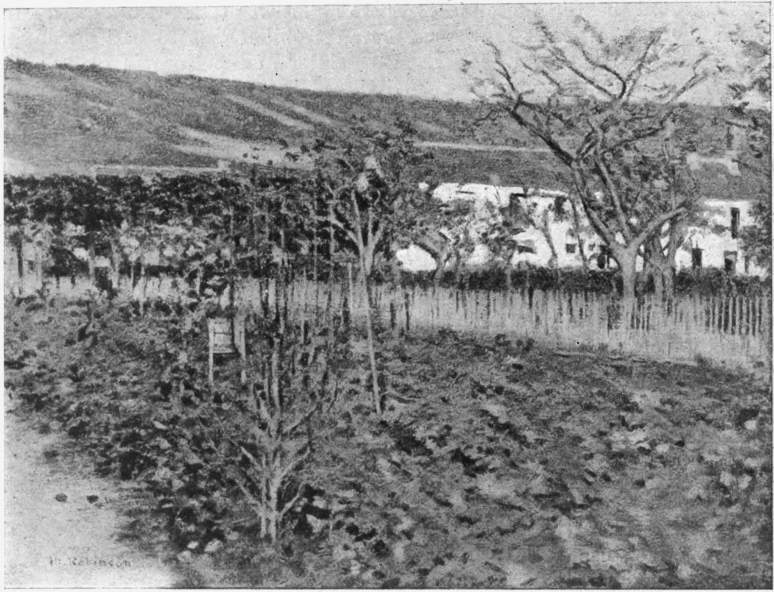 |
| The Century. |
| MONET’S HOME AT GIVERNY. |
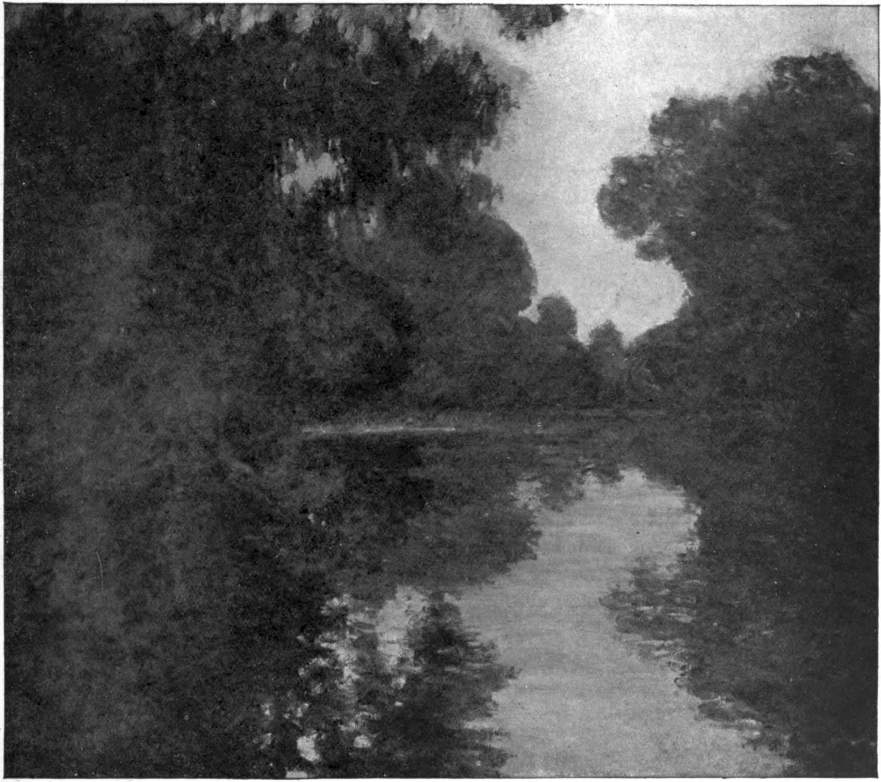 | |
| MONET. | MORNING ON THE SEINE. |
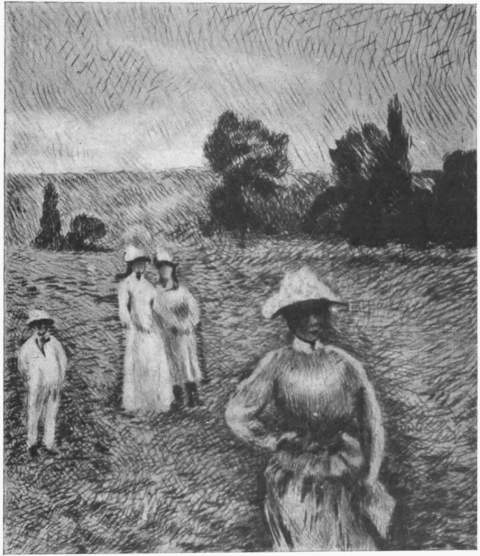 |
| MONET. A WALK IN GREY WEATHER. |
| (By permission of M. Durand-Ruel, the owner of the copyright.) |
So long as any advance beyond Rousseau and Corot seemed impossible, pictures of talent but only moderate importance had increased in number in the province of landscape. The landscape painters who immediately followed the great pioneers loved nature on account of her comparative coolness in summer; upon sites where the classic artists of Fontainebleau dreamed and painted they built comfortable villas and settled down with the sentiments of a householder. The country was parcelled out, and each one undertook his part, and painted it conscientiously without arousing any novel sensations. Impressionism gave landscape painting, which showed signs of being split into specialties, once more a firm basis, a charming field of study. To communicate impressions without any of the studio combinations, just as they strike us suddenly, to preserve the vividness and cogency of the first imprint of nature upon the mind, was the great problem which Impressionism placed before the landscape painters. The artists of Fontainebleau painted neither the rawness and rigidity of winter nor the sultry atmosphere and scorching heat of summer; they painted artistic and dignified and exquisite works. The Impressionists did not approach their themes as poets, but as naturalists. In their hands landscape, which in Corot, Millet, Diaz, Rousseau, Daubigny, and Jongkind is an occasional poem, becomes a likeness of a region under special influences of light. With more delicate nerves, and a sensibility almost greater, they allowed nature to work upon them, and perceived in the symphonies of every hour strains never heard before, transparent shadows, the vibration of atoms of light. 144 decomposing the lines of contour, that tremor of the atmosphere which is the breath of landscape. Here also England was not without influence. As Corot and Rousseau received an impulse from Constable and Bonington in 1830, Monet and Sisley returned from London with their eyes dazzled by the light of the great Turner. Laid hold upon, like Turner, by the miracles of the universe, by the golden haze which trembles in a sunbeam, they succeeded in painting light in spite of the defectiveness of our chemical mediums.
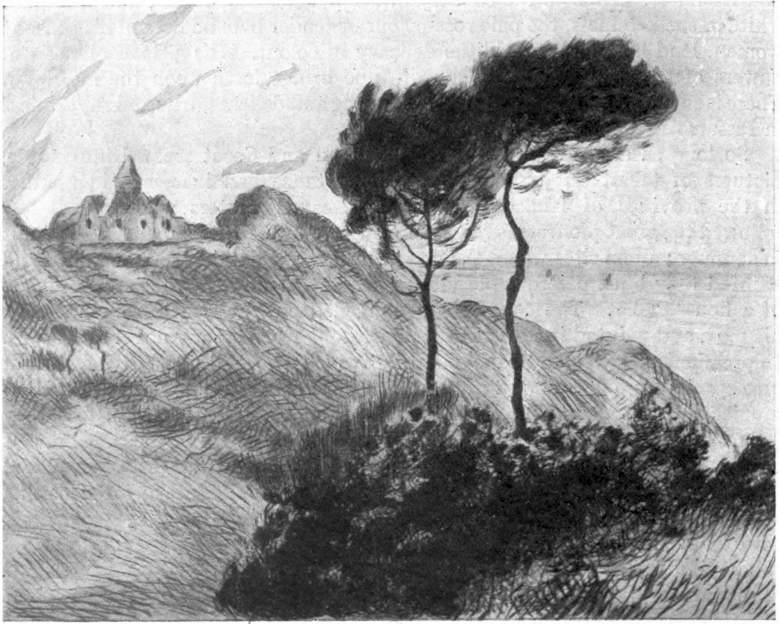 | |
| MONET. | THE CHURCH AT VARANGÉVILLE. |
| (By permission of M. Durand-Ruel, the owner of the copyright.) | |
Alfred Sisley might be compared with Daubigny. He settled in the neighbourhood of Moret, upon the banks of the Loing, and is the most soft and tender amongst the Impressionists. Like Daubigny, he loves the germinating energy, the blossoming, and the growth of young and luminous spring; the moist banks of quiet streamlets, budding beeches, and the rye-fields growing green, the variegated flowering of the meadows, clear skies, ladies walking in bright spring dresses, and the play of light upon the vernal foliage. He has painted tender mornings breathed upon with rosy bloom, reeds with a bluish gleam, and moist duck-weed, grey clouds mirrored in lonely pools, alleys of poplar, peasants’ houses, and hills and banks, melting softly in the warm atmosphere. His pictures, like those of the master of Oise, leave the impression of youth and freshness, of quiet happiness, or of smiling melancholy.
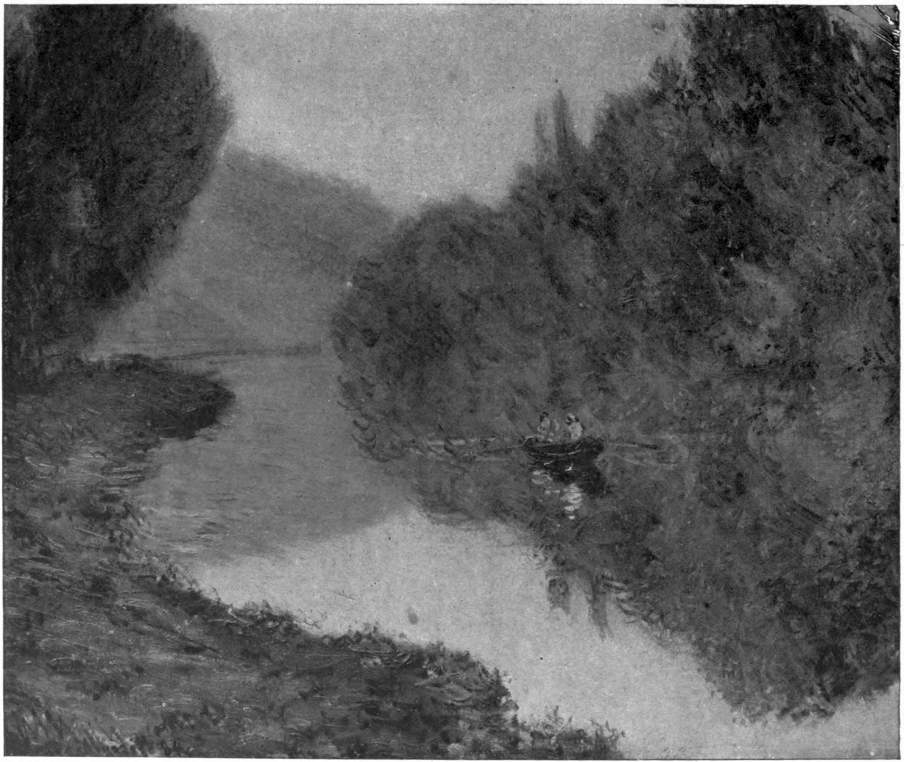 | |
| MONET. | RIVER SCENE. |
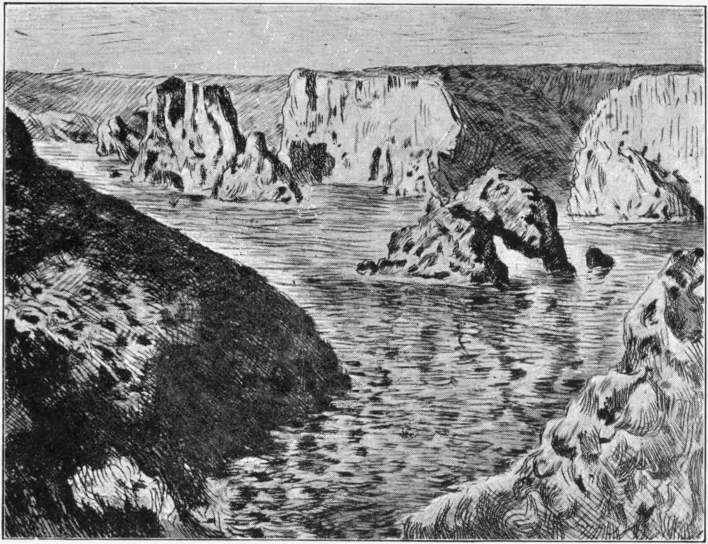 | |
| MONET. | THE ROCKS AT BELLE-ISLE. |
| (By permission of M. Durand-Ruel, the owner of the copyright.) | |
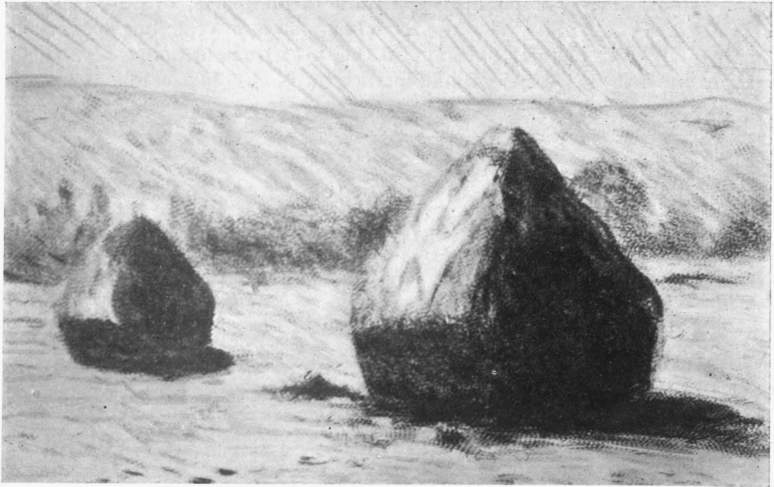 | |
| MONET. | HAY-RICKS. |
| (By permission of M. Durand-Ruel, the owner of the copyright.) | |
On many of his pictures, saturated as they are with light, Claude Monet could inscribe the name of Turner without inciting unbelief. In exceedingly unequal works, which are nevertheless full of audacity and genius, he has grasped what would seem to be intangible. Except Turner there is no one who has carried so far the study of the effects of light, of the gradations and reflections of sunbeams, of momentary phases of illumination, no one who has embodied more subtle and forcible impressions. For Monet man has no existence, but only the earth and the light. He delights in the rugged rocks of Belle-Isle, and the wild banks of the Creuse, when the oppressive sun of summer is brooding over them. He paints phenomena as transitory as the shades of expression in Renoir. The world appears in a glory of light, such as it only has in fleeting moments, and such as would be blinding were it always to be seen. Nature, in his version, is an inhospitable dwelling where it is impossible to dream and live. One hopes sometimes to hear a word of intimate association from Monet—but in vain; Claude Monet is only an eye. Carouses of sunshine and orgies in the open air are the exclusive materials of his pictures. Thus he has little to say for those who seek the soul of a human being in every landscape. Like Degas, he is par excellence the master in technique 148 whose highest endeavour is to enrich the art of painting with novel sensations and unedited effects, even if it has to be done by violence. There are sea-pieces filled with the spirit of evening, when the sea, red as a mirror of copper, merges into the glory of the sky, in a great radiant ocean of infinity; moods of evening storm, when gloomy clouds over the restless tree-tops race across the smoky red sky, losing tiny shreds in their flight, little thin strips of loosened cloud, saturated through and through with a wine-red glow by the splendour of the sun. Or there are spring meadows fragrant with bloom, and hills parched by the sun; rushing trains with their white smoke gleaming in the light; yellow sails scudding over glittering waters; waves shining blue, red, and golden; and burning ships, with shooting tongues of flame leaping upon the masts; and, behind, a jagged rim of the evening glow. Claude Monet has followed light everywhere—in Holland, Normandy, the South of France, Belle-Isle-en-Mer, the villages of the Seine, London, Algiers, Brittany. He became an enthusiast for nature as she is in Norway and Sweden, for French cathedrals rising into the sky, tall and fair, like the peaks of great promontories. He interpreted the surge of towns, the movement of the sea, the majestic solitude of the sky. But he knows too that the artist could pass his life in the same corner of the earth and work for years upon the same objects without the drama of nature played before him ever becoming exhausted. For the light which streams between things is for ever different. So he stood one evening two paces in front of his little house, in the garden, amid a flaming sea of flowers scarlet like poppies. White summer clouds shifted in the sky, 149 and the beams of the setting sun fell upon two stacks, standing solitary in a solitary field. Claude Monet began to paint, and came again the next day, and the day after that, and every day throughout the autumn, and winter, and spring. In a series of fifteen pictures, “The Hay-ricks,” he painted—as Hokusai did in his hundred views of the Fuji mountain—the endless variations produced by season, day, and hour upon the eternal countenance of nature. The lonely field is like a glass, catching the effects of atmosphere, the breeze, and the most fleeting light. The stacks gleam softly in the brightness of the beautiful afternoons, stand out sharp and clear against the cold sky of the forenoon, loom like phantoms in the mist of a November evening, or sparkle like glittering jewels beneath the caress of the rising sun. They shine like glowing ovens, absorbed by the light of the autumnal sunset; they are surrounded as by a rosy halo, when the early sun pierces like a wedge through the dense morning mist. They rise distinctly, covered with sparkling, rose-tinged snow, into the cloudless heaven, and cast their pure, blue shadows upon the silent, white, wintry landscape, or stand out in ghostly outlines against the night firmament, mantled with silver by the moonlight. Without moving his easel, Monet has interpreted the silence of winter, and autumn with her sad and splendid feasts of colour—dusk and rain, snow and frost and sun. He heard the voices of evening and the jubilation of morning; he painted the eternal undulation of light upon the same objects, the altered impression which the same particle of nature yields according to the changing 150 light of the hour. He chanted the poetry of the universe in a single fragment of nature, and would be a pantheistic artist of world-wide compass had he merely painted these stacks of hay for the rest of his natural existence.
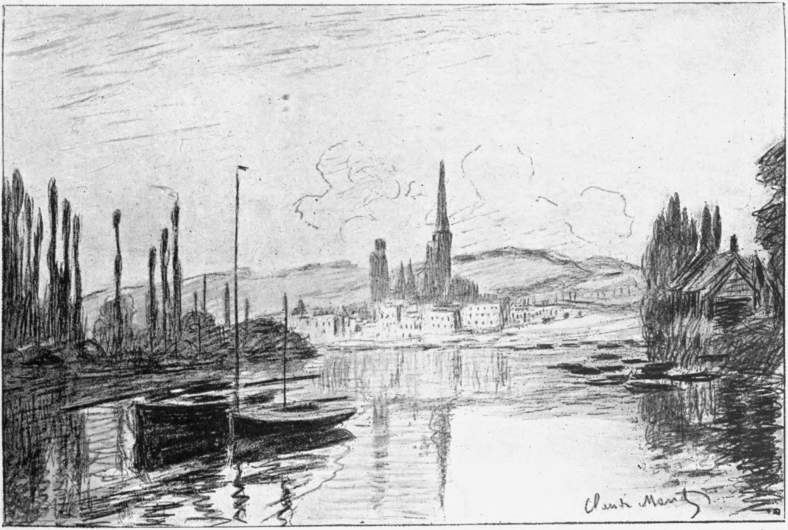 | |
| MONET. | Gaz des Beaux-Arts. A VIEW OF ROUEN. |
| (By permission of the Artist.) | |
And here ends the battle for the liberation of modern art. Libertas artibus restituta. The painters of the nineteenth century are no longer imitators, but have become makers of a new thing, “enlargers of the empire.” The prophetic words written in the beginning of the nineteenth century by the Hamburger, Philipp Otto Runge, “light, colour, and moving life,” were to form the great problem, the great conquest of modern art; they were fulfilled after two generations. Through the Impressionists art was enriched by an opulence of new beauties. A new and independent style had been discovered for the representation of new things, and a new province—a province peculiar to herself—was won for painting.

CHAPTER XXXII
THE NEW IDEALISM IN ENGLAND
The flood of Impressionism was at the same time crossed by another current. Impressionism was a phase of progressive art of world-wide influence. It proclaimed that nature and life were the inexhaustible mine of beauty. Then after Naturalism had taught artists to work upon the impressions of external reality in an independent manner, a transition was made by some who embodied the impressions of their inward spirit in a free creative fashion, unborrowed from the old masters.
We feel the need of living not merely in the world around us, but in an inner world that we build up ourselves, a world far more strange and fair, far more luminous than that in which our feet stumble so helplessly. We must needs mount upon the pinions of fancy into the wide land of vision, build castles in the clouds, watch their rise and their fall, and follow into misty distance the freaks of their changing architecture. The more grey and colourless the present may be, the more alluringly does the fairy splendour of vanished worlds of beauty flit before us. It is the very banality of everyday life that renders us more sensitive to the delicate charm of old myths, and we receive them in a more childlike, impressionable way than any earlier age, for we look upon them with fresh eyes that have been rendered keen by yearning.
From all this it is evident that Impressionism could not remain the mode of expression for the whole world of the present day. The longing for old-world romance would brook no refusal. It was demanded from art not that she should mirror nature, nature could be seen without her aid, but that she should carry us away on dream-wings to a distant world more beautiful than our own; not that she should be merely modern, but that she should afford us even to-day some reflection of that beauty which sheds forth its lustre from the works of the old masters.
This yearning after far-off worlds of beauty was combined with a demand for new delights of colour. The Impressionists had centred every effort in compassing the most difficult elements of the world of phenomena—light, air, and colour—ending in extreme imitation of reality. Then came a desire for colours, more radiant, more vivid than ever was seen on this poor world of ours; and since hardly any of the younger generation fulfilled the desire of the modern longing, the standard of a bygone age was raised 152 aloft, and there set in the anti-naturalistic, anti-modern current that still survived from the age of romance in the work-a-day world of the present.
How was it possible that England should have taken the lead upon this occasion also? Can an Englishman, a matter-of-fact being who finds his happiness in comfort and a practical sphere of action, be at the same time a Romanticist? Is not London the most modern town in Europe? Yet, without a question, this is the very reason why the New Romanticism found its earliest expression there, although it was the place where Naturalism had reigned longest and with the greatest strictness. There was a reaction against the prose of everyday life, just as, in the earlier part of the century, English landscape painting had been a reaction against town life. To escape the whistle of locomotives and the restless bustle of the struggle for existence, men take refuge in a far-off world, a world where everything is fair and graceful, and all emotions tender and noble, a world where no rudeness, no discord, and nothing fierce or brutal disturbs the harmony of ideal perfection. These artists become revellers in a land of fantasy, and flee from reality to an inner life which they have created for themselves, wander from London’s railways and fogs to the sunny Italy of Botticelli, take their rest in the land of poetry, and come back with packing-cases full of lovely pictures and hearts full of happy emotions.
Moreover, they find in the primitive artists that simplicity which is most refreshing of all to overstrained spirits. Having produced Byron, Shelley, and Turner, the English were artistic gourmets, sated with all enjoyments in the realms of the intellect, and they now meditated works through which yet a new thrill of beauty might pass through the imagination. In the primitive masters they discovered all the qualities which had vanished from art since the sixteenth century—inofficious purity, innocent and touching Naturalism, antiquated austerity, and an enchanting depth of feeling. Jaded with other experiences, they admired in those naïve spirits the capacity for ecstatic rapture and vision—in other words, for the highest gratification. If one could but have in this nineteenth century such feelings as were known to Dante, the gloomy Florentine; Botticelli, the great Jeremiah of the Renaissance; or the tender mystic Fra Angelico! Surfeited with modernity, and endowed with nerves of acute refinement, artists went back in their fancy to this luxuriously blissful condition, and finally came to the point at which modernity was transformed once more into childish babble and the unbelieving materialism of the present age into a mystical and romantic union with the old currents of emotion.
Under the influence of Dante Gabriel Rossetti English pre-Raphaelitism now entered upon a new and entirely different phase.
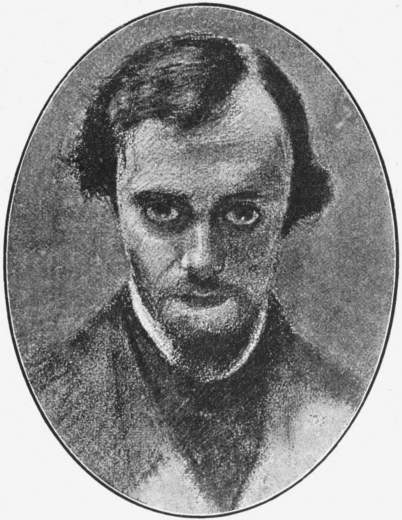 |
 | ||
| Mag. of Art. | ROSSETTI. | Cassell & Co. BEATA BEATRIX. | |
| DANTE GABRIEL ROSSETTI. | (By permission of Mr. F. Hollyer, the owner of the copyright.) | ||
Although Rossetti was the soul of the earlier movement, he was a man whose temperament was even then essentially different from that of his comrades Millais and Hunt, who founded the Brotherhood with him in 1848. Even the two works which he exhibited with them in 1849 and 1850 make 153 one feel the great gulf which lay between him and them. In the former year, when Hunt was represented by his “Rienzi,” and Millais by his “Lorenzo and Isabella,” Rossetti produced his “Girlhood of Mary Virgin.” In the following, when Hunt painted “The Converted British Family sheltering a Christian Missionary” and Millais “The Child Jesus in the Workshop of Joseph the Carpenter,” Rossetti came forward with his “Ecce Ancilla Domini.” “The Girlhood of Mary Virgin” was a little picture of austere simplicity and ascetic character; it was intentionally angular in drawing, and possessed a certain archaic bloom. The Virgin, clad in grey garments, sits at a curiously shaped frame embroidering a lily with gold threads upon a red ground. The flower she is copying stands before her in a vase, and a little angel, with roseate wings, is watering it with an air of abashed reverence. St. Anne is busy by the side of the Virgin—both being, respectively, portraits of the artist’s mother and sister—and in the background St. Joachim is binding a vine to a trellis. And several Latin books are lying upon the floor. The second work, “Ecce Ancilla Domini,” is the familiar picture which is now in the National Gallery—a harmony of white upon white of indescribable graciousness and delicacy. Mary, a bashful, meditative, and childlike maiden, in a white garment, is shown in a half-kneeling attitude upon a white bed. The walls of the chamber are white, and in front of her there stands a frame at which she has been working; and a piece of embroidery, with a lily which she has begun, hangs over it. Before her stands the angel with flame rising from his feet, in solemn, peaceful gravity, as he extends towards her the stalk of the lily which he holds. A dove flies gently in through the window. Now, in spite of their romantic subjects the work of Hunt and Millais is lucid and temperate, while Rossetti is dreamily mystical. The two former were straightforward, true, and natural, whereas the simplicity of the latter was subtilised and consciously affected. It was due to the vibrating delicacy of his distempered, seething imagination that he was able to give himself a deceptive appearance of being a primitive artist. The creative power of the two former is an earnest power of the understanding, whereas in the latter there is a vague dreaminess, a tendency to luxuriate in his own moods, an efflorescence of tones and colours. In the one case there is an 154 angular but single-minded study of nature; in the other there is the demureness and embarrassment of the Quattrocento, a demureness breaking into blossom, and an embarrassment full of charm—a romanticism which cherished the yearning for repose in the childlike and innocent Middle Ages, and clothed it with all the attractions of mysticism. Holman Hunt, Madox Brown, and Millais were realists in their drawing, men who wanted to represent objects with all possible accuracy, to be faithful in rendering the finest fibre of a petal and every thread in a fabric. Rossetti’s picture was a symphonic ode in pigments, and he himself was one of the earliest of the modern lyricists of colour. This distinction became wider and wider with the course of time, and as early as 1858 he found himself deserted by his earlier comrades. Madox Brown, Holman Hunt, and especially Millais, in their further development, tended more and more to become Naturalists, and were finally led to completely realistic subjects from the immediate present by the inviolable fidelity with which they studied nature. On the other hand, Rossetti became the centre of a new circle of artists, who directed the current of what was originally Naturalism more and more into mysticism and refined archaism.
In 1856 The Oxford and Cambridge Magazine was founded as a monthly periodical. There were several contributions by Rossetti, and in this way he became so well known in Oxford that the Union accepted an offer from him to execute a series of wall-paintings. Accordingly he painted several pictures from the Arthurian legends, making the sketches for them himself, and employing for their elaboration a number of young men, some of them amateur artists and students at the University. In this way he came into connection with Arthur Hughes, William Morris, and Edward Burne-Jones. These artists, afterwards joined by Spencer Stanhope and Walter Crane, both of them younger men, became—with George Frederick Watts at their flank—the leading members of the new brotherhood, the representatives of that New pre-Raphaelitism in which interest is still centred in England.
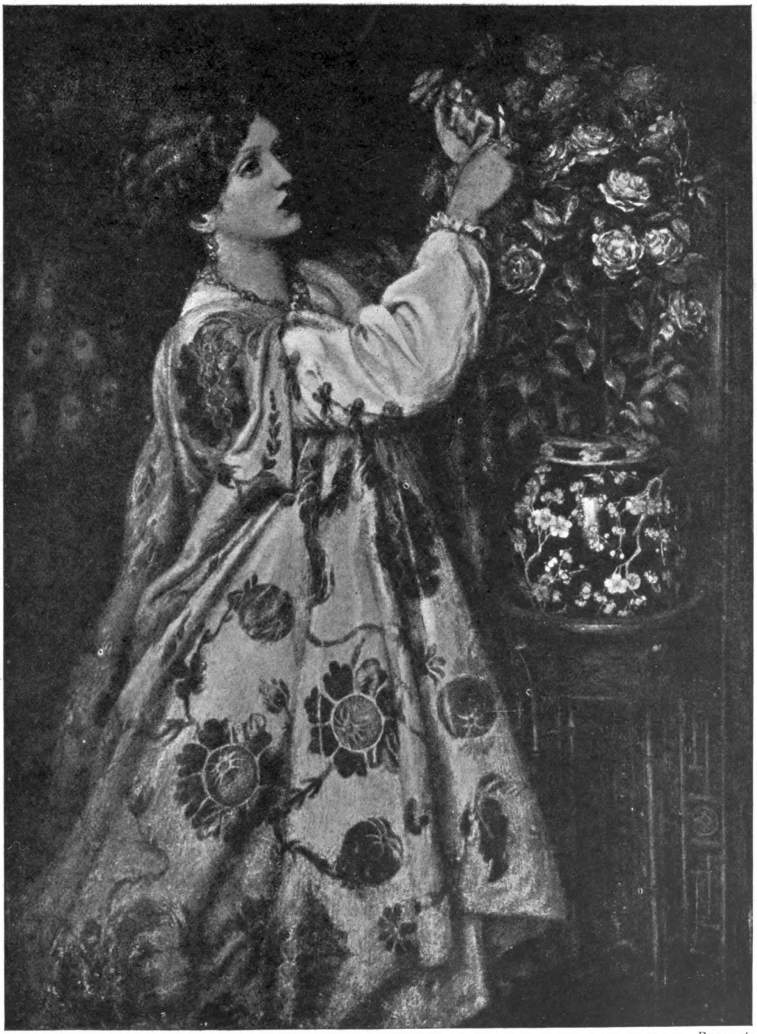 | |
| ROSSETTI. | Pageant. MONNA ROSA. |
| (By permission of Mr. W. M. Rossetti.) | |
Their art is a kind of Italian Renaissance upon English soil. The romantic chord which vibrates in old English poetry is united to the grace and purity of Italian taste, the classical lucidity of the Pagan mythology with Catholic mysticism, and the most modern riot of emotion with the demure vesture of the primitive Florentines. Through this mixture of heterogeneous elements English New Idealism is probably the most remarkable form of art upon which the sun has ever shone: borrowed and yet in the highest degree personal, it is an art combining an almost childlike simplicity of feeling with a morbid hautgoût, the most attentive and intelligent study of the old masters with free, creative, modern imagination, the most graceful sureness of drawing and the most sparkling individuality of colour with a helpless, stammering accent introduced of set purpose. The old Quattrocentisti wander amongst the real Italian flowers; but with the New pre-Raphaelites one enters a hot-house: one is met by a soft damp heat, bright exotic flowers exhale an overpowering fragrance, juicy fruits catch the eye, and slender palms, through the branches of which no rough wind may bluster, gently sway their long, broad fans.
 |
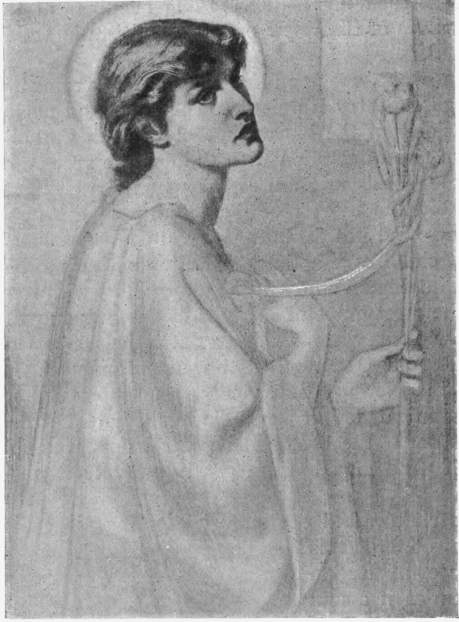 | ||
| ROSSETTI. | Cassell & Co. ECCE ANCILLA DOMINI. |
ROSSETTI. | Portfolio. SANCTA LILIAS. |
| (By permission of Messrs. T. Agnew & Sons, the owners of the copyright.) | |||
Professor Lombroso would certainly find the material for ingenious disquisition in Rossetti, who introduced this Italian phase, and himself came of an Italian stock. And it might almost seem as if a soul from those old times had found its reincarnation in the lonely painter who lived at Chelsea, though it was a soul who no longer bore heaven in his heart like Fra Angelico. In his whole being he seems like a phenomenon of atavism, like a citizen of that long-buried Italy who, after many transmigrations, had strayed into the misty North, to the bank of the Thames, and from thence looked in his home-sickness ever towards the South, enveloped in poetry and glowing in the sun.
Dante Gabriel Rossetti was a Catholic and an Italian. Amid his English surroundings he kept the feelings of one of Latin race. His father, the patriot and commentator upon Dante, had originally lived in Naples, and inflamed the popular party there by his passionate writings. In consequence of the active part which he took in political agitation he lost his post at the Bourbon Museum, escaped 158 from Italy upon a warship, disguised as an English officer, settled in London in 1824, and married Francesca Polidori, the daughter of a secretary of Count Alfieri. Here he became Professor of the Italian language at King’s College, and published several works on Dante, the most important of which, Dante’s Beatrice, written in 1852, once more supported the theory that Beatrice was not a real person. Dante Gabriel, the son of this Dante student Gabriele Rossetti, was born in London on 12th May 1828. The whole family actively contributed to scholarship and poetry. His elder sister, Maria Francesca, was the authoress of A Shadow of Dante, a work which gives a most valuable explanation of the scheme of The Divine Comedy; his younger sister, Christina, was one of the most eminent poetesses of England; and his brother, William Michael Rossetti, is well known as an art-critic and a student of Shelley. Even from early youth Dante Gabriel Rossetti was familiar with the world of Dante, and brought up in the worship of Dante’s wonderful age and an enthusiasm for his mystic and transcendental poetry. He knew Dante by heart, and Guido Cavalcanti. The mystical poet became his guide through life, and led him to Fra Angelico, the mystic of painting. Indeed, the world of Dante and of the painters antecedent to Raphael is his spiritual home.
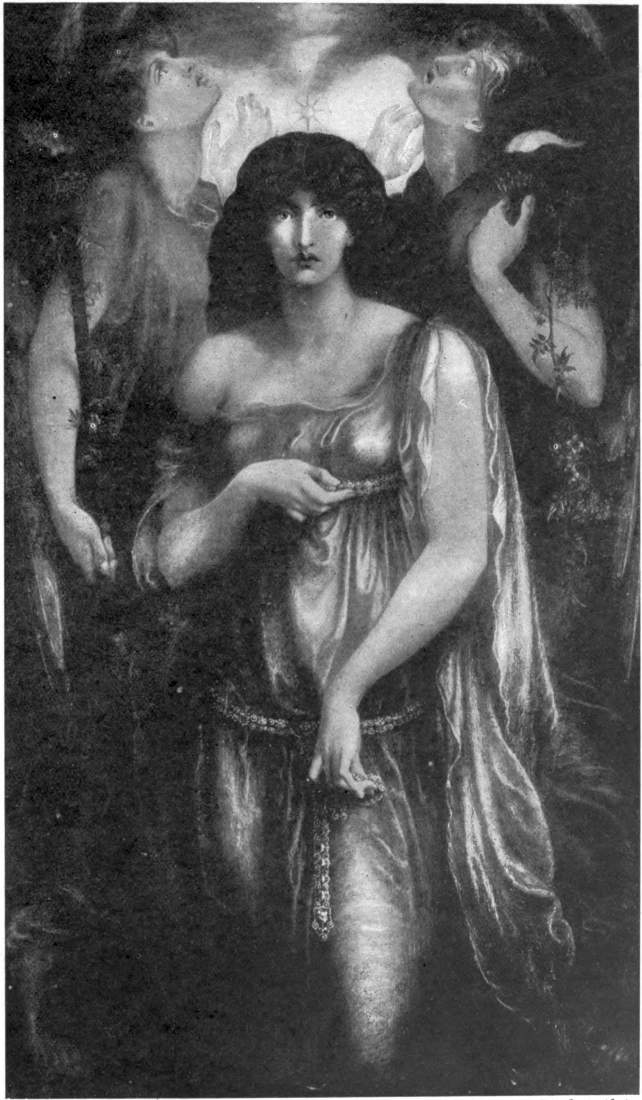 | |
| ROSSETTI. | Brothers, photo. ASTARTE SYRIACA. |
| (By permission of the Corporation of Manchester, the owners of the picture.) | |
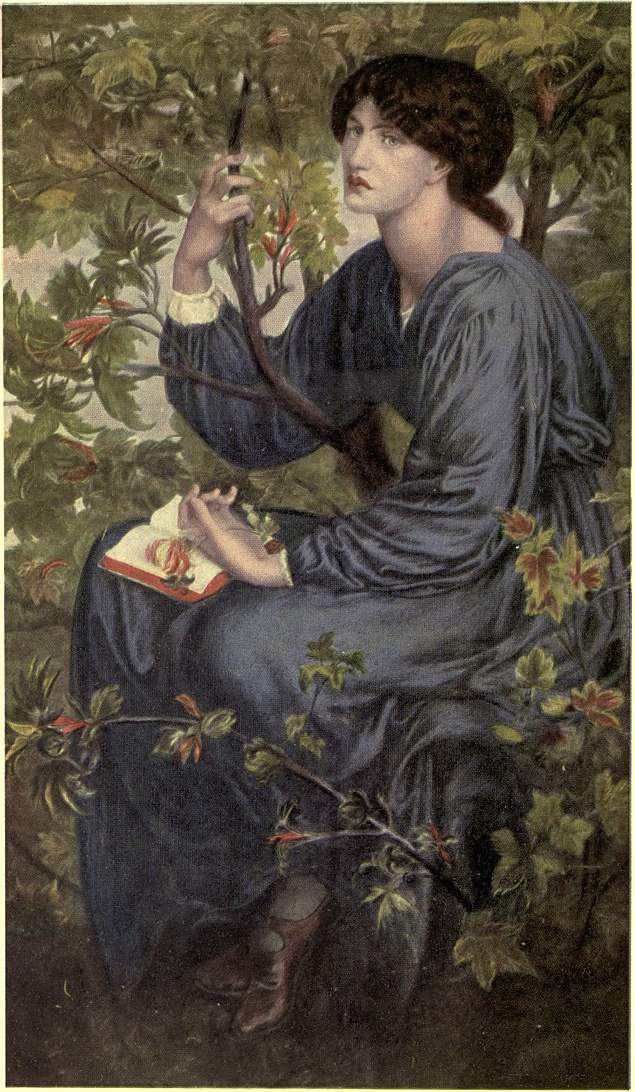 | |
| Mansell & Co. | |
| ROSSETTI. | THE DAY DREAM. |
He was barely eighteen when he became a pupil at the Royal Academy, studying a couple of years later under Madox Brown, who was not many years older than himself. Even then Rossetti had an almost mesmeric influence upon his friends. He was a pale, tall, thin young man, who always walked with a slight stoop; reserved, dry in his manner, and careless in dress, there was nothing captivating about him at a transitory meeting. But his pale face was lit up by his unusually reflective, deeply clouded, contemplative eyes; and about his defiant mouth there played that contempt of the profane crowd which is natural to a superior mind, while the laurel of fame was already twined about his youthful forehead. In 1849, when he was exhibiting his earliest picture, he had published in The Germ, to say nothing of his numerous poems, a mystical, visionary, sketch in prose named Hand and Soul, which was much praised by men of the highest intellect in London. Soon afterwards he published a volume entitled Dante and his Circle, in which he translated a number of old Italian poems, and rendered Dante’s Vita Nuova into strictly archaic English prose. Reserved as he was towards strangers, he was irresistibly attractive to his friends, and his brilliant, genial conversation won him the goodwill of every one. A man of gifted and delicate nature, sensitive to an extreme degree, a sedentary student who had yet an enthusiasm for knightly deeds, a jaded spirit capable of morbidly heightened, exotic sensibility and soft, melting reverie, one whose overstrained nerves only vibrated if he slept in the daytime and worked at night, it seemed as though Rossetti was born to be the father of the décadence, of that state of spirit which every one now perceives to be flooding Europe.
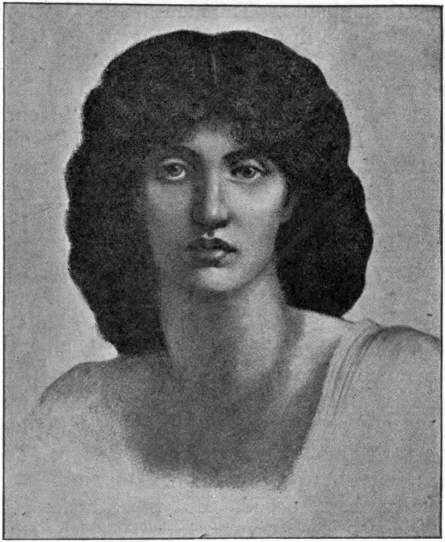 |
| ROSSETTI. STUDY FOR ASTARTE SYRIACA. |
His later career was as quiet as its opening had been brilliant. After that graciously sentimental little picture, “Ecce Ancilla Domini,” Rossetti exhibited in public only once again; this was in 1856. From that date the public saw no more of his painting. He worked only for his friends and the friends of his friends. He was famous only in private, and looked up to like a god within a narrow circle of admirers. One of his acquaintances, the painter Deverell, had introduced him in 1850 to the woman who became for him what Saskia Uylenburgh had been for Rembrandt and Helene Fourment for Rubens—his type of feminine beauty. She was a young dressmaker’s assistant, Miss Eleanor Siddal. Her thick, heavy hair was fair, with that faint reddish tint in it which Titian painted; it grew in two tapering bands deep down into the neck, being there somewhat fairer than it was above, and it curled thickly. Her eyes had something indefinite in their expression; nothing, however, that was dreamy, mobile, and changeable, for they seemed rather to be insuperable, fathomless, and unnaturally vivid. All the play of her countenance lay in the lower part of her face, in the nostrils, 162 mouth, and chin. The mouth, indeed, with its deep corners, sharply chiselled outlines, and lips triumphantly curved, was particularly expressive. And her tall, slender figure had a refined distinction of line. In 1860 they married. Some of his most beautiful works were painted during this epoch—the “Beata Beatrix,” the “Sibylla Palmifera,” “Monna Vanna,” “Venus Verticordia,” “Lady Lilith,” and “The Beloved”—pictures which he painted without a thought of exhibition or success. After a union of barely two years this passionately loved woman died, shortly after the birth of a still-born child. He laid a whole volume of manuscript poems—many of them inspired by her—in the coffin, and they were buried with her. From that time he lived solitary and secluded from the world, surrounded by mediæval antiques, in his old-fashioned house at Chelsea, entirely given up to his dreams, a stranger in a world without light. He suffered much from ill-health, and was sensitive and hypochondriacal, and, indeed, undermined his health by an immoderate use of chloral. His friends entreated him to bring out his poems, and all England was expectant when Rossetti at length yielded to pressure, opened the grave of his wife, and took out the manuscript. The poems appeared in the April of 1870. The first edition was bought up in ten days, and there followed six others. Wherever he appeared he was honoured like a god. But the attacks directed against the first pictures of the pre-Raphaelites were repeated, although now transferred to another region. A pseudonymous article by Robert Buchanan in the Contemporary Review, and published afterwards as a pamphlet, entitled The Fleshly School of Poetry, accused Rossetti of immorality and imitation of Baudelaire and the Marquis de Sade. Rossetti stepped once more into the arena, and replied by a letter in the Athenæum headed The Stealthy School of Criticism. From that time he shut himself up completely, never went out, and led “the hole-and-cornerest existence.”
In 1881 he published a second volume of poems, chiefly composed of ballads and sonnets. A year afterwards, on 10th April 1882, he died, honoured, even in the academical circles in which he never mingled, as one of the greatest men in England. The exhibition of his works which was opened a couple of months after his death created an immense sensation. Those of his pictures which had not been already sold straight from the easel were paid for with their weight in gold, and are now scattered in great English country mansions and certain private galleries in Florence. The only very rich collection in London is that of an intimate friend of the artist, the late Mr. Leyland, who had gathered together, in his splendid house in the West End, probably the most beautiful work of which the East can boast in carpets and vases, or the early Renaissance in intaglios, small bronzes, and ornaments. Here, surrounded by the quaint and delicate pictures of Carlo Crivelli and Botticelli, Rossetti was in the society of his contemporaries.
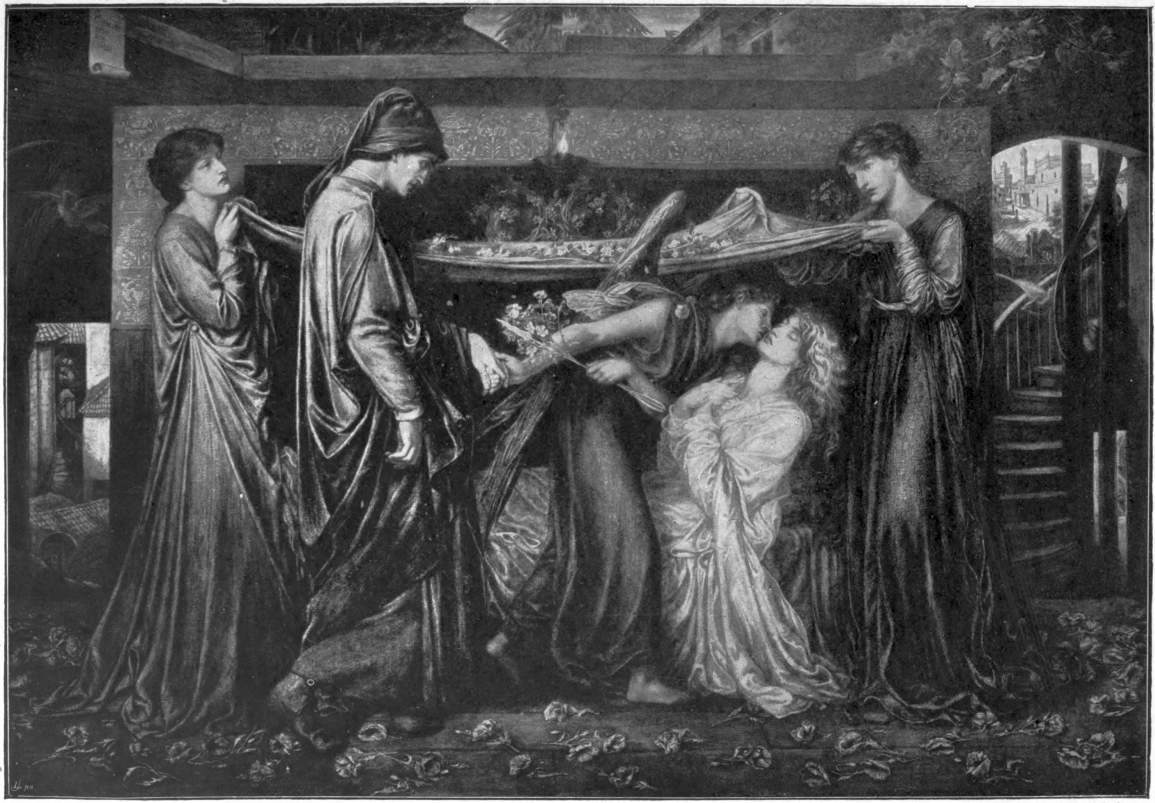 | |
| ROSSETTI. | Seemann, Leipzig. DANTE’S DREAM. |
| (By permission of the Corporation of Liverpool, the owners of the picture.) | |
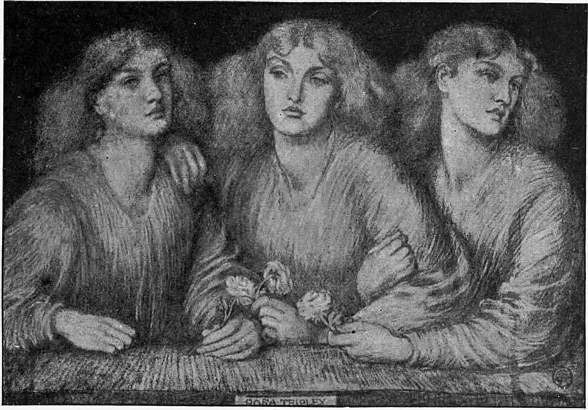 | |
| ROSSETTI. | Cassell & Co. ROSA TRIPLEX. |
| (By permission of Mr. F. Hollyer, the owner of the copyright.) | |
His range of subject was not wide. In his earliest period he had a fancy for painting small biblical pictures, of which “Ecce Ancilla Domini” is the best known, and the delightfully archaic “Girlhood of Mary Virgin” one of the most beautiful. But this austerely biblical tendency was not of long continuance. It soon gave way to a brilliant, imaginative Romanticism, to which he was prompted by Dante. “Giotto painting the Portrait of Dante,” “The Salutation of Beatrice on Earth and in Eden” (from the Vita Nuova), “La Pia” (from the Purgatorio), the “Beata Beatrix,” and “Dante’s Dream,” in the Walker Art Gallery in Liverpool, are the leading works which arose under the influence of the great Italian. The head of his wife, with her heavily veiled eyes, and Giotto’s well-known picture of Dante, sufficed him for the creation of the most tender, mystical poems, which, at the same time, show him in all the splendour of his wealth of colour. He revels in the most brilliant hues; his pictures have the appearance of being bathed in a glow; and there is something deeply sensuous in his vivid and lustrous green, red, and violet tones. In the picture “Dante on the Anniversary of Beatrice’s Death” the poet kneels at the open window which looks out upon Florence; he has been drawing, and a tablet is in his hand. The room is quite simple, a frieze with angels’ heads being its only ornament. Visitors of rank have come to see him—an elderly magnate and his daughter—and have stood long behind him without his noticing their presence; for he has been thinking of Beatrice, and it is only when his attention is attracted to them by a friend that he turns round at last. The “Beata Beatrix,” in the National Gallery in London—a picture begun in 1863 and ended in the August of 1866—treats of the death of Beatrice “under the semblance of a trance, in which Beatrice, seated in a balcony overlooking the city, is suddenly rapt from earth to heaven.” In accordance with the description in the Vita 166 Nuova, Beatrice sits in the balcony of her father’s palace in strange ecstasy. Across the parapet of the balcony there is a view of the Arno and of that other palace where Dante passed his youth close to his adored mistress, until the unforgotten 9th of June 1290, when death robbed him of her. A peaceful evening light is shed upon the bank of the Arno, and plays upon the parapet with warm silvery beams. Beatrice is dressed in a garment belonging to no definite epoch, of green and rosy red, the colours of Love and Hope. Her head rises against a little patch of yellow sky between the two palaces, and seems to be surrounded by it as by a halo. She is in a trance, has the foreknowledge of her approaching death, and already lives through the spirit in another world, whilst her body is still upon the earth. Her hands are touched by a heavenly light. A dove of deep rose-coloured plumage alights upon her knees, bringing her a white poppy; whilst opposite, before the palace of Dante, the figure of Love stands, holding a flaming heart, and announcing to the poet that Beatrice has passed to a life beyond the earth.
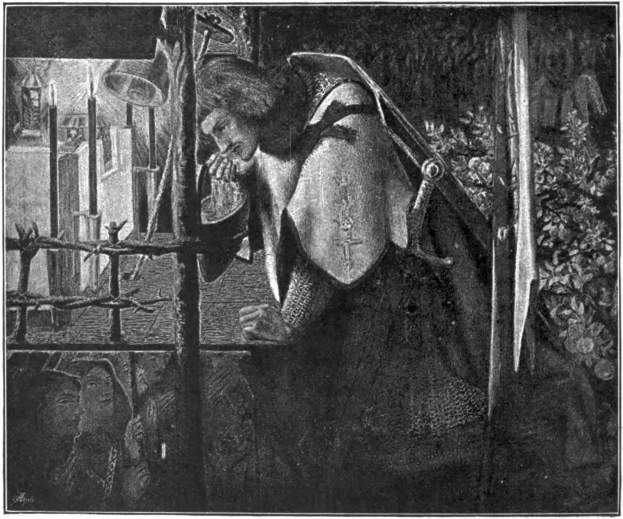 | |
| Cassell & Co. | |
| ROSSETTI. | SIR GALAHAD. |
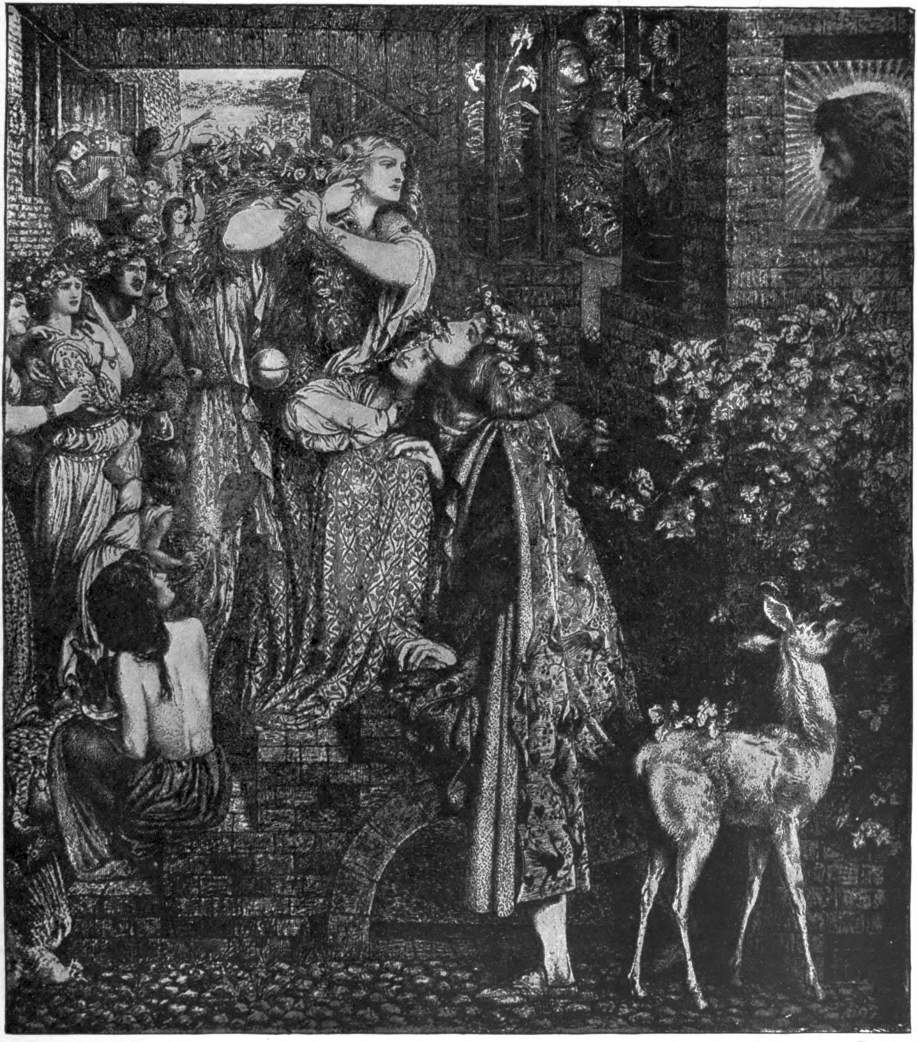 | |
| ROSSETTI. | Pageant. MARY MAGDALENE AT THE HOUSE OF SIMON THE PHARISEE. |
| (By permission of Mr. W. M. Rossetti.) | |
“La Donna Finestra,” painted in 1879, and to be counted amongst his ripest creations, has connection with that passage in the Vita Nuova where Dante sinks to the ground overcome with sorrow for Beatrice’s death, and is regarded with sympathy by a lady looking down from a window, the Lady of Pity, the human embodiment of compassion. “Dante’s Dream” is probably the work which shows the painter at his zenith. The expression of the heads is profound and lofty, the composition severely mediæval and admirably complete; and although the painting is laboured, the total impression is nevertheless so cogent that it is impossible to forget it. “The scene,” in Rossetti’s own description, “is a chamber of dreams, strewn with poppies, where Beatrice is seen lying on a couch, as if just fallen back in death; the winged figure of Love carries his arrow pointed at the dreamer’s heart, and with it a branch of apple-blossom; as he reaches the bier, Love bends for a moment over Beatrice with the kiss which her lover has never given her; while the two green-clad dream-ladies hold the pall full of May-blossom suspended for an instant before it covers her face for ever.” The expression of ecstasy in Dante’s face, and the still, angelical sweetness of Beatrice, are rendered with astonishing intensity. She lies upon the bier, pale as a flower, wrapped in a white shroud, with her lips parted as though she were gently breathing, and seems not dead but fallen asleep. Her fair hair floats round her in golden waves. In its vague folds the covering of the couch displays the marble outlines of the body: and a look of bliss rests upon the pure and clear-cut features of her lovely face.
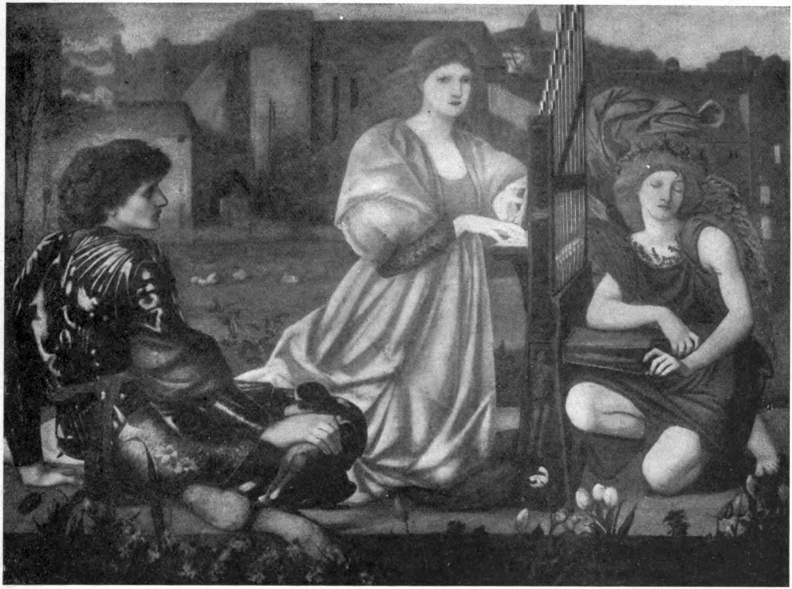 | |
| BURNE-JONES. | CHANT D’AMOUR. |
| (By permission of Mr. F. Hollyer, the owner of the copyright.) | |
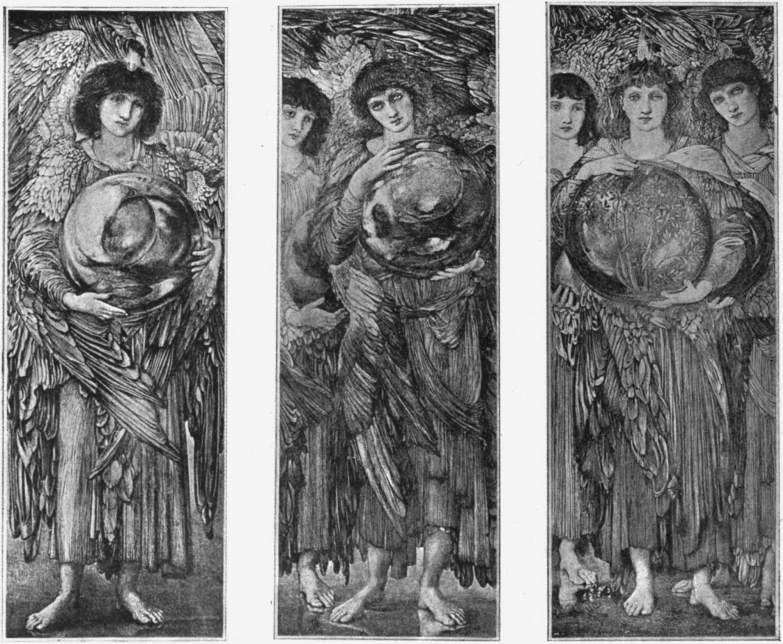 | |
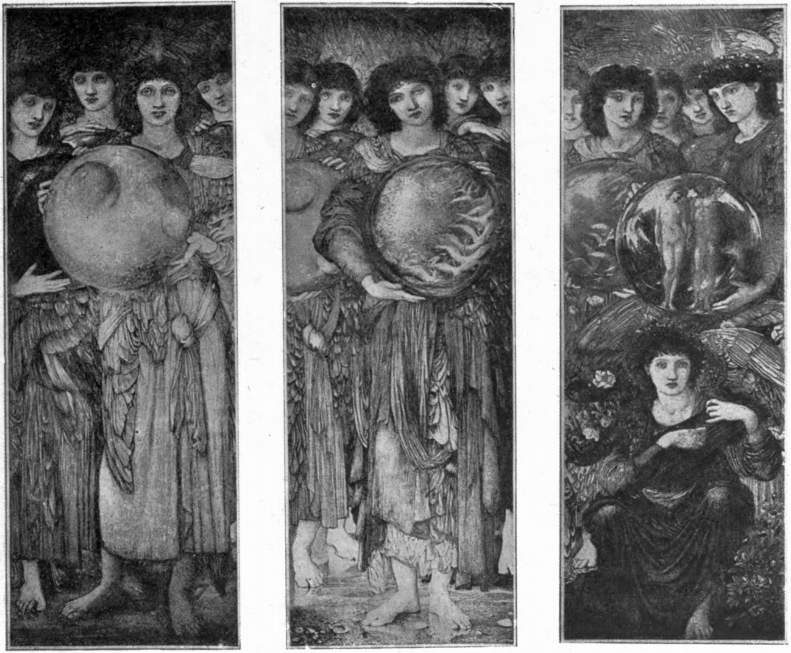 | |
| BURNE-JONES. | THE DAYS OF CREATION. |
| (By permission of Mr. F. Hollyer, the owner of the copyright.) | |
This “painting of the soul” occupied Rossetti almost exclusively in the third and most fruitful period of his life, when he painted hardly any pictures upon the larger scale, but separate feminine figures furnished with various poetic attributes, the deeper meaning of which is interpreted in his poems. “The Sphinx,” in which he busied himself with the great riddle of life, is the only one containing several figures. Three persons—a youth, a man of ripe years, and a grey-beard—visit the secret dwelling of the Sphinx to inquire their destiny of this omniscient being. It is only the man who really puts the question; the grey-beard stumbles painfully towards her cavern, while the young man, wearied with his journey, falls dying to the earth before the very object of his quest. The Sphinx remains in impenetrable silence, with her green, inscrutable, mysterious eyes coldly and pitilessly fixed upon infinity. “The Blessed Damozel,” “Proserpina,” “Fiammetta,” “The Daydream,” “La Bella Mano,” “La Ghirlandata,” “Veronica Veronese,” “Dis Manibus,” “Astarte Syriaca” are all separate figures dedicated to the memory of his wife. As Dante immortalised his Beatrice, Rossetti honoured his wife, who died so early, in his poems and his pictures. He painted her as “The Blessed Damozel,” with her gentle, saint-like face, her quiet mouth, her flowing golden hair and peaceful lids. He represents her as 171 an angel of God standing at the gate of Heaven, looking down upon the earth. She is thinking of her lover, and of the time when she will see him again in heaven, and of the sacred songs that will be sung to him. Lilies rest upon her arm, and lovers once more united hover around.
There is no action or rhetoric of gesture in Rossetti. His tall Gothic figures are motionless and silent, having almost the floating appearance of visionary figures which stand long before the gaze of the dreamer without taking bodily form. They glide along like phantoms and shadows, like the undulations of a blossom-laden tree or a field of corn waving in the wind. They neither talk nor weep nor laugh, and are only eloquent through their quiet hands, the most sensuous and the most spiritual hands ever painted, or with their eyes, the most dreamy and fascinating eyes which have been rendered in art since Leonardo da Vinci. In the pictures which Rossetti devoted to her, Eleanor Siddal is a marvellously lofty woman, glorified in the mysticism of a rare beauty. Rossetti drapes his idol in Venetian fashion, with rich garments which recall Giorgione in the character of their colour, and, like Botticelli, he strews flowers of deep fragrance around her, especially 172 roses, which he painted with wonderful perfection and hyacinths, for which he had a great love, and the intoxicating perfume of which affected him greatly.
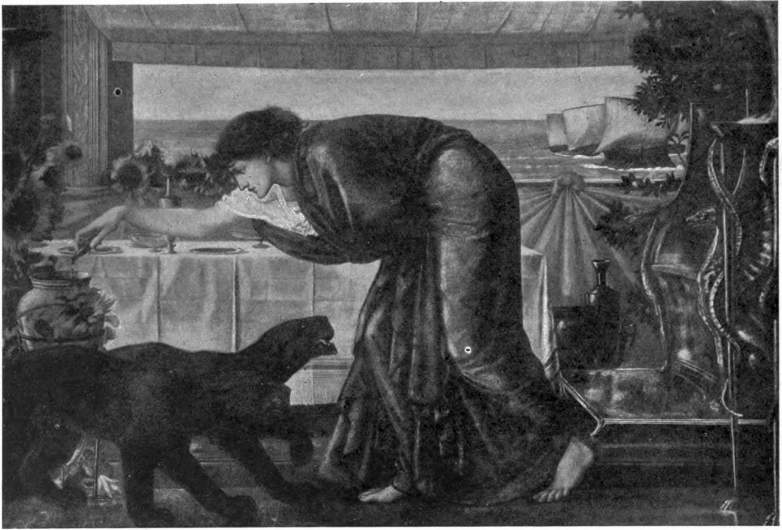 | |
| BURNE-JONES. | CIRCE. |
| (By permission of Mr. F. Hollyer, the owner of the copyright.) | |
This taste for beautiful and deeply lustrous colours and rich accessories is, indeed, the one purely pictorial quality which this painter-poet has, if one understands by pictorial qualities the capacity for intoxicating one’s self with the beauty of the visible world. His drawing is often faulty; and his bodies, enveloped in rich and heavy garments, are, perhaps, not invariably in accordance with anatomy. What explains Rossetti’s fabulous success is purely the condition of spirit which went to the making of his works—that nervous vibration, that ecstasy of opium, that combination of suffering and sensuousness, and that romanticism drunk with beauty, which pervade his paintings. When they appeared they seemed like a revelation of a beautiful land, only one could not say where it existed—a revelation, indeed, for it revealed for the first time a world of story which was in no sense fabulous: there came a romanticism which was something real; a style arose which seemed as though it were woven of tones and colours, a style rioting in an everlasting exhilaration of spirit, breaking out sometimes in a glow of flame and sometimes in delicate, tremulous longing. Even where he paints a Madonna she is merely a woman in his eyes, and he endows her with the glowing fire of passionate fervour, with a trace of the joy of the earth, which no painter has ever given her before; and through this union of refined modern sensuousness and Catholic mysticism he has created a new thrill of beauty. His painting was a drop of a most precious essence, in its hues enchanting and intoxicating, the strongest spiritual potion ever brewed in English art. The intensity of his overstrained sensibility, and the wonderful Southern mosaic of form into which he poured this sensibility with elaborate refinement, make him seem own brother to Baudelaire.
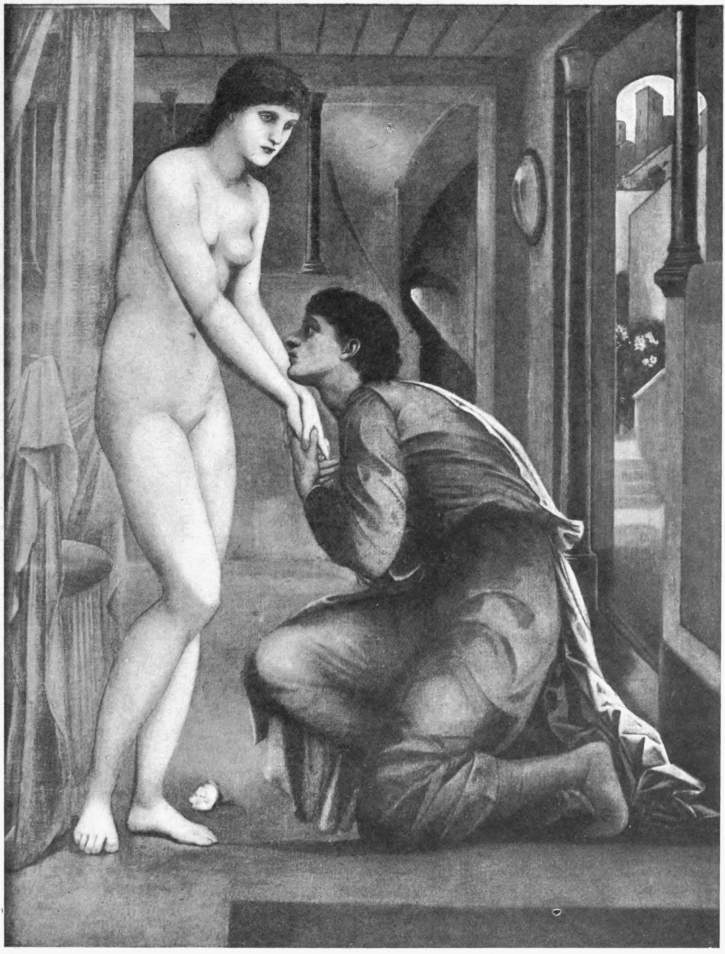 | |
| BURNE-JONES. | PYGMALION (THE SOUL ATTAINS). |
| (By permission of Mr. F. Hollyer, the owner of the copyright.) | |
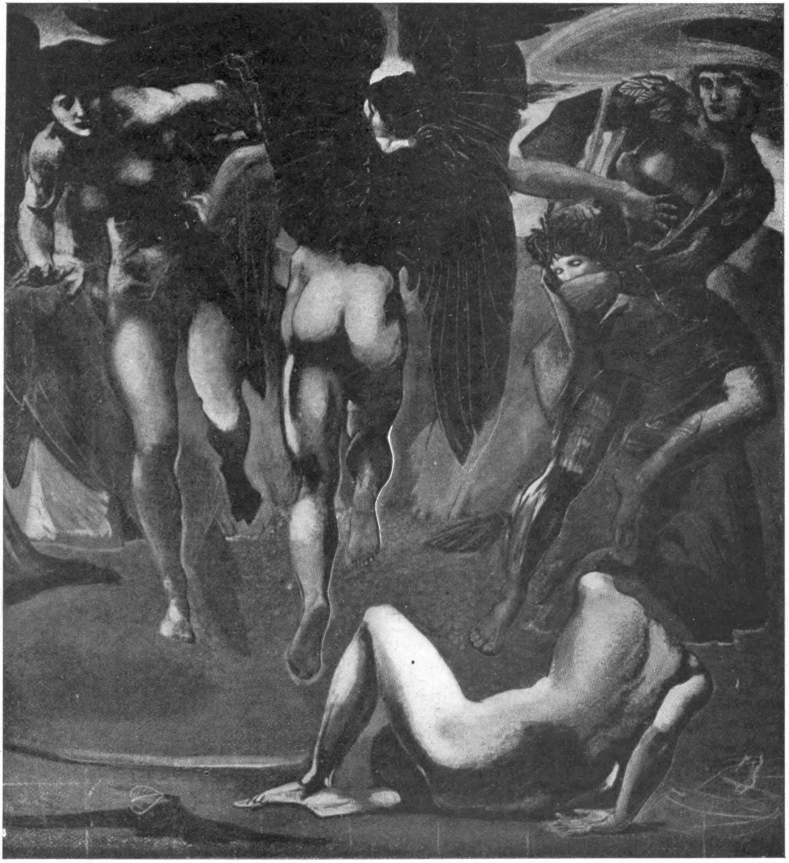 | |
| Pageant. | |
| BURNE-JONES. | PERSEUS AND ANDROMEDA. |
 |
| BURNE-JONES. THE ANNUNCIATION. |
| (By permission of Mr. F. Hollyer, the owner of the copyright.) |
This tendency of spirit was so novel, this plunge in the tide of mysticism so enchanting, this delicate, archaic fragrance so overwhelming, that a new stage in the culture of modern England dates from the appearance of Rossetti. 176 He borrowed nothing from his contemporaries, and all borrowed from him. There came a time when budding girls in London attired themselves like early Italians from Dante’s Inferno, when Jellaby Postlethwaite, in Du Maurier’s mocking skit, entered a restaurant at luncheon-time, and ordered a glass of water and placed in it a lily which he had brought with him. “What else can I bring?” asked the waiter. “Nothing,” he sighed; “that is all I need.” There began that æstheticism, that yearning for the lily and that cult of the sunflower, which Gilbert and Sullivan parodied in Patience. Swinburne, who has tasted of emotions of the most various realms of spirit, and in his poems set them before the world as though in marvellously chiselled goblets, represents this æsthetic phase of English art in literature. As a painter, Edward Burne-Jones—the greatest of that Oxford circle which gathered round Rossetti in 1856—began to work at the point where Rossetti left off.
Sir Edward Burne-Jones, who must now be spoken of, was born in Birmingham in August 1833, and was reading theology in Oxford when Rossetti was there painting the mural pictures for the Union. Rossetti attracted him as a flame attracts the moth. As yet he had not had any artistic training, but some of his drawings which were shown to Rossetti by a mutual friend revealed so much poetic force, in spite of their embarrassed method of expression, that the painter-poet entered into communication with him, and allowed him to paint in the Debating Room of the Union a subject from the Arthurian legends, “The Death of Merlin.” The picture met with approval, and Burne-Jones abandoned theology, became an intimate friend of Rossetti and the companion of his studies, and went with him to London. There he designed a number of church windows for Christ Church Cathedral, Oxford, and in 1864 exhibited his first picture, “The Merciful Knight.” Later there followed the triptych “Pyramus and Thisbe” and a picture called “The Evening Star,” a glimmering landscape through which a gentle spirit in a bronze-green garment is seen to 177 float. But none of these works excited much attention. The small picture exhibited in 1870, “Phyllis and Demophoön,” was even thought offensive on account of the “sensuous expression” of the nymph. So Burne-Jones withdrew it, and for many years from that time held aloof from all the exhibitions of the Royal Academy. For seven years his name was never seen in a catalogue. It was only on 1st May 1877, at the opening of the Grosvenor Gallery—founded by Sir Coutts Lindsay, likewise a painter, to afford himself and his comrades a place of exhibition independent of the Academy—that Burne-Jones once more made his appearance before the eyes of the world. But his pictures, like those of Rossetti, had found their way in secrecy and by their own merit, and of a sudden he saw himself regarded as one of the most eminent painters in the country.
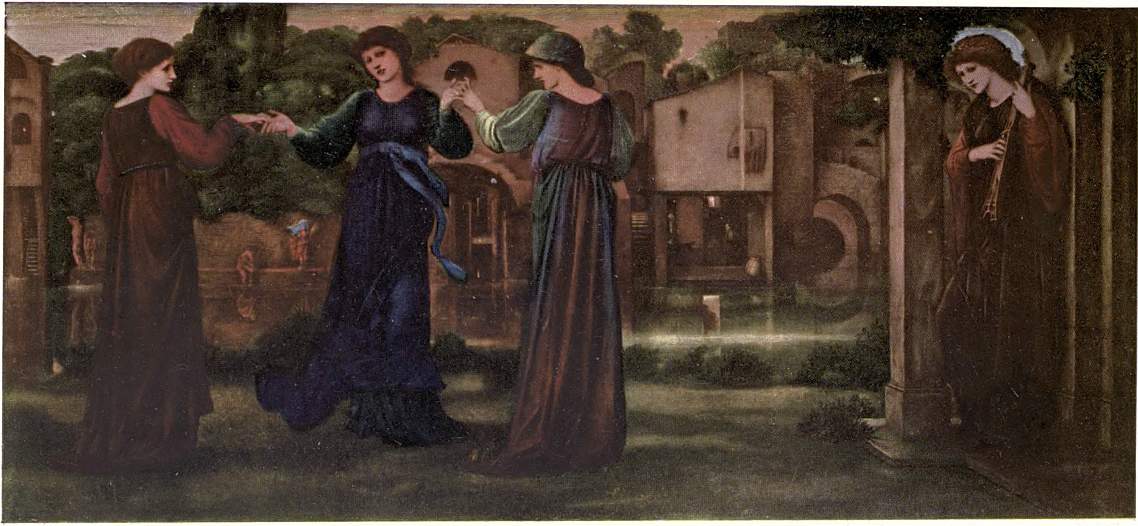 | |
| Mansell Photo. | |
| BURNE-JONES. | THE MILL. |
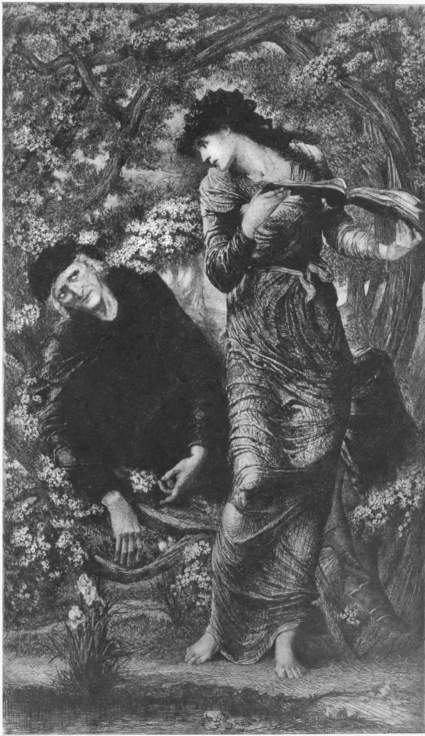 |
 | ||
| BURNE-JONES. | L’Art. THE ENCHANTMENT OF MERLIN. |
BURNE-JONES. | Pageant. THE SEA NYMPH. |
| (By permission of Mr. F. Hollyer, the owner of the copyright.) | (By permission of Mr. F. Hollyer, the owner of the copyright.) | ||
His art is the flower of most potent fragrance in English æstheticism, and the admiration accorded to him in England is almost greater than that which had been previously paid to Rossetti. The Grosvenor Gallery, where he exhibited his pictures at this period, was for a long time a kind of temple for the æsthetes. On the opening day men and women of the greatest refinement crowded before his works. There was a cult of Burne-Jones at the Grosvenor Gallery, as there is a cult of Wagner at Bayreuth. One had to work one’s way very gradually through the crowd to see his pictures, which always occupied the place of honour in the principal room of the gallery, and I remember how helplessly I stood in 1884 before the first of his pictures which I saw there.
In a kind of vestibule of early Gothic architecture there was seated in the foreground an armed man, who, in his dark, gleaming harness and his hard and bold profile, was like a Lombard warrior, say Mantegna’s Duke of Mantua, and as he mused he held in his hand an 178 iron crown studded with jewels; farther in the background, upon a high marble throne, a maiden was seated, a young girl with reddish hair and a pale worn face, looking with steadfast eyes far out into another world, as though in a hypnotic trance. Two youths, apparently pages, sang, leaning upon a balustrade; while all manner of costly accessories, brilliant stuffs, lustrous marble, grey granite, and mosaic pavement, shining in green and red tones, lent the whole picture an air of exquisite richness. The title in the catalogue was “King Cophetua and the Beggar-Maid,” and any one acquainted with Provençal poetry knew that King Cophetua, the hero of an old ballad, fell in love with a beggar-girl, offered her his crown, and married her. But this was not to be gathered from the picture itself, where all palpable illustration of the story was avoided. Nevertheless a vague sense of emotional disquietude was revealed in it. The two leading persons of the strange idyll, the earnest knight and the pallid maiden, are not yet able themselves to understand how all has come to pass—how she, the beggar-maid, should be upon the marble throne, and he, the king, kneeling on the steps before her whom he has exalted to be a queen. They remain motionless and profoundly silent, but their hearts are alive and throbbing. They have feeling which they cannot comprehend themselves, and the past and present surge through one another: life is a dream, and the dream is life.
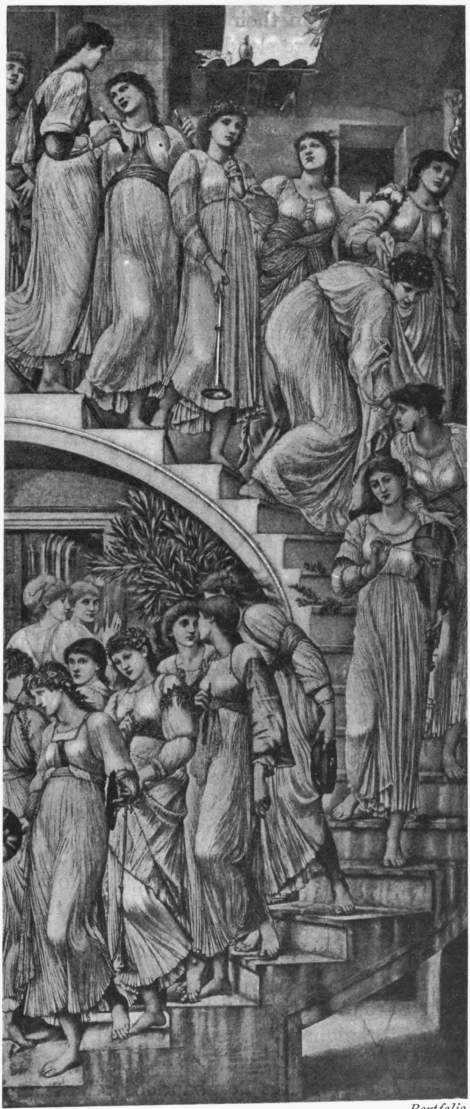 |
| Portfolio. |
| BURNE-JONES. THE GOLDEN STAIRS. |
| (By permission of Mr. F. Hollyer, owner of the copyright.) |
Everything that Burne-Jones has created is at once fragrant, mystical, and austere, like this picture. His range of subject is most extensive. In his Princess Alfred Tennyson had quickened into new life the legends of chivalry, and in his Idylls of the King the tales of the Knights of the Holy Grail. Swinburne published his Atalanta in Calydon, in which he exercised once more the mysterious spell of the ancient drama, while he created in Chastelard, Bothwell, and Mary Stuart a trilogy of the finest historical tragedies ever written, and showed in Tristram of Lyonesse that even Tennyson had not exhausted all the beauty in old legends of the time of King Arthur; while, as early as 1866, he had given to the world his Poems and Ballads, dedicated to Burne-Jones. In 179 these works lie the ideas to which the painter has given form and colour.
He paints Circe in a saffron robe, preparing the potion to enchant the companions of Ulysses, with a strange light in her orbs, while two panthers fawn at her feet. He represents the goddess of Discord at the marriage-feast of Thetis, a ghastly, pallid figure, entering amongst the gods who are celebrating the occasion, and holding the fateful apple in her hand. He depicts Pygmalion, the artist King of Cyprus, supplicating Aphrodite to breathe life into the sculptured image of a maiden, the work of his own hands.
Apart from classical antiquity, he owes some of his inspiration to the Bible and Christian legends, the sublimity of their grave tragedies, and the troubled sadness of their yearning and exaltation. One of his leading works devotes six pictures to the days of creation. An angel—accompanied in every case by the angels of the previous days—carries a sphere, in which may be seen the stars, the waters, the trees, the animals, and the first man and woman, in their proper sequence. The scene of the “Adoration of the Kings” is a landscape where fragrant roses bloom in the shadow of the slender stems of trees, which rise straight as a bolt. 180 The Virgin sits in their midst calm and unapproachable, and in her lap the Child, who is more slender than in the pictures of Cimabue. The three Wise Men—tall, gigantic figures, clad in rich mediæval garments—approach softly, whilst an angel floats perpendicularly in the air as a silent witness.
In his picture “The Annunciation” Mary is standing motionless beside the great basin of a well-spring, at the portico of her house. To the left the messenger of God appears in the air. He has floated solemnly down, and it seems as if the folds of his robes, which fall straight from the body, had hardly been ruffled in his flight, as if his wings had scarcely moved; with the extremities of his feet he touches the branches of a laurel. Mary does not shrink, and makes no gesture. There they stand, gravely, and as still as statues. The robe of the angel is white, and white that of the Virgin, and white the marble floor and the wainscoting of the house; and it is only the pinions of the heavenly messenger that gleam in a golden brightness. A picture called “Sponsa die Libano” bore as a motto the words from The Song of Solomon: “Awake, O north wind; and come, thou south; blow upon my garden, that the spices thereof may flow out.” The bride, in an ample blue robe, walks musing beside a stream, upon the bank of which white lilies grow, whilst the vehement figures of the North and South Winds rush through the air in grey, fluttering garments.
In addition to his love for Homer and the Bible, Burne-Jones has a passion for the old Trouvères of the Chansons de Geste, the great and fanciful adventures of vanished chivalry, Provençal courts of love, and the legends of Arthur, Merlin, and the Knights of the Round Table. His “Chant d’Amour” is like a page torn out of an old English or Provençal tale. On the meadow before a mediæval town a lady is kneeling, a sort of St. Cecilia, in a white upper-garment and a gleaming skirt, playing upon an organ, the full chords of which echo softly through the evening landscape. To the left a young knight is sitting upon the ground, and silently listens, lost in the music, while a strange figure, clad in red, is pressing upon the bellows of the instrument. “The Enchantment of Merlin,” with which he made his first appearance in 1877, illustrated the passage in the old legend of Merlin and Vivien, relating how it came to pass one day that she and Merlin entered a forest, which was called the forest of Broceliande, and found a glorious wood of whitethorn, very high and all in blossom, and seated themselves in the shadow: and Merlin fell asleep, and when she saw that he slept she raised herself softly, and began the spell, exactly according to the teaching of Merlin, drawing the magic circle nine times and uttering the spell nine times. And Merlin looked around him, and it seemed to him as though he were imprisoned in a tower, the highest in the world, and he felt his strength leave him as if the blood were streaming from his veins.
In other pictures he abandons all attempt to introduce ideas, confining himself to the simple grouping of tender girlish figures, by means of which he makes a beautiful composition of the most subtle lines, forms, colours, and 181 gestures. The “Golden Stairs” of 1878 was a picture of this description: a train of girls, beautiful as angels, descended the steps without aim or object, most of them with musical instruments, and all with the same delicate feet and the same robes falling in beautiful folds. In this year he also produced “Venus’ Looking-glass”: a number of nymphs assembled by the side of a clear pool at sunset, in the midst of a sad and solemn landscape, are kneeling by the water’s edge together, reflected in its surface.
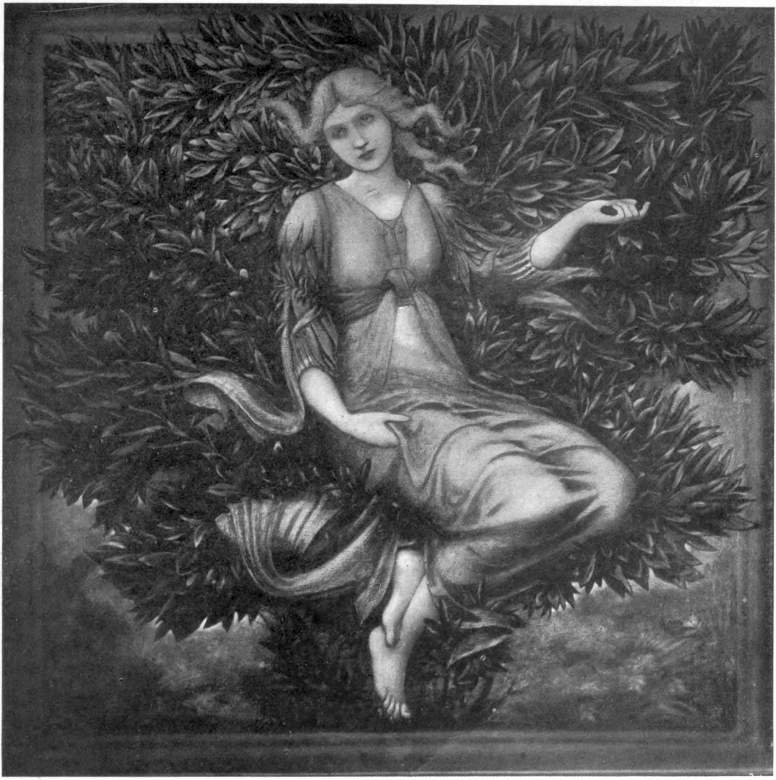 | |
| BURNE-JONES. | THE WOOD NYMPH. |
| (By permission of Mr. F. Hollyer, the owner of the copyright.) | |
Besides these numerous canvases, mention must be made of the decorative works of the master. For the English church in Rome, Burne-Jones has designed decorations in a rich and grave Byzantine style, and in England, where mural decoration has little space accorded to it in churches, there is all the more comprehensive scope for painting upon glass. Until the sixties 182 church windows of this kind were almost exclusively ordered from Germany. The court depôt of glass-painting in Munich provided for the adornment of Glasgow Cathedral from drawings by Schwind, Heinrich Hess, and Schraudolph, and for the windows of St. Paul’s from designs by Schnorr, while Kaulbach was employed for a public building in Edinburgh. In these days Burne-Jones reigns over this whole province. Where the German masters handled glass-painting by modernising it like a Nazarene fresco, Burne-Jones, who has penetrated deeply into the mediæval treatment of form, created a new style in glass-painting, and one exquisitely in keeping with the Neo-Gothic architecture of England. His most important works of this description are probably the glass windows which he designed for St. Martin’s Church and St. Philip’s Church in Birmingham, his native town. These labours of his in the province of Gothic window-painting explain how he came to his style of painting at the easel: he habituated himself to compose his pictures with the architectonical sentiment of a Gothic artist. Forced to satisfy the requisitions of the slender, soaring Gothic style, he came to paint his tall, straight-lined figures, the composition of which is not triangular in the old fashion, but formed in long lines as in vertical church windows.
It is not difficult to find prototypes for every one of these works of his. His sibyls recall Pompeii. His church decoration would never have arisen but for the mosaics of Ravenna. And those angels in golden drapery with grave, hieratical gestures in the pictures of the Trecentisti influenced him in his “Days of Creation.” Other works of his suggest the Etruscan vases or the suavity of Duccio. “Laus Veneris” has the severe classicality of Mantegna saturated with Bellini’s warmth of hue. The “Chant d’Amour,” in its deep splendour of colour, is like an idyll by Giorgione. And often he heaps together costly work in gold and ivory like the Florentine goldsmith painters Pollajuolo and Verrochio. Many of his young girls are of lineal descent from those slender, flexible, feminine saints of Perugino, painted in sweeping lines and planted upon small flat feet. Often, too, when he exaggerates his Gothic principles and gives them eight-and-a-half or nine times the proportion of their heads, they seem, with their lengthy necks and slim hands fit for princesses, like younger sisters of Parmigianino’s lithe-limbed women; while sometimes their movements have a more ample grace, a more majestic nobility, and their lips are moved by the mystical inward smile of Luini, so unfathomably subtle in its silent reserve. But it is Botticelli who is most often brought to mind. Burne-Jones has borrowed from him the fine transparent gauze draperies, clinging to the limbs and betraying clearly the girlish forms in his pictures; the splendid mantles, flowered and adorned with dainty patterns of gold; the taste for Southern vegetation, for flowers and fruits, and artificial bowers of thick palm leaves or delicate boughs of cypress, which he delights in using as a refined and significant embellishment; from Botticelli he has borrowed all the attributes with which he has endowed his angels—rose-garlands and vases, tapers and tall lilies; even his type of womanhood has an outward resemblance to that of the Florentine, with its long, delicate, oval face framed in wavy hair, its dreamy eyes and finely arched brows, its dainty and rather tip-tilted nose, and its ripe, delicately curving mouth slightly opened. Indeed, Burne-Jones’s painting is like one of those gilded flower-tables where plants of all latitudes mingle their tendrils and their foliage, their bells and their clusters, their perfume and their marvellous glory of colour, in a harmony artificially arranged. In its strained archaism his art is an affected, artificial art, and would perish as swiftly as a luxuriant exotic plant, had not this pupil of the Italians been born a thoroughbred Englishman, and this Botticelli risen from the grave become a true Briton on the banks of the Thames.
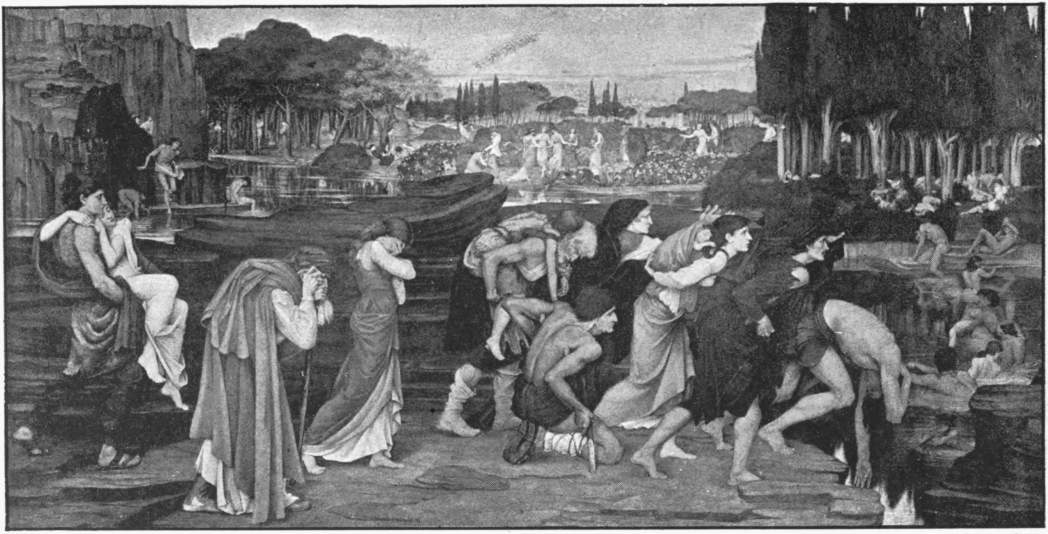 | |
| STANHOPE. | Brothers, photo. THE WATERS OF LETHE. |
| (By permission of the Corporation of Manchester, the owners of the picture.) | |
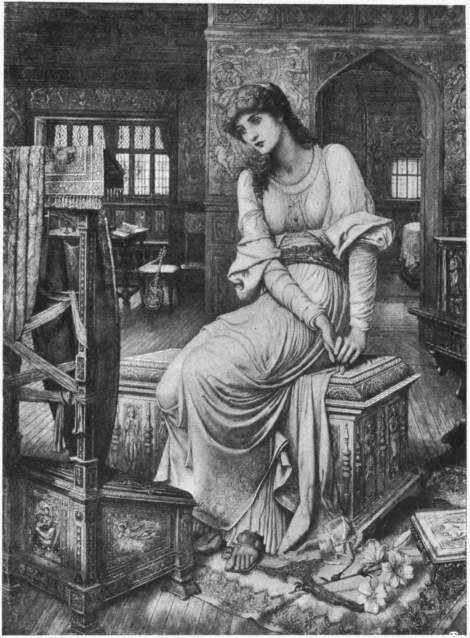 |
 | ||
| STRUDWICK. | ELAINE. | STRUDWICK. | Dixon, photo. THY TUNEFUL STRINGS WAKE MEMORIES. |
| (By permission of the Berlin Photographic Co., the owners of the copyright.) | (By permission of W. Imrie, Esq., the owner of the picture.) | ||
Burne-Jones stands to Botticelli as Botticelli himself stood to the antique, or as Swinburne to his literary models. As a graceful scholar, Swinburne has reproduced all styles: the language of the Old Testament, the forms of Greek literature, and the naïve lisp of the poets of chivalry. He decorates his verses with all manner of strange metaphors drawn from the literatures of all periods. His Atalanta in Calydon is, down to the choruses, an imitation of the Sophoclean tragedies. In his Ballad of Life he follows the model of the singers who made canzonets, the writers who followed Dante and the earliest lyric poets of Italy. In Laus Veneris he tells the story of Tannhäuser and Dame Venus in the manner of the French romantic poets of the sixteenth century; Saint Dorothy is a faithful echo of Chaucer’s narrative style; and the Christmas Carol is modelled upon the Provençal Ballades. Even the earliest lyrical mysteries are reproduced in some poems so precisely that, so far as form goes, they might be mistaken for originals. But the thought of Swinburne’s verse is what no earlier poet would have ever expressed. It is inconceivable that a Greek chorus would have chanted any song of the weariness of man, and of the gifts of grief and tears brought to him at his 186 creation; nor would a Greek have written that Hymn to Aphrodite, the deadly flower born of the foam of blood and the froth of the sea. And in Hesperia, where he describes a man who has loved beyond measure and suffered over-much amid the mad pleasures of Rome, and now sets out, pale and exhausted, to sail the golden sea of the West until he reach the “Fortunate Islands” and find peace before his death, the mood does not reflect the thoughts of the old world, but those of the close of the nineteenth century; and so it is, too, in his “Hendecasyllabics,” where he complains in classically chiselled diction of the swift decay of beauty and the hidden ills which of a sudden consume the inward force of life. And Burne-Jones treats old myths with the same freedom and independence. He takes them up and recasts them, discovers modern passions lying in the very heart of them, enriches them with a wealth of delicate shades, borrowed without the smallest ceremony from a new conception of the world and from the life of his own time. The human soul grown old looks back, as it were, upon the path which it has travelled, and sees the spirit of its own ripe age latent in its infancy, recognising that “the child is father of the man.” All the figures in his pictures are surrounded by a dusk which has nothing in common with the broad daylight in which the Renaissance artists placed the antique world. There remains what may be called a residue of modern feeling which has not been assimilated to the old myth, a breath of magic floating round these figures on their career, something mysterious, an elusive air of fable. This, indeed, is the pervasive temperament and sentiment of our own age. It is our own inward spirit that gazes upon us as though from an enchanted mirror with the mien of a phantom.
And just as he remodels the entire spirit of old myths, he converts the figures which he has borrowed into an artistic form of his own, and, without hesitation, subordinates them in type and physical build and bearing to the new part they have to play.
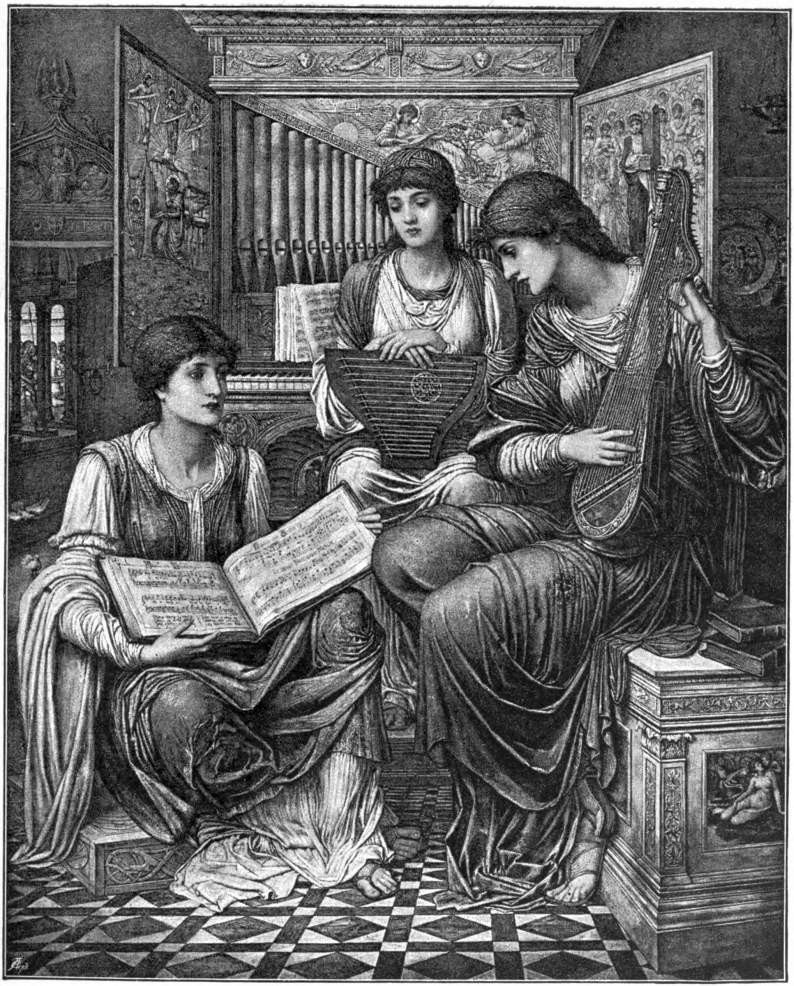 | |
| STRUDWICK. | Cassell & Co. GENTLE MUSIC OF A BYGONE DAY. |
| (By permission of John Dixon, Esq., the owner of the picture.) | |
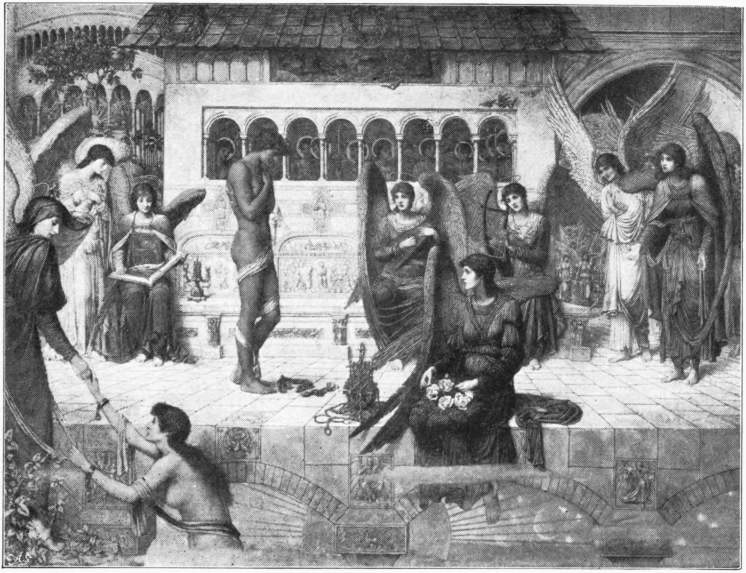 | |
| STRUDWICK. | Dixon, photo. THE RAMPARTS OF GOD’S HOUSE. |
| (By permission of Wm. Imrie, Esq., the owner of the picture.) | |
His pictures differ in their whole character from those of the masters of the Quattrocento. In Botticelli, also, the young foliage grows green and flaunts in its exuberant abundance; but in Burne-Jones the vegetation suggests one of those immense forests in Sumatra or Java. All the plants are luxuriant and resplendent in colour, and seem to swoon in their own opulent, plethoric life. Every tree creates an impression of having shot up in swift and wanton growth under a tropical sun. Rank parasitic plants trail from stem to stem, and garlands of climbers grow in a luxuriant tangle round the branches.
And in proportion as the vegetation is luxuriant and sensuous the human figures are wasted and languishing. The severe charm, rigidity, and demureness of the Quattrocento is weakened into lackadaisical melancholy. The dreamy bliss of Botticelli is transposed into sanctified solemnity, delicate fragility, a voluptuous lassitude, a gentle weariness of the world. When he paints ancient sibyls, they are touched at once by the unearthly asceticism of the Middle Ages seeking refuge from the world, and the melancholy, anæmic lassitude of the close of the nineteenth century. If he paints a Venus she does not stand out victorious in her nudity, but wears a heavy brocaded robe, and around her lie the symbols of Christian martyrdom, palms, and 190 perhaps a lyre. It is not the fairness of her body that makes her goddess of love, but only the dim mystery of her radiant eyes. She is not the Olympian who entered into frolicsome adventure with the war-god Mars amid the laughter of the heavenly gods, for in her conventional humiliation she is rather like the beautiful dæmon of the Middle Ages who, upon her journey into exile, passed by the cross where the Son of Man was hanging, and tasted all the bitterness of the years. In their delicate features his Madonnas have a gentle sadness rarely found in the Italian masters. Even the angels, who were roguish and wayward in the Quattrocento, do their spiriting with ceremonious gravity, and a subdued melancholy underlies their devotional reverence. In Botticelli they are fresh, youthful figures, lightly girdled, and with fluttering locks and swelling robes and limber bodies, whether they float around the Madonna in blissful revelry or look up to the Child Christ in their rapt ecstasy. But in Burne-Jones they are devout, sombre, deeply earnest beings, gazing as thoughtfully and dreamily as though they had already known all the affliction of the world. Their limbs seem paralysed, and their gesture weary. It is not possible to look at one of his pictures without being reminded of the Florentines of the fifteenth century, and yet the spectator at once recognises that they are the work of Burne-Jones. He is even opposed to Rossetti, his lord and master, through this element of melancholy: the intoxication of opium is followed by the sober awakening.
Rossetti’s women are dazzling and glorious figures of a modern and deliberately cruel beauty—sisters of Messalina, Phædra, and Faustina. He delineates them as luxuriant beings with supple and splendid bodies, long white necks, and snowily gleaming breasts; with full and fragrant hair, ardent, yearning eyes, and demoniacally passionate lips. Their mother is the Venus Verticordia whom Rossetti so often painted. Cruel in their love as one of the blind forces of nature, they are like that water-sprite with her song and her red coral mouth dragged from the sea in a fishing-net, as an old French fabliau tells, and so fair that every man who beheld her was seized by the love of her, but died when he clasped her in his arms. What they love in man is his physical strength, his face and sinews of bronze. Only the strong man who loves them with overpowering madness, like a stormy wind, can bend them to his will. Swinburne has sung of “the lips intertwisted and bitten, where the foam is as blood,” of
| “The heavy white limbs and the cruel Red mouth like a venomous flower.” |
 | |
| STRUDWICK. | Dixon, photo. THE TEN VIRGINS. |
| (By permission of William Imrie, Esq., the owner of the picture.) | |
But the women of Burne-Jones know that this fervour is no longer to be found upon the earth. The blood has been sapped, and the fire burns low, and the glorious, ancient might of love has disappeared. For these women life has lost its sunshine, and love its passion, and the world its hopes. The hue of their cheeks is pallid, their eyes are dim, their bodies sickly and without flesh and blood, and their hips are spare. With pale, quivering lips, and a melancholy smile or a strangely resigned, intensely grieved look flickering at the corners of their mouths, they live consumed by sterile longing, and pine in silent dejection, gazing into vacant space like imprisoned goldfish, or luxuriate in the vague Fata Morgana of an over-delicate, over-refined, and bashfully tremulous eroticism—
| “And the chaplets of old are above us, And the oyster-bed teems out of reach; Old poets outsing and outlove us, And Catullus makes mouths at our speech. Who shall kiss in the father’s own city, With such lips as he sang with again? Intercede with us all of thy pity, Our Lady of Pain.” |
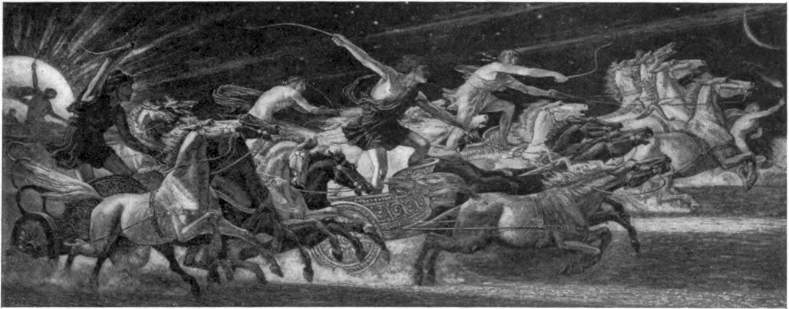 | |
| CRANE. | Portfolio. THE CHARIOTS OF THE FLEETING HOURS. |
| (By permission of the Artist.) | |
Swinburne’s first ardent and sensuous volume of lyrics contains a poem, The Garden of Proserpine: it tells how a man weary of all things human and divine, and no longer able to support the intoxicating fragrance of the roses of Aphrodite, draws near with wavering steps to the throne where calm Proserpine sits silent, crowned with cold white flowers. And in the same way Rossetti’s flaming and quivering passion and his volcanic desire end in Burne-Jones with sad resignation.
Whilst Christianity and Hellenism mingle in the figures of Burne-Jones, a division of labour is noticeable amongst the following artists: some addressed themselves exclusively to the treatment of ancient subjects, others to ecclesiastical romantic painting in the style of the Quattrocento, and others again recognised their chief vocation in initiating a reformation in kindred provinces of industrial art.
R. Spencer Stanhope, who was at Oxford, like Burne-Jones, and, indeed, received his first artistic impulses while employed on the elaboration of Rossetti’s mural pictures for the Union, worked even in later days chiefly in the field of decorative painting, and is, with Burne-Jones, the principal designer 194 for the interior decoration of churches in England. His oil-paintings are few, and in their gracious Quattrocento build they are in outward appearance scarcely different from those of Burne-Jones. In a picture belonging to the Manchester Gallery there is a maiden seated amid a flowery meadow, while a small Cupid with red pinions draws near to her; the landscape has an air of peace and happiness. Another picture—probably inspired by Catullus’ Lament for Lesbia’s Sparrow—displays a girl sitting upon an old town wall with a little dead bird. “The Temptation of Eve” is like a brilliantly coloured mediæval miniature, painted with the greatest finesse. As in the woodcut in the Cologne Bible, Paradise is enclosed with a circular red wall. Eve is like a slim, twisted Gothic statue. Like Burne-Jones, Stanhope is always delicate and poetic, but he is less successful in setting upon old forms of art the stamp of his individuality, and thus giving them new life and a character of their own. In their severe, archæological character his pictures have little beyond the affectation of a style which has been arrived at through imitation.
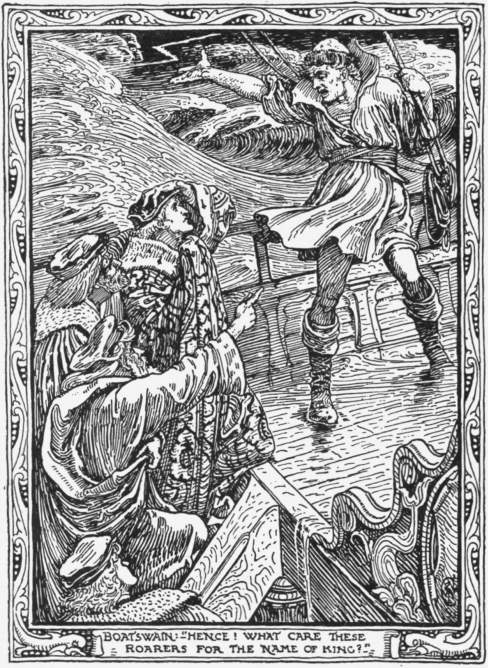 |
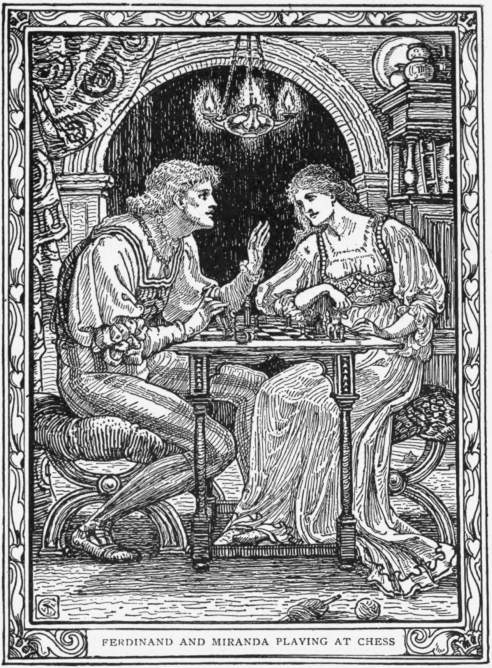 | ||
| WALTER CRANE. | FROM THE TEMPEST. | WALTER CRANE. | FROM THE TEMPEST. |
The third member of this Oxford Circle, the poet William Morris, has exercised great influence over English taste by the institution of an industrial establishment for embroidery, painting upon glass, and household decoration. Keeping in mind that close union which existed in the fifteenth century between art and the manual crafts, he and certain of his disciples did not hesitate to provide designs for decorative stuffs, wall-papers, furniture, and household embellishments of every description. They were largely indebted to the Japanese, to say nothing of the old Italians, though they succeeded in creating a thoroughly modern and independent style, in spite of all they borrowed. The whole range of industrial art in England received a new lease of life, and household 195 decoration became blither and more cheerful in its appearance. Only light, delicate, and finely graduated colours were allowed to predominate, and they were combined with slender, graceful, and vivacious form. The heavy panelling which was popular in the sixties gave way to bright papers ornamented with flowers; narrow panes made way for large plate-glass windows with light curtains, in which long-stemmed flowers were entwined in the pattern. Slim pillars supported cabinets painted in exquisite hues or gleaming with lacquer-work and enamel. Seats were ornamented with soft cushions shining in all the delicate splendour of Indian silks. And the pre-Raphaelite style of ornamentation was even extended to the embellishment of books, so that England created the modern book, at a time when other nations adhered altogether to the imitation of old models.
In his early years Arthur Hughes attracted much attention by an Ophelia, a delicate, thoroughly English figure of soft pre-Raphaelite grace; but in later years he rarely got beyond sentimental Renaissance maidens suggestive of Julius Wolff, and humorous work in the style of genre.
J. N. Strudwick, who worked first under Spencer Stanhope and then under Burne-Jones, was more consistent in his fidelity to the pre-Raphaelite principles. His pictures have the same delicate, enervated mysticism, and the same thoughtful, dreamy poetry, as those of his elders in the school. By preference he paints slender, pensive girlish figures, with the sentiment of Burne-Jones, taking his motive from some passage in a poet. In a picture called “Elaine” the heroine is mournfully seated in a lofty room of a mediæval palace. Another of his works reveals three girls occupied with music. Or a knight strewn with roses lies asleep in a maiden’s lap. Or again, there is St. Cecilia standing with her Seraphina before a Roman building. Strudwick does not possess 196 the spontaneity of his master. The childlike, angular effect at which he aims often seems slightly weak and mawkish; and occasionally his painting is somewhat diffident, especially when he paints in the architectural detail and rich artistic accessories, and stipples with a very fine brush. But his works are so exquisite and delicate, so precious and æsthetic, that they must be reckoned amongst the most characteristic performances of the New pre-Raphaelitism. One of his larger compositions he has named “Bygone Days.” There is a man musing over the memories of his life, as he sits upon a white marble throne in front of a long white marble wall, amid an evening landscape. He stretches out his arms after the vanished years of his youth, the years when love smiled upon him; but Time, a winged figure like Orcagna’s Morte, divides him from the goddess of love, swinging his scythe with a threatening gesture. “The Past,” a slender matron in a black robe, covers her face lamenting. In Strudwick’s most celebrated picture, “The Ramparts of God’s House,” there is a man standing at the threshold of heaven, naked as a Greek athlete. His earthly fetters lie shattered at his feet. Angels receive him, marvellously spiritual beings filled with a lovely simplicity and revealing ineffable profundity of soul, beings who partake of Fra Angelico almost as much as of Ellen Terry. Their expression is quiet and peaceful. Instead of marvelling at the new-comer, they gaze with their eyes green as a water-sprite’s meditatively into illimitable space. The architecture in the background is entirely symbolical, as in the pictures of Giotto. A little house with a golden roof and gilded mediæval reliefs is inhabited by a dense throng of little angels, as if it were a Noah’s-ark. The colour is rich and sonorous, as in the youthful works of Carlo Crivelli.
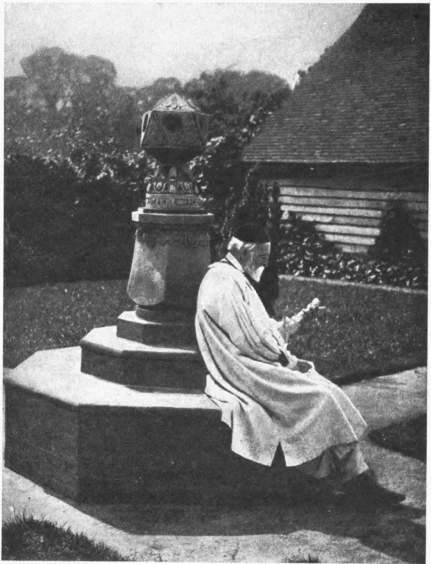 |
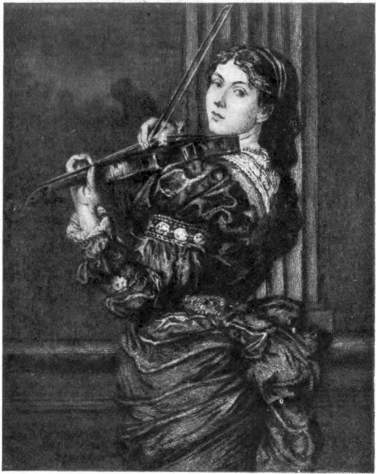 | ||
| G. F. WATTS IN HIS GARDEN. | WATTS. | L’Art. LADY LINDSAY. | |
| (By permission, from a photograph by A. Frazer-Tytler, Esq.) | (By permission of Lady Lindsay, the owner of the picture.) | ||
Henry Holliday, who has of late devoted himself largely to decorative tasks, seems in these works to be the juste-milieu between Burne-Jones and Leighton. And the youngest representative of this group tinged with religious and romantic feelings is Marie Spartali-Stillman, who lives in Rome and paints as a rule pictures from Dante, Boccaccio, and Petrarch, after the fashion of Rossetti.
Others, who turned to the treatment of antique subjects, were led by these themes more towards the Idealism of the Cinquecento as regards the form of their work; and in this way they lost the severe stamp of the pre-Raphaelites.
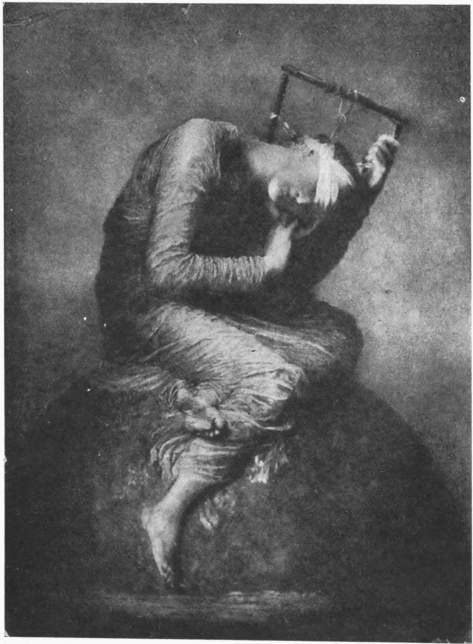 |
| Cameron, photo. |
| WATTS. HOPE. |
| (By permission of the Artist.) |
In these days William Blake Richmond, in particular, no longer shows any trace of having once belonged to the mystic circle of Oxonians. The Ariadne which he painted in the old days was a lean and tall woman with fluttering black mantle, casting up her arms in lamentation and gazing out of those deep, gazelle-like eyes which Burne-Jones gave his Vivien. Even the scheme of colour was harmonised in the bronze, olive tone which marked the earliest works of Burne-Jones. But soon afterwards his views underwent a complete revolution in Italy. Influenced by Alma Tadema in form, and by the French in colour, he drew nearer to the academic manner, until he became, at length, a Classicist without any salient peculiarity. The allegory “Amor Vincit Omnia” is characteristic of this phase of his art. Aphrodite, risen from her bath, is standing naked in a Grecian portico, through which a purple sea is visible. Her maidens are busied in dressing her; and they are, one and all, chaste and noble figures of that classic grace and elegant fluency of line which Leighton usually lends to his ideal forms. In a picture which became known in Germany through the International Exhibition of 1891, Venus, a clear and white figure, floats down with stately motion towards Anchises. It is only in the delicate pictures of children which have been his chief successes of late years that he is still fresh and direct. Girls with thick hair of a blonde cendrée, finely moulded lips, and large gazelle-like eyes full of sensibility, are seen in these works dreamily seated in white or blue dresses against a red or a blue curtain. And the æsthetic method of painting, which almost suggests pastel work in its delicacy, is in keeping with the ethereal figures and the bloom of colour.
Walter Crane has been far more successful in uniting the pre-Raphaelite conception with a sentiment for beauty formed upon the antique, Burne-Jones’s “paucity of flesh and plenitude of feeling” with a measured nobility of form. Born in Liverpool in 1845, he received his first impressions of art at the Royal Academy Exhibition of 1857, where he saw Millais’ “Sir Isumbras at the Ford.” The chivalrous poetry of this master became the ideal of 198 his youth, and it rings clearly throughout his first pictures, exhibited in 1862. One of these has as its subject “The Lady of Shalott” approaching the shore of her mysterious island in a boat, and the other St. George slaying the dragon. Meanwhile, however, he had come to know Walker, through W. J. Linton, the wood-engraver, for whom he worked from 1859 to 1862, and the former led him to admire the beauty of the sculptures of the Parthenon. After this he passed from romantic to antique subjects, and there is something notably youthful, a fresh bloom as of old legends, in these compositions, which recall the sculpture of Phidias. “The Bridge of Life,” belonging to the year 1875, was like an antique gem or a Grecian bas-relief. At the Paris World Exhibition of 1878 he had a “Birth of Venus,” noble and antique in composition, and of a severity of form which suggested Mantegna. The suave and poetic single figures which he delights in painting are at once Greek and English: girls, with branches of blossom, in white drapery falling into folds, and enveloping their whole form while indicating every line of the body. His “Pegasus” might have come straight from the frieze of the Parthenon. “The Fleeting Hours” at once recalls Guido Reni’s “Aurora” and Dürer’s apocalyptic riders.
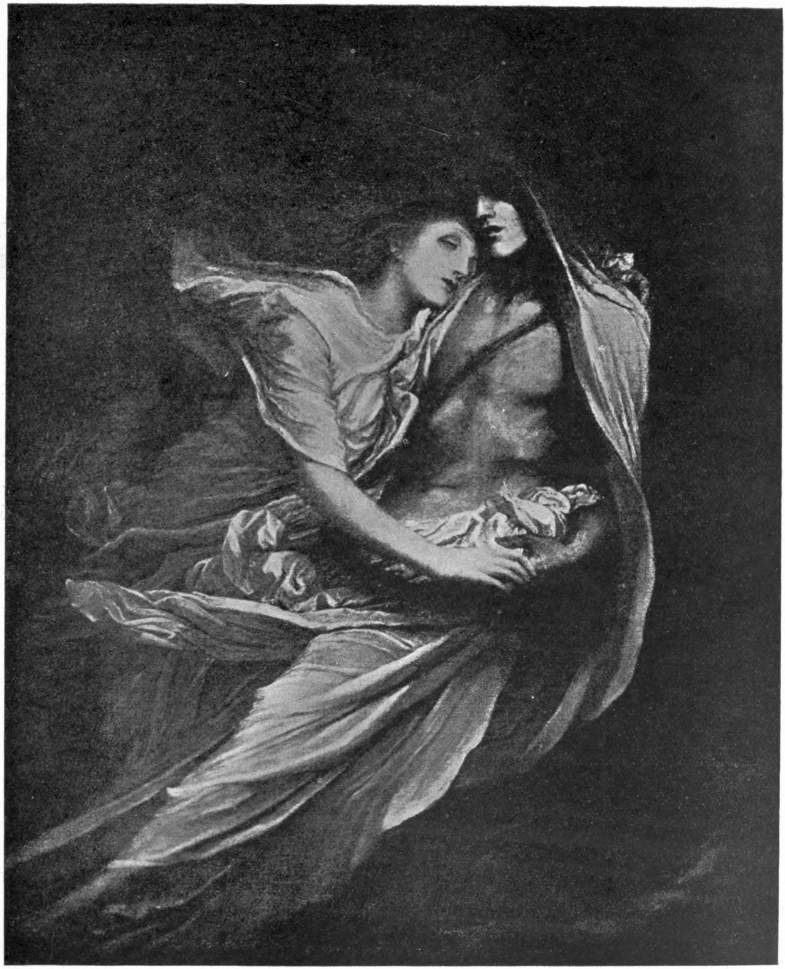 | |
| WATTS. | Pageant. PAOLO AND FRANCESCA. |
| (By permission of the Artist.) | |
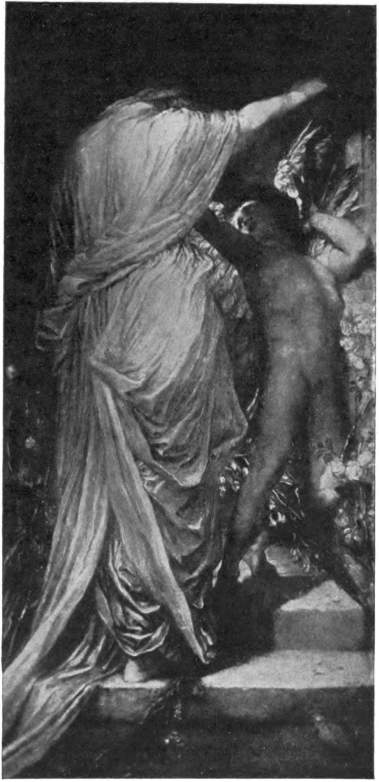 |
| Cameron, photo. |
| WATTS. LOVE AND DEATH. |
| (By permission of the Corporation of Manchester, the owners of the picture.) |
Later he turned to decorative painting, like all the representatives of the pre-Raphaelite group. He is one of the most original designers for industrial work in tapestry, next to Morris the most influential leader of the English arts and crafts, and he has collaborated in founding that modern naturalistic tendency of style which will be the art of the future. His designs are always based upon naturalistic motives—the English type of womanhood and the English splendour of flowers. There always predominates a sensitive relationship between the æsthetic character of the forms and their symbolical significance. He always adapts an object of nature so that it may correspond in style with the material in which he works. The way in which he makes use of the noblest models of antiquity and of the Renaissance, and yet immediately transposes them into an English key of sentiment and into available modern forms, is entirely peculiar. And last, but not least, he is a marvellous illustrator. Every one went wild with delight at the close of the sixties over the appearance of his first children’s books, The Faerie Queene, The Little Pig who went to Market, and King Luckiboy, the pictures of which were soon displayed upon all patterns for embroidery. And they were followed by others: after 1875 he published Tell me a Story, The First of May—a Fairy Masque, The Sirens Three, Echoes of Hellas, and so forth. The two albums The Baby’s Bouquet and The Baby’s Opera of 1879 are probably the finest of them all.
In spite of their childish subjects, the drawings of Walter Crane have such a monumental air that they have the effect of “grand painting.” Without imitation he reproduces spontaneously the grace and character of the primitive Florentines. Some of his plates recall “The Dream of Polifilo,” and might bear the monogram of Giovanni Bellini. They owe their origin to a profound Germanic sentiment mingled with pagan reminiscences; they are an almost Grecian and yet English art, where fancy like a foolish, dreamy child plays with a brilliant skein of forms and colours.
That great artist George Frederick Watts stands quite apart as a personality in himself. In point of substance he is divided from others by not leaning upon poets, but by inventing independent allegories for himself; and in point of form by courting neither the Quattrocento nor the Roman Cinquecento, but rather following the Venice of the later Renaissance. Instead of the marble precision of Squarcione or Mantegna, what predominates in his work is something soft and melting, which might recall Correggio, Tintoretto, or Giorgione, were it not that there is a cooler grey, a subdued light fresco tone in Watts, in place of the Venetian glory of colour.
As a man, Watts was one of those artists who are only to be found in England—an artist who, from his youth upwards, has been able to live for his art without regard to profit. Born in London in the year 1820, he left the Academy after being a pupil there for a brief period, and began to visit the Elgin Room in the British Museum. The impression made upon him by the sculptures of the Parthenon was decisive for his whole life. Not merely are numerous plastic works due to his study of them, but several of his finest paintings. When he was seventeen he exhibited his first pictures, which were painted very delicately and with scrupulous pains; and in 1843 he took part in the competition for the frescoes of the Houses of Parliament, amongst which the representation of St. George and the Dragon was from his hand. With the proceeds of the prize which he received at the competition he went to Italy, and there he came to regard the great Venetians Titian and Giorgione as his kin and his contemporaries. The pupil of Phidias became the worshipper of Tintoretto. In Italy he produced “Fata Morgana,” a picture of a warrior vainly catching at the airy white veil of a nude female figure which floats past. This work already displays him as an accomplished artist, though it is wanting in the large, Classical tranquillity of his later paintings. He returned home with plans demanding more than human energy. Like the Frenchman Chenavard, he cherished the purpose of representing the history of the world in a series of frescoes, which were to adorn the walls of a building specially adapted for the purpose. “Chaos,” “The Creation,” “The Temptation of Man,” “The Penitence,” “The Death of Abel,” and “The Death of Cain” were the earliest pictures which he designed for the series. It was through fresco painting alone, as he believed, that it was possible to school English art to monumental grandeur, nobleness, and simplicity. But it was not possible for him to remain long upon this path in England, where painting has but little space accorded to it upon the walls of churches, while in other public buildings decoration is not in demand. Moreover, it is doubtful whether Watts would have achieved anything great in this province of art. At any rate, a work which he executed for the dining-hall at Lincoln’s Inn—an assembly of the lawgivers of all times from Moses down to Edward I—is scarcely more than a mixture of Raphael’s “School of Athens” and the “Hemicycle” of Delaroche. In magnificent allegories in the form of oil-paintings he first found the expression of his individuality. Like Turner, Watts did not paint pictures for sale. Yet he has lent one or other of his pictures to almost every public exhibition. A whole room is devoted to him in the Tate Gallery. But to know his work thoroughly one had to go to his house. His studio in Little Holland House contained almost all his important creations, and was visited by the public upon Saturday and Sunday afternoons as freely as if it were a museum.
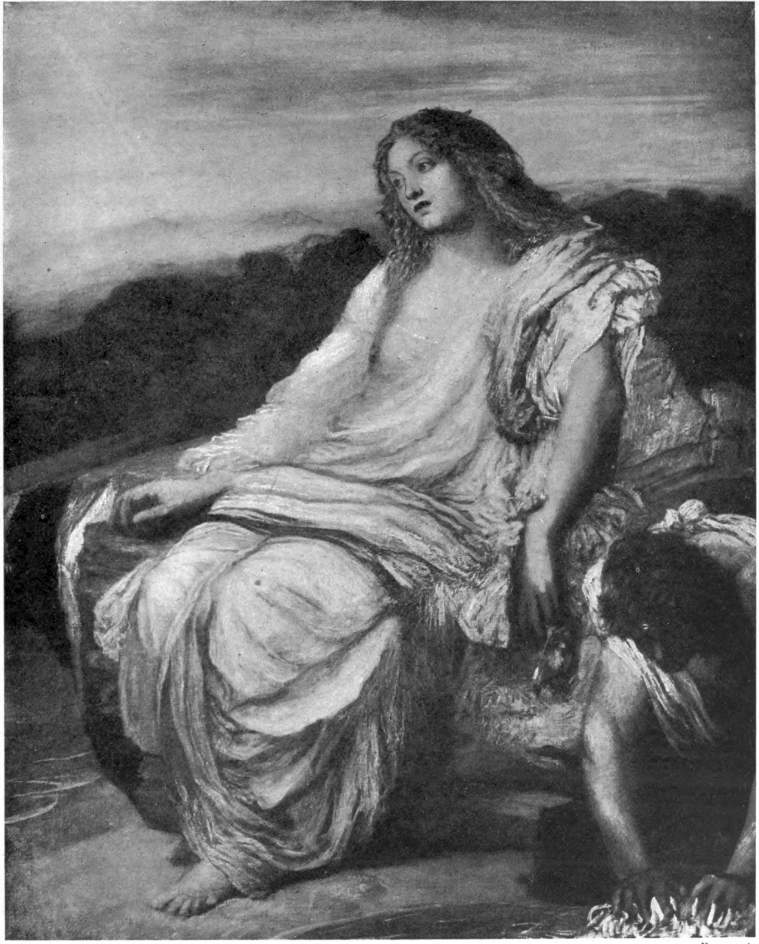 | |
| WATTS. | Pageant. ARIADNE. |
| (By permission of Mr. F. Hollyer, the owner of the copyright.) | |
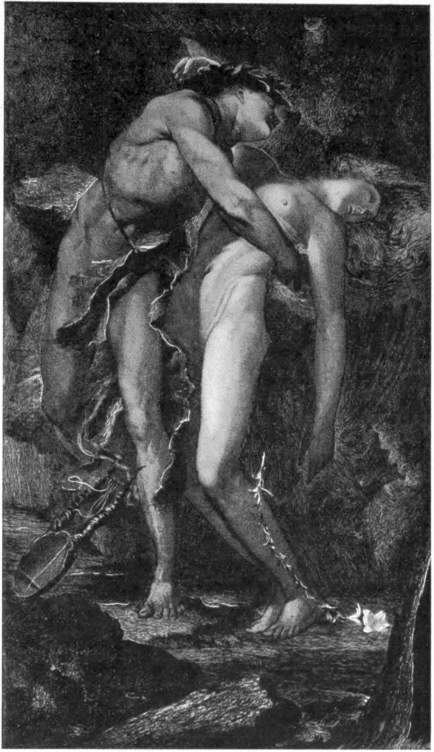 |
| L’Art. |
| WATTS. ORPHEUS AND EURYDICE. |
| (By permission of the Artist.) |
As a landscape painter Watts is a visionary like Turner, though in addition to the purely artistic effect of his pictures he always endeavoured to awaken remoter feelings and ideas of some kind or another. His landscape “Corsica” reveals a grey expanse, with very slight vibrations of tone which suggest that out to sea a distant island is emerging from the mist. His “Mount Ararat,” a picture entirely filled with the play of light blue tones, represents a number of barren rocky cones bathed in the intense blue of a pure transparent starry night. Above the highest peak there is one star sparkling more brilliantly than the others. In his “Deluge: the Forty-first Day,” he attempted to depict, after an interpretation of his own, the power “with which light and heat, dissipating the darkness and dissolving the multitude of the waters into mist and vapour, give new life to perished nature.” What is actually placed before the eye is a delicate symphony of colours which would have delighted Turner: wild, agitated sea, clouds gleaming like liquid gold, and mist behind which the sun rises in a magical glow, like a red ball of fire.
In his portraits he is earnest and sincere. Just as fifty years ago David d’Angers devoted half a lifetime to getting together a portrait gallery of famous contemporaries, so to Watts belongs the glory of having really been the historian of his time. The collection of portraits, many of which are to be seen in the National Portrait Gallery, comprises about forty likenesses, all of them half-length pictures, all of them upon the same scale of size, all of them representing very famous men. Amongst the poets comprised in this gallery of genius are Alfred Tennyson, Robert Browning, Matthew Arnold, Swinburne, William Morris, and Sir Henry Taylor; amongst prose-writers, Carlyle, John Stuart Mill, Lecky, Motley, and Leslie Stephen; amongst statesmen, Gladstone, Sir Charles Dilke, the Duke of Argyll, Lord Salisbury, Lord Shaftesbury, Lord Lyndhurst, and Lord Sherbrooke; amongst the leaders of the clergy, Dean Stanley, Dean Milman, Cardinal Manning, and Dr. Martineau; 206 amongst painters, Rossetti, Millais, Leighton, Burne-Jones, and Calderon; and amongst notable foreigners, Guizot, Thiers, Joachim the violinist, and many others. In the matter of technique Watts is excelled by many of the French. His portraits have something heavy, nor are they eminent either for softness of modelling, or for that momentary and animated effect peculiar to Lenbach. But few portraits belonging to the nineteenth century have the same force of expression, the same straightforward sureness of aim, the same grandeur and simplicity. Before each of the persons represented one is able to say, That is a painter, that a poet, and that a scholar. All the self-conscious dignity of a President of the Royal Academy is expressed in the picture of Leighton, and his look is as cold as marble; while the eyes of Burne-Jones seem mystically veiled, as though they were gazing into the past. Indeed, the way in which Watts grasps his characters is masterly beyond conception. Amongst the old painters Tintoretto and Moroni might be compared with him most readily, while Van Dyck is the least like him of all.
In opposition to the poetic fantasy of Burne-Jones dallying with legendary lore, an element of brooding thought is characteristic of the large compositions of Watts, a meditative absorption in ideas which provoke the intellect to further activity by their mysterious allegorical suggestions. Just as he makes an approach to the old Venetians in external form, he is divided from them in the inward burden of his work by a severity and hardiness characteristic of the Northern spirit, a predominance of idea seldom met with amongst Southern masters, and a profoundly sad way of thought in which one sees the stamp of the nineteenth century. Apart from the purely artistic effect of his work, he tried to make his pictures serve as a stimulus to deeper thought and meditation: “The end of art,” he writes, “must be the exposition of some weighty principle of spiritual significance, the illustration of a great truth.”
“The Spirit of Christianity,” the only one of his works which has a religious tone, displays a youth throned upon the clouds, with children nestling at his feet. His powerful head is bent upwards, and his right hand opened wide. In “Orpheus and Eurydice” he has chosen the moment when Orpheus turns round to behold Eurydice turning pale and sinking to the earth, to be once more swallowed by Hades. The lyre drops from his hands, and with a gesture of despair he draws the form of his wife to his heart in a last, eternal embrace. “Artemis and Endymion” is a scene in which a tall female figure in silvery shining vesture bends over the sleeping shepherd, throwing herself into the curve of a sickle.
But, as a rule, he neither makes use of Christian nor of ancient ideas, but embodies his own thoughts. In “The Illusions of Life,” a picture belonging to the year 1847, beautiful, dreamy figures hover over a gulf, spreading at the verge of existence. At their feet lie the shattered emblems of greatness and power, and upon a small strip of the earth hanging over an abyss those illusions are visible which have not yet been destroyed: Glory, in the shape 207 of a knight in harness, chases the bubble of resounding fame; Love is symbolised by a pair who are tenderly embracing; Learning, by an old man poring over manuscripts in the dusk; Innocence, by a child grasping at a butterfly. “The Angel of Death” is a picture of a winged and mighty woman throned at the entrance of a way which leads to eternity. Upon her knees there rests, covered with a white cloth, the corpse of a new-born child. Men and women of every station lay reverently down at the feet of the angel the symbols of their dignity and the implements of their earthly toil.
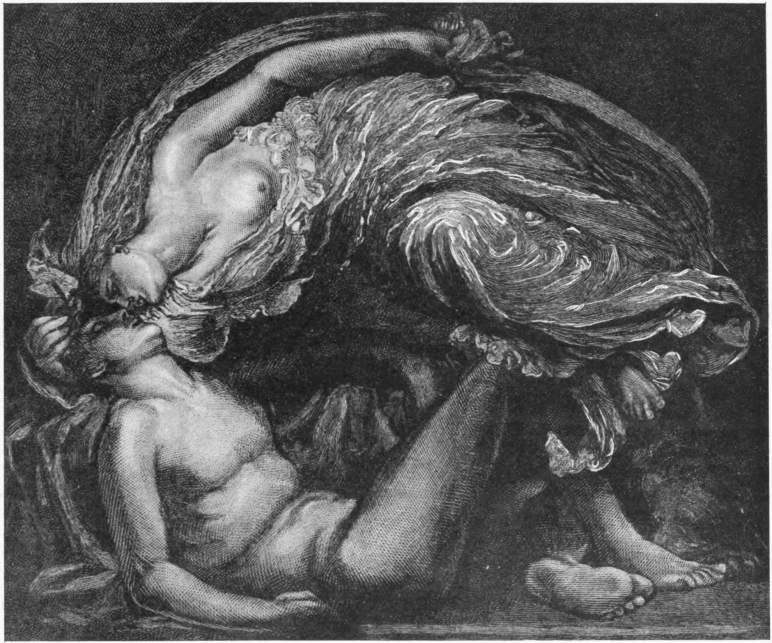 | |
| WATTS. | Gaz. des Beaux-Arts. ARTEMIS AND ENDYMION. |
| (By permission of Mr. Robert Dunthorne, the owner of the copyright.) | |
“Love and Death” represents the two great sovereigns of the world wrestling together for a human life. With steps which have a mysterious majesty, pallid Death draws near, demanding entrance at the door of a house, whilst Love, a slight, boyish figure with bright wings, places himself in the way; but with one great, irresistible gesture the mighty genius of Death sweeps the shrinking child to one side. In another picture, “Love and Life,” the genius of Love, in the form of a slim, powerful youth, helps poor, weak, clinging Life, a half-grown, timid, faltering girl, to clamber up the stony path of a mountain, over which the sun rises golden. “Hope” is a picture in 208 which a tender spirit, bathed in the blue mist, sits upon the globe, blindfold, listening in bliss to the low sound vibrating from the last string of her harp. “Mammon” is embodied by Watts in a coarse and bloated satyr brutally setting his heel upon a youth and a young girl, as upon a footstool.
In 1893, when the committee of the Munich Exhibition were moved by the writings of Cornelius Gurlitt to have some of these works sent over to Germany, a certain disappointment was felt in artistic circles. And any one who is accustomed to gauge pictures by their technique is justified in missing the genuine pictorial temperament in Watts. The sobriety of his scheme of colour, his preference for subdued tones, his distaste for all “dexterity” and freedom from all calculated refinement, are not in accord with the desires of our time. Even his sentiment is altogether opposed to that which predominates in the other New Idealists. Burne-Jones and Rossetti found sympathy because their repining lyricism, their psychopathic subtlety, their wonderful mixture of archaic simplicity and décadent hautgoût, stand in direct touch with the present. Watts’ pictures seem cold and wanting in temperament because he made no appeal to the vibrating life of the nerves.
But the same sort of criticism was written by the younger generation in Germany, seventy years ago, on the works of Goethe, which have, none the less, remained fresher than those of Schlegel and Tieck. What is modern is not always the same as what is eternally young. And if one endeavours, disregarding the current of the age, to approach Watts as though he were an old master, one feels an increasing sense of the probability that amongst all the New Idealists of the present he has, next to Boecklin, the best prospect of becoming one. In spite of all its independence of spirit, the art of Burne-Jones has an affected mannerism in its outward garb. The sentiment of it is free, but the form is confined in the old limits. And it is not impossible that later generations, to whom his specifically modern sentiment will appeal more and more faintly, may one day rank him, on account of his archaism in drawing, as much amongst the eclectics as Overbeck and Führich are held to be at the present time. But that can never happen to Watts. His works are the expression of an artist who is as little dependent upon the past as upon the momentary tendencies of the present. His articulation of form has nothing in common with the lines of beauty of the antique, or the Quattrocento, or the Cinquecento. It is a thing created by himself and to himself peculiar. He needs no erudition, and no attributes and symbols borrowed from the Renaissance, to body forth his allegories. With him there begins a new power of creating types; and his figure of Death—that tall woman, clad in white, with hollow cheeks, livid face, and lifeless sunken eyes—is no less cogent than the genius with the torch reversed or the burlesque skeleton of the Middle Ages. Moreover, there is in his works a trace of profundity and simple grandeur which stands alone in our own period. It is precisely our more sensitive nervous system which divides us from the old painters, and has generally given the artistic productions of our day a disturbed, 209 capricious, restless, and overstrained character, making them inferior to those of the old masters.
Watts is, perhaps, the only painter who can bear comparison with them in every respect. Here is a man who has been able to live in himself far away from the bustle of exhibitions, a man who worked when he was old as soundly and freshly as when he was young, a man, also, who is always simple in his art, lucid, earnest, grandiose, impressive, and of monumental sublimity. Though he shows no trace of imitation he might have come straight from the Renaissance, so deep is his sense of beauty, so direct and so condensed his power of giving form to his ideas. And amongst living painters I should find it impossible to name a single one who could embody such a scene as that of “Love and Death” so calmly, so entirely without rhetorical gestures and all the tricks of theatrical management. There is the mark of style about everything in Watts, and it is no external and borrowed style, but one which is his own, a style which a notable man, a thinker and a poet, has fashioned for the expression of his own ideas. That is what makes him a master of contemporary painting and of the painting of all times. And that is what will, perhaps, render him, in the eyes of later generations, one of the greatest men of our time.

CHAPTER XXXIII
THE NEW IDEALISM IN FRANCE AND GERMANY
A similar change of taste occurred in France. Just as the Impressionists had held modernity alone in high honour, so now awoke the longing after the faded lustre of a bygone age of beauty. The younger generation in literature began to do homage to their spiritual ancestors not in Zola but in Charles Baudelaire, that abstracter of the quintessence; and similarly in the province of art there came to the fore two of the older masters who until then had been relegated to the background.
In pictorial art Gustave Moreau is equivalent to Charles Baudelaire. Certain of the strange and fascinating poems in the Fleurs du Mal strike alone the same note of sentiment as the tortured, subtilised, morbid, but mysterious and captivating creations of Moreau; and his figures, like those of Baudelaire, live in a mysterious world, and stimulate the spirit like eternal riddles. Every one of his works stands in need of a commentary; every one of them bears witness to a profound and peculiar activity of mind, and every one of them is full of intimate reveries. Every agitation of his inward spirit takes shape in myths of hieratical strangeness, in mysterious hallucinations, which he sets in his pictures like jewels. He gives ear to dying strains, rising faintly, inaudible to the majority of men. Marvellous beings pass before him, fantastic and yet earnest; forms of legendary story hover through space upon strange animals; a fabulous hippogriff bears him far away to Greece and the East, to vanished worlds of beauty. Upon the journey he beholds Utopias, beholds the Fortunate Islands, and visits all lands, borne upon the pinions of a dream. An age which went wild over Cabanel and Bouguereau could not possibly be in sympathy with him. The Naturalists, also, looked upon him as a singular being; it was much as if an Indian magician whose robe shone in all the hues of the rainbow had suddenly made his appearance at a ball, amongst men in black evening dress. It is only since the mysterious smile of Leonardo’s feminine figures has once more drawn the world beneath its spell that the spirit of Moreau’s pictures has become a familiar thing. Even his schooling was different from that of his contemporaries. He was the only pupil of that strange artist Théodore Chassériau, and Chassériau had directed him to the study of Bellini, Mantegna, Leonardo da Vinci, and all those enchanting primitive artists whose enchanting female figures are seen to move through mysterious black and blue landscapes. He was then seized with an enthusiasm 211 for the hieratical art of India. And he was also affected by old German copper-engraving, old Venetian pottery, painting upon vases and enamel, mosaics and niello work, tapestries and old Oriental miniatures. His exquisite and expressive style, which, at a time when the flowing Cinquecento manner was in vogue, made an unpleasant effect by its archaic angularity, was the result of the fusion of these elements.
When he appeared, the special characteristic of French art was its seeking after violent agitations of the spirit, émotions fortes. The spirit was to be roused by stormy vehemence, as a relaxed system is braced by massage. But the generation at the close of the nineteenth century wanted to be soothed rather than stirred by painting. It could not endure shrill cries, loud, emphatic speech, or vehement gestures. It desired subdued and refined emotions, and Moreau’s distinction is that he was the first to give expression to this weary décadent humour. In his work a complete absence of motion has taken the place of the striding legs, the attitudes of the fencing-master, the arms everlastingly raised to heaven, and the passionately distorted faces which had reigned in French painting since David. He makes spiritual expression his starting-point, and not scenic effect; he keeps, as it were, within the laws which rule over classical sculpture, where vehemence was only permitted to intrude from the period of decline, from the Pergamene reliefs, the Laocoön, and the Farnese Bull. Everything bears the seal of sublime peace; everything is inspired by inward life and suppressed passion. Even when the gods fight there are no mighty gestures; with a mere frown they can shake the earth like Zeus.
His spiritual conception of the old myths is just as peculiar as his grave articulation of form; it is a conception such as earlier generations could not have, one which alone befits the spiritual condition of the close of the nineteenth century. During the most recent decades archæological excavations and scientific researches have widened and deepened our conceptions of the old mythology in a most unexpected manner. Beside the laughter of the Grecian Pan we hear the sighs and behold the convulsions of Asia, in her anguish bearing gods, who perish young like spring flowers, in the loving arms of Oriental goddesses. We have heard of chryselephantine statues covered with precious stones from top to bottom; and we know the graceful terra-cotta figures of Tanagra. Before there was a knowledge of the Tanagra statuettes no archæologist could have believed that the Eros of Hesiod was such a charming, wayward little rascal. Before the discovery of the Cyprus statues no artist would have ventured to adorn a Grecian goddess with flowers, pins for the head, and a heavy tiara. Prompted by these discoveries, Moreau has been swayed by strangely rich inspirations. He is said to have worked in his studio as in a tower opulent with ivory and jewels. He has a delight in arraying the figures of his legends in the most costly materials, as the discoveries at Cyprus give him warrant for doing, in painting their robes in the deepest and most lustrous hues, and in being almost too lavish in his manner 212 of adorning their arms and breasts. Every figure of his is a glittering idol, enveloped in a dress of gold brocade embroidered with precious stones. His love of ornamentation is even extended to his landscapes. They are improbable, far too fair, far too rich, far too strange to exist in the actual world, but they are in close harmony with the character of these sumptuously clad figures which wander in them like the mystic and melancholy shapes of a dream. The capricious generation that lived in the Renaissance occasionally handled classical subjects in this manner, but there is the same difference between Filippino Lippi and Gustave Moreau as there is between Botticelli and Burne-Jones: the former, like Shakespeare in the Midsummer Night’s Dream, transformed the antique into a blithe and fantastic fairy world, whereas that fire of yearning romance which once flamed from poor Hölderlin’s poet heart burns in the pictures of Moreau.
His “Orpheus” is one of his most characteristic and beautiful works. He has not borrowed the composition from antique tragedy. The drama is over. Orpheus has been torn asunder by the Mænads, and the limbs of the poet lie scattered over the icy fields of the hyperborean lands. His head, borne upon his lyre now for ever mute, has been cast upon the shore of Erebus. Nature seems to sleep in mysterious peace. Around there is nothing to be seen but still waters and pallid light, nothing to be heard but the tone of a small shrill flute, played by a barbarian shepherd sitting on the cliff. A Thracian girl, whose hair is adorned with a garland, and whose look is earnest, has taken up the head of the singer and regards it long and quietly. Is it merely pity that is in her eyes? A romantic Hellenism, a profound melancholy underlies the picture, and the old story closes with a cry of love. In his “Œdipus and the Sphinx” of 1864, and his “Heracles” of 1878, he treated battle scenes, the heroic struggle between man and beast, and in these pictures, also, there is no violence, no vehemence, no movement. In a terrible silence the two antagonists exchange looks in his “Œdipus and the Sphinx,” while their breath mingles. Like a living riddle, the winged creature gazes upon the stranger, but the youth with his long locks stands so composedly before her that the spectator feels that he must know the decisive word.
In “Helen upon the Walls of Troy” the figure of the enchantress, as she stands there motionless, clad in a robe glittering with brilliant stones and diamonds like a shrine, is seen to rise against the blood-red horizon as though it were a statue of gold and ivory. Like a queen of spades, she holds in her hand a large flower. Heaps of bodies pierced with arrows lie at her feet. But she has no glance of pity for the dying whose death-rattle greets her. Her wide, apathetic eyes are fixed upon vacancy. She sees in the gold of the sunset the smoke ascending from the Grecian camp. She will embark in the fair ship of Menelaus, and return in triumph to Hellas, where new love shall be her portion. And the looks of the old men fasten upon her in admiration. “It is fitting that the Trojans and the Achæans fight for such a woman.” Helen in her blond voluptuous beauty is transformed beneath 213 the hands of Moreau into Destiny stalking over ground saturated with blood, into the Divinity of Mischief—a divinity that, without knowing it, poisons everything that comes near her, or that she sees or touches.
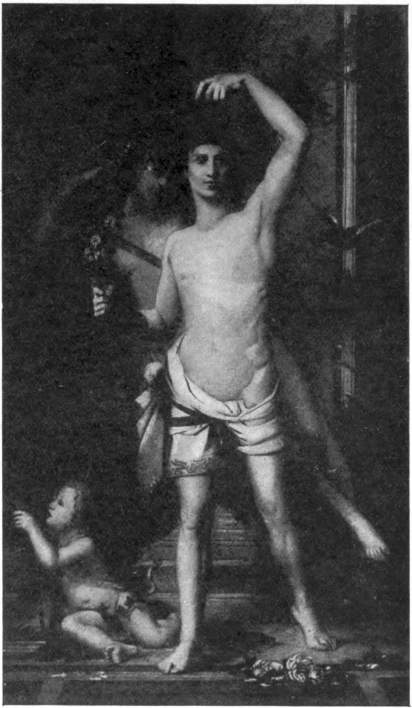 |
 | ||
| Baschet. | Gaz. des Beaux-Arts. | ||
| MOREAU. | THE YOUNG MAN AND DEATH. | MOREAU. | ORPHEUS. |
In his “Galatea” Moreau’s love of jewels and enamel finds its highest triumph. Galatea’s grotto is one large, glittering casket. Flowers made from the sun, and leaves from the stars, and branches of coral stretch forth their boughs and open their cups. And as the most brilliant jewel of all, there rests in the holy of holies the radiant form of the sleeping Galatea, a kind of Greek Susanna, watched by the staring, adamantine eye of Polyphemus.
And just as he bathes these Grecian forms in the dusk of a profound romantic melancholy, so in Moreau’s pictures the figures of the Bible are tinged with a shade of Indian Buddhism, a pantheistic mysticism which places them in a strange modern light. In his “David” he represents in a quiet and peaceful way the entry of a human soul into Nirvana. The aged king sits dreaming upon his gorgeous throne, and an angel watches in shining beauty beside this phantom, the flame of whose life is slowly sinking. A curious light falls upon him from the sky. The light of the evening horizon shines faint between the pillars, and the spectator feels that it is the end of a long day. His pictures of 1878 dealing with Salome, in their strange sentiment—suggestive of an opium vision—are like a paraphrase of Heine’s poem in Atta Troll. In a sombre hall supported by mighty pillars, through which coloured lamps and stupefying pastil-burners shed a blue and red light, sits Herod the king, half asleep with hasheesh, wrapped in silk, and motionless as a Hindu idol. His face is pale and gloomy, and his throne is like a crystal confessional chair, fashioned with all the riches of the world. Two women lean at the foot of a pillar. One of them touches the strings of a lute, and a small panther yawns near a vessel of incense. Upon the floor of variegated mosaics flowers lie strewn. Salome advances. Tripping upon her toes as 214 lightly as a figure in a dream, she begins to dance, holding a tremulous lotus-flower in her hand. A shining tiara is upon her head; her body is adorned with all the jewels which the dragons guard in the veins of the earth. Faster and faster and with a more voluptuous grace she twists and stretches her splendid limbs; but of a sudden she starts and presses her hand to her heart: she has seen the executioner as he smote the head of John from the body.—In the midst of an Oriental paradise, the body of the Baptist lies in the grass; the head has been set upon a charger, and Salome, like a bloodthirsty tigress, watches it with looks of ardent, famished love.
Different as they seem in technique, there are many points of contact between the visionary Gustave Moreau and Puvis de Chavannes, the original and fascinating creator of the decorative painting of the nineteenth century. Where one indulges in detail, the other resorts to simplification; where the former is opulent the latter is ascetic; and yet they are associated through inward sympathy.
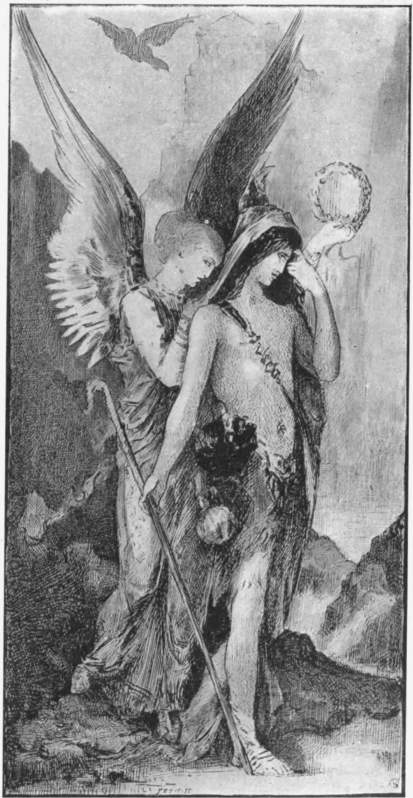 |
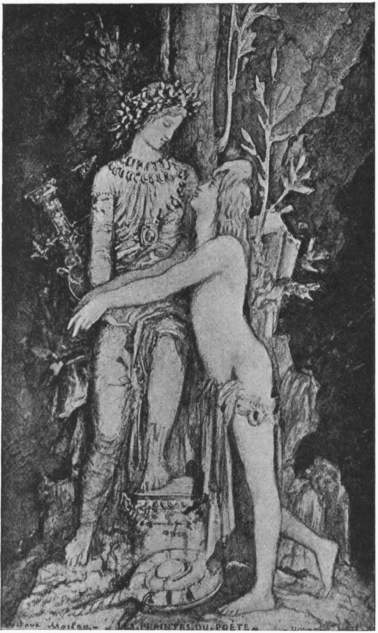 | ||
| Gaz. des Beaux-Arts. | Gaz. des Beaux-Arts. | ||
| MOREAU. | DESIGN FOR ENAMEL. | MOREAU. | THE PLAINT OF THE POET. |
Puvis de Chavannes is the Domenico Ghirlandajo of the nineteenth century. The most eminent mural works which have been achieved in France owe their existence to him. Wall-paintings from his hand may be found above the staircase of the museums of Amiens, Marseilles, and Lyons, in the Paris Panthéon and the new Sorbonne, in the town-halls of Poitiers and many other French towns—pictures which it is difficult to describe in detail, through the medium of pedestrian prose. The two works with which he opened the decorative series in the museum of Amiens in 1861 are entitled “Bellum” and “Concordia.” In the former warriors are riding over a monotonous plain. Two smoking pillars, the gloomy witnesses to sorrow and devastation, cast their dark shadows over the still fields, whilst here and there burning mills rise into the sombre sky like torches. In “Concordia,” the counterpart to this work, there are women plucking flowers, and naked youths urging on their horses amid a luxuriant grove of laurel. In the Paris Panthéon he painted, between 1876 and 1878, “The Girlhood of St. Geneviève.” 215 A laughing spring landscape, filled with the blitheness of May, spreads beneath the bright sky of the Isle de France. Calm figures move in it, men and women, children and greybeards. A bishop lays his hand upon the head of a young shepherdess; sailors are coming ashore from their barks. “The Grove sacred to the Arts and Muses” comes first in the decoration of the Lyons Museum. Upon one side is a thick forest, dark and profound, and upon the other the horizon is fringed by violet-blue hills and a large lake reflecting the bluish atmosphere; in the foreground are green meadows, where the flowers gleam like stars, and trees standing apart, oaks and firs, their strong, straight stems rising stiffly into the sky. At the foot of a pillared porch strange figures lie by the shore or stand erect amid the pale grass, one with her arm pointing upwards, another musing with her hand resting upon her chin, a third unrolling a parchment. Athletic youths are bringing flowers and winding garlands. The “Vision of Antiquity” and “Christian Inspiration” complete the series. The former of these pictures brings the spectator into Attica. Locked by a simple landscape of hills the blue sea is rippling, and bright islands rise from its bosom, while a clear sky sheds its full light from above. Trees and shrubs are growing here and there. A shepherd is playing upon the pan-pipes, goats are grazing, and five female figures, some of them nude, the others clothed, caress tame peacocks in the tall grass or lean against a parapet, breathing in the fresh, cool air. Farther back, at the foot of a height, is a young woman, holding herself erect like a statue, as she talks with a youth, whilst in the distance at the verge of the sea a spectral cavalcade, like that in Phidias’ frieze of the Parthenon, gallops swiftly by. In the counterpart, “Christian Inspiration,” a number of friars who are devoted to art are gathered together in the 216 portico of an abbey church. The walls are embellished with naïve frescoes in the style of the Siennese school. One of the monks who is working on the pictures has alighted from the ladder and regards the result of his toil with a critical air. Lilies are blooming in a vase upon the ground. Outside, beyond the cloister wall, the flush of evening sheds its parting light over a lonely landscape, whence dark cypresses rise into the air, straight as a lance. In the decoration of the Sorbonne the object was to suggest all the lofty purposes to which the place has been dedicated upon the wall of the great amphitheatre used for the solemn sessions of the faculty, and facing the statues of the founders. Puvis de Chavannes did this by displaying a throne in a sacred grove, a throne upon which a grave matron arrayed in sombre garments is sitting in meditation. This is the old Sorbonne. Two genii at her side bring palm-branches and crowns as offerings in honour of the famous minds of the past. Around are standing manifold figures arrayed in the costumes which were assigned to the arts and sciences in Florence at the time of Botticelli and Filippino Lippi. From the rock upon which they are set there bursts the living spring from which youth derives knowledge and new power. A thick wood divides this quiet haunt, consecrated to the Muses, from the rush and the petty trifles of life. In a painting entitled “Inter Artes et Naturam,” over the staircase of the museum of Rouen, artists musing over the ruins of mediæval buildings are seen lying in the midst of a Norman landscape, beneath apple-trees whose branches are weighed down by their burden of fruit; upon the other side of the picture there is a woman holding a child upon her knees, whilst another woman is trying to reach a bough laden with fruit, and a group of painters look on enchanted with the grace of her simple, harmonious movement.
Puvis de Chavannes is not a virtuoso in technique; for a Frenchman, indeed, he is almost clumsy, and is sure in very little of the work of his hand,—in fact, it is quite possible that a later age will not reckon him among the great painters. But what it can never forget is that after a 217 period of lengthy aberrations he restored decorative art in general to its proper vocation.
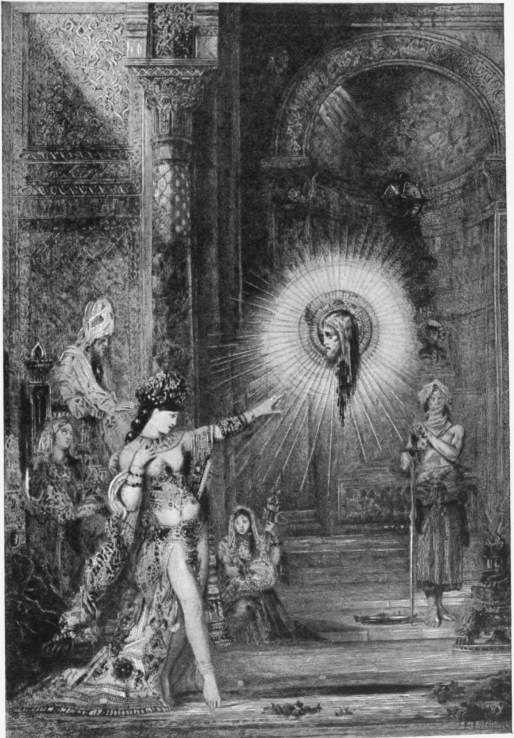 |
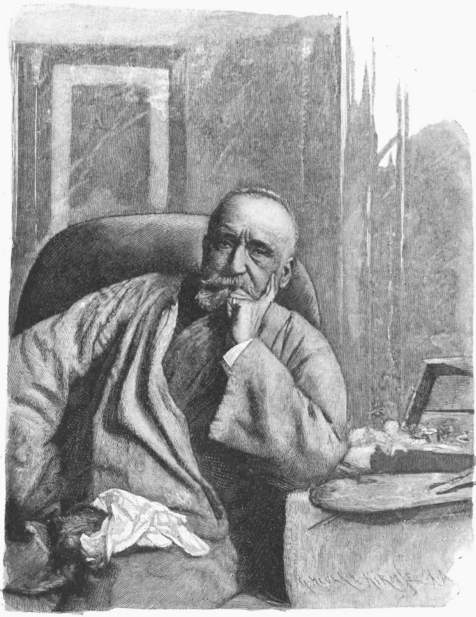 | ||
| L’Art. | Graphische Künste. | ||
| MOREAU. | THE APPARITION. | PIERRE PUVIS DE CHAVANNES. | |
Before his time what was good in the so-called monumental painting of the nineteenth century was usually not new, but borrowed from more fortunate ages, and what was new in it, the narrative element, was not good, or at least not in good taste. When Paolo Veronese produced his pictures in the Doge’s Palace or Giulio Romano his frescoes in the Sala dei Giganti in Mantua, neither of them thought of the great mission of instructing the people or of patriotic sentiments; they wanted to achieve an effect which should be pictorial, festal, and harmonious in feeling. The task of painters who were entrusted with the embellishment of the walls of a building was to waken dreams and strike chords of feeling, to summon a mood of solemnity, to delight the eye, to uplift the spirit. What they created was decorative music, filling the mansion with its august sound as the solemn notes of an organ roll through a church. Their pictures stood in need of no commentary, no exertion of the mind, no historical learning. But the painting which in the nineteenth century did duty upon official occasions and was encouraged by governments for the sake of its pedagogical efficiency was not permitted to content itself with this general range of sentiment; it had to lay on the colours more thickly, and to appeal to the understanding rather than to sentiment. Descriptive prose took the place of lyricism.
Puvis de Chavannes went back to the true principle of the old painters by renouncing any kind of didactic intention in his art. In the Panthéon of Paris, when the eye turns to the works of Puvis de 218 Chavannes after beholding all the admirable panels with which the recognised masters of the flowing line have illustrated the temple of St. Geneviève, when it turns from St. Louis, Clovis, Jeanne d’Arc, and Dionysius Sanctus to “The Girlhood of St. Geneviève,” it is as if one laid aside a prosy history of the world to read the Eclogues of Virgil.
In the one case there are archæological lectures, stage scenery, and histrionic art; in the other, simple poetry and lyrical magic, a marvellous evocation from the distant past of that atmosphere of legend which banishes the commonplace. His art would express nothing, would represent nothing; it would only charm and attune the spirit, like music heard faintly from the distance. His figures perform no significant actions; nor are any learned attributes employed in their characterisation, such as were introduced in Greece and at the Renaissance. He does not paint Mars, Vulcan, and Minerva, but war, work, and peace. In translating the word bellum into the language of painting in the Museum of Amiens he did not need academical Bellonas, nor sword-cuts, nor knightly suits of armour, nor fluttering standards. A group of mourning and stricken women, warlike horsemen, and a simple landscape sufficed him to conjure up the drama of war in all its terrible majesty. And he is as far from gross material heaviness as from academical sterility. The reapers toiling in his painting entitled “Summer” are modern in their movements and in their whole appearance, and yet they belong to no special time and seem to have been wafted into a world beyond; they are beings who might have lived yesterday, or, for the matter of that, a thousand years ago. The whole of existence seems in Puvis de Chavannes like a day without beginning or end, a day of Paradise, unchangeable and eternal. And very simple means sufficed him to attain this transcendental effect: like Millet, he generalises what is individual, and tempers what is presented in nature; antique nudity is associated in an unforced manner with modern costume; a designed simplicity, 219 which has nothing of the academical painting of the nude, is expressed in the handling of form. Even his landscape he constructs upon its elementary forms, and by means of its essential, expressive features. But by a certain concordance of lines, by a distinct rhythm of form, he compasses a sentiment which is grave and solemn or idyllic.
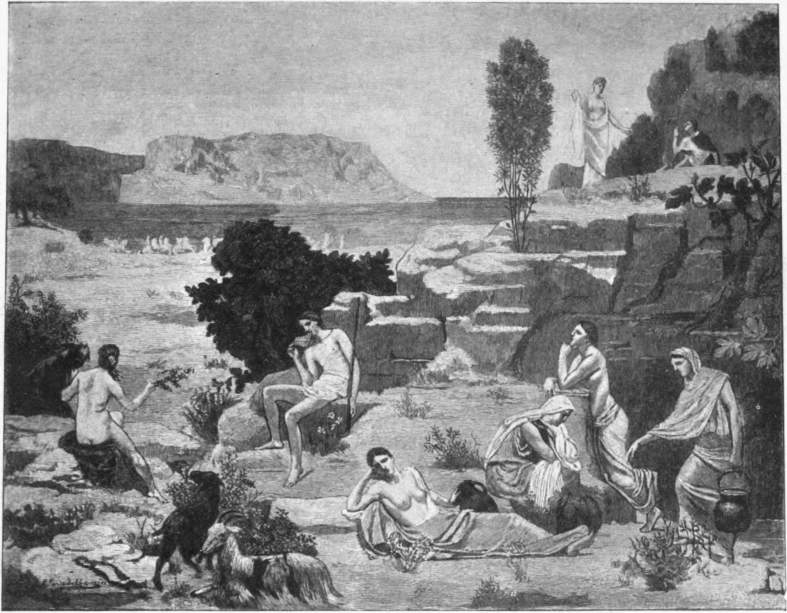 | |
| PUVIS DE CHAVANNES. | A VISION OF ANTIQUITY. |
| (By permission of the Artist.) | |
The Quattrocentisti, especially Ghirlandajo, were his models in this epical simplicity, and beside Baudry, the deft and spirited decorator of the most modernised High Renaissance style, he has the effect of a primitive artist risen from the grave. His pictures have an archaic bloom—something sacerdotal, if you will, something seraphic and holy. Often one fancies that one recognises the influence of old tapestries, to say nothing of Fra Angelico, but one is at a loss to give the model copied. And what places him like Moreau in sharp opposition to the old masters is that, instead of their sunny, smiling blitheness, he too is under the sway of that heavy melancholy spirit which the close of the nineteenth century first brought into the world.
When he, a countryman of Flandrin and Chenavard, began his career under Couture over half a century ago, the world did not understand his pictures. People blamed the poverty of his palette, asserted that he was too simple and restricted in his methods of colouring, and he was called a Lenten 220 painter, un peintre de carême, whose dull eye noted nothing in nature except ungainly lines and uniformly grey tones. Women were especially unfavourable to him, taking his lean figures as a personal insult to themselves. Moreover, the calm and immobility of his figures were censured, and when he exhibited his earliest pictures in 1854, at the same time as those of Courbet, he was called un fou tranquille, just as the latter was christened un fou furieux. In later years it was precisely through these two qualities, his grandiose quietude and his “anæmic” painting, that he brought the world beneath his spell, and diverted French art into a new course.
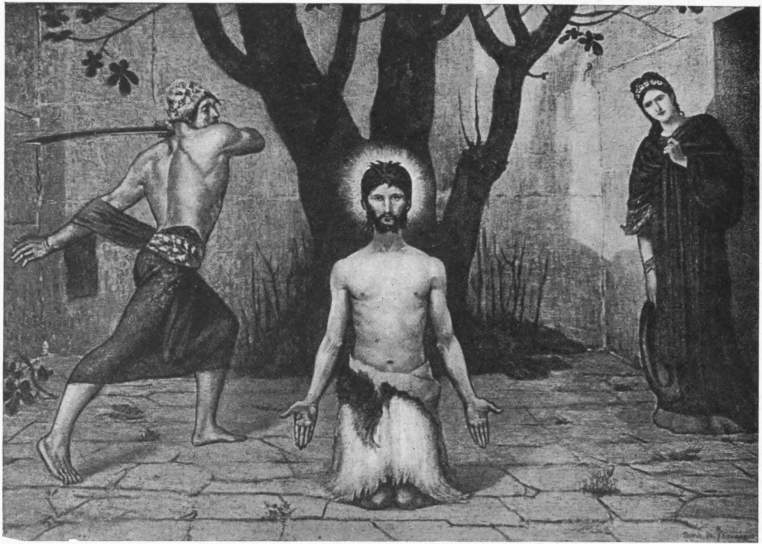 | |
| PUVIS DE CHAVANNES. | Baschet. THE BEHEADING OF JOHN THE BAPTIST. |
| (By permission of the Artist.) | |
As his landscapes know nothing of agitated clouds, nor abruptness nor the strife of the elements, so his figures avoid all oratorical vehemence. They are eternally young, free from brutal passions, lost in oblivion. Let him conjure up old Hellas or the quiet life of the cloister, over figures and landscapes there always rests a tender sentiment of consecration and dreamy peace; no violent gesture and no loud tone disturb that harmony of feeling by any vehement action.
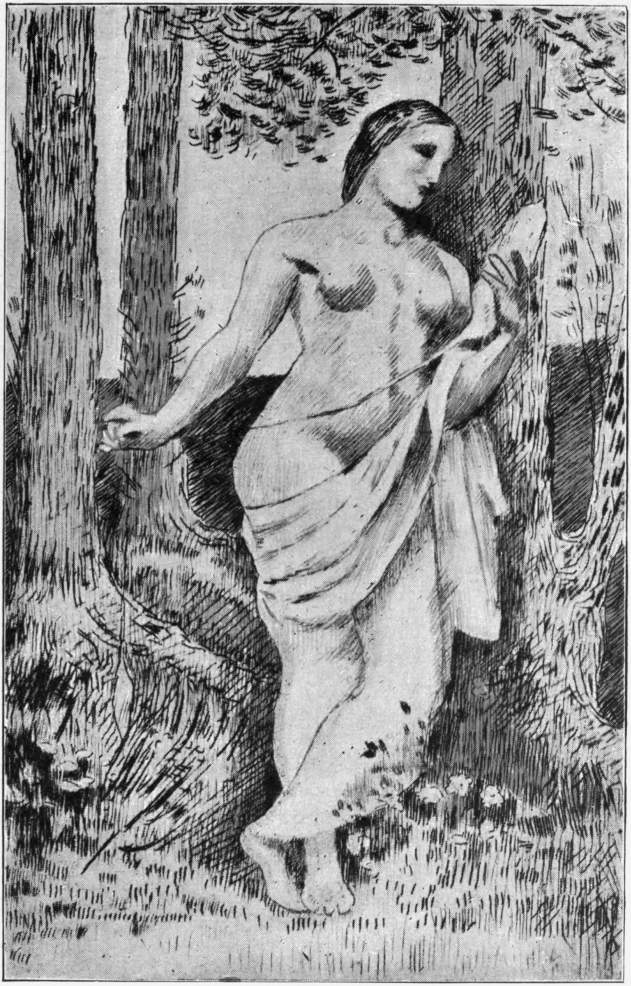 | |
| PUVIS DE CHAVANNES. | THE THREADSPINNER. |
| (By permission of M. Durand-Ruel, the owner of the picture.) | |
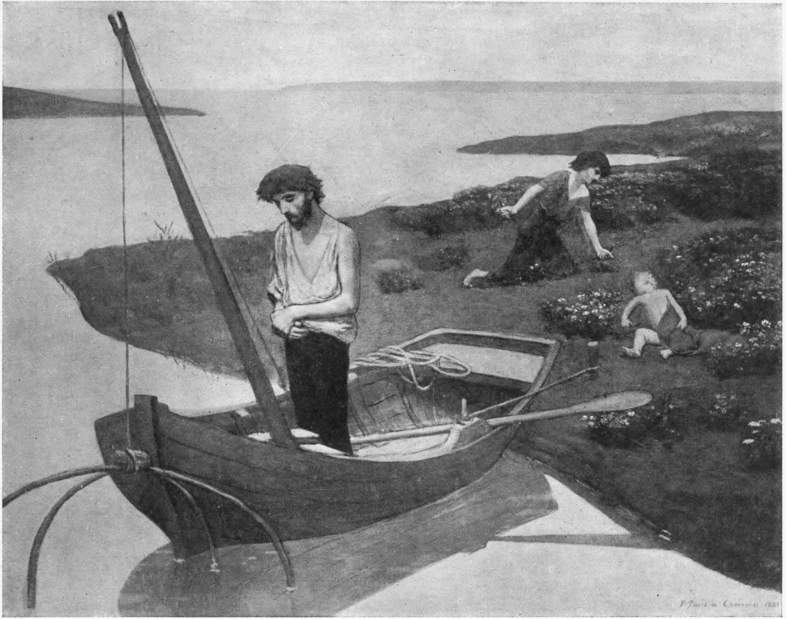 | |
| Neurdein frères, photo. | |
| PUVIS DE CHAVANNES. | THE POOR FISHERMAN. |
Nor does the colour admit any discord in the large harmony. It is exceedingly soft and light, although subdued; it has that faint, deadened indecisiveness to be seen in faded tapestries or vanishing frescoes. Tender and delicate in its chalky grey unity, which banishes reality and creates a world of dreams, it is spread around the shadowy figures. It is impossible to imagine his pictures without this light so pure and yet veiled, this silvery, transparent air, impregnated with the breath of the Divine, as Plato would say; it is impossible to imagine them without the delicate tones of these pale green, pale rose-coloured, and pale violet dresses, which are as delicate as fading flowers, and without this flesh-tint, which lends a phantomlike and unearthly appearance to his figures. It is all like a melody pitched in the high, finely touched, and tremulous tones of a violin; it invites a mood which is at once blithe and sentimental, happy and sad, banishes all earthly things into oblivion, and carries one into a distant, peaceful, and holy world.
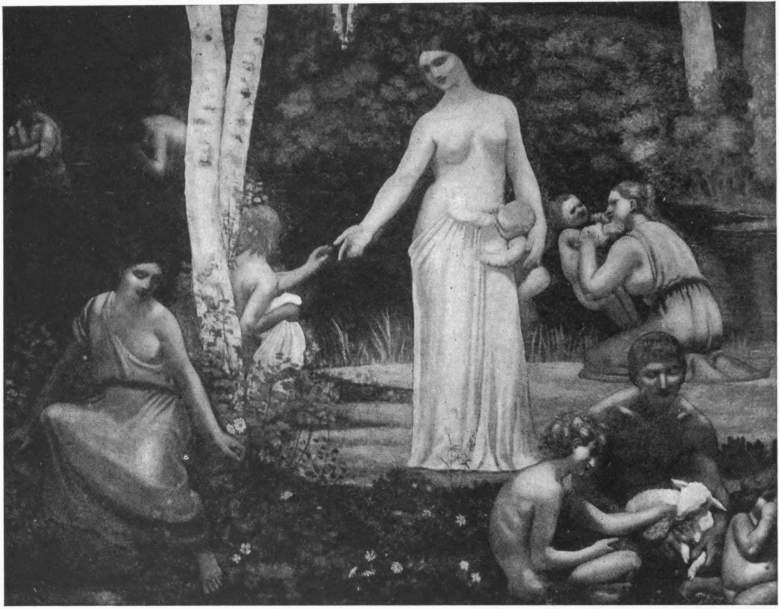 | |
| Levy et ses Fils, photo. | |
| PUVIS DE CHAVANNES. | SUMMER. |
It was not long before the doctrine of the two souls in Faust was exemplified in Germany also: from the fertile manure of Naturalism there sprang the blue flower of a new Romanticism. In Germany there had once lived Albrecht Dürer, the greatest and most profound painter-poet of all time; and there, too, even in an unpropitious age that genial visionary Moritz Schwind succeeded in flourishing. When the period of eclectic imitation had been overcome by Naturalism, was it not fitting that artists should once more attempt to embody the world of dreams beside that of actual existence, and beside tangible reality to give shape to the unearthly foreboding which fills the human heart with the visions and the cravings of fancy? In that 225 age of hope arose the cult of Boecklin, and Germany began to honour in him who had been so long blasphemed the founder of a new and ardently desired art.
Burne-Jones, Puvis de Chavannes, Gustave Moreau, and Arnold Boecklin make up the four-leaved clover of modern Idealism. To future generations they will bear witness to the sentiment of Europe at the close of the nineteenth century. All four are more or less of the same age; they all four began their work in the beginning of the fifties; and they were all different from their contemporaries and from those who had gone before them. They embodied the spirit of the future. Boecklin had gone through a process of change as little as the others. His spirit was so rich that it comprised a century in itself, and leads us now towards the century to come. He was the contemporary of Schwind, he is our own contemporary, and he will be the contemporary of those who come after us. And it were as impossible to derive his art from that of any previous movement as to explain how he, our greatest visionary, came to be born in Basle, the most prosaic town in Europe.
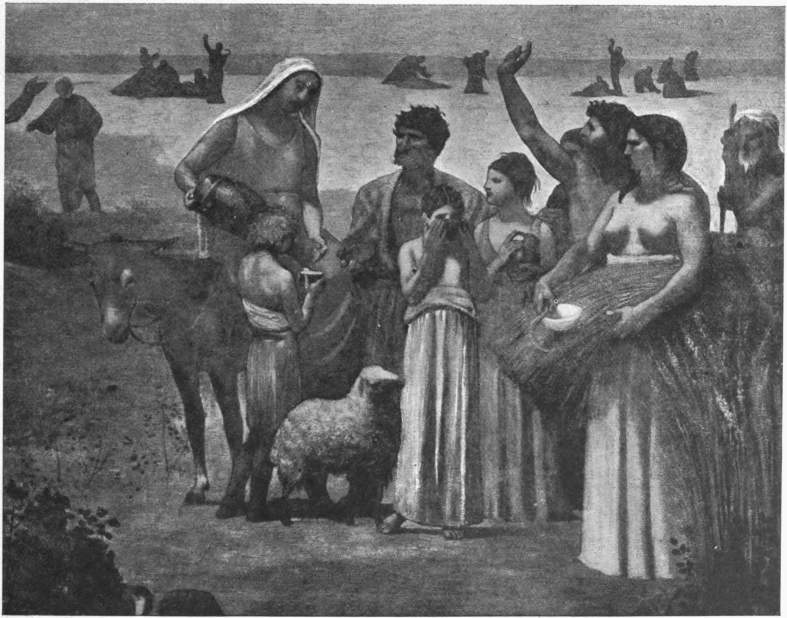 | |
| Levy et ses Fils, photo. | |
| PUVIS DE CHAVANNES. | AUTUMN. |
His father was a merchant there, and he was born in the year 1827. In 1846 he went to Schirmer in Düsseldorf, and upon Schirmer’s advice repaired 226 to Brussels, where he copied the old Dutch masters in the gallery. By the sale of some of his works he acquired the means of travelling to Paris. He passed through the days of the Revolution of June in 1848, studied the pictures in the Louvre, and returned home after a brief stay to perform his military duties. In the March of 1850, when he was three-and-twenty, he went to Rome, where he entered the circle of Anselm Feuerbach; and in 1853 he married a Roman lady. In the following year he produced the decorative pictures in which he represented the relations of man to fire; these had been ordered for the house of a certain Consul Wedekind in Hanover, but were sent back as being “bizarre.” In 1856 he betook himself—rather hard up for money—to Munich, where he exhibited in the Art Union “The Great Pan,” which was bought by the Pinakothek. Paul Heyse was the medium of his making the acquaintance of Schack. And in 1858 he was appointed a teacher at the Academy of Weimar, by the influence of Lenbach and Begas. During this time he produced “Pan startling a Goat-herd” in the Schack Gallery, and “Diana Hunting.” After three years he was again in Rome, and painted there “The Old Roman Tavern,” “The Shepherd’s Plaint of Love,” and “The Villa by the Sea.” In 1866 he went to Basle to complete the frescoes over the staircase of the museum, and in 1871 he was in Munich, where “The Idyll of the Sea” was exhibited amongst other things. In 1876 he settled in Florence, in 1886 at Zürich. From 1895 until the day of his death, January 16, 1901, he lived like a patriarch of art in his country house on the ridge of Fiesole.
Any one who would interpret a theory based upon the idea that an artist is the result of influences might, while he is about it, speak of Boecklin’s apprentice period in Düsseldorf and Schirmer’s biblical landscapes. That “harmonious blending of figures with landscape,” which is the leading note in Boecklin’s work, was of course from the days of Claude Lorraine and Poussin the essence of the so-called historical landscape which found its principal representatives at a later period in Koch, Preller, Rottmann, Lessing, and Schirmer. Yet Boecklin is not the disciple of these masters, but stands at the very opposite pole of art. The art of all these men was merely a species of historical painting. Old Koch read the Bible, Æschylus, Ossian, Dante, and Shakespeare; found in them such scenes as Noah’s thank-offering, Macbeth and the witches, or Fingal’s battle with the spirit of Loda; and sought amid the Sabine hills, in Olevano and Subiaco, for sites where these incidents might have taken place. Preller made the Odyssey the basis of his artistic creation, chose out of it moments where the scene might be laid in some landscape, and found in Rügen, Norway, Sorrento, and the coast of Capri the elements of nature necessary to his epic. Rottmann worked upon hexameters composed by King Ludwig, and adhered in the views he painted to the historical memories attached to the towns of Italy. Lessing sought inspiration in Sir Walter Scott, for whose monks and nuns he devised an appropriately sombre and mysterious background. Schirmer illustrated the Books of Moses by placing 227 the figures in Schnorr’s Picture Bible in Preller’s Odyssean landscape. Whether they were Classicists appealing to the eye by the architecture of form, or Romanticists addressing the spirit by the “mood” in their landscapes, it was common to all these painters that they set out from a literary or historical subject. They gave an exact interpretation of the actions prescribed by their authors, surrounding the figures with fictitious landscapes, corresponding in general conception to one’s notion of the surroundings of heroes, patriarchs, or hermits. Their pictures are historical incidents with a stage-setting of landscape.
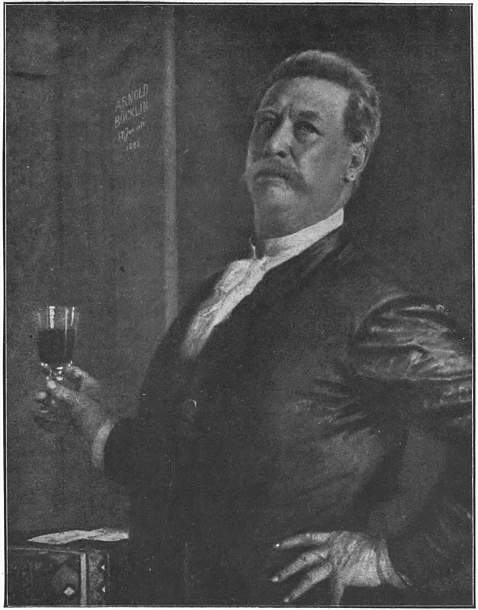 |
| Hanfstaengl. |
| ARNOLD BOECKLIN. PORTRAIT OF HIMSELF. |
In Boecklin all this is reversed. Landscape painter he is in his very essence, and he is, moreover, the greatest landscape painter of the nineteenth century, at whose side even the Fontainebleau group seem one-sided specialists. Every one of the latter had a peculiar type of landscape, and a special hour in the day which appealed to his feelings more distinctly than any other. One loved spring and dewy morning, another the clear, cold day, another the threatening majesty of the storm, the flashing effects of sportive sunbeams, or the evening after sunset, when colours fade from view. But Boecklin is as inexhaustible as infinite nature herself. In one place he celebrates the festival of spring with its burden of beauty: it is ushered in by snowdrops, and greeted with joy by the veined cups of the crocus; yellow primroses and blue violets merrily nod their heads, and a hundred tiny mountain streams leap precipitately into the valley to announce the coming of spring. In another, nature shines and blooms and chimes, and breathes her balm in all the colours of summer. Tulips freaked with purple rise at the side of paths; flowers in rows of blue, white, and yellow—hyacinths, daisies, gentians, anemones, and snapdragon—fill the sward in hordes; and down in the valley blow the narcissus in dazzling myriads, loading the air with an overpowering perfume. But, beside such lovely idylls, he has painted with puissant sublimity 228 as many complaining elegies and tempestuous tragedies. Here, the sombre autumnal landscapes, with their tall black cypresses, are lashed by the rain and the howling storm. There, lonely islands or grave, half-ruined towers, tangled with creepers, rise dreamily from a lake, mournfully hearkening to the repining murmur of the waves; and there, in the midst of a narrow rocky glen, a rotten bridge hangs over a fearful abyss. Or a raging storm, beneath the might of which the forests bow, blusters round a wild mountain land which rises from a blue-black lake. Boecklin has painted everything: the graceful and heroic, the solitude and the waste, the solemnly sublime and the darkly tragic, passionate agitation and demoniacal fancy, the strife of foaming waves and the eternal rest of rigid masses of rock, the wild uproar of the sky and the still peace of flowery fields. The compass of his moods is as much greater than that of the French Classicists as Italy is greater than Fontainebleau.
For Italy is Boecklin’s home as a landscape painter, and the moods of nature there are more in number than Poussin ever painted. Grave and sad and grandiose is the Roman Campagna, with the ruins of the street of sepulchres, and the grey and black herds of cattle looking mournfully over the brown pastures. Hidden like the Sleeping Beauty lie the Roman villas in his pictures, in their sad combination of splendour and decay, of life and death, of youth and age. Behind weather-beaten grotto-wells and dark green nooks of yew, white busts and statues gleam like phantoms. From lofty terraces the water in decaying aqueducts trickles down with a monotonous murmur into still pools, where bracken and withered shrubs overgrown with ivy are reflected. Huge cypresses of the growth of centuries stand gravely in the air, tossing their heads mournfully when the wind blows. Then at a bound we are at Tivoli, and the whole scenery is changed. Great fantastic rocks rise straight into the air, luxuriantly mantled by ivy and parasitic growths; trees and shrubs take root in the clefts; the floods of the Anio plunge headforemost into the depths with a roar of sound, like a legion of demons thunder-stricken by some higher power. Then comes Naples, with its glory of flowers and its moods of evening glowing in deep ruby. Blue creepers twine round the balustrades of castles; hedges of monthly roses veil the roads, and oranges grow large amid the dark foliage. Farther away he paints the Homeric world of Sicily, with its crags caressed or storm-beaten by the wave, its blue grottoes, and its deep glowing splendours of changing colour. Or he represents the inland landscape of Florence with its soft graceful lines of hill, its fields and flowers, buds and blossoms, and its numbers of white dreaming villas hidden amid rosy oleanders and standing against the blue sky with a brightness almost dazzling.
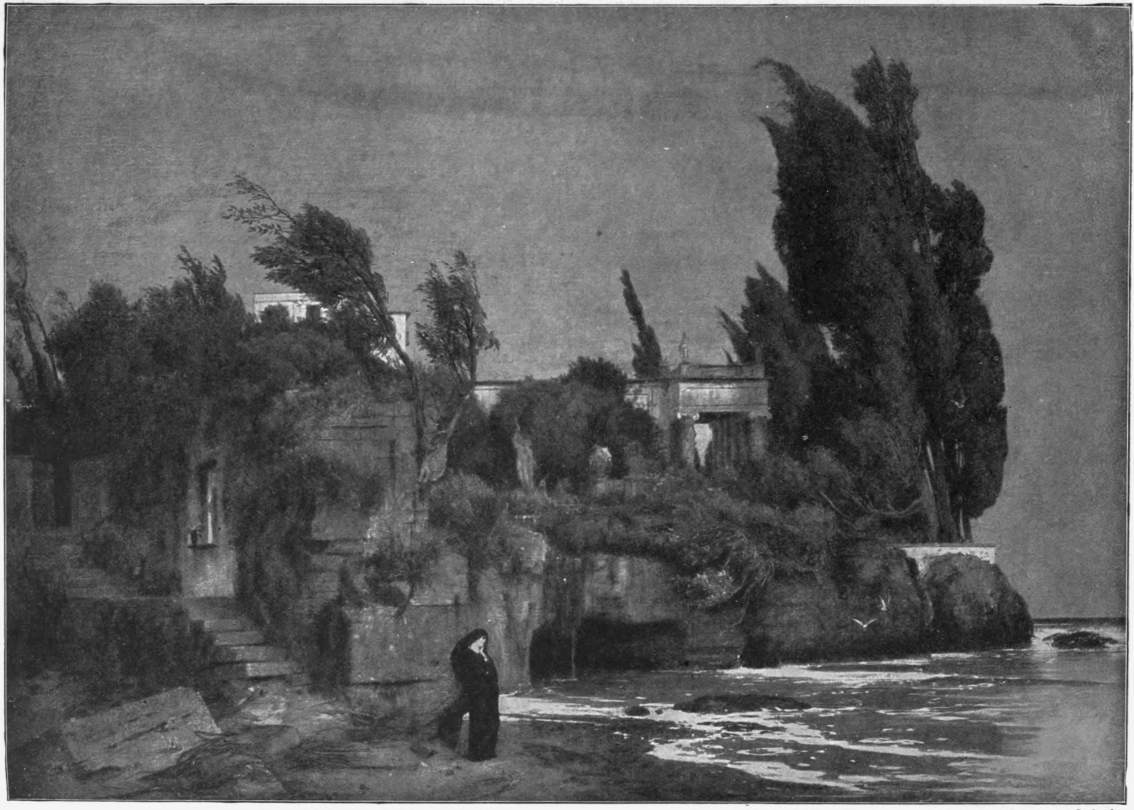 | |
| Seemann, Leipzig. | |
| BOECKLIN. | A VILLA BY THE SEA. |
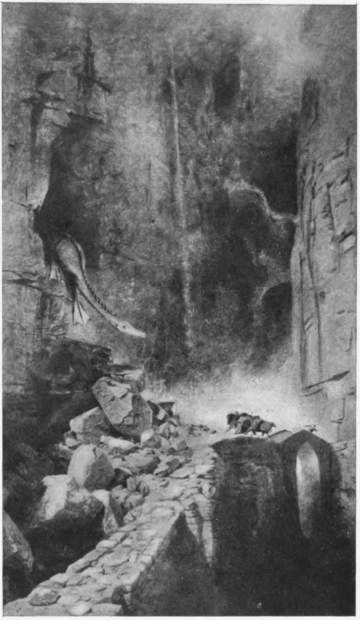 |
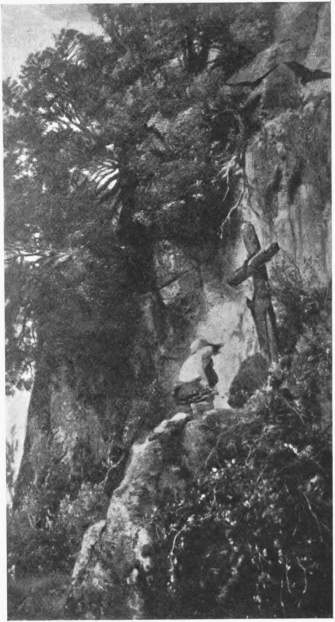 | ||
| Albert, Munich. | Albert, Munich. | ||
| BOECKLIN. | A ROCKY CHASM. | BOECKLIN. | THE PENITENT. |
Boecklin has no more rendered an exact portrait of the scenery of Italy than the Classic masters of France sought to represent in a photographic way districts in the forest of Fontainebleau. His whole life, like theirs, was a renewed and perpetual wooing of nature. As a boy he looked down from his attic in Basle upon the heaving waters of the Rhine. When he was in Rome, in 1850, he wandered daily in the Campagna to feast his eyes upon its grave lines and colours. After a few years in Weimar he gave up his post to gather fresh impressions in Italy. And the moods with which he was inspired by nature and the phenomena he observed were stored in his mind as though in a great emporium. Then his imagination went through another stage. That “organic union of figures and landscape” which the representatives of “heroic landscape” had surmised and endeavoured to attain by a reasoned method through the illustration of passages in poetry took place in Boecklin by the force of intuitive conception. The mood excited in him by a landscape is translated into an intuition of life.
In many pictures, particularly those of his earlier period, the ground-tone given by the landscape finds merely a faint echo in small accessory figures. In such pictures he stands more or less on a level with Dreber, that master who died in Rome in 1875, and was forgotten in the history of German art more swiftly than ought to have been the case. Franz Dreber was not one of those Classicists dispersed over the face of Europe, men who were content with setting heroic actions in the midst of noble landscapes in the fashion of Preller; on the contrary, he was the lyricist of this movement, the first man who did not touch the epical material of old myths in a manner that was merely scholarly and illustrative, but developed his picture from the original note of landscape. In his pictures nature laughs with those who are glad, mourns with those who weep, sheds her light upon the joyful, and envelops tortured spirits in storm and the terror of thunder. If the golden age is to be represented, the scene is a soft summer landscape, where everything breathes peace and innocence and bliss. And the life of those who inhabit this happy region runs by in blissful peace also. Fair women and children rest upon the meadow, and gather fruits and pluck roses. If he paints Ulysses upon the shore of the sea, looking with yearning towards his distant home, a dull, sultry haze of noon broods over the district, wide and grey like the hero’s yearning. A spring landscape of sunny blitheness, with 232 butterflies sipping at the blossoms of the trees and sunbeams sportively dallying on the sea, are the surroundings of the picture where Psyche is crowned by Eros. And if Prometheus is represented chained to the rock and striving to burst his fetters, all nature fights the fight of the Titan. Lurid clouds move swiftly through the sky, ghostly flashes of lightning quiver, and a wild tempest rakes the mountains.
In Boecklin’s earlier pictures the accessory figures are placed in close relation with the landscape in a manner entirely similar. The mysterious keynote of sentiment in nature gives the theme of the scene represented. In the picture called “The Penitent,” in the Schack Gallery, a hermit is kneeling half-naked before the cross of the Saviour upon the slope of a steep mountain. Troops of ravens fly screaming above his head, and a strip of blue sky shines with an unearthly aspect between the trees, which are bent into wild shapes. The character of the scene is terribly severe, and severe and heavy is the misery in the heart of the man chastising himself with the scourge in his hand as he kneels there in prayer. A deep melancholy rests over the picture named “The Villa by the Sea.” The failing waves break gently on the shore with a mournful whisper, the wind utters its complaint blowing through the cypresses, and a few sunbeams wander coyly over the deep grey of the sky. At the socle of a niche a young woman dressed in black stands, and, with her head resting upon her hand, looks out of deeply veiled eyes over the moving tide. In “The Spring of Love” the landscape vibrates in lyrically soft and flattering chords. The budding splendour of blossoms covers the trees luxuriantly, and a rivulet ripples over the laughing grassy balk. A young man touches the strings of a lyre and sings; and, joining in his song, a maiden stands beside him leaning against a bush laden with blossom. In “The Walk to Emmaus” the ground-tone is given by a grave evening landscape. The storm ruffles the tops of the great trees, and chases across the sky the heavy clouds, over which strange evening lights are flitting. All nature trembles in shivering apprehension. “Abide with us: for it is toward evening, and the day is far spent.”
But Boecklin’s great creations reach a higher level. Having begun by 233 extending the lyrical mood of a landscape to his figures, he finally succeeded in peopling nature with beings which seem the final condensation of the life of nature itself, the tangible embodiment of that spirit of nature whose cosmic action in the water, the earth, and the air, he had glorified in one of his youthful works, the frescoes of the Basle Museum. In such pictures he has no forerunners whatever in the more recent history of art. His principle of creation rests, it might be said, upon the same overwhelming feeling for nature which brought forth the figures of Greek myth. When the ancient Greek stood before a waterfall he gave human form to what he saw. His eye beheld the outlines of beautiful nude women, nymphs of the spot, in the descending volume of the cascade; its foam was their fluttering hair, and in the rippling of the water and spattering froth he heard their bold splashing and their laughter. The elemental sway of nature, the secret interweaving of her forces took shape in plastic forms—
| “Alles wies den eingeweihten Blicken, Alles eines Gottes Spur ... Diese Höhen füllten Oreaden, Eine Dryas lebt in jedem Baum, Aus dem Urnen lieblicher Najaden Sprang der Ströme Silberschaum. Jener Lorbeer wand sich einst um Hilfe, Tantals Tochter schweigt in diesem Stein, Syrinx Klage tönt aus jenem Schilfe, Philomelas Schmerz aus diesem Hain.” |
The beings which live in Boecklin’s pictures owe their origin to a similar action of the spirit. He hears trees, rivers, mountains, and universal nature whisper as with human speech. Every flower, every bush, every flame, the rocks, the waves, and the meadows, dead and without feeling as they are to the ordinary eye, have to his mind a vivid existence of their own; and in the same way the old poet conceived the lightning as a fiery bird and the clouds as the flocks of heaven. The stones have a voice, white walls lengthen like huge phantoms, the bright lights of the houses upon a mountain declivity at night change into the great eyes with which the spirit of the fell glares fixedly down; legions of strange beings circle and whir round in the fantastic region. In his imagination every impression of nature condenses itself into figures that may be seen. As a dragon issues from his lair to terrify travellers in the gloom of a mountain ravine, and as the avenging Furies rise in the waste before a murderer, so in the still brooding noon, when a shrill tone is heard suddenly and without a cause, the Grecian Pan lives once again for Boecklin—Pan, who startles the goat-herd from his dream by an eerie shout, and then whinnies in mockery at the terrified fugitive. The cool, wayward splashing element of water takes shape as a graceful nymph, shrouded in a transparent water-blue veil, leaning upon her welling urn as she listens dreamily to the song of a bird. The fine mists which rise from the fountain-head become embodied as a row of merry children, whose vaporous figures float 234 hazily through the shining clouds of spring. The secret voices that live amid the silence of the wood press round him, and the phantom born of the excited senses becomes a ghostly unicorn advancing with noiseless step, and bearing upon his back a maiden of legendary story dressed in a white garment. In the thundercloud lying over the broad summit of a mountain and abundant in blessing rain he sees the huge body of the giant Prometheus, who brought fire from heaven and lies fettered to the mountain top, spreading over the landscape like a cloud. The form of Death stumbling past cloven trees in rain and tempest, as he rides his pale horse, appears to him in a waste and chill autumnal region, where stands a ruined castle in lurid illumination. A sacred grove, lying in insular seclusion and fringed with venerable old trees that rise straight into the air, rustling as they bend their heads towards each other, is peopled, as at a word of enchantment, with grave priestly figures robed in white, which approach in solemn procession and fling themselves down in prayer before the sacrificial fire. The lonely waste of the sea is not brought home to him with sufficient force by a wide floor of waves, with gulls indolently flying beneath a low and leaden sky; so he paints a flat crag emerging from the waves, and upon its crest, over which the billows sweep, the shy dwellers of the sea bathe in the light. Naiads and Tritons assembled for a gamesome ride over the sea typify the sportive hide-and-seek of the waves. Yet there is nothing forced, nothing merely ingenious, nothing literary in these inventions. The figures are not placed in nature with deliberate calculation: they are an embodied mood of nature; they are children of the landscape, and no mere accessories.
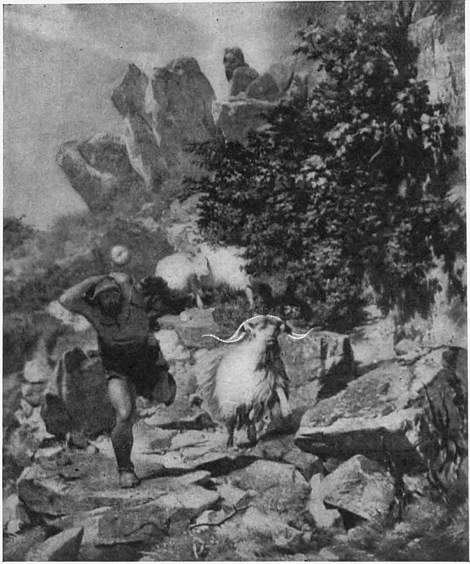 |
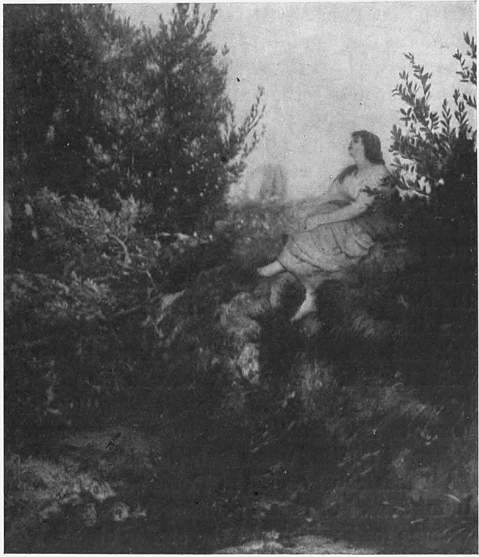 | ||
| Albert, Munich. | Albert, Munich. | ||
| BOECKLIN. | PAN STARTLING A GOAT-HERD. | BOECKLIN. | THE HERD. |
Boecklin’s power of creating types in embodying these beings of his imagination is a thing unheard of in the whole history of art. He has represented his Centaurs and Satyrs, and Fauns and Sirens and Cupids, so vividly and impressively that they have become ideas as currently acceptable as if they were simple incomposite beings. He has seen the awfulness of the sea at moments 235 when the secret beings of the deep emerge, and he allows a glimpse into the fabulous reality of their heretofore unexplored existence. For all beings which hover swarming in the atmosphere around have their dwelling in the trees or their haunts in rocky deserts, he has found new and convincing figures. Everything which was created in this field before his time—the works of Dürer, Mantegna, and Salvator Rosa not excepted—was an adroit sport with forms already established by the Greeks, and a transposition of Greek statues into a pictorial medium. With Boecklin, who instead of illustrating mythology himself creates it, a new power of inventing myths was introduced. His creations are not the distant issue of nature, but corporeal beings, full of ebullient energy, individualised through and through, and stout, lusty, and natural; and in creating them he has been even more consistent than the Greeks. In their work there is something inorganic in the combination of a horse’s body with the head of Zeus or Laocoön grafted upon it. But in the presence of Boecklin’s Centaurs heaving great boulders around them and biting and worrying each other’s manes, the spectator has really the feeling which prompts him to exclaim, “Every inch a steed!” In him the nature of the sea is expressed through his cold, slimy women with the dripping hair clinging to their heads far more powerfully than it was by the sea-gods of Greece. How merciless is the look in their cold, black, soulless eyes! They are as terrible as the destroying sea that yesterday in its bellowing fury engulfed a hundred human creatures despairing in the anguish of death, and to-day stretches still and joyous in its blue infinity and its callous oblivion of all the evils it has wrought.
And only a slight alteration in the truths of nature has sufficed him for the creation of such chimerical beings. As a landscape painter he stands with all his fibres rooted in the earth, although he seems quite alienated from this world of ours, and his fabulous creatures make the same convincing impression because they have been created with all the inner logical congruity 236 of nature, and delineated under close relationship to actual fact with the same numerous details as the real animals of the earth. For his Tritons, Sirens, and Mermaids, with their awkward bodies covered with bristly hair and their prominent eyes, he may have made studies from seals and walruses. As they stretch themselves upon a rocky coast, fondling and playing with their young, they have the look of sea-cows in human form, though, like men, they have around them all manner of beasts of prey and domestic pets which they caress,—in one place a sea-serpent, in another a seal. His obese and short-winded Tritons, with shining red faces and flaxen hair dripping with moisture, are good-humoured old gentlemen with a quantity of warm blood in their veins, who love and laugh and drink new wine. His Fauns may be met with amongst the shepherds of the Campagna, swarthy strapping fellows dressed in goat-skins after the fashion of Pan—lads with glowing eyes and two rows of white teeth gleaming like ivory. It is chiefly the colour lavished upon them which turns them into children of an unearthly world, where other suns are shining and other stars.
In the matter of colour also the endeavours of Romanticists of the nineteenth century reach a climax in Boecklin. When Schwind and his comrades set themselves to represent the romantic world of fairyland an interdict was still laid upon colour, and it was lightly washed over the drawing, which counted as the thing of prime importance. But Boecklin was the first Romanticist in Germany to reveal the marvellous power in colour for rendering moods of feeling and its inner depth of musical sentiment. Even in those years when the brown tone of the galleries prevailed everywhere, colour was allowed in his pictures to have its own independent existence, apart from its office of being a merely subordinate characteristic of form. For him green was thoroughly green, blue was divinely blue, and red was jubilantly red. At the very time when Richard Wagner lured the colours of sound from music, with a glow and light such as no master had kindled before, Boecklin’s symphonies of colour streamed forth like a crashing orchestra. The whole scale, from the most sombre depth to the most chromatic light, was at his command. In his pictures of spring the colour laughs, rejoices, and exults. In “The Isle of the Dead” it seems as though a veil of crape were spread over the sea, the sky, and the trees. And since that time Boecklin has grown even greater. His splendid sea-green, his transparent blue sky, his sunset flush tinged with violet haze, his yellow-brown rocks, his gleaming red sea-mosses, and the white bodies of his girls are always arranged in new glowing, sensuous harmonies. Many of his pictures have such an ensnaring brilliancy that the eye is never weary of feasting upon their floating splendour.
A master who died in Rome some nineteen years ago might have been in the province of mural painting for German art what Puvis de Chavannes has become for French. In the earlier histories of art his name is not mentioned. Seldom alluded to in life, dead as a German painter ten years before his death, he was summoned from the grave by the enthusiasm of a friend who was a refined connoisseur four years after the earth had closed over him. Such was Hans von Marées’ destiny as an artist.
 | |
| BOECKLIN. | VENUS DESPATCHING CUPID. |
Marées was born in Elberfeld in 1837. In beginning his studies he had first betaken himself to Berlin, and then went for eight years to Munich, where he paid his tribute to the historical tendency by a “Death of Schill.” But in 1864 he migrated to Rome, where he secluded himself with a few pupils, and passed his time in working and teaching. Only once did he receive an order. He was entrusted in 1873 with the execution of some mural paintings in the library of the Zoological Museum in Naples, and lamented afterwards that he had not received the commission in riper years. When he had sufficient confidence in himself to execute such tasks he had no similar opportunity, and thus he lost the capacity for the rapid completion of a work. He began to doubt his own powers, sent no more pictures to any exhibition, and when he died in the summer of 1887, at the age of fifty, his funeral was that of a man almost unknown. It was only when his best works were brought together at the annual exhibition of 1891 at Munich that he became known in wider circles, and these pictures, now preserved in the Castle of Schleissheim, will show to future years who Hans von Marées was, and what he aimed at.
“An artist rarely confines himself to what he has the power of doing,” said Goethe once to Eckermann; “most artists want to do more than they can, and are only too ready to go beyond the limits which nature has set to their talent.” Setting out from this tenet, there would be little cause for rescuing Marées from oblivion. Some portraits and a few drawings are his only performances which satisfy the demands of the studio—the portraits being large in conception and fine in taste, the drawings sketched with a swifter and surer hand. His large works have neither in drawing nor colour any one of those advantages which are expected in a good picture; they are sometimes incomplete, sometimes tortured, and sometimes positively childish. “He is ambitious, but he achieves nothing,” was the verdict passed upon him in Rome. Upon principle Marées was an opponent of all painting from the model. He scoffed at those who would only reproduce existing fact, and thus, in a certain sense, reduplicate nature, according to Goethe’s saying: “If I paint my mistress’s pug true to nature, I have two pugs, but never a work of art.” For this reason he never used models for the purpose of detailed pictorial studies; and just as little was he at pains to fix situations in his mind by pencil sketches to serve as notes; for, according to his view, the direct use of motives, as they are called, is only a hindrance to free artistic creation. And, of course, creation of this kind is only possible to a man who can always command a rich store of vivid memories of what he has seen and studied and profoundly grasped in earlier days. This treasury of artistic forms was not large enough in Marées. If one buries oneself in Marées’ works—and there are some of them in which the trace of great genius has altogether vanished beneath the unsteady hand of a restless brooder—it seems as if there thrilled within them the cry of a human heart. Sometimes through his method of painting them over and over again 240 he produced spectral beings with grimacing faces. Their bodies have been so painted and repainted that whole layers of colour lie upon separate parts, and ruin the impression in a ghastly fashion. Only too often his high purpose was wrecked by the inadequacy of his technical ability; and his poetic dream of beauty almost always evaporated because his hand was too weak to give it shape.
If his pictures, in spite of all this, made a great effect in the Munich exhibition, it was because they formulated a principle. It was felt that notes had been touched of which the echo would be long in dying. When Marées appeared there was no “grand painting” for painting’s sake in Germany, but mural decoration after the fashion of the historical picture—works in which the aim of decorative art was completely misunderstood, since they merely gave a rendering of arid and instructive stories, where they should have simply aimed at expressing “a mood.” Like his contemporary Puvis de Chavannes in France, Marées restored to this “grand painting” the principle of its life, its joyous impulse, and did so not by painting anecdote, but because he aimed at nothing but pictorial decorative effect. A sumptuous festal impression might be gained from his pictures; it was as though beautiful and subdued music filled the air; they made the appeal of quiet hymns to the beauty of nature, and were, at the same time, grave and monumental in effect.
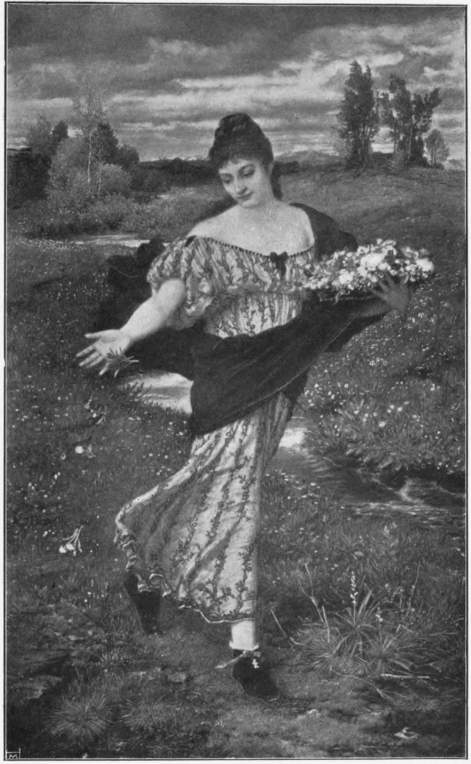 |
| Hanfstaengl. |
| BOECKLIN. FLORA. |
In one, St. Martin rides through a desolate wintry landscape upon a slow-trotting nag, and holds his outspread mantle towards the half-naked beggar, shivering with the cold. In another, St. Hubert has alighted from his horse, and kneels in adoration before the cross which he sees between the antlers of the stag. In another, St. George, upon a powerful rearing horse, thrusts his lance through the body of the dragon with solemn and earnest mien. But as a rule even the relationship with antique, mythological, and mediæval legendary ideas is wanting in his art. Landscapes which seem to have been studied in another world he peoples with beings who pass their lives lost in contemplation of the divine. Women and children, men and grey-beards live, and love, and labour as though in an age that knows nothing of the stroke of the clock, and which might be yesterday or a hundred thousand years ago. They repose upon the luxuriant sward shadowed by apple-trees laden with fruit, abandoning themselves to a thousand reveries and meditations. They do not pose, and they aim at being nothing except children of nature, nature in her innocence and simplicity. Nude women stand motionless under the trees, or youths are seen reflected in the pools. The motive of gathering oranges is several times repeated: a youth snatches at the fruit, an old man bends to pick up those which have dropped, and a child searches for those which have rolled away in the grass. Sometimes the steed, the Homeric comrade of man, is introduced: the nude youth rides his steed in the training-school, or the commander of an army gallops upon his splendid warhorse. Everything that Marées painted belongs to the golden age. And when it was borne in mind that these pictures had been produced twenty years back or more, they came to have the significance of works that opened out a new path; there was poetry in the place 241 of didactic formula; in the place of historical anecdote the joy of plastic beauty; in the place of theatrical vehemence an absence of gesticulation and a perfect simplicity of line. At a time when others rendered dramas and historical episodes by colours and gestures, Marées composed idylls. He came as a man of great and austere talent, Virgilian in his sense of infinite repose on the breast of nature, monastic in his abnegation of petty superficial allurements, despite special attempts which he made at chromatic effect. Something dreamy and architectonic, lofty and yet familiar, intimate in feeling and yet monumental holds sway in his works. Intimacy of effect he achieved by the stress he laid upon landscape; monumental dignity by his grandiose and earnest art, and his calm and sense of style in line. All abrupt turns and movements were avoided in his work. And he displayed a refinement entirely peculiar to himself through the manner in which he brought into accord the leading lines of landscape and the leading lines in his figures. A feeling for style, in the sense in which it was understood by the old painters, is everywhere dominant in his work, and a handling of line and composition in the grand manner which placed him upon a level with the masters of art. A new and simple beauty was revealed. And if it is true that it is only in the field of plastic art that he has had, up to the present, any pupil of importance—and he had one in Adolf Hildebrandt—it is, nevertheless, beyond question that the monumental painting of the future is alone capable of being developed upon the ground prepared by Marées.
In this more than anything, it seems to me, lies the significance of all these masters. We must not lay too much stress upon the fact that they dealt with ideal and universal themes; a healthy art cannot be nourished on bloodless 242 ideals, but only on the living essence of its own epoch. We must bear in mind, however, that a sound artistic principle has been formulated. A glance at the productions of classic art shows us that the old masters carefully considered the relation of a picture to its environment. Take, for instance, the Ravenna mosaics or Giotto’s frescoes. They must needs resound in solemn harmony the whole church through; looked at from any point of view they must make their presence felt right away in the farthest distance: so both Giotto and the mosaic artists worked only in broad expressive lines, their forcible colour-schemes were fitted together in accordance with strict decorative laws. All naturalistic effects are avoided, all petty detail is left out in the flow of the drapery as well as in the structure of the landscape. Then the clear outlines tell out. The pictures must, when viewed from a distance, simultaneously, in all their lines, carry on the lines of the building.
 | |
| Hanfstaengl. | |
| BOECKLIN. | IN THE TROUGH OF THE WAVES. |
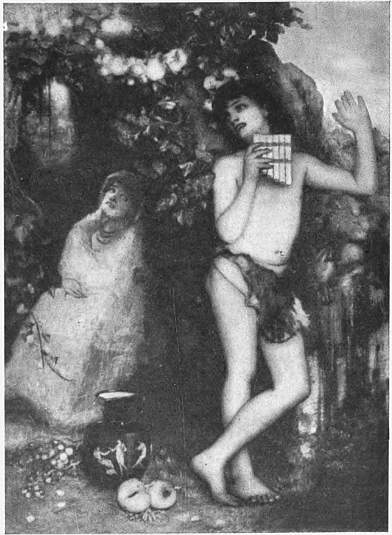 |
| Albert, Munich. |
| BOECKLIN. THE SHEPHERD’S PLAINT. |
Later on, in the Netherlands, there arose another style of painting. In abrupt contrast to the monumental works of the Italian school we have Jan van Eyck’s tiny little pictures painted with a fine point, stroke by stroke, with the most minute exactitude. Every hair in the head, every vein in the hands, every ornament in the costume is drawn true to life. Jan van Eyck knew what he was about with this fine-point style of art, for his pictures did not lay claim 243 to any effect from a distance; they were meant to be looked at, like miniatures in the prayer-books, from the closest point of view possible. They were little domestic altar-pieces: when anyone wanted to look at them, he drew the curtain aside and knelt or stood just in front of them. The style of painting of the later Dutch cabinet pictures is accounted for in the same way. These paintings were generally placed on an easel, as if to give the spectator a gentle hint, “If you wish to fully appreciate the beauties of this little picture, please stand right in front.” Even when the pictures were meant to adorn the walls, the minute and dainty style of a Don or a Mieris was appropriate, for the narrowness of the old Dutch rooms precluded all possibility of the spectator’s being able to stand far away from the picture.
If by chance one of these Dutch artists, Weenix for instance, had to do work for a Flemish palace, he changed his style forthwith. He recognised the fact that a picture, to be effective in a large state-room, must differ not only in size, but in composition and style of painting from one that is meant for a small parlour. It is undoubtedly this lack of appreciation of the fact that a picture must be suitable to its surroundings that has robbed the nineteenth century of any claim to style. What abominable daubs mural painters have foisted upon us in our public buildings! The literary trend of the time drew away people’s attention from the beauty of form and colour, and centred it upon the didactic value of the works. Instead of starting from the idea that a picture should “adorn,” they covered the walls with historical genre painting, never troubling themselves about decorative effect, and offered the beholder instructive stories in picture cards. As to art in the home, well, we can all of us remember the time when small photographs and etchings, instead of being kept in an album or a portfolio, were put on the wall, where they looked like mere spots of dead black and white. It was the same sort of thing in galleries and exhibitions, confusion worse confounded. On one and the same wall you got the most heterogeneous collection, cabinet pictures by Brouwer or Ostade next to an enormous altar-piece by Rubens, a gigantic Delacroix flanked by neat little Meissoniers. In this way the power of appreciating the significance of a work of art as part of the 244 decoration of a room was totally lost. Surely it is not to be wondered at that a picture seen close to in an exhibition, bought, taken home, hung on the wall and looked at from a distance, turns out a meaningless chaos of dirty-brown.
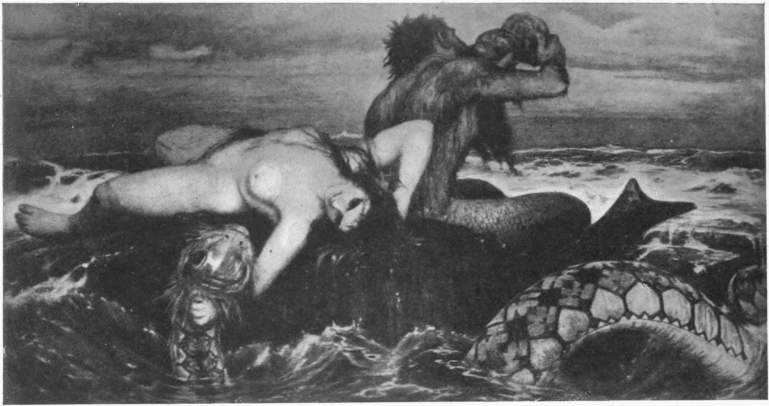 | |
| Albert, Munich. | |
| BOECKLIN. | AN IDYLL OF THE SEA. |
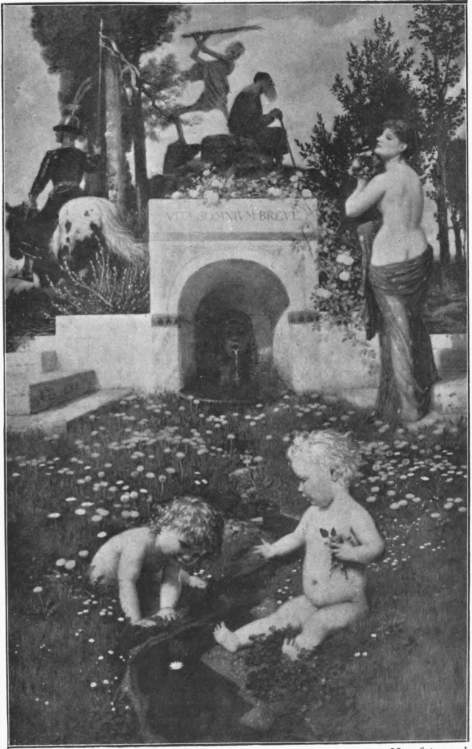 |
| Hanfstaengl. |
| BOECKLIN. VITA SOMNIUM BREVE. |
In the province of mural painting the tendency towards an improvement set in earliest. In England, France, and Germany, almost simultaneously efforts began to be made with the object of restoring to mural painting once more its decorative element. In England Burne-Jones was the first to pay attention to harmony of style between picture and building. Before his time English churches were provided with stained-glass windows in a spurious sort of Cinquecento style that was absolutely unsuited to the building, but Burne-Jones satisfied the most exacting demands of the English Neo-Gothic architecture. All his subjects are brought into style with the slender pillars, the curves of the landscape as well as of the figures harmonise with the pointed arches of the building. Everything, colour as well as line, is so simplified that the pictures retain the clearness of their composition when seen from the farthest possible standpoint. In France, Puvis de Chavannes travelled by another road to the same goal. The decoration of the Pantheon was placed in his hands. Before him many artists had done work there, but the policy of all of them had been to adopt the old style of oil-painting to mural decoration, and so they adorned the Pantheon as well, though it was called a Grecian temple, with oil-paintings founded on Raphael or Caravaggio, mural pictures that would have been far better suited to a church of the Cinquecento or the baroque period. Puvis was the first to realise that in the decoration of a building the artist must be strictly controlled by the style of the architecture; so in his frescoes he avoided all projections, all 245 roundness, all wavy lines, bends, and curves, and dealt exclusively with groups of vertical and horizontal lines, that followed the characteristic lines of pillar and architrave. Similarly in the colours as well as the lines he excluded all detail that would distract the attention, all confusion of colours that would disturb the eye, and thereby gave his works the stately and dominant effect that they produce. Had Fate been kind, poor Hans von Marées might have won the same significance for Germany as Puvis did for France. Though individually his works are faulty, they are all informed with a marvellous feeling for style; one observes how beautifully the lines of the landscape are made to harmonise with the lines of the figures, and with what a finely decorative quality the colours are combined.
In a similar manner we must bring our minds to bear upon the problem of the framed picture in connection with the decoration of a room. Our rooms are not only lighter but more spacious than the old-fashioned Dutch parlours, with their leaded panes; so it was merely a hereditary taint in our painters that made them cling so long to the ancestral style of painting, in spite of the altered conditions of the lighting and size of modern rooms. Impressionism did at any rate bring colour more into harmony with the improved lighting of our rooms; yet in every art the sins of the fathers are visited upon their children. The Impressionists discovered atmosphere, and so they denied the existence of lines, and the outlines vanished into thin air; they discovered light, and therefore they likewise denied the existence of colours. Then by means of light the colours were analysed, and patches of colour were decomposed into a heterogeneous conglomeration of luminous points. The Impressionists simply revelled in 246 the most delicate nuances of vague tones of indefinite colour, and as they eliminated from their work all significant lines and all strong and frank colours, they spoilt to a great extent the decorative effect of their pictures when viewed at a distance: their paintings from that standpoint are often nothing more than a daub of violet and yellow, without form and void.
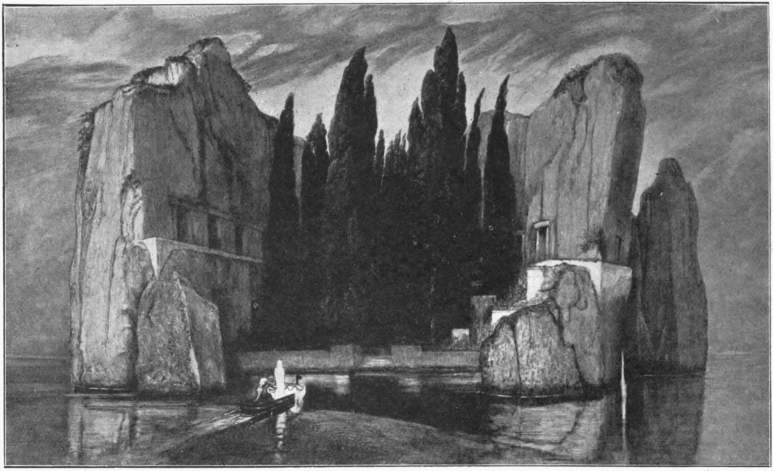 | |
| Hanfstaengl. | |
| BOECKLIN. | THE ISLE OF THE DEAD. |
Thus towards the close of the nineteenth century there came under discussion a new problem again in the matter of picture painting. The question arose as to how decorative qualities might be arrived at in painting pure and simple. The way seems to be pointed out in the works of Moreau and Boecklin; the way in which they placed side by side beautiful strong colours in broad masses, and invariably so as to avoid all discord, and combined the most conflicting tones into a harmonious whole in a manner which words fail one to describe. It was delightful, after having looked so long at nothing but the subtle, delicate nuances of the Impressionists, to turn again to these full-toned colours ringing out their deep and mighty harmonies.
It is scarcely to be wondered at that the younger generation of the present day refused to be bound by the principles of art laid down by their predecessors, notwithstanding the fact that Moreau, as well as Boecklin, was indebted to the Quattrocento for the mosaic-like brilliancy of his colours. Impressionism has discovered a whole range of new colour values by careful and intelligent study of the influence of light upon colour, and where formerly we saw ten we now find a hundred. Red, green, blue have lost their meaning in the category of complex and infinitely differentiated tones. So, as we advance from a realistic transcript of impressions taken direct from nature 247 to free, symphonic compositions of the colours to which Impressionism has opened our eyes, we shall evolve harmonies richer than were ever imagined before, more melting than we ever dreamed of. This is the goal to which the efforts of the younger generation are primarily tending. Building upon the foundations laid by the Impressionists, they seek to ensure for their pictures both clearness and harmony, by simplification of form, by beauty of technique, and by subordination of colour to the decorative scheme. Their confession of faith is comprised in the words of Paterson: “A picture must be something more than garbled Nature: it must please the educated eye; and only so far as nature gives the painter his material can he or dare he follow her.”

BOOK V
A SURVEY OF EUROPEAN ART AT THE PRESENT TIME
INTRODUCTION
By what means was the further development of painting in Europe brought about under the influence of the principles of the two schools, the Impressionists and the Decorative-Stylists? The following may supply the answer.
“Realism” having led painting from the past to the present, and “Impressionism” having broken the jurisdiction of the galleries by establishing an independent conception of colour for a new class of subjects, the flood of modern life, which had been artificially dammed, began to pour into art in all its volume. A whole series of new problems emerged, and a vigorous band of modern spirits were ready to lay hold upon them and give them artistic shape, each according to his nature, his ability, and his individual knowledge and power. After nineteenth-century painting had found its proper field of activity they were no longer under the necessity of seeking remote subjects. The fresh conquest of a personal impression of nature took the place of that retrospective taste which employed the ready-made language of form and colour belonging to the old masters, as a vocabulary for the preparation of fresh works of art. Nature herself had become a gallery of splendid pictures. Artists were dazzled as if by a new light, overcome as though by a revelation of tones and strains from which the painter was to compose his symphonies. They learnt how to find what was pictorial and poetic in the narrowest family circle and amongst the beds of the simplest vegetable garden; and for the first time they felt more wonder in the presence of reality, the joy of gradual discovery and of a leisurely conquest of the world.
Of course, plein-air painting was at first the chief object of their endeavours. Having painted so long only in brown tones, the radiant magic world of free and flowing light was something so ravishingly novel that for several years all their efforts were exclusively directed to possessing themselves once more of the sun, and substituting the clear daylight for the clare-obscure which had reigned alone, void of atmosphere. In this sunny brightness, flooded with light and air, they found a crowd of problems, and turned to the perpetual discovery of new chords of colour. Sunbeams sparkling as they rippled through the leaves, and greyish-green meadows flecked with dust and basking under light, were the first and most simple themes.
The complete programme, however, did not consist of painting in bright hues, but, generally speaking, in seizing truth of colour and altogether renouncing artificial harmony in a generally accepted tone. Thus, after the 252 painting of daylight and sunlight was learnt, a further claim had still to be asserted: the ideal of truth in painting had to be made the keynote in every other task. For in the sun, light is no doubt white, but in the recesses of the forest, in the moonshine, or in a dim place, it shines and is at the same time charged with colour. Night, or mist, with its hovering and pervasive secrets, is quite as rich in beauties as the radiant world of glistening sunshine. After seeing the summer sun on wood and water, it was a relief for the eye to behold the subdued, soft, and quiet light of a room. Upon the older and rougher painting of free light there followed a preference for dusk, which has a softness more picturesque, a more tender harmony of colours, and more geniality than the broad light of day. Artists studied clare-obscure, and sought for an enhancement of colour in it; they looked into the veil of night, and addressed themselves to a painting of darkness such as could only have proceeded from the plein-air school. For this darkness of theirs is likewise full of atmosphere, a darkness in which there is life and breath and palpitation. In earlier days, when a night was painted, everything was thick and opaque, covered with black verging into yellow; to this latter error artists were seduced by the crusts of varnish upon old pictures. Now they learnt to interpret the mysterious life of the night, and to render the bluish-grey atmosphere of twilight. Or if figures were to be painted in a room, artists rendered the circulation of the air amid groups of people, which Correggio called “the ambient” and Velasquez “respiration.” And there came also the study of artificial illumination—of the delicate coloured charm of many-coloured lanterns, of the flaring gas or lamp-light which streams through the glass windows of shops, flaring and radiating through the night and reflected in a blazing glow upon the faces of men and women. Under these purely pictorial points of view the gradual widening of the range of subject was completed.
So long as the acquisition of sunlight was the point in question, representations from the life of artisans in town and country stood at the centre itself of artistic efforts, because the conception and technical methods of the new art could be tested upon them with peculiar success. And through these pictures painting came into closer sympathy with the heart-beat of the age. At an epoch when the labouring man as such, and the political and social movement in civilisation, had become matters of absorbing interest, the picture of artisans necessarily claimed an important place in art; and one of the best sides of the moral value of modern painting lies in its no longer holding itself in indifference aloof from these themes. When the century began, Hector and Agamemnon alone were qualified for artistic treatment, but in the natural course of development the disinherited, the weary and heavy-laden likewise acquired rights of citizenship. In the passage where Vasari speaks of the Madonnas of Cimabue, comparing them with the older Byzantine Virgins, he says finely that the Florentine master brought more “goodness of heart” into painting. And perhaps the historians of the future will say the same about the art of the present.
The predilection for the disinherited was in the beginning to such an extent 253 identified with the plain, straightforward painting of the proletariat that Naturalism could not be conceived at all except in so far as it dealt with poverty: in making its first great successes it had sought after the miserable and the outcast, and serious critics recognised its chief importance in the discovery of the fourth estate. Of course, the painting of paupers, as a sole field of activity for the new art, would have been an exceedingly one-sided acquisition. It is not merely the working-man who should be painted, because the age must strive to compass in a large and full spirit the purport of its own complicated conditions of life. So there began, in general, the representation, so long needed, of the man of to-day and of society agitated, as it is, by the stream of existence. As Zola wrote in the very beginning of the movement: “Naturalism does not depend upon the choice of subject. The whole of society is its domain, from the drawing-room to the drinking-booth. It is only idiots who would make Naturalism the rhetoric of the gutter. We claim for ourselves the whole world.” Everything is to be painted,—forges, railway-stations, machine-rooms, the workrooms of manual labourers, the glowing ovens of smelting-works, official fêtes, drawing-rooms, scenes of domestic life, cafés, storehouses and markets, the races and the Exchange, the clubs and the watering-places, the expensive restaurants and the dismal eating-houses for the people, the cabinets particuliers and chic des premières, the return from the Bois and the promenades on the seashore, the banks and the gambling-halls, casinos, boudoirs, studios, and sleeping-cars, overcoats, eyeglasses and red dress-coats, balls, soirées, sport, Monte Carlo and Trouville, the lecture-rooms of universities and the fascination of the crowded streets in the evening, the whole of humanity in all classes of society and following every occupation, at home and in the hospitals, at the theatre, upon the squares, in poverty-stricken slums and upon the broad boulevards lit with electric light. Thus the new art flung aside the blouse, and soon displayed itself in the most various costumes, down to the frock-coat and the smoking-jacket. The rude and remorseless traits which it had at first, and which found expression in numbers of peasant, artisan, and hospital pictures, were subdued and softened until they even became idyllic. Moreover, the scale of painting over life-size, favoured in the early years of the movement, could be abandoned, since it arose essentially from competition with the works of the historical school. So long as those huge pictures covered the walls at exhibitions, artists who obeyed a new tendency were forced from the beginning—if they wished to prevail—to produce pictures of the same size. But since historical painting was finally dead and buried, there was no need to set up such a standard any longer, and a transition could be made to a smaller scale, better fitted for works of an intimate character. The dazzling tones in which the Impressionists revelled were replaced by those which were dim and soft, energy and force by subdued and tender treatment, largeness of size by a scale which was small and intimate.
That was more or less the course of evolution run through in all European countries in a similar way between the years 1875 and 1885. Just in the same 254 way from this time onwards the Decorative-Stylists’ tendency set in universally. Hitherto everything was focused on the “picture as such.” Tasteless novelty or methodless imitation held sway over the applied arts. The endeavours of the next decade aimed at freeing the picture from its isolation and making the room itself a harmonious work of art. A long line of eminent artists took in hand the hitherto neglected subject of art in decoration; and as thereby new blood was infused into the applied arts, so on the other hand pictorial art in one way renounced its freedom to fit itself into its new frame. Colour, which formerly was determined principally by the lighting, now became subordinate to a decorative scheme. Truth is no longer the end and aim of art, but fitness, harmony of form and colour values. It is, however, obviously impossible to give verse and chapter to the history of this development, just as it would be impossible to fix a boundary line between the two roads, the Impressionistic on the one hand and the Decorative on the other. We will wander free from one country to another, and try to assign to each its proper place in the general chart of modern painting.

CHAPTER XXXIV
FRANCE
Paris, which for a hundred years had given the signal for all novel tactics in European art, still remained at the head of the movement; the artistic temperament of the French people themselves, and the superlatively excellent training which the painter enjoys in Paris, enable him at once to follow every change of taste with confidence and ease. In 1883 Manet died, on the varnishing day of the Salon, and in the preface which Zola wrote to the catalogue of the exhibition held after the death of the master he was well able to say: “His influence is an accomplished fact, undeniable, and making itself more deeply felt with every fresh Salon. Look back for twenty years, recall those black Salons, in which even studies from the nude seemed as dark as if they had been covered with mouldering dust. In huge frames history and mythology were smothered in layers of bitumen; never was there an excursion into the province of the real world, into life and into perfect light; scarcely here or there a tiny landscape, where a patch of blue sky ventured bashfully to shine down. But little by little the Salons were seen to brighten, and the Romans and Greeks of mahogany to vanish in company with the nymphs of porcelain, whilst the stream of modern representations taken from ordinary life increased year by year, and flooded the walls, bathing them with vivid tones in the fullest sunlight. It was not merely a new period; it was a new painting bent upon reaching the perfect light, respecting the law of colour values, setting every figure in full light and in its proper place, instead of adapting it in an ideal fashion according to established tradition.”
When the way had been paved for this change, when the new principles had been transferred from the chamber of experiments to full publicity, from the Salon des Refusés to the Salon which was official, it was chiefly Bastien-Lepage who gained the first adherents to them amongst the public. But because he does not belong to the pioneers of art, and merely adapted for the great public elements that had been won by Manet, the immoderate praise which was accorded him in earlier days has been recently brought within more legitimate limits. It has been urged, by way of restriction, that he stands in relation to Manet as Breton to Millet, and that, admitting all differences, he has nevertheless a certain resemblance to his teacher, Cabanel. As the latter rendered Classicism elegant, Bastien-Lepage, it has been said, softened the ruggedness of Naturalism, cut and polished the nails of his 256 peasants, and made their rusticity a pretty thing, qualifying it for the drawing-room. Degas was in the habit of calling him the Bouguereau of Naturalism. As a matter of fact, Naturalism was bound to make certain concessions if it were ever to prevail, and such critics forget that it was just these amiable concessions which helped the principles of Manet to prevail more swiftly than would have been otherwise possible. All the forms and ideas of the Impressionists, with which no one, outside the circle of artists, had been able to reconcile himself, were to be found in Bastien-Lepage, purified, mitigated, and set in a golden style. He followed the eclaireurs, as the leader of the main body of the army which has gained the decisive battle, and in this way he has fulfilled an important mission in the history of art.
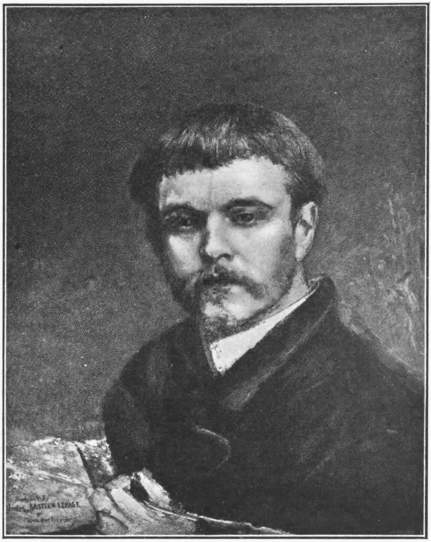 |
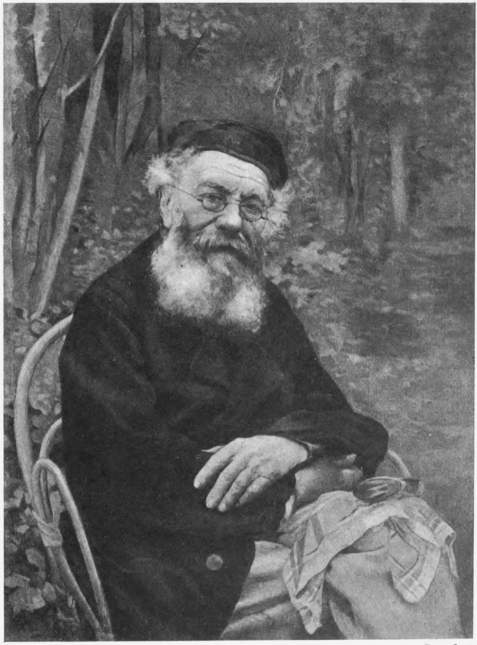 | ||
| Baschet. | BASTIEN-LEPAGE. | Baschet. PORTRAIT OF HIS GRANDFATHER. | |
| JULES BASTIEN-LEPAGE. | (By permission of M. E. Bastien-Lepage, the owner of the picture.) | ||
Bastien-Lepage was born in ancient Damvillers—once a small stronghold of Lorraine—in a pleasant, roomy house that told a tale of even prosperity rather than of wealth. As a boy he played amongst the venerable moats which had been converted into orchards. Thus in his youth he received the freshest impressions, being brought up in the heart of nature. His father drew a good deal himself, and kept his son at work with the pencil, without any æsthetic theories, without any vague ideal, and without ever uttering the word “academy” or “museum.” Having left school in Verdun, Bastien-Lepage went to Paris to become an official in the post-office. Of an afternoon, however, he drew and painted with Cabanel. But he was Cabanel’s pupil much as Voltaire was a pupil of the Jesuits. “My handicraft,” as he said afterwards, “I learnt at the Academy, but not my art. You want to paint what exists, and you are invited to represent the unknown ideal, and to dish up the pictures of the old masters. In old days I scrawled drawings of gods and goddesses, Greeks and Romans, beings I didn’t know, and didn’t understand, and regarded with supreme indifference. To keep up my courage, I repeated to myself that this was possibly ‘grand art,’ and I ask myself sometimes whether anything academical still remains in my composition. I do not say that one should only paint everyday life; but I do assert that 257 when one paints the past it should, at any rate, be made to look like something human, and correspond with what one sees around one. It would be so easy to teach the mere craft of painting at the academies, without incessantly talking about Michael Angelo, and Raphael, and Murillo, and Domenichino. Then one would go home afterwards to Brittany, Gascony, Lorraine, or Normandy, and paint what lies around; and any morning, after reading, if one had a fancy to represent the Prodigal Son, or Priam at the feet of Achilles, or anything of the kind, one would paint such scenes in one’s own fashion, without reminiscences of the galleries—paint them in the surroundings of the country, with the models that one has at hand, just as if the old drama had taken place yesterday evening. It is only in that way that art can be living and beautiful.”
The outbreak of the war fortunately prevented him from remaining long at the Academy. He entered a company of Franc-Tireurs, took part in the defence of Paris, and returned ill to Damvillers. Here he came to know himself and his peculiar talent. At once a poet and a realist, he looked at nature with that simple frankness which those alone possess who have learnt from youth upwards to see with their own eyes instead of trusting to other people’s. His friends called him “primitive,” and there was some truth in what they said, for Bastien-Lepage came to art free from all trace of mannerism; he knew nothing of academical rules, and merely relied upon his eyes, which were always open and trustworthy.
Looking back as far as he could, he was able to remember nothing except gleaners bowed over the stubble-fields, vintagers scattered amid the furrows of the vineyards, mowers whose robust figures rose brightly from the green meadows, shepherdesses seeking shelter beneath tall 258 trees from the blazing rays of the midday sun, shepherds shivering in their ragged cloaks in winter, pedlars hurrying with great strides across the plain raked by a storm, laundresses laughing as they stood at their tubs beneath the blossoming apple-trees. He was impressionable to everything: the dangerous-looking tramp who hung about one day near his father’s house; the wood-cutter groaning beneath the weight of his burden; the passer-by trampling the fresh grass of the meadows and leaving his trace behind him; the little sickly girl minding her lean cow upon a wretched field; the fire which broke out in the night and set the whole village in commotion. That was what he wanted to paint, and that is what he has painted. The life of the peasants of Lorraine is the theme of all his pictures, the landscape of Lorraine is their setting. He painted what he loved, and he loved what he painted.
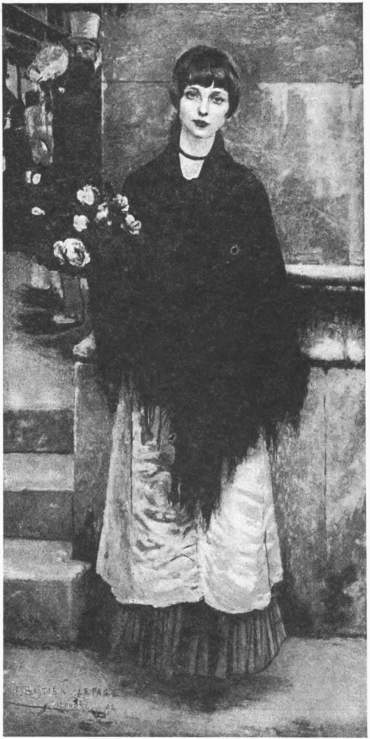 |
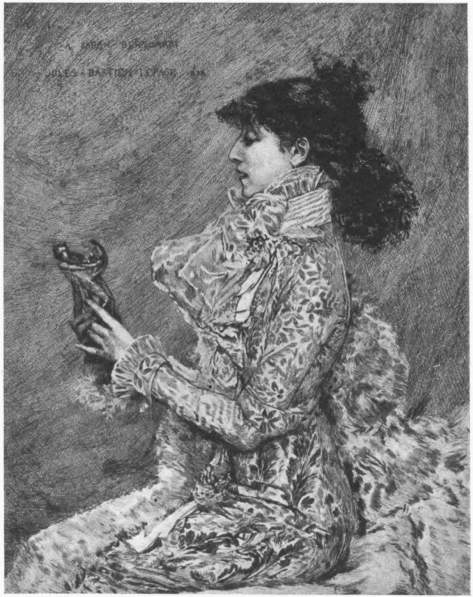 | ||
| Baschet. | Gaz. des Beaux-Arts. | ||
| BASTIEN-LEPAGE. | THE FLOWER GIRL. | BASTIEN-LEPAGE. | SARAH BERNHARDT. |
It was in Damvillers that he felt at home as an artist. He had his studio in the second storey of his father’s house, though he usually painted in the open air, either in the field or the orchard, whilst his grandfather, an old man of eighty, was near him clipping the trees, watering the flowers, and weeding the grass. His mother, a genuine peasant, was always busy with the thousand cares of housekeeping. Of an evening the whole family sat together round the lamp, his mother sewing, his father reading the paper, his grandfather with the great cat on his lap, and Jules working. It was at this time that he produced those familiar domestic scenes, thrown off with a few strokes, which were to be seen at the exhibition of the works which he left behind him. He knew no greater pleasure than that of drawing again and again the portraits of his father and mother, the old lamp, or the velvet cap of his grandfather. At ten o’clock sharp his father gave the signal for going to bed.
In Paris, indeed, other demands were made. In 1872 he painted, with the object of being represented in the Salon, that remarkable picture “In the Spring,” the only one of his works which is slightly hampered by conventionality in conception. The pupil 259 of Cabanel is making an effort at truth, and has not yet the courage to be true altogether. Here, as in the “Spring Song” which followed, there is a mixture of borrowed sentiment, work in the old style and fresh Naturalism. The landscape is painted from nature, and the peasant woman is real, but the Cupids are taken from the old masters.
 |
| Baschet. |
| BASTIEN-LEPAGE. MME. DROUET. |
The next years were devoted to competitive labours. To please his father and mother Bastien-Lepage twice contested the Prix de Rome. In 1873 he painted as a prize exercise a “Priam before Achilles,” and in 1875 an “Annunciation of the Angel to the Shepherds,” that now famous picture which received the medal at the World Exhibition of 1878. And he who afterwards revelled in the clearest plein-air painting here celebrates the secret wonders of the night, though the influences of Impressionism are here already visible. In his picture the night is as dark as in Rembrandt’s visions; yet the colours are not harmonised in gold-brown, but in a cool grey silver tone. And how simple the effect of the heavenly appearance upon the shepherds lying round the fire of coals! The place of the curly ideal heads of the old sacred painting has been taken by those of bristly, unwashed men who, nurtured amid the wind and the weather, know nothing of those arts of toilette so much in favour with the imitators of Raphael, and who receive the miracle with the simplicity of elemental natures. Fear and abashed astonishment at the angelic appearance are reflected in their faces, and the plain and homely gestures of their hands are in correspondence with their inward excitement. Even the angel turning towards the shepherds was conceived in an entirely human and simple way. In spite of this, or just because of it, Bastien failed with his “Annunciation to the Shepherds,” as he had done previously with his “Priam.” Once the prize was taken by Léon Comerre, a pupil of Cabanel, and on the other occasion by Josef Wencker, the pupil of Gérôme. It was written in the stars that Bastien-Lepage was not to go to Rome, and it did 260 him as little harm as it had done to Watteau a hundred and sixty years before. In Italy Bastien-Lepage would only have been spoilt for art. The model for him was not one of the old Classic painters, but nature as she is in Damvillers,—Nature, the great mother. When the works sent in for the competition were exhibited a sensation was made when one day a branch of laurel was laid on the frame of Bastien-Lepage’s “Annunciation to the Shepherds” by Sarah Bernhardt. And Sarah Bernhardt’s portrait became the most celebrated of the small likenesses which soon laid the foundation of the painter’s fame.
The portrait of his grandfather, that marvellous work of a young man of five-and-twenty, is the first picture in which he was completely himself. The old man sits in a corner of the garden, just as usual, in a brown cap, his spectacles upon his nose, his arms crossed upon his lap, with a horn snuff-box and a check handkerchief lying upon his knees. How perfectly easy and natural is the pose, how thoughtful the physiognomy, what a personal note there is in the dress! Nor are there in that garden, bathed in light, any of those black shadows which only fall in the studio. Everything bore witness to a simplicity and sincerity which justified the greatest hopes. After that first work the world knew that Bastien-Lepage was a preeminent portrait painter, and he did not betray the promise of his youth. His succeeding pictures showed that he had not merely rusticity and nature to rely upon, but that he was a charmeur in the best sense of the word.
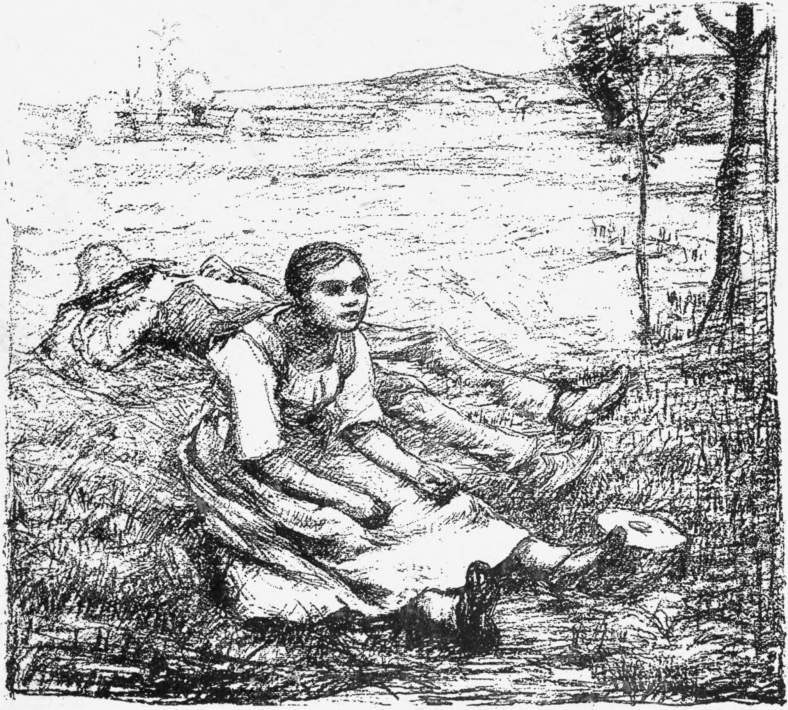 | |
| Gaz. des Beaux-Arts. | |
| BASTIEN-LEPAGE. | THE HAY HARVEST. |
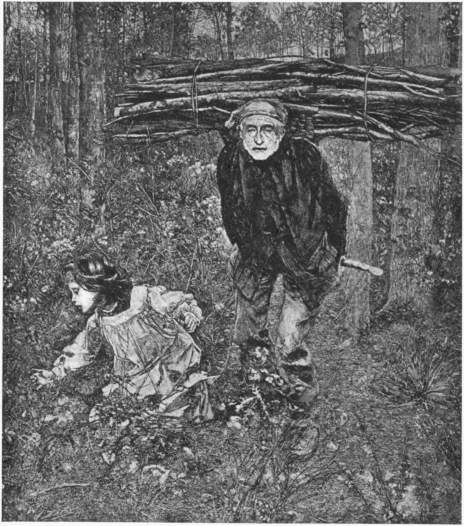 |
| Baschet. |
| BASTIEN-LEPAGE. LE PÈRE JACQUES. |
This ingenuous artist, who knew nothing of the history of painting, and felt more at home in the open air than in museums, was not ignorant, at any rate, of the portraits of the sixteenth century, and had chosen for his likenesses a scale as small as that which Clouet and his school preferred. The representation here reaches a depth of characterisation which recalls Jan van Eyck’s little pearls of portrait painting. In these works also he mostly confined himself to bright lights. Portraits of this type are those of his brother, of Madame 261 Drouet, the aged friend of Victor Hugo, with her weary, gentle, benevolent face—a masterpiece of intimate feeling and refinement; of his friend and biographer André Theuriet, of Andrieux the prefect of the police, and, above all, the famous and signal work of inexorable truth and marvellous delicacy, Sarah Bernhardt in profile, with her tangled chestnut hair, sitting upon a white fur, arrayed in a white China-silk dress with yellowish lights in it, and carefully examining a Japanese bronze. The bizarre grace of the tragic actress, her slender figure, fashioned, as it were, for Donatello, the nervous intensity with which she sits there, her weird Chinese method of wearing the hair, and the profile of which she is so proud, have been rendered in none of her many likenesses with such an irresistible force of attraction as in this little masterpiece. In some of his other portraits Bastien-Lepage has not disdained the charm of obscure light; he has not done so, for example, in the little portrait of Albert Wolff, the art-critic, as he sits at his writing-desk amongst his artistic treasures, with a cigarette in his hand. Only 262 Clouet and Holbein painted miniature portraits of such refinement. Amongst moderns, probably Ingres alone has reached such a depth of characterisation upon the smallest scale, and in general he is the most closely allied to Bastien-Lepage as a portrait painter in profound study of physiognomy, and in the broad and, one might say, chased technique of his little drawings. Comparison with Gaillard would be greatly to the disadvantage of this great engraver, for Bastien-Lepage is at once more seductive and many-sided. It is curious how seldom his portraits have that family likeness which is elsewhere to be found amongst almost all portrait painters. In his effort at penetrative characterisation he alters, on every occasion, his entire method of painting according to the personality, so that it leaves at one time an effect that is bizarre, coquettish, and full of intellectual power and spirit, at another one which is plain and large, at another one which is bashful, sparing, and bourgeois.
As a painter of peasant life he made his first appearance in 1878.
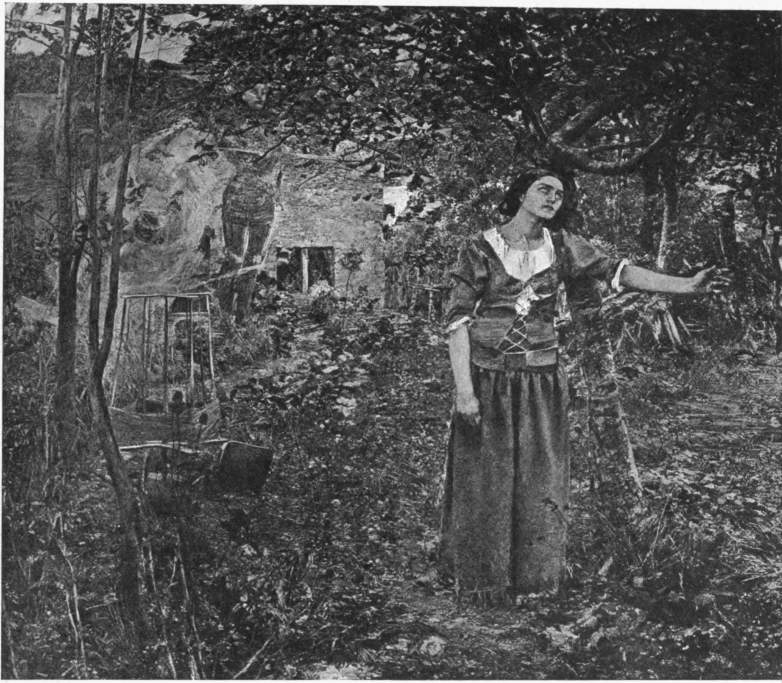 | |
| Baschet. | |
| BASTIEN-LEPAGE. | JOAN OF ARC. |
In the Salon of this year a sensation was made by a work of such truth and poetry as had not been seen since Millet; this was the “Hay Harvest.” It is noon. The June sun throws its sultry beams over the mown meadows. The ground rises slowly to a boundless horizon, where a tree emerges here and there, standing motionless against the brilliant sky. The grey and the green of these great plains—it is as if the weariness of many toilsome miles rose out of them—weighed heavily upon one, and created a sense of forsaken loneliness. Only two beings, a pair of day-labourers, break the wide level scorched by a quivering, continuous blaze of light. They have had their midday meal, and their basket is lying near them upon the ground. The man has now lain down to sleep upon a heap of hay, with his hat tilted over his eyes. But the woman sits dreaming, tired with the long hours of work, dazzled with the glare of the sun, and overpowered by the odour of the hay and the sultriness of noon. She does not know the drift of her thoughts; nature is working upon her, and she has feelings which she scarcely understands herself. She is sunburnt and ugly, and her head is square and heavy, and yet there lies a world of 263 sublime and mystical poetry in her dull, dreamy eyes gazing into a mysterious horizon. By this picture and “The Potato Harvest,” which succeeded it in 1879, Bastien-Lepage, the splendid, placed himself in the first line of modern French painters. This time he renders the sentiment of October. The sandy fields, impregnated with dust, rest in a white, subdued light of noon; pale brown are the potato stalks, pale brown the blades of grass, and the roads are bright with dust; and through this landscape, with its wide horizon, where the tree-tops, half despoiled already, shiver in the wind, there blows le grand air, a breeze strong as only Millet in his water-colours had the secret of painting. With Millet he shares likewise the breath of tender melancholy which broods so sadly over his pictures. “The Girl with the Cow,” the little Fauvette, that child of social misery—misery that lies sorrowful and despairing in the gaze of her eyes—is perhaps the most touching example of his brooding devotion to truth. Her brown dress is torn and dirty, while a grey kerchief borders her famished, sickly face. A waste, disconsolate landscape, with a frozen tree and withered 264 thistles, stretches round like a boundless Nirvana. Above there is a whitish, clear, tremulous sky, making everything paler, more arid and wearily bright; there is no gleam of rich luxuriant tints, but only dry, stinted colours; and not a sound is there in the air, not a scythe driving through the grass, not a cart clattering over the road. There is something overwhelming in this union between man and nature. One thinks of the famous words of Taine: “Man is as little to be divided from the earth as an animal or a plant. Body and soul are influenced in the same way by the environment of nature, and from this influence the destinies of men arise.” As an insect draws its entire nature, even its form and colour, from the plant on which it lives, so is the child the natural product of the earth upon which it stands, and all the impulses of its spirit are reflected in the landscape.
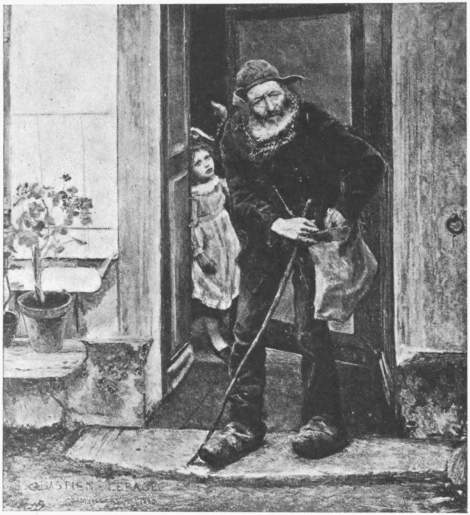 |
| Baschet. |
| LEPAGE. THE BEGGAR. |
In 1879 Bastien-Lepage went a step further. In that year appeared “Joan of Arc,” his masterpiece in point of spiritual expression. Here he has realised the method of treating historical pictures which floated before him as an idea at the Academy, and has, at the same time, solved a problem which beset him from his youth—the penetration of mysticism and the world of dreams into the reality of life. “The Annunciation to the Shepherds,” “In Spring,” and “The Spring Song” were merely stages on a course of which he reached the destination in “Joan of Arc.” His ideal was “to paint historical themes without reminiscences of the galleries—paint them in the surroundings of the country, with the models that one has at hand, just as if the old drama had taken place yesterday evening.”
The scene of the picture is a garden of Damvillers painted exactly from nature, with its grey soil, its apple and pear-trees clothed with small leaves, its vegetable beds, and its flowers growing wild. Joan herself is a pious, careworn, dreamy country girl. Every Sunday she has been to church, lost herself in long mystic reveries before the old sacred pictures, heard the misery of France spoken of; and the painted statues of the parish church and its tutelary saints pursue her thoughts. And just to-day, as she sat winding yarn in the shadow of the apple-trees, murmuring a 265 prayer, she heard of a sudden the heavenly voices speaking. The spirits of St. Michael, St. Margaret, and St. Catharine, before whose statues she has prayed so often, have freed themselves from the wooden images and float as light phantoms, as pallid shapes of mist, which will as suddenly vanish into air before the eyes of the dreaming girl. Joan rises trembling, throwing her stool over, and steps forward. She stands in motionless ecstasy stretching out her left arm, and gazing into vacancy with her pupils morbidly dilated. Of all human phases of expression which painting can approach, such mystical delirium is perhaps the hardest to render; and probably it was only by the aid of hypnotism, to which the attention of the painter was directed just then by the experiments of Charcot, that Bastien-Lepage was enabled to produce in his model that look of religious rapture, oblivious to the whole world, which is expressed in the vague glance of her eyes, blue as the sea.
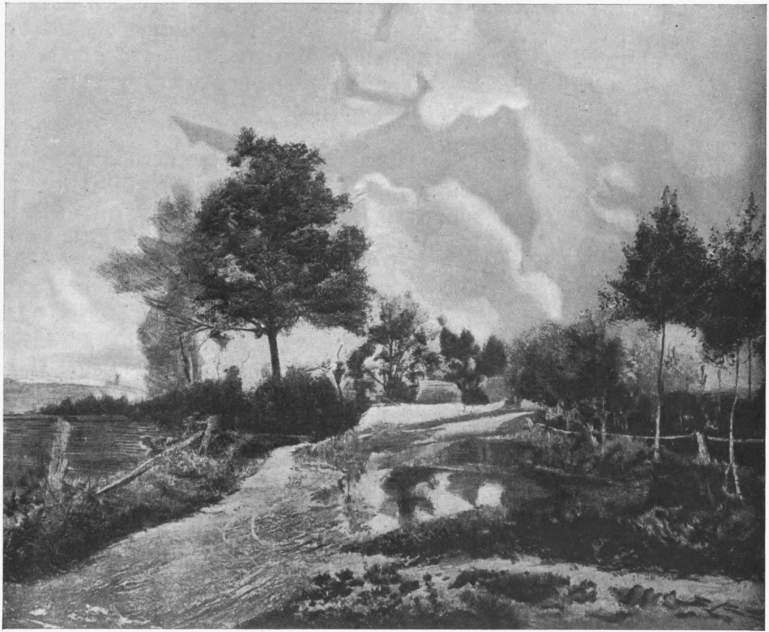 | |
| Baschet. | |
| BASTIEN-LEPAGE. | THE POND AT DAMVILLERS. |
“Joan of Arc” was succeeded by “The Beggar,” that life-size figure of the haggard old tramp who, with a thick stick under his arm—of which he would make use upon any suitable occasion—picks up what he can in the villages, saying a paternoster before the doors while he begs. This time he has been ringing at the porch of an ordinary middle-class dwelling, and he is sulkily 266 thrusting into the wallet slung round his shoulders a great hunch of bread which a little girl has just given to him. There is a mixture of spite and contempt in his eyes as he shuffles off in his heavy wooden shoes. And behind the doorpost the little girl, who, in her pretty blue frock, has such a trim air of wearing her Sunday best, looks rather alarmed and glances timidly at the mysterious old man.
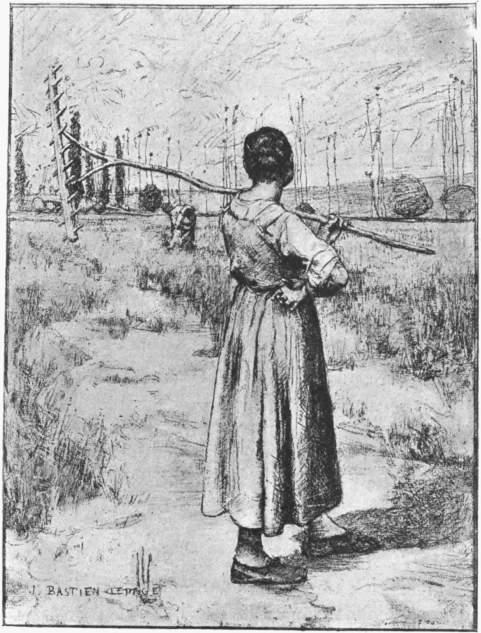 |
| Baschet. |
| BASTIEN-LEPAGE. THE HAYMAKER. |
“Un brave Homme,” or “Le Père Jacques,” as the master afterwards called the picture, was to some extent a pendant to “The Beggar.” He comes out of the wood wheezing, with a pointed cap upon his head and a heavy bundle of wood upon his shoulders, whilst at his side his little grandchild is plucking the last flowers. It is November; the leaves have turned yellow and cover the ground. Père Jacques is providing against the Winter. And the Winter is drawing near—death.
Bastien-Lepage’s health had never been good, nor was Parisian life calculated to make it better. Slender and delicate, blond with blue eyes and a sharply chiselled profile—tout petit, tout blond, les cheveux à la bretonne, le nez retroussé et une barbe d’adolescent, as Marie Baskirtscheff describes him—he was just the type which Parisiennes adore. His studio was besieged; there was no entertainment to which he was not invited, no committee, no meeting to hold judgment over pictures at which he was not present. Amateurs fought for his works and asked for his advice when they made purchases. Pupils flocked to him in numbers. He was intoxicated with the Parisian world, enchanted with its modern elegance; he loved the vibration of life, and rejoiced in masked balls like a child. Consumptive people are invariably sensuous, drinking in the pleasures of life with more swift and hasty draughts. He then left Paris and plunged into the whirlpool of other great cities. From Switzerland, Venice, and London he came 267 back with pictures and landscapes. In London, indeed, he painted that beautiful picture “The Flower-Girl,” the pale, delicate child upon whose faded countenance the tragedy of life has so early left its traces. Through the whole summer of 1882 he worked incessantly in Damvillers. Once more he painted his native place in a landscape of the utmost refinement. Here, as in his portraits, everything has been rendered with a positive trenchancy, with a severe, scientific effort after truth, in which there lies what is almost a touch of aridness. And yet an indescribable magic is thrown over the fragrant green of the meadows, the young, quivering trees, and the still pond which lies rippling in the cloudless summer day.
 | |
| Mansell Photo | |
| L’HERMITTE. | THE PARDON OF PLOURIN. |
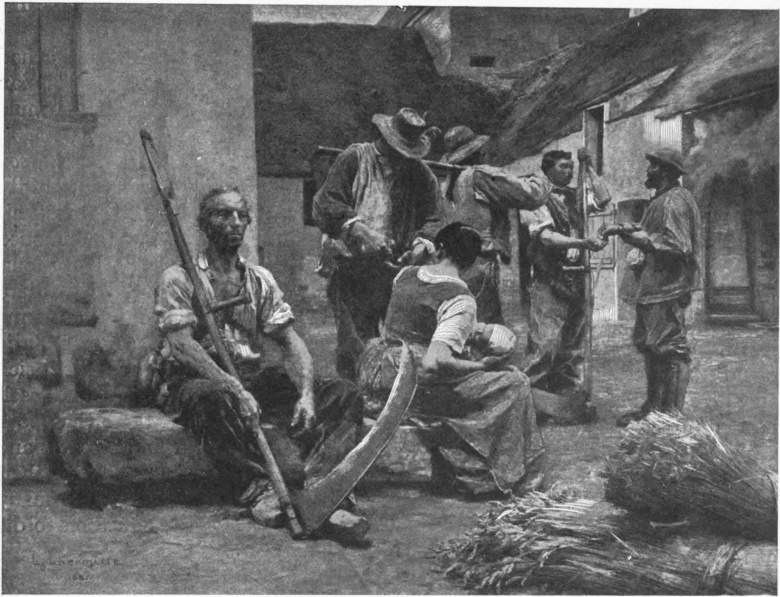 | |
| Portfolio. | |
| L’HERMITTE. | PAY TIME IN HARVEST. |
In 1883 there appeared in the Salon that wonderful picture “Love in the Village.” The girl has hung up her washing on the paling, and the neighbour’s son has run down with a flower in his hand; she has taken the flower, and in confusion they have suddenly turned their backs upon each other, and stand there without saying a word. They love each other, and wish to marry, but how hard is the first confession. Note how the lad is turning his fingers about in his embarrassment; note the confusion of the girl, which may be seen, although she is looking towards the background of the picture; note the spring landscape, which is as fair as the figures it surrounds.
It is a tender dreamer who gives himself expression here—and love came to him also.
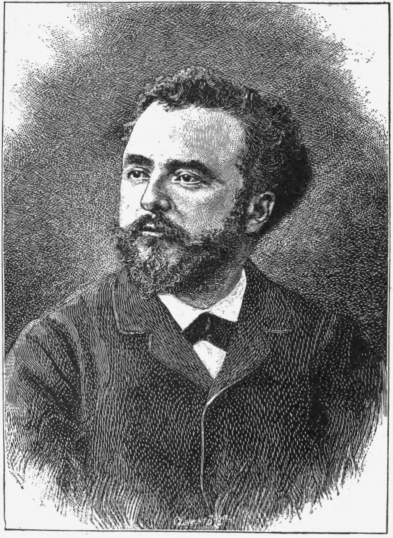 |
| L’Art. |
| LÉON L’HERMITTE. |
Enthusiastically adored by the women in his school of painting, he had found a dear friend in Marie Baskirtscheff, the distinguished young Russian girl who had become his pupil just as his fame began to rise. It is charming to see the enthusiasm with which Marie speaks of him in her diary. “Je peins sur la propre palette du vrai Bastien, avec des couleurs à lui, son pinceau, son atelier, et son frère pour modèle.” And how the others envy her because of it! “La petite Suédoise voulait toucher à sa palette.” With Marie he sketched his plans for the future, and in the midst of this restless activity he was summoned hence together with her, for she also died young, at the age of twenty-four, just as her pictures began to create a sensation. A touching idyll in her diary tells how the girl learnt, when she was dying of consumption, that young Bastien had also fallen ill, and been given up as hopeless. So long as Marie could go out of doors she went with her mother and her aunt to visit her sick friend; and when she was no longer allowed to leave the house he had himself carried up the steps to her drawing-room by his brother, and there they both sat beside each other in armchairs, and saw the end draw near, merciless and inevitable, the end of their young lives, their talents, their ambition, and their hopes. “At last! Here it is then, the end of all my sufferings! So many efforts, so many wishes, so many plans, so many —— ——, and then to die at four-and-twenty upon the threshold of them all!”
Her last picture was one of six schoolboys, sons of the people, who are standing at a street corner chattering; and it makes a curiously virile impression, when one considers that it was painted by a blond young girl, who slept under dull blue silken bed-curtains, dressed almost entirely in white, was rubbed with perfumes after a walk in hard weather, and wore on her shoulders furs which cost two thousand francs. It hangs in the Luxembourg, and for a long time a lady dressed in mourning used to come there every week and cry before the picture painted by the daughter whom she had lost so early. Marie died on 31st October 1884, and Bastien barely a month afterwards. “The Funeral of a Young Girl,” in which he wished to immortalise the funeral of Marie, was his last sketch, 269 his farewell to the world, to the living, alluring, ever splendid nature which he loved so much, grasped and comprehended so intimately, and to the hopes which built up their deceptive castles in the air before his dying gaze. He died before he reached Raphael’s age, for he was barely thirty-six. The final collapse came on 10th December 1884, upon a sad, rainy evening, after he had lain several months upon a bed of sickness. His frame was emaciated, and as light as that of a child; his face was shrivelled—the eyes alone had their old brilliancy.
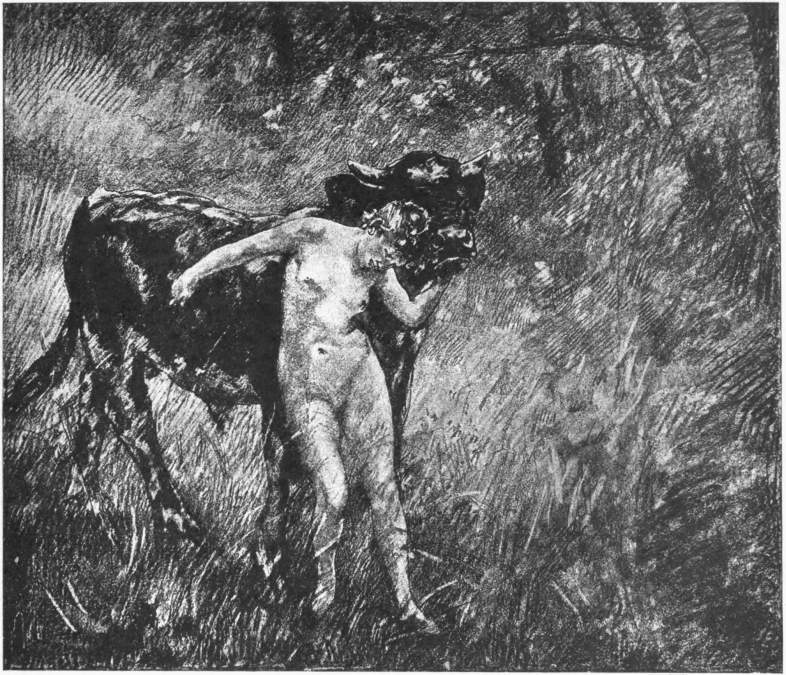 | |
| ROLL. | Gaz. des Beaux-Arts. THE WOMAN WITH A BULL. |
| (By permission of the Artist.) | |
On 14th December his body was brought up to the Eastern railway station. The coffin was covered with roses, white elder blossoms, and immortelles. And now he lies buried in Lorraine, in the little churchyard of Damvillers, where his father and grandfather rest beneath an old apple-tree. Red apple-blossoms he too loved so dearly. His importance Marie Baskirtscheff has summarised simply and gracefully in the words: “C’est un artiste puissant, originel, c’est un poète, c’est un philosophe; les autres ne sont que des fabricants de n’importe quoi à côté de lui.... On ne peut plus 270 rien regarder quand on voit sa peinture, parce que c’est beau comme la nature, comme la vie....”
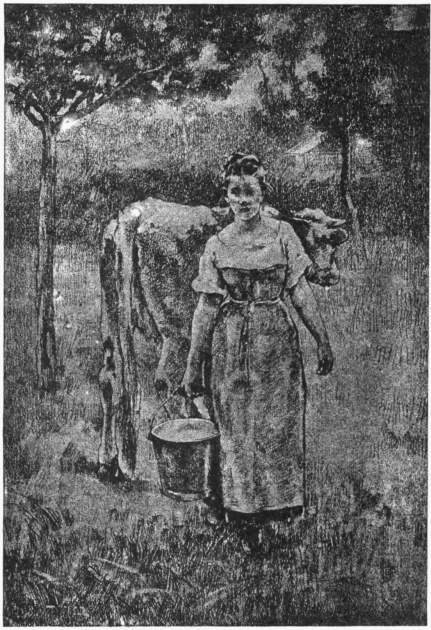 |
| Gaz. des Beaux-Arts. |
| ROLL. MANDA LAMÉTRIE, FERMIÈRE. |
This tender poetic trait which runs through his works is what principally distinguishes him from L’hermitte, the most sterling representative of the picture of peasant life at the present time. L’hermitte, also, like most of these painters of peasants, was himself the son of a peasant. He came from Mont-Saint-Père, near Château-Thierry, a quiet old town, where from the great “Hill of Calvary” one sees a dilapidated Gothic church and the moss-grown roofs of thatched houses. His grandfather was a vine-grower and his father a schoolmaster. He worked in the field himself, and, like Millet, he painted afterwards the things which he had done himself in youth. His principal works were pictures of reapers in the field, peasant women in church, young wives nursing their children, rustics at work, here and there masterly water-colours, pastels and charcoal drawings, in 1888 the pretty illustrations to André Theuriet’s Vie Rustique, the decoration of a hall at the Sorbonne with representations of rustic life, in his later period occasionally pictures from other circles of life, such as “The Fish-market of St. Malo,” “The Lecture in the Sorbonne,” “The Musical Soirée,” and finally, as a concession to the religious tendency of recent years, a “Christ visiting the House of a Peasant.” He has his studio in the Rue Vaquelin in Paris, though he spends most of his time in the village where he was born, and where he now lives quietly and simply with the peasants. Most of his works, which are to be ranked throughout amongst the most robust productions of modern Naturalism, are painted in the great glass studio which he built in the garden of his father’s house. Whilst Bastien-Lepage, through a certain softness of temperament, was moved to paint the weak rather than the strong, and less often men in the prime of life than patriarchs, women, and children, L’hermitte displays the peasant in all his rusticity. He knows the country and the 271 labours of the field which make the hands horny and the face brown, and he has rendered them in a strictly objective manner, in a great sculptural style. Bastien-Lepage is inclined to refinement and poetic tenderness; in L’hermitte everything is clear, precise, and sober as pale, bright daylight.
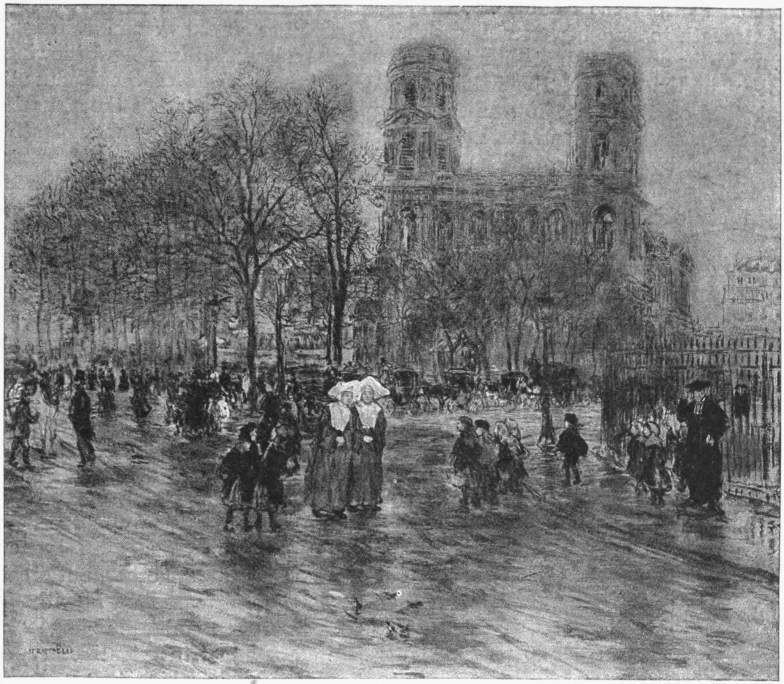 | |
| RAFFAELLI. | Cassell & Co. PLACE ST. SULPICE. |
| (By permission of the Artist.) | |
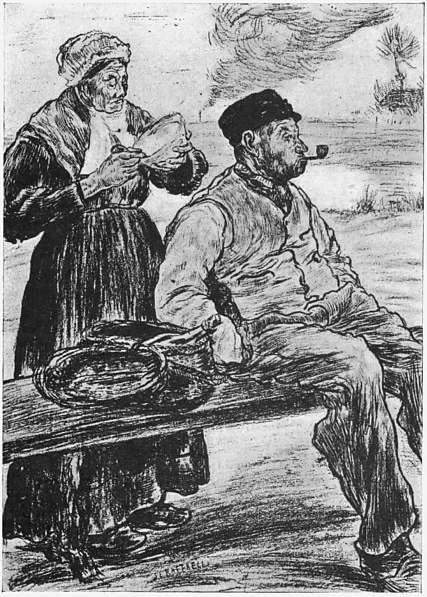 |
| Gaz. des Beaux-Arts. |
| RAFFAELLI. THE MIDDAY SOUP. |
| (By permission of the Artist.) |
Alfred Roll was born in Paris, and the artisan of the Parisian streets is the chief hero of his pictures. Like Zola in his Rougon-Macquart series, he set before himself the aim of depicting the social life of the present age in a great sequence of pictures—the workmen’s strike, war, and toil. His pictures give one the impression that one is looking down from the window upon an agitated scene in the street. And his broad, plebeian workmanship is in keeping with his rough and democratic subjects. He made a beginning in 1875 with the colossal picture of the “Flood at Toulouse.” The roofs of little peasants’ houses rise out of the expanse of water. Upon one of them a group of country people have taken refuge, and are awaiting a boat which 272 is coming from the distance. A young mother summons her last remnant of strength to save her trembling child. Beside her an old woman is sitting, sunk in the stupor of indifference, while in front a bull is swimming, bellowing wildly in the water. The influence of Géricault’s “Raft of the Medusa” is indeed obvious; but how much more plainly and actually has the struggle for existence been represented here, than by the great Romanticist still hampered by Classicism. The devastating effect of the masses of water in all their elemental force could not have been more impressively rendered than has been done through this bull struggling for life with all its enormous strength.
In technique this picture belongs to the painter’s earlier phase. Even in the colouring of the naked figures it has still the dirty heaviness of the Bolognese. This bond which united him to the school of Courbet was broken when—probably under the influence of Zola’s Germinal—he painted “The Strike,” in 1880. The stern reality which goes through Zola’s accounts of the life of pit-men is likewise to be found in these ragged and starving figures, clotted with coal dust, assembling in savage desperation before the manufactory walls, prepared for a rising. The dull grey of a rainy November morning spreads above. In 1887 he painted war, war in the new age, in which one man is not pitted against another, but great masses of men, who kill without seeing one another, are made to manœuvre with scientific accuracy—war in which the balloon, distant signalling, and all the discoveries of science are turned to account. “Work” was the last picture of the series. There are men toiling in the hot, dusty air of Paris with sandstones of all sizes. Life-size, upon life-size figures, the drops of sweat were seen upon the apathetic faces, and the patches upon the blouses and breeches. Any one who only reckons as art what is fine and delicate will necessarily find these pictures brutal; but whoever delights in seeing art in close connection with the age, as it really is, cannot deny to Alfred 273 Roll’s great epics of labour the value of artistic documents of the first rank.
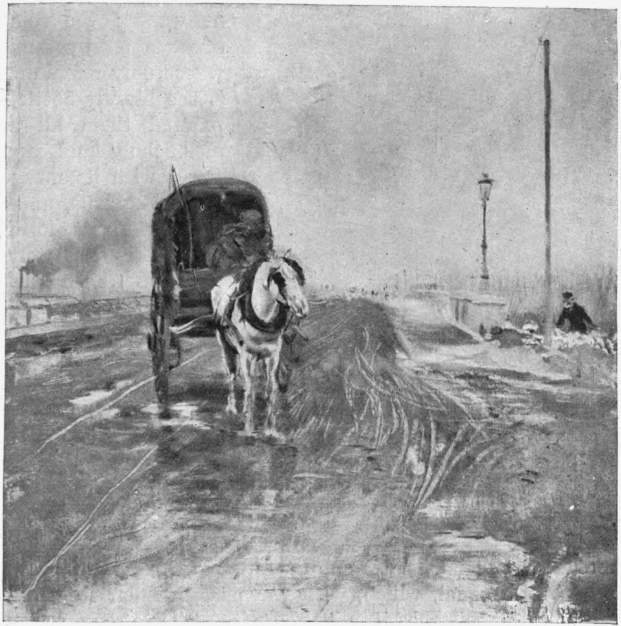 | |
| RAFFAELLI. | Studio. THE CARRIER’S CART. |
| (By permission of the Artist.) | |
He devoted himself to the more delicate problems of light, especially in certain idyllic summer scenes, in which he delighted in painting life-size bulls and cows upon the meadow, and beside them a girl, sometimes intended as a milkmaid and sometimes as a nymph. Of this type was the picture of 1888, A Woman returning from Milking, “Manda Lamétrie, Fermière.” With a full pail she is going home across the sunny meadow. Around there is a gentle play of light, a soft atmosphere transmitting faint reflections, lightly resting upon all forms, and mildly shed around them. A yet more subtle study of light in 1889 was named “The Woman with a Bull.” Pale sunbeams are rippling through the fluttering leaves, causing a delicious play of fine tones upon the nude body of the young woman and the shining hide of the bull.
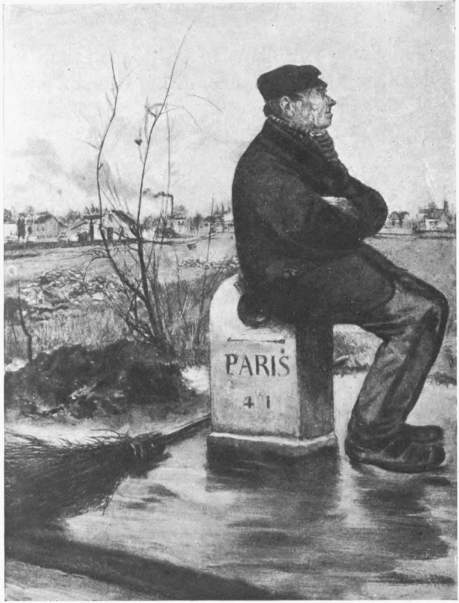 |
| Baschet. |
| RAFFAELLI. PARIS 4K. 1. |
| (By permission of the Artist.) |
On a strip of ground in the suburbs of Paris, where the town has come to an end and the country has not yet begun, Raffaelli, perhaps the most spirited of the Naturalists, has taken up his abode. He has painted the 274 workman, the vagabond, the restlessness of the man who does not know where he is going to eat and sleep; the small householder, who has all he wants; the ruined man, overtaken by misfortune, whose only remaining passion is the brandy-bottle,—he has painted them all amid the melancholy landscape around Paris, with its meagre region still in embryo, and its great straight roads losing themselves disconsolately in the horizon. Théophile Gautier has written somewhere that the geometricians are the ruination of landscapes. If he lived in these days he would find, on the contrary, that those monotonous roads running straight as a die give landscape a strange and melancholy grandeur. One thinks of the passage in Zola’s Germinal, where the two socialists, Étienne and Suwarin, walk in the evening silently along the edge of a canal, which, with the perpendicular stems of trees at its side, stretches for miles, as if measured with a pair of compasses, through a monotonous flat landscape. Only a few low houses standing apart break the straight line of the horizon; only here and there, in the distance, does there emerge a human being, whose diminished figure is scarcely perceptible above the ground. Raffaelli was the first to understand the virginal beauty of these localities, the dumb complaining language of poverty-stricken regions spreading languidly beneath a dreary sky. He is the painter of poor people and of wide horizons, the poet and historian of humanity living in the neighbourhood of great cities. There sits a house-owner, or the proprietor of a shop, in front of his own door; there a pedlar, or a man delivering parcels, hurries across the field; there a rag-picker’s dog strays hungry about a lonely farmyard. Sometimes the wide landscapes are relieved by the manufactories, water and gas-works which feed the huge crater of Paris. At other times the snow lies on the ground, the skeletons of trees stand along the high-road, and a driver shouts to his team; the heavy cart-horses covered with worsted cloths, shiver, and an impression of intense cold strikes through you to your 275 very bones. Indeed, Raffaelli’s austerity was first subdued a little when he came to make a lengthy residence in England. Then he acquired a preference for the light-coloured atmosphere and the gracious verdure of nature in England. He began to take pleasure in tender spring landscapes, in place of rigid scenes of snow. The poor soil no longer seems so hard and inhospitable, but becomes attractive beneath the soft, peaceful, bluish atmosphere. Even the uncivilised beings, with famine in their eyes, who wandered about in his earliest pictures, become milder and more resigned. The grandfather, in his blouse and wooden shoes, leads his grandchild by the hand amid the first shyly budding verdure. Old men sit quietly in the grounds of the alms-house, with the sun shining upon them. People no longer stand in the mist of November evenings with their teeth chattering from the frost, but breathe with delight the soft air of bright spring mornings.
 | |
| RAFFAELLI. | THE HIGHROAD TO ARGENTEUIL. |
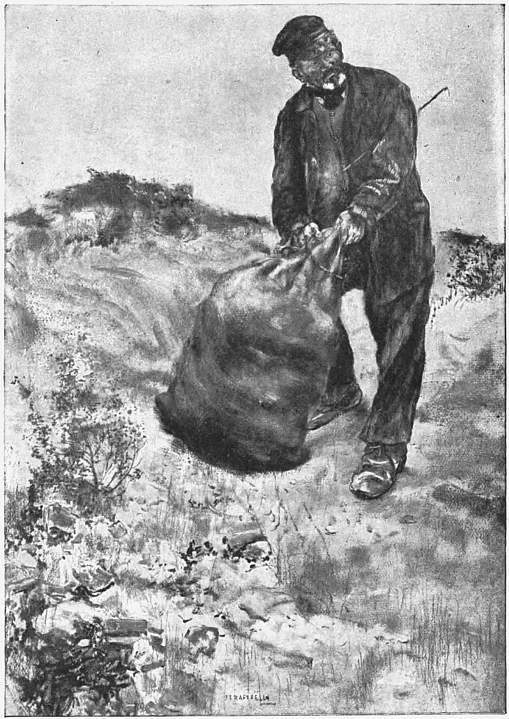 |
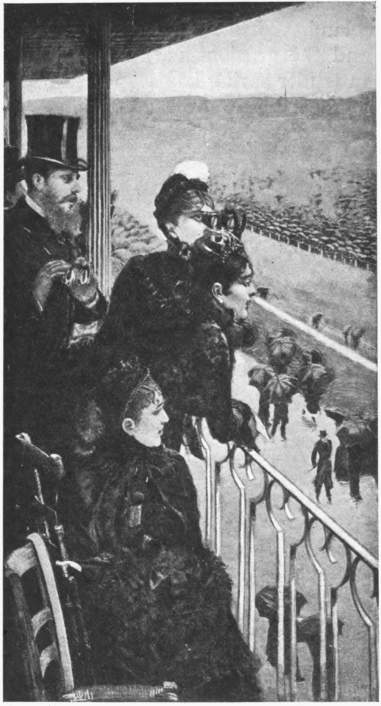 | ||
| Studio. | Gaz. des Beaux-Arts. | ||
| RAFFAELLI. | LE CHIFFONIER. | DE NITTIS. | PARIS RACES. |
| (By permission of the Artist.) | |||
Raffaelli, for fifteen years the master of this narrowly circumscribed region, has recorded his impressions of it in an entirely personal manner, in a style which in one of his brochures he has himself designated “caractérisme.” And by comparing the costumed models in the pictures of the previous generation with the figures of Raffaelli, the happiness of this phrase is at once understood. In fact, Raffaelli is a great master of characterisation, and perhaps nowhere more trenchant than in the illustrations which he drew for the Revue Illustrée. Spirited caricatures of theatrical representations alternate with the grotesque figures of the Salvation Army. Yet he feels most in his element when he dives into the horrors of Paris by night. The types which he has created live; they meet 276 you at every step, wander about the boulevards in the cafés and outside the barriers, and they haunt you with their looks of misery, vice, and menace.
Giuseppe de Nittis, an Italian turned a Parisian, a bold, searching, nervously excitable spirit, was the first gentilhomme of Impressionism, the first who made a transition from the rugged painting of the proletariat to coquettish pictures from the fashionable quarters of the city, and reconciled even the wider public to the principles of Impressionism by the delicate flavouring of his works.
“It was a cold November morning. Cold it was certainly, but in compensation the morning vapour was as fine as snow turned into mist. Yonder in the crowded, populous, sooty quarters of the city, in Paris busy with trade and industry, this early vapour which settles in the broad streets is not to be found; the hurry of awakening life, and the confused movement of country carts, omnibuses, and heavy, rattling freight-waggons, have scattered, divided, and dispersed it too quickly. Every passer-by bears it away on his shabby overcoat, on his threadbare comforter, or disperses it with his baggy gloves. It dribbles down the shivering blouses and the waterproofs of toiling poverty, it dissolves before the hot breath of the many who have passed a sleepless or dissipated night, it is absorbed by the hungry, it penetrates into shops which have just been opened, into gloomy backyards, and it floats up the staircases, dripping on the walls and banisters, right up to the frozen attics. And that is the reason why so little of it remains outside. But in the spacious and stately quarter of Paris, upon the broad boulevards planted with trees and the empty quays the mist lay undisturbed, section over section, like an undulating mass of transparent wool in which one felt isolated, hidden, almost imbedded in splendour, for the sun rising lazily on the distant horizon already shed a mild purple glow, and in this light the mist level with the tops of the houses shone like a piece of muslin spread over scarlet.”
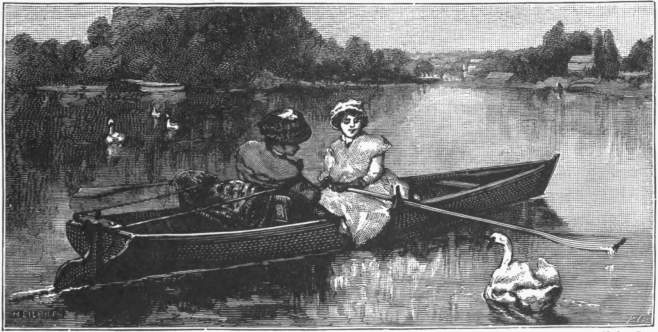 | |
| Cassell & Co. | |
| HEILBUTH. | FINE WEATHER. |
This opening passage in Daudet’s Le Nabab most readily gives the mood awakened by Giuseppe do Nittis’ Parisian landscapes. De Nittis was born in 1846 at Barletta, near Naples, in poor circumstances. In 1868, when he was two-and-twenty years of age, he came to Paris, where Gérôme and Meissonier interested themselves in him. Intercourse with Manet led him to his range of subject. He became the painter of Parisian street-life as it is to be seen in the neighbourhood of the quays, the painter of mist, smoke, and air. The Salons of 1875 and 1876 contained his first pictures, the “Place des Pyramides” and the view of the Pont Royal, fine studies of mist with a tremulous grey atmosphere, out of which graceful little figures raise their faint, vanishing outlines. From that time he has stood at the centre of artistic life in Paris. He observed everything, saw everything, painted everything—a strip of the boulevards, the Place du Carrousel, the Bois de Boulogne, the races, the Champs Elysées, in the daytime with the budding chestnuts, the flower-beds blooming in all colours, the playing fountains, the women of grace and beauty, and the light carriages which crowd between the Arc de Triomphe, the Obelisk, and the Gardens of the Tuileries, and in the evening when chains of white and coloured lights flash among the dark trees. De Nittis has interpreted all atmospheric phases. He seized the intangible, the vibration of vapour, the dust of summer, and the rains of December days. He breathed the atmosphere, as it were, with his eyes, and felt with accuracy its greater or its diminished density. The great public he gained by his exquisite sense of feminine elegance. Of marvellous charm are the figures which give animation to the Place des Pyramides, the Place du Carrousel, the Quai du Pont Neuf—women in the most coquettish toilettes, men chatting together as they lean against a newspaper kiosk, flower-girls offering bouquets, loiterers carelessly turning over the books exposed for sale upon a stall, bonnes with short petticoats and broad ribbons, smart-looking boys with hoops, and little girls with the air of great ladies. Since 278 Gabriel de Saint Aubin, Paris has had no more faithful observer. “De Nittis,” said Claretie in 1876, “paints modern French life for us as that brilliant Italian, the Abbé Galliani, spoke the French language—that is to say, better than we do it ourselves.”
 |
| L’Art. |
| ULYSSE BUTIN. |
The summit of his ability was reached in his last pictures from England. One knows the London fogs of November, which hover over the town as black as night, so that the gas has to be lit at noon, fogs which are suffocating and shroud the nearest houses in a veil of crape. Scenes like this were made for de Nittis’ brush. He roamed about in the smoke of the city, observed the fashion of the season, the confusion of cabs and drays upon London Bridge, the surge and hurry of the human stream in Cannon Street, the vast panorama of the port of London veiled with smoke and fog, the fashionable West End with its magnificent clubs, the green, quiet squares and great, plainly built mansions; he studied the dense smoky atmosphere of fog compressed into floating phantom shapes, the remarkable effects of light seen when a fresh breeze suddenly drives the black clouds away. And again his eye adapted itself at once to the novel environment. It was not merely the blithe splendour of Paris that found an incomparable painter in Giuseppe de Nittis, but London also with its thick atmosphere and that mixture of damp, tawny fog and grey smoke. Piccadilly, the National Gallery, the railway bridge at Charing Cross, the Green Park, the Bank, and Trafalgar Square are varied samples of these English studies, which showed British painters themselves that not one of them had understood the foggy atmosphere of London as this tourist who was merely travelling through the town. “Westminster” and “Cannon Street,” a pair of dreary, sombre symphonies in ash-grey, perhaps display the highest of what De Nittis has achieved in the painting of air.
Born in Hamburg, though a naturalised Frenchman, Ferdinand Heilbuth took up again the cult of the Parisienne in the wake of Stevens, and as he turned the acquisitions of Impressionism to account in an exceedingly pleasing 279 manner he seems, in comparison with Stevens, lighter and more vaporous and gracious. He painted water-scenes, scenes on the greensward or in the entrance squares of châteaux, placing in these landscapes girls in fashionable summer toilette. He was particularly fond of representing them in a white hat, a white or pearl-grey dress with a black belt and long black gloves, in front of a bright grey stream, seated upon a fallen trunk, with a parasol resting against it. The bloom of the atmosphere is harmonised in the very finest chords with the virginal white of their dresses and the fresh verdure of the landscapes. His pictures are little Watteaus of the nineteenth century, as discreet in effect as they are piquant.
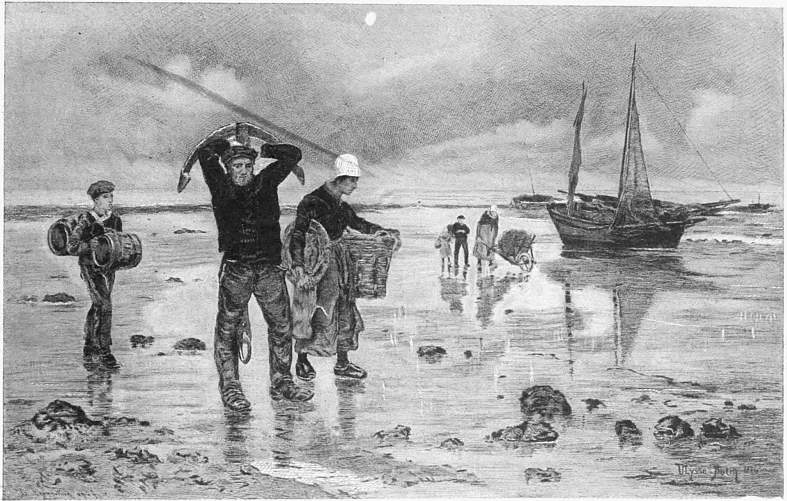 | |
| L’Art. | |
| BUTIN. | THE DEPARTURE. |
After Heilbuth’s death Albert Aublet, who in earlier days depicted sanguinary historical pieces, became the popular painter of girls, whose beauties are gracefully interpreted in his pictures. When he paints the composer Massenet, sitting at the piano surrounded by flowers and beautiful women,—when he represents the doings of the fashionable world on the shore at a popular watering-place, or young ladies plucking roses, or wandering meditatively in bright dresses amid green shrubs and yellow flowers, or going into the sea in white bathing-gowns, there may be nothing profound or particularly artistic in it all, but it is none the less charming, attractive, bright, joyous, and fresh.
Jean Béraud, another interpreter of Parisian elegance, has found material for numerous pictures in the blaze of the theatres, the naked shoulders of 280 ballet-girls, the dress-coats of old gentlemen, the evening humour of the boulevards, the mysteries of the Café Anglais, the bustle of Monte Carlo, and the footlights of the Café-Concert. But absolute painter he is not. One would prefer to have a less oily heaviness in his works, a bolder and freer execution more in keeping with the lightness of the subject, and for this one would willingly surrender the touches of genre which Béraud cannot let alone even in these days. But his illustrations are exceedingly spirited.
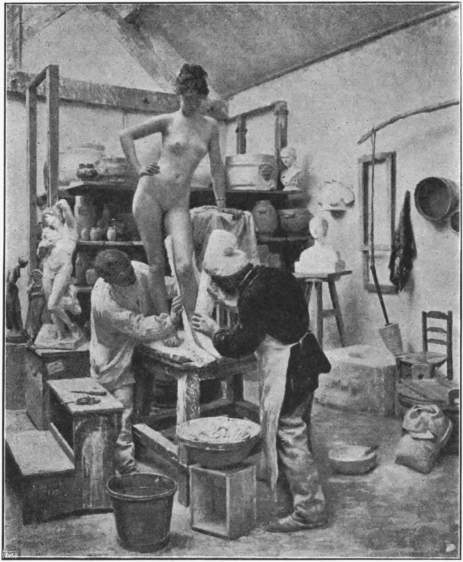 |
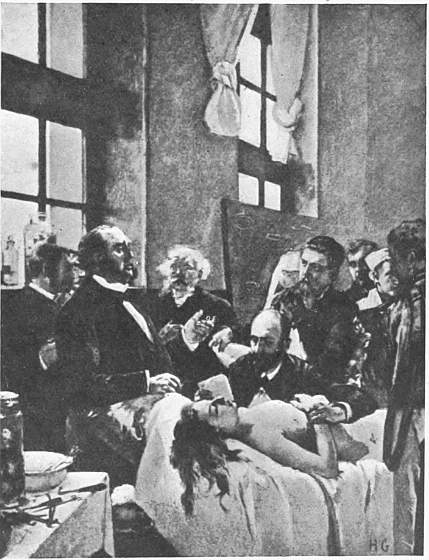 | ||
| Hanfstaengl. | Gaz. des Beaux-Arts. | ||
| DANTAN. | A PLASTER CAST FROM NATURE. | GERVEX. | DR. PÉAN AT LA SALPÉTRIÈRE. |
| (By permission of the Artist.) | |||
It would be impossible to classify painters according to further specialties. In fact, it is as little possible to bring individuals into categories as it was at the time of the Renaissance, when the painter busied himself at the same time with sculpture, architecture, and the artistic crafts. Great artists do not wall themselves up in a narrow space to be studied. Liberated from the studio and restored to nature, they endeavour, as in the best periods of art, to encompass life as widely as possible. A mere enumeration, such as chance offers, and such as will preserve a sense for the individuality of every man’s talent without attempting comparisons, seems therefore a better method to pursue than a systematic grouping which could only be attained artificially and by ambiguities.
The late Ulysse Butin settled down on the shore of the Channel and painted the life of the fishermen of Villerville, a little spot upon the coast near Honfleur. Sturdy, large-boned fellows drag their nets across the strand, carry heavy anchors ashore, or lie smoking upon the dunes. The rays of the evening sun play upon their clothes; the night falls, and a profound silence rests upon the landscape.
By preference Édouard Dantan has painted the interiors of sculptors’ studios—men turning pots, casting plaster, or working on marble, with grey blouses, contrasting delicately with the light grey walls of workrooms which are themselves flooded with bright and tender light. Very charming was “A Plaster Cast from Nature,” painted in 1887: in the centre was a nude 281 female figure most naturally posed, whilst a fine, even atmosphere, which lay softly upon the girl’s form, streaming gently over it, was shed around.
Having cultivated in the beginning the province of feminine nudity with little success, in such pictures as “The Bacchante” of the Luxembourg, “The Woman with the Mask,” and “Rolla,” Henri Gervex, the spoilt child of contemporary French painting, turned to the lecture-rooms of the universities, and by his picture of Dr. Péan at La Salpétrière gave the impulse to the many hospital pictures, surgical operations, and so forth which have since inundated the Salon. With the upper part of her body laid bare and her lips half opened, the patient lies under the influence of narcotics, whilst Péan’s assistant is counting her pulse. His audience have gathered round. The light falls clear and peacefully into the room. Everything is rendered simply, without diffidence, and with confidence and quietude.
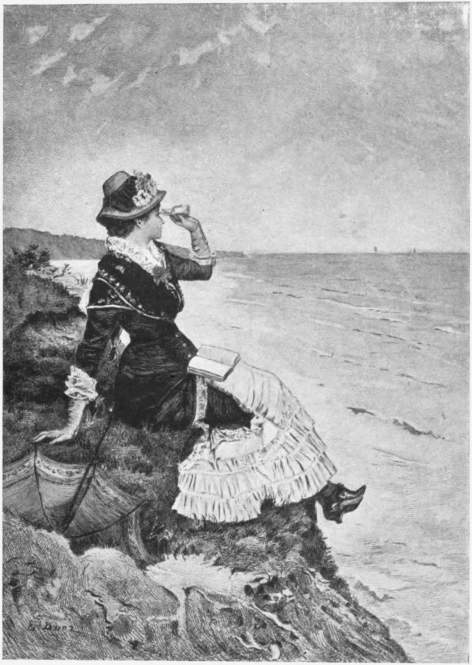 |
| L’Art. |
| DUEZ. ON THE CLIFF. |
Duez, when he had had his first success in 1879 with a large religious picture—the triptych of Saint Cuthbert in the Luxembourg—appeared with animal pictures, landscapes, portraits, or fashionable representations of life in the streets and cafés. In the hands of such mild and complacent spirits as Friant and Goeneutte, Naturalism fell into a mincing, lachrymose condition; but in a series of quiet, unpretentious pictures Dagnan-Bouveret was more successful in meeting the growing inclination of recent years for contemplative repose, just as in the province of literature Ohnet, Malot, and Claretie, with their spirit of compromise, came after those stern naturalists Flaubert and Zola. According to the drawing of Paul Renouard, Dagnan-Bouveret is a little, black-haired man with a dark complexion and deep-set eyes, a short blunt nose, and a black pointed beard. There is nothing in him which betrays spirit, caprice, and audacity, but everything which is an indication of patience and endurance; and, as a matter of fact, such are the qualities by which he has gained his high position. He is a man of poetic 282 talent, though rather tame, and stands to Bastien-Lepage and Roll as Breton to Millet. One often fancies that it is possible to observe in him that German Gemüth, that genial temper, for the satisfaction of which Frau Marlitt provided in fiction. A pupil of Gérôme, he made his first great success in the Salon of 1879 with the picture “A Wedding at the Photographer’s.” This was succeeded in 1882 by “The Nuptial Benediction”; in 1883 by “The Vaccination”; in 1884 by “The Horse-pond” of the Musée Luxembourg; in 1885 by a “Blessed Virgin,” a homely, thoughtful, and delicately coloured picture which gained him many admirers in Germany; and in 1886 by “The Consecrated Bread,” in which he was one of the first to take up the study of light in interiors. In a Catholic church there are sitting devout women—most of them old, but also one who is young—and children, while an acolyte is handing them consecrated bread. This simple scene in the damp village church, filled with a tender gloom, is rendered with a winning homely plainness, and with that touch of compassionate sentimentality which is the peculiar note of Dagnan-Bouveret. The “Bretonnes au Pardon” of 1889 thoroughly displayed this definitive Dagnan: a soft, peaceful picture, full of simple and cordial poetry. In the grass behind the church, the plain spire of which rises at the end of a wall, women are sitting, both young and old, in black dresses and white caps. One of them is reading a prayer from a devotional book. The rest are listening. Two men stand at the side. Everything is at peace; the scheme of colour is soft and quiet, while in the execution there is something recalling Holbein, and the effect is idyllically moving like the chime of a village bell when the sun is going down.
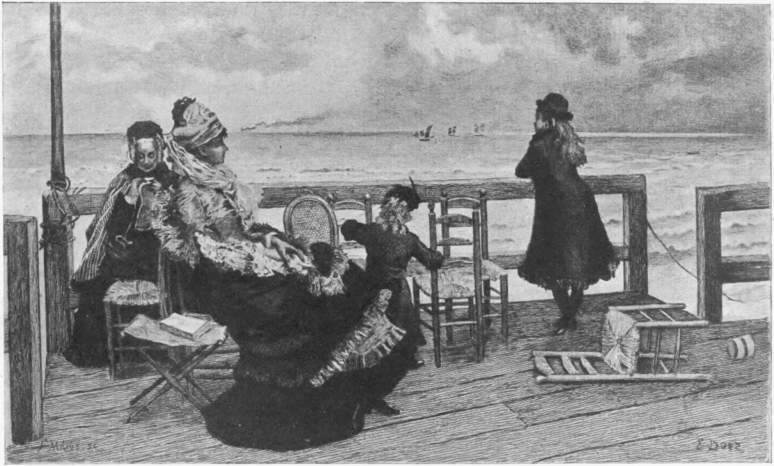 | |
| DUEZ. | L’Art THE END OF OCTOBER. |
| (By permission of the Artist.) | |
The zeal with which painters took up the study of contemporary life, so long neglected, did not, however, 283 prevent the quality of French landscape painting from being exceedingly high. New parts of the world were no longer to be conquered. For fifteen years none of the nobler, nor of the less noble, landscapes of France had been neglected, nor any strip of field; there were no flowers that were not plucked, whether they were cultivated in forcing-houses or had sprung pallid in a dark garden of old Paris. It was only the joy in brightness and the newly discovered beauty of sunshine that brought with them any change of material. Following the Impressionists, the landscape painters deserted their forests. Those “woodland depths,” such as Diaz and Rousseau painted, seldom appear in the works of the most modern artists. In the severest opposition to such once popular scenes there lies the plain, the wide expanse stretching forth like a carpet in bright, shining tones under the play of tremulous sunbeams, and scarcely do a few trees break the quiet line of the distant horizon. At first the poorest and most humble corners were preferred. The painting of the poor brought even the most forlorn regions into fashion. Later, in landscape also, a bent towards the most tender lyricism corresponded with that inclination to idyllic sentiment which was on the increase in figure painting. These painters have a peculiar joy in the fresh mood of morning, when a light vapour hovers over the meadows and the waters, before it is dissolved into shining dew. They love the bloom of fruit-trees and the first smile of spring, or revel in the gradations of the dusk, rich as they are in shades of tint, mistily wan and grey, pale lilac, delicate green, and milky blue. The perspective is broad and fine; objects are entirely absorbed by the harmony of colour, and the older and coarser treatment of 284 free light heightened to the most refined play by the most delicate shades of hue. And these colourists deriving from Corot, with their soft grey enveloping all, are opposed by others who strike novel and higher chords upon the keyboard of Manet—landscape painters whom such simple and intimate things do not satisfy, but who search after unexpected, fleeting, and extraordinary impressions, analysing fantastically combined effects of light.
 |
| L’Art. |
| DAGNAN-BOUVERET. CONSECRATED BREAD. |
A group of New-Impressionists, who might be called prismatic painters, stand in this respect at the extreme left. Starting from the conviction that the traditional mixing of colours upon the palette results after all only in palette tones, and can never fully express the intensity and pulsating vividness of tone-values, they founded the theory of the resolution of tones,—in other words, they break up all compound colours into their primary hues, set these directly upon the canvas, and leave it to the eye of the spectator to undertake the mixture for itself. In particular George Seurat was an energetic disseminator of this painting in points which excited new discussions amongst artists and new polemics in the newspapers. His pictures were entirely composed of flaming, glowing, and shining patches. Close to these pictures nothing was to be seen but a confusion of blotches, but at the proper distance they took shape as wild sea-studies in the brilliant hues of noon, with rocks and stones standing out in relief, orgies of blue, red, and violet. Such was Seurat’s manner of seeing nature. That such a course brings with it a good deal of monotony, that it will hardly ever be possible to quicken art to this extent with science, is incontestable. But it is just as certain that Seurat was a painter of distinction who shows in many of his pictures a fine sense for delicate, pale atmosphere. Many of his landscapes, which at close quarters look like mosaics of small, smooth, variously coloured stones, acquire a vibrating light, such as 285 Monet himself did not attain, when looked at from a proper distance. Signac, Anquetin, Angrand, Lucien Pissarro, Coss, Luèc, Rysselberghe, and Valtat are the names of the other representatives of this scientific painting, and their method has not seldom enabled them to give expression in an overpowering manner to the quiet of water and sky, the green of the meadows, and the softness of tender light shifting over the sea.
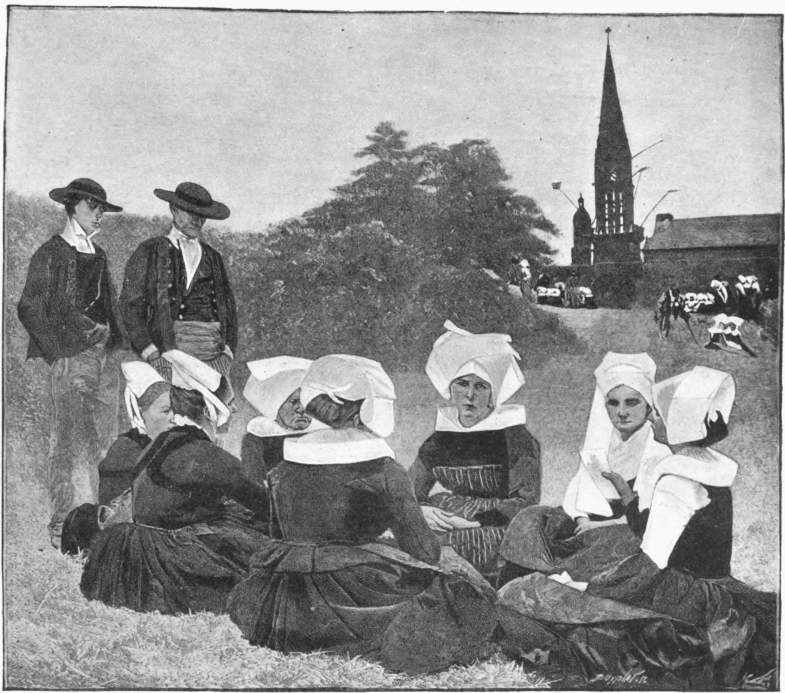 | |
| DAGNAN-BOUVERET. | L’Art. BRETONNES AU PARDON. |
| (By permission of the Artist.) | |
When these “spotted” pictures hang in a room where they are fewer in number than ordinary paintings they are difficult to understand. Only the disadvantages of such a method of painting are noticed; the disagreeable spottiness of the little points of colour ranged unpleasantly side by side, and putting one in mind of a piece of embroidery work, does not exactly appeal to the artist who looks for beautiful lines and belle pâte in a picture. Nevertheless, the method would scarcely have found so many exponents did it not afford an opportunity to get certain effects which are scarcely obtainable in any other way. As a matter of fact, one finds in these pictures a sense of 286 life, such shimmering, glimmering effects, such tremulous, vibrating light, as could not be arrived at without this disintegration of colour into separate points. Moreover, they have at a distance a decorative effect that leaves other pictures far behind.
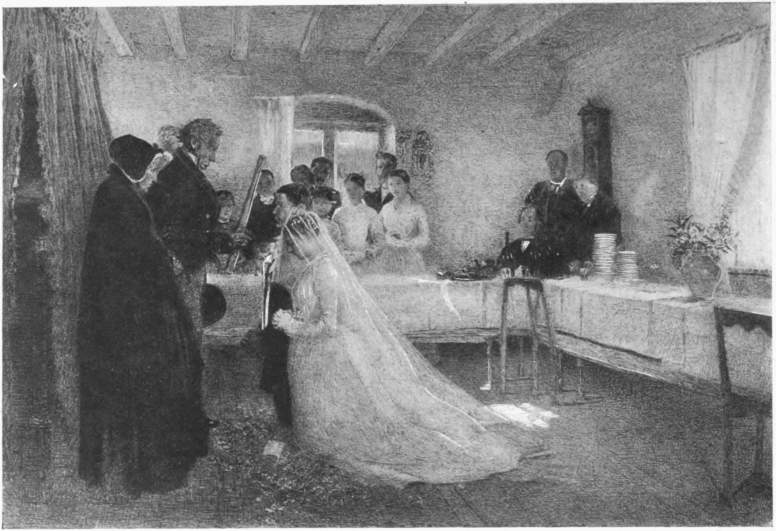 | |
| DAGNAN-BOUVERET. | Gaz. des Beaux-Arts. THE NUPTIAL BENEDICTION. |
| (By permission of Messrs. Boussod, Valadon & Co., the owners of the copyright.) | |
The importance of Neo-Impressionism, therefore, depends on two particulars. First, in the analysis of light it has carried the principles of Impressionism to their furthest limit; secondly, in the matter of decorative effect it has laid aside one great fault of Impressionism, and has given us pictures which, seen from a distance, take on a definite form instead of a blur of indistinct tones.
Amongst the younger painters exhibiting in the Salon, Pointelin—without any trace of imitation—perhaps comes nearest to the tender poetry of Corot, and has with most subtlety interpreted the delicate charm of cold moods of morning, the deep feeling of still solitude in a wide expanse. Jan Monchablon views the meadow and the grass, the blades and variegated flowers of the field, with the eyes of a primitive artist. Wide stretches of rolling ground upon radiant spring days are usually to be seen in his pictures. The sun shines, the grass sparkles, and the horizon spreads boundless around. In the background cows are grazing, or there move small figures bathed in air, whilst a dreamy rivulet murmurs in the foreground. The bright, soft light of 287 Provence is the delight of Montenard, and he depicts with delicacy this landscape with its bright, rosy hills, its azure sky, and its pale underwood. Light, as he sees it, has neither motes nor shadows; its vibration is so intense and fine that it fills the air with liquid gold, and absorbs the tints of objects, wrapping them in a soft and mystic golden veil.
Dauphin, who is nearly allied with him, always remains a colourist. His painting is more animated, provocative, and blooming, especially in those sea-pieces with their bright harbours, glittering waves, and rocking ships with their sails shimmering and coquetting in the sunshine. The name of Rosset-Granget recalls festal evenings, houses all aglow with lights and fireworks, or red lanterns shedding forth their gleam into the dark blue firmament, and reflected with a thousand fine tints in the sea.
 |
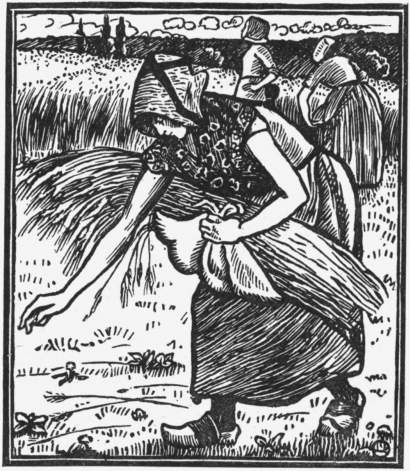 | ||
| Dial. | |||
| LUCIEN PISSARRO. | SOLITUDE (WOODCUT). | LUCIEN PISSARRO. | RUTH (WOODCUT). |
| (By permission of Messrs. Hacon & Ricketts, the owners of the copyright.) | |||
The melancholy art of Émile Barau, a thoroughly rustic painter, who renders picturesque corners of little villages with an extremely personal accent, stands in contrast with the blithe painting of the devotees of light; it is not the splendour of colour that attracts him, but the dun hues of dying nature. He has come to a halt immediately in front of Paris, in the square before the church of Creile. He knows the loneliness of village streets when the people are at work in the fields, and the houses give a feeling that their inhabitants are not far off and may return at any moment. His pictures are harmonies in grey. The leading elements in his works are the pale light lying upon colourless autumn sward, the mournful outlines of leafless trees stretching their naked boughs into the air as though complaining, small still ponds where ducks are paddling, the scanty green of meagre gardens, the muddy waters of old canals, reddish-grey roofs and narrow little streets amid moss-covered hills, tall poplars and willows by the side of swampy ditches, and in the background the old village steeple, which is scarcely ever absent. Damoye, likewise, is fond of twilight, and autumn and winter evenings. He is the poet of the great plains and dunes and the sombre heaven, where isolated sunbeams break shyly from behind white clouds. A fine sea-painter, Boudin, studies in Etretat, Trouville, Saint Valery, Crotoy, and Berck the dunes and the misty sky, spreading in cold northern grey across the silent sea. Dumoulin paints night landscapes with deep blue shadows and bright blue lights, while Albert 288 Lebourg has a passion for the grey of rain and the glittering snow which gleams in the light, blue in one place, violet and rosy in another. Victor Binet and Réné Billotte have devoted themselves to the study of that poor region, still in embryo, which lies around Paris, a region where a delicate observer finds so much that is pictorial and so much hidden poetry. Binet is so delicate that everything grows nobler beneath his brush. He specially loves to paint the poetry of twilight, which softens forms and tinges the trees with a greyish-green, the quiet, monotonous plains where tiny footpaths lose themselves in mysterious horizons, the expiring light of the autumn sun playing with the fallen yellow leaves upon dusty highways. Réné Billotte’s life is exceedingly many-sided. In the forenoon he is an important ministerial official, in the evening the polished man of society in dress-clothes and white tie whom Carolus Duran painted. Of an afternoon, in the hours of dusk and moonrise, he roams as a landscape painter in the suburbs of Paris; he is an exceedingly accomplished man of the world, who only speaks in a low tone, and what he specially loves in nature, too, is the hour when moonlight lies gently and delicately over all forms. The scenes he usually chooses are a quarry with light mist settling over it, a light-coloured cornfield in a bluish dusk, a meadow bathed in pale light, or a strip of the seashore where the delicate air is impregnated with moisture.
To be at once refined and true is the goal which portrait painting in recent years has also specially set itself to reach. In the years of chic it started with the endeavour to win from every personality its beauties, to paint men and women “to advantage”; but later, when the Naturalism of Bastien-Lepage stood at its zenith, it strove at all costs to seize the actual human being, to catch, as it were, the work-a-day character of the personality as it is in involuntary moments when people believe themselves to be unobserved and give up posing. The place of those pompous arrangements of the painters of material was taken by a soul, and temperament interpreted by an intelligence. And corresponding with the universal principle of conceiving man and nature as an indivisible whole, it became imperative in portrait painting no longer to place persons before an arbitrary background, but in their real surroundings—to 289 paint the man of science in his laboratory, the painter in his studio, the author at his work-table—and to observe with accuracy the atmospheric influences of this environment.
 | |
| BOUDIN. | THE PORT OF TROUVILLE. |
| (By permission of M. Durand-Ruel, the owner of the copyright.) | |
The ready master-worker of this plain and sincere naturalism in portrait painting was peculiarly Fantin-Latour, who ought not merely to be judged by his latest paintings, which have something petrified, rigid, gloomy, and professorial. In his younger days he was a solid and powerful artist, one of the soundest and simplest of whom France could boast. His pictures were dark in tone and harmonious, and had a puritanic charm. The portrait of Manet, and that of the engraver Edwin Edwards and his wife, in particular, will always preserve their historical value.
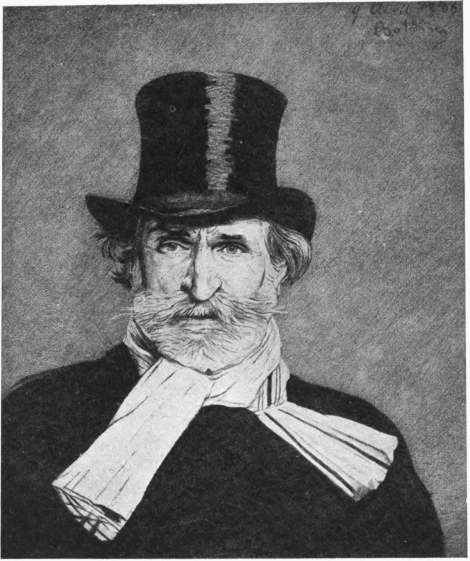 |
| L’Art. |
| BOLDINI. GIUSEPPE VERDI. |
Later, when the whole bias of art tended away from the poorer classes, and once more approached this fashionable world, portrait painting also showed a tendency to become exquisite and over-refined, and to exhibit a preference for symphonic arrangements of colour and subtilised effects of light. White, light yellow, and light blue silks were harmonised upon very delicate scales with pearly-grey backgrounds. Ladies in mantles of light grey fur and rosy dresses stand amid dark-green shrubs, in which rose-coloured lanterns are burning, or they sit in a ball-dress near a lamp which produces manifold and tender transformations of light upon the white of the silk.
The work of Jacques Émile Blanche, the son of the celebrated mad-doctor, is peculiarly characteristic of these tendencies of French portrait painting. It is well known that English fashion was at this time regarded in Paris as the height of elegance, while Anglicisms were entering more and more into the French language; and this tendency of taste gave Blanche the occasion for most æsthetic pictures. The English Miss, in her attractive mixture of affectation and naïveté, in all her slim and long-footed grace, has found a delicate interpreter in him. Tall ladies clad in white, bitten with the Anglomania, drink tea most æsthetically, and sit there bored, or are grouped round the piano; gommeux, neat, straight, chic, from their tall hats to their patent-leather boots, look wearily about the world, with an eyeglass fixed, a yellow rose in their buttonhole, and a thick stick in the gloved hand. Amongst his portraits of well-known personalities, much notice was attracted by that of his father in 1890—a modern Bertin the Elder, and in 1891 by that of Maurice Barrès, a portrait in which he has analysed the author of Le Jardin de Bérénice in a very simple and convincing fashion.
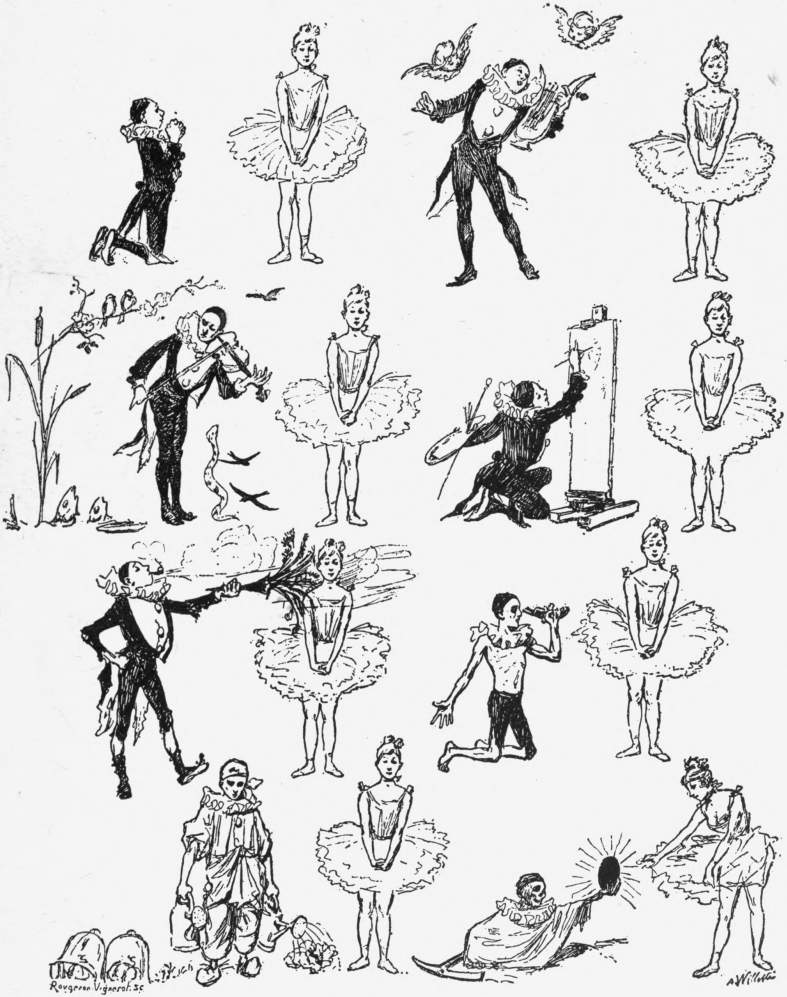 | |
| Quantin, Paris. | |
| WILLETTE. | THE GOLDEN AGE. |
The brilliant Italian Boldini brought to this English chic the manual volubility of a Southerner: sometimes he was microscopic à la Meissonier, sometimes a juggler of the brush à la Fortuny, and sometimes he gave the most seductive mannerism and the most diverting elegance to his portraits of ladies. Born in 1845, the son of a painter of saints, Boldini had begun as a Romanticist with pictures for Scott’s Ivanhoe. From Ferrara he went to Florence, where he remained six years. At the end of the sixties he emerged in London, and, after he had painted Lady Holland and the Duchess of Westminster there, he soon became a popular portrait painter. But since 1872 his home has been Paris, where the fine Anglo-Saxon aroma, the “æsthetic” originality of his pictures, soon became an object of universal admiration. In his portraits of women Boldini always renders what is most novel. It is as if he knew in advance the new fashion which the coming season would bring. His trenchantly cut figures of ladies in white dresses and with black gloves have a defiant and insolent effect, and yet one which is captivating through their ultra-modern chic. The portraits of Carolus Duran have nothing of that charm which makes such an appeal to the nerves, nothing of that discomposing indefinable quality which lies in the expression and gestures of a fashionable woman, whose eccentricity reveals every day fresh nuances of beauty. He had not the faculty of seizing movement, the most difficult element in the world. But Boldini’s pictures seem like bold and sudden sketches which clinch the conception with spirit and swiftness in liberal, pointed crayon strokes controlled by keen observation. There is no ornament, no bracelet, no pillars and drapery. One hears the silken bodice rustle over the tightly laced corset, sees the mobile foot, and the long train swept to the side with a bold movement. Sometimes his creations are full and luxuriant, nude even in their clothes, excited and full of movement; sometimes they are bodiless, as if compact of the air, pallid and half-dead with the strain of nights of festivity, “living with hardly any blood in their veins, in which the pulse beats almost entirely out of complaisance.”
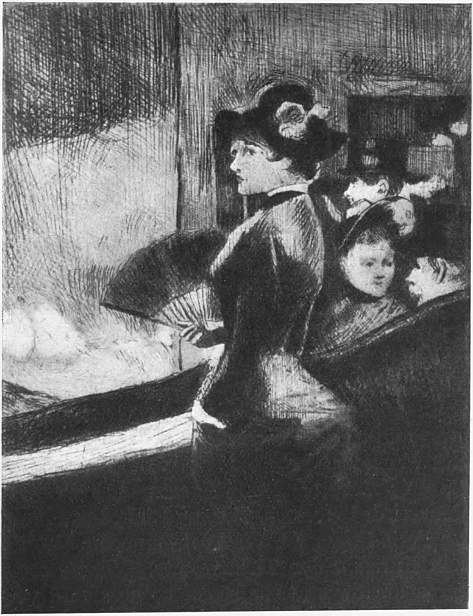 |
| FORAIN. AT THE FOLIES-BERGÈRES. |
| (By permission of M. Durand-Ruel, the owner of the copyright.) |
His pictures of children are just as subtle: there is an elasticity in these little girls with their widely opened velvet eyes, their rosy young lips, and their poses calculated with so much coquetry. Boldini has an indescribable method of seizing a motion of the head, a mien, or a passing flash of the eyes, of arranging the hair, of indicating coquettish lace underclothing beneath bright silk dresses, or of showing the grace and fineness of the slender leg of a girl, encased in a black silk stocking, and dangling in delicate lines from a light grey sofa. There is French esprit, something piquant and with a double meaning in his art, which borders on the indecorous and is yet charming. These portraits of ladies, however, form but a small portion of his work. He paints in oils, in water-colour, 294 and pastel, and is equally marvellous in handling the portraits of men, the street picture and the landscape. His portrait of the painter John Lewis Brown, crossing the street with his wife and daughter, looked as though it had been painted in one jet. In his little pictures of horses there is an astonishing animation and nervous energy. M. Faure, the singer, possesses some small rococo pictures from his brush, scenes in the Garden of the Tuileries, which might have come from Fortuny. His pictures from the street life of Paris—the Place Pigalle, the Place Clichy—recall De Nittis, and some illustrations—scenes from the great Paris races—might have been drawn by Caran D’Ache.
There is no need to treat illustration in greater detail, because, naturally, it could no longer play the initiative part which fell to it in earlier days, now that the whole of life had been drawn within the compass of pictorial representation. Besides, in an epoch like our own, which is determined to know and see and feel everything, illustration has been so extended that it would be quite impossible even to select the most important work. Entirely apart from the many painters who occasionally illustrated novels or other books, such as Bastien-Lepage, Gervex, Dantan, Détaille, Dagnan-Bouveret, Ribot, Benjamin Constant, Jean Paul Laurens, and others, there are a number of professional draughtsmen in Paris, most of whom are really distinguished artists.
In particular, Chéret, one of the most original artists of our time—Chéret, the great king of posters, the monarch of a fabulously charming world, in which everything gleams in blue and red and orange, cannot be passed over in a history of painting. The flowers which he carelessly strews on all sides with his spendthrift hand are not destined for preservation in an historical herbarium; his works are transient flashes of spirit, brilliantly shining, ephemera, but a bold and subtle Parisian art is concealed amid this improvisation. Settled for many years in London, Jules Chéret had there already drawn admirable placards, which are now much sought after by collectors.
In 1866 he introduced this novel branch of industry into France, and gave it—thanks to the invention of machines which admit of the employment of the largest lithographic stones—an artistic development which could not have been anticipated. He has created many thousands of posters. The book-trade, the great shops, and almost all branches of industry owe their success to him. His theatrical posters alone are amongst the most graceful products of modern art: La Fête des Mitrons, La Salle de Frascati, Les Mongolis, Le Chat Botté, L’Athénée Comique, Fantaisies Music-Hall, La Fée Cocotte, Les Tsiganes, Les Folies-Bergères en Voyage, Spectacle Concert de l’Horloge, Skating Rink, Les Pillules du Diable, La Chatte Blanche, Le Petit Faust, La Vie Parisienne, Le Droit du Seigneur, Cendrillon, Orphée aux Enfers, Éden Théâtre, etc. These are mere posters, destined to hang for a few days at the street corners, and yet in graceful ease, sparkling life, and coquettish bloom of colour they surpass many oil paintings which flaunt upon the walls of the Musée Luxembourg.
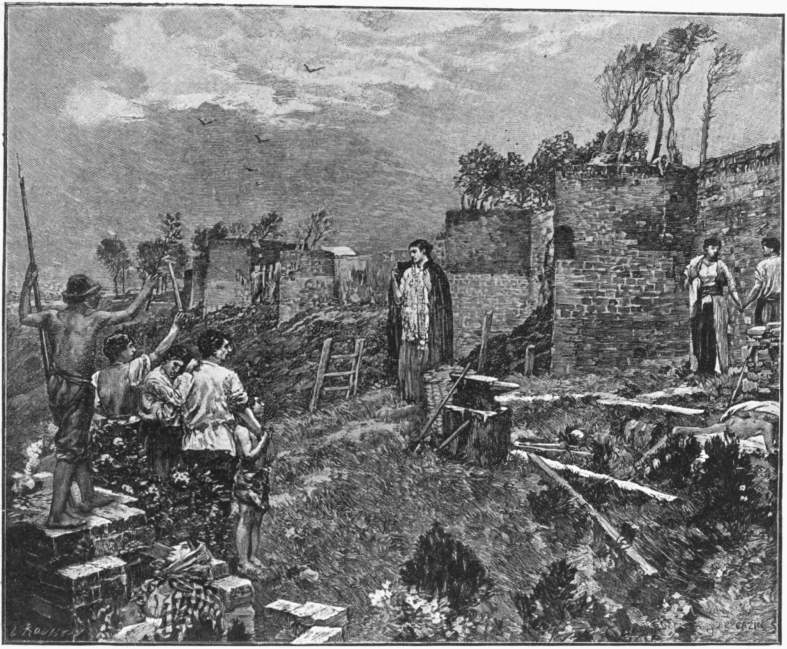 | |
| Baschet. | |
| CAZIN. | JUDITH. |
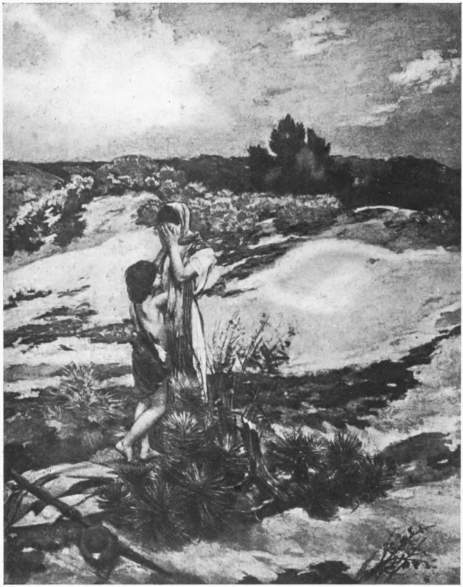 |
| Baschet. |
| CAZIN. HAGAR AND ISHMAEL. |
Amongst the illustrators Willette is perhaps the most charming, the most brilliant in grace, fancy, and spirit. A drawing by him is something living, light, and fresh. Only amongst the Japanese, or the great draughtsmen of the rococo period, does one find plates of a charm similar to Willette’s tender poems of the “Chevalier Printemps” or the “Baiser de la Rose.” At the same time there is something curiously innocent, something primitive, naïve, something like the song of a bird, in his charming art. No one can laugh with such youthful freshness. No one has such a childlike fancy. Willette possesses the curious gift of looking at the world like a boy of sixteen with eyes that are not jaded for all the beauty of things, with the eyes of a schoolboy in love for the first time. He has drawn angels for Gothic windows, battles, and everything imaginable; nevertheless, woman is supreme over his whole work, ruined and pure as an angel, cursed and adored, and yet always enchanting. She is Manon Lescaut, with her soft eyes and angelically pure sins. She has something of the lovely piquancy of the woman of Brantôme, when she disdainfully laughs out of countenance poor Pierrot, who sings his serenades to her plaintively in the moonlight. One might say that 296 Willette is himself his Pierrot, dazzled with the young bosoms and rosy lips: at one time graceful and laughing, wild as a young fellow who has just escaped from school; at another earnest and angry, like an archangel driving away the sinful; to-day fiery, and to-morrow melancholy; now in love, teasing, blithe, and tender, now gloomy and in mortal trouble. He laughs amid tears and weeps amid laughter, singing the Dies Iræ after a couplet of Offenbach; himself wears a black-and-white garment, and is, at the same time, mystic and sensuous. His plates are as exhilarating as sparkling champagne, and breathe the soft, plaintive spirit of old ballads.
Beside this amiable Pierrot Forain is like the modern Satyr, the true outcome of the Goncourts and Gavarni, the product of the most modern decadence. All the vice and grace of Paris, all the luxury of the world, and all the chic of the demi-monde he has drawn with spirit, with bold stenographical execution, and the elegance of a sure-handed expert. Every stroke is made with trenchant energy and ultimate grace. Adultery, gambling, chambres séparées, carriages, horses, villas in the Bois de Boulogne; and then the reverse side—degradation, theft, hunger, the filth of the streets, pistols, suicide,—such are the principal stages of the modern epic which Forain composed; and over all the Parisienne, the dancing-girl, floats with smiling grace like a breath of beauty. His chief field of study is the promenade of the Folies-Bergères—the delicate profiles of anæmic girls singing, the heavy masses of flesh of gluttonising gourmets, the impudent laughter and lifeless eyes of prostitutes, the thin waists, lean arms, and demon hips of fading bodies laced in silk. Little dancing-girls and fat roués, snobs with short, wide overcoats, huge collars, and long, pointed shoes—they all move, live, and exhale the odour of their own peculiar atmosphere. There is spirit in the line of an overcoat which Forain draws, in the furniture of a room, in the hang of a fur or a silk dress. He is the master of the light, fleeting seizure of the definitive line. Every one of his plates is like a spirited causerie, which is to be understood through nods and winks.
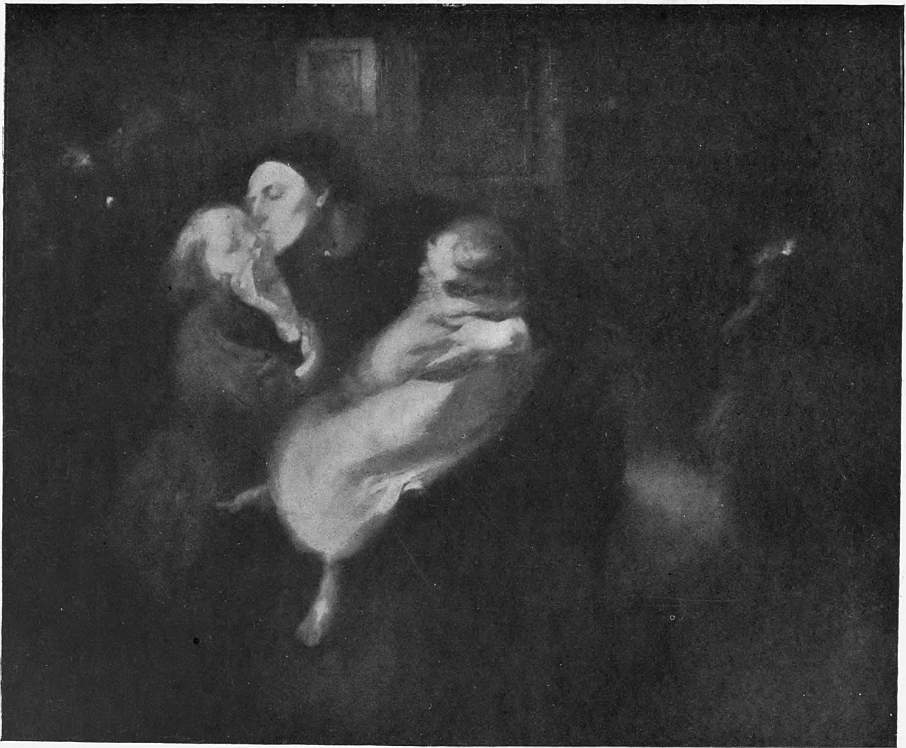 | |
| CARRIÈRE. | MOTHERHOOD. |
The name of Paul Renouard is inseparable from the opera. Degas had already painted the opera and the ballet-dancers with wonderful reality, fine irony, or in the weird humour of a dance of death. But Renouard did not imitate Degas. As a pupil of Pils he was one of the many who, in 1871, were occupied with the decoration of the staircase of the new opera house, and through this opportunity he obtained his first glance into this capricious and mysterious world made up of contrasts,—a world which henceforward became his domain. All his ballet-dancers are accurately drawn at their rehearsals, but the charm of their smile, of their figures, their silk tights, their gracious movements, has something which almost goes beyond nature. Renouard is a realist with very great taste. Girls practising at standing on the tips of their toes, dancing, curtseying, and throwing kisses to the audience are broadly and surely drawn with a few strokes. The opera is for him a universe in a nutshell—a résumé of Paris, where all the oddities, all the wildness, and all the sadness of modern life are to be found.
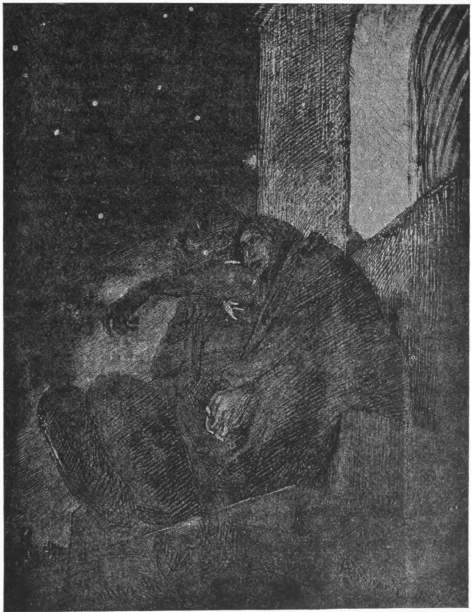 |
| Gaz. des Beaux-Arts. |
| BESNARD. EVENING. |
Mention must also be made of Daniel Vierge, torn prematurely from his art by a cruel disease, but not before he had been able to complete his masterpiece, the edition of Don Pablo de Segovia. Henri de Toulouse-Lautrec too must be named, the grim historian of absinthe dens, music halls and dancing saloons; and we must give a passing glance to Léandre and Steinlen, in whose drawings also the whole of Parisian life breathes and pulsates, with all the glitter of over-civilisation, with all its ultra-refinement of pleasure. But a detailed appreciation of these draughtsmen is obviously out of place in a history of painting.
If we turn back to those who have done good work in the province of painting pure and simple, we must tarry for a while with that refined painter of elegiac 300 landscape, Charles Cazin. He awaits us as the evening gathers, and tells with a vibrating voice of things which induce a mood of gentle melancholy. He has his own hour, his own world, his own men and women. His hour is that secret and mystic time when the sun has gone down and the moon is rising, when soft shadows repose upon the earth and bring forgetfulness. The land he enters is a damp, misty land with dunes and pale foliage, one that lies beneath a heavy sky and is seldom irradiated by a beam of hope, a land of Lethe and oblivion of self, a land created to yield to the tender colour of infinite weariness. The motives of his landscapes are always exceedingly simple, though they have a simplicity which is perhaps forced, instead of being entirely naïve. He represents, it may be, the entrance into a village with a few cottages, a few thin poplars, and reddish tiled roofs, bathed in the pale shadows of evening. Upon the broad street lined with irregular houses, in a provincial town, the rain comes splashing down. Or it is night, and in the sky there are black clouds, with the moon softly peering between them. Lamps are gleaming in the windows of the houses, and an old post-chaise rolling heavily over the slippery pavement. Or dun-green shadows repose upon a solitary green field with a windmill and a sluggish stream. The earth is wrapt in mysterious silence, and there is movement only in the sky, where a flash of lightning quivers—not one that blazes into intensely vivid light, but rather a silvery white electric spark lambent in the dark firmament. Corot alone has painted such things, but where he is joyous Cazin is elegiac. The little solitary houses are of a ghostly grey. The trees sway towards each other as if in tremulous fear. And the mist hangs damp in the brown boughs. Faint evening shadows flit around. A Northern malaria seems to prevail. At times a sea-bird utters a wailing complaint. One thinks of Russian novels, Nihilism, and Raskolnikoff, though I know not through what association of ideas. One is disposed to sit by the wayside and dream, as Verlaine sings:—
| “La lune blanche Luit dans les bois; De chaque branche Part une voix. L’étang reflète, Profond miroir, La silhouette Du saule noir Où le vent pleure: Rêvons c’est l’heure. Un vaste et tendre Apaisement Semble descendre Du firmament Que l’astre irise: C’est l’heure exquise.” |
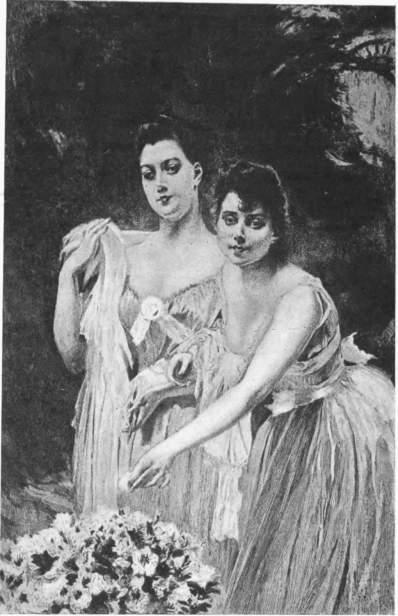 |
| Gaz. des Beaux-Arts. |
| BESNARD. PORTRAIT OF MLLES. D. |
Sometimes the humour of the landscape is associated with the memory of kindred feelings which passages in the Bible or in old legends have awakened in him. In such cases he creates the biblical or mythological pictures which have principally occupied him in recent years. Grey-green dusk rests upon the earth; the shadows of evening drive away the last rays of the sun. A mother with her child is sitting upon a bundle of straw in front of a thatched cottage with a ladder leaning against its roof, and a poverty-stricken yard bordered by an old paling, while a man in a brown mantle stands beside her, leaning upon a stick: this picture is “The Birth of Christ.” Two solitary people, a man and a woman, are walking through a soft, undulating country. The sun is sinking. No house will give the weary wanderers shelter in the night, but the shade of evening, which is gradually descending, envelops them with its melancholy peace: this is “The Flight into Egypt.” An arid waste of sand, with a meagre bush rising here and there, and the parching summer sun brooding sultry overhead, forms the landscape of the picture “Hagar and Ishmael.” Or the fortifications of a mediæval town are represented. Night is drawing on, watch-fires are burning, brawny figures stand at the anvil fashioning weapons, and the sentinels pace gravely along the moat. The besieged town is Bethulia, and the woman who issues with a wild glance from the town gateway is Judith, going forth followed by her handmaid to slay Holofernes. Through such works Cazin has become the creator of the landscape of religious sentiment, which has since occupied so much space in French and German painting. The costume belongs to no time in particular, though it is almost more appropriate to the present than to bygone ages; but something so biblical, so patriarchal, such a remote and mystical poetry is expressed in the great lines of the landscape that the figures seem like visions from a far-off past.
The continuation of this movement is marked by that charming artist who delighted in mystery, Eugène Carrière, “the modern painter of Madonnas,” 302 as he has been called by Edmond de Goncourt. Probably no one before him has painted the unconscious spiritual life of children with the same tender, absorbed feeling: little hands grasping at something, stammering lips of little ones who would kiss their mother, dreamy eyes gazing into infinity. But although young children at the beginning of life, whose eyes open wide as they turn towards the future, look out of his pictures, a profound sadness rests over them. His figures move gravely and silently in a soft, mysterious dusk, as though divided from the world of realities by a veil of gauze. All forms seem to melt, and fading flowers shed a sleepy fragrance around; it is as though there were bats flitting invisible through the air. Even as a portrait painter he is still a poet dreaming in eternal haze and a twilight of mystery. In his portraits, Alphonse Daudet, Geffroy, Dolent, and Edmond de Goncourt looked as though they had been resolved into vapour, although the delineation of character was of astonishing power, and marked firmly with a penetrative insight into spiritual life such as was shared by Ribot alone.
At the very opposite pole of art stands Paul Albert Besnard: amongst the worshippers of light he is, perhaps, the most subtle and forcible poet, a luminist who cannot find tones high enough when he would play upon the fibres of the spirit. Having issued from the École des Beaux-Arts, and gained the Prix de Rome with a work which attracted much notice, he had long moved upon strictly official lines; and he only broke from his academical strait-waistcoat about a dozen years ago, to become the refined artist to whom the younger generation do honour in these days, a seeker whose works vary widely in point of merit, though they always strike one afresh from the bold confidence with which he attacks and solves the most difficult problems of light. In Puvis de Chavannes, Cazin, and Carrière a reaction towards sombre effect and pale, vaporous beauty of tone followed the brightness of Manet; but Besnard, pushing forward upon Manet’s course, revels in the most subtle effects of illumination—effects not ventured upon even by the boldest Impressionists—endeavours to arrest the most unexpected and unforeseen phases of light, and the most hazardous combinations of colour. The ruddy glow of the fire glances upon faded flowers. Chandeliers and tapers outshine the soft radiance of the lamp; artificial light struggles with the sudden burst of daylight; and lanterns, standing out against the night sky like golden lights with a purple border, send their glistening rays into the blue gloom. It is only in the field of literature that a parallel may be found in Jens Pieter Jacobsen, who in his novels occasionally describes with a similar finesse of perception the reflection of fire upon gold and silver, upon silk and satin, upon red and yellow and blue, or enumerates the hundred tints in which the September sun pours into a room.
The portrait group of his children is a harmony in red. A boy and two girls are standing, with the most delightful absence of all constraint, in a country room, which looks out upon a mountainous landscape. The wall 303 of the background is red, and red the costume of the little ones, yet all these conflicting nuances of red tones are brought into harmonious unity with inherent taste. Rubens would have rejoiced over a second landscape exhibited in the same year. A nude woman is seated upon a divan drinking tea, with her feet tucked under her and her back to the spectator. Upon her back are cast the warm and the more subdued reflections of a fire which lies out of sight and of the daylight quivering in yellowish stripes, like a glowing aureole upon her soft skin.
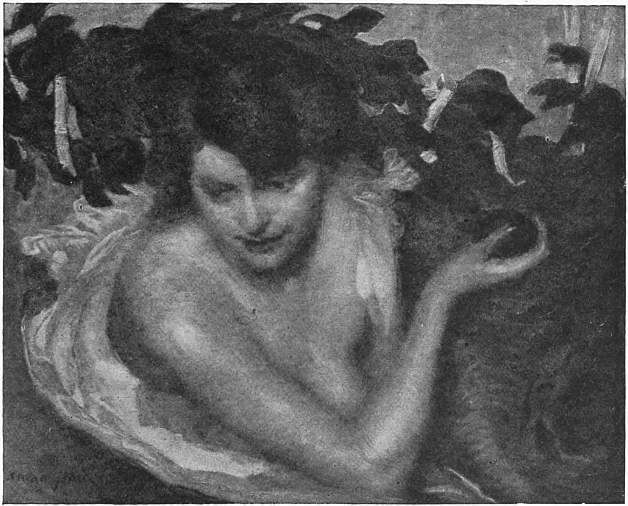 | |
| Studio. | |
| AMAN-JEAN. | SOUS LA GUERLANDA. |
In a third picture, called “Vision de Femme,” a young woman with the upper part of her form unclothed appears upon a terrace, surrounded by red blooming flowers and the glowing yellow light of the moon. Under this symbol Besnard imagined Lutetia, the eternally young, hovering over the rhododendrons of the Champs Elysées and looking down upon the blaze of lights in the Café des Ambassadeurs. In 1889 he produced “The Siren,” a symphony in red. A petite femme of Montmartre stands wearily in a half-antique morning toilette before a billowing lake, which glows beneath the rays of the setting sun in fiery red and dull mallow colour. In his “Autumn” of 1890 he made the same experiment in green. The moon casts its silvery light upon the changeful greenish mirror of a lake, and at the same time plays in a thousand reflections upon the green silk dress of a lady sitting upon the shore; while, in a picture of 1891, a young lady in an elegant négligé is seated at the piano, with her husband beside her turning over the music. 304 The light of the candles is shed over hands, faces, and clothes. Another picture, called “Clouds of Evening,” represented a woman with delicate profile amid a violet landscape over which the clouds were lightly hovering, touched with orange-red by the setting sun. The double portrait, executed in 1892, of the “Mlles. D——,” one of whom is leisurely placing a scarf over her shoulders with a movement almost recalling Leighton, while the other stoops to pick a blossom from a rhododendron bush, is exceedingly soft in its green, red, and blue harmony.
The French Government recognised the eminent decorative talent displayed in these pictures, and gave Besnard the opportunity of achieving further triumphs as a mural painter. Here, too, he is modern to his fingertips, knowing nothing of stately gestures, nothing of old-world naïveté; but merely through his appetising and sparkling play of colour he has the art of converting great blank spaces into a marvellous storied realm.
In 1890 he had to represent “Astronomy” as a ceiling-piece for the Salon des Sciences in the Hôtel de Ville. Ten years before there would have been no artist who would not have executed this task by the introduction of nude figures provided with instructive attributes. One would have held a globe, the second a pair of compasses, and the third a telescope in one hand, and in the other branches of laurel wherewith to crown Galileo, Columbus, or Kepler. Besnard made a clean sweep of all this. He did not forget that a ceiling is a kind of sky, and accordingly he painted the planets themselves, the stars which run their course through the firmament of blue. The figures of the constellations are arranged in a gracious interplay of light bodies floating softly past. Amongst the pictures of the École de Pharmacie a like effect is produced by Besnard’s great composition “Evening,” a work treated with august simplicity. The atmosphere is of a grey-bluish white: stars are glittering here and there, and two very ancient beings, a man and a woman, sit upon the threshold of their house, grave, weather-beaten forms of quiet grandeur, executed with expressive lines. The old man casts a searching glance at the stars, as if yearning after immortality, while the woman leans weary and yet contented upon his shoulder. In the room behind a kettle hangs bubbling over the fire, and a young woman with a child upon her arm steps through the door: man and the starry world, the finite and the infinite, presented under plain symbols.
 | |
| CARRIÈRE. | SCHOOLWORK. |
Such are, more or less, the representative minds of contemporary France, the centres from which other minds issue like rays. Alfred Agache devotes himself with great dexterity to an allegorical style after the fashion of Barroccio. Inspired by the pre-Raphaelites, Aman-Jean has found the model for his allegorical compositions in Botticelli, and is a neurasthenic in colour, which is exceptionally striking, in his delicate portraits of women. Maurice Denis, who drew the illustrations to Verlaine’s Sagesse in a style full of archaic bloom, as a painter takes delight in the intoxicating fragrance of incense, the gliding steps and slow, quiet movements of nuns, in men and women 305 kneeling before the altar in prayer, and priests crossing themselves before the golden statue of the Virgin. The Spaniard Gandara, who lives in Paris, displays in his grey and melting portraits much feeling for the decorative swing of lines. That spirited “pointillist” Henri Martin seems for the present to have reached a climax in his “Cain and Abel,” one of the most powerful creations of the younger generation in France. Louis Picard’s work has a tincture of literature, and he delights in Edgar Allan Poe, mysticism and psychology. Ary Renan, the son of Ernest Renan and the grandson of Ary Scheffer, has given the soft subdued tones of Puvis de Chavannes a tender Anglo-Saxon fragrance in the manner of Walter Crane. And that spirited artist in lithograph, Odilon Redon, has visions of distorted faces, flowers that no mortal eye has seen, and huge white sea-birds screaming as they fly across a black world. Forebodings like those we read of in the verse of Poe take shape in his works, ghosts roam in the broad daylight, and the sea-green eyes of Medusa-heads dripping with blood shine in the darkness of night with a mesmeric effect. Carlos Schwabe drew the illustrations for the Évangile de l’Enfance of Catulle Mendès with the charming naïveté of Hans Memlinc, and afterwards attracted attention by his delicate, archaic pictures.
Bonnard, Vuillard, Valloton and Roussel are others whose names have in the last few years become well known. Their art is built up on the foundation laid by the Impressionists only so far as they use the new colour-values discovered by the “bright painters,” in a free, harmonious manner, and place them at the service of a new decorative purpose. In exhibitions one is often at a loss how to view these decorative paintings, such, for instance, as those of Bonnard and Vuillard; the eye is astounded for a moment when, after looking at the usual array of good pictures, it suddenly comes upon works that look more like pieces of Gobelin tapestry than paintings. Then one’s mind reverts to rooms such as Olbrich, Van de Velde, or Josef Hoffmann designed with some particular purpose in view, and one understands the object of these pictures. “We can hang in our rooms any picture which is beautiful in itself and by itself.” That is the old familiar story, but that feeling never enters our minds when we stand in a mediæval room in which there are no pictures that can be taken away from their surroundings. It is a difficult task to arrange things that are individually beautiful into a harmonious whole. The realisation of the old-time principle is for obvious reasons well-nigh impracticable—the modern man is a restless, fickle creature; he must always be at liberty to pitch his tent anywhere—but we can surely make some approach to it. One may imagine in every dwelling a room in which furniture and pictures are made to fit into some conception of harmony, and the works of Bonnard and Vuillard may be conceived as parts of such a scheme for the decoration of a room, and indeed—though we must not forget similar attempts which have been made in other directions—as parts of a scheme which, though thoroughly modern and by no means a mere external copy, reverts to the style of bygone centuries.
From the historian’s standpoint these young artists scarcely come into question; they are still too much in the embryonic stage for any conclusion to be arrived at with respect to either of them. But the art lover who looks to the future rather than the past feels bound to follow with care their creations, in which the wealth of beauty that is already indicated in their first prints, the certainty of purpose with which they direct their efforts towards the point at which Impressionism has left the widest gap, seems to give a guarantee that in the future France will maintain in the province of art the position she has held during the nineteenth century as the leading artistic nation.

CHAPTER XXXV
SPAIN
Just as France to-day shows such a wealth of talent, Spain, correspondingly, can scarcely be said to come into the question of modern endeavour in art; in fact, it is quite impossible to treat of a history of Spanish art, one can only consider individual artists, for they each go their own way, working in different directions and without any concerted plan.
It was in the spring of 1870 that a little picture called “La Vicaria” was exhibited in Paris at the dealer Goupil’s. A marriage is taking place in the sacristy of a rococo church in Madrid. The walls are covered with faded Cordova leather hangings figured in gold and dull colours, and a magnificent rococo screen separates the sacristy from the middle aisle. Venetian lustres are suspended from the ceiling; pictures of martyrs, Venetian glasses in carved oval frames hang on the wall, richly ornamented wooden benches, and a library of missals and gospels in sparkling silver clasps, and shining marble tables and glistening braziers form part of the scene in which the marriage contract is being signed. The costumes are those of the time of Goya. As a matter of fact, an old beau is marrying a young and beautiful girl. With affected grace and a skipping minuet step, holding a modish three-cornered hat under his arm, he approaches the table to put his signature in the place which the escribano points out with an obsequious bow. He is arrayed in delicate lilac, while the bride is wearing a white silk dress trimmed with flowered lace, and has a wreath of orange blossoms in her luxuriant black hair. As a girl-friend is talking to her she examines with abstracted attention the pretty little pictures upon her fan, the finest she has ever possessed. A very piquant little head she has, with her long lashes and her black eyes. Then, in the background, follow the witnesses, and first of all a young lady in a swelling silk dress of the brightest rose-colour. Beside her is one of the bridegroom’s friends in a cabbage-green coat with long flaps, and a shining belt from which a gleaming sabre hangs. The whole picture is a marvellous assemblage of colours, in which tones of Venetian glow and strength, the tender pearly grey beloved of the Japanese, and a melting neutral brown, each sets off the other and give a shimmering effect to the whole.
The painter, who was barely thirty, bore the name of Mariano Fortuny, and was born in Reus, a little town in the province of Tarragona, on 11th June 1838. Five years after he had completed this work he died, at the age of thirty-six, on 21st November 1874. Short as his career was, it was, nevertheless, 308 so brilliant, his success so immense, his influence so great, that his place in the history of modern painting remains assured to him.
Like French art, Spanish art, after Goya’s death, had borne the yoke of Classicism, Romanticism, and academical influence by turns. In the grave of Goya there was buried for ever, as it seemed, the world of torreros, majas, manolas, monks, smugglers, knaves, and witches, and all the local colour of the Spanish Peninsula. As late as the Paris World Exhibition of 1867, Spain was merely represented by a few carefully composed, and just as carefully painted, but tame and tedious, historical pictures of the David or the Delaroche stamp—works such as had been painted for whole decades by José Madrazo, J. Ribera y Fernandez, Federigo Madrazo, Carlo Luis Ribera, Eduardo Rosales, and many others whose names there is no reason for rescuing from oblivion. They laboured, meditating an art which was not their own, and could not waken any echo in themselves. Their painting was body without soul, empty histrionic skill. As complete darkness had rested for a century over Spanish art, from the death of Claudio Coellos in 1693 to the appearance of Goya, rising like a meteor, so the first half of the nineteenth century produced no single original artist until Fortuny came forward in the sixties.
He grew up amid poor surroundings, and when he was twelve years of age he lost his father and mother. His grandfather, an enterprising and adventurous joiner, had made for himself a cabinet of wax figures, which he exhibited from town to town in the province of Tarragona. With his grandson he went on foot through all the towns of Catalonia, the old man showing the wax figures which the boy had painted. Whenever he had a moment free the latter was drawing, carving in wood, or modelling in wax. It chanced, however, that a sculptor saw his attempts, spoke of them in Fortuny’s birthplace, and succeeded in inducing the town to make an allowance of forty-two francs a month to a lad whose talent had so much promise. By these means Fortuny was enabled to attend the Academy of Barcelona for four years. In 1857, when he was nineteen years of age, he received the Prix de Rome, and set out for Rome itself in the same year. But whilst he was copying the pictures of the old masters there a circumstance occurred which set him upon another course. The war between Spain and the Emperor of Morocco determined his future career. Fortuny was then a young man of three-and-twenty, very strong, rather thick-set, quick to resent an injury, taciturn, resolute, and accustomed to hard work. His residence in the East, which lasted from five to six months, was a discovery for him—a feast of delight. He found the opportunity of studying in the immediate neighbourhood a people whose life was opulent in colour and wild in movement; and he beheld with wonder the gleaming pictorial episodes so variously enacted before him, and the rich costumes upon which the radiance of the South glanced in a hundred reflections. And, in particular, when the Emperor of Morocco came with his brilliant suite to sign the treaty of peace, Fortuny developed a feverish activity. 309 The great battle-piece which he should have executed on the commission of the Academy of Barcelona remained unfinished. On the other hand, he painted a series of Oriental pictures, in which his astonishing dexterity and his marvellously sensitive eye were already to be clearly discerned: the stalls of Moorish carpet-sellers, with little figures swarming about them, and the rich display of woven stuffs of the East; the weary attitude of old Arabs sitting in the sun; the sombre, brooding faces of strange snake-charmers and magicians. This is no Parisian East, like Fromentin’s; every one here speaks Arabic. Guillaumet alone, who afterwards interpreted the fakir world of the East, dreamy and contemplative in the sunshine, has been equally convincing.
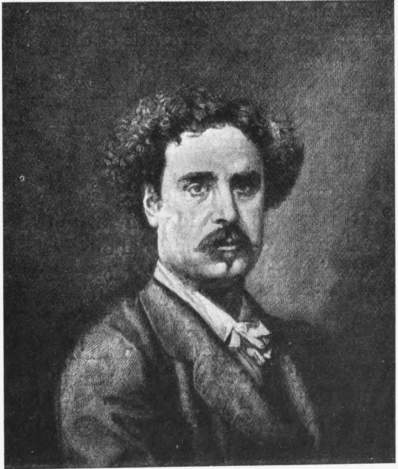 |
| L’Art. |
| MARIANO FORTUNY. |
Yet Fortuny first discovered his peculiar province when he began, after his return, to paint those brilliant kaleidoscopic rococo pictures with their charming play of colour, the pictures which founded his reputation in Paris. Even in the earliest, representing gentlemen of the rococo period examining engravings in a richly appointed interior, the Japanese weapons, Renaissance chests, gilded frames of carved wood, and all the delightful petit-riens from the treasury of the past which he had heaped together in it, were so wonderfully painted that Goupil began a connection with him and ordered further works. This commission occasioned his journey, in the autumn of 1866, to Paris, where he entered into Meissonier’s circle, and worked sometimes at Gérôme’s. Yet neither of them exerted any influence upon him at all worth mentioning. The French painter in miniature is probably the father of the department of art to which Fortuny belongs; but the latter united to the delicate execution of the Frenchman the flashing, gleaming spirit of the Latin races of the South. He is a Meissonier with esprit recalling Goya. In his picture “The Spanish Marriage” (La Vicaria) all the vivid, throbbing, rococo world, buried with Goya, revived once more. While in his Oriental pieces—“The Praying Arab,” “The Arabian Fantasia,” and “The Snake Charmers”—he still aimed at concentration and unity of effect, this picture had something gleaming, iridescent and pearly, which soon became the delight of all collectors. Fortuny’s successes, his celebrity, and his fortune dated from that time. His fame flashed forth like a meteor. After fighting long years in vain, not for recognition, but for his very bread, he suddenly became the most honored painter of the 310 day, and began to exert upon a whole generation of young artists that powerful influence which survives even at this very day.
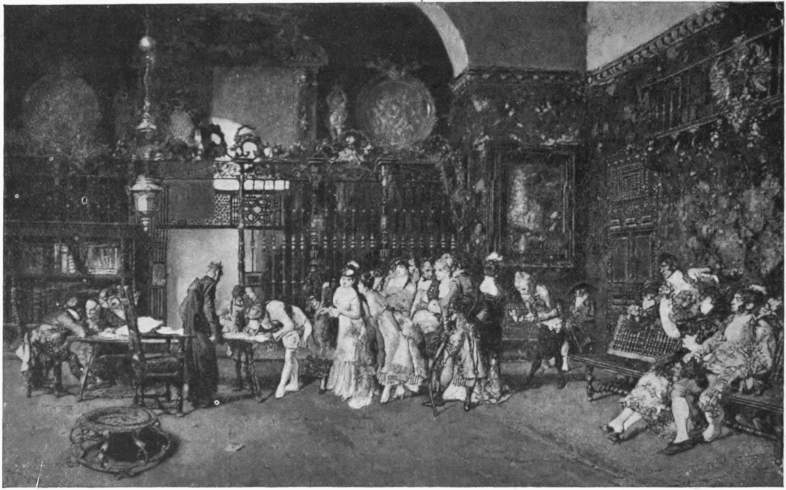 | |
| FORTUNY. | THE SPANISH MARRIAGE (LA VICARIA). |
| (By permission of Messrs. Goupil & Co., the owners of the copyright.) | |
The studio which he built for himself after his marriage with the daughter of Federigo Madrazo in Rome was a little museum of the most exquisite products of the artistic crafts of the West and the East: the walls were decorated with brilliant oriental stuffs, and great glass cabinets with Moorish and Arabian weapons, and old tankards and glasses from Murano stood around. He sought and collected everything that shines and gleams in varying colour. That was his world, and the basis of his art.
Pillars of marble and porphyry, groups of ivory and bronze, lustres of Venetian glass, gilded consoles with small busts, great tables supported by gilded satyrs and inlaid with variegated mosaics, form the surroundings of that astonishing work “The Trial of the Model.” Upon a marble table a young girl is standing naked, posing before a row of academicians in the costume of the Louis XV period, while each one of them gives his judgment by a movement or an expression of the face. One of them has approached quite close, and is examining the little woman through his lorgnette. All the costumes gleam in a thousand hues, which the marble reflects. By his picture “The Poet” or “The Rehearsal” he reached his highest point in the capricious analysis of light. In an old rococo garden, with the brilliant façade of the Alhambra as its background, there is a gathering of gentlemen assembled to witness the rehearsal of a tragedy. The heroine, a tall, charming, luxuriant beauty, has 311 just fallen into a faint. On the other hand, the hero, holding the lady on his right arm, is reading the verses of his part from a large manuscript. The gentlemen are listening, and exchanging remarks with the air of connoisseurs; one of them closes his eyes to listen with thorough attention. Here the entire painting flashes like a rocket, and is as iridescent and brilliant as a peacock’s tail. Fortuny splits the rays of the sun into endless nuances which are scarcely perceptible to the eye, and gives expression to their flashing glitter with astonishing delicacy. Henri Regnault, who visited him at that time in Rome, wrote to a Parisian friend: “The time I spent with Fortuny yesterday is haunting me still. What a magnificent fellow he is! He paints the most marvellous things, and is the master of us all. I wish I could show you the two or three pictures that he has in hand, or his etchings and water-colours. They inspired me with a real disgust of my own. Ah! Fortuny, you spoil my sleep.”
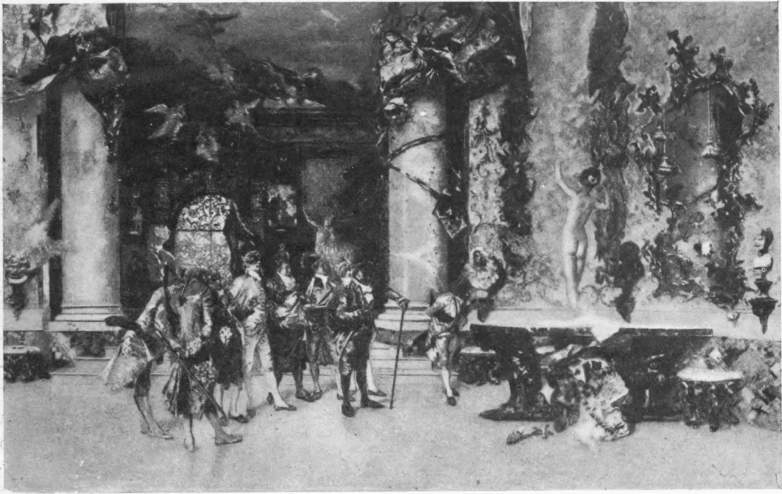 | |
| FORTUNY. | THE TRIAL OF THE MODEL. |
| (By permission of Messrs. Boussod, Valadon & Co., the owners of the copyright.) | |
Even as an etcher he caught all the technical finesses and appetising piquancies of his great forerunner Goya. It is only with very light and spirited strokes that the outlines of his figures are drawn; then, as in Goya, comes the aquatint, the colour which covers the background and gives locality, depth, and light. A few scratches with a needle, a black spot, a light made by a judiciously inserted patch of white, and he gives his figures life and character, causing them to emerge from the black depth of the background like mysterious visions. “The Dead Arab,” covered with his black cloak, and lying on the ground with his musket on his arm, “The Shepherd” on the stump of a 312 pillar, “The Serenade,” “The Reader,” “The Tambourine Player,” “The Pensioner,” the picture of the gentleman with a pig-tail bending over his flowers, “The Anchorite,” and “The Arab mourning over the Body of his Friend,” are the most important of his plates, which are sometimes pungent and spirited, and sometimes sombre and fantastic.
In the picture “The Strand of Portici” he attempted to strike out a new path. He was tired of the gay rags of the eighteenth century, as he said himself, and meant to paint for the future only subjects from surrounding life in an entirely modern manner like that of Manet. But he was not destined to carry out this change any further. He passed away in Rome on 21st November 1874. When the unsold works which he left were put up to auction the smallest sketches fetched high figures, and even his etchings were bought at marvellous prices.
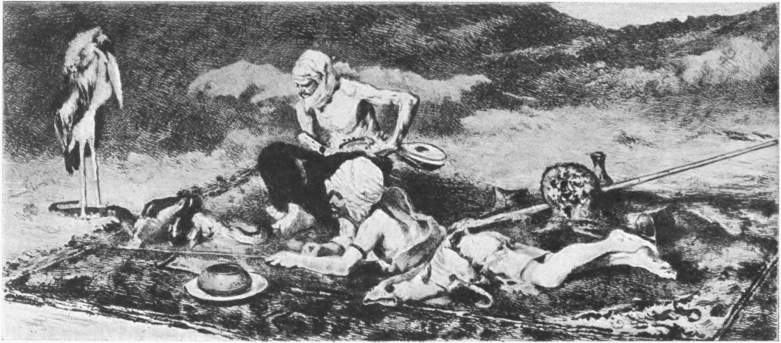 | |
| Gaz. des Beaux-Arts. | |
| FORTUNY. | THE SNAKE CHARMERS. |
In these days the enthusiasm for Fortuny is no longer so glowing. The capacity to paint became so ordinary in the course of years that it was presupposed as a matter of course; it was a necessary acquirement for an artist to have before approaching his pictures in a psychological fashion. And in this later respect there is a deficiency in Fortuny. He is a charmeur who dazzles the eyes, but rather creates a sense of astonishment than holds the spectator in his grip. Beneath his hands painting has become a matter of pure virtuosity, a marvellous, flaring firework that amazes and—leaves us cold after all. With enchanting delicacy he runs through the brilliant gamut of radiant colours upon the small keyboard of his little pictures painted with a pocket-lens, and everything glitters golden, like the dress of a fairy. He united to the patience of Meissonier a delicacy of colour, a wealth of pictorial point, and a crowd of delightful trifles, which combine to make him a most exquisite and fascinating juggler of the palette—an amazing colourist, a wonderful clown, an original and subtle painter with vibrating nerves, but not a truly great and moving artist. His pictures are dainties in gold frames, 313 jewels delicately set, astonishing efforts of patience lit up by a flashing, rocket-like esprit; but beneath the glittering surface one is conscious of there being neither heart nor soul. His art might have been French or Italian, just as appropriately as Spanish. It is the art of virtuosi of the brush, and Fortuny himself is the initiator of a religion which found its enthusiastic followers, not in Madrid alone, but in Naples, Paris, and Rome.
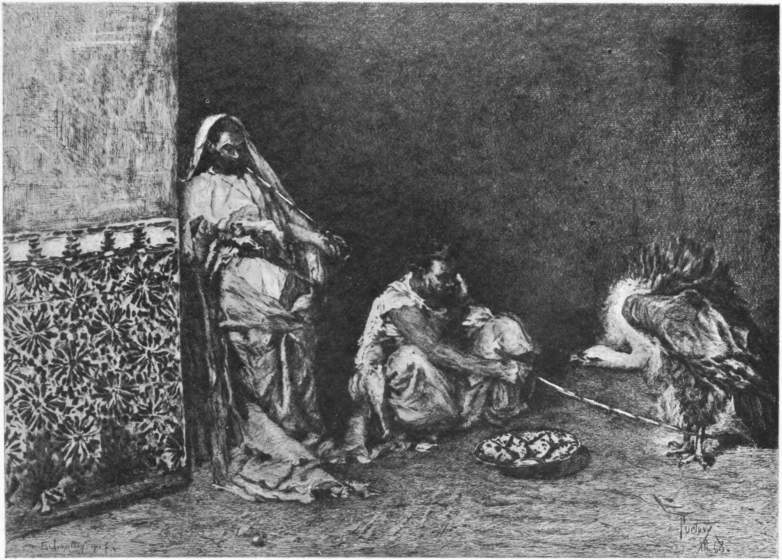 | |
| L’Art. | |
| FORTUNY. | MOORS PLAYING WITH A VULTURE. |
Yet Spanish painting, so far as it is individual, works even now upon the lines of Fortuny. After his death it divided into two streams. The official endeavour of the academies was to keep the grand historical painting in flower, in accord with the proud programme announced by Francisco Tubino in his brochure, The Renaissance of Spanish Art. “Our contemporary artists,” he writes, “fill all civilised Europe with their fame, and are the object of admiration on the far side of the Atlantic. We have a peculiar school of our own with a hundred teachers, and it shuns comparison with no school in any other country. At home the Academy of the Fine Arts watches over the progress of painting; it has perfected the laws by which our Academy in Rome is guided, the Academy in the proud possession of Spain, and situated so splendidly upon the Janiculum. In Madrid there is a succession of biennial exhibitions, and there is no deficiency in prizes nor in purchases. Spanish painting does not merely adorn the citizen’s house or the boudoir of the fair 314 sex with easel-pieces; by its productions it recalls the great episodes of popular history, which are able to excite men to glorious deeds. Austere, like our national character, it forbids fine taste to descend to the painting of anything indecorous. Before everything we want grand paintings for our galleries; the commercial spirit is no master of ours. In such a way the glory of Zurburan, Murillo, and Velasquez lives once more in a new sense.”
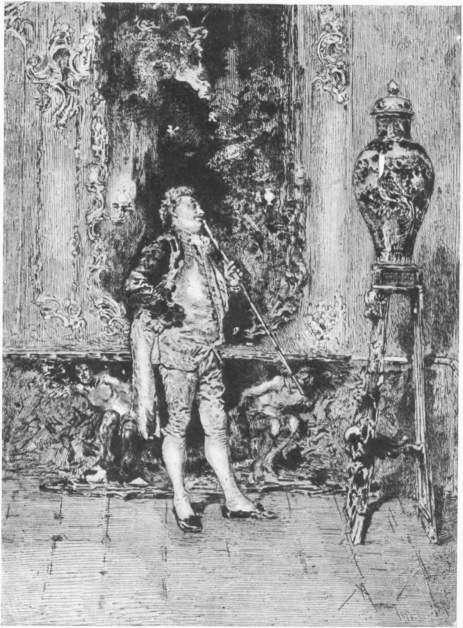 |
| L’Art. |
| FORTUNY. THE CHINA VASE. |
The results of such efforts were those historical pictures which at the Paris World Exhibition of 1878, the Munich International Exhibition of 1883, and at every large exhibition since have been so exceedingly refreshing to all admirers of the illustration of history upon ground that was genuinely Spanish. At the Paris World Exhibition of 1878 Pradilla’s “Joan the Mad” received the large gold medal, and was, indeed, a good picture in the manner of Laurens. Philip the Fair is dead. The funeral train, paying him the last honours, has come to a halt upon a high-road, and the unhappy princess rushes up with floating hair and staring eyes fixed upon the bier which hides the remains of her husband. The priests and women kneeling around regard the unfortunate mad woman with mournful pity. To the right the members of the Court are grouped near a little chapel where a priest is celebrating a mass for the dead; to the left the peasantry are crowding round to witness the ceremony. Great wax candles are burning, and the chapel is lit up with the sombre glow of torches. This was all exceedingly well painted, carefully balanced in composition, and graceful in drawing. At the Munich Exhibition of 1883 he received a gold medal for his “Surrender of Granada, 1492,” a picture which made a great impression at the time upon the German historical painters, as Pradilla had made a transition from the brown bituminous painting of Laurens to a “modern” painting in grey, which did more justice to the illumination of objects beneath the open sky. In the same year Casado’s large painting, “The Bells of Huesca,” with the ground streaming with blood, fifteen decapitated 315 bodies, and as many bodiless heads, was a creation which was widely admired. Vera had exhibited his picture, filled with wild fire and pathos, “The Defence of Numantia,” and Manuel Ramirez his “Execution of Don Alvaro de Luna,” with the pallid head which has rolled from the steps and stares at the spectator in such a ghastly manner. In his “Conversion of the Duke of Gandia,” Moreno Carbonero displayed an open coffin à la Laurens: as Grand Equerry to the Empress Isabella at the Court of Charles V, the Duke of Gandia, after the death of his mistress, has to superintend the burial of her corpse in the vault at Granada, and as the coffin is opened there, to confirm the 316 identity of the person, the distorted features of the dead make such a powerful impression upon the careless noble that he takes a vow to devote himself to God. Ricardo Villodas in his picture “Victoribus Gloria” represents the beginning of one of those sea-battles which Augustus made gladiators fight for the amusement of the Roman people. By Antonio Casanova y Estorach there was a picture of King Ferdinand the Holy, who upon Maundy Thursday is washing the feet of eleven poor old men and giving them food. And a special sensation was made by the great ghost picture of Benliure y Gil, which he named “A Vision in the Colosseum.” Saint Almaquio, who was slain, according to tradition, by gladiators in the Colosseum, is seen floating in the air, as he swings in fanatical ecstasy a crucifix from which light is streaming. Upon one side men who have borne witness to Christianity with their blood chant their hymns of praise; upon the other, troops of female martyrs clothed in white and holding tapers in their hands move by; but below, the earth has opened, and the dead rise for the celebration of this midnight service, praying from their graves, while the full moon shines through the apertures of the ruins and pours its pale light upon the phantom congregation. There was exhibited by Checa “A Barbarian Onset,” a Gallic horde of riders thundering past a Roman temple, from which the priestesses are flying in desperation. Francisco Amerigo treated upon a huge canvas a scene from the sacking of Rome in 1527, when the despoiling troops of Charles V plundered the Eternal City. “Soldiers intoxicated with wine and lust, tricked out with bishops’ mitres and wrapped in the robes of priests, are desecrating the temples of God. Nunneries are violated, and fathers kill their daughters to save them from shame.” So ran the historical explanation set upon the broad gold frame.
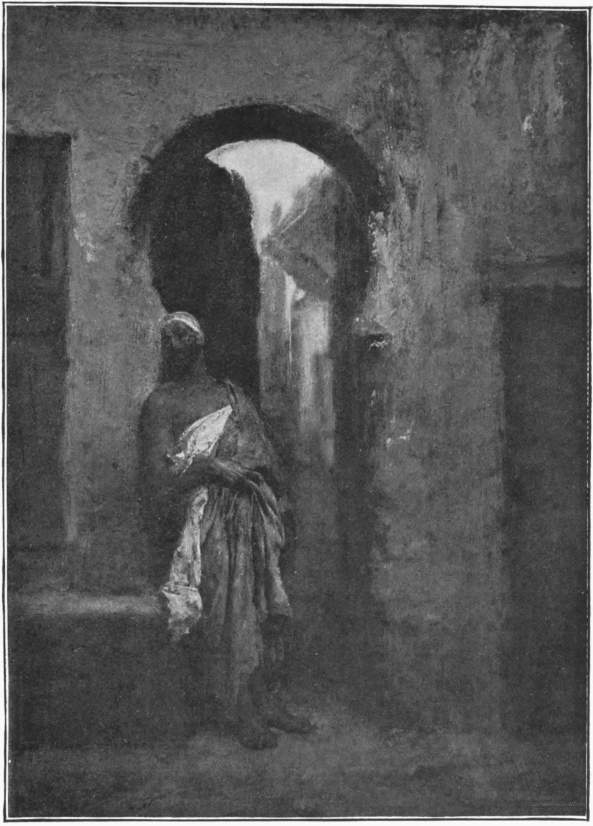 | |
| Cassell & Co. | |
| FORTUNY. | AT THE GATE OF THE SERAGLIO. |
But, after all, these historical pictures, in spite of their great spaces of canvas, are of no consequence when one comes to characterise the efforts of modern art. Explanations could be given showing that in the land of bull-fights this painting of horrors maintained itself longer than elsewhere, but the hopes of those who prophesied from it a new golden period for historical painting were entirely disappointed. For Spanish art, as in earlier days for French art, the historical picture has merely the importance implied by the Prix de Rome. A method of colouring which is often dazzling in result, and a vigorous study of nature, preserved from the danger of “beautiful” tinting, make the Spanish works different from the older ones. Their very passion often has an effect which is genuine, brutal, and of telling power. In the best of these pictures one believes that a wild temperament really does burst into flame through the accepted convention that the painters have delight in the horrible, which the older French artists resorted to merely for the purpose of preparing veritable tableaux. But in the rank and file, in place of the Southern vividness of expression which has been sincerely felt, histrionic pose is the predominant element, the petty situation of the stage set upon a gigantic canvas, and in addition to this a straining after effect which grazes the boundary line where the horrible degenerates into the ridiculous. Through their extraordinary ability they all compel respect, but they have not enriched the treasury of modern emotion, nor have they transformed the older historical painting in the essence of its being. And the man who handles again and again motives derived from what happens to be the mode in colours renders no service to art. Delaroche is dead; but though he may be disinterred he cannot be brought to life, and the Spaniards merely dug out of the earth mummies in which the breath of life was wanting. Their works are not directing-posts to the future, but the last revenants of that histrionic spirit which wandered like a ghost through the art of all nations. Even the composition, the shining colours, the settles and carpets picturesquely spread upon the ground, are the same as in Gallait. How often have these precious stage properties done duty in tragic funereal service since Delaroche’s “Murder of the Duke of Guise” and Piloty’s “Seni”!
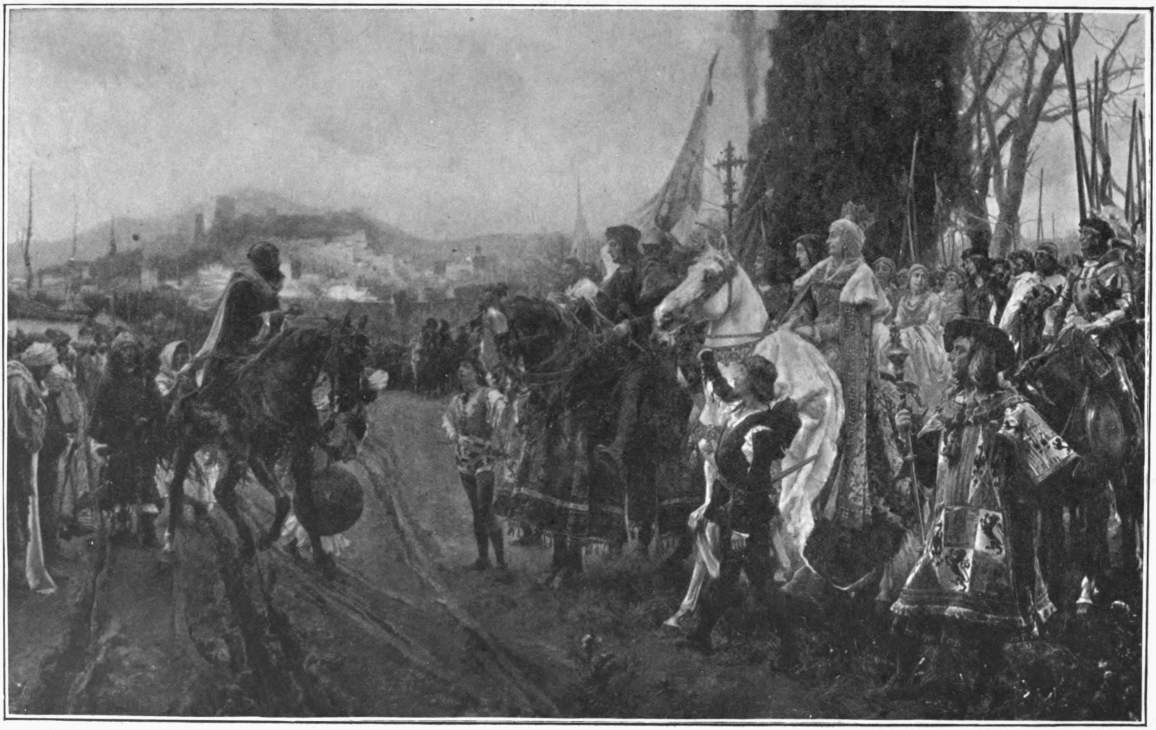 | |
| Hanfstaengl. | |
| PRADILLA. | THE SURRENDER OF GRANADA. |
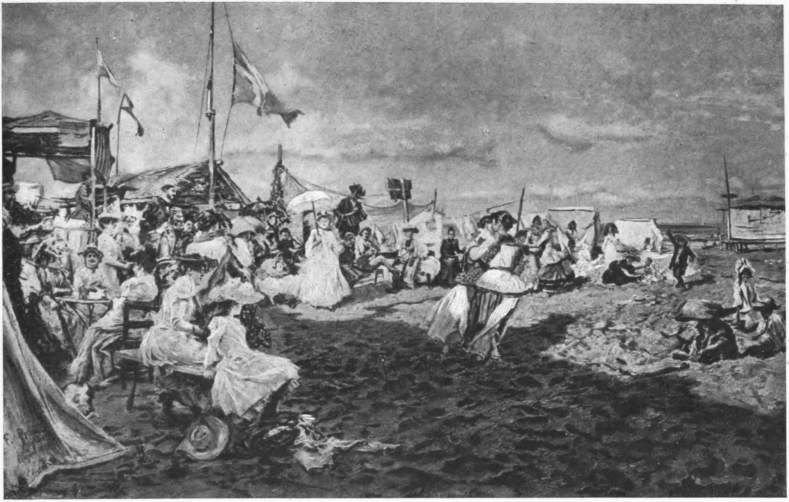 | |
| Kunst unserer Zeit. | |
| PRADILLA. | ON THE BEACH. |
And these conceptions, nourished upon historical painting, had an injurious influence upon the handling of the modern picture of the period. Even here there is an endeavour to make a compromise with the traditional historic picture, since artists painted scenes from modern popular life upon great spaces of canvas, transforming them into pageants or pictures of tragical ceremonies, and sought too much after subjects with which the splendid and motley colours of historical painting would accord. Viniegra y Lasso and Mas y Fondevilla execute great processions filing past, with bishops, monks, 320 priests, and choristers. All the figures stand beaming in brightness against the sky, but the light glances from the oily mantles of the figures without real effect. Alcazar Tejedor paints a young priest reading his “First Mass” in the presence of his parents, and merely renders a theatrical scene in modern costume, merely transfers to an event of the present that familiar “moment of highest excitement” so popular since the time of Delaroche. By his “Death of the Matador,” and “The Christening,” bought by Vanderbilt for a hundred and fifty thousand francs, José Villegas, in ability the most striking of them all, acquired a European name; whilst a hospital scene by Luis Jimenez of Seville is the single picture in which something of the seriousness of French Naturalism is perceptible, but it is an isolated example from a province of interest which is otherwise not to be found in Spain.
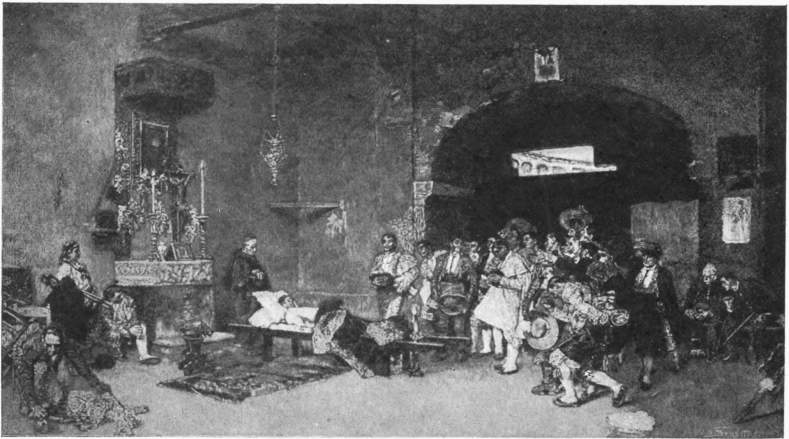 | |
| VILLEGAS. | DEATH OF THE MATADOR. |
Indeed, the Spaniards are by no means most attractive in gravely ceremonial and stiffly dignified pictures, but rather when they indulge in unpretentious “little painting” in the manner of Fortuny. Yet even these wayward “little painters,” with their varied glancing colour, are not to be properly reckoned amongst the moderns. Their painting is an art dependent on deftness of hand, and knows no higher aim than to bring together in a picture as many brilliant things as possible, to make a charming bouquet with glistening effects of costume, and the play, the reflections, and the caprices of sunbeams. The earnest modern art which sprang from Manet and the Fontainebleau painters avoids this kaleidoscopic sport with varied spots of colour. All these little folds and mouldings, these prismatic arts of blending, and these curious reflections are what the moderns have no desire to see: they half close their eyes to gain a clearer conception of the chief values; they simplify; 321 they refuse to be led from the main point by a thousand trifles. Their pictures are works of art, while those of the disciples of Fortuny are sleights of artifice. In all this bric-à-brac art there is no question of any earnest analysis of light. The motley spots of colour yield, no doubt, a certain concord of their own; but there is a want of tone and air, a want of all finer sentiment: everything seems to have been dyed, instead of giving the effect of colour. Nevertheless those who were independent enough not to let themselves be entirely bewitched by the deceptive adroitness of a conjurer have painted little pictures of talent and refinement; taking Fortuny’s rococo works as their starting-point, they have represented the fashionable world and the highly coloured and warm-blooded life of the people of modern Spain with a bold and spirited facility. But they have not gone beyond the observation of the external sides of life. They can show guitarreros clattering with castanets and pandarets, majas dancing, and ribboned heroes conquering bulls instead of Jews and Moors. Yet their pictures are at any rate blithe, full of colour, flashing with sensuous brilliancy, and at times they are executed with stupendous skill.
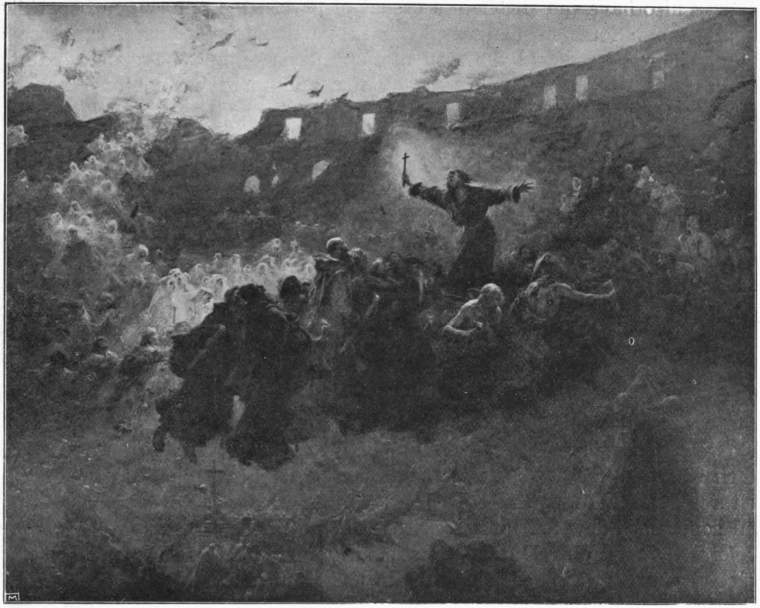 | |
| Hanfstaengl. | |
| BENLIURE Y GIL. | A VISION IN THE COLOSSEUM. |
Martin Rico was for the longest period in Italy with Fortuny, and his 322 pictures also have the glitter of a casket of jewels, the pungency of sparkling champagne. Some of his sea-pieces in particular—for instance, those of the canal in Venice and the Bay of Fontarabia—might have been painted by Fortuny. In others he seems quieter and more harmonious than the latter. His execution is more powerful, less marked by spirited stippling, and his light gains in intensity and atmospheric refinement what it loses in mocking caprices, while his little figures have a more animated effect, notwithstanding the less piquant manner in which they are painted. Their outlines are scarcely perceptible, and yet they are seen walking, jostling, and pressing against each other; whereas those of Fortuny, precisely through the more subtle and microscopic method in which they have been executed, often seem as though they were benumbed in movement. Certain market scenes, with a dense crowd of buyers and sellers, are peculiarly spirited, rapid sketches, with a gleaming charm of colour.
Zamacois, Casanova, and Raimundo de Madrazo, Fortuny’s brother-in-law, show no less virtuosity of the palette. Sea-pieces and little landscapes alternate with scenes from Spanish popular life, where they revel, like Fortuny, in a scintillating medley of colour. Later, in Paris, Madrazo was likewise much sought after as a painter of ladies’ portraits, as he lavished on his pictures sometimes a fine hautgoût of fragrant rococo grace a la Chaplin, and sometimes devoted himself with taste and deftness to symphonic tours de force à la Carolus Duran. Particularly memorable is the portrait of a graceful young girl in red, exhibited in the Munich Exhibition of 1883. She is seated upon a sofa of crimson silk, and her feet rest upon a dark red carpet. Equally memorable in the Paris World Exhibition of 1889 was a pierrette, whose costume ran through the whole gamut from white to rose-colour. Her skirt was of a darker, her bodice of a brighter red, and a light rose-coloured stocking peeped from beneath a grey silk petticoat; over her shoulders lay a white swansdown cape, and white gloves and white silk shoes with rose-coloured bows completed her toilette. His greatest picture represented “The End of a Masked Ball.” Before the Paris Opera cabs are waiting with coachmen sleeping or smoking, whilst a troop of pierrots and pierrettes, harlequins, Japanese girls, rococo gentlemen, and Turkish women are streaming out, sparkling with the most glittering colours in the grey light of a winter morning, in which the gas lamps cast a warm yellow glimmer.
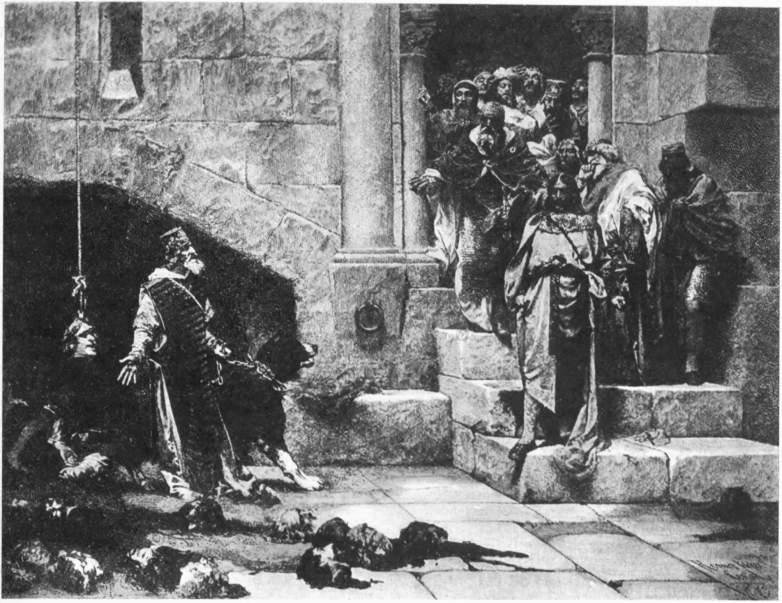 | |
| CASADO. | THE BELLS OF HUESCA. |
Even those who made their chief success as historical painters became new beings when they came forward with such piquant “little paintings.” Francisco Domingo in Valencia is the Spanish Meissonier, who has painted little horsemen before an inn, mercenary soldiers, newspaper readers, and philosophers of the time of Louis XV, with all the daintiness in colour associated with the French patriarch—although a huge canvas, “The Last Day of Sagunt,” has the reputation of being his chief performance. In the year in which he exhibited his “Vision in the Colosseum,” Benliure y Gil made a success with two little pictures stippled in varied colours, the “Month of Mary” and 323 the “Distribution of Prizes in Valencia,” in which children, smartened and dressed in white frocks, are moving in the ante-chambers of a church, decorated for the occasion. Casado, painter of the sanguinary tragedy of Huesca, showed himself an admirable little master full of elegance and grace in “The Bull-Fighter’s Reward,” a small eighteenth-century picture. The master of the great hospital picture, Jimenez, took the world by surprise at the very same time by a “Capuchin Friar’s Sermon before the Cathedral of Seville,” which flashed with colour. Emilio Sala y Francés, whose historical masterpiece was the “Expulsion of the Jews from Spain in 1493,” delights elsewhere in spring, Southern gardens with luxuriant vegetation, and delicate rococo ladies, holding up their skirts filled with blooming roses, or gathering wild flowers among the grass. Antonio Fabrés was led to the East by the influence of Regnault, and excited attention by his aquarelles and studies in pen and ink, in which he represented Oriental and Roman street figures with astonishing adroitness. But the ne plus ultra is attained by the bold and winning art of Pradilla, which is like a thing shot out of a pistol. He is the greatest product of contemporary Spain, a man with a talent for improvisation as ingenious as it was free, who treated with equal facility the most varied subjects. In the bold and spirited decorations with which he 324 embellished Spanish palaces he sported with nymphs and Loves and floating genii à la Tiepolo. All the grace of the rococo period is cast over his works in the Palais Murga in Madrid. The figures join each other with ease—coquettish nymphs swaying upon boughs, and audacious “Putti” tumbling over backwards in quaint games. Nowhere is there academic sobriety, and everywhere life, pictorial inspiration, the intoxicating joyousness of a fancy creating without effort and revelling in the festal delight of the senses. In the accompanying wall pictures he revived the age of the troubadours, of languishing love-song and knightly romance free from the burden of thought, in tenderly graceful and fluent figures. And this same painter, who filled these huge spaces of wall, lightly dallying with subjects from the world of fable, seems another man when he grasps fragments from the life of our own age in pithy inspirations sure in achievement. His historical pictures are works which compel respect; but those paintings on the most diminutive scale, in which he represented scenes from the Roman carnival and the life in Spanish camps, the shore of the sea and the joy of a popular merry-making with countless figures of the most intense vividness, carried out with an unrivalled execution of detail which is yet free from anything laboured, and full of splendour and glowing colour,—these, indeed, are performances of painting beside which as a musical counterpart at best Paganini’s variations on the G string are comparable—sleights of art of which only Pradilla was capable, and such as only Fortuny painted forty years ago.
Two masters who do not live at home, but in France, have followed still further the modern development of art with great power. The first is Zuloaga. The pictures of this artist have something truly Spanish, something that one as an admirer of Goya looks for eagerly in Spanish pictures. At the first glance the eye receives rather a shock. One seeks in vain for delicate painting of light in Zuloaga, or exquisite harmonies of colour. He places the crudest reds and yellows next to each other, strong, almost brutal, like a poster. With an uncompromising love of truth he paints the rouge-smeared cheeks and blackened eyebrows of his women-about-town, does not even try to make their movements graceful or give their costumes a touch of modish smartness. But what a breadth of conception! With what daring he sweeps his bold strokes over the picture! It is just because he avoids all flattery, because he brings nothing foreign, nothing cosmopolitan into his exclusive world, that the characteristics of Spanish life are mirrored with such truth in his works. Especially in his portrait of the popular poet, Don Miguel de Segovia, the whole picture is suffused with a rare Don Quixote feeling. Velasquez’ Pablillas stands before you reincarnated. It is interesting, too, that Zuloaga, though in France, remains still a Spaniard. Even when he paints Parisiennes he translates toilette and gesture into grandiose Spanish style.
The influence of the French school is much more marked in the second of these Spanish masters, Hermen Anglada. He has come to the front in 325 the exhibitions of the last few years. Besnard has given him much of his refined epicurism, and this French hautgoût lends his pictures a charm which is altogether their own. If you are seeking for unusual and quaint effects you will find them in this Spaniard, who paints pale, colourless women in the most astonishing costumes, places them in the midst of sensuous, misty landscapes, and gives you a glistening potpourri of colours. But Anglada’s work is in itself the best testimony to the fact that the Spain of to-day is getting worn-out and bloodless. There is something senile and sapless in this over-refined art that takes pleasure in nothing but the most extraordinary nuances, and that needs something very unusual to tickle its nerves.

CHAPTER XXXVI
ITALY
Italy has played a very different part from that of Spain in the development of modern art. Even at the World Exhibition of 1855 Edmond About called Italy “the grave of painting” in his Voyage à travers l’Exposition des Beaux-Arts. He mentions a few Piedmontese professors, but about Florence, Naples, and Rome he found nothing to say. The Great Exhibition of 1862 in England was productive of no more favourable criticism, for W. Bürger’s account is as little consolatory as About’s. “Renowned Italy and proud Spain,” writes Burger, “have no longer any painters who can rival those of other schools. There is nothing to be said about the rooms where the Italians, Spanish, and Swiss are exhibited.” To-day there are in Italy a great number of vigorous painters. In Angelo de Gubernati’s lexicon of artists there are over two thousand names, some of which are favourably known in other countries also. But the mass dwindles to a tiny heap if those only are included who have risen from the level of dexterous picture-makers to that of painters of real importance in the world of art.
Whether it be from direct influence or similarity of origin, Fortuny has found his ablest successors amongst the Neapolitan artists. As early as the seventeenth century the school of painting there was very different from those in the rest of Italy; the Greek blood of the population and the wild, romantic scenery of the Abruzzi gave it a peculiar stamp. Southern brio, the joy of life, colour, and warmth, in contrast with the noble Roman ideal of form, were the qualities of Salvator Rosa, Luca Giordano, and Ribera, bold and fiery spirits. And a breath of such power seems to live in their descendants still. Even now Neapolitan painting sings, dances, and laughs in a bacchanal of colour, pleasure, delight in life, and glowing sunshine.
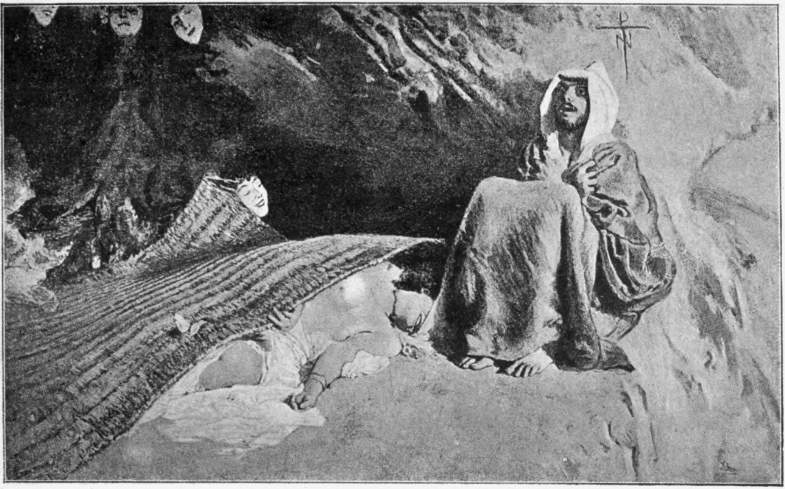 | |
| Kunst für Alle. | |
| MORELLI. | THE TEMPTATION OF ST. ANTHONY. |
A wild and restless spirit, Domenico Morelli, whose biography is like a chapter from Rinaldo Rinaldini, is the head of this Neapolitan school. He was born on 4th August, 1826, and in his youth he is said to have been, first a pupil in a seminary of priests, then an apprentice with a mechanician, and for some time even facchino. He never saw such a thing as an academy. Indeed, it was a Bohemian life that he led, making his meals of bread and cheese, wandering for weeks together with Byron’s poems in his pocket upon the seashore between Posilippo and Baiæ. In 1848 he fought against King Ferdinand, and was left severely wounded on the battle-field. After these 327 episodes of youth he first became a painter, beginning his career in 1855 with the large picture “The Iconoclasts,” followed in 1857 by a “Tasso,” and in 1858 by a “Saul and David.” Biblical pictures remained his province even later, and he was the only artist in Italy who handled these subjects from an entirely novel point of view, pouring into them a peculiarly exalted and imaginative spirit. A Madonna rocking her sleeping Child, whilst her song is accompanied by a legion of cherubs playing upon instruments, “The Reviling of Christ,” “The Ascension,” “The Descent from the Cross,” “Christ walking on the Sea,” “The Raising of the Daughter of Jairus,” “The Expulsion of the Money-Changers from the Temple,” “The Marys at the Grave,” “Salve Regina,” and “Mary Magdalene meeting Christ risen from the Grave,” are the principal stages of his great Christian epic, and in their imaginative naturalism a new revolutionary language finds utterance through all these pictures. There is in them at times something of the mystical quietude of the East, and at times something of the passionate breath of Eugène Delacroix. In these pictures he revealed himself as a true child of the land of the sun, a lover of painting which scintillates and flickers. As yet hard, ponderous, dark, and plastic in “The Iconoclasts,” he was a worshipper of light and resplendent in colour in the “Mary Magdalene.” “The Temptation of St. Anthony” probably marks the summit of his creative power in the matter of colour. Morelli has conceived the whole temptation as a hallucination. The saint squats upon the ground, claws with his fingers, and with fixed gaze tries to stifle thoughts, full of craving sensuality, which 328 are flaming in him. Yet they throng ever more thickly, take shape ever more distinctly, are transformed into red-haired women who detach themselves from corners upon all sides. They rise from beneath the matting, wind nearer from the depth of the cavern; even the breeze that caresses the fevered brow of the tormented man changes into the head of a girl pressing her kisses upon him. Only Naples could produce an artist at once so bizarre, so many-sided and incoherent, so opulent and strange. Younger men of talent trooped around him. A fiery spirit, haughty and independent, he became the teacher of all the younger generation. He led them to behold the sun and the sea, to marvel at nature in her radiant brightness. Through him the joy in light and colour came into Neapolitan painting, that rejoicing in colour which touches such laughing concords in the works of his pupil Paolo Michetti.
A man of bold and magnificent talent, the genuine product of the wild Abruzzi, Michetti was the son of a day-labourer, like Morelli. However, a man of position became the protector of the boy, who was early left an orphan. But neither at the Academy at Naples nor in Paris and London did this continue long. As early as 1876 he was back in Naples, and settled amid the Abruzzi, close to the Adriatic, in Francavilla à Mare, near Ostona, a little nest which the traveller passes just before he goes on board the Oriental steamer at Brindisi. Here he lives out of touch with old pictures, in the thick of the vigorous life of the Italian people. In 1877 he painted the work which laid the foundation of his celebrity, “The Corpus Domini Procession at Chieti,” a picture which rose like a firework in its boisterous, exhilarating medley of bright colours. The procession is seen just coming out of church: men, women, naked children, monks, priests, a canopy, choristers with censers, old men and youths, people who kneel and people who laugh, the mist of incense, the beams of the sun, flowers scattered on the ground, a band of musicians, and a church façade with rich and many-coloured ornaments. There is the play of variously hued silk, and colours sparkle in all the tints of the prism. Everything laughs, the faces and the costumes, the flowers and the sunbeams. Following upon this came a picture which he called “Spring and the Loves.” It represented a desolate promontory in the blue sea, and upon it a troop of Cupids, playing round a hawthorn bush in full flower, are scuffling, buffeting each other, and leaping as riotously as Neapolitan street-boys. Some were arrayed like little Japanese, some like Grecian terra-cotta figures, whilst a marble bridge in the neighbourhood shone in indigo blue. The whole picture gleamed with red, blue, green, and yellow patches of colour: a serpentine dance painted twelve years before the appearance of Loie Fuller. Then again he painted the sea. It is noon, and the sultry heat broods over the azure tide. Naked fishermen are standing in it, and on the shore gaily dressed women are searching for mussels; whilst, in the background, vessels with the sun playing on their sails are mirrored brightly in the water. Or the moon rises casting greenish reflections upon 329 the body of Christ, which shines like phosphorus as it is being taken from the cross: or there is a flowery landscape upon a summer evening; birds are settling down for the night, and little angels are kissing each other and laughing. In all these pictures Michetti showed himself an improviser of astonishing dexterity, solving every difficulty as though it were child’s play, and shedding a brilliant colour over everything—a man to whom “painting” was as much a matter of course as orthography is to ourselves. Even the Paris World Exhibition of 1878 made him celebrated as an artist, and from that time his name was to the Italian ear a symbol for something new, unexpected, wild, and extravagant. The word “Michetti” means splendid materials, dazzling flesh-tones, conflicting hues set with intention beside each other, the luxuriant bodies of women basking in heat and sun, fantastic landscapes created in the mad brain of the artist, strange and curious frames, and village idylls in the glowing blaze of the sun. There are no lifeless spots in his works; every whim of his takes shape, as if by sorcery, in splendid figures.
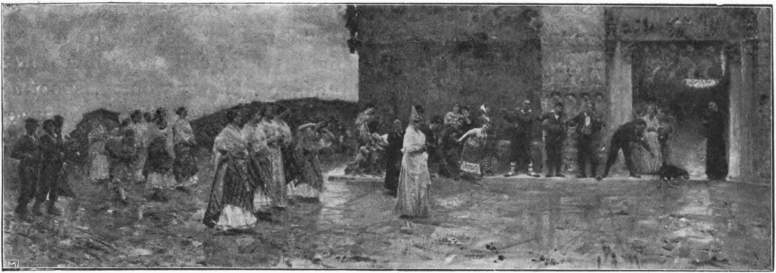 | |
| Hanfstaengl. | |
| MICHETTI. | GOING TO CHURCH. |
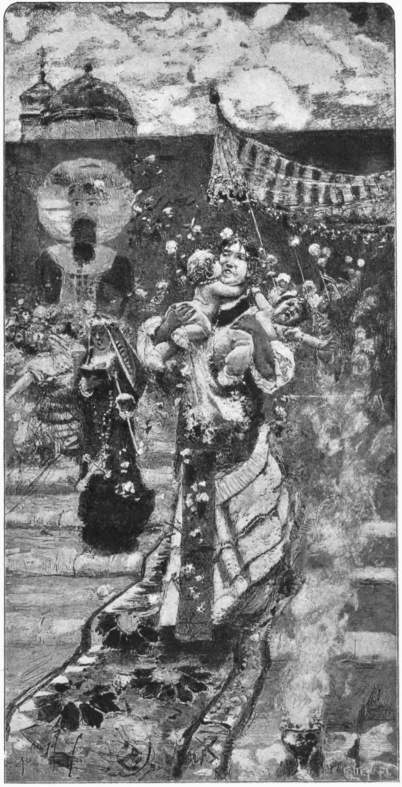 |
| Kunst für Alle. |
| MICHETTI. THE CORPUS DOMINI PROCESSION AT CHIETI. |
Another pupil of Morelli, Edoardo Dalbono, completed his duty to history by a scene of horror à la Laurens, “The Excommunication of King Manfred,” and then became the painter of the Bay of Naples. “The Isle of Sirens” was the first production of his able, appetising, and nervously vibrating brush. There is a steep cliff dropping sheer into the blue sea. Two antique craft are drawing near, the crews taking no heed of the reefs and sandbanks. With phantomlike gesture the naked women stretch out their arms beckoning, embodiments as they are of the deadly beautiful and voluptuously cruel ocean. By degrees the sea betrayed to him all its secrets—its strangest combinations of colour and atmospheric effects, its transparency, and its eternally shifting phases of ebb and flow. He has painted the Bay of Naples under bright, hot noon and the gloom of night, in the purple light of the sinking sun and in the strange and many-coloured mood of twilight. At one moment it shines and plays variegated and joyous in blue, grass-green, and violet tones; at another it seems to glitter with millions of phosphorescent sparks: the rosy clouds of the sky are glassed in it, and the lights of the houses 330 irregularly dotted over abrupt mountain-chains or the dark-red glow of lava luridly shining from Vesuvius. Now and then he painted scenes from Neapolitan street-life—old, weather-beaten seamen, young sailors with features as sharply cut as if cast in bronze, beautiful, fiery, brown women, shooting the hot Southern flame from their eyes, houses painted white or orange-yellow, with the sun glittering on the windows. The “Voto alla Madonna del Carmine” was the most comprehensive of these Southern pictures. Everything shines in joyous blue, yellowish-green, and red colours. Warmth, life, light, brilliancy, and laughter are the elements on which his art is based.
Alceste Campriani, Giacomo di Chirico, Rubens Santoro, Federigo Cortese, Francesco Netti, Edoardo Toffano, Giuseppe de Nigris have, all of them, this kaleidoscopic sparkle, this method of painting which gives pictures the appearance of being mosaics of precious stones. As in the days of the Renaissance, the Church is usually the scene of action, though not any longer as the house of God, but as the background of a many-coloured throng. As a rule these pictures contain a crowd of canopies, priests, and choristers, and country-folk, bowing or kneeling when the host is carried by, or weddings, horse-races, and country festivals; and everything is vivid and joyous in colour, saturated with the glowing sun of Naples. Alceste Campriani’s chief work was entitled “The Return from Montevergine.” Carriages and open rack-waggons are dashing along, the horses snorting and the drivers smacking their whips, while the peasants, who have had their fill of sweet wine, are shouting and singing, and the orange-sellers in the street are crying their goods. A coquettish glancing light plays over the gay costumes, and the white dust sparkles like fluid silver, as it rises beneath the hoofs of the horses wildly plunging forward. The leading work of Giacomo di Chirico, who became mad in 1883, was “A Wedding in the 331 Basilicata.” It represents a motley crowd. The entire village has set out to see the ceremony. The wedding guests are descending the church steps to the square, which is decked out with coloured carpets and strewn with flowers. Triumphal arches have been set up, and the pictures of the Madonna are hung with garlands. Meanwhile the sindaco gives his arm to the bride, beneath whose gay costume a charmingly graceful little foot is peeping out. Then the bridegroom follows with the sindaco’s wife. All the village girls are looking on with curiosity, and the musicians are playing. Winter has covered the square with a white cloak of snow; yet the sunbeams sport over it, making it shine vividly with a thousand reflections.
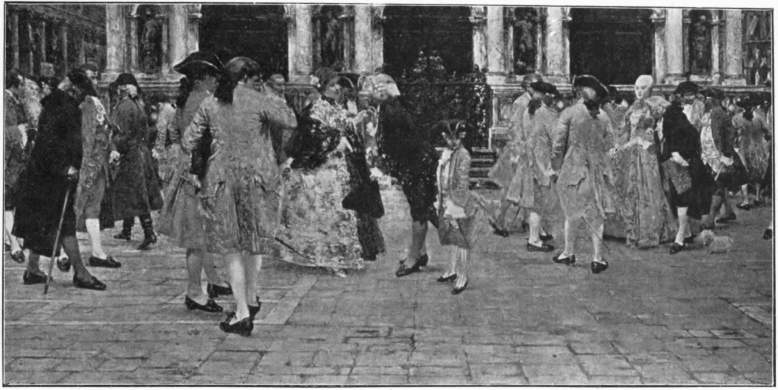 | |
| Hanfstaengl. | |
| FAVRETTO. | ON THE PIAZZETTA. |
Of course, the derivation of all these pictures is easily recognisable. Almost all the Neapolitan painters studied at Fortuny’s in the seventies in Rome, and when they came home again they perceived that the life of the people offered themes which had a coquettish fitness in Fortuny’s scale of tones. From the variously coloured magnificence of old churches, the red robes of ecclesiastics, the gaudy splendour of the country-people’s clothes, and the gay glory of rags amongst the Neapolitan children, they composed a modern rococo, rejoicing in colour, whilst the Spaniard had fled to the past to attain his gleaming effects.
A great number of the Italians do the same even now. In numerous costume pictures, from the seventeenth and eighteenth centuries, flashing with silk and velvet, the Southerner’s bright pleasure in colour still loves to celebrate its orgies. Gay trains rustle, rosy Loves laugh down from the walls, Venetian chandeliers shed their radiance; no other epoch in history enables the painter with so much ease to produce such an efflorescence of full-toned chords of colour. With his shining glow of hue the delectable and spirited Favretto (who, like Fortuny, entered the world of art as a victor, 332 and, like him again, was snatched from it when barely thirty-seven, after a brief and brilliant career) stands at the head of this group. The child of poor parents, indeed the son of a joiner, he was born in Venice in 1849, and, like the Spaniard, passed a youth which was full of privations. But all the cares of existence, even the loss of an eye, did not hinder him from seeing objects under a laughing brightness of colour. Through his studies and the bent of his fancy he had come to be no less at home in the Venice of the eighteenth century than in that of his own time. This Venice of Francesco Guardi, this city of enchantment surrounded with the gleam of olden splendour, the scene of rich and brilliantly coloured banquets and a graceful and modish society, rose once more under Favretto’s hands in fabulous beauty. What brio of technique, what harmony of colours, were to be found in the picture “Un Incontro,” the charming scene upon the Rialto Bridge, with the bowing cavalier and the lady coquettishly making her acknowledgments! This was the first picture which gave him a name in the world. What fanfares of colour were in the two next pictures, “Banco Lotto” and “Erbajuolo Veneziano”! At the Exhibition in Turin in 1883 he was represented by “The Bath” and “Susanna and the Elders”; at that in Venice in 1887 he celebrated his last and greatest triumph. The three pictures “The Friday Market upon the Rialto Bridge,” “The Canal Ferry near Santa Margherita,” and “On the Piazzetta” were the subject of enthusiastic admiration. All the Venetian society of the age of Goldoni, Gozzi, and Casanova had become vivid in this last picture, and moved over the smooth brick pavement of the Piazzetta at the hour of the promenade, from the Doge’s palace to the library, and from the Square of St. Mark to the pillar of the lions and Theodore, to and fro in surging life. Men put up their glasses and chivalrously greeted the queens of beauty. The enchanting magic building of Sansovino, the loggetta with their bright marble pillars, bronze statues of blackish-grey, and magnificent lattice doors, formed the background of the standing and sauntering groups, whose variegated costumes united with the tones of marble and bronze to make a most beautiful combination of colours. Favretto had a manner of his own, and, although a member of the school of Fortuny, he was stronger and healthier than the latter. He drew like a genuine painter, without having too much of the Fortuny fireworks. His soft, rich painting was that of a colourist of distinction, always tasteful, exquisite in tone, and light and pleasing in technique.
By the other Italian costume painters the scale run through by Fortuny was not enriched by new notes. Most of their pictures are nugatory, coquettishly sportive toys, masterly in technique no doubt, but so empty of substance that they vanish from memory like novels read upon a railway journey. Many have no greater import than dresses, cloaks, and hats worn by ladies during a few weeks of the season. Sometimes their significance is not even so great, since there are modistes and dressmakers who have more skill in making ruches and giving the right nuance to colours. Some small part of 333 Favretto’s refined taste seems to have been communicated to the Venetian Antonio Lonza, who delights in mingling the gleaming splendour of Oriental carpets, fans, and screens amid the motley, picturesque costumes of the rococo period—Japanese who perform as jugglers and knife-throwers in quaint rococo gardens before the old Venetian nobility. But the centre of this costume painting is Florence, and the great mart for it the Società artistica, where there are yearly exhibitions.
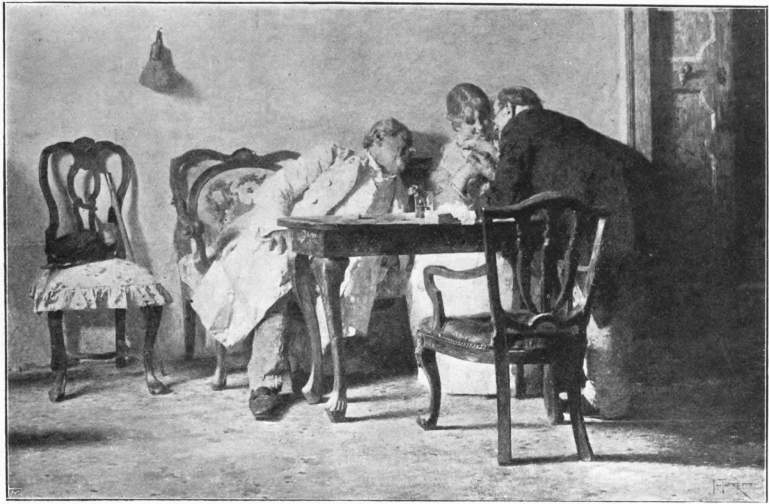 | |
| Hanfstaengl. | |
| FAVRETTO. | SUSANNA AND THE ELDERS. |
Francesco Vinea, Tito Conti, Federigo Andreotti, and Edoardo Gelli are in Italy the special manufacturers who have devoted themselves, with the assistance of Meissonier, Gérôme, and Fortuny, to scenes from the sixteenth and seventeenth centuries, to plumed hats, Wallenstein boots, and horsemen’s capes, to Renaissance lords and laughing Renaissance ladies, and they have thereby won great recognition in Germany. Pretty, languishing women in richly coloured costumes, tippling soldiers and gallant cavaliers, laughing peasant women and trim serving-girls drawing wine in the cellar vaults and setting it before a trooper, who in gratitude affectionately puts his arm round their waist, beautiful and still more languishing noble ladies, who laugh with a parrot or a dog, instead of a trooper, in apartments richly furnished with Gobelins—such for the most part are the subjects treated by Francesco Vinea with great virtuosity bordering on the routine of a typewriter. His technique is neither refined nor fascinating; the colours are so crude that they affect the eye as a false note the ear. But the mechanical power of his painting is great. He has much ability, far more, indeed, than 334 Sichel, and possesses the secret of painting, in an astonishing manner, the famous lace kerchiefs wound round the heads of his fair ones. Andreotti and Tito Conti work in the same fashion, except that the ballad-singers and rustic idylls of Andreotti are the smoother and more mawkish, whereas the pictures of Conti make a somewhat more refined and artistic effect. His colour is superior and more transparent, and his tapestry backgrounds are warmer.
And, so far as one can judge from their pictures, life runs as merrily for the Italians of the present as it did for those rococo cavaliers. Hanging here and there beside the serious art of other nations, these little picture-people enjoy their careless tinsel pomp; art is a gay thing for them, as gay as a Sunday afternoon with a procession and fireworks, walks and sips of sherbet, to an Italian woman. By the side of the blue-plush and red-velvet costume-picture comic genre still holds its sway: barbaric in colour and with materials which are merrier than is appropriate in tasteful pictures, Gaetano Chierici represents children, both good and naughty, making their appearance upon a tiny theatre. Antonio Rotta renders comic episodes from the life of Venetian cobblers and the menders of nets. Scipione Vannuttelli paints young girls in white dresses arrayed as nuns or being confirmed in church. Francesco Monteverde rejoices in comical intermezzi in the style of Grützner—for instance, an ecclesiastical gentleman observing, to his horror, that his pretty young servant-girl is being kissed by a smart lad in the yard. This is more or less his style of subject. Ettore Tito paints the pretty Venetian laundresses whom Passini, Cecil van Haanen, Charles Ulrich, Eugène Blaas, and others introduced into art. Only a very few struck deeper notes. Luigi Nono, in Venice, painted his beautiful picture “Refugium Peccatorum”; Ferragutti, the Milanese, his “Workers in the Turnip Field,” a vivid study of sunlight of serious veracity; and after these Giovanni Segantini came forward with his forcible creations, in which he has demonstrated that it is possible for a man to be an Italian and yet a serious artist.
 | |
| Hanfstaengl. | |
| TITO. | THE SLIPPER SELLER. |
Segantini’s biography is like a novel. Born the child of poor parents, in Arco, in 1858, he was left, after the death of his parents, to the care of a relative in Milan with whom he passed a most unhappy time. He then wanted to make his fortune in France, and set out upon foot; but he did not get very far, in fact he managed to hire himself out as a swine-herd. After this he lived for a whole year alone in the wild mountains, worked in the field, the stable, the barn. Then came the well-known discovery, which one could not believe were it not to be read in Gubernati. One day he drew the finest of his pigs with a piece of charcoal upon a mass of rock. The peasants ran in a crowd and took the block of stone, together with the young Giotto, in triumph to the village. He was given assistance, visited the School of Art in Milan, and now paints the things he did in his youth. In a secluded village of the Alps, Val d’Albola in Switzerland, a thousand metres above the sea, amid the grand and lofty mountains, he settled down, surrounded only by the peasants who make a precarious living from the soil. Out of touch with the world of artists the whole year round, observing great nature at every season and every hour of the day, fresh and straightforward in character, he is one of those natures of the type of Millet, in whom heart and hand, man and artist, are one and the same thing. His shepherd and peasant scenes from the valleys of the high Alps are free from all flavour of genre. The life of these poor and humble beings passes without contrasts and passions, being spent altogether in work, which fills the long course of the day in monotonous regularity. The sky sparkles with a sharp brilliancy. The spiky yellow and tender green of the fields forces its way modestly from the rocky ground. In front is something like a hedge where a cow is grazing, or there is a shepherdess pasturing her sheep. Something majestic there is in this cold nature, where the sunshine is so sharp, the air so thin. And the primitive, it might almost be said antique, execution of these pictures is in accord with the primitive simplicity of the subjects. In fact, Segantini’s pictures, with their cold silvery colours, and their contours so sharp in outline, standing out hard against the rarefied air, make an impression like encaustic paintings or mosaics. They have nothing alluring or pleasing, and there is, perhaps, even a touch of mannerism in this mosaic painting; but they are nevertheless exceedingly true, rugged, austere, and yet sunny. Segantini opened up to painting an entirely new world of beauty, the poetry of the highlands. His appearance dates from the Impressionistic period when preference was given to damp, misty atmospheres which toned down all colour and melted away all lines, and artists made a specialty of flat, monotonous plains. At that time the mountains were in bad repute, thanks to the old-fashioned painters of views, the masters of the “picture-postcard style.” Segantini led the way again up to the heights; but he did not paint the mountain-tops that, like the Titans of old, strive to reach the sky; he painted the plateaus, not the plains of the lowlands, but of the highlands, lonely, weird, sublime, where man draws near to the heart of Nature, far from the noise and struggle of everyday life. The air of the heights is there, the colours and lines speak with no uncertain voice. Thus Segantini learnt from the locale of his pictures to become the first master of line among the Impressionists. How he mirrors in his pictures the stillness, the might and grandeur of these lofty heights! With what astounding truth his cold, clear colours make us feel the coldness and clearness of these regions. Like a dome of steel, the sky stretches over the steel-blue lakes, clear as crystal, over the pale-green meadows in the grip of the frost; the tender foliage rustles and freezes in the quivering ice-cold air: there glaciers gleam, there glitters the snow, there the sun pours down his beams upon the earth like plumes of fire. A thunder cloud draws near, calm and majestic as destiny in its relentless course. There is something Northern and virginal, something earnest and grandiose, which stands in strange contrast with the joyful, conventional smile which is otherwise spread over the countenance of Italian painting. Though he 338 died so young, Giovanni Segantini will live for all time in the history of art.
With the exception of Segantini, not one of these painters will own that there are poverty-stricken and miserable people in his native land. An everlasting blue sky still laughs over Italy, sunshine and the joy of life still hold undisputed sway over Italian pictures. There is no work in sunny Italy, and in spite of that there is no hunger. Even where work is being done there are assembled only the fairest girls of Lombardy, who kneel laughing and jesting on the strand, while the wind dallies with their clothes. They have a special delight for showing themselves while engaged at their toilette, in a bodice, their little feet in neat little slippers, their naked arms raised to arrange their red-gold hair. As a rule, however, they do nothing whatever but smile at you with their most seductive smile, which shows their pearl-white teeth, and ensnares every poor devil who does not suspect that they have smiled for years in the same way, and most of all with him who pays highest: “j’aime les hommes parse que j’aime les truffes.” These pictures are almost invariably works which are well able to give pleasure to their possessor, only they seldom suggest discussion on the course of art. Trop de marchandise is the phrase generally used in the Paris Salon when the Italians come under consideration. Few there are amongst them who are real pioneers, spirits pressing seriously forward and having a quickening influence on others. The vital questions of the painting of free light, Impressionism, and Naturalism do not interest them in the least. A naïve, pleasant, lively, and self-complacent technique is in most cases the solitary charm of their works. One feels scarcely any inclination to search the catalogue for the painter’s name, and whether the beauty—for she is not the first of her kind—who was called Ninetta last year has now become Lisa. Most of these modern Italians execute their pictures in the way in which gold pieces are minted, or in the way in which plastic works, which run through so many editions, are produced in Italy. Nowhere are more beautiful laces chiselled, and in the same manner painters render the shining splendour of satin and velvet, the glittering brilliancy of ornaments, and the starry radiance of the beautiful eyes of women. Only, as soon as one has once seen them one knows the pictures by heart, as one knows the works in marble, and this is so because the painters had them by heart first. Everywhere there are the evidences of talent, industry, ability, and spirit, but there is no soul in the spirit and no life in the colours. So many brilliant tones stand beside each other, and yet there is neither a refined tone nor the impression of truth to nature.
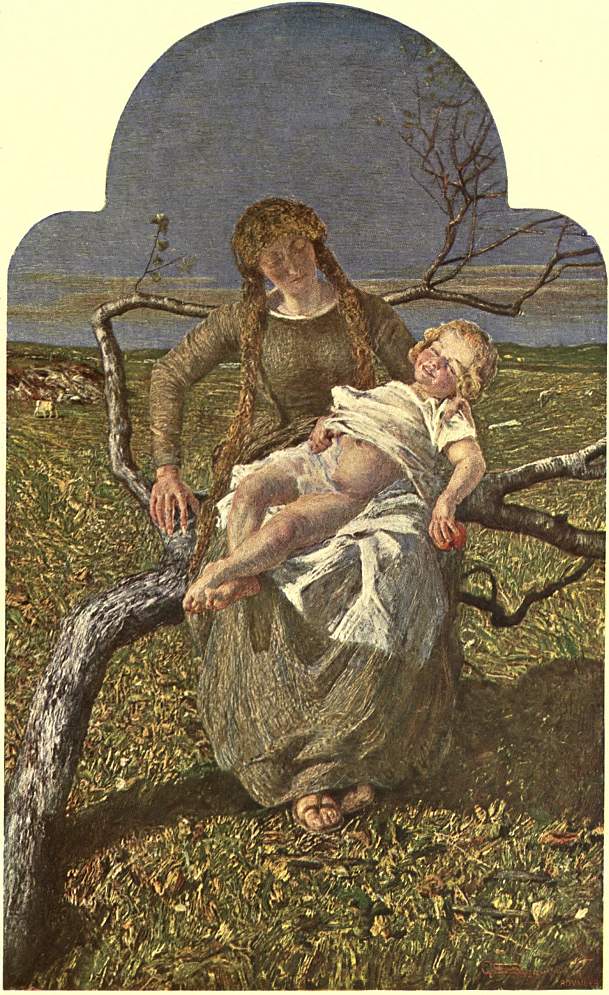 | |
| SEGANTINI. | MATERNITY. |
In all this art of theirs there is scarcely a question of any serious landscape. Apart from the works of some of the younger men—for instance, Belloni, Serra, Gola, Filippini, and others, who display an intimacy of observation which is worthy of honour—a really close connection with the efforts made across the Alps is not achieved in these days. As a rule the landscapes 339 are mere products of handicraft, which are striking for the moment by their technical routine, but seldom waken any finer feelings, whether the Milanese paint the dazzling Alpine effects or the Venetian lagunes steeped in light, with gondolas and gondola-poles glowing in the sunshine, or the Neapolitans set glittering upon the canvas their beautiful bay like a brilliant firework. Most of them continue to pursue with complete self-satisfaction the flagged gondola of Ziem; the conquests of the Fontainebleau painters and of the Impressionists are unnoticed by them.
And this industrial characteristic of Italian painting is sufficiently explained by the entire character of the country. The Italian painter is not properly in a position to seek effects of his own and to make experiments. Hardly anything is bought for the galleries, and there are few collectors of superior taste. He labours chiefly for the traveller, and this gives his performances the stamp of attractive mercantile wares. The Italian is too much a man of business to undertake great trials of strength pour le roi de Prusse. He paints no great pictures, which would be still-born children in his home, nor does he paint severe studies of plein-air, preferring a specious, exuberant, flickering, and glaring revel in colour. In general he produces nothing which will not easily sell, and has a fine instinct for the taste of the rich travelling public, who wish to see nothing which does not excite cheerful and superficial emotions.
But it is possible that this decline of the Latin races is connected with the nature of modern art itself. Of late the words “Germanic” and “Latin” have been much abused. It has been proclaimed that the new art meant the victory of the German depth of feeling over the Latin sense of form, the onset of German cordiality against the empty exaggeration in which the imitation of the Cinquecento resulted. Such assertions are always hard to maintain, because every century shows similar reactions of truth to nature against mannerism. Nevertheless is it true that modern art, with its heartfelt devotion to everyday life and the mysteries of light, has an essentially Germanic character, finding its ancestors not in Raphael, Michael Angelo, and Titian, but in the English of the eighteenth, the Dutch of the seventeenth, and the Germans of the sixteenth century. The Italians and Spaniards, whose entire intellectual culture rests upon a Latin foundation, may therefore find it difficult to follow this change of taste. They either adhere to the old bombastic and theatrical painting of history, or they recast the new painting in an external drawing-room art draped with gaudy tinsel. Even in France the rise of the new art meant, as it were, the victory of the Frankish element over the Gallic. Millet the Norman, Courbet the Frank, Bastien-Lepage of Lorraine, drove back the Latins—Ingres and Couture, Cabanel and Bouguereau—just as in the eighteenth century the Netherlander Watteau broke the yoke of the rigid Latin Classicism.
It is perhaps no mere chance that the threads of the Germanic aim in art were drawn out with such zeal by the Germanic nations. With the Latins 340 a striking effect is made by brilliant technique, mastery of the manual art of painting, and careless sway over all the enchantments of the craft; with the Teutons one stands in the presence of an art which is so natural and simple that one scarcely thinks of the means by which it was called into being. In one case there is virtuosity, ductility, and grace; in the other, health, intrinsic feeling, and temperament.

CHAPTER XXXVII
ENGLAND
To English painting the acquisitions of the French could now give little that was radically novel, for the epoch-making labours of the pre-Raphaelites were already in existence. Apart from certain cases of direct borrowing, it has either completely preserved its autonomy, or recast everything assimilated from France in a specifically English fashion. It is in art, indeed, as it is with men themselves. The English travel more than any other people, for travel is a part of their education. They are to be met in every quarter of the globe—in Africa, Asia, America, or the European Continent; and they scarcely need to open their mouths, even from a distance, to betray that they are English. In the same way there is no need of a catalogue at exhibitions to recognise all English pictures at the first glance. English painting is too English not to be fond of travel. The painter delights in reconnoitring all other schools and studying all styles; he is as much at home in the past as in the present. But as the English tourist, let him go to the world’s end, retains everywhere his own customs, tastes, and habits, so English painting, even on its most adventurous journeys, remains unwaveringly true to its national spirit, and returns from all its wanderings more English than before; it adapts what is alien with the same delicious abnegation of all scruple with which the English tongue brings foreign words into harmony with its own sense of convenience. A certain softness of feeling and tenderness of spirit induce the English even in these days to avoid hard contact with reality. Their art rejects everything in nature which is harsh, rude, and brutal; it is an art which polishes and renders the reality poetic at the risk of debilitating its power. It considers matters from the standpoint of what is pretty, touching, or intelligible, and by no means holds that everything true is necessarily beautiful. And just as little does the English eye—so much occupied with detail—see light in its most exquisite subtleties. Indeed, it rather sees the isolated fact than the total harmony, and is clearer than it is fine.
For this reason plein-air painting has very few adepts, and the atmospheric influences which blunt the lines of objects, efface colours, and bring them nearer to each other, meet with little consideration. Things are given all the sharpness of their outlines, and the harmony, which in the French follows naturally from the observation of light and air saturating form and colour, 342 is the more artificially attained by everything being brought into concord in a bright and delicate tone, which is almost too fine. The audacities of Impressionism are excluded, because painting which starts from a masterly seizure of total effect would seem too sketchy to English taste, which has been formed by Ruskin. Painting must be highly finished and highly elaborated; that is a conditio sine qua non which English taste refuses to renounce in oil-painting as little as in water-colour, and in England they are more closely related than elsewhere, and have mutually influenced each other in the matter of technique. In fact, English water-colours seek to rival oil-painting in force and precision, and have therefore forfeited the charm of improvisation, the verve of the first sketch, and the freshness and ease which they should have by their very character. Through a curious change of parts oil-painting has a fancy for borrowing from water-colours their effects and their processes. English pictures have no longer anything heavy or oily, but they likewise show nothing of the manipulation of the brush, rather resembling large water-colours, perhaps even pastels or wax-painting. The colours are chosen with reserve, and everything is subdued and softened like the quiet step of the footman in the mansion of a nobleman. The special quality in all English pictures—putting aside a preference for bright yellow and vivid red in the older period—consists in a bluish or greenish luminous general tone, to which every English painter seems to conform as though it were a binding social convention, and it even recurs in English landscapes. In fact, English painting differs from French as England from France.
France is a great city, and the name of this city is Paris. Here, and not in the provinces, lives that fashionable, thinking world which has become the guide of the nation and the censor of beauty, by the refinement of its taste and its preeminent intellect. The ideas which fly throughout the land upon invisible wires are born in Paris. Painting, likewise, receives them at first hand. It stands amid the seething whirlpool of the age, the heart’s-blood of the present streams through all its veins, and there is nothing human that is alien to it, neither the filth nor the splendour of life, its laughter nor its misery. All the nerves of the great city are vibrating in it. Paris has made her people refined and, at the same time, insatiate in enjoyment. Every day they have need of new impressions and new theories to ward off tedium. And thus is explained the universally comprehensive sphere of subject in French painting, and its feverish versatility in technique.
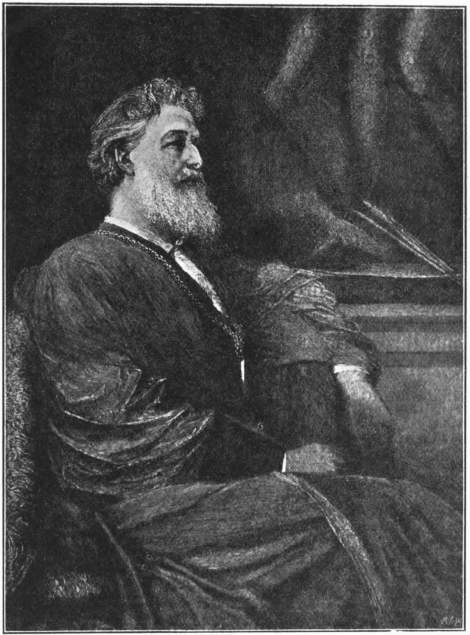 |
| Mag. of Art. |
| LORD LEIGHTON, P.R.A. |
But London has, in no sense, the importance for England which Paris has for France. It is a centre of attraction for business; but the more refined classes of society live in the country. As soon as one is off in the Dover express country houses fly past on either side of the train. They are all over England—upon the shores of the lakes, upon the strand of the sea, upon the tops of the hills. And how pleasant they are, how well appointed, how delightful to look at, with their gabled roofs and their gleaming brickwork overgrown with ivy! Around them stretches a fresh lawn which is rolled every morning, as 343 soft as velvet. Fat oxen, and sheep as white as if they had been just washed, lie upon the grass. Thus all rustic England is like a great summer resort, where there is heard no sound of the ringing and throbbing strokes of life. Nor is painting allowed to disturb this idyllic harmony. No one wishes that anything should remind him of the prose of life when his work is done and the town has vanished. Schiller’s assertion, “Life is earnest, blithe is art,” is here the first law of æesthetics.
English painting is exclusively an art based on luxury, optimism, and aristocracy; in its neatness, cleanliness, and good-breeding it is exclusively designed to ingratiate itself with English ideas of comfort. Yet the pictures have to satisfy very different tastes—the taste of a wealthy middle class which wishes to have substantial nourishment, and the æesthetic taste of an élite class, which will only tolerate the quintessence of art, the most subtle art that can be given. But all these works are not created for galleries, but for the drawing-room of a private house, and in subject and treatment they have all to reckon with the ascendant view that a picture ought, in the first place, to be an attractive article of furniture for the sitting-room. The traveller, the lover of antiquity, is pleased by imitation of the ancient style; the sportsman, the lover of country life, has a delight in little rustic scenes; and the women are enchanted with feminine types. And everything must be kept within the bounds of what is charming, temperate, and prosperous, without in any degree suggesting the struggle for existence. The pictures have themselves the grace of that mundane refinement from the midst of which they are beheld.
England is the country of the sculptures of the Parthenon, the country where Bulwer Lytton wrote his Last Days of Pompeii, and where the most Grecian female figures in the world may be seen to move. Thus painters of antique subjects still play an important part in the pursuit of English art—probably 344 the pursuit of art rather than its development. For they have never enriched the treasury of modern sentiment. Trained, all of them, in Paris or Belgium, they are equipped with finer taste, and have acquired abroad a more solid ability than James Barry, Haydon, and Hinton, the half-barbaric English Classicists of the beginning of the century. But at bottom—like Cabanel and Bouguereau—they represent rigid conservatism in opposition to progress, and the way in which they set about the reconstruction of an august or domestic antiquity is only distinguished by an English nuance of race from that of Couture and Gérôme.
Lord Leighton, the late highly cultured President of the Royal Academy, was the most dignified representative of this tendency. He was a Classicist through and through—in the balance of composition, the rhythmical flow of lines, and the confession of faith that the highest aim of art is the representation of men and women of immaculate build. In the picture galleries of Paris, Rome, Dresden, and Berlin he received his youthful impressions; his artistic discipline he received under Zanetti in Florence, under Wiertz and Gallait in Brussels, under Steinle in Frankfort, and under Ingres and Ary Scheffer in Paris. Back in England once more, he translated Couture into English as Anselm Feuerbach translated him into German with greater independence. Undoubtedly there has never been anything upon his canvas which could be supposed ungentlemanlike. And as a nation is usually apt to prize most the very thing which has been denied it, and for which it has no talent, Leighton was soon an object of admiration to the refined world. As early as 1864 he became an associate, and in November 1879 President of the Royal Academy. For sixteen years he sat like a Jupiter upon his throne in London. An accomplished man of the world and a good speaker, a scholar who spoke many languages and had seen many countries, he possessed every quality which the president of an academy needs to have; he had an exceedingly imposing presence in his red gown, and did the honours of his house with admirable tact.
But one stands before his works with a certain feeling of indifference. There are few artists with so little temperament as Lord Leighton, few in the same degree wanting in the magic of individuality. The purest academical art, as the phrase is understood of Ingres, together with academical severity of form, is united with a softness of feeling recalling Hofmann of Dresden; and the result is a placid classicality adapted ad usum Delphini, a classicality foregoing the applause of artists, but all the more in accordance with the taste of a refined circle of ladies. His chief works, “The Star of Bethlehem,” “Orpheus and Eurydice,” “Jonathan’s Token to David,” “Electra at the Tomb of Agamemnon,” “The Daphnephoria,” “Venus disrobing for the Bath,” and the like, are amongst the most refined although the most frigid creations of contemporary English art.
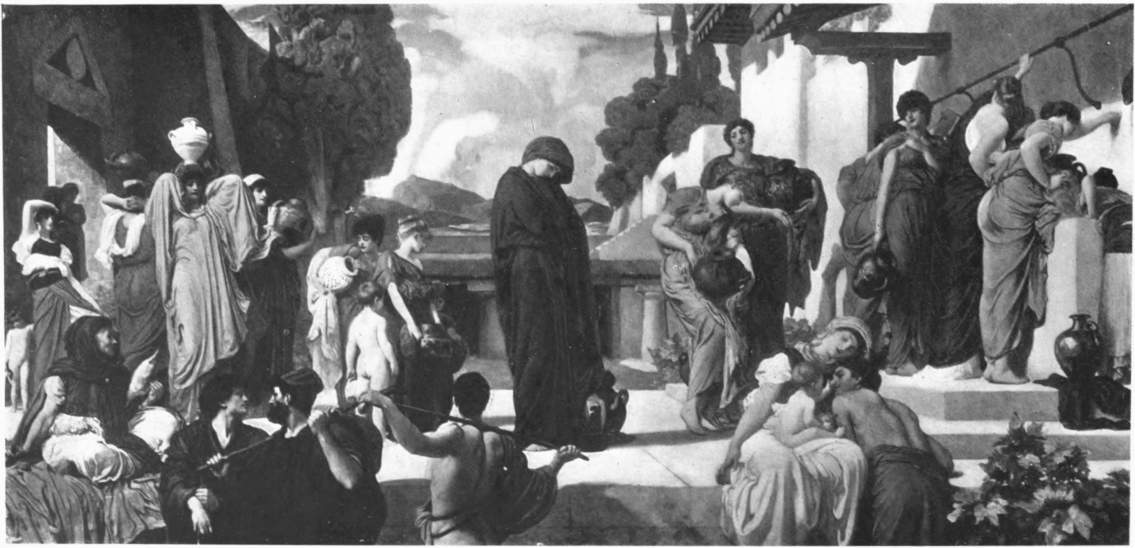 | |
| LEIGHTON. | CAPTIVE ANDROMACHE. |
| (By permission of the Berlin Photographic Co., the owners of the copyright.) | |
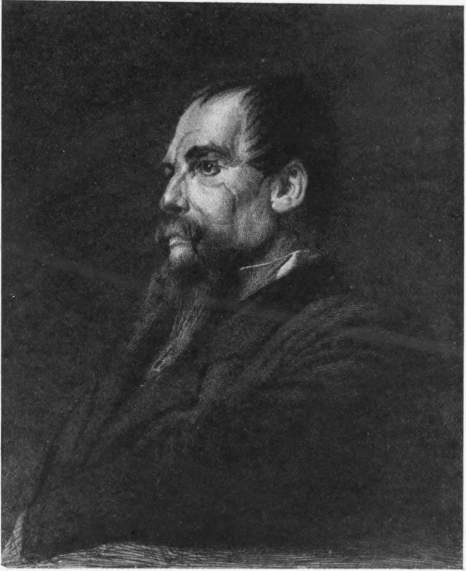 |
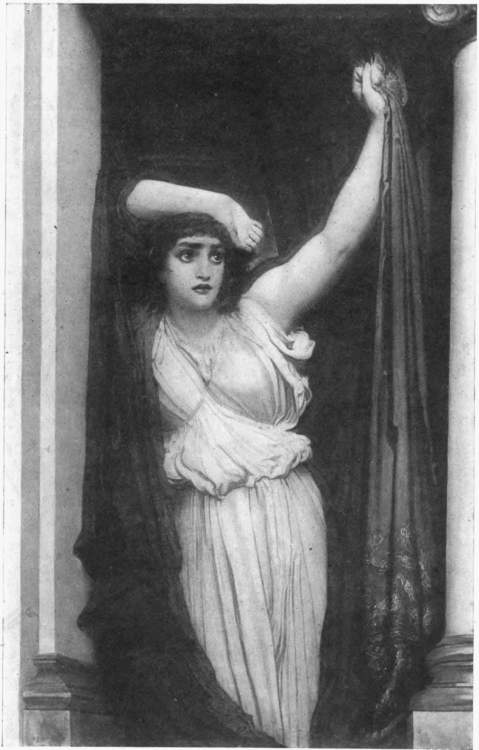 | ||
| Portfolio. | Brothers, photo. | ||
| LEIGHTON. | SIR RICHARD BURTON. | LEIGHTON. | THE LAST WATCH OF HERO. |
| (By permission of the Corporation of Manchester, the owners of the picture.) | |||
Perhaps the “Captive Andromache” of 1888 is the quintessence of what he aimed at. The background is the court of an ancient palace, where female slaves are gathered together fetching water. In the centre of the stage, as the leading actress, stands Andromache, who has placed her pitcher on the ground before her, and waits with dignity until the slaves have finished their work. This business of water-drawing has given Leighton an opportunity for combining an assemblage of beautiful poses. The widow of Hector expresses a queenly sorrow with decorum, while the amphora-bearers are standing or walking hither and thither, in the manner demanded by the pictures upon Grecian vases, but without that sureness of line which comes of the real observation of life. In its dignity of style, in the noble composition and purity of the lines which circumscribe the forms with so much distinction and in so impersonal a manner, the picture is an arid and measured work, cold as marble and smooth as porcelain. “Hercules wrestling with Death for the Body of Alcestis” might be a Grecian relief upon a sarcophagus, so carefully balanced are the masses and the lines. The pose of Alcestis is that of the nymphs of the Parthenon; only, it would not have been so fine were these not in existence. His “Music Lesson” of 1877 is charming, and his “Elijah in the Wilderness” is a work of style. And in his frescoes in the South Kensington Museum there is a perfect compendium of beautiful motives of gesture. The eye delights to linger over these feminine forms, half nude, half enveloped with drapery, yet it notes, too, that these creations are composed out of the painter’s knowledge and artistic reminiscences; there is a want of life in them, because the master has surrendered himself to feeling with the organs of a dead Greek. Leighton’s colour is always carefully considered, scrupulously polished, and endowed with the utmost finish, but it never has the magical charm by which one recognises the work of a true colourist. It is rather the result of painstaking study and cultivated taste than of personal feeling. The grace of form is always carefully prepared—a thing which has the consciousness of its own existence. Beautiful and spontaneous as the movements undoubtedly are, one has always a sense 348 that the artist is present, anxiously watching lest any of his actors offend against a law of art.
Lord Leighton’s pupils, Poynter and Prinsep, followed him with a good deal of determination. Val Prinsep shares with Leighton the smooth forms of a polished painting, whereas Edward Poynter by his more earnest severity and metallic precision verges more on that union of aridness and style characteristic of Ingres. His masterpiece, “A Visit to Æsculapius,” is in point of technique one of the best products of English Classicism. To the left Æsculapius is sitting beneath a pillared porch overgrown with foliage, while, like Raphael’s Jupiter in the Farnesina, he supports his bearded chin thoughtfully with his left hand. A nymph who has hurt her foot appears, accompanied by three companions, before the throne of the god, begging him for a remedy. To say nothing of many other nude or nobly draped female figures, numerous decorative paintings in the Houses of Parliament, St. Paul’s, and St. Stephen’s Church in Dulwich owe their existence to this most industrious artist.
Alma Tadema, the famous Dutchman who has called to life amid the London fog the sacrifices of Pompeii and Herculaneum, stands to this grave academical group as Gérôme to Couture. As Bulwer Lytton, in the field of literature, created a picture of ancient civilisation so successful that it has not been surpassed by his followers, Alma Tadema has solved the problem of the picture of antique manners in the most authentic fashion in the province of painting. He has peopled the past, rebuilt its towns and refurnished its houses, rekindled the flame upon the sacrificial altars and awakened the echo of the dithyrambs to new life. Poynter tells old fables, while Alma Tadema takes us in his 349 company, and, like the best-informed cicerone, leads us through the streets of old Athens, reconstructing the temples, altars, and dwellings, the shops of the butchers, bakers, and fishmongers, just as they once were.
 |
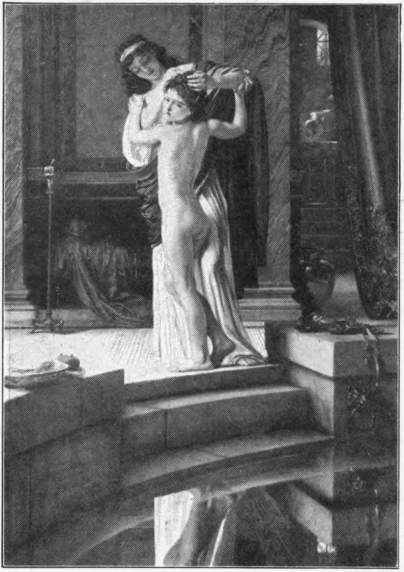 | ||
| Dixon, photo. | |||
| LEIGHTON. | THE BATH OF PSYCHE. | POYNTER. | IDLE FEARS. |
| (By permission of the Berlin Photographic Co., the owners of the copyright.) | (By permission of Lord Hillingdon, the owner of the picture.) | ||
This power of making himself believed Alma Tadema owes in the first place to his great archæological learning. By Leys in Brussels this side of his talent was first awakened, and in 1863, when he went to Italy for the first time, he discovered his archæological mission. How the old Romans dressed, how their army was equipped and attired, became as well known to him as the appearance of the citizens’ houses, the artizans’ workshops, the market and the bath. He explored the ruins of temples, and he grew familiar with the privileges of the priests, the method of worship, of the sacrifices, and of the festal processions. There was no monument of brass or marble, no wall-painting, no pictured vase nor mosaic, no sample of ancient arts, of pottery, stone-cutting, or work in gold, that he did not study. His brain soon became a complete encyclopædia of antiquity. He knew the forms of architecture as well as he knew the old myths, and all the domestic appointments and robes as exactly as the usages of ritual. In Brussels, as early as the sixties, this complete power of living in the period he chose to represent gave Alma Tadema’s pictures from antiquity their remarkable cachet of striking truthfulness to life. And London, whither he migrated in 1870, offered even a more favourable soil for his art. Whereas the French painters of the antique picture of manners often fell into a 350 diluted idealism and a lifeless traffic with old curiosities, with Alma Tadema one stands in the presence of a veritable fragment of life; he simply paints the people amongst whom he lives and their world. The Pompeian house which he has built in London, with its dreamy vividarium, its great golden hall, its Egyptian decorations, its Ionic pillars, its mosaic floor, and its Oriental carpets, contains everything one needs to conjure up the times of Nero and the Byzantine emperors. It is surrounded by a garden in the old Roman style, and a large conservatory adjoining is planted with plane-trees and cypresses. All the celebrated marble benches and basins, the figures of stone and bronze, the tiger-skins and antique vessels and garments of his pictures, may be found in this notable house in the midst of London. Whether he paints the baths, the amphitheatre, or the atrium, the scenes of his pictures are no other than parts of his own house which he has faithfully painted.
And the figures moving in them are Englishwomen. Among all the beautiful things in the world there are few so beautiful as English girls. Those tall, slender, vigorous figures that one sees upon the beach at Brighton are really like Greek women, and even the garb which they wear in playing tennis is as free and graceful as that of the Grecian people. Alma Tadema was able to introduce into his works these women of lofty and noble figure with golden hair, these forms made for sculpture—to use the phrase of Winckelmann—without any kind of beautifying idealism. In their still-life his pictures are the fruit of enormous archæological learning which has become intuitive vision, but his figures are the result of a healthy rendering of life. In this way the unrivalled classical local colour of his interiors is to be explained, as well as the lifelike character of his figures. By his works a remarkable problem is solved: an intense feeling for modern reality has called the ancient world into being in a credible fashion, whilst it has remained barricaded against all others who have approached it by the road of idealism.
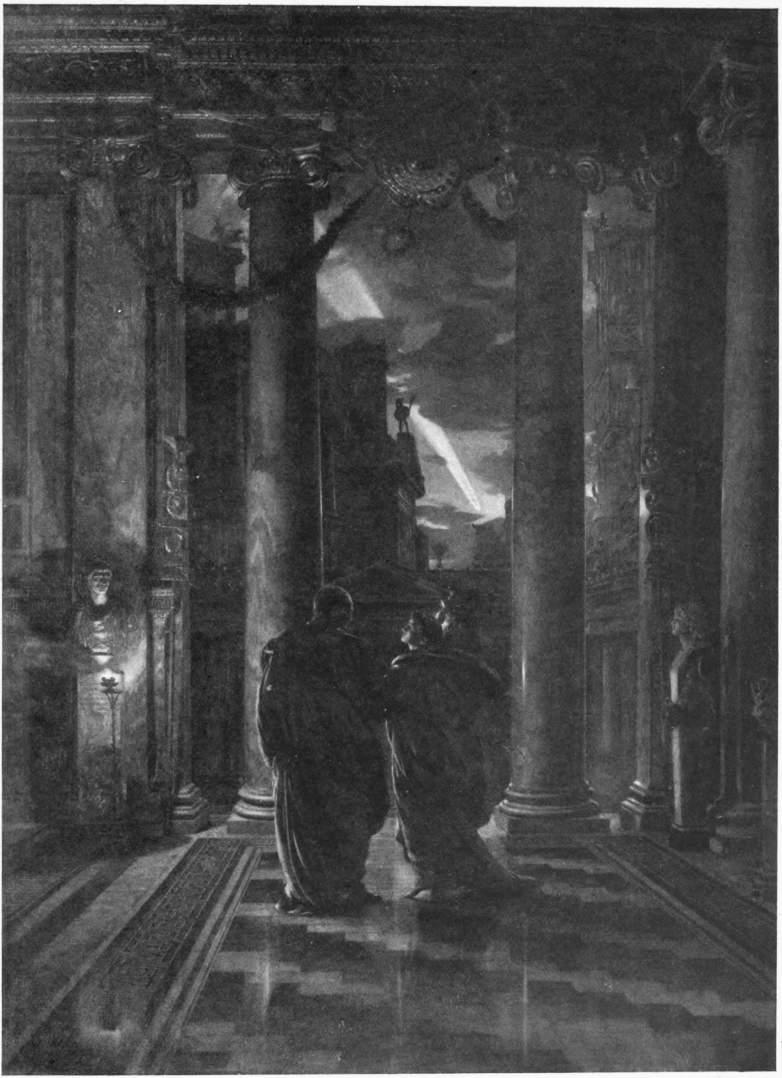 | |
| POYNTER. | Brothers, photo. THE IDES OF MARCH. |
| (By permission of the Corporation of Manchester, the owners of the picture.) | |
It is only in this method of execution that he still stands upon the same ground as Gérôme, with whom he shares a taste for anecdote, and a pedantic, neat, and correct style of painting. His ancient comedies played by English actors are an excellent archæological lecture; they rise above the older picture of antique manners by a more striking fidelity to nature, very different from the generalisation of the Classicists’ ideal; yet as a painter he is wanting in every quality. His marble shines, his bronze gleams, and everything is harmonised with the green of the cypresses and delicate rose-colour of the oleander blossoms in a cool marble tone; but there is also something marble in the figures themselves. He draws and stipples, works like a copper engraver, and goes over his work again and again with a fine and feeble brush. His pictures have the effect of porcelain, his colours are hard and lifeless. One remembers the anecdotes, but one cannot speak of any idea of colour.
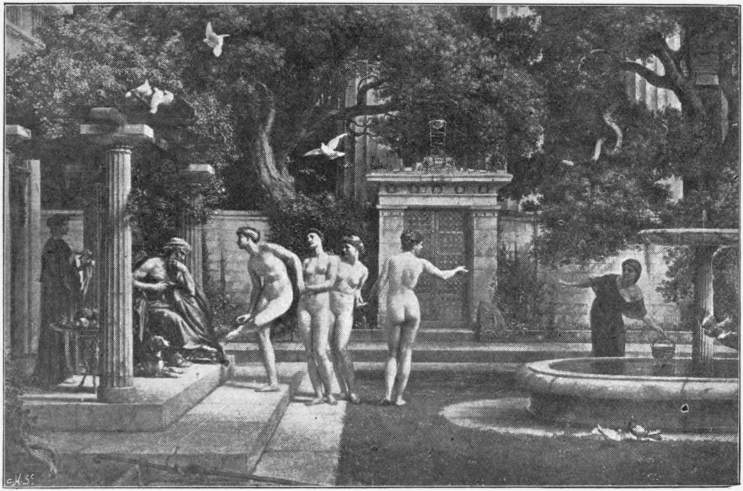 | |
| POYNTER. | Dixon, photo. A VISIT TO ÆSCULAPIUS. |
| (By permission of the Berlin Photographic Co., the owners of the copyright.) | |
 | |
| ALMA TADEMA. | L’Art. SAPPHO. |
| (By permission of the Berlin Photographic Co., the owners of the copyright.) | |
Albert Moore is to be noted as the solitary “painter” of the group: a very delicate artist, with a style peculiar to himself; one who is not so well known upon the Continent as he deserves to be. His province, also, is ancient Greece, yet he never attempted to reconstruct classical antiquity as a learned archæologist. Merely as a painter did he love to dream amid the imperishable world of beauty known to ancient times. His figures are ethereal visions, and move in dreamland. He was influenced, indeed, by the sculptures of the Parthenon, but the Japanese have also penetrated his spirit. From the Greeks he learnt the combination of noble lines, the charm of dignity and quietude, while the Japanese gave him the feeling for harmonies of colour, for soft, delicate, blended tones. By a capricious union of both these elements 354 he formed his refined and exquisite style. The world which he has called into being is made up of white marble pillars; in its gardens are cool fountains and marble pavements; but it is also full of white birds, soft colours, and rosy blossoms from Kioto, and peopled with graceful and mysterious maidens, clothed in ideal draperies, who love rest, enjoy an eternal youth, and are altogether contented with themselves and with one another. It might be said that the old figures of Tanagra had received new life, were it not felt, at the same time, that these beings must have drunk a good deal of tea. Not that they are entirely modern, for their figures are more plastic and symmetrical than those of the actual daughters of Albion; but in all their movements they have a certain chic, and in all their shades of expression a weary modernity, through which they deviate from the conventional woman of Classicism. Otherwise the pictures of Albert Moore are indescribable. Frail, ethereal beings, blond as corn, lounge in æesthetically graduated grey and blue, salmon-coloured, or pale purple draperies upon bright-hued couches decorated by Japanese artists with most æsthetic materials; or are standing in violet robes with white mantles embroidered with gold, by a grey-blue sea which has a play of greenish tones where it breaks upon the shore. They stand out with their rosy garments from the light grey background and the delicate arabesques of a gleaming silvery gobelin, or in a graceful pose occupy themselves with their rich draperies. They do as little as they possibly can, but they are living and seductive, and the stuffs which they wear and have around them are delicately and charmingly painted. It is harmonies of tone and colour that exclusively form the subject of every work. The 355 figures, accessories, and detail first take shape when the scheme of colour has been found; and then Albert Moore takes a delight in naming his pictures “Apricots,” “Oranges,” “Shells,” etc., according as the robes are apricot or orange colour or adorned with light ornaments of shell. Everything which comes from his hands is delightful in the charm of delicate simplicity, and for any one who loves painting as painting it has something soothing in the midst of the surrounding art, which still confuses painting with poetry more than is fitting.
 | |
| Mansell Photo. | |
| ALMA TADEMA. | A VISIT. |
 |
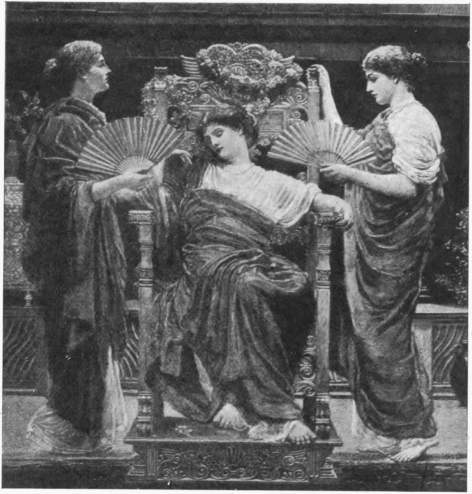 | ||
| Scribner. | Scribner. | ||
| ALBERT MOORE. | ALBERT MOORE. | MIDSUMMER. | |
| (By permission of Messrs. Cadbury, Jones & Co., the owners of the copyright.) | |||
Such a painter-poet of the specifically English type is Briton-Rivière. He is a painter of animals, and as such one of the greatest of the century. Lions and geese, royal tigers and golden eagles, stags, dogs, foxes, Highland cattle, he has painted them all, and with a mastery which has nothing like it except in Landseer. Amongst the painters of animals he stands alone through his power of conception and his fine poetic vein, while in all his pictures he unites the greatest simplicity with enormous dramatic force. Accessory work is everywhere kept within the narrowest limits, and everywhere the character of the animals is magnificently grasped. He does not alone paint great tragic scenes as Barye chiselled them, for he knows that beasts of prey are usually quiet and peaceable, and only now and then obey their savage nature. Moreover, he never attempts to represent animals performing a masquerade of humanity in their gestures and expression, as Landseer did, nor does he transform them into comic actors. He paints them as what they are, a symbol of what humanity was once itself, with its elemental passions and its natural virtues and failings. Amongst all animal painters he is almost alone in resisting the temptation to give the lion a consciousness of his own dignity, the tiger a consciousness of his own savageness, the dog a consciousness of his own understanding. They neither pose nor think about themselves. In addition to this he has a powerful and impressive method, and a deep and earnest scheme of colour. In the beginning of his career he learnt most from James Ward. Later he felt the influence of the refined, chivalrous, and piquant Scotchmen Orchardson and Pettie. But the point in which Briton-Rivière is altogether peculiar is that in which he joins issue with the painters influenced by Greece: he introduces his animals into a scene where there are men of the ancient world.
Briton-Rivière is descended from a French family which found its way into England after the revocation of the Edict of Nantes, and he is one of those painters—so 356 frequent in English art—whose nature has developed early: when he was fourteen he left school, exhibited in the Academy when he was eighteen, painted as a pre-Raphaelite between the ages of eighteen and twenty-two, and graduated at Oxford at seven-and-twenty. In his youth he divided his time between art and scholarship—painting pictures and studying Greek and Latin literature. Thus he became a painter of animals, having also an enthusiasm for the Greek poets, and he has stood for a generation as an uncontested lord and master on his own peculiar ground. In his first important picture, of 1871, the comrades of Ulysses, changed into swine, troop grunting round the enchantress Circe. In the masterpiece of 1872 the Prophet Daniel stands unmoved and submissive to the will of God amid the lions roaring and showing their teeth, ready to spring upon him in their hunger, yet regarding him with a mysterious fear, spellbound by the power of his eye; while his great picture “Persepolis” makes the appeal of a page from the philosophy of history, with its lions roaming majestically amid the ruins of human grandeur and human civilisation, which are flooded with moonlight. The picture “In Manus Tuas, Domine,” showed St. George riding solitary through the lonely and silent recesses of a primitive forest upon a pale white horse. He is armed in mail and has a mighty sword; a deep seriousness is imprinted on his features, for he has gone forth to slay the dragon. In yet another picture, “An Old-World Wanderer,” a man of the early ages has come ashore upon an untrodden island, and is encompassed by flocks of great white birds, fluttering round him with curiosity and confidence, as yet ignorant of the fear of human beings. The picture of 1891, “A Mighty Hunter before the Lord,” is one of his most poetic night-pieces: Nimrod is returning home, and beneath the silvery silence of the moon the dead and dying creatures which he has laid low upon the wide Assyrian plain are tended and bemoaned by their mates.
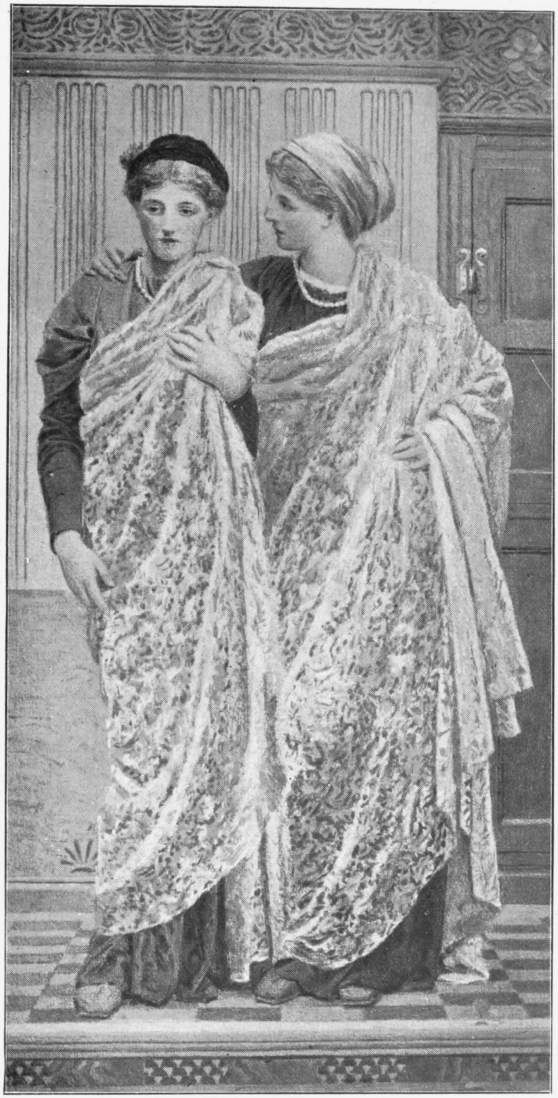 | |
| ALBERT MOORE. | COMPANIONS. |
| (By permission of Messrs. Dowdeswell & Dowdeswells, the owners of the copyright.) | |
Between whiles he painted subjects which were not borrowed from ancient history, illustrating the friendship between man and dog, as Landseer had done before him. For instance, in “His Only Friend” there is a poor lad who has broken down at the last milestone before the town and is guarded by his dog. In “Old Playfellows,” again, one of the playmates is a child, who is sick and leans back quietly in an armchair covered with cushions. His friend the great dog has one paw resting on the child’s lap, and looks up with a pensive expression, such as Landseer alone had previously painted. But in this style he reached his highest point in “Sympathy.” No work of Briton-Rivière’s has become more popular than this picture of the little maiden who has forgotten her key and is sitting helpless before the house-door, consoled by the dog who has laid his head upon her shoulder.
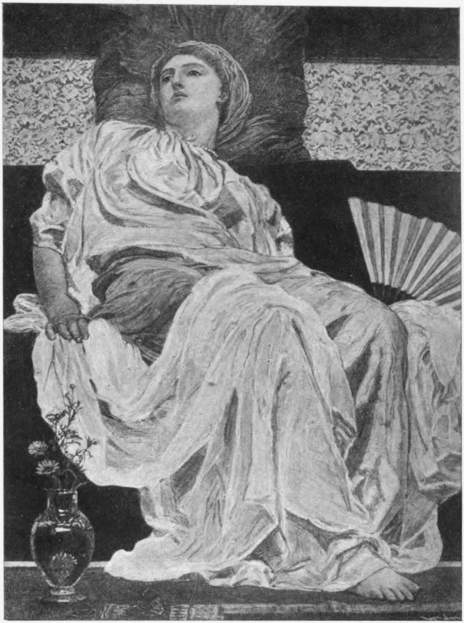 |
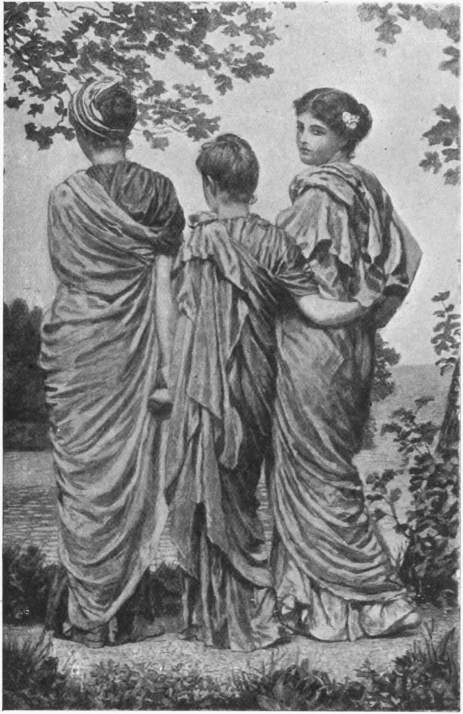 | ||
| Scribner. | Scribner. | ||
| ALBERT MOORE. | YELLOW MARGUERITES. | ALBERT MOORE. | WAITING TO CROSS. |
| (By permission of W. Connal, Esq., the owner of the picture.) | (By permission of Lord Davey, the owner of the picture.) | ||
Since the days of Reynolds English art has shown a most vivid originality in such representations of children. English picture-books for children are in these days the most beautiful in the world, and the marvellous fairy-tales and fireside stories of Randolph Caldecott and Kate Greenaway have made their way throughout the whole Continent. How well these English draughtsmen know the secret of combining truth with the most exquisite grace! How touching are these pretty babies, how angelically innocent these little maidens! Frank eyes, blue as the flowers of the periwinkle, gaze at you with no thought of their being looked at in return. The naïve astonishment of the little ones, their frightened mien, their earnest look absently fixed upon the sky, the first tottering steps of a tiny child and the mobile grace of a schoolgirl, all are rendered in these prints with the most tender intimacy of feeling. And united with this there is a delicate and entirely modern sentiment for scenery, for the fascination of bare autumn landscapes robbed of their foliage, for sunbeams and the budding fragrance of spring. Everything is idyllic, poetic, and touched by a congenial breath of tender melancholy.
And this aerial quality, this delicacy and innocent grace and tenderness, 360 is not confined alone to such representations of children, but is peculiar to English painting. Even when perfectly ordinary subjects from modern life are in question the basis of this art is, as in the first half of the century, by no means the sense for what is purely pictorial, by no means that naturalistic pantheism which inspires the modern French, but rather a sense for what is moral or ethical. The painter seldom paints merely for the joy of painting, and the numberless technical questions which play such an important part in French art are here only of secondary importance. It accords with the character and taste of the people that their artists have rather a poetic design than one which is properly pictorial. The conception is sometimes allegorical and subtle to the most exquisite fineness of point, sometimes it is vitiated by sentimentality, but it is never purely naturalistic; and this qualified realism, this realism with a poetic strain to keep it ladylike, set English art, especially in the years when Bastien-Lepage and Roll were at their zenith, in sharp opposition to the art of France. In those days the life-size artisan picture, the prose of life, and the struggle for existence reigned almost exclusively in the Parisian Salon, whereas in the Royal Academy everything was quiet and cordial; an intimate, inoffensive, and heartfelt cheerfulness was to be found in the pictures upon its walls, as if none of these painters knew of the existence of such a place as Whitechapel. A connection between pictures and poems is still popular, and some touching trait, some tender episode, some expression of softness, is given to subjects drawn from the ordinary life of the people. Painters seek in every direction after pretty rustic scenes, moving incidents, or pure emotions. Instead of being harsh and rugged in their sense of truth and passion, they glide lightly away from anything ugly, bringing together the loveliest 361 and most beautiful things in nature, and creating elegies, pastorals, and idylls from the passing events of life. Their method of expression is fastidious and finished to a nicety; their vision of life is smiling and kindly, though it must not be supposed that their optimism has now anything in common with the genre picture of 1850. The genre painters from Wilkie to Collins epitomised the actual manners of the present in prosaic compositions. But here the most splendid poetry breaks out, as indeed it actually does in the midst of ordinary life. If in that earlier period English painting was awkward in narration, vulgar, and didactic, it is now tasteful, refined, beautiful, and of distinction. The philistinism of the pictures of those days has been finally stripped away, and the humorously anecdotic genre entirely overcome. The generation of tiresome narrative artists has been followed by painter-poets of delicacy and exquisite tenderness of feeling.
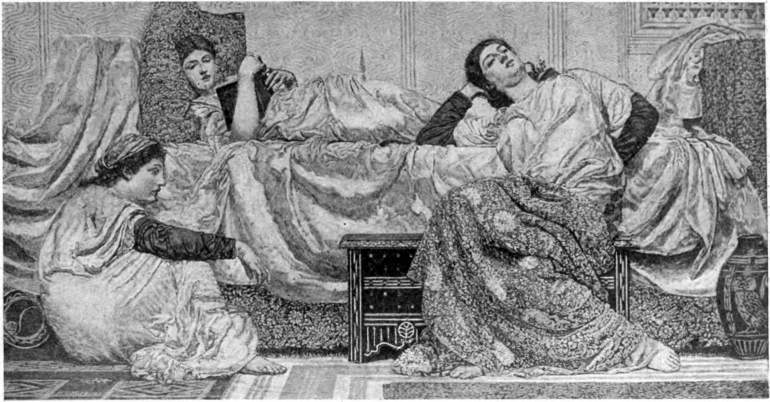 | |
| ALBERT MOORE. | Scribner. READING ALOUD. |
| (By permission of W. Connal, Esq., the owner of the picture.) | |
Two masters who died young and have a peculiarly captivating individuality, George Mason and Fred Walker, stand at the head of this, the most novel phase of English painting. Alike in the misfortune of premature death, they are also united by a bond of sympathy in their taste and sentiment. If there be truth in what Théophile Gautier once said in a beautiful poem, “Tout passe, l’art robuste seul a l’éternité,” neither of them will enter the kingdom of immortality. That might be applied to them which Heine said of Leopold Robert: they have purified the peasant in the purgatory of their art, so that nothing but a glorified body remains. As the pre-Raphaelites wished to give exquisite precision to the world of dream, Walker and Mason have taken this precision from the world of reality, endowing it with a refined subtlety which in truth it does not possess. Their pictures breathe only of the bloom and essence of things, and in them nature is deprived of her strength 362 and marrow, and painting of her peculiar qualities, which are changed into coloured breath and tinted dream. They may be reproached with an excess of nervous sensibility, an effort after style by which modern truth is recast, a morbid tendency towards suave mysticism. Nevertheless their works are the most original products of English painting during the last thirty years, and by a strange union of realism and poetic feeling they have exercised a deeply penetrative influence upon Continental art.
“Æquam semper in rebus arduis servare mentem” might be chosen as a motto for George Mason’s biography. Brought up in prosperous circumstances, he first became a doctor, but when he was seven-and-twenty he went to Italy to devote himself to painting; here he received the news that he was ruined. His father had lost everything, and he found himself entirely deprived of means, so that his life became a long struggle against hunger. He bound himself to dealers, and provided animal pieces by the dozen for the smallest sums. In a freezing room he sat with his pockets empty, worked until it was dark, and crept into bed when Rome went to feast. After two years, however, he had at last saved the money necessary for taking him back to England, and he settled with his young wife in Wetley Abbey. This little village, where he lived his simple life in the deepest seclusion, became for him what Barbizon had been for Millet. He wandered by himself amongst the fields, and painted the valleys of Wetley with the tenderness of feeling with which Corot painted the outskirts of Fontainebleau. He saw the ghostly mists lying upon the moors, saw the peasants returning from the plough and the reapers from the field, noted the children, in their life so closely connected with the change of nature. And yet his peasant pictures more resemble the works of Perugino than those of Bastien-Lepage. The character of their landscape is to some extent responsible for this. For the region he paints, in its lyrical charm, has kinship with the hills in the pictures of Perugino. Here there grow the same slender trees upon a delicate, undulating soil. But the silent, peaceful, and resigned human beings who move across it have also the tender melancholy of Umbrian Madonnas. Mason’s realism is merely specious; it consists in the external point of costume. There are really no peasants of such slender growth, no English village maidens with such rosy faces and such coquettish Holland caps. Mason divests them of all the heaviness of earth, takes, as it were, only the flower-dust from reality. The poetic grace of Jules Breton might be recalled, were it not that Mason works with more refinement and subtlety, for his idealism was unconscious, and never resulted in an empty, professional painting of beauty.
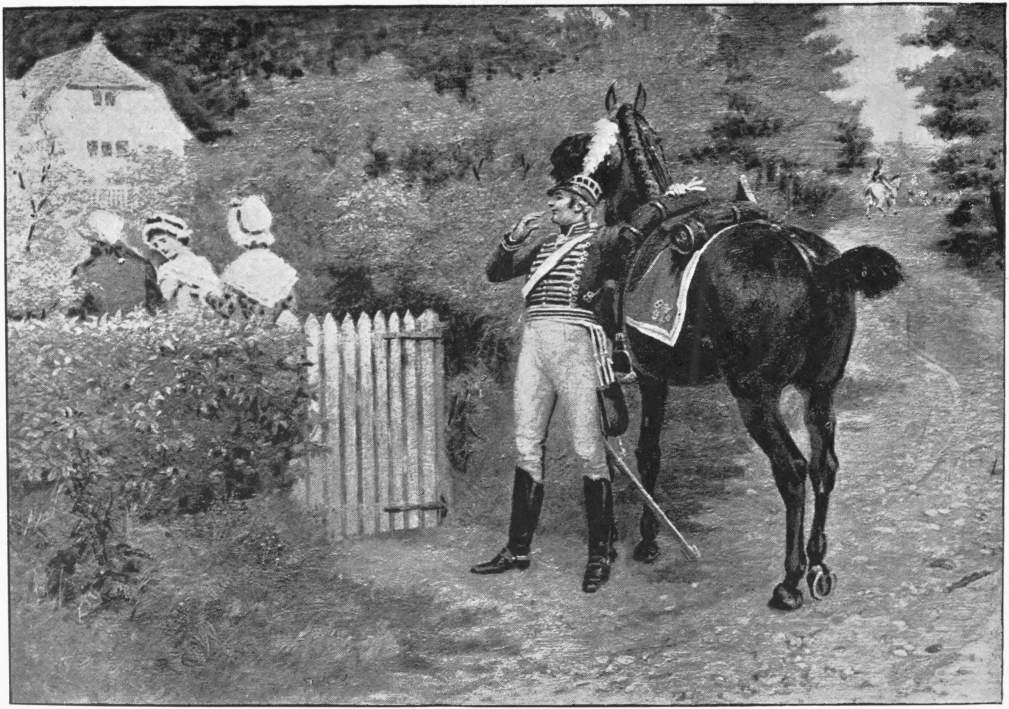 | |
| CALDECOTT. | Brothers, photo. THE GIRL I LEFT BEHIND ME. |
| (By permission of the Corporation of Manchester, the owners of the picture.) | |
When he painted his finest pictures he suffered from very bad health, and his works have themselves the witchery of disease, the fascinating beauty of consumption. He painted with such delicacy and refinement, because sickness had made him weak and delicate; he divested his peasant men and women of everything fleshly, so that nothing but a shadow of them remained, a spirit vibrating in fine, elusive, dying chords. In his “Evening Hymn” girls are singing in the meadow; to judge from their dresses, they should be the daughters of the peasantry, but one fancies them religious enthusiasts, brought together upon this mysterious and sequestered corner of the earth by a melancholy world-weariness, by a yearning after the mystical. Fragile as glass, sensitive to the ends of their fingers, and, one might say, morbidly spiritual, they breathe out their souls in song, encompassed by the soft shadows of the evening twilight, and uttering all the exquisite tenderness of their subtle temperament in the hymn they chant. Another of his pastoral symphonies is “The Harvest Moon.” Farm labourers are plodding homewards after their day’s work. The moon is rising, and casts its soft, subdued light upon the dark hills and the slender trees, in the silvery leaves of which the evening wind is playing. “The Gander,” “The Young Anglers,” and “The Cast Shoe” are captivating through the same delicacy and the same mood of peaceful resignation. George Mason is an astonishing artist, almost always guilty of exaggeration, but always seductive. Life passes in his pictures like a beautiful summer’s day, and with the accompaniment of soft music. A peaceful, delicate feeling, something mystical, bitter-sweet, and suffering, lives beneath the light and tender veil of his pictures. They affect the nerves like a harmonica, and lull one with low and softly veiled harmonies. Many of the melancholy works of Israels have a similar effect, only Israels is less refined, has less of distinction and—more of truth.
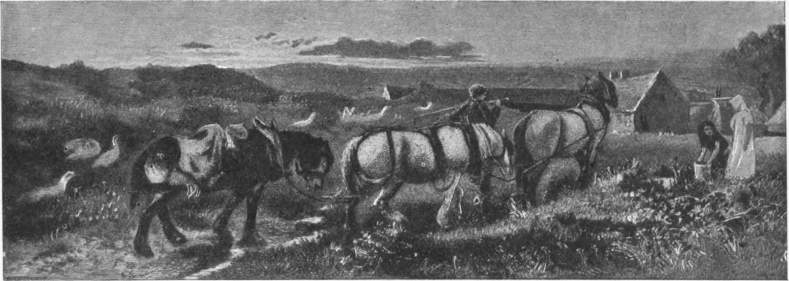 | |
| MASON. | THE END OF THE DAY. |
| (By gracious permission of H.M. Queen Victoria, the owner of the picture.) | |
This suavity of feeling is characteristic in an almost higher degree of Fred Walker, a sensitive artist never satisfied with himself. Every one of his pictures gives the impression of deep and quiet reverie; everywhere a kind of mood, like that in a fairy tale, colours the ordinary events of life in his works, an effect produced by his refined composition of forms and colours. In his classically simple art Mason was influenced by the Italians, and especially the Umbrians. Walker drew a similar inspiration from the works of Millet. Both the Englishman and the Frenchman died in the same year, the former on 20th January 1875, in Barbizon, the latter on 5th June, 366 in Scotland; and yet in a certain sense they stand at the very opposite poles of art. Walker is graceful, delicate, and tender; Millet forceful, healthy, and powerful. “To draw sublimity from what is trivial” was the aim of both, and they both reached it by the same path. All their predecessors had held truth as the foe of beauty, and had qualified shepherds and shepherdesses, ploughmen and labourers, for artistic treatment by forcing upon them the smiling grace and the strained humour of genre painting. Millet and Fred Walker broke with the frivolity of this elder school of painting, which had seen matter for jesting, and only that, in the life of the rustic; they asserted that in the life of the toiler nothing was more deserving of artistic representation than his toil. They always began by reproducing life as they saw it, and by disdaining, in their effort after truth, all artificial embellishment; they came to recognise, both of them at the same time, a dignity in the human frame, and grandiose forms and classic lines in human movement, which no one had discovered before. With the most pious reverence for the exact facts of life, there was united that greatness of conception which is known as style.
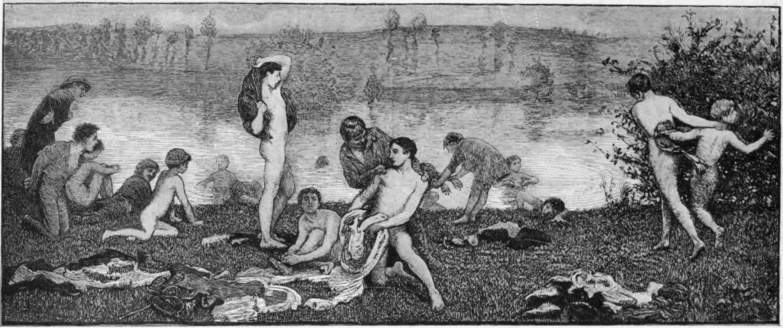 | |
| WALKER. | L’Art. THE BATHERS. |
| (By permission of Messrs. Thomas Agnew & Sons, the owners of the copyright.) | |
Fred Walker, the Tennyson of painting, was born in London in 1840, and had scarcely left school before the galleries of ancient art in the British Museum became his favourite place of resort. Drawings for wood-engraving were his first works, and with Millet in France he has the chief merit of having put fresh life into the traditional style of English wood engraving, so that he is honoured by the young school of wood-engravers as their lord and master. His first, and as yet unimportant, drawings appeared in 1860 in a periodical called Once a Week, for which Leech, Millais, and others also made drawings. Shortly after this début he was introduced to Thackeray, then the editor of Cornhill, and he undertook the illustrations with Millais. In these plates he is already seen in his charm, grace, and simplicity. His favourite season is the tender spring, when the earth is clothed with young verdure, 367 and the sunlight glances over the naked branches, and the children pluck the first flowers which have shot up beneath their covering of snow.
His pictures give pleasure by virtue of the same qualities—delicacy of drawing, bloom of colouring, and a grace which is not affected in spite of its Grecian rhythm.
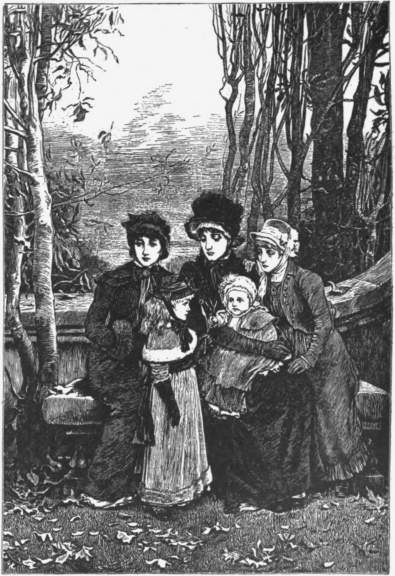 |
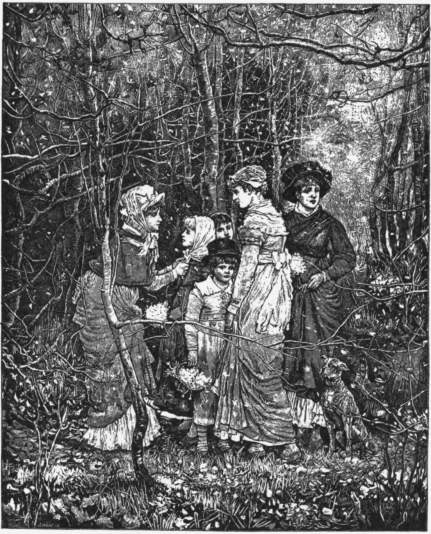 | ||
| L’Art. | L’Art. | ||
| BOUGHTON. | GREEN LEAVES AMONG THE SERE. | BOUGHTON. | SNOW IN SPRING. |
| (By permission of the Artist.) | (By permission of the Artist.) | ||
Walker was the first to introduce that delicate rosy red which has since been popular in English painting. His method of vision is as widely removed from that of Manet as from Couture’s brown sauce. The surface of every one of his pictures resembles a rare jewel in its delicate finish: it is soft, and gives the sense of colour and of refined and soothing harmony. His first important work, “Bathers,” was exhibited in 1867 at the Royal Academy, where works of his appeared regularly during the next five years. About a score of young people are standing on the verge of a deep and quiet English river, and are just about to refresh themselves in the tide after a hot August day. Some, indeed, are already in the water, while others are sitting upon the grass and others undressing. The frieze of the Parthenon is recalled, so plastic is the grace of these young frames, and the style and repose of the treatment of lines, which are such as may only be found in Puvis de Chavannes. In his next picture, “The Vagrants,” he represented a group of gipsies camping round a fire in the midst of an English landscape. A mother is nursing her child, while to the left a woman is standing plunged in thought, and to the right a lad is throwing wood upon the faintly blazing fire. Here, too, the figures are all drawn severely after nature and yet have the air of Greek statues. There is no modern artist who has united in so unforced a manner actuality and fidelity to nature with “the noble simplicity and quiet grandeur” of the antique. In a succeeding picture of 1870, “The Plough,” a labourer is striding over the ground behind the plough. The long day is approaching its end, and the moon stands silvery in the sky. Far into the distance the field stretches away, and the heavy tread of the horses mingles in the stillness of evening with the murmur of the stream which flows round the grassy ridge, making its soft complaint. 368 “Man goeth forth to his work and to his labour until the evening” is its thoroughly English motto. The same still mournfulness of sunset he painted in that work of marvellous tenderness, “The Old Gate.” The peace of dusk is resting upon a soft and gentle landscape. A lady who is the owner of a country mansion and is dressed like a widow has just stepped out from the garden gate, accompanied by her maid, who is in the act of shutting it; children are playing on the steps, and a couple of labourers are going past in front and look towards the lady of the house. It is nothing except the meeting of certain persons, a scene such as takes place every day, and yet even here there is a subtlety and tenderness which raise the event from the prose of ordinary life into a mysterious world of poetry.
In his later period he deviated more and more towards a fragrant lyricism. In his great picture of 1872, “The Harbour of Refuge,” the background is formed by one of those peaceful buildings where the aged poor pass the remainder of their days in meditative rest. The sun is sinking, and there is a rising moon. The red-tiled roof stands out clear against the quiet evening sky, while upon the terrace in front, over which the tremulous yellow rays of the setting sun are shed, an old woman with a bowed figure is walking, guided by a graceful girl who steps lightly forward. It is the old contrast between day and night, youth and age, strength and decay. Yet in Walker there is no opposition after all. For as light mingles with the shadows in the twilight, this young and vigorous woman who paces in the evening, holding the arm of the aged in mysterious silence, has at the moment no sense of her youth, but is rather filled with that melancholy thought underlying Goethe’s “Warte nur balde,” “Wait awhile and thou shalt rest too.” Her eyes have a strange gaze, as though she were looking into vacancy in mere absence of mind. And upon the other side of the picture this theme of the transient life of humanity is still further developed. Upon a bench in the midst of a verdant lawn covered with daisies a group of old men are sitting meditatively near a hedge of hawthorn luxuriant in blossom. Above the bench there stands an old statue casting a 369 clearly defined shadow upon the gravel path, as if to point to the contrast between imperishable stone and the unstable race of men, fading away like the autumn leaves. Well in the foreground a labourer is mowing down the tender spring grass with a scythe—a strange, wild, and rugged figure, a reaper whose name is Death.
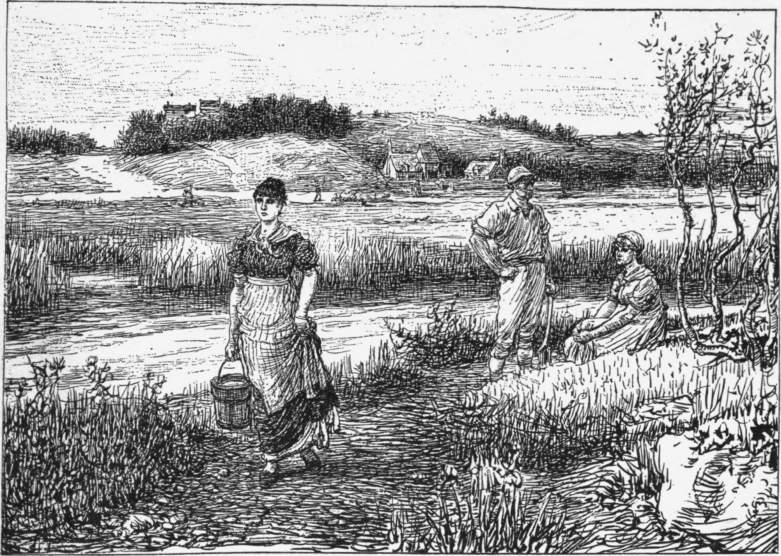 | |
| BOUGHTON. | L’Art. A BREATH OF WIND. |
| (By permission of the Artist.) | |
It was not long before evening drew on for the painter, and Death, the mighty reaper, laid him low.
Of a nervous and sensitive temperament, Walker had one of those natures which find their way with difficulty through this rude world of fact. Those little things which he had the art of painting so beautifully, and which occupy such an important place in his work, had, in another sense, more influence upon his life than ought to have been the case. While Mason faced all unpleasantnesses with stoical indifference, Walker allowed himself to be disturbed and hindered in his work by every failure and every sharp wind of criticism. In addition to that he was, like Mason, a victim of consumption. A residence in Algiers merely banished the insidious disease for a short time. Amongst the last works, which he exhibited in 1875, a considerable stir was made by a drawing called “The Unknown Land”: a vessel with naked men is drawing near the shores of a wide and peaceful island bathed in a magical light. Soon afterwards Walker had himself departed to that unknown land: he died 370 in Scotland when he was five-and-thirty. His body was brought to the little churchyard at Cookham on the banks of the Thames. In this village Fred Walker is buried amid the fair river landscape which he so loved and so often painted.
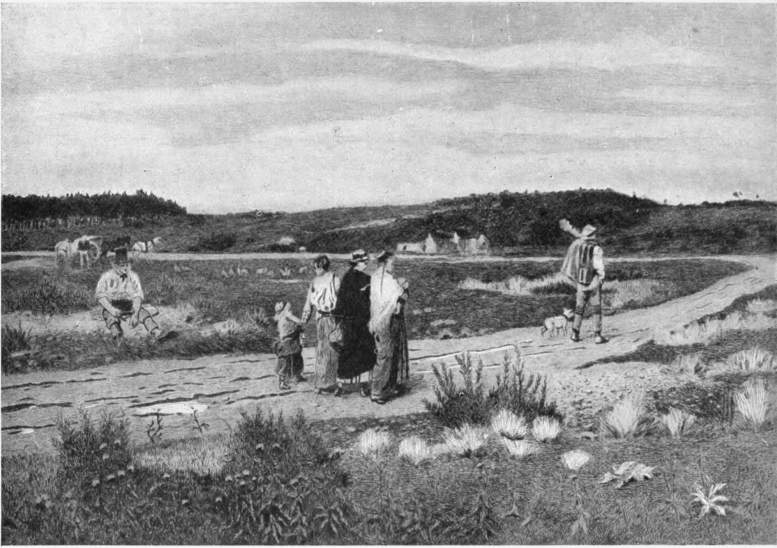 | |
| BOUGHTON. | L’Art. THE BEARERS OF THE BURDEN. |
| (By permission of the Artist.) | |
After the pre-Raphaelite revolution, the foundation of the school of Walker indicated the last stage of English art. His influence was far greater than might be supposed from the small number of his works, and fifty per cent. of the English pictures in every exhibition would perhaps never have been painted if he had not been born. A national element long renounced, that old English sentiment which once inspired the landscapes of Gainsborough and the scenes of Morland, and was lost in the hands of Wilkie and the genre painters, lives once more in Fred Walker. He adapted it to the age by adding something of Tennyson’s passion for nature. There is a touch of symbolism in that old gate which he painted in the beautiful picture of 1870. He and Mason opened it so that English art might pass into this new domain, where musical sentiment is everything, where one is buried in sweet reveries at the sight of a flock of geese driven by a young girl, or a labourer stepping behind his plough, or a child playing, free from care, with pebbles at the water’s edge. Their disciples are perhaps healthier, or, should one say, “less refined,”—in other words, not quite so sensitive and hyper-æsthetic as those who opened the old gate. They seem physically more 371 robust, and can better face the sharp air of reality. They no longer dissolve painting altogether into music and poetry; they live more in the world at every hour, not merely when the sun is setting, but also when the prosaic daylight exposes objects in their material heaviness. But the tender ground-tone, the effort to seize nature in soft phases, is the same in all. Like bees, they suck from reality only its sweets. The earnest, tender, and deeply heartfelt art of Walker has influenced them all.
Evening when work is over, the end of summer, twilight, autumn, the pale and golden sky, and the dead leaves are the things which have probably made the most profound impression on the English spirit. The hour when toil is laid aside, and rest begins and people seek their homes, and the season when fires are first lighted are the hour and the season most beloved by this people, which, with all its rude energy, is yet so tender and full of feeling. Repose to the point of enervation and the stage where it passes into gentle melancholy is the theme of their pictures—this, and not toil.
How many have been painted in the last forty years in which people are returning from their work of an evening across the country! The people in the big towns look upon the country with the eyes of a lover, especially those parts of it which lie near the town; not the scenes painted by Raffaelli, but the parks and public gardens. Soft, undulating valleys and gently swelling hills are spread around, the flowers are in bloom, and the leaves glance in the sunshine. And over this country, with its trim gravel paths and its green, luxuriant lawns, there comes a well-to-do people. Even the labourers seem in good case as they go home across the flowery meadows.
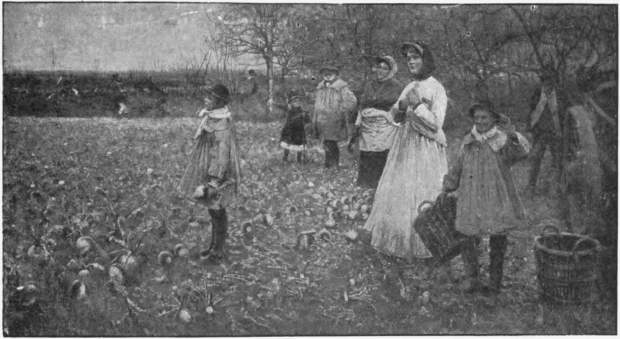 | |
| Cassell & Co. | |
| J. R. REID. | TOIL AND PLEASURE. |
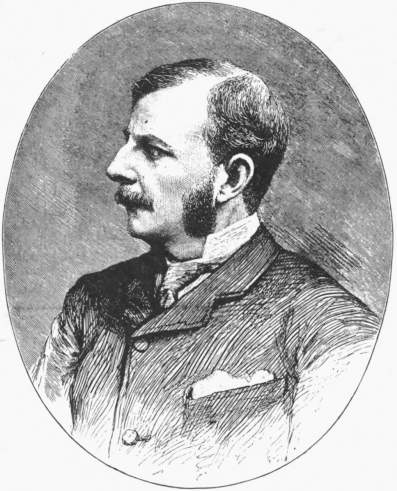 |
| FRANK HOLL. |
George H. Boughton was one of the most graceful and refined amongst Walker’s followers. By birth and descent a countryman of Crome and Cotman, he passed his youth in America, worked several years in Paris from 1853, and in 1863 settled in London, where he was exceedingly active as a draughtsman, 372 a writer, and a painter. His charming illustrations for Harper’s Magazine, where he also published his delicate story The Return of the Mayflower, are well known. As a painter, too, his brush was only occupied by pleasant things, whether belonging to the past or the present. There is something in him both of the delicacy of Gainsborough and of the poetry of Memlinc. He delights in the murmur of brooks and the rustle of leaves, in fresh children and pretty young women in æesthetically fantastic costume; he loves everything delicate, quiet, and fragrant. And for this reason he also takes delight in old legends entwined with blossoms, and attains a most harmonious effect when he places shepherds and kings’ daughters of story, and steel-clad knights and squires in his charming and entirely modern landscapes. Almost always it is autumn, winter, or at most the early spring in his pictures. The boughs of the trees are generally bare, though sometimes a tender pointed yellowish verdure is budding upon them. At times the mist of November hovers over the country like a delicate veil; at times the snowflakes fall softly, or the October sun gleams through the leafless branches.
Moreover, a feeling for the articulation of lines, for a balance of composition, unforced, and yet giving a character of distinction, is peculiar to him in a high degree. In 1877 he had in the Royal Academy the charming picture “A Breath of Wind.” Amid a soft landscape with slender trees move the thoroughly Grecian figures of the shapely English peasants, whilst the tender evening light is shed over the gently rising hills. His picture of 1878 he named “Green Leaves among the Sere”: a group of children, in the midst of whom the young mother herself looks like a child, are seated amid an autumn landscape, where the leaves fall, and the sky is shrouded in wintry grey. In the picture “Snow in Spring” may be seen a party of charming girls—little modern Tanagra figures—whom the sun has tempted into the air to search for the earliest woodland snowdrops under the guidance of a damsel still in her ’teens. Having just reached a secret corner of the wood, they are standing with their flowers in their hands surrounded by tremulous boughs, when a sudden snowstorm overtakes them. Thick white flakes alight upon the slender boughs, and combine with the light green leaves and pale reddish dresses of the children in making a delicate harmony of colour. Among his legendary pictures the poetic “Love Conquers all 373 Things,” in particular is known in Germany: a wild shepherd’s daughter sits near her flock, and the son of a king gazes into her eyes lost in dream.
 | |
| HOLL. | “THE LORD GAVE, THE LORD HATH TAKEN AWAY; BLESSED BE THE NAME OF THE LORD.” |
| (By permission of E. C. Pawle, Esq., the owner of the picture.) | |
Boughton is not the only painter of budding girlhood. All English literature has a tender feminine trait. Tennyson is the poet most widely read, and he has won all hearts chiefly through his portraits of women: Adeline, Eleänore, Lilian, and the May Queen—that delightful gallery of pure and noble figures. In English painting, too, it is seldom men who are represented, but more frequently women and children, especially little maidens in their fresh pure witchery.
Belonging still to the older period there is Philip H. Calderon, an exceedingly fertile although lukewarm and academical artist, in whose blood is a good deal of effeminate Classicism. When his name appears in a catalogue it means that the spectator will be led into an artificial region peopled with pretty girls—beings who are neither sad nor gay, and who belong neither to the present nor to ancient times, to no age in particular and to no clime. Whenever such ethereal girlish figures wear the costume of the Directoire period, Marcus Stone is their father. He is likewise one of the older men whose first appearance was made before the time of Walker. His young ladies part broken-hearted from a beloved suitor, turned away by their father, 374 and save the honour of their family by giving their hand to a wealthy but unloved aspirant, or else they are solitary and lost in tender reveries. In his earliest period Marcus Stone had a preference for interiors; rich Directoire furniture and objects of art indicate with exactness the year in which the narrative takes place. Later, he took a delight in placing his rococo ladies and gentlemen in the open air, upon the terraces of old gardens or in sheltered alleys. All his pictures are pretty, the faces, the figures, and the accessories; in relation to them one may use the adjective “pretty” in its positive, comparative, or superlative degree. In England Marcus Stone is the favourite painter of “sweethearts,” and it cannot be easy to go so near the boundaries of candied genre painting and yet always to preserve a certain noblesse.
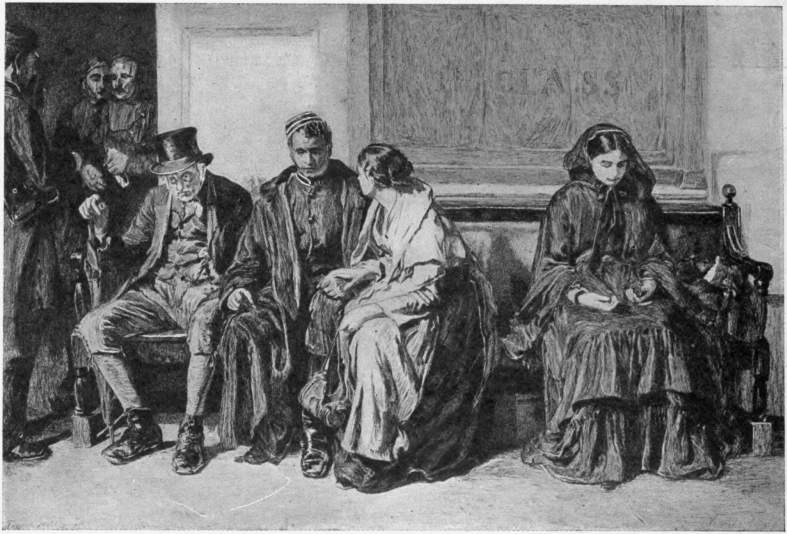 | |
| L’Art. | |
| HOLL. | LEAVING HOME. |
Amongst later artists G. D. Leslie, the son of Charles Leslie, has specially the secret of interpreting innocent feminine beauty, that somewhat predetermined but charming grace derived from Gainsborough and the eighteenth century. A young lady who has lately been married is paying a visit to her earlier school friends, and is gazed upon as though she were an angel by these charming girls. Or his pretty maidens have ensconced themselves beneath the trees, or stand on the shore watching a boat at sunset, or amuse themselves from a bridge in a park by throwing flowers into the water and looking dreamily after them as they float away. Leslie’s pictures, too, are very pretty and poetic, and have much silk in them and much sun, while the soft pale method of painting, so highly æsthetic in its delicate attenuation of colour, corresponds with the delicacy of their purport.
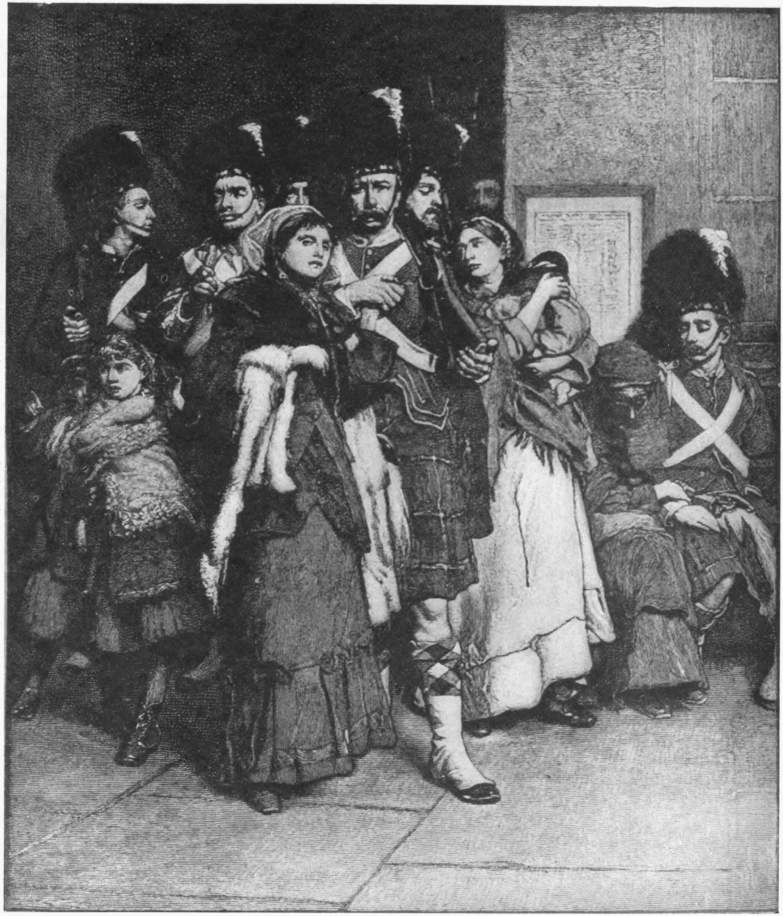 | |
| HOLL. | ORDERED TO THE FRONT. |
P. G. Morris, not less delicate in feeling and execution, became specially known by a “Communion in Dieppe.” Directly facing the spectator a train of pretty communicants move upon the seashore, assuming an air of dignified superiority, like young ladies from Brighton or Folkestone. A bluish light plays over the white dresses of the girls and over the blue jackets of the sailors lounging about the quay; it fills the pale blue sky with a misty vibration and glances sportively upon the green waves of the sea. “The Reaper and the Flowers” was a thoroughly English picture, a graceful allegory after the fashion of Fred Walker. On their way from school a party of children meet at the verge of a meadow an old peasant going home from his day’s work with a scythe upon his shoulder. In the dancing step of the little ones may be seen the influence of Greek statues; they float along as if borne by the zephyr, with a rhythmical motion which is seldom found in real school-children. But the old peasant coming towards them is intended to recall the contrast between youth and age as in Fred Walker’s “Harbour of Refuge”; while the scythe glittering in the last rays of the setting sun signifies the scythe of Fate, the scythe of death which does not even spare the child.
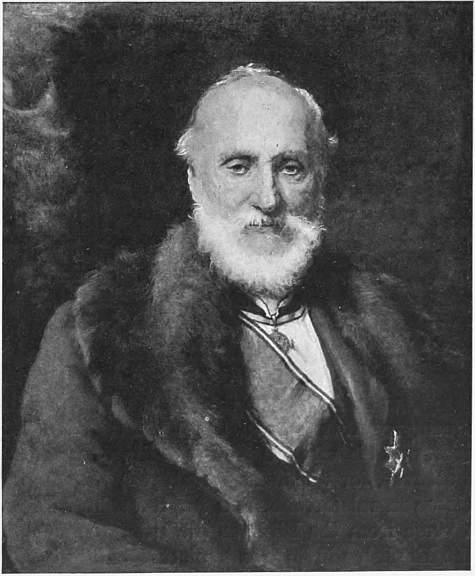 |
| OULESS. LORD KELVIN. |
| (By permission of the Artist.) |
And thus the limits of English painting are defined. It always reveals a certain conflict between fact and poetry, reverie and life. For whenever the scene does not admit of a directly ethical interpretation, refuge is invariably taken in lyricism. The wide field which lies between, where powerful works are nourished, works which have their roots in reality, and derive their life from it alone, has not been definitely conquered by English art. England is the greatest producer and consumer in the world, and her people press the marrow out of things as no other have ever done: and yet this land of industry knows nothing of pictures in which 378 work is being accomplished; this country, which is a network of railway lines, has never seen a railway painted. Even horses are less and less frequently represented in English art, and sport finds no expression there whatever. Much as the Englishman loves it from a sense of its wholesomeness, he does not consider it sufficiently æsthetic to be painted, a matter upon which Wilkie Collins enlarges in an amusing way in his book Man and Wife.
And in English pictures there are no poor, or, at any rate, none who are wretched in the extreme. For although the Chelsea Pensioners were a favoured theme in painting, there were none of them miserable and heavy-laden; they were rather types of the happy poor who were carefully tended. If English painters are otherwise induced to represent the poor, they depict a room kept in exemplary order, and endeavour to display some touching or admirable trait in honest and admirable people. In fact, people seem to be good and honourable wherever they are found. Everywhere there is content and humility, even in misfortune. Even where actual need is represented, it is only done in the effort to give expression to what is moving in certain dispensations of fate, and to create a lofty and conciliating effect by the contrast between misfortune and man’s noble trust in God.
John R. Reid, a Scotchman by birth, but residing in London, has treated scenes from life upon the seacoast in this manner. How different his works are from the tragedies of Joseph Israels, or the grim naturalism of Michael Ancher! He occupies himself only with the bright side of life with its colour and sunshine, not with the dark side with its toils. He paints the inhabitants of the country in their Sunday best, as they sit telling stories, or as they go a-hunting, or regale themselves in the garden of an inn. The old rustics who sit happy with their pipes and beer in his “Cricket Match” are typical of everything that he has painted.
And even when, once in a way, a more gloomy trait appears in his pictures, it is there only that the light may shine the more brightly. The poor old flute-player who sits homeless upon a bench near the house is placed there merely to show how well off are the children who are hurrying merrily home after school. His picture of 1890, indeed, treated a scene of shipwreck, but a passage from a poet stood beneath; there was not a lost sailor to be seen, and all the tenderness of the artist is devoted to the pretty children and the young women gazing with anxiety and compassion across the sea.
Frank Holl was in the habit of giving his pictures a more lachrymose touch, together with a more sombre and ascetic harmony of colour. He borrowed his subjects from the life of the humble classes, always searching, moreover, for melancholy features; he took delight in representing human virtue in misfortune, and for the sake of greater effect he frequently chose a verse from the Bible as the title. Thus the work with which he first won the English public was a picture exhibited in 1869: “The Lord gave, the Lord hath taken away; blessed be the name of the Lord.” A family of 379 five brothers and sisters, who have just lost their mother, are assembled round the breakfast-table in a poorly furnished room. One sister is crying, another is sadly looking straight before her, whilst a third is praying with folded hands. The younger brother, a sailor, has just reached home from a voyage, to close his dying mother’s eyes, and the eldest of all, a young and earnest curate, is endeavouring to console his brothers and sisters with the words of Job.
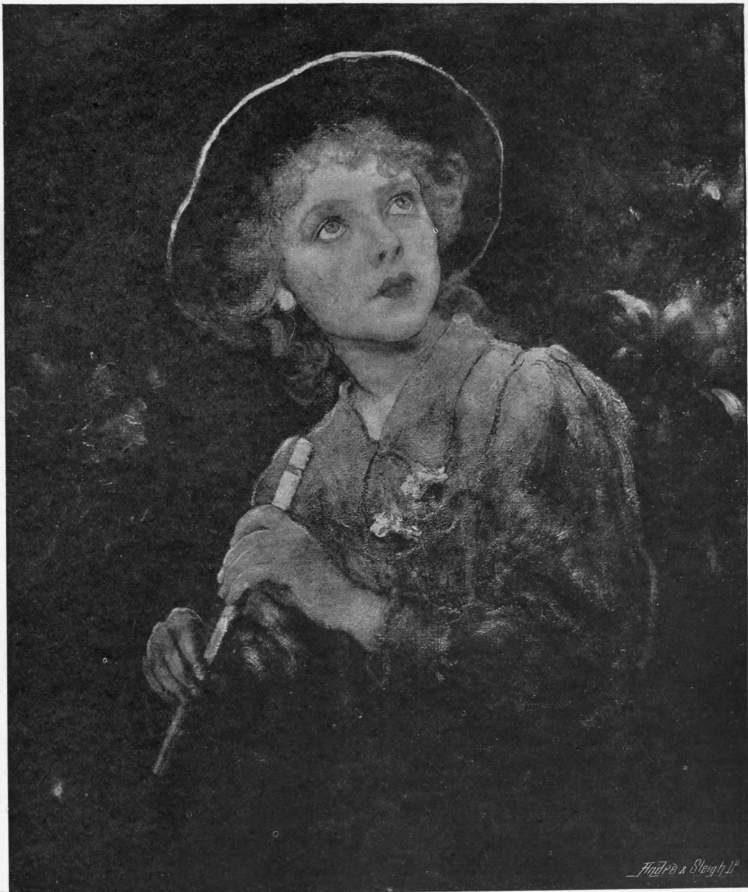 | |
| SANT. | Cassell & Co. THE MUSIC LESSON. |
| (By permission of the Artist.) | |
The next picture, exhibited in 1871, he called “No Tidings from the Sea,” and represented in it a fisherman’s family—grandmother, mother, and child—who in a cheerless room are anxiously expecting the return of a sailor. “Leaving Home” showed four people sitting on a bench outside a waiting-room at a railway station. To awaken the spectator’s pity “Third Class” is written in large letters upon the window just above their heads. The principal figure is a lady dressed in black, who is counting, in a somewhat obtrusive manner, the little money which she still has left.
In the picture “Necessity knows no Law” a poor woman with a child in her arms has entered a pawnshop to borrow money on her wedding-ring; in another, women of the poorer class are to be seen walking along with their soldier sons and husbands, who have been called out on active service. One of them clasps tightly to her breast her little child, the only one still remaining to her in life, whilst an aged widow presses the hand of her son with the sad presentiment that, even if he comes back to her, she will probably not have long to live after his return. Not only did Frank Holl paint stories for his countrymen, but he also painted them big in majuscule characters which were legible without spectacles, and he partially owed his splendid successes to this cheap sentimentality.
Almost everywhere the interest of subject still plays the first part, and this slightly lachrymose trait bordering on genre, this lyrically tender or allegorically subtle element, which runs through English figure pictures, would easily degenerate into vaporous enervation in another country. In England portrait painting, which now, as in the days of Reynolds, is the greatest title to honour possessed by English art, invariably maintains its union with direct reality. By acknowledgment portrait painting in the present day is exceedingly earnest: it admits of no decorative luxuriousness, no sport with hangings and draperies, no pose; and English likenesses have this severe actuality in the highest degree. Stiff-necked obstinacy, sanguine resolution, and muscular force of will are often spoken of as an Englishman’s national characteristics, and a trace of these qualities is also betrayed in English portrait painting. The self-reliance of the English is far too great to suffer or demand any servile habit of flattery: everything is free from pose, plain and simple. Let the subject be the weather-beaten figure of an old sailor or the dazzling freshness of English youth, there is a remarkable energy and force of life in all their works, even in the pictures of children with their broad open brow, finely chiselled nose, and assured and penetrative glance. And as portrait painting in England, to its own advantage and the benefit of all art, has never been considered as an isolated province, such pictures may be specified among the works of the most frigid academician as well as amongst those of the most vigorous naturalist. Frank Holl, who had such a Düsseldorfian tinge in his more elaborate pictures, showed at the close of his life, in his likenesses of the engraver Samuel Cousins, Lord Dufferin, Mr. Joseph Chamberlain, Lord Wolseley, Mr. Gladstone, the Duke of Cleveland, 381 Sir George Trevelyan, and Lord Spencer, a simple virility altogether wanting in his earlier works. They had a trenchant characterisation and an unforced pose which were striking even in England. It is scarcely possible to exhibit people more naturally, or more completely to banish from their expression that concentrated air of attentiveness which suggests photography and so easily intrudes into a portrait. Even Leighton, so devoid of temperament, so entirely devoted to the measured art of the ancients, became at once nervous and almost brutal in his power when he painted a portrait in place of ideal Grecian figures. His vivid and forcible portrait of Sir Richard Burton, the celebrated African traveller, would do honour to the greatest portrait painter of the Continent.
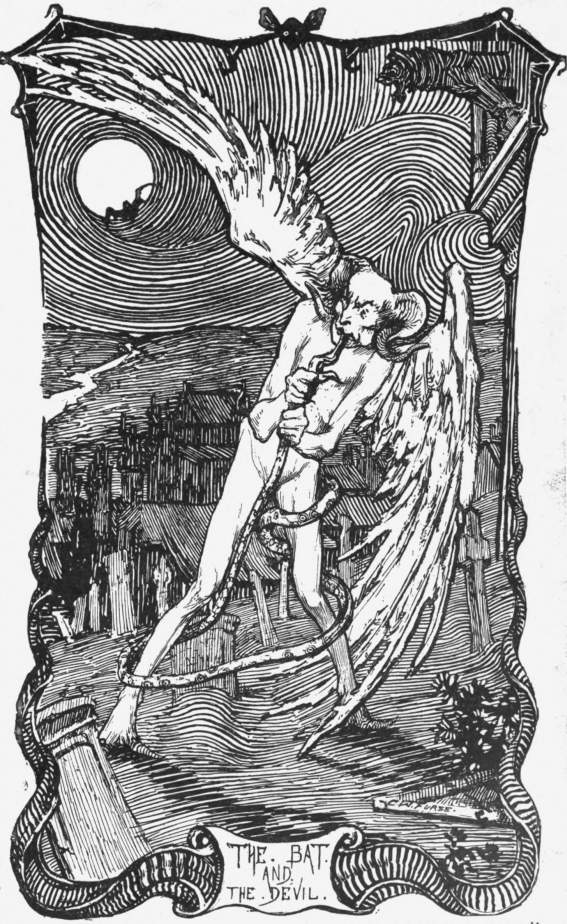 |
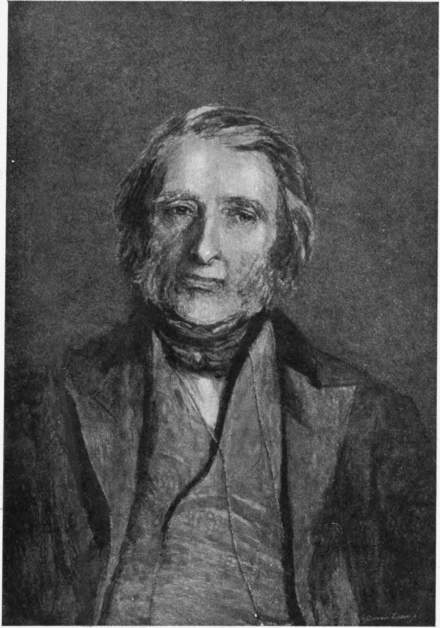 | ||
| Mag. of Art. | |||
| FURSE. | FRONTISPIECE TO “STORIES AND INTERLUDES.” | HERKOMER. | JOHN RUSKIN. |
| (By permission of the Artist.) | |||
Amongst portrait painters by profession Walter Ouless will probably merit the place of honour immediately after Watts as an impressive exponent of character. He has assimilated much from his master Millais—not merely the heaviness of colour, which often has a disturbing effect in the latter, but also Millais’ powerful flight of style, always so free from false rhetoric. The chemical expert Pochin, as Ouless painted him in 1865, does not pose in the 382 picture nor allow himself to be disturbed in his researches. It is a thoroughly contemporary portrait, one of those brilliant successes which later occurred in France also. The Recorder of London, Mr. Russell Gurney, he likewise painted in his professional character and in his robes of office. In its inflexible graveness and earnest dignity the likeness is almost more than the portrait of an individual; it seems the embodiment of the proud English Bench resting upon the most ancient traditions. His portrait of Cardinal Manning had the same convincing power of observation, the same large and sure technique. The soft light plays upon the ermine and the red stole, and falls full upon the fine, austere, and noble face.
Besides Ouless mention may be made from among the great number of portrait painters of J. J. Shannon, with his powerful and firmly painted likenesses; of James Sant, with his sincere and energetic portraits of women; of Mouat Loudan, with his pretty pictures of children, and of the many-sided Charles W. Furse. Hubert Herkomer was the most celebrated in Germany, and is probably the most skilful of the young men whom The Graphic brought into eminence in the seventies.
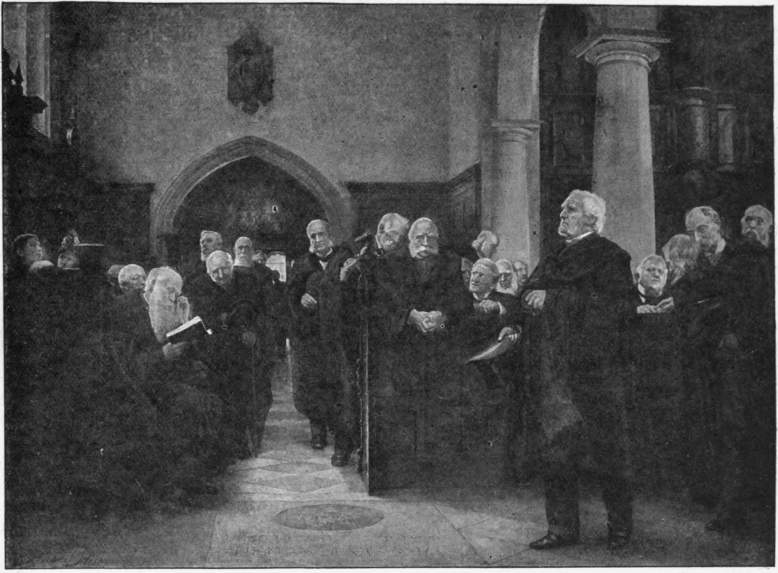 | |
| Cassell & Co. | |
| HERKOMER. | CHARTERHOUSE CHAPEL. |
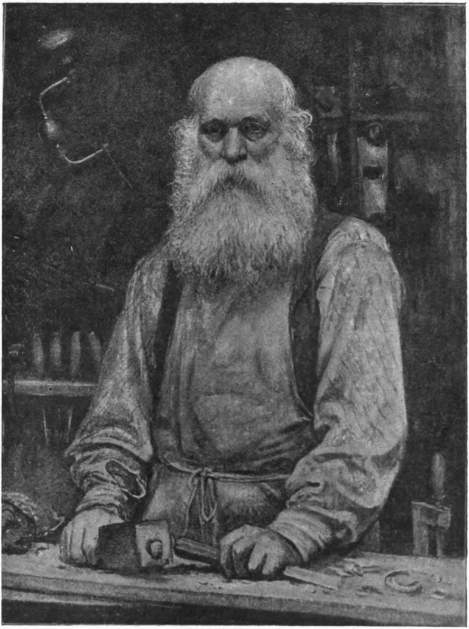 |
| Art Annual. |
| HERKOMER. PORTRAIT OF HIS FATHER. |
| (By permission of the Artist.) |
The career of Hubert Herkomer is amongst those adventurous ones which become less and less frequent in the nineteenth century; there are not many who have risen so rapidly to fame and fortune from such modest circumstances. His father was a carver of sacred images in the little Bavarian village of Waal, where Hubert was born in 1849. In 1851 the enterprising Bavarian tried his fortune in the New World. But there he did not succeed in making progress, and in 1857 the family appeared in England, at Southampton. Here he fought his way honestly at the bench where he carved, and as a journeyman worker, whilst his wife gave lessons in music. A commission to carve Peter Vischer’s four evangelists in wood brought him with his son to Munich, where they occupied room in the back buildings of 383 a master-carpenter’s house, in which they slept, cooked, and worked. In the preparatory class of the Munich Academy the younger Herkomer received his first teaching, and began to draw from the nude, the antique serving as model. At a frame-maker’s in Southampton he gave his first exhibition, and drew illustrations for a comic paper. With the few pence which he saved from these earnings he went to London, where he lived from hand to mouth with a companion as poor as himself. He cooked, and his friend scoured the pans; meanwhile he worked as a mason on the frieze of the South Kensington Museum, and hired himself out for the evenings as a zither-player. Then The Graphic became his salvation, and after his drawings had made him known he soon had success with his paintings. “After the Toil of the Day,” a picture which he exhibited in the Royal Academy of 1873—a thoughtful scene from the village life of Bavaria, carried out after the manner of Fred Walker—found a purchaser immediately. He was then able to make a home for his parents in the village of Bushey, which he afterwards glorified in the picture “Our Village,” and he began his masterpiece “The Last Muster,” which obtained in 1878 the great medal at the World Exhibition in Paris. Since then he found the eyes of the English public fixed upon him. There followed at first a series of pictures in which he proceeded upon the lines of Fred Walker’s poetic realism: “Eventide,” a scene in the Westminster 384 Union; “The Gloom of Idwal,” a romantic mountain picture from North Wales; “God’s Shrine,” a lonely Bavarian hillside path, with peasants praying at a shrine; “Der Bittgang,” a group of country people praying for harvest; “Contrasts,” a picture of English ladies surrounded by school-children in the Bavarian mountains. At the same time he became celebrated as a portrait painter, his first successes in this field being the likenesses of Wagner and Tennyson, Archibald Forbes, his own father, John Ruskin, Stanley, and the conductor Hans Richter. And he reached the summit of his international fame when his portrait of Miss Grant, “The Lady in White,” appeared in 1886; all Europe spoke of it at the time, and it called forth entire bundles of poems, anecdotes, biographies, and romances. From that time he advanced in his career with rapid strides.
The University of Oxford appointed him Professor of the Fine Arts. He opened a School of Art, and had etchings, copper engravings, and engravings in mezzotint produced by his pupils under his guidance. He wrote articles in the London papers upon social questions, and political economy, and all manner of subjects, an article signed with Herkomer’s name being always capable of creating interest. He has his own theatre, and produces in it operas of which he writes the text and the music, and manages the rehearsals and the scenery, besides playing the leading parts.
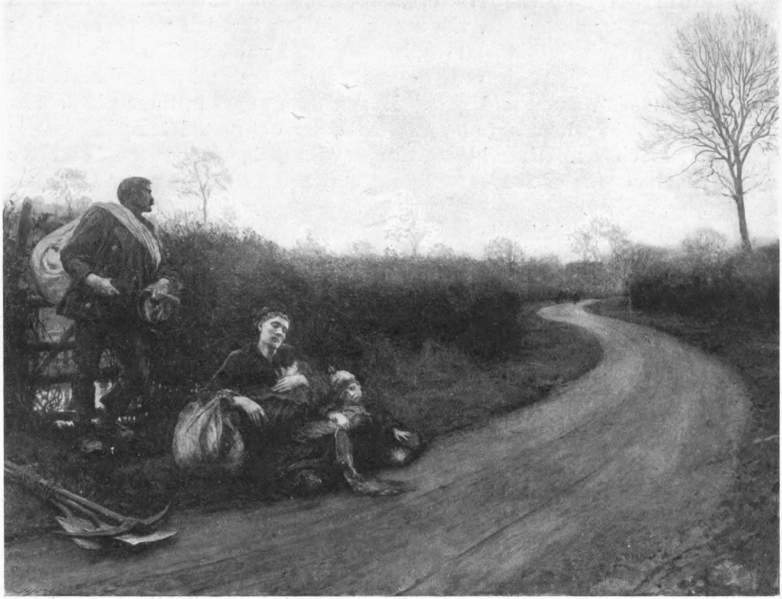 | |
| HERKOMER. | Brothers, photo. HARD TIMES. |
| (By permission of the Manchester Art Gallery, the owners of the picture.) | |
Yet it is just his portraits of women, the foundations of his fame, which do not seem in general to justify entirely the painter’s great reputation. Miss Grant was certainly a captivating woman, and she broke men’s hearts wherever she made her appearance. People gazed again and again into the brilliant brown eyes with which she looked so composedly before her; they were overwhelmed by her austere and lofty virginal beauty. “The Lady in Black (An American Lady)” made yet a more piquant and spiritualised 385 effect. There was the unopened bud, and here the woman who has had experience of the delights and disappointments of life. There was unapproachable pride, and here a trait of distinction and of suffering, an almost weary carriage of the body. There would certainly be an interesting gallery of beauty if Herkomer unite these “types of women” in a series. But even in the first picture how much of all the admiration excited was due to the painter and how much to the model? The portrait of Miss Grant was such a success primarily because Miss Grant herself was so beautiful. The arrangement of white against white was nothing new: Whistler, a far greater artist, had already painted a “White Girl” in 1863, and it was a much greater work of art, though, on account of the attractiveness of the model being less powerful, it triumphed only in the narrower circle of artists. Bastien-Lepage, who set himself the same problem in his “Sara Bernhardt,” had also run through the scale of white with greater sureness. And Herkomer’s later pictures of women—“The Lady in Yellow,” Lady Helen Fergusson, and others—are even less alluring, considered as works of art. The reserve and evenness of the execution give his portraits a somewhat clotted and stiff appearance. Good modelling and exceedingly vigorous drawing may perhaps ensure great 386 correctness in the counterfeit of the originals, but the life of the picture vanishes beneath the greasy technique, the soapy painting through which materials of drapery and flesh-tints assume quite the same values. There is nothing in it of the transparency, the rosy delicacy, freshness, and flower-like bloom of Gainsborough’s women and girls. Herkomer appears in these pictures as a salon painter in whom a tame but tastefully cultivated temperament is expressed with charm. Even his landscapes with their trim peasants’ cottages and their soft moods of sunset have not enriched with new notes the scale executed by Walker.
All the more astonishing is the earnest certainty of touch and the robust energy which are visible in his other works. His portraits of men, especially the one of his father, that kingly old man with the long, white beard and the furrowed brow, take their place beside the best productions of English portraiture, which are chiselled, as it were, in stone. In “The Last Muster” he showed that it is possible to be simple and yet strike a profound note and even attain greatness. For there is something great in these old warriors, who at the end of their days are praying, having never troubled themselves over prayer during all their lives, who have travelled so far and staked their lives dozens of times, and are now drawing their last breath softly upon the seats of a church. Even his more recent groups—“The Assemblage of the Curators of the Charterhouse” and “The Session of the Magistrates of Landsberg”—are magnificent examples of realistic art, full of imposing strength and soundness. In the representation of these citizens the genius of the master who in his “Chelsea Pensioners” created one of the “Doelen pieces” of the nineteenth century, revealed itself afresh in all its greatness.
Beside portrait painting the painting of landscape stands now as ever in full bloom amongst the English; not that the artists of to-day are more consistently faithful to truth than their predecessors, or that they seem more modern in the study of light. In the province of landscape as in that of figure painting, far more weight is laid upon subject than on the moods of atmosphere. If one compares the modern English painters with Crome and Constable, one finds them wanting in boldness and creative force; and placed beside Monet, they seem to be diffident altogether. But a touching reverence for nature gives almost all their pictures a singularly chaste and fragrant charm.
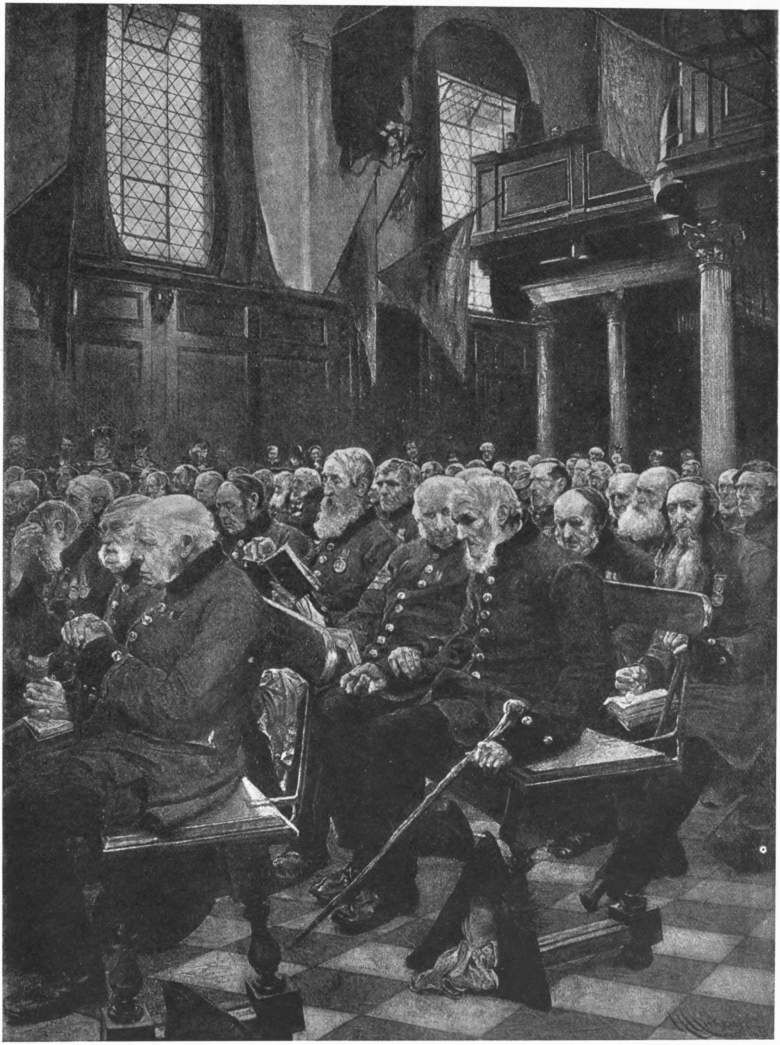 | |
| HERKOMER. | Mag. of Art. THE LAST MUSTER. |
| (By permission of Messrs. Boussod, Valadon & Co., the owners of the picture.) | |
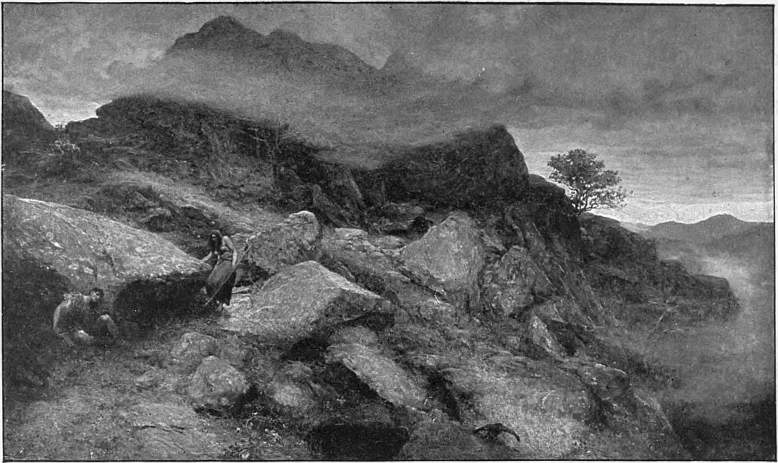 | |
| Cassell & Co. | |
| HERKOMER. | FOUND. |
Of course, all the influences which have affected English art in other respects are likewise reflected in landscape painting. The epoch-making activity of the pre-Raphaelites, the passionate earnestness of Ruskin’s love for nature, as well as the influence of foreign art, have all left their traces. In his own manner Constable had spoken the last word. The principal thing in him, as in Cox, was the study of atmospheric effects and of the dramatic life of air. They neither of them troubled themselves about local colour, but sought to render the tones which are formed under atmospheric and meteorological influences; they altogether sacrificed the completion of the details of subject to seizing the momentary impression. In Turner, generally speaking, it was only the air that lived. Trees and buildings, rocks and water, are merely repoussoirs for the atmosphere; they are exclusively ordained to lead the eye through the mysterious depths of light and shadow. The intangible absorbed what could be touched and handled. As a natural reaction there came this pre-Raphaelite landscape, and by a curious irony of chance the writer who had done most for Turner’s fame was also he who first welcomed this pre-Raphaelite landscape school. Everything which the old school had neglected now became the essential object of painting. The landscape painters fell in love with the earth, with the woods and the fields; and the more autumn resolved the wide green harmony of nature into a sport of colours multiplied a thousand times, the more did they love it. Thousands of things were there to be seen. First, how the foliage turned yellow and red and brown, and then how it fell away: how it was scattered upon a windy day, whirling in a yellow drift of leaves; how in still weather leaf after leaf lightly rustled to the ground from between the wavering brown boughs. And then when the foliage fell from the trees and bushes the most inviolate secrets of summer came to light; there lay around quantities of bright seeds and berries rich in colour, brown nuts, smooth acorns, black and glossy sloes, and scarlet haws. In the leafless beeches there clustered pointed beechmast, the mugwort bent beneath its heavy red bunches, late blackberries lay black and brown amid the damp foliage upon the road, bilberries grew amid the heather, and wild raspberries bore their dull red fruit once again. The dying ferns took a hundred colours; the moss shot up like the ears of a miniature cornfield. Eager as children the landscape 390 painters roamed here and there across the woodland, to discover its treasures and its curiosities. They understood how to paint a bundle of hay with such exactness that a botanist could decide upon the species of every blade. One of them lived for three months under canvas, so as thoroughly to know a landscape of heath. Confused through detail, they lost their view of the whole, and only made a return to modernity when they came to study the Parisian landscape painters. Thus English art in this matter made a curious circuit, giving and taking. First, the English fertilised French art; but at the time when French artists stood under the influence of the English, the latter swerved in the opposite direction, until they ultimately received from France the impulse which led them back into the old way.
In accordance with these different influences, several currents which cross and mingle with each other are to be found flowing side by side in English landscape painting: upon one side a spirit of prosaic reasonableness, a striving after clearness and precision, which does not know how to sacrifice detail, and is therefore wanting in pictorial totality of effect; on the other side an artistic pantheism which rises at times to high lyrical poetry in spite of many dissonances.
The pictures of Cecil Lawson lead to the point where the pre-Raphaelites begin. The elder painters, with their powerful treatment and the freedom and boldness of their execution, still keep altogether on the lines of Constable, whereas in later painters, with their minute elaboration of all particularities, the influence of the pre-Raphaelites becomes more and more apparent.
Where Cecil Lawson ended, James Clarke Hook began, the great master-spirit who opened the eyes of the world fifty years ago to the depth of colouring and the enchanting life of nature, even in its individual details. His pictures, especially those sunsets which he paints with such delight, have something devout and religious in them; they have the effect of a prayer or a hymn, and often possess a solemnity which is entirely biblical, in spite of their brusque, pungent colours. In his later period he principally devoted himself to sea-pieces, and in doing so receded from the pre-Raphaelite painting of detail, which is characteristic of his youthful period. His pictures give one the breath of the sea, and his sailors are old sea-wolves. All that remains from his pre-Raphaelite period is that, as a rule, they carry a certain burden of ideas.
Vicat Cole, likewise one of the older school, is unequal and less important. From many of his pictures one receives the impression that he has directly copied Constable, and others are bathed in dull yellow tones; nevertheless he has sometimes painted autumn pictures, felicitous and noble landscapes, in which there is really a reflection of the sun of Claude Lorrain.
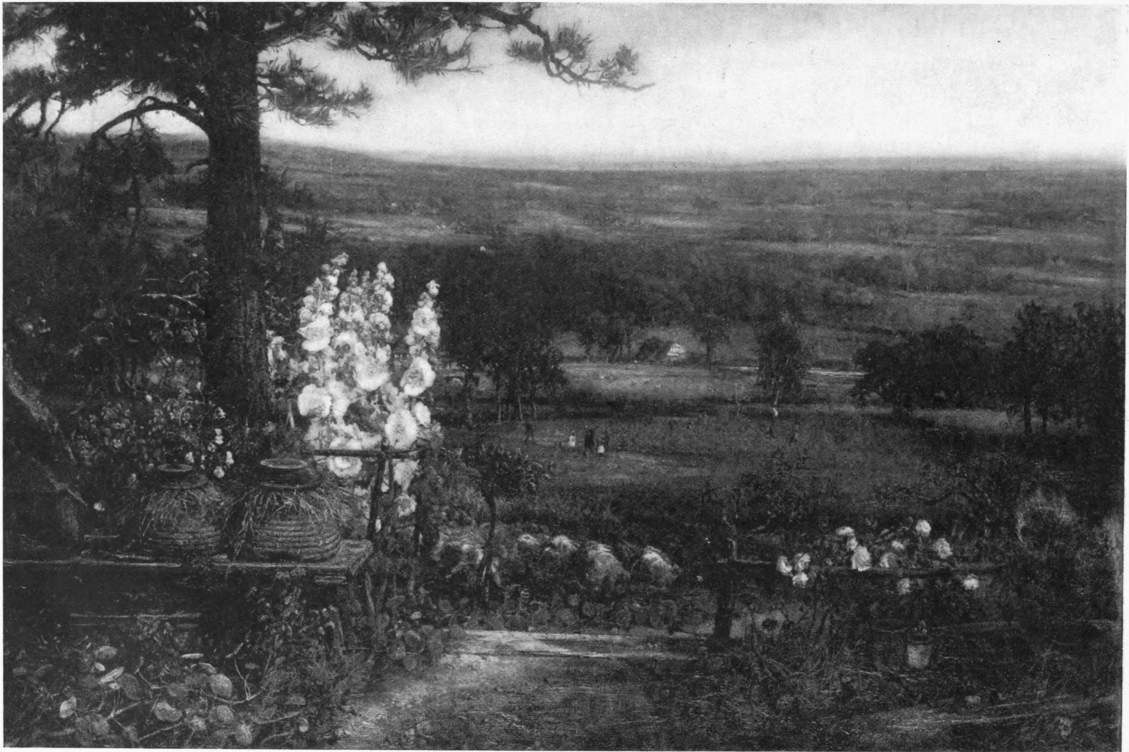 | |
| LAWSON. | Brothers, photo. THE MINISTER’S GARDEN. |
| (By permission of the Corporation of Manchester, the owners of the picture.) | |
With much greater freedom does Colin Hunter approach nature, and he has the secret of seizing her boldly in her most impressive moments. The twilight, with its mysterious, interpenetrating tremor of colours of a thousand shades, its shine and glimmer of water, with the sky brooding heavily above, is what fascinates him most of all. Sometimes he represents the dawn, as in “The Herring Market at Sea”; sometimes the pale tawny sunset, as in “The Gatherers of Seaweed,” in the South Kensington Museum. His men are always in a state of restless activity, whether they are making the most of the last moments of light or facing the daybreak with renewed energies.
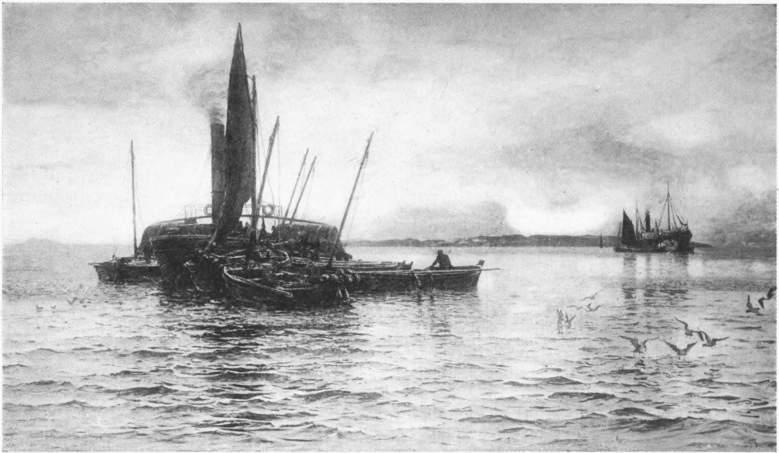 | |
| COLIN HUNTER. | Brothers, photo. THE HERRING MARKET AT SEA. |
| (By permission of the Corporation of Manchester, the owners of the picture.) | |
Although resident in London, he and Hook are the true standard-bearers of the forcible Scotch school of landscape. MacCallum, MacWhirter, and James Macbeth, with whom John Brett, the landscape painter of Cornwall, may be associated, are all gnarled, Northern personalities. Their strong, dark tones stand often beside each other with a little hardness, but they sum up the great glimpses of nature admirably. Their brush has no tenderness, their spirit does not lightly yield to dreaminess, but they stand with both feet firmly planted on the earth, and they clasp reality in a sound and manly fashion with both arms. Their deep-toned pictures, with red wooden houses, darkly painted vessels, veiled skies, and rude fishermen with all their heart in their work, waken strong and intimate emotions. The difference between these Scots and the tentative spirits of the younger generation of the following of Walker and Mason is like that between Rousseau and Dupré as opposed to Chintreuil and Daubigny. The Scotch painters are sombre and virile; they have an accent of depth and truth, and a dark, ascetic harmony of colour. Even as landscape painters the English love what is delicate in nature, what is refined and tender, familiar and modest: blossoming apple-trees and budding birches, the odour of the cowshed and the scent of hay, the chime of sheep-bells 394 and the hum of gnats. They seek no great emotions, but are merely amiable and kindly, and their pictures give one the feeling of standing at the window upon a country excursion, and looking out at the laughing and budding spring. In her novel North and South Mrs. Gaskell has given charming expression to the glow of this feeling of having fled from the smoke and dirt of industrial towns to breathe the fresh air and see the sun go down in the prosperous country, where the meadows are fresh and well-kept, and where the flowers are fragrant and the leaves glisten in the sunshine. In the pictures of the Scotch artists toiling men are moving busily; for the English, nature merely exists that man may have his pleasure in her. Not only is everything which renders her the prosaic handmaiden of mankind scrupulously avoided, but all abruptnesses of landscape, all the chance incidents of mountain scenery; and, indeed, they are not of frequent occurrence in nature as she is in England. A familiar corner of the country is preferred to wide prospects, and some quiet phase to nature in agitation. Soft, undulating valleys, gently spreading hills conforming to the Hogarthian line of beauty, are especially favoured. And should the rainbow, the biblical symbol of atonement, stand in the sky, the landscape is for English eyes in the zenith of its beauty.
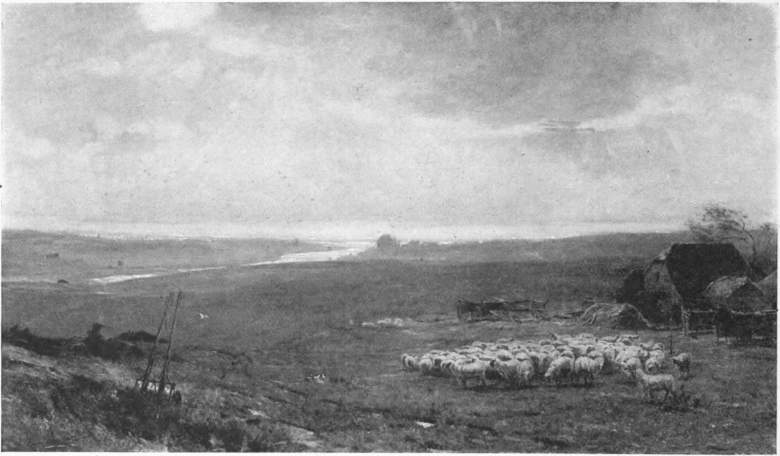 | |
| AUMONIER. | Brothers, photo. THE SILVER LINING TO THE CLOUD. |
| (By permission of the Corporation of Manchester, the owners of the picture.) | |
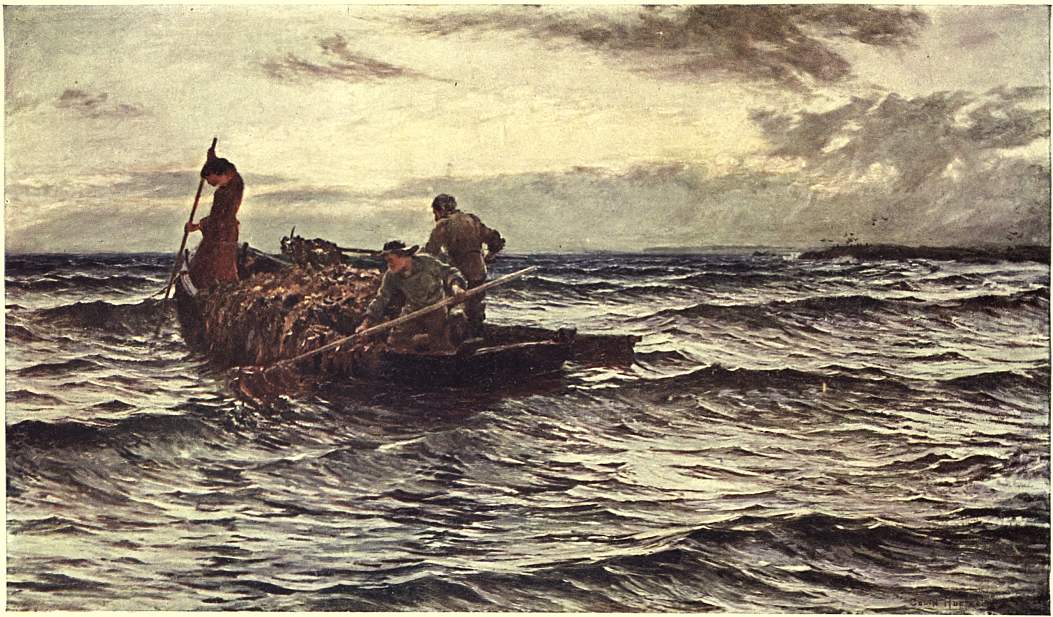 | |
| Cassell & Co. | |
| COLIN HUNTER. | THEIR ONLY HARVEST. |
 | |
| HENRY MOORE. | Brothers, photo. MOUNT’S BAY. |
| (By permission of the Corporation of Manchester, the owners of the picture.) | |
There is Birket Forster, one of the first and most energetic followers of Walker—Birket Forster, whose charming woodcuts became known in Germany likewise; Inchbold, who with a light hand combines the tender green of the grasses upon the dunes and the bright blue of the sea into a whole pervaded with light, and of great refinement; Leader, whose bright evening landscapes, 395 and Corbet, whose delicate moods of morning, are so beautiful. Mark Fisher, who in the matter of tones closely follows the French landscape school, though he remains entirely English in sentiment, has painted with great artistic power the dreamy peace of solitary regions as well as the noisy and busy life of the purlieus of the town. John White, in 1882, signalised himself with a landscape, “Gold and Silver,” which was bathed in light and air. The gold was a waving cornfield threaded by a sandy little yellow path; the silver was the sea glittering and sparkling in the background. Moved by Birket Forster, Ernest Parton seeks to combine refinement of tone with incisiveness in the painting of detail. His motives are usually quite simple—a stream and a birch wood in the dusk, a range of poplars stretching dreamily along the side of a ditch. Marshall painted gloomy London streets enveloped in mist; Docharty blossoming hawthorn bushes and autumn evening with russet-leaved oaks; while Alfred East became the painter of spring in all its fragrance, when the meadows are resplendent in their earliest verdure, and the leaves of the trees which have just unfolded stand out against the firmament in light green patches of colour, when the limes are blossoming and the crops begin to sprout. M. J. Aumonier appears in the harmony of colouring, and in the softness of his fine, light-hued tones, as the true heir of Walker and Mason. A discreet and intimate sense of poetry pervades his valleys with their veiled and golden light, a fertile odour of the earth streams from his rich meadows, and from all the luxuriant, cultivated, and peacefully idyllic tracts which he has painted so lovingly and so well. Gregory, Knight, Alfred Parsons, David Fulton, A. R. Brown, and St. Clair Simmons have all something personal in their work, a bashful tenderness beneath what is seemingly arid. The study of water-colour would alone claim a chapter for itself. Since water-colour 396 allows of more breadth and unity than oil-painting, it is precisely here that there may be found exceedingly charming and discreet concords, softly chiming tones of delicate blue, greenish, and rosy light, giving the most refined sensations produced by English colouring.
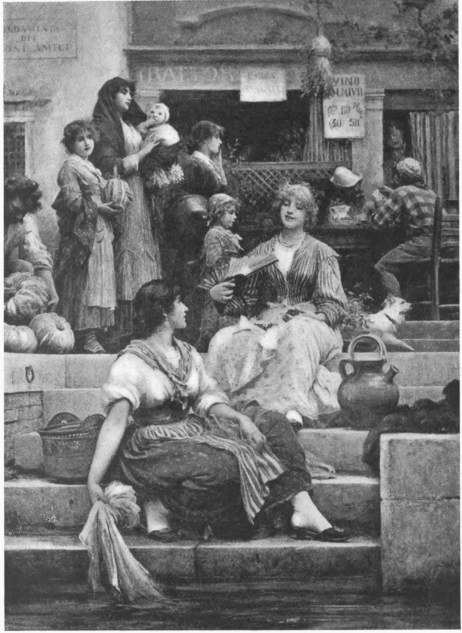 |
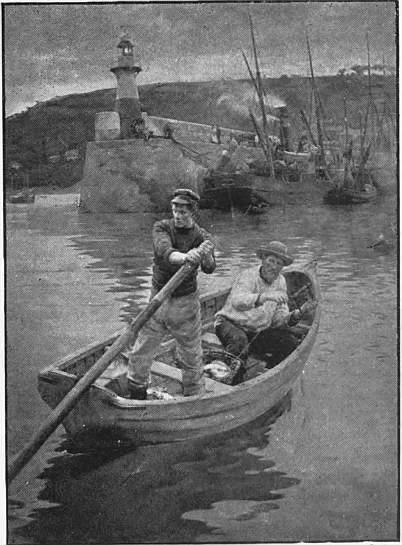 | ||
| Mag. of Art. | Brothers, photo. | ||
| LUKE FILDES. | VENETIAN WOMEN. | STANHOPE FORBES. | THE LIGHTHOUSE. |
| (By permission of the Berlin Photographic Co., the owners of the copyright.) | (By permission of the Corporation of Manchester, the owners of the picture.) | ||
Of course, England has a great part to play in the painting of the sea. It is not for nothing that a nation occupies an insular and maritime position, above all with such a sea and upon such coasts, and the English painter knows well how to give an heroic and poetic cast to the weather-beaten features of the sailor. For thirty years Henry Moore, the elder brother of Albert Moore, was the undisputed monarch of this province of art. Moore began as a landscape painter. From 1853 to 1857 he painted the glistening cliffs and secluded nooks of Cumberland, and then the green valleys of Switzerland flooded with the summer air and the clear morning light—quiet scenes of rustic life, the toil of the wood-cutter and the haymaker, somewhat as Julien Dupré handles such matters at the present time in Paris. From 1858 he began his conquest of the sea, and in the succeeding interval he painted it in all the phases of its changing life,—at times in grey and sombre morning, at other times when the sun stands high; at times in quietude, at other times when the wind sweeps heavily across the waves, when the storm rises or subsides, when the sky is clouded or when it brightens. It is a joy to follow him in all quarters of the world, to see how he constantly studies the waves of every zone on fair or stormy days, amid the clearness and brilliancy of the mirror of the sea, as amid the strife of the elements; as a painter he is, at the same time, always a student of nature, and treats the sea as though he had to paint its portrait. In the presence of his sea-pieces one has the impression of a window opening suddenly upon the ocean. Henry Moore measures the boundless expanse quite calmly, like a captain calculating the 397 chances of being able to make a crossing. Nowhere else does there live any painter who regards the sea so much with the eyes of a sailor, and who combines such eminent qualities with this objective and cool, attentive observation, which seems to behold in the sea merely its navigable capacity.
The painter of the river-port of London and the arm of the Thames is William L. Wyllie, whose pictures unite so much bizarre grandeur with so much precision. One knows the port life of the Thames, with its accumulation of work, which has not its like upon the whole planet. Everything is colossal. From Greenwich up to London both sides of the river are a continuous quay: everywhere there are goods being piled, sacks being raised on pulleys, ships being laid at anchor; everywhere are fresh storehouses for copper, beer, sails, tar, and chemicals. The river is of great width, and is like a street populated with ships, a workshop winding again and again. The steamers and sailing vessels move up and down stream, or lie in masses, close beside one another, at anchor. Upon the bank the docks lie athwart like so many streets of water, sending out ships or taking them in. The ranks of masts and the slender rigging form a spider’s web spreading across the whole horizon; and a vaporous haze, penetrated by the sun, envelops it with a reddish veil. Every dock is like a town, filled with huge vats and populated with a swarm of human beings, that move hither and thither amid fluttering shadows. This vast panorama, veiled with smoke and mist, only now and then broken by a ray of sunlight, is the theme of Wyllie’s pictures. Even as a child he ran about in the port of London, clambered on to the ships, noted the play of the waves, and wandered about the docks; and so he painted his pictures afterwards with all the technical knowledge of a sailor. There is no one who knows so well how ships stand in the water; no one has such an understanding of their details: the heavy sailing vessels and the great steamers, which lie in the brown water of the port like mighty monsters, the sailors and the movements of the dock labourers, the dizzy tide of men, the confusion of cabs and drays upon the bridges spanning the arm of the Thames; only Vollon in Paris is to be compared with him as painter of a river-port.
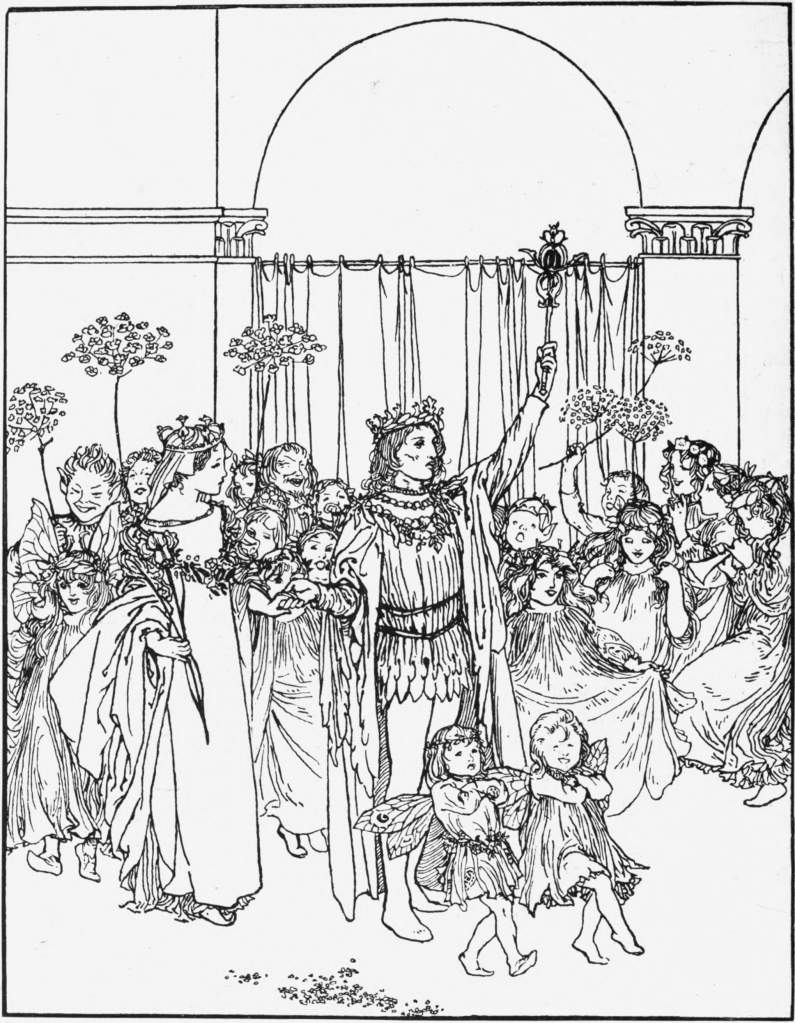 | |
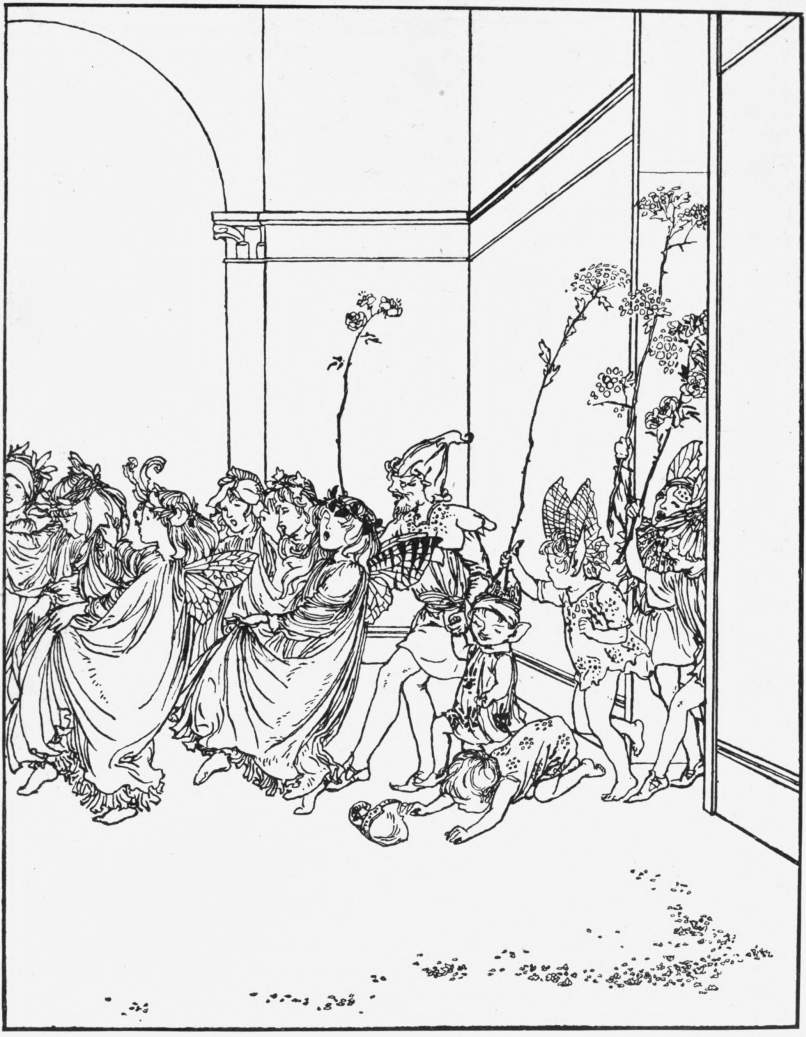 | |
| R. ANNING BELL. | OBERON AND TITANIA WITH THEIR TRAIN. |
Apart from him, Clara Montalba specially has painted the London port in delicate water-colours. Yet she is almost more at home in Venice, the Venice of Francesco Guardi, with its magic gleam, its canals, regattas, and palaces, the Oriental and dazzling splendour of San Marco, the austere grace of San Giorgio Maggiore, the spirited and fantastic décadence of Santa Maria della Salute. Elsewhere English water-colour often enters into a fruitless rivalry with oil-painting, but Clara Montalba cleaves to the old form which in other days under Bonington, David Cox, and Turner was the chief glory of the English school. She throws lightly upon paper notes and effects which have struck her, and the memory of which she wishes to retain.
For the English painters of the day, so far as they do not remain in the country, Venice has become what the East was for the earlier generations. They no longer study the romantic Venice which Turner painted and Byron sang in Childe Harold, they do not paint the noble beauty of Venetian architecture or its canals glowing in the sun, but the Venice of the day, with its narrow alleys and pretty girls, Venice with its marvellous effects of light and the picturesque figures of its streets. Nor are they at pains to discover “ideal” traits in the character of the Italian people. They paint true, everyday scenes from popular life, but these are glorified by the magic of light. After Zezzos, Ludwig Passini, Cecil van Haanen, Tito, and Eugène Blaas, the Englishmen Luke Fildes, W. Logsdail, and Henry Woods are the most skilful painters of Venetian street scenes. In the pictures of Luke Fildes and W. Logsdail there are usually to be seen in the foreground beautiful women, painted life-size, washing linen in the canal or seated knitting at the house door; the heads are bright and animated, the colours almost glaringly vivid. Henry Woods, the brother-in-law of Luke Fildes, rather followed the paths prescribed by Favretto in such pictures as “Venetian Trade in the Streets,” “The Sale of an Old Master,” “Preparation or the First Communion,” “Back from the Rialto,” and the like; of all the English he has carried out the study of bright daylight most consistently. The little glass house which he built in 1879 at the back of the Palazzo Vendramin became the model of all the glass studios now disseminated over the city of the lagunes.
And these labours in Venice contributed in no unessential manner to lead English painting, in general, away from its one-sided æsthetics and rather more into the mud of the streets, caused it to break with its finely accorded tones, and brought it to a more earnest study of light. Beside his idealised Venetian women, Luke Fildes also painted large pictures from the life of the English people, such as “The Return of the Lost One,” “The Widower,” and the like, which struck tones more earnest than English painting does elsewhere; and in his picture of 1878, “The Poor of London,” he even recalled certain sketches which Gavarni drew during his rambles through 401 the poverty-stricken quarter of London. The poor starving figures in this work were rendered quite realistically and without embellishment; the general tone was a greenish-grey, making a forcible change from the customary light blue of English pictures. Dudley Hardy’s huge picture “Homeless,” where a crowd of human beings are sleeping at night in the open air at the foot of a monument in London, and Jacomb Hood’s plain scenes from London street life, are other works which in recent years were striking, from having a character rather French than English. Stott of Oldham, by his pretty pictures of the dunes with children playing, powerful portraits, and delicate, vaporous moonlight landscapes, has won many admirers on the Continent also. Stanhope Forbes painted “A Philharmonic Society in the Country,” a representation of an auction, and scenes from the career of the Salvation Army, in which he restrained himself from all subordinate ideas of a poetic turn.
In the same way those artists are important who work according to the demands of decorative painting. A picture in a room should be like a jewel in its setting, in harmony. It should fit agreeably into the scheme of decoration, its colour in unison, its lines melodious, its general effect toning well with the general design.
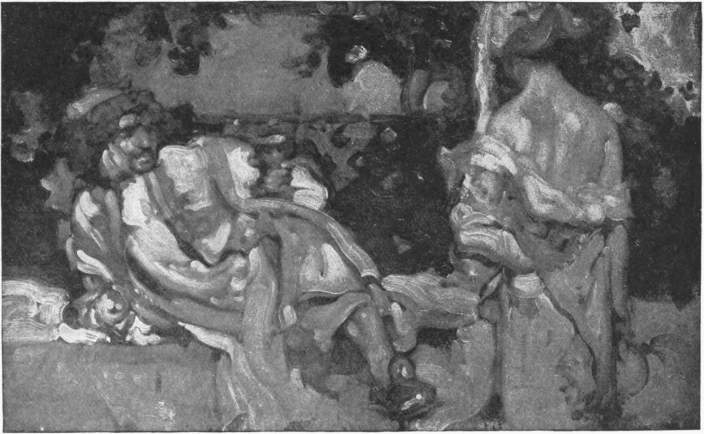 | |
| BRANGWYN. | ILLUSTRATION TO THE RUBÁIYÁT OF OMAR KHAYYÁM. |
| (By permission of Messrs. Gibbings & Co., the owners of the copyright.) | |
These principles, taught by Morris, have had a formative influence on the work of a large number of artists. There arose a tendency which, by borrowing characteristic effects from woodwork, carpets, and stained-glass, and by the application of style to line as well as to colour, went one step further than Burne-Jones.
The pictures of John W. Waterhouse, for instance, are not only conceived in literary vein, but seen with the eye of a painter. By smooth, thick lines, by the discordant harmony of blues, greens, and violet, he gets a carpet-like effect which is highly decorative.
Byam Shaw, still a young man, is just such another master of decorative lines. At the age of twenty-five he painted the picture “Love’s Baubles,” which now hangs in the art gallery in Liverpool. The subject he took from a poem in Rossetti’s “House of Life.” Beautiful women snatch after the fruit which a boy carries along on a salver. The whole is a harmony of melodious lines and rich, quiet colours.
In his next picture, “Truth,” he ranges himself with Boutet de Monoel or Ludwig von Zumbusch: he strives after the monumental effect that the figures of old Brueghel have.
Next to Byam Shaw, G. E. Moira is the chief representative of this decorative school. His picture of Pelleas and Melisande is a work quite out of the ordinary, original in arrangement, incisive, almost bitter in colour, dull-green, black, lilac, and yellow; fine in the atmosphere of Maeterlinck that pervades the whole. But he does his best work as a decorator, not as a painter of pictures that can be taken away from their setting. In the frieze with which he decorated the Trocadéro Restaurant in London he, for the first time, made use of polychrome relief, that since has played such an important part in the art of decoration, and sought to enhance the colour effect still more by the use of metal. In the Paris Exhibition he attracted considerable attention by the pictures with which he decorated the pavilion of the Peninsular and Oriental Steamship Company—simple lines and fantasies of colour which with their delicate, flowing harmony had an effect like music. His designs for stained-glass windows have the same qualities, and in his position as professor in the National College of Art at South Kensington he is bound to exert a great influence over the younger generation.
Anning Bell, well known by his design for the cover of the Studio, has also done excellent work in coloured relief, especially in his frieze “Music and Dancing.”
Maurice Greiffenhagen surprises one by the ardour of his imagination, his strong emphatic line, and the tapestry-like beauty of his colour. He reminds one of Aman-Jean, such a wonderful “old-master-like” beauty is suffused through the picture “The Sons of God looked upon the Daughters of Men.” No less effective is the “gourmandise” with which he gives his interpretation the appearance of an old picture. The colours, though full of sound and movement, are at the same time so etiolated and faint that one would think the picture had hung for centuries in a dusty corner of an old church, or that spiders had spun their webs across it; the frame too is in keeping, and enhances the general effect of solemnity.
The same style is found in the later work of Frank Brangwyn, who began by painting out-of-door pictures in the spirit of the French Impressionists, 403 and afterwards, thanks to a visit to the East, was brought into touch with Nature saturated in colour and massive in feature.
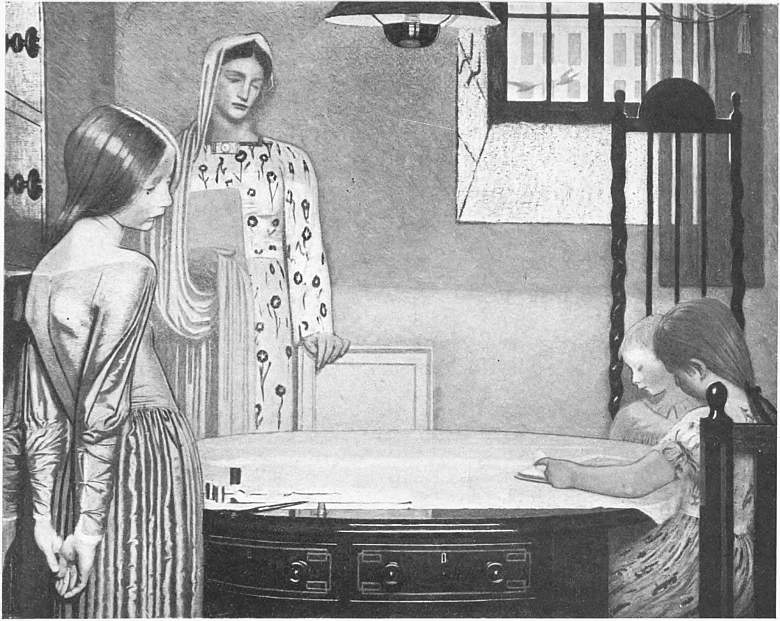 | |
| F. CAYLEY ROBINSON. | A WINTER EVENING. |
| (By permission of the Artist.) | |
All his works are imposing through the decisive way in which he builds up his masses, and the wonderful, rhythmical articulation of forms and colours combined. The picture “Gold, Frankincense, and Myrrh” which has been given a place in the Luxembourg, and the large mural painting “Commerce and Navigation” in the Royal Exchange in London, are up to now his strongest work.
F. Cayley Robinson, who arrests one’s attention with his austere, almost heraldic arrangement of line, and his gloomy acerbity of colour; Miss Eleanor Fortescue Brickdale, who awoke high hopes with her picture “The Deceitfulness of Riches”; and that spirited draughtsman, W. Nicholson, whose drawings lead the eye to and fro, backwards and forwards, along heavy decided lines, noting every expressive turn and movement. Almost all these masters have come to us from the applied arts. It was the idea of attaining to unity of effect in decorative ornament that impelled these artists to work in the spirit of to-day, not that each should bring forward his own work of art and let it stand by itself, but that the scheme of decorative 404 architecture, modelling, and painting should work together hand in hand in a homogeneous scheme of decoration.
With all these artists one cannot help noticing that they owe much in the way of light and leading to one who in England, the land of poems-in-paint, proclaimed more outspokenly than anyone else the principle of “Art for art’s sake,”—to the great American, James M‘Neill Whistler.

BIBLIOGRAPHY
BIBLIOGRAPHY
CHAPTER XXVIII
In General:
John Ruskin: Letters to “The Times” on the Principal Pre-Raphaelite Pictures in the Exhibition of 1854. Reprinted for Private Circulation. London, 1876.
Pre-Raphaelitism: Its Art, Literature, and Professors, “London and County Review,” March 1868.
The Poetic Phase in Modern English Art, “New Quarterly Magazine,” June 1879.
William Holman Hunt: The Pre-Raphaelite Brotherhood, “Contemporary Review,” April-June 1886.
Edouard Rod: Les Préraphaélites Anglais, “Gazette des Beaux-Arts,” 1887, ii 177, 399.
W. v. Seidlitz: Die englische Malerei auf der Jubiläumsausstellung zu Manchester im Sommer, 1887, “Repertorium für Kunstwissenschaft,” 1888, xi 274, 405.
P. T. Forsyth: Religion in Recent Art. Manchester and London, 1889.
Wilhelm Weigand: Die aesthetische Bewegung in England, “Gegenwart,” 1889 (35), p. 165.
Wilhelm Weigand: Die Praeraphaeliten, in his “Essays.” Munich, 1892.
Cornelius Gurlitt: Die Praeraphaeliten, eine britische Malerschule, “Westermanns Monatshefte,” April-June, 1892.
W. Holman Hunt: Pre-Rafaelitism and Pre-Rafaelite Brotherhood. London, 1905.
Noël Paton:
J. M. Gray: Sir Noël Paton, “Art Journal,” 1881, p. 78.
Holman Hunt:
F. G. Stephens: W. Holman Hunt, “Portfolio,” 1871, p. 33.
F. G. Stephens: Holman Hunt’s “The Triumph of the Innocents,” “Portfolio,” 1885, p. 80.
J. Beavington-Atkinson: Mr. Holman Hunt, his Work and Career, “Blackwood’s Magazine,” April 1886.
Madox Brown:
W. M. Rossetti: Mr. Madox Brown’s Exhibition and its Place in our School of Painting, “Fraser’s Magazine,” May 1865.
Sidney Colvin: Ford Madox Brown, “Portfolio,” 1870, p. 81.
Madox Brown’s Mural Painting at Manchester, “Academy,” 1879, p. 379.
W. M. Rossetti: Mr. Madox Brown’s Frescoes in Manchester, “Art Journal,” 1881, New Series, p. 9.
E. Chesneau: Peintres anglais contemporains: Ford Madox Brown, “L’Art,” 1883, p. 409.
F. G. Stephens: Ford Madox Brown, his early Studies and Motives, “Portfolio,” 1893, pp. 62 and 69.
Millais:
Sidney Colvin: Millais, “Portfolio,” 1871, p. 1.
Modern Artists. Illustrated Biographies. 2 vols. 1882-84.
Emilie Isabel Barrington: Why is Mr. Millais our Popular Painter? “Fortnightly Review,” July 1882.
Walter Armstrong: Sir J. E. Millais, his Life and Work. Illustrated with Engravings and Facsimiles, “The Art Annual.” London, 1885.
John Ruskin: Notes on some of the Principal Pictures of Sir John Millais. London, 1886.
Helen Zimmern: Sir John Millais, “Die Kunst unserer Zeit,” Munich, 1891.
M. H. Spielmann: Millais and his Works. London, 1898.
A. L. Baldry: Millais, his Art and his Influence. London, 1899.
Millais: Life and Letters of Millais. 2 vols. London, 1899.
CHAPTER XXIX
Menzel:
(Beside books, etc. cited for Chapter XV.):
Duranty: Adolf Menzel, “Gazette des Beaux-Arts,” 1880, i and ii.
A. Lichtwark: Menzels Piazza d’Erbe, “Gegenwart,” 1884, 25.
C. Gurlitt: Menzels Brunnenpromenade in Kissingen, “Gegenwart,” 37, p. 61.
Georg Galland: Das Arbeiterbild in Vergangenheit und Gegenwart, “Frankfurter Zeitung,” 1890, p. 139.
Jul. Meier-Gräfe: Der junge Menzel. Stuttgart, 1906.
Bleibtreu:
K. Pietschker: Georg Bleibtreu, der Maler des neuen deutschen Kaiserreiches, Kunststudie und biographische Skizze. Koethen, 1877.
A. v. Werner:
Ludwig Pietsch: “Nord und Süd,” 18, 1881, p. 185.
Ad. Rosenberg, in “Künstlermonographien,” ix. Bielefeld, 1900.
Max Michael:
Hermann Helferich: Erinnerung an Max Michael, “Kunst für Alle,” 1891, vi 225.
Güssow:
Max Kretzer: “Westermanns Monatshefte,” vol. 54, 1883, p. 519.
Pettenkofen:
Alfred de Lostalot: “Gazette des Beaux-Arts,” 1877, i 410.
Carl v. Lützow: “Zeitschrift für bildende Kunst,” 1889.
Lorenz Gedon:
G. Hirth: “Zeitschrift des Münchener Kunstgewerbevereins,” 1884, 1, 2.
Fr. Schneider, the same, 1884, 5 and 6.
“Allgemeine Zeitung,” 1884, No. 67.
K.: “Allgemeine Kunstchronik,” 1884, viii p. 5.
Ludwig Pietsch: “Nord und Süd,” 30, 1884, p. 42.
Diez:
Friedrich Pecht: Zu Wilhelm Diez 50 Geburtstage, “Kunst für Alle,” 1889, iv 113.
H. E. v. Berlepsch: W. Diez, “Zeitschrift für bildende Kunst,” xxii.
Claus Meyer:
Claus Meyer-Album. Twelve Photogravures, with Biographical Text by W. Lübke. München, 1890.
Harburger:
Harburger-Album. Munich, Braun & Schneider, 1882.
Fritz August Kaulbach:
Hermann Helferich: Neue Kunst. Berlin, 1887.
P. G.: “Zeitschrift für bildende Kunst,” 1888, xxiii 125.
R. Graul: “Graphische Künste,” 1890, xiii 27, 61.
See also Kaulbach-Album. Verlag für Kunst und Wissenschaft. München, 1891.
Ad. Rosenberg, in the “Künstlermonographien.” Ed. by Knackfuss. Bielefeld, 1901.
Lenbach:
Friedrich Pecht: Franz Lenbach, “Nord und Süd,” 1877, i 113.
B. Förster: Franz Lenbachs neueste Porträts, “Zeitschrift für bildende Kunst,” 1880, No. 26.
Ludwig Pietsch: Franz Lenbach, “Nord und Süd,” 44, 1888, p. 363.
C. Gurlitt: Lenbachs Bismarck-Bildniss, “Gegenwart,” 37, p. 318.
H. Helferich: Lenbachs Zeitgenössische Bildnisse, “Nation,” 5, 1887-88, pp. 205 and 227.
H. E. v. Berlepsch: Franz Lenbach, in “Velhagen und Klasings Monatshefte,” 1891, i.
Ad. Rosenberg, in the “Künstlermonographien.” Ed. by Knackfuss. Bielefeld, 1898.
See also Lenbachs Zeitgenössische Bildnisse. Heliogravures by Albert. München, 1888.
Leibl:
S. R. Köhler: “American Art Review,” 1880, 11.
Hermann Helferich: “Kunst für Alle,” January 1892.
Georg Gronau, in the “Künstlermonographien.” Ed. by Knackfuss. Leipzig, 1901.
CHAPTER XXX
Leading Works:
Louis Gonse: L’Art japonais. Paris, Quantin, 1883.
Anderson: The Pictorial Arts of Japan, London, 1883.
J. Brinkmann: Kunst und Handwerk in Japan. Berlin, 1889.
See also Ernest Chesneau: Le Japon à Paris, “Gazette des Beaux-Arts,” 1878, ii 385, 841.
H. v. Tschudi: Die Kunst in Japan, “Mittheilungen des k. k. österreichischen Museums,” 1879, xiv 170.
Le Blanc du Vernet: L’Art japonais, “L’Art,” 1880, p. 280; Japonisme, “L’Art,” 1880, p. 273.
Th. Duret: L’Art japonais. Les livres illustrés. Les albums imprimés. Hokusai, “Gazette des Beaux-Arts,” 1882, ii 113, 300.
Hans Gierke: Japanesische Malerei, in “Westermanns Monatshefte,” May 1883.
D. Brauns: Die Leistungen der Japaner auf dem Gebiete der Künste, “Unsere Zeit,” 1883, ii 765.
O. v. Schorn: Malerei und Illustration in Japan, “Vom Fels zum Meer,” April 1884.
F. E. Fenollosa: Review of the Chapter on Painting in “L’Art japonais,” by L. Gonse. Yokohama, 1885.
W. Koopmann: Kunst und Handwerk in Japan, “Zeitschrift für bildende Kunst,” xiv 189.
T. de Wyzewa: La peinture japonaise, “Revue des Deux Mondes,” 1 July 1890. Also separately, Les grands peintres de l’Espagne, etc. Paris, 1891.
S. Bing: Le Japon artistique. Paris, 1888.
Edward F. Strange: Japanese Illustration. London, 1897.
W. v. Seidlitz: Geschichte des japanischen Farbenholzschnittes. Dresden, 1897.
Outamaro:
E. de Goncourt: Outamaro le peintre des maisons vertes. Paris, 1891.
Hokusai:
G. Geffroy, in “La vie artistique.” Paris, 1892.
CHAPTER XXXI
In General:
Duranty: La nouvelle peinture, à propos du groupe d’artistes qui expose dans les galeries Durand-Ruel. Paris, Dentu, 1876.
Théodore Duret: Les peintres impressionists: C. Monet, Sisley, C. Pissarro, Renoir, B. Morisot. Avec un dessin de Renoir. Paris, 1879.
Louis Enault: Une revolution artistique. Paris, 1880.
Frederick Wedmore: The Impressionists, “The Fortnightly Review,” January 1883.
Felix Fénélon: Les Impressionistes en 1886. (Angrand, Caillebotte, Miss Cassatt, Degas, Dubois-Pillet, David Estoppey, Forain, Gauguin, Guillaumin, Claude Monet, Mme. Morisot, de Nittis, Camille et Lucien Pissarro, Raffaelli, Renoir, Seurat, Signac, Zandomeneghi, etc.) Paris, 1886.
Catalogue illustré de l’exposition des peintures du groupe Impressioniste et Synthétiste, faite dans le local de M. Volpini au Champ de Mars, 1889.
G. Lecomte: L’Art Impressioniste. Paris, 1892.
H. Huysmans: Certains. Paris, 1892.
H. Huysmans: L’Art moderne. Paris, 1892.
G. Geffroy: La vie artistique. Paris, 1892.
Jul. Meier-Gräfe: Der Impressionismus in Muther’s series, “Die Kunst.” Berlin, 1902.
Manet:
Zola: Mes Haines. Edouard Manet. Paris, 1878, p. 327.
Catalogue de l’exposition des Œuvres de Manet, avec préface d’Emile Zola. Paris, 1884.
Edmond Bazire: Manet. Paris, 1884.
Jacques de Biez: Edouard Manet. Conférence faite à la salle des capucines le Mardi, 22 Janvier 1884. Paris, 1884.
L. Gonse: Manet, “Gazette des Beaux-Arts,” 1884, i 133.
Fritz Bley: Edouard Manet, “Zeitschrift für bildende Kunst,” 1884, 8.
Paul D’Abrest: “Allgemeine Kunstchronik,” 1884, viii 5.
Andreas Aubert, in the Copenhagen “Tilskueren,” 1888.
Hugo von Tschudi: Edouard Manet. Berlin, 1902.
Monet:
Théodore Duret: Le peintre Claude Monet: Notice sur son œuvre. Paris, 1880.
A. de Lostalot: Exposition des œuvres de M. Claude Monet, “Gazette des Beaux-Arts,” 1883, i 342.
C. Dargenty: Exposition des œuvres de M. Monet, “Courier de l’Art,” 1883, 11.
Hermann Helferich: Claude Monet, “Freie Bühne,” 1890, 8.
Degas:
George Moore: Degas, the Painter of Modern Life, “Magazine of Art,” 1889.
Max Liebermann: Degas, Berlin, Cassirer, 1901.
Pissarro:
G. Lecomte: Camille Pissarro. No. 11 of “Hommes d’aujourd’hui.” Paris, 1890.
CHAPTER XXXII
Rossetti:
William Sharp: Dante Gabriel Rossetti and Pictorialism in Verse, “Portfolio,” 1882, p. 176.
William Sharp: Dante Gabriel Rossetti, a Record and a Study. London, 1882.
William Tirebuck: Dante Gabriel Rossetti, his Works and Influence. London, 1882.
T. Hall Caine: Recollections of Dante Gabriel Rossetti. London, 1882.
F. G. Stephens: The Earlier Works of Rossetti, “Portfolio,” May 1882.
Sidney Colvin: Rossetti as a Painter, “Magazine of Art,” March 1883.
W. Tirebuck: Obituary in the “Art Journal,” January 1883.
R. Waldmüller: Dante Gabriel Rossetti, Dichter und Maler, “Allgemeine Zeitung,” 1883, Blatt 344.
Notes on Rossetti and his Works, “Art Journal,” May 1884.
William Michael Rossetti, Introduction to the two-volume edition of the works of Dante Gabriel Rossetti. London, 1883.
Franz Hüffer: Dante Gabriel Rossetti. Leipzig, 1883.
J. Beavington-Atkinson: Contemporary Art, Poetic and Positive (Rossetti and Alma Tadema, Linnell and Lawson), “Blackwood’s Magazine,” March 1883.
Theodore Watts: The Truth about Rossetti, “Nineteenth Century,” March 1883.
F. G. Stephens: The Earlier Works of Rossetti, “Portfolio,” 1883, pp. 87 and 114.
Théodore Duret: Les expositions de Londres: Dante Gabriel Rossetti, “Gazette des Beaux-Arts,” 1883, ii 49.
David Hannay: The Paintings of Rossetti, “National Review,” March 1883.
Helen Zimmern: Aus London, D. G. Rossetti, “Westermanns Monatshefte,” August 1883.
Harry Quilter: The Art of Rossetti, “Contemporary Review,” February 1883.
William Michael Rossetti: Notes on Rossetti and his Works, “Art Journal,” 1884, pp. 148, 164, 204, 255.
F. G. Stephens: Ecce Ancilla Domini, “Portfolio,” 1888, p. 125.
William Michael Rossetti: D. G. Rossetti as Designer and Writer. London, 1889.
Wilhelm Weigand: “Gegenwart,” 1889, p. 38, and his Essays.
F. G. Stephens: Beata Beatrix, “Portfolio,” 1891, p. 45.
F. G. Stephens: Rosa Triplex, by D. G. Rossetti, “Portfolio,” 1892, p. 197.
H. C. Marillier: D. G. Rossetti, an Illustrated Memorial of his Art and Life. 2nd Edition. London, 1901.
Burne-Jones:
Sidney Colvin: “Portfolio,” 1870, p. 17.
F. G. Stephens: “Portfolio,” 1885, pp. 220 and 227.
Birmingham Museum and Art Gallery, Catalogue (with Notes) of the Collections of Paintings by George Frederick Watts and Edward Burne-Jones. Birmingham, 1886.
F. G. Stephens: “Portfolio,” 1889, p. 214.
F. G. Stephens: Mr. Burne-Jones’ Mosaics at Rome, “Portfolio,” May 1890.
Malcolm Bell: Edward Burne-Jones. London, 1892.
André Michel: “Journal des Débats,” 15 March 1893.
Cornelius Gurlitt: Die Praerafaeliten, eine britische Malerschule, “Westermanns Monatshefte,” July 1892.
P. Leprieur: Burne-Jones, decorateur et ornemaniste, “Gazette des Beaux-Arts,” 1892, ii 381.
Ninety-one Photogravures directly reproduced from the Original Paintings, “Berl. Photogr. Gesell.,” 1901.
Malcolm Bell: Burne-Jones. Muther’s “Die Kunst.” Bd. 3.
Otto v. Schleinitz: “Künstlermonographien.” Ed. by Knackfuss. Bd. 55. Bielefeld, 1901.
Arthur Hughes:
William Michael Rossetti: “Portfolio,” 1870, p. 113.
J. M. Strudwick:
G. Bernard Shaw: “Art Journal,” 1891, p. 97.
Richmond:
H. Lascelles: William B. Richmond, “Art Journal,” Christmas Annual. 1902.
Morris:
Aymer Vallance: William Morris, his Art, his Writings, and his Public Life. London, 1897.
J. W. Mackail: Life of William Morris. 2 vols. London, 1901.
Walter Crane:
F. G. Stephens: The Designs of Walter Crane, “Portfolio,” 1891, 12, 45.
Cornelius Gurlitt: “Gegenwart,” 1893.
Peter Jessen: “Zeitschrift für bildende Kunst,” 1893.
V. Berlepsch: Walter Crane. Wien, 1897.
Otto v. Schleinitz: Walter Crane, in the “Künstlermonographien.” Ed. by Knackfuss, Bielefeld, 1901.
P. G. Konody: The Art of Walter Crane. London, 1902.
Watts:
J. Beavington-Atkinson: “Portfolio,” 1870, p. 65.
F. W. Myers: On Mr. Watts’ Pictures, “Fortnightly Review,” February 1882.
F. W. Myers: Stanzas on Mr. Watts’ Collected Works. London, 1882.
H. Quilter: The Art of Watts, “Contemporary Review,” February 1882.
Walter Armstrong: George Frederick Watts, “L’Art,” 1882, p. 379.
E. I. Barrington: The Painted Poetry of Watts and Rossetti, “Nineteenth Century,” June 1883.
E. Pfeiffer: On Two Pictures by G. F. Watts, “Academy,” 1884, p. 627.
M. H. Spielmann: The Works of Mr. G. F. Watts, with a Catalogue of his Pictures, “Pall Mall Gazette Extra,” No. 22. London, 1886.
F. G. Stephens: G. F. Watts, “Portfolio,” 1887, p. 13.
Helen Zimmern in “Die Kunst unserer Zeit,” 1892.
Hermann Helferich: “Kunst für Alle,” December 1893.
Jarno Jessen: George Frederick F. Watts. Berlin, 1901.
Rosa E. D. Sketchley: George Frederick Watts. London, 1904.
CHAPTER XXXIII
Gustave Moreau:
Paul Leroi: Les parias du Salon, “L’Art,” 1876, iii 246.
Charles Tardieu: La peinture à l’exposition universelle de 1878, “L’Art,” 1878, ii 319.
Ary Renan: G. Moreau, “Gazette des Beaux-Arts,” 1886, i 377, ii 36.
Claude Phillips: Fables of La Fontaine by Gustave Moreau, “Magazine of Art,” 1887, p. 37.
Karl Huysmans: A. Rebours. Paris, 1891, passim.
P. Flat: Le musée Gustave Moreau. Étude sur Gustave Moreau, ses œuvres, son influence. Paris, 1898.
Ary Renan: Gustave Moreau. Paris, 1900.
G. Larronnet: Gustave Moreau. Paris, 1901.
Puvis de Chavannes:
A. Baignières: La peinture décorative au XIX siècle. M. Puvis de Chavannes, “Gazette des Beaux-Arts,” 1881, i 416.
Edouard Aynard: Les peintures décoratives de Puvis de Chavannes au Palais des Arts. Lyon, 1884.
Thiebault-Sisson: Puvis de Chavannes et son œuvre, “La Nouvelle Revue,” December 1887.
André Michel: Exposition de M. Puvis de Chavannes, “Gazette des Beaux-Arts,” 1886, i 36.
Hermann Bahr: Zur Kritik der Moderne. Zürich, 1890.
André Michel: “Graphische Künste,” xiv, 1892, 37.
A. Nossig: “Allgemeine Kunstchronik,” 1893, No. 12.
M. Vachon: Puvis de Chavannes. Paris, 1896.
L. Bénédite: Les dessins de Puvis de Chavannes au musée du Luxembourg. Paris, 1901.
Golberg: Puvis de Chavannes. Paris, 1901.
Boecklin:
F. Pecht: “Nord und Süd,” 1878, iv 288. Reprinted in “Deutsche Künstler des 19 Jahrhunderts,” Nördlingen, 1879, pp. 180-202.
A. Rosenberg: “Grenzboten,” 1879, i pp. 387-397.
Graf Schack: Meine Gemäldesammlung. Stuttgart, 1881, pp. 139-155.
O. Berggruen: Die Galerie Schack. Wien, 1883.
Zwei neue Gemälde von A. Boecklin, “Deutsche Rundschau,” June 1883.
E. Koppel: Arnold Boecklin, “Vom Fels zum Meer,” July 1884.
Otto Baisch: Arnold Boecklin, “Westermanns Monatshefte,” August 1884, 37.
Guido Hauck: Arnold Boecklins Gefilde Seligen und Goethes Faust. Berlin, 1884.
F. Pecht: Zu Arnold Boecklins 60 Geburtstag, “Kunst für Alle,” 1887, iii 2.
Fritz Lemmermayer: “Unsere Zeit,” 1888, ii 492.
Helen Zimmern: “Art Journal,” 1888, p. 305.
Berthold Haendke: Arnold Boecklin in seiner historischen und künstlerischen Entwicklung. Hamburg, 1890.
Hugo Kaatz: Der Realismus Arnold Boecklins, “Gegenwart,” 1890, 38, p. 168.
Carus Sterne: Arnold Boecklins Fabelwesen im Lichte der organischen Formenlehre, “Gegenwart,” 1890, 37, p. 21.
A. Fendler: Arnold Boecklin, “Illustrirte Zeitung,” 1890, No. 2310.
Max Lehrs: Arnold Boecklin, Ein Leitfaden zum Verständniss der Kunst. München, 1890.
J. Mähly: Aus Arnold Boecklins Atelier, “Gegenwart,” 1892, 14.
Emil Hannover, in “Tilskueren,” Kopenhagen, 1892, p. 118.
Franz Hermann, “Gazette des Beaux-Arts,” Nos. 430 and 433, 1 April and 1 July 1893.
Franz Hermann, in “Die Kunst Unserer Zeit,” December 1893.
Carl Neumann, “Preussische Jahrbücher,” vol. 71, 1893, Part 2.
Cornelius Gurlitt: “Kunst für Alle,” 1894, Part 2.
Ola Hansson: “Seher und Deuter.” Berlin, 1894, p. 152.
F. von Ostini, in “Velhagen und Klasings Monatshefte,” 1894.
See also the work on Boecklin produced by the “Verlag für Kunst und Wissenschaft,” with forty of the artist’s chief pictures reproduced in photogravure. München, 1892.
W. Ritter: Arnold Boecklin. Paris, 1895.
H. F. Meissner: Arnold Boecklin. Berlin, 1898.
E. Schick: Boecklins Tagebuch. Hrsg. v. Tschudi. Berlin, 1899.
H. Mendelssohn: Arnold Boecklin. Berlin, 1900.
H. Brockhaus: Arnold Boecklin. Leipzig, 1901.
G. Floerke: Gespräche mit Boecklin. München, 1902.
J. Meier-Gräfe: Der Fall Boecklin. Stuttgart, 1905.
H. von Marées:
Conrad Fiedler: H. von Marées. Munich, 1889. (1 vol. text, 1 vol. pictures.)
Conrad Fiedler: H. von Marées auf der Münchener Jahresausstellung, “Allgemeine Zeitung,” 1891, Supplement No. 150.
H. Janitschek: “Die Nation,” 1890, No. 51.
Carl von Pidoll: Aus der Werkstatt eines Künstlers. Luxemburg, 1890.
Cornelius Gurlitt: “Gegenwart,” 1891, 1.
Heinr. Wölfflin: “Zeitschrift für bildende Kunst,” 1892, Part 4.
Emil Hannover, in “Tilskueren,” Kopenhagen, 1891, p. 1.
Franz Dreber:
Exhibition in Royal National Gallery of Berlin, 1876.
Hubert Janitschek: Zur Charakteristik Franz Drebers, “Zeitschrift für bildende Kunst,” xi, 1876, p. 681.
CHAPTER XXXIV
Bastien-Lepage:
A. Theuriet: J. Bastien-Lepage, l’homme et l’artiste. Paris, 1885.
A. Hustin: Bastien-Lepage, “L’Art,” 1885, i 13.
G. Dargenty: “L’Art,” 1885, i 146, 163.
A. de Fourcaud: Jules Bastien-Lepage, sa vie et ses œuvres. Paris, 1888.
Marie von Baskirtscheff: “Journal intime.” Paris, 1890.
Marie Baskirtscheff:
Cornelius Gurlitt: Marie Baskirtscheff und ihr Tagebuch, in “Die Kunst unserer Zeit,” 1892, i 61.
Léon L’Hermitte:
Robert Walker: L’Hermitte, “Art Journal,” 1886, p. 266.
Raffaelli:
Alfred de Lostalot: Expositions diverses à Paris: Œuvres de M. J. F. Raffaelli, “Gazette des Beaux-Arts,” 1884, i 334.
Emil Hannover: Raffaelli, “Af Dagens Krönike.” Kopenhagen, 1889.
J. de Nittis:
Philippe Burty: “L’Art,” 1880, p. 276.
Henry Jouin: Maîtres contemporains, p. 229. Paris, 1887.
Ferdinand Heilbuth:
A. Hustin: “L’Art,” 1889, ii 268.
A. Helferich: “Kunst für Alle,” v, 1890, p. 61.
Gervex:
F. Jahyer: Galerie contemporaine litéraire et artistique, 1879, p. 178.
Friant:
Roger Marx: Silhouettes d’artistes contemporains, “L’Art,” 1883, p. 461.
Ulysse Butin:
Paul Leroi: “L’Art,” 1878, ii 25.
Abel Patoux: “L’Art,” 1890, ii 7, 117.
Dagnan-Bouveret:
B. Karageorgevitsch: “Magazine of Art,” February 1893, No. 148.
On the more Modern Landscape Painters in General:
P. Taren: Die moderne Landschaft, “Gegenwart,” 1889, 20.
On Neo-Impressionism:
Paul Signac: D’Eugène Delacroix au Neo-impressionisme. Paris, 1903.
George Seurat:
Obituary in the “Chronique des Arts,” 1890, 14.
Cheret:
Ernest Maindron: Les affiches illustrées, “Gazette des Beaux-Arts,” 1884, ii 418 and 435.
Karl Huysmans: Certains. Paris, 1891.
L’affiche illustrée. Le roi de l’affiche. L’œuvre de Chéret, etc., “La Plume,” No. 110, 15 November 1893.
R. H. Sherard: “Magazine of Art,” September 1893, No. 155.
L. Morin: Quelques artistes de ce temps. [Cherét, Vierge.] Paris, 1898.
G. Kahn: Jules Chéret, “Art et Decoration,” xii, 1902, p. 177.
Steinlen:
Crouzat: A. de Steinlen, peintre, graveur, lithographe. Paris, Maison du livre, 1902.
Paul Renouard:
Eugène Véron: “L’Art,” 1875, iii 58; 1876, iv 252.
Jules Claretie: M. Paul Renouard et l’Opéra, “Gazette des Beaux-Arts,” 1881, i 435.
Daniel Vierge:
J. and E. R. Pennell: Daniel Vierge, “Portfolio,” 1888, p. 201.
By the Editor: “Magazine of Art,” 1892, No. 146 (December).
Cazin:
Leon Bénédite: Cazin. Paris, 1902.
Lautrec:
E. Klassowki: Die Maler von Montmartre [Billotte, Steinlen, Toulouse-Lautrec, Léandre]. “Die Kunst,” Bd. 15. Edited by R. Muther.
André Rivoire: “Revue de l’art ancien et moderne,” xi, 1902.
Carrière:
G. Geffroy: La vie artistique. Préface d’Edmond de Goncourt. Pointe sèche d’Eugène Carrière. Paris, Dentu, 1893.
Léailles: E. Carrière, l’homme et l’artiste. Paris, 1901.
G. Geffroy: L’œuvre d’Eugène Carrière. Paris, 1902.
Aman-Jean:
A. Beaunier, Aman-Jean, “Art et Decoration,” vi, 1899.
Odilon Redon:
J. Destrée: L’œuvre lithographique de Odilon Redon. Catalogue descriptif. Bruxelles, 1891.
CHAPTER XXXV
In General:
Francisco Tubino: The Revival of Spanish Art. 1882.
Spanische Künstlermappe. Edited by Prince Ludwig Ferdinand, with an Introduction by F. Reber. Munich, 1885.
Gustav Diercks: Moderne spanische Maler, “Vom Fels zum Meer,” 1890, 5.
Fortuny:
“Zeitschrift für bildende Kunst,” ix, 1874, p. 341.
J. C. Davillier: Fortuny, sa vie, son œuvre, sa correspondance. Avec cinq dessins inédits en facsimile et deux eaux-fortes originales. Paris, Aubry, 1876.
Fortuny und die moderne Malerei der Spanier, “Allgemeine Zeitung,” 1881, Supplement, 245.
Walther Fol: “Gazette des Beaux-Arts,” 1875, i 267, 351.
Charles Yriarte: “L’Art,” 1875, i 361.
Charles Yriarte, in “Les artistes célèbres.” Paris, 1885.
See also the Fortuny Album published by Goupil. 40 page photographs. Paris, 1889.
Pradilla:
Delia Hart: “Art Journal,” 1891, p. 257.
CHAPTER XXXVI
James Jackson Jarves: Modern Italian Painters and Painting, “Art Journal,” 1880, p. 261.
P. P.: Die Kunstausstellung im Senatspalast zu Mailand, “Zeitschrift für bildende Kunst,” xvi, 1881, 361, 381.
Camillo Boito: Pittura e scultura. Milano, 1883.
Die modernen Venetianer Maler, “Allgemeine Kunstchronik,” 1884, viii 2.
Milliot: De l’art actuel en Italie, “Revue du monde latin,” Juin, 1887.
Angelo de Gubernatis: Dizionario degli Artisti Italiani viventi. Firenze, 1889.
M. Wittich: Italienische Malerei. Mappe, 1890, 8.
Helen Zimmern: Die moderne Kunst in Italien, “Kunst unserer Zeit,” 1890, p. 74.
A. Stella: Pittura e Scultura in Piemonte. Turin, Paravia & Comp., 1893.
On the Neapolitans:
Principessa della Rocca: Artisti Italiani Viventi (Napolitani). Napoli, 1878.
Helen Zimmern: Die neapolitanische Malerschule, “Kunst für Alle,” 1889, p. 81.
Morelli:
Helen Zimmern: “Art Journal,” 1885, pp. 345 and 357.
E. Dalbano: Domenico Morelli. Napoli Nobilissima, xi, 1902.
Michetti:
Helen Zimmern: “Art Journal,” 1887, pp. 16 and 41.
Dalbono:
Helen Zimmern: “Art Journal,” 1888, p. 45.
Favretto:
Obituaries in 1887: Garocci, “Arte e storia,” vi 16; “Chronique des Arts,” 24; “Allgemeine Kunstchronik,” 26; “Mittheilungen des Mähr. Gewerbemuseums,” 8; “Courrier de l’Art,” vi 25; “Kunstchronik,” xxii 37; “The Saturday Review,” 1 October 1887.
See also Giacomo Favretto e le sue opere. Edizione unica di tutti i principali Capolavori del celebre Artista Veneziano. Publicata per cura di G. Cesare Sicco. Torino, 1887.
L. Brasch: Giacomo Favretta, “Die Kunst unserer Zeit,” xii, 1902.
Segantini:
W. Fred: Giovanni Segantini. Wien, 1901.
Franz Servaes: Giovanni Segantini. Sein Leben und sein Werk. Hrsg. v. k. k. Ministerium für Kultus und Unterricht. Wien, M. Serlach & Co. 1901.
CHAPTER XXXVII
In General:
Frederick Wedmore: Some tendencies in Recent Painting, “Temple Bar,” July 1878.
E. Chesneau: Artistes anglais contemporains. Paris, 1887.
Claude Phillips: The Progress of English Art as shown at the Manchester Exhibition, “Magazine of Art,” December 1887.
Ford Madox Brown on the same subject in the “Magazine of Art,” February 1888.
Rutari: Kunst und Künstler in England, “Kölnische Zeitung,” 1890, 205.
Leighton:
J. Beavington Atkinson: “Portfolio,” 1870, p. 161.
Mrs. A. Lang: Sir F. Leighton, his Life and Work. 42 Plates. “The Art Annual,” 1884. London, Virtue.
Wyke Bayliss: Five Great Painters of the Victorian Era. London, Sampson Low, Marston & Co. 1902.
G. C. Williamson: Frederic Lord Leighton. London, G. Bell & Sons, 1902.
Poynter:
Sidney Colvin: “Portfolio,” 1871, 1.
P. G. Hamerton: “Portfolio,” 1877, 11.
James Dafforne: “Art Journal,” 1877, p. 18; 1881, p. 26.
Alma Tadema:
G. A. Simcox: “Portfolio,” 1874, p. 109.
H. Billung: “Zeitschrift für bildende Kunst,” 1879, xiv 229, 269.
The Works of Laurence Alma Tadema, “Art Journal,” February 1883.
Alice Meynell: L. Alma Tadema, “Art Journal,” November 1884.
Georg Ebers: Lorenz Alma Tadema, “Westermanns Monatshefte,” November and December 1885.
Helen Zimmern: L. Alma Tadema, his Life and Work, “The Art Annual,” 1886. London, Virtue.
K. Brügge: Alma Tadema, “Vom Fels zum Meer,” 1887, 2.
Helen Zimmern in “Die Kunst unserer Zeit,” 1890, ii 130.
Rudolf de Cardova: Sir Laurence Alma Tadema, “Cassell’s Magazine,” 1902.
H. Zimmern: Sir Laurence Alma Tadema. London, G. Bell & Sons, 1902.
Albert Moore:
Sidney Colvin: “Portfolio,” 1870, 1.
Harold Frederic: “Scribner’s Magazine,” December 1891, p. 712.
Karl Blind: “Vom Fels zum Meer,” 1892.
Briton Rivière:
James Dafforne: The Works of Briton Rivière, “Art Journal,” 1878, p. 5.
Walter Armstrong: Briton Rivière, his Life and Work, “Art Annual,” 1891. London, Virtue.
A. Braun: Ein englischer Thiermaler, “Allgemeine Kunstchronik,” 1888, 37-39.
R. Caldecott:
Claude Phillips: “Gazette des Beaux-Arts,” 1886, i 327.
See also R. Caldecott: Sketches, with an Introduction by H. Blackburn. London, 1890.
George Mason:
Sidney Colvin: George Mason, “Portfolio,” 1871, p. 113.
G. A. Simcox: Mr. Mason’s Collected Works, “Portfolio,” 1873, p. 40.
Alice Meynell: “Art Journal,” 1883, pp. 43, 108, and 185.
Walker:
Sidney Colvin: Frederick Walker, “Portfolio,” 1870, p. 33.
Obituary in the “Art Journal,” 1875, pp. 232, 254, 351.
James Dafforne: The Works of Frederick Walker, “Art Journal,” 1876, p. 297.
J. Comyns Carr: “Portfolio,” 1875, p. 117.
J. Comyns Carr: “L’Art,” 1876, i 175, ii 130.
J. Comyns Carr: Frederick Walker, an Essay. London, 1885.
Clementina Black: Frederick Walker. London, Duckworth, 1902.
G. H. Boughton:
Sidney Colvin: “Portfolio,” 1871, p. 65.
James Dafforne: “Art Journal,” 1873, p. 41.
G. D. Leslie:
Tom Taylor: “Portfolio,” 1870, p. 177.
P. H. Calderon:
Tom Taylor: “Portfolio,” 1870, p. 97.
James Dafforne: “Art Journal,” 1870, p. 9.
Marcus Stone:
Lionel G. Robinson: “Art Journal,” 1885, p. 68.
Frank Holl:
Harry Quilter: In Memoriam: Frank Holl, “Universal Review,” August 1888.
Erwin Volckmann: “Zeitschrift für bildende Kunst,” xxiv, 1889, p. 130.
Gertrude E. Campbell: “Art Journal,” 1889, p. 53.
Herkomer:
J. Dafforne: The Works of Hubert Herkomer, “Art Journal,” 1880, p. 109.
Helen Zimmern: H. Herkomer, “Kunst für Alle,” vi, 1891, i.
W. L. Courtney: Professor Hubert Herkomer, Royal Academician, his Life and Work, “Art Annual” for 1892. London, Virtue.
Ludwig Pietsch: Hubert Herkomer, “Velhagen und Klasings Monatshefte,” 1892.
See also H. Herkomer: Etching and Mezzotint Engraving. Lectures delivered at Oxford. London, 1892.
L. Pietsch: Herkomer, “Künstlermonographien.” Ed. Knackfuss, No. 54. Bielefeld, 1901.
On Modern English Landscape:
P. G. Hamerton: The Landscape-Painters, “Portfolio,” 1870, p. 145.
Alfred Dawson: English Landscape Art, its Position and Prospects. London, 1876.
Alfred W. Hunt: Modern English Landscape-Painting, “Nineteenth Century,” May 1880.
Cecil Lawson:
“Art Journal,” 1882, p 223.
Heseltine Ovon: “Magazine of Art,” No. 158, December 1893.
Hook:
F. G. Stephens: James Clarke Hook, “Portfolio,” 1871, p. 181.
A. H. Palmer: James Clarke Hook, “Portfolio,” 1888, pp. 1, 35, 74, 105, 165.
Frederick George Stephens: James Clarke Hook, his Life and Work, “Art Annual,” 1888. London, Virtue.
Vicat Cole:
James Dafforne: “Art Journal,” 1870, p. 177.
Colin Hunter:
Walter Armstrong: “Art Journal,” 1885, p. 117.
Birket Foster:
James Dafforne: “Art Journal,” 1871, p. 157.
Marcus B. Huish: “Art Annual,” 1890. London, Virtue.
David Murray:
Marion Hepworth Dixon: “Art Journal,” 1891, p. 144.
W. Armstrong: “Magazine of Art,” 1891, p. 397.
Ernest Parton:
“Art Journal,” 1892, p. 353.
W. B. Leader:
James Dafforne: “Art Journal,” 1871, p. 45.
W. L. Wyllie:
J. Penderel-Brodhurst: “Art Journal,” 1889, p. 220.
Henry Moore:
“Art Journal,” 1881, pp. 161 and 223.
P. G. Hamerton: A Modern Marine Painter, “Portfolio,” 1890, pp. 88 and 110.
On the Group of English Painters working in Venice:
Julia Cartwright: The Artist in Venice, “Portfolio,” 1884, p 17.
Henry Woods:
“Art Journal,” 1886, p. 97.
Clara Montalba:
Paul Leroi: “L’Art,” 1882, iii 207.
Stanhope A. Forbes:
Wilfrid Meynell: “Art Journal,” 1892, p. 65.
Shaw:
P. G. Konody: Byam Shaw, “Kunst und Kunsthandwerk,” v, 1902.

Printed by Morrison & Gibb Limited, Edinburgh